ON THE ROAD AGAIN: Seeing America From "See Level"
#1
FlyerTalk Evangelist
Original Poster
Join Date: Apr 2001
Location: East Ester, Alaska
Programs: Alaska Million Miler, United Million Miler, Wyndham Rewards Diamond, Choice Hotels Diamond
Posts: 12,148
ON THE ROAD AGAIN: Seeing America From "See Level"
Hmm –
Well I suppose I could write something…
After all, it’s been nine months since I last posted a trip report and already I’ve received a couple of queries as to whether I’m dead or alive and, if the latter, have I been traveling anywhere? More to the point, where’s the trip report?
First off, I’m pleased to report that I’ve been anything but moribund way up here in Alaska’s Interior. Heck, I’ve probably done more physical traveling than most of you. In point of fact, since my whirlwind Premium Class extravaganza taken back in February, I’ve logged a further one hundred and one flights totaling 99,950 miles. I’ve rented about a dozen automobiles everywhere from Baltimore to New Orleans to Denver to Portland and I’ve ridden a variety of trains all over the country from the Louisiana Bayou to the Grand Canyon to the ice fields above Seward, Alaska. Shoot – I even found time to catch a baseball game at venerable Fenway Park in Boston. And as if that weren’t enough, just last week I took to the seas for a two day cruise down Alaska’s inside passage from Juneau to Ketchikan. So yes – I’m still alive and kickin’, although following yet another neck surgery in August I’m not kickin’ quite as high as I used to.
Be that as it may, with FlyerTalk’s membership rolls now totaling well over a half million members, I’m frankly quite flattered that anyone would even notice my absence from the ever busy Trip Reports Forum, much less care enough to issue forth a query as to my well-being. But thank you. Really.
I guess the question now would have to be… do any of my recent travels really qualify for a trip report? Looking out at all of those alluring reports covering premium class travels aboard the world’s finest airlines or thrilling adventures in some of the world’s most far flung and exotic destinations, it’s easy to see how a report on my comparatively pedestrian peregrinations around the U.S. could be easily dismissed.
Then again, it could be argued that the worth of a trip report can be judged not so much by its subject matter as by the quality of its reporting, be that through pictures or the written word. To be sure, photo reports are the preferred medium these days. For most of us it’s a lot more satisfying to flip through a couple hundred photos than to slog through a couple thousand words. Then again I’d like to think that when properly employed, words can paint a picture that creates a sense of being along for the ride much more effectively than a collection of photos. And that, my friends, is the goal of my writing style – to take you along for the ride.
For my part, I do enjoy writing trip reports. Over the past twelve years I’ve submitted seventy-one of them totaling over 1.1 million words. Now if only there were even a scintilla of interest in my style of travel reporting outside of FlyerTalk, I might have been able to bank a little money, do the talk show circuit and then retire to a cabin with water.
That’s alright – writing these reports is really a labor of love and I’m happy to have an outlet here for one of my creative energies. Believe me, you guys are it! Outside of FlyerTalk I have plenty of friends who enjoy traveling but when it comes to reading my style of reporting about actually travelling somewhere - even in style, they’d sooner go wash their hair. They’re all about being there – not getting there. You know the type. They forevermore fly in economy class.
For my part, putting together a good trip report is like creating a good meal. Unique and quality ingredients are preferable, though not entirely necessary. If you know what you’re doing, you can often take some very basic ingredients and whip up a pretty passable meal. In this case, although I have no exciting First Class flights aboard world-class airlines or travels to exotic destinations to work with, the above mentioned trains and cruise in combination with a few other everyday American travel experiences just might allow me to whip up a reasonably passable trip report.
As always, you’ll be the ultimate judge. I should warn those who’ve not read my reports before that my focus is on getting there, not being there. If you’re expecting or hoping for a report detailing all the wonderful things to do in Kansas City or Flagstaff, might I suggest you hit the back button and peruse the wide selection of trip reports available, some of which are very well presented and photographed. Additionally, in recognition of the fact that photo reports are the favored medium here at the Trip Reports forum, I have instilled over 240 photos in this report. Unfortunately, because I actually do enjoy writing these reports, those pictures are interspersed amidst a few thousand words of print. Feel free to use the scroll function to expedite your way around the annoying verbiage or better yet you can click on the handy link right HERE and be delivered to nothing but pictures.
So – without further ado, let’s head on out to Fairbanks International and get this trip report underway. At this point I honestly don’t know how long this report is going to turn out to be, but for those of you who like to accompany my reports with a good bottle of scotch or wine, I’d recommend planning for a trip report of average length – about 40000 words or so. It might be a good idea to bring some snacks along as well.
Our first destination is New Orleans, Louisiana, so laissez les bons temps rouler et bon appétit!
Well I suppose I could write something…
After all, it’s been nine months since I last posted a trip report and already I’ve received a couple of queries as to whether I’m dead or alive and, if the latter, have I been traveling anywhere? More to the point, where’s the trip report?
First off, I’m pleased to report that I’ve been anything but moribund way up here in Alaska’s Interior. Heck, I’ve probably done more physical traveling than most of you. In point of fact, since my whirlwind Premium Class extravaganza taken back in February, I’ve logged a further one hundred and one flights totaling 99,950 miles. I’ve rented about a dozen automobiles everywhere from Baltimore to New Orleans to Denver to Portland and I’ve ridden a variety of trains all over the country from the Louisiana Bayou to the Grand Canyon to the ice fields above Seward, Alaska. Shoot – I even found time to catch a baseball game at venerable Fenway Park in Boston. And as if that weren’t enough, just last week I took to the seas for a two day cruise down Alaska’s inside passage from Juneau to Ketchikan. So yes – I’m still alive and kickin’, although following yet another neck surgery in August I’m not kickin’ quite as high as I used to.
Be that as it may, with FlyerTalk’s membership rolls now totaling well over a half million members, I’m frankly quite flattered that anyone would even notice my absence from the ever busy Trip Reports Forum, much less care enough to issue forth a query as to my well-being. But thank you. Really.
I guess the question now would have to be… do any of my recent travels really qualify for a trip report? Looking out at all of those alluring reports covering premium class travels aboard the world’s finest airlines or thrilling adventures in some of the world’s most far flung and exotic destinations, it’s easy to see how a report on my comparatively pedestrian peregrinations around the U.S. could be easily dismissed.
Then again, it could be argued that the worth of a trip report can be judged not so much by its subject matter as by the quality of its reporting, be that through pictures or the written word. To be sure, photo reports are the preferred medium these days. For most of us it’s a lot more satisfying to flip through a couple hundred photos than to slog through a couple thousand words. Then again I’d like to think that when properly employed, words can paint a picture that creates a sense of being along for the ride much more effectively than a collection of photos. And that, my friends, is the goal of my writing style – to take you along for the ride.
For my part, I do enjoy writing trip reports. Over the past twelve years I’ve submitted seventy-one of them totaling over 1.1 million words. Now if only there were even a scintilla of interest in my style of travel reporting outside of FlyerTalk, I might have been able to bank a little money, do the talk show circuit and then retire to a cabin with water.
That’s alright – writing these reports is really a labor of love and I’m happy to have an outlet here for one of my creative energies. Believe me, you guys are it! Outside of FlyerTalk I have plenty of friends who enjoy traveling but when it comes to reading my style of reporting about actually travelling somewhere - even in style, they’d sooner go wash their hair. They’re all about being there – not getting there. You know the type. They forevermore fly in economy class.
For my part, putting together a good trip report is like creating a good meal. Unique and quality ingredients are preferable, though not entirely necessary. If you know what you’re doing, you can often take some very basic ingredients and whip up a pretty passable meal. In this case, although I have no exciting First Class flights aboard world-class airlines or travels to exotic destinations to work with, the above mentioned trains and cruise in combination with a few other everyday American travel experiences just might allow me to whip up a reasonably passable trip report.
As always, you’ll be the ultimate judge. I should warn those who’ve not read my reports before that my focus is on getting there, not being there. If you’re expecting or hoping for a report detailing all the wonderful things to do in Kansas City or Flagstaff, might I suggest you hit the back button and peruse the wide selection of trip reports available, some of which are very well presented and photographed. Additionally, in recognition of the fact that photo reports are the favored medium here at the Trip Reports forum, I have instilled over 240 photos in this report. Unfortunately, because I actually do enjoy writing these reports, those pictures are interspersed amidst a few thousand words of print. Feel free to use the scroll function to expedite your way around the annoying verbiage or better yet you can click on the handy link right HERE and be delivered to nothing but pictures.
So – without further ado, let’s head on out to Fairbanks International and get this trip report underway. At this point I honestly don’t know how long this report is going to turn out to be, but for those of you who like to accompany my reports with a good bottle of scotch or wine, I’d recommend planning for a trip report of average length – about 40000 words or so. It might be a good idea to bring some snacks along as well.
Our first destination is New Orleans, Louisiana, so laissez les bons temps rouler et bon appétit!
Last edited by Seat 2A; Feb 6, 2022 at 12:36 am
#2
FlyerTalk Evangelist
Original Poster
Join Date: Apr 2001
Location: East Ester, Alaska
Programs: Alaska Million Miler, United Million Miler, Wyndham Rewards Diamond, Choice Hotels Diamond
Posts: 12,148
PART ONE
Flying to New Orleans for dinner
The impetus for flying nearly 4000 miles from Fairbanks down to New Orleans was gastronomical in nature. I enjoy good food and New Orleans has an enviable selection of fine eateries. There’s a bit more to it than that, however. Truth be told, I’d actually won the dinner by correctly answering the following question:
Identify the number of destinations in the state of California that Air West served with scheduled flights in the summer of 1968. Also name the aircraft types Air West was operating in the state at this time. And if you can name every one of these California cities, I'll buy you a gourmet dinner with wine in the French Quarter of N.O.
That question was asked as part of a collection of questions posed at the Old Timers Airline and Airliners Quiz over in the TravelBuzz Forum. For those of you unfamiliar with this thread, it began three years ago when I posed a set of seventy questions directed toward anyone who had both the experience of having flown in the sixties and seventies as well as enough interest in commercial aviation to have a working knowledge of the aircraft and airlines of the times.
Given that the vast majority of FlyerTalk members are either 1.) too young to have been flying during that era or 2.) they could care less anyway, I figured this thread would last no longer than a few days on page one before sliding into obscurity shortly thereafter.
Boy was I wrong! The response was immediate and ongoing. As of this writing, the Old Timers Airline and Airliners Quiz has amassed 287206 hits and 6567 posts over the past three years. Thousands of questions have been presented and answered, as well as more than a few great stories and reminiscing from the “Good Old Days” of commercial aviation.
To be sure, not all of the questions come with such generous and appetizing awards. In fact, I believe this is the only one that ever has. For that I can thank the generosity of fellow FlyerTalker jlemon. In any event, yours truly was well suited to provide the correct answer to this question, especially given that I spent a lot of time in California back in the early seventies. Hughes Airwest’s bright yellow F-27s were a familiar sight most California airports, including such off the beaten track destinations as Inyokern, Santa Maria or El Centro. If anything, it might be harder to list where Air West didn't fly! Myself – being innately drawn to these far flung outposts of civilization – would keep track of flights there via my handy collection of OAGs (Official Airline Guides) which I’d procure upon their expiration from local travel agencies.
And lo – now forty-two years later, I still have a few of those old OAGs, including one from September of 1968 that I scored through an eBay auction. So it is that I now find myself comfortably ensconced aboard an Alaska Airlines 737, winging my way down the rugged Alaskan coast on the first leg of a typically convoluted routing between Fairbanks and the Crescent City. More on that later, though...
Alaska’s a long way from New Orleans. Indeed, it’s a long way from anywhere in the contiguous United States or – as we like to call them – the Lower 48. During the fall, winter and spring, Alaska Airlines is the only airline offering service from Fairbanks with flights down to Seattle and beyond. Airfares to and from Fairbanks reflect its isolation both geographically and competitively. The lowest roundtrip airfare I could find between Fairbanks and New Orleans was $751.40. This was not unexpected. Indeed, the search was really more for entertainment purposes given that I haven’t purchased a ticket out of Fairbanks to anywhere for many years now. Instead I use miles and because I work harder than most to earn my miles, I like to get as much bang for my buck as possible whenever I leave the state. As such, I’ll fly to New Orleans via Seattle, Kansas City, Dallas and Jackson, Mississippi. Travel between Jackson and New Orleans will be via Amtrak’s City of New Orleans.
Day One
Alaska Airlines Fairbanks to Seattle 525p – 958p 737-700 Economy Class
My neighbor Sharon did the honors in dropping me off at Fairbanks International. With the recent spate of 50° temperatures across Alaska’s Interior, the snow that had accumulated throughout the winter was starting to rapidly melt. The road into our cabins had become a quagmire of slush and mud – two people got stuck in it yesterday - but thankfully Sharon’s twelve year old 2WD Toyota Camry proved up to the task as Sharon gunned it through three hundred yards of deep slushy muck with all the skill and verve of a seasoned Alaskan ice road driver.
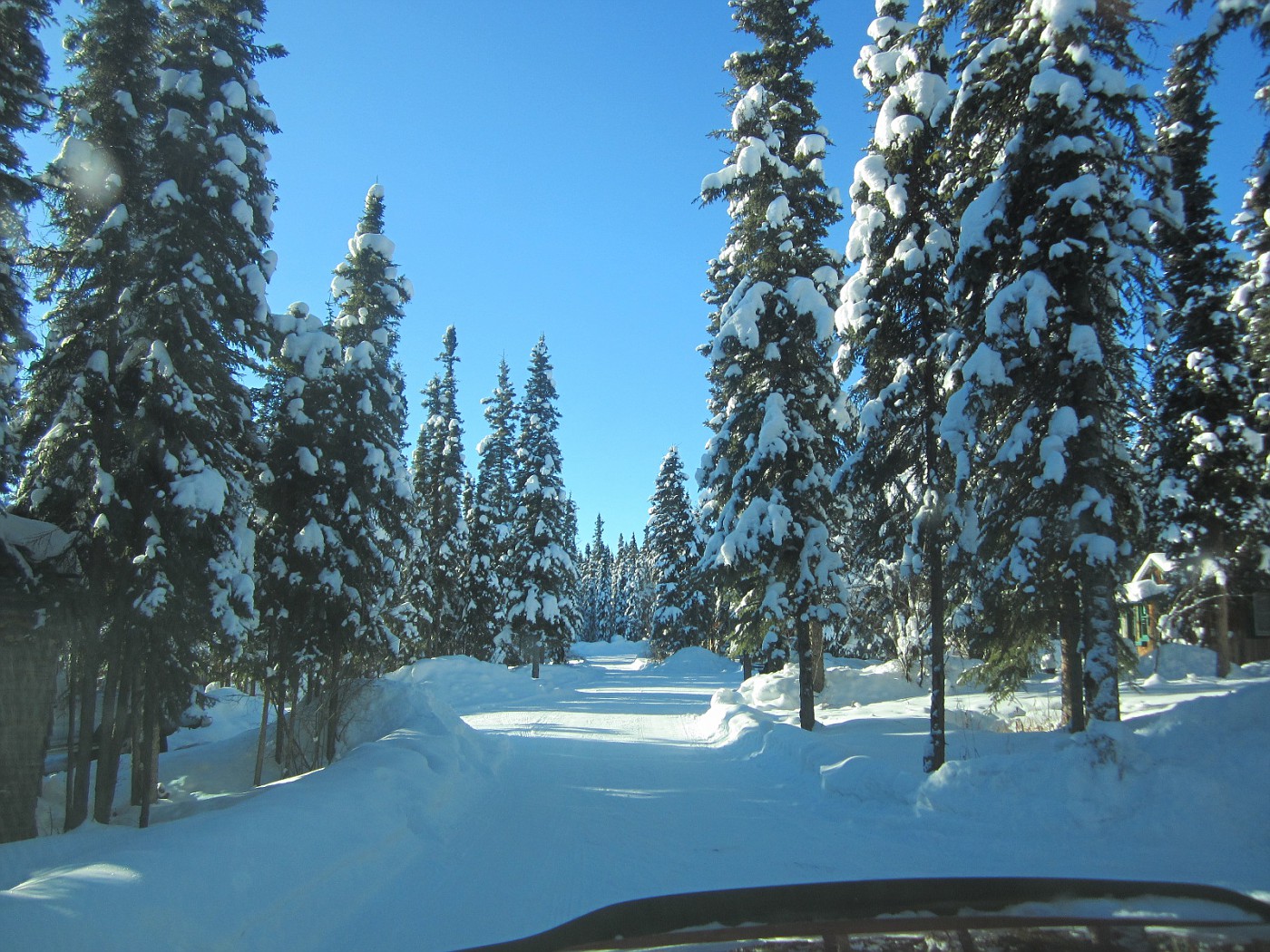
The road out of my place
As seen under good conditions in the winter
Those of you who are unfamiliar with Alaska may be surprised at the “International” appellation for Fairbank’s humble little airport but FAI has a long history of international service dating back to 1935 when Pacific Alaska Airways provided nonstop flights from Whitehorse, across the Canadian border in the Yukon Territory. Later Pan American used Fairbanks as a refueling point on its one-stop 707 flights between New York and Tokyo. At present we enjoy year round service from Dawson City, Yukon with Air North and seasonal nonstop flights from Japan with JAL and from Germany with Condor.
As usual I’m booked in Economy class for my flights down to Jackson. Given the mediocre product that passes as “First Class” in the U.S. these days, I just don’t see the value in redeeming twice the mileage for a marginally more comfortable seat and a so-so meal. Had I wanted to I could’ve upgraded this flight to First Class for $100.00 but I fit just fine into an Economy Class seat and Alaska’s Buy-On-Board meals are far and away the best in the country. A mere $6.00 will always get you a hot sandwich or casserole style dish that’s generally every bit as flavorful as it is filling. Indeed, the food that Alaska serves behind the curtain is occasionally better than what it serves up front.
So, I’m just fine here in 6C thanks, watching with interest as the First Class patrons one row forward of me are served a barbecued chicken breast accompanied by what appears to be a corn fritter and a little piece of chocolate for dessert. Meanwhile, I am tucking into a delicious hot Vietnamese Pork Loin Sandwich, served on a hoagie roll and accompanied by fresh sliced jalapenos, cucumbers, cilantro and carrots. Because of my top flight status in Alaska’s Mileage Plan, Alaska has generously offered me my first cocktail “on the house”. I don’t know of any other airline that does this for its elite flyers but I can tell you that I appreciate the gesture and the sincere thanks for flying with Alaska that come with it.
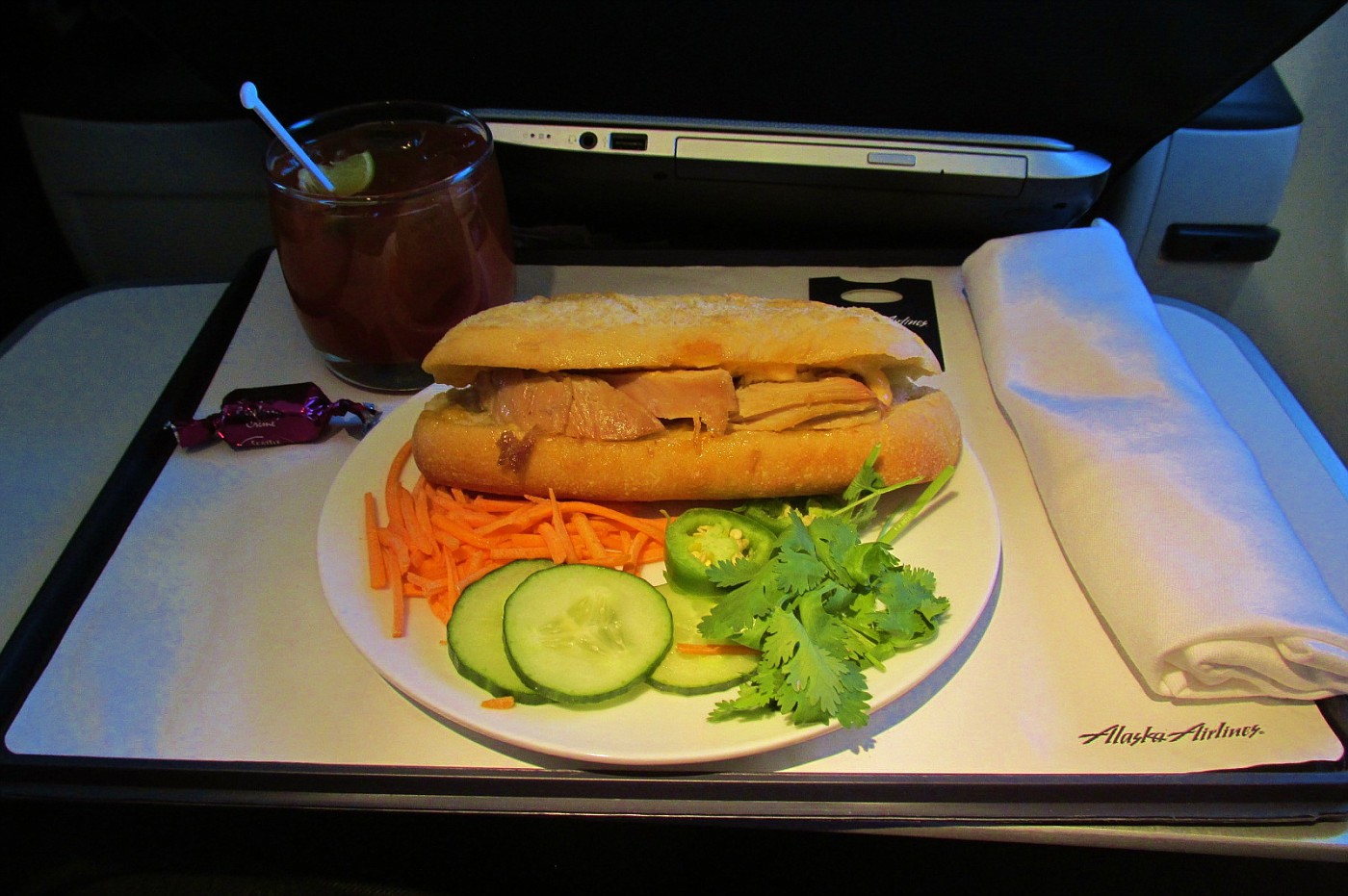
Alaska’s Bahn Mi Sandwich
This is the First Class version. It differs from the Economy Class version
only in that it is served on a plate. Otherwise it is identical.
Two hours and fifty-eight minutes later, we touched down in Seattle on a surprisingly clear and pleasant evening. My thirteen hour layover here provides more than enough time to take advantage of one of the many affordably priced hotels nearby SeaTac but if ever there were an airport that I actually enjoy sleeping in, it’s this one and besides; I’m shelling out $140.00 for my hotel room in New Orleans. That’s the equivalent of three nights at my usual haunts in Needles, CA and Page, AZ. The way I see it, the $60.00 I save tonight will make that New Orleans hotel bill “seem” like $80.00 instead.
Most friends and acquaintances have never been able to come to grips with this side of my travels. Why on earth would I willingly sleep in an airport? In short, why would I want to spend any more time in an airport than absolutely necessary?
One of the major differences between us is that when most folks have had to sleep in an airport, it’s usually because they’ve become stuck in the airport for some unplanned reason. Myself on the other hand, I actually plan to sleep in the airport so I come prepared with a Thermarest Pad, a large (and warm) wool blanket, a small pillow, a headlamp, some eyeshades and an alarm clock. The Thermarest pad allows me to sleep quite comfortably in places where others would never go – such as dark alcoves atop cold linoleum floors, away from the maddening crowds and annoying announcements. The blanket is equally important as many airports can get downright chilly at night. A small pillow atop my day pack is essential as are eyeshades, an alarm clock and a headlamp for reading. The result is a comfortable sleep and a nice savings of anywhere from $50-80.00 per night.
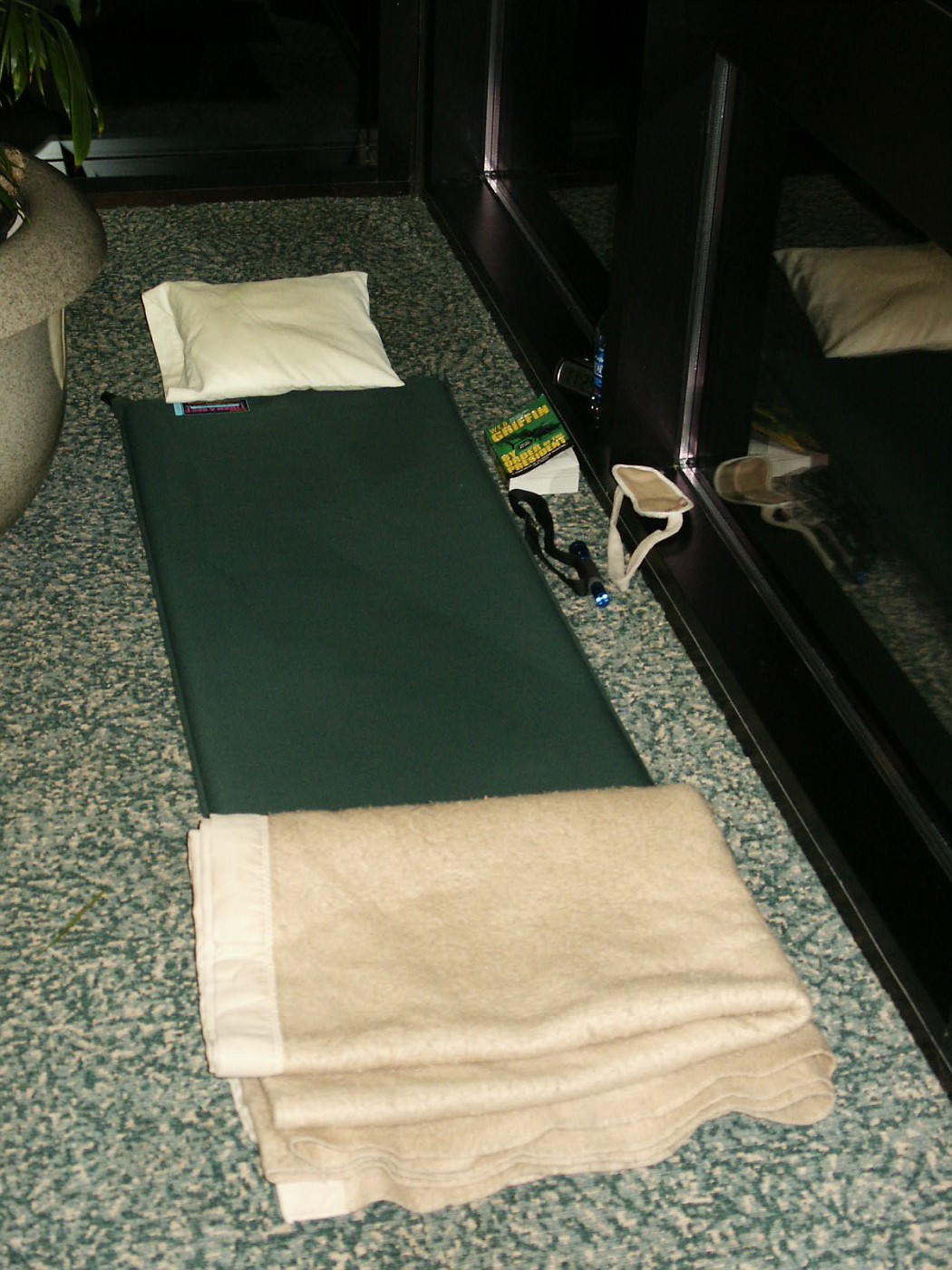
How to sleep in an airport
Another major difference between me and my friends is that because I fly frequently, I enjoy faster service through shorter lines and better service through lounge memberships and frequent upgrades. These combine to make my time in most any airport both pleasant and productive. My patient explanations notwithstanding, most people are still left shaking their heads until that day arrives where fate has us flying on the same flight and I’m strolling through TSA Pre✓ and am seated in First Class while they’re stuck in a 30 minute line at security and relegated to a seat back in Coach. Being the kind hearted soul that I am, I always invite them into the airline lounge and – if at all possible – I try to send back a few drippings from the First Class meal service.
Day Two
Alaska Airlines Seattle to Kansas City 1030a – 352p 737-900 Coach Class
American Airlines Kansas City to Dallas 520p – 700p MD-80 Coach Class
American Eagle Dallas to Jackson 945p – 1105p ERJ-145 Coach Class
After stopping by Delta’s Sky Club for a hot shower, I made my way back across the terminal to Alaska’s Boardroom where hot coffee, a bagel and some yogurt got the morning off to a good start. Departure was from C-11 which allowed me to pay a visit to Wagi’s and purchase a bowl of extra-spicy stir-fried chicken and veggies for later in the flight.
The aircraft operating this morning’s flight to Kansas City was Alaska’s brightly colored “Spirit of Disneyland II”. So far as I know it is the only one of Alaska’s growing fleet of 737-900s that is painted in a special livery. It is also the one -900 upon which I have logged the most flights, having logged 14 flights totaling 15390 miles aboard it so far. I realize that for many of you, keeping a detailed flight log is just a wee bit nerdier than you’re comfortable admitting to but consider then the plethora of fascinating aeronautical statistics you’re missing out on. I mean honestly now, who wouldn’t be thrilled to discover that they’d flown every DC-10 in Continental’s fleet or that that creaky old rust bucket you flew on Delta last week was the exact same shiny new DC-9-50 that you once flew with North Central Airlines just thirty-one years earlier? What’s that? Some of you aren’t thirty-one yet? Oh. Well uh, we all have our own unique histories. It’s never too late to start detailing those flights now, though. Getting back to Alaska 737s, my multiple flight champ is N793AS, a 737-400 upon which I’ve logged 28 flights.
Alaska’s only been flying the Seattle to Kansas City route for a couple of years now, and so far as I know they are the only airline flying the route today, offering a single daily nonstop in each direction. In years past however, the SEA-MCI route has been flown by Braniff, Eastern, Midwest Express, Southwest, TWA, United and US Air. Will Alaska still be flying the route ten years from now or will yet another airline step in and have a go at it?
Aided by a 70 mph tailwind, flight time to Kansas City was a mere two hours and forty-eight minutes. We landed on a nice warm afternoon and parked over at terminal B.
MCI is comprised of three separate passenger terminals that are built in the shape of rings. Each ring has a parking lot in the center of the ring. When the airport was designed back in the late 1960s, the idea was that passengers could be dropped off or park much nearer to their gate. The roadway has actually been measured at only 75 feet from the gates. Much of this design was driven by TWA who envisioned MCI as its primary domestic hub with 747s, L-1011s and other aircraft flying travelers all over the country.
Unfortunately, this design was flawed from the start, primarily due to the corridors being too narrow. When the airport was dedicated in 1972, it didn’t take long to discover that widebodied aircraft would quickly overwhelm the narrow corridors with large numbers of passengers. Bathrooms, shops and restaurants were few and, due to the limitations of the narrow corridors, very small. Additionally, the spate of hijackings in the 1960s resulted in security checkpoints being required in all major airports. The narrow ring-like terminals were not conducive to a central security checkpoint and so they had to be installed at each gate. The result was that once you were past security, you no longer had access to bathrooms, shops or restaurants without going back outside the checkpoint.
It wasn’t long before TWA asked for the terminals (which had been built to its specifications) to be rebuilt to correct these deficiencies. Like many large projects of its day, cost overruns and labor strife had resulted in the airport being more expensive to build than originally planned and so the city refused to comply. As a result, TWA moved its hub across the state to St. Louis. I’d like to think the bad karma resulting from that move led to Carl Icahn’s disastrous involvement with the airline some twenty years later.
Dallas-Fort Worth International Airport was designed along similar lines. However, its corridors are wider and each terminal is connected by a train. MCI’s terminals are all independent of one another, unconnected by either train or walkway. As a result, inter-terminal connections must be made by busses which run regularly throughout the day.
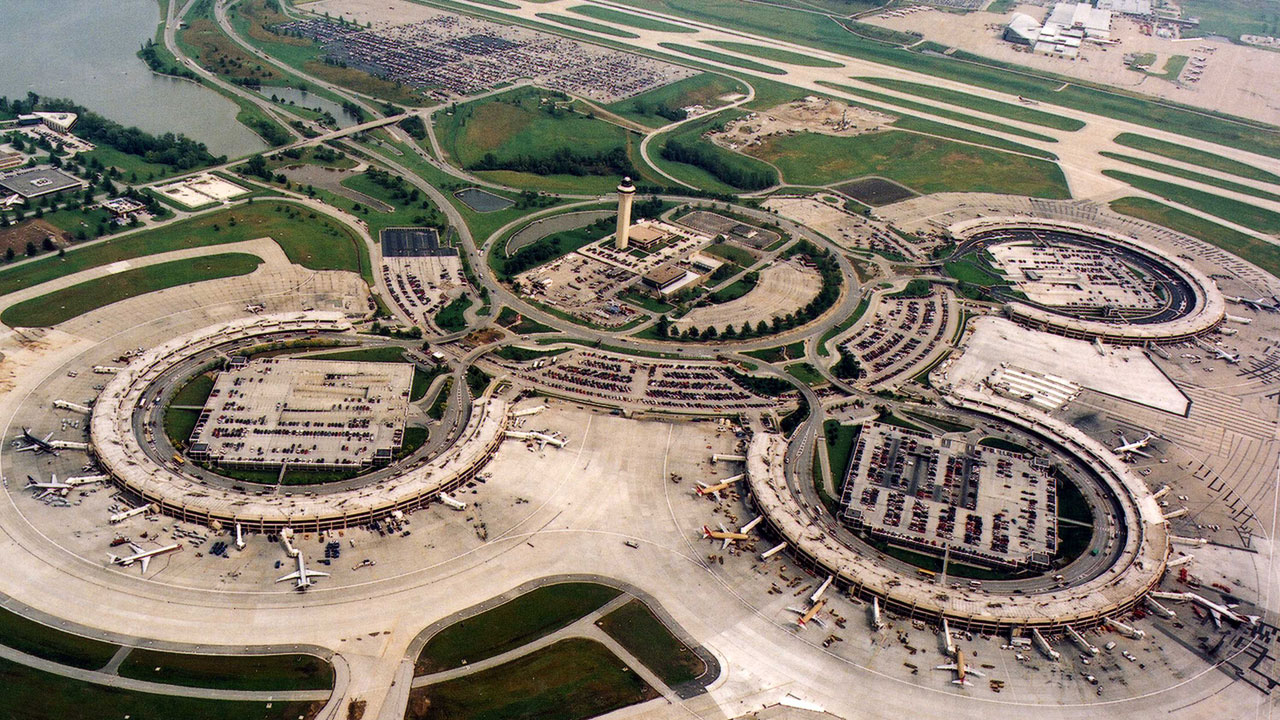
Kansas City International Airport
Photo courtesy of Burns & McDonnell
My American flight to Dallas was departing from Terminal C, so I gathered my belongings and made my way outside where I was greeted by a cloud of cigarette smoke from the large cluster of smokers gathered just beyond the doorway. I was thankful that all of my smoking took place back in the day when we could smoke onboard planes and inside airports or even hospitals. Fortunately I was able to quit back in 1990 after just 13 years.
Narrow corridors and independent terminals notwithstanding, for me the major flaw at MCI is the lack of a good local barbecue joint. I mean, Kansas City is justifiably famous for its delicious barbecue and yet none of the major barbecue outlets such as Gates or Jack Stack are represented at the airport. A couple of years ago I ordered a barbecued chicken sandwich from a Budweiser themed sports bar but it was largely unsatisfying. Today I decided to hold off on dinner until I got down to Dallas where I had two and a half hour layover.
Many people profess not to like the MD-80, referring to it with desultory names like “Mad Dog” and generally looking forward to the day it’s retired from American skies. I am not one of those people. The 2-3 seating in coach is wider than that found in Boeing’s 737 and – if you’re sat ahead of the wing – the cabin ambience is remarkably quiet. I’ve logged over 340 flights aboard MD80s from fifteen different airlines. With one exception (where the airplane experienced an inflight mechanical issue), all of those flights were quite pleasant.
The aircraft operating this afternoon’s flight down to Dallas was an ex-TWA machine, built in 1990. By MD-80 standards, this airplane was only middle aged with a good 5-10 more years of revenue flights ahead before she’ll likely be put out to pasture. At the rate American’s accepting new 737s and A320s, this plane will likely spend a bit of time parked in Roswell, New Mexico before some secondary airline shows up to kick its tires and put a few more hours on her airframe. Perhaps we’ll meet up again someday when she’s wearing the livery of some third world start-up or perhaps even an airline closer to home such as Allegiant.
Flight time down to Dallas was a mere one hour and fifteen minutes. Upon arrival I caught the Skylink train over to Terminal B and soon was tucking into a halfway decent platter of barbecued ribs at Cousin’s Bar-B-Q, conveniently located just a couple of gates down from the departure gate for my American Eagle flight to Jackson.
As much as I like flying aboard old MD-80s, I reserve an equal amount of dislike for flying aboard skinny little regional jets such as Embraer’s ERJ-140. I can barely stand up straight in the narrow cabin and the seating feels tight and cheap. Thankfully tonight’s 410 mile flight to Jackson was over after just one hour and two minutes.
I have slept in dozens of airports across the country (69 different ones to be exact) but this would be my first time doing so in Jackson’s Jackson–Medgar Wiley Evers International Airport. The last time I flew through here was in 1984, and the terminal appears to have undergone substantial renovations since then. Before settling on a spot in the spacious and quiet upper mezzanine, I checked in with the airport police. This is always a good idea because establishing in advance that you’re a bonafide traveler can occasionally save you being woken up at 3:00am to verify that fact. It is not at all unheard of for non-travelers - many of them homeless people – to attempt to sleep in airports. Being homeless and sometimes destitute, some of them are not above resorting to thievery to improve their lot.
Back in the early 1980s I had a wallet slit right out of my back pocket with a razor blade while I slept on the floor of Chicago’s O’Hare International Airport. Of course the fact that I’d spent the past couple of days with the Grateful Dead up in Wisconsin’s Alpine Valley Amphitheater meant that I hadn’t had much sleep of late and so the cold airport floor notwithstanding, I was probably sleeping more soundly than usual. These days I secure my wallet and other valuables in my daypack, atop which I place my pillow. Nobody has ever bothered me since.
Day Three
Amtrak Jackson to New Orleans 1120a – 332p City of New Orleans Coach Class
In the morning I washed up in a deserted restroom off baggage claim (the first flight wasn’t due to arrive until after 8:00am) before heading upstairs to purchase a coffee and a croissant. Surprisingly there is no public transport available from the airport into downtown Jackson. As a result I was forced to shell out $38.00 for a taxi down to the Amtrak station, located in the heart of downtown Jackson.
I first heard the train whistle about three minutes before the southbound City of New Orleans rolled onto the elevated platform above the Jackson station. The train consist was quite long today, totaling over a dozen bi-level Superliner cars. Perhaps I was standing in the wrong place or possibly the train came into the station a little faster than desired but either way the result was that I had to walk almost the entire length of the train past sleepers, the diner, the lounge car and numerous coaches before finally reaching my coach, located two cars from the locomotives.
As we accelerated out of Jackson, I took in the Jackson skyline and in particular the gold dome of the attractive state capitol. According to the route guide placed in the seat pocket in front of me, the city was invaded by General Sherman three times during the Civil War and burned to the ground. Indeed, some say that "Chimneyville," as it came to be called, was where Sherman practiced for the burning of Atlanta.
As we rolled onward with ever increasing speed, the city and its suburbs were soon replaced by Mississippi’s beautiful Piney Woods, home to some of the best remaining longleaf pine forests in America and an increasingly rare ecosystem in the South. Longleaf pine once covered 95 million acres of the American South but since the end of the Civil War, increased demand for turpentine and wood has reduced that to about 4 million acres.
It’s a four hour ride down to New Orleans and with two hours yet to go I decided to take a stroll up to the diner and see what was available for lunch. Truth be told, with the increasing standardization of Amtrak’s breakfast and luncheon menus I already had a pretty good idea of the offerings and had my heart set on a Chipotle Black Bean and Corn Veggie Burger. Topped with cheese and served on a Kaiser roll with all the usual trimmings, this burger has become my favorite luncheon item. I particularly enjoy it with a couple slices of bacon and a side of salsa, both of which I requested today.
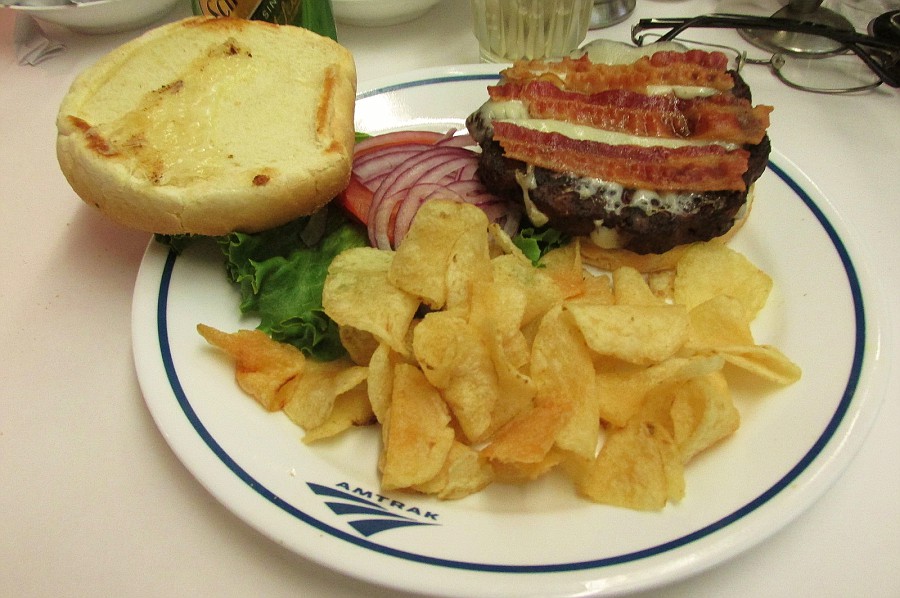
Amtrak’s delicious black bean and corn burger with bacon
We were about an hour out of New Orleans when the landscape once again changed from forest into Bayou. We’re talking lush green wetlands sprinkled liberally with moss-laden cypress trees and populated by a surprising variety of wildlife. From my seat I saw an alligator, a turtle, lots of egrets and two dudes in an airboat.
Soon we were speeding over the long causeway that runs atop Lake Ponchartrain. It’s a huge lake, its broad expanse looking almost like an inland sea. A highway soon joined us, followed shortly by an increasing number of buildings as we eased into New Orleans proper. Instructions went out over the train’s PA system to remain seated as the train backed into the station.
Alighting from the train into a sunny and pleasant Louisiana afternoon, I made my way into the air-conditioned station and made a call to jlemon. Minutes later he and his lady friend (who I’ll refer to as Lady K) showed up in a comfortable Lexus sedan and off we sped to Drago’s Restaurant for a plate of delicious charbroiled oysters washed down with a tasty French Bordeaux. Later we checked into the Hyatt Regency New Orleans and got ready for dinner. The hotel was very crowded with many of its guests in town to participate in New Orleans’ famous Crescent City Classic 10k race.
Now you may recall that the reason I came to New Orleans for this night was given some 3,600 words earlier in this chronicle. That’s right! I’d won a gourmet dinner with jlemon and Lady K for having correctly answered a question proffered in the Old Timers Airline and Airliners Quiz.
Well you’d think I’d correctly answered an entire page full of questions because from the moment I arrived to the moment we parted company, jlemon saw to it that I was wined and dined like royalty. We started with dinner at Muriel’s Restaurant in New Orleans’ historic Jackson Square. I enjoyed a delicious Double Cut Pork Chop, admirably accompanied by a glass or two of delightfully tasty Margaux. After dinner we grabbed a cab over to Frenchman Street for fine bourbon and good music at the d.b.a. Club. It was approaching midnight when we closed out the evening with one last drink at the Hyatt’s Vitascope Hall Bar.

Muriel’s Restaurant – New Orleans

The view out my hotel window of the Superdome
In the morning we joined fellow FTer and longtime Old Timers Airline and Airliners Quiz participant miniliq for breakfast at Tujague's. Located in the heart of the French Quarter, Tujague's is the second oldest restaurant in New Orleans. Besides excellent food and atmosphere, the restaurant is also noted for its extensive miniature liquor bottle collection, which numbers over 5,000 bottles. We’re talking airline style miniatures, and for most of us it would be hard to imagine a more impressive assemblage of these little bottles than those on display at Tujague's. Amazingly however, FT’s very own miniliq has a collection which numbers over 23,000! HERE is a small sampling of some of his airline related miniatures.
After breakfast, we parted company and went our own ways – JL and Lady K back to Lafayette and mini back to Metairie. I took a moment to thank everyone for a wonderful time and who knows – perhaps we can all get reacquainted once again at an Old Timers Airline and Airliners Quiz Do someday! mini was kind enough to drop me off at New Orleans’ Amtrak station where I was to commence the next part of my travels…
Flying to New Orleans for dinner
The impetus for flying nearly 4000 miles from Fairbanks down to New Orleans was gastronomical in nature. I enjoy good food and New Orleans has an enviable selection of fine eateries. There’s a bit more to it than that, however. Truth be told, I’d actually won the dinner by correctly answering the following question:
Identify the number of destinations in the state of California that Air West served with scheduled flights in the summer of 1968. Also name the aircraft types Air West was operating in the state at this time. And if you can name every one of these California cities, I'll buy you a gourmet dinner with wine in the French Quarter of N.O.
That question was asked as part of a collection of questions posed at the Old Timers Airline and Airliners Quiz over in the TravelBuzz Forum. For those of you unfamiliar with this thread, it began three years ago when I posed a set of seventy questions directed toward anyone who had both the experience of having flown in the sixties and seventies as well as enough interest in commercial aviation to have a working knowledge of the aircraft and airlines of the times.
Given that the vast majority of FlyerTalk members are either 1.) too young to have been flying during that era or 2.) they could care less anyway, I figured this thread would last no longer than a few days on page one before sliding into obscurity shortly thereafter.
Boy was I wrong! The response was immediate and ongoing. As of this writing, the Old Timers Airline and Airliners Quiz has amassed 287206 hits and 6567 posts over the past three years. Thousands of questions have been presented and answered, as well as more than a few great stories and reminiscing from the “Good Old Days” of commercial aviation.
To be sure, not all of the questions come with such generous and appetizing awards. In fact, I believe this is the only one that ever has. For that I can thank the generosity of fellow FlyerTalker jlemon. In any event, yours truly was well suited to provide the correct answer to this question, especially given that I spent a lot of time in California back in the early seventies. Hughes Airwest’s bright yellow F-27s were a familiar sight most California airports, including such off the beaten track destinations as Inyokern, Santa Maria or El Centro. If anything, it might be harder to list where Air West didn't fly! Myself – being innately drawn to these far flung outposts of civilization – would keep track of flights there via my handy collection of OAGs (Official Airline Guides) which I’d procure upon their expiration from local travel agencies.
And lo – now forty-two years later, I still have a few of those old OAGs, including one from September of 1968 that I scored through an eBay auction. So it is that I now find myself comfortably ensconced aboard an Alaska Airlines 737, winging my way down the rugged Alaskan coast on the first leg of a typically convoluted routing between Fairbanks and the Crescent City. More on that later, though...
Alaska’s a long way from New Orleans. Indeed, it’s a long way from anywhere in the contiguous United States or – as we like to call them – the Lower 48. During the fall, winter and spring, Alaska Airlines is the only airline offering service from Fairbanks with flights down to Seattle and beyond. Airfares to and from Fairbanks reflect its isolation both geographically and competitively. The lowest roundtrip airfare I could find between Fairbanks and New Orleans was $751.40. This was not unexpected. Indeed, the search was really more for entertainment purposes given that I haven’t purchased a ticket out of Fairbanks to anywhere for many years now. Instead I use miles and because I work harder than most to earn my miles, I like to get as much bang for my buck as possible whenever I leave the state. As such, I’ll fly to New Orleans via Seattle, Kansas City, Dallas and Jackson, Mississippi. Travel between Jackson and New Orleans will be via Amtrak’s City of New Orleans.
Day One
Alaska Airlines Fairbanks to Seattle 525p – 958p 737-700 Economy Class
My neighbor Sharon did the honors in dropping me off at Fairbanks International. With the recent spate of 50° temperatures across Alaska’s Interior, the snow that had accumulated throughout the winter was starting to rapidly melt. The road into our cabins had become a quagmire of slush and mud – two people got stuck in it yesterday - but thankfully Sharon’s twelve year old 2WD Toyota Camry proved up to the task as Sharon gunned it through three hundred yards of deep slushy muck with all the skill and verve of a seasoned Alaskan ice road driver.

The road out of my place
As seen under good conditions in the winter
Those of you who are unfamiliar with Alaska may be surprised at the “International” appellation for Fairbank’s humble little airport but FAI has a long history of international service dating back to 1935 when Pacific Alaska Airways provided nonstop flights from Whitehorse, across the Canadian border in the Yukon Territory. Later Pan American used Fairbanks as a refueling point on its one-stop 707 flights between New York and Tokyo. At present we enjoy year round service from Dawson City, Yukon with Air North and seasonal nonstop flights from Japan with JAL and from Germany with Condor.
As usual I’m booked in Economy class for my flights down to Jackson. Given the mediocre product that passes as “First Class” in the U.S. these days, I just don’t see the value in redeeming twice the mileage for a marginally more comfortable seat and a so-so meal. Had I wanted to I could’ve upgraded this flight to First Class for $100.00 but I fit just fine into an Economy Class seat and Alaska’s Buy-On-Board meals are far and away the best in the country. A mere $6.00 will always get you a hot sandwich or casserole style dish that’s generally every bit as flavorful as it is filling. Indeed, the food that Alaska serves behind the curtain is occasionally better than what it serves up front.
So, I’m just fine here in 6C thanks, watching with interest as the First Class patrons one row forward of me are served a barbecued chicken breast accompanied by what appears to be a corn fritter and a little piece of chocolate for dessert. Meanwhile, I am tucking into a delicious hot Vietnamese Pork Loin Sandwich, served on a hoagie roll and accompanied by fresh sliced jalapenos, cucumbers, cilantro and carrots. Because of my top flight status in Alaska’s Mileage Plan, Alaska has generously offered me my first cocktail “on the house”. I don’t know of any other airline that does this for its elite flyers but I can tell you that I appreciate the gesture and the sincere thanks for flying with Alaska that come with it.

Alaska’s Bahn Mi Sandwich
This is the First Class version. It differs from the Economy Class version
only in that it is served on a plate. Otherwise it is identical.
Two hours and fifty-eight minutes later, we touched down in Seattle on a surprisingly clear and pleasant evening. My thirteen hour layover here provides more than enough time to take advantage of one of the many affordably priced hotels nearby SeaTac but if ever there were an airport that I actually enjoy sleeping in, it’s this one and besides; I’m shelling out $140.00 for my hotel room in New Orleans. That’s the equivalent of three nights at my usual haunts in Needles, CA and Page, AZ. The way I see it, the $60.00 I save tonight will make that New Orleans hotel bill “seem” like $80.00 instead.
Most friends and acquaintances have never been able to come to grips with this side of my travels. Why on earth would I willingly sleep in an airport? In short, why would I want to spend any more time in an airport than absolutely necessary?
One of the major differences between us is that when most folks have had to sleep in an airport, it’s usually because they’ve become stuck in the airport for some unplanned reason. Myself on the other hand, I actually plan to sleep in the airport so I come prepared with a Thermarest Pad, a large (and warm) wool blanket, a small pillow, a headlamp, some eyeshades and an alarm clock. The Thermarest pad allows me to sleep quite comfortably in places where others would never go – such as dark alcoves atop cold linoleum floors, away from the maddening crowds and annoying announcements. The blanket is equally important as many airports can get downright chilly at night. A small pillow atop my day pack is essential as are eyeshades, an alarm clock and a headlamp for reading. The result is a comfortable sleep and a nice savings of anywhere from $50-80.00 per night.

How to sleep in an airport
Another major difference between me and my friends is that because I fly frequently, I enjoy faster service through shorter lines and better service through lounge memberships and frequent upgrades. These combine to make my time in most any airport both pleasant and productive. My patient explanations notwithstanding, most people are still left shaking their heads until that day arrives where fate has us flying on the same flight and I’m strolling through TSA Pre✓ and am seated in First Class while they’re stuck in a 30 minute line at security and relegated to a seat back in Coach. Being the kind hearted soul that I am, I always invite them into the airline lounge and – if at all possible – I try to send back a few drippings from the First Class meal service.
Day Two
Alaska Airlines Seattle to Kansas City 1030a – 352p 737-900 Coach Class
American Airlines Kansas City to Dallas 520p – 700p MD-80 Coach Class
American Eagle Dallas to Jackson 945p – 1105p ERJ-145 Coach Class
After stopping by Delta’s Sky Club for a hot shower, I made my way back across the terminal to Alaska’s Boardroom where hot coffee, a bagel and some yogurt got the morning off to a good start. Departure was from C-11 which allowed me to pay a visit to Wagi’s and purchase a bowl of extra-spicy stir-fried chicken and veggies for later in the flight.
The aircraft operating this morning’s flight to Kansas City was Alaska’s brightly colored “Spirit of Disneyland II”. So far as I know it is the only one of Alaska’s growing fleet of 737-900s that is painted in a special livery. It is also the one -900 upon which I have logged the most flights, having logged 14 flights totaling 15390 miles aboard it so far. I realize that for many of you, keeping a detailed flight log is just a wee bit nerdier than you’re comfortable admitting to but consider then the plethora of fascinating aeronautical statistics you’re missing out on. I mean honestly now, who wouldn’t be thrilled to discover that they’d flown every DC-10 in Continental’s fleet or that that creaky old rust bucket you flew on Delta last week was the exact same shiny new DC-9-50 that you once flew with North Central Airlines just thirty-one years earlier? What’s that? Some of you aren’t thirty-one yet? Oh. Well uh, we all have our own unique histories. It’s never too late to start detailing those flights now, though. Getting back to Alaska 737s, my multiple flight champ is N793AS, a 737-400 upon which I’ve logged 28 flights.
Alaska’s only been flying the Seattle to Kansas City route for a couple of years now, and so far as I know they are the only airline flying the route today, offering a single daily nonstop in each direction. In years past however, the SEA-MCI route has been flown by Braniff, Eastern, Midwest Express, Southwest, TWA, United and US Air. Will Alaska still be flying the route ten years from now or will yet another airline step in and have a go at it?
Aided by a 70 mph tailwind, flight time to Kansas City was a mere two hours and forty-eight minutes. We landed on a nice warm afternoon and parked over at terminal B.
MCI is comprised of three separate passenger terminals that are built in the shape of rings. Each ring has a parking lot in the center of the ring. When the airport was designed back in the late 1960s, the idea was that passengers could be dropped off or park much nearer to their gate. The roadway has actually been measured at only 75 feet from the gates. Much of this design was driven by TWA who envisioned MCI as its primary domestic hub with 747s, L-1011s and other aircraft flying travelers all over the country.
Unfortunately, this design was flawed from the start, primarily due to the corridors being too narrow. When the airport was dedicated in 1972, it didn’t take long to discover that widebodied aircraft would quickly overwhelm the narrow corridors with large numbers of passengers. Bathrooms, shops and restaurants were few and, due to the limitations of the narrow corridors, very small. Additionally, the spate of hijackings in the 1960s resulted in security checkpoints being required in all major airports. The narrow ring-like terminals were not conducive to a central security checkpoint and so they had to be installed at each gate. The result was that once you were past security, you no longer had access to bathrooms, shops or restaurants without going back outside the checkpoint.
It wasn’t long before TWA asked for the terminals (which had been built to its specifications) to be rebuilt to correct these deficiencies. Like many large projects of its day, cost overruns and labor strife had resulted in the airport being more expensive to build than originally planned and so the city refused to comply. As a result, TWA moved its hub across the state to St. Louis. I’d like to think the bad karma resulting from that move led to Carl Icahn’s disastrous involvement with the airline some twenty years later.
Dallas-Fort Worth International Airport was designed along similar lines. However, its corridors are wider and each terminal is connected by a train. MCI’s terminals are all independent of one another, unconnected by either train or walkway. As a result, inter-terminal connections must be made by busses which run regularly throughout the day.

Kansas City International Airport
Photo courtesy of Burns & McDonnell
My American flight to Dallas was departing from Terminal C, so I gathered my belongings and made my way outside where I was greeted by a cloud of cigarette smoke from the large cluster of smokers gathered just beyond the doorway. I was thankful that all of my smoking took place back in the day when we could smoke onboard planes and inside airports or even hospitals. Fortunately I was able to quit back in 1990 after just 13 years.
Narrow corridors and independent terminals notwithstanding, for me the major flaw at MCI is the lack of a good local barbecue joint. I mean, Kansas City is justifiably famous for its delicious barbecue and yet none of the major barbecue outlets such as Gates or Jack Stack are represented at the airport. A couple of years ago I ordered a barbecued chicken sandwich from a Budweiser themed sports bar but it was largely unsatisfying. Today I decided to hold off on dinner until I got down to Dallas where I had two and a half hour layover.
Many people profess not to like the MD-80, referring to it with desultory names like “Mad Dog” and generally looking forward to the day it’s retired from American skies. I am not one of those people. The 2-3 seating in coach is wider than that found in Boeing’s 737 and – if you’re sat ahead of the wing – the cabin ambience is remarkably quiet. I’ve logged over 340 flights aboard MD80s from fifteen different airlines. With one exception (where the airplane experienced an inflight mechanical issue), all of those flights were quite pleasant.
The aircraft operating this afternoon’s flight down to Dallas was an ex-TWA machine, built in 1990. By MD-80 standards, this airplane was only middle aged with a good 5-10 more years of revenue flights ahead before she’ll likely be put out to pasture. At the rate American’s accepting new 737s and A320s, this plane will likely spend a bit of time parked in Roswell, New Mexico before some secondary airline shows up to kick its tires and put a few more hours on her airframe. Perhaps we’ll meet up again someday when she’s wearing the livery of some third world start-up or perhaps even an airline closer to home such as Allegiant.
Flight time down to Dallas was a mere one hour and fifteen minutes. Upon arrival I caught the Skylink train over to Terminal B and soon was tucking into a halfway decent platter of barbecued ribs at Cousin’s Bar-B-Q, conveniently located just a couple of gates down from the departure gate for my American Eagle flight to Jackson.
As much as I like flying aboard old MD-80s, I reserve an equal amount of dislike for flying aboard skinny little regional jets such as Embraer’s ERJ-140. I can barely stand up straight in the narrow cabin and the seating feels tight and cheap. Thankfully tonight’s 410 mile flight to Jackson was over after just one hour and two minutes.
I have slept in dozens of airports across the country (69 different ones to be exact) but this would be my first time doing so in Jackson’s Jackson–Medgar Wiley Evers International Airport. The last time I flew through here was in 1984, and the terminal appears to have undergone substantial renovations since then. Before settling on a spot in the spacious and quiet upper mezzanine, I checked in with the airport police. This is always a good idea because establishing in advance that you’re a bonafide traveler can occasionally save you being woken up at 3:00am to verify that fact. It is not at all unheard of for non-travelers - many of them homeless people – to attempt to sleep in airports. Being homeless and sometimes destitute, some of them are not above resorting to thievery to improve their lot.
Back in the early 1980s I had a wallet slit right out of my back pocket with a razor blade while I slept on the floor of Chicago’s O’Hare International Airport. Of course the fact that I’d spent the past couple of days with the Grateful Dead up in Wisconsin’s Alpine Valley Amphitheater meant that I hadn’t had much sleep of late and so the cold airport floor notwithstanding, I was probably sleeping more soundly than usual. These days I secure my wallet and other valuables in my daypack, atop which I place my pillow. Nobody has ever bothered me since.
Day Three
Amtrak Jackson to New Orleans 1120a – 332p City of New Orleans Coach Class
In the morning I washed up in a deserted restroom off baggage claim (the first flight wasn’t due to arrive until after 8:00am) before heading upstairs to purchase a coffee and a croissant. Surprisingly there is no public transport available from the airport into downtown Jackson. As a result I was forced to shell out $38.00 for a taxi down to the Amtrak station, located in the heart of downtown Jackson.
I first heard the train whistle about three minutes before the southbound City of New Orleans rolled onto the elevated platform above the Jackson station. The train consist was quite long today, totaling over a dozen bi-level Superliner cars. Perhaps I was standing in the wrong place or possibly the train came into the station a little faster than desired but either way the result was that I had to walk almost the entire length of the train past sleepers, the diner, the lounge car and numerous coaches before finally reaching my coach, located two cars from the locomotives.
As we accelerated out of Jackson, I took in the Jackson skyline and in particular the gold dome of the attractive state capitol. According to the route guide placed in the seat pocket in front of me, the city was invaded by General Sherman three times during the Civil War and burned to the ground. Indeed, some say that "Chimneyville," as it came to be called, was where Sherman practiced for the burning of Atlanta.
As we rolled onward with ever increasing speed, the city and its suburbs were soon replaced by Mississippi’s beautiful Piney Woods, home to some of the best remaining longleaf pine forests in America and an increasingly rare ecosystem in the South. Longleaf pine once covered 95 million acres of the American South but since the end of the Civil War, increased demand for turpentine and wood has reduced that to about 4 million acres.
It’s a four hour ride down to New Orleans and with two hours yet to go I decided to take a stroll up to the diner and see what was available for lunch. Truth be told, with the increasing standardization of Amtrak’s breakfast and luncheon menus I already had a pretty good idea of the offerings and had my heart set on a Chipotle Black Bean and Corn Veggie Burger. Topped with cheese and served on a Kaiser roll with all the usual trimmings, this burger has become my favorite luncheon item. I particularly enjoy it with a couple slices of bacon and a side of salsa, both of which I requested today.

Amtrak’s delicious black bean and corn burger with bacon
We were about an hour out of New Orleans when the landscape once again changed from forest into Bayou. We’re talking lush green wetlands sprinkled liberally with moss-laden cypress trees and populated by a surprising variety of wildlife. From my seat I saw an alligator, a turtle, lots of egrets and two dudes in an airboat.
Soon we were speeding over the long causeway that runs atop Lake Ponchartrain. It’s a huge lake, its broad expanse looking almost like an inland sea. A highway soon joined us, followed shortly by an increasing number of buildings as we eased into New Orleans proper. Instructions went out over the train’s PA system to remain seated as the train backed into the station.
Alighting from the train into a sunny and pleasant Louisiana afternoon, I made my way into the air-conditioned station and made a call to jlemon. Minutes later he and his lady friend (who I’ll refer to as Lady K) showed up in a comfortable Lexus sedan and off we sped to Drago’s Restaurant for a plate of delicious charbroiled oysters washed down with a tasty French Bordeaux. Later we checked into the Hyatt Regency New Orleans and got ready for dinner. The hotel was very crowded with many of its guests in town to participate in New Orleans’ famous Crescent City Classic 10k race.
Now you may recall that the reason I came to New Orleans for this night was given some 3,600 words earlier in this chronicle. That’s right! I’d won a gourmet dinner with jlemon and Lady K for having correctly answered a question proffered in the Old Timers Airline and Airliners Quiz.
Well you’d think I’d correctly answered an entire page full of questions because from the moment I arrived to the moment we parted company, jlemon saw to it that I was wined and dined like royalty. We started with dinner at Muriel’s Restaurant in New Orleans’ historic Jackson Square. I enjoyed a delicious Double Cut Pork Chop, admirably accompanied by a glass or two of delightfully tasty Margaux. After dinner we grabbed a cab over to Frenchman Street for fine bourbon and good music at the d.b.a. Club. It was approaching midnight when we closed out the evening with one last drink at the Hyatt’s Vitascope Hall Bar.

Muriel’s Restaurant – New Orleans

The view out my hotel window of the Superdome
In the morning we joined fellow FTer and longtime Old Timers Airline and Airliners Quiz participant miniliq for breakfast at Tujague's. Located in the heart of the French Quarter, Tujague's is the second oldest restaurant in New Orleans. Besides excellent food and atmosphere, the restaurant is also noted for its extensive miniature liquor bottle collection, which numbers over 5,000 bottles. We’re talking airline style miniatures, and for most of us it would be hard to imagine a more impressive assemblage of these little bottles than those on display at Tujague's. Amazingly however, FT’s very own miniliq has a collection which numbers over 23,000! HERE is a small sampling of some of his airline related miniatures.
After breakfast, we parted company and went our own ways – JL and Lady K back to Lafayette and mini back to Metairie. I took a moment to thank everyone for a wonderful time and who knows – perhaps we can all get reacquainted once again at an Old Timers Airline and Airliners Quiz Do someday! mini was kind enough to drop me off at New Orleans’ Amtrak station where I was to commence the next part of my travels…
Last edited by Seat 2A; Jan 1, 2015 at 5:30 pm
#3
FlyerTalk Evangelist
Original Poster
Join Date: Apr 2001
Location: East Ester, Alaska
Programs: Alaska Million Miler, United Million Miler, Wyndham Rewards Diamond, Choice Hotels Diamond
Posts: 12,148
PART TWO
Trains to the Midwest, the Desert Southwest and the Pacific Northwest
Any of you who’ve read my past trip reports know that there’s simply no way that I could only go to New Orleans for dinner. I need to make a real trip out of this! For me that means some First Class train travel, a bit of mileage running and a good road trip. Why not see the country instead of just fly over it? My Amtrak Guest Reward Account was approaching 46000 points, so I decided to use 20000 of those points for a five day – four night rail extravaganza from New Orleans to Chicago before continuing on to Los Angeles and on up to Seattle. From there I’ll fly down to San Diego and commence a six day, 1600 mile drive around the Desert Southwest. Many of the roads I’ll be driving along I’ve driven before, so this time there’ll be an added twist: I’ve booked a seat in the First Class Parlor Car on the Grand Canyon Railway from Williams, Arizona up to the south rim of the Grand Canyon. Afterwards I’ll continue on to Flagstaff, up to Green River, Utah and then across to Death Valley National Park before making my way back down through the Mojave Desert and over the San Gabriel Mountains to San Diego.
United, Delta and Alaska all offer good fares from San Diego to the Northeast, so I’ve booked a quick roundtrip to Boston on United before switching over to Delta for a two stop journey back over to Portland, Maine. The next morning Amtrak’s Downeaster will whisk me down to Boston, arriving in plenty of time to watch my favorite baseball team play at my favorite ball park. That would be the Oakland A’s playing at Boston’s Fenway Park. I’ve got Grandstand seats about 20 rows up from first base and I’m looking forward to seeing my A’s play in person for the first time since 1997. Later that evening Alaska Airlines will provide First Class comfort on the six hour nonstop to San Diego. The next day it’s on to Denver (via Seattle, of course) for a couple days of meetings with family, dentist and bankers before flying back up to Fairbanks, just in time to drive down to Denali and resume my job driving America’s most tenacious travelers deep into the wilds of Denali National Park.
We’ve got an hour and a half until the train leaves, so let’s head on into the station and check out the Magnolia Room.
Day Four
Amtrak New Orleans to Chicago 145p – 900a City of New Orleans First Class
The Illinois Central Railroad introduced the original City of New Orleans in 1947 as a daytime companion to the overnight Panama Limited. Because the majority of the schedule was run during daytime hours, the original City of New Orleans did not have the sleepers, fine dining and stylish parlor cars of the much more luxurious Panama Limited. It sure was fast, though! Early timetables show the City of New Orleans covering the 921-mile route between New Orleans and Chicago in just 15 hours and 25 minutes. The relatively flat route along the Mississippi River combined with tracks that were in much better condition back then allowed the train to average over 60mph, occasionally reaching speeds of up to 100 mph. At that time this was the longest daytime schedule in the United States.

Route of The City of New Orleans
My first ride on the City of New Orleans came back in 1983. Amtrak had taken over operation of virtually all of the nation’s passenger rail operations in 1971 and unfortunately it had done little to upgrade the City of New Orleans. The consist was made up of older Heritage Fleet equipment and while there was a lounge car, no true dining car was included. Coach passengers as well as First Class passengers from the sleeper got their meals reheated in the Amfleet II café. An article in Trains magazine referred to the City of New Orleans as "Amtrak's Least Glamorous Long-Distance Train".
It’s worth noting that when Amtrak took over the Chicago to New Orleans route back in ‘71, it retained the Panama Limited name for its scheduled overnight train. However, after Arlo Guthrie memorialized the old daytime City of New Orleans with his famous folk ballad (The song was actually written by Steve Goodman), so much attention was called upon the train that Amtrak decided to switch the name of its train to the City of New Orleans! Ironically, based upon the times mentioned in the lyrics (Nighttime on The City of New Orleans, Changing cars in Memphis, Tennessee) and the sad state of the service back then, Goodman may well have written his song based upon an experience aboard the Panama Limited in its final days before Amtrak. Let’s check out the lyrics:
The City of New Orleans
by Steve Goodman
Riding on the City of New Orleans,
Illinois Central Monday morning rail
Fifteen cars and fifteen restless riders,
Three conductors and twenty-five sacks of mail.
All along the southbound odyssey
The train pulls out at Kankakee
Rolls along past houses, farms and fields.
Passin' trains that have no names,
Freight yards full of old black men
And the graveyards of the rusted automobiles.
CHORUS:
Good morning America how are you?
Don't you know me I'm your native son,
I'm the train they call The City of New Orleans,
I'll be gone five hundred miles when the day is done.
Dealin' card games with the old men in the club car.
Penny a point ain't no one keepin' score.
Pass the paper bag that holds the bottle
Feel the wheels rumblin' 'neath the floor.
And the sons of Pullman porters
And the sons of engineers
Ride their father's magic carpets made of steel.
Mothers with their babes asleep,
Are rockin' to the gentle beat
And the rhythm of the rails is all they feel.
CHORUS
Nighttime on the City of New Orleans,
Changing cars in Memphis, Tennessee.
Half way home, we'll be there by morning
Through the Mississippi darkness
Rolling down to the sea.
And all the towns and people seem
To fade into a bad dream
And the steel rails still ain't heard the news.
The conductor sings his song again,
The passengers will please refrain
This train's got the disappearing railroad blues.
Good night, America, how are you?
Don't you know me I'm your native son,
I'm the train they call The City of New Orleans,
I'll be gone five hundred miles when the day is done.
©1970, 1971 EMI U Catalogue, Inc and Turnpike Tom Music (ASCAP)
Since its rocky inception in May of 1971, things have improved a bit for Amtrak and – by extension – the City of New Orleans. Bi-level Superliner II cars and new diners were added in the 1990s, providing the City of New Orleans with real dining service. While the menu was less varied than that of other Superliner trains, the new dining service represented a significant improvement over the microwaved tray meals that were previously offered. When I last rode this train in 1997 its dining car featured a customized menu with dishes that reflected New Orleans' cuisine. It was a welcome upgrade to a train that’s long deserved better!
Moving on to the present, here I was in New Orleans’ Union Passenger Terminal with an hour and a half to go before train time. Back in the eighties this facility sported a very nice cafeteria where $4.00 would get you a memorable plate of red beans and rice with Andouille sausage. Today, the cafeteria has been replaced by a Subway sandwich shop. The game room is still there but unfortunately my old favorite - a Ms. Pacman game - sat dark and silent, out of order.
But wait! I’m rolling out of here in First Class, today. That means I get to go lounge in the Magnolia Room, a private waiting area reserved for Sleeping Car passengers only. The entrance is through twin glass doors guarded by a lock which requires a passcode (easily obtained from the ticket counter) as there are no staff assigned to the room to assist passengers in any way. Inside are a couple dozen chairs, a TV, a small coffee urn and a water dispenser. There are no snacks provided, no computers, no Wi-Fi and no restrooms. In short, the only real benefit to this “lounge” would be that it’s quieter and the cushioned chairs are more comfortable than sitting on the hard plastic seats out in the main lobby.
In retrospect, I’d recommend spending more time in New Orleans and then plan to arrive at the station about 1:30 so you can just board immediately. And while you’re at it, why not grab a “Hurricane” to go before heading over to the terminal!
It was about 1:30 when an Amtrak employee entered the lounge and announced that the train was ready to board. We were escorted to the main station doors and directed down the platform to the waiting train. Today’s consist included a single P42DC locomotive, two sleepers, a Cross Country Café diner/lounge, a Sightseer Lounge Car and three coaches. Once again I had to walk the length of the train as this time the sleepers – not the coaches – were at the front of the train!
Waiting at the entrance to my sleeper with a passenger manifest was my car attendant, Lisa. After verifying my name was on her list, she directed me to enter and turn left where I’d find my roomette on the lower level, just past the luggage racks. I stowed my suitcase there and headed down the hall to my room.

Boarding The City of New Orleans
Each Amtrak bi-level Superliner Sleeper car offers 14 Roomettes, 5 Deluxe bedrooms, 1 Family bedroom and one Handicapped bedroom. Four roomettes along with the Family and Handicapped bedrooms are located downstairs. The roomettes measure 3’6” by 6’6” and are accessed via a sliding glass door. During the day they offer two wide opposite facing seats that fold together to become a bed at night. Above them is a fold-down upper berth. Other amenities include four separate lights, an electrical outlet, a tall mirror, a fold out table, a small open closet with hangers and a thermostat which I immediately turned to its lowest level. Best of all, each compartment has its own huge window, approximately 2’ X 5’, through which to view the passing scenery. Toilet and shower facilities are down the hall. For a single traveler, I think these roomettes are quite sufficient and comfortable which is a good thing because they would be my home for the next four nights.
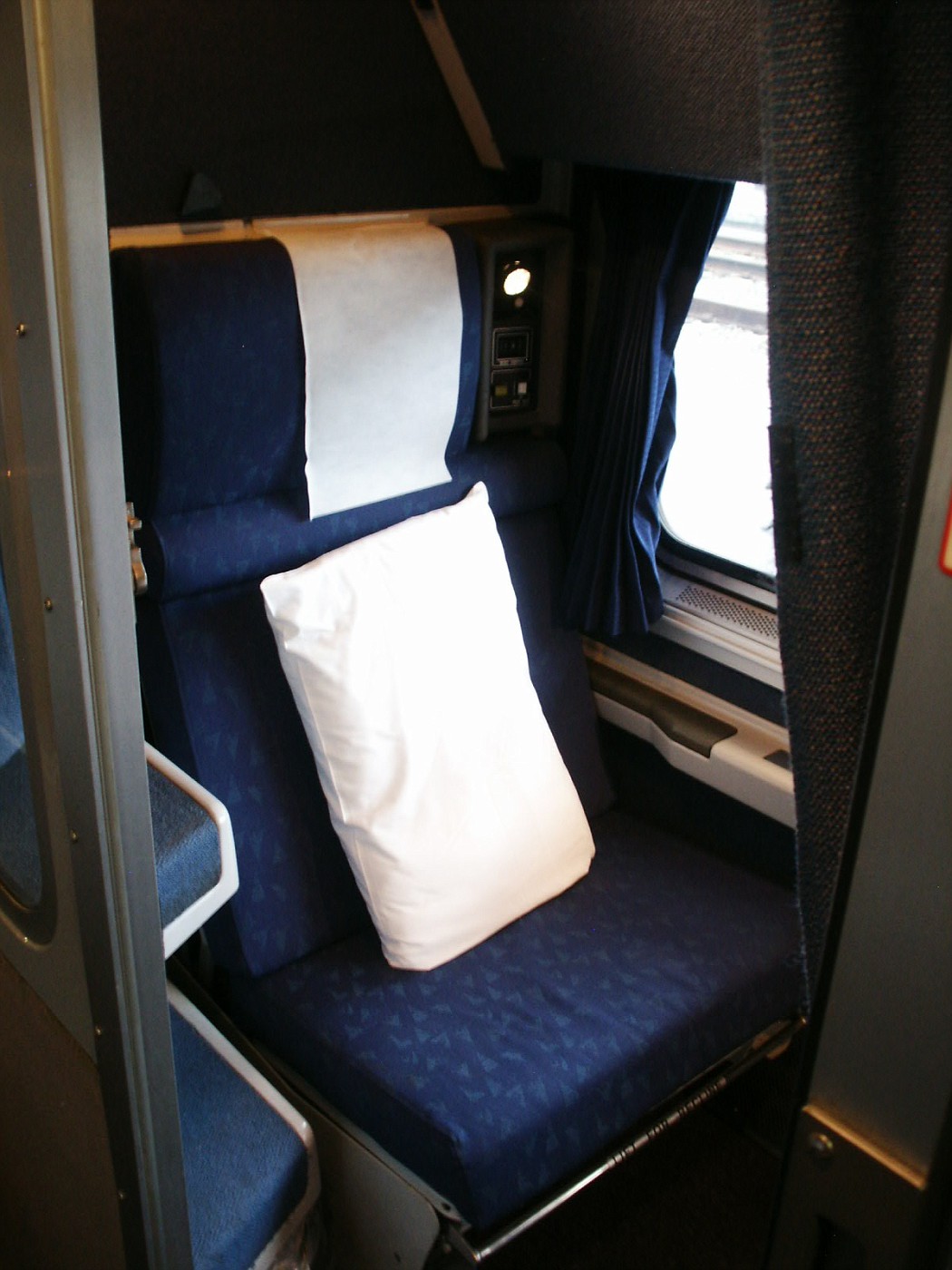
Amtrak Superliner Roomette
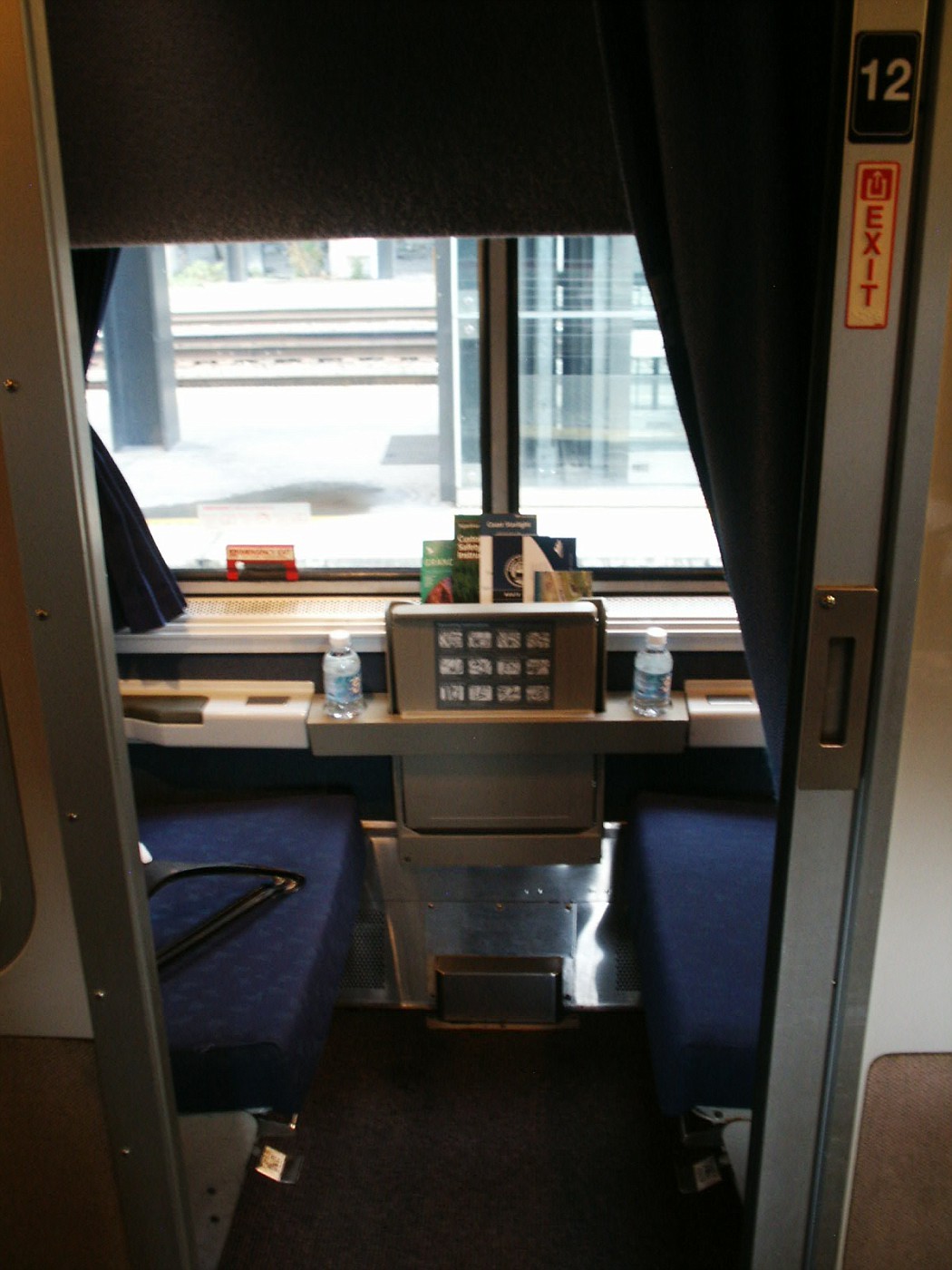
Amtrak Superliner Roomette
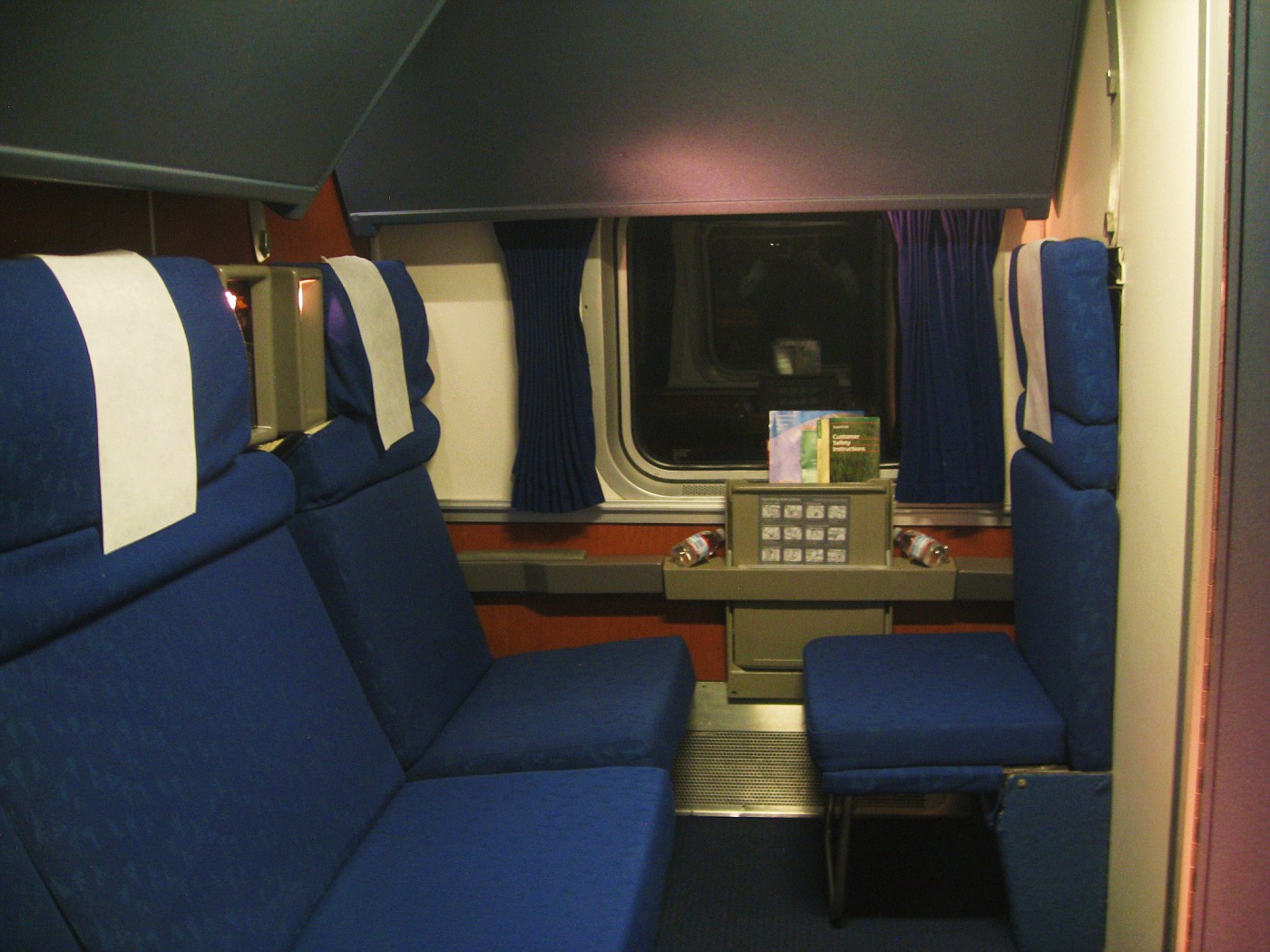
Amtrak Superliner Lower Level Bedroom
At my seat were two big fluffy pillows and a small grey amenities bag containing shampoo, conditioner and lotion. On the center console where the table is stored were two bottles of water and a variety of pamphlets about the train. There was a route guide, a timetable, a safety card much like you’d see aboard an airliner and a brochure describing the train and its various services and attractions.
Although most people are excited about the prospect of a seat or bedroom high on the upper level of Amtrak’s Superliner fleet, I specifically chose a lower level room for two reasons. First, the downstairs rooms are quieter because there is much less foot traffic passing by your door. All the inter-car traffic is upstairs. As well, the train’s natural rocking motion makes for a difficult time walking and most people tend to ricochet their way down the narrow hallways, bouncing off walls and doors with equal abandon. One sleeping car passenger complained that her arms were bruised after just one afternoon on the train. Secondly, riding in the lower level of the car results in much less tilt motion than is experienced on the upper levels. Like a fulcrum point on a seesaw, the ride is smoother the lower you are.
At the top of the stairway is the service area for each car. In the morning, juice and coffee are available from this area. Ice is available throughout the day.
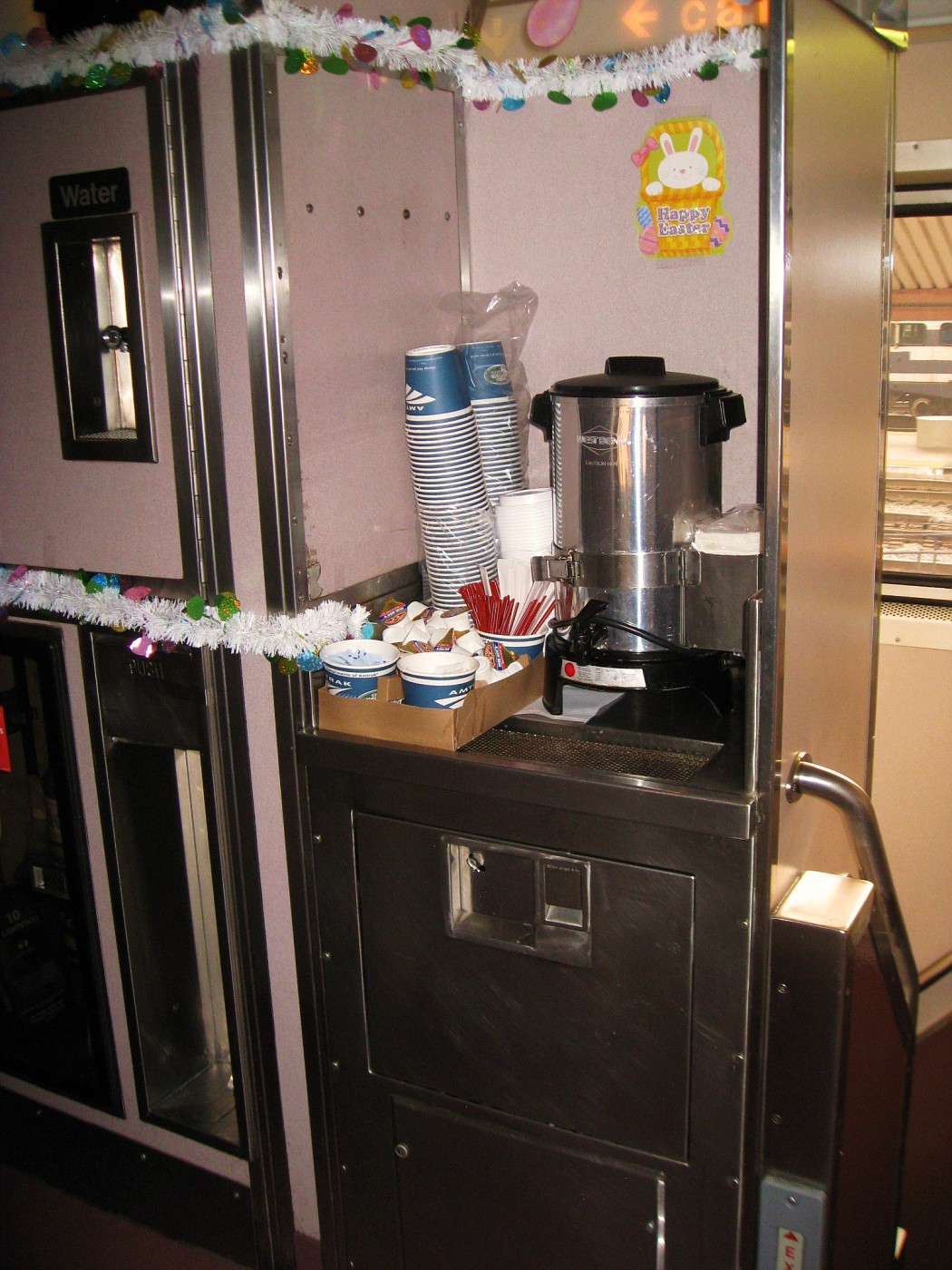
Amtrak Service Area
Taking quick stock of my surroundings and satisfied that all was in order, I hung my jacket and then grabbed my camera and stepped off the train for a couple of photos. Train travel is exciting stuff with plenty of sights, sounds and smells to stimulate the senses. Boarding most airplanes these days has become a relatively sterile experience as you’re usually separated from your aircraft by large glass windows and a jet bridge. By comparison, you must walk up to and meet your train. It’s right there in front of you – big, silver and inviting your inspection. Amtrak’s bi-level Superliner cars are huge, towering above those of us down on the platform. Even at idle the big diesel locomotives are quite loud, emitting a variety of noises such as changes in rpms or frequent short releases of air. I was joined by a couple of other passengers who were also photographing the scene. I chatted briefly with a guy named Jack who claimed this was his sixth ride on the City of New Orleans. It was nice to see the excitement and passion for a train ride still burned bright within him.
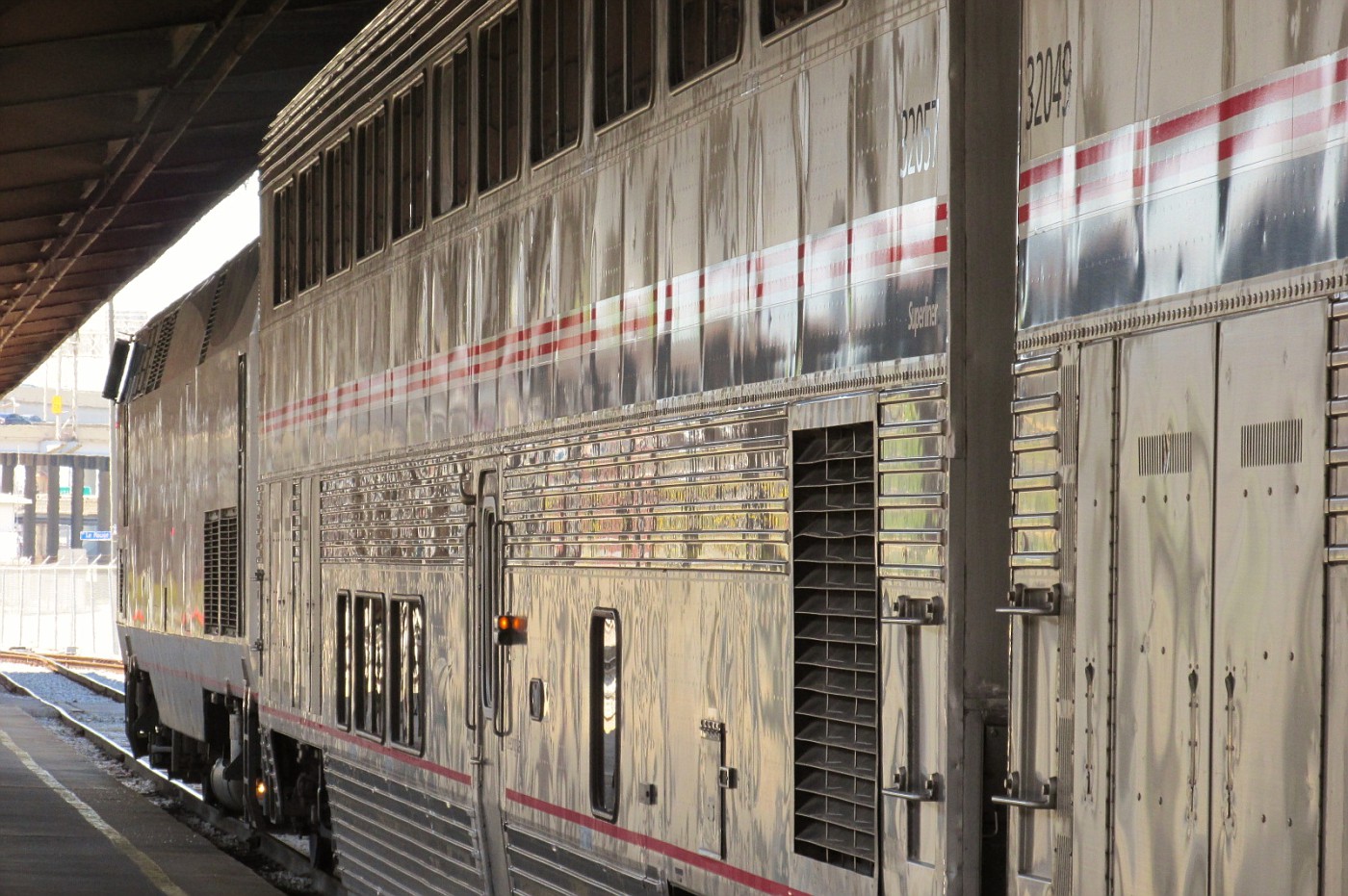
A Wall of Train
It wasn’t long before the “All Aboard!” call rang out and we quickly re-boarded the train. The doors were closed, the step stools stowed and just like that, the City of New Orleans slowly accelerated out of the station. Chicago was 19 hours and 934 miles to the north. Settling into my wide seat, I reclined it a bit and watched as we rolled through the suburbs of New Orleans and out onto the causeway that crosses Lake Ponchartrain. Looking out my window at the vast expanse of water, we could just as easily have been on a ship.
An announcement was made that the dining car steward would soon be passing through the cars taking reservations for tonight’s dinner seatings. He’d be starting with the sleepers and moving backward to the coaches. A variety of times between 5:30 and 7:30pm were available. I stuck around until he arrived and then chose the 6:15 seating for my dinner.
One downside to this particular train was that the windows were not very clean. Sure, you could see through them well enough but good clear photographs would not be forthcoming. Many end of the line stations like New Orleans have car washers – either human or mechanical – but evidently that hadn’t happened for today’s train. That’s all right, I guess. After all, scenery is only half the fun of a long distance train trip.
It’s been said that a train is a place that’s going somewhere. How true! To begin with, I’m traveling aboard a train named the “City of New Orleans”. This sounds much more personable than a seat aboard a nameless 737-800 or a regional jet. Indeed, when it comes to train names, the railroads have it all over the airlines. I mean, consider the prospect of a trip aboard the “Twentieth Century Limited”, the “Silver Star” or the “Coast Starlight” as opposed to a flight on an “Airbus”, a “Jumbojet” or a “757 Luxuryliner” upon which a debatable semblance of luxury is extended to only a small fraction of its total passengers
Unlike an airplane flight where most passengers spend the entire flight confined to their seat - many of them with their window shades down - passengers on a long distance train have the option of strolling up to the Lounge Car to meet, drink and trade stories with their fellow travelers. Those who desire a bite to eat can wander up to the Dining Car or, for lighter fare, head to the Snack Bar located on the lower level of the lounge car. Conversely, those who desire a bit of peace and quiet can easily find it within the confines of their compartment or even at a seat in the lounge car where many are content to settle in and watch the scenery roll by through the large picture windows which start at knee level and extend all the way up to the ceiling. Some people bring books and magazines; others are wired into their mp3 players. Everyone is enjoying the journey in their own way.
As we sped north through the Bayou and Piney Woods towards communities like Hammond, Brookhaven and Jackson, Mississippi I noticed that the engineers sure seemed enthusiastic in their use of the train’s horn. It seemed to blow constantly as we sped through numerous small hamlets and past innumerable road crossings. I once read that a higher percentage of cars are hit by trains in Southern states than anywhere else in the nation, so perhaps this has something to do with the horn usage. Or maybe the engineers are just excited to be driving their train along at 79mph on a nice sunny afternoon. Woo-Hoo! We be cruisin' now!! Yeah!!! Either way, this train really rips along and life does not always turn out like an episode of The Dukes of Hazzard. Drivers of smaller cars and pick-up trucks would be wise to give this train a wide berth!
One interesting aspect of our journey through Mississippi was all the pretty little towns we passed through. The old brick buildings and wooden houses looked very attractive in the late afternoon sun. Some of these towns looked to be on the verge of becoming ghost towns with deserted buildings, derelict cars and machinery littering the surrounding lands. Some towns were more trailer parks than houses. As pretty as the landscape was, clearly life was tough on many of this region’s inhabitants.
The afternoon passed quickly and by the time we pulled into Jackson the sun sat low on the horizon under a clear azure sky. As we continued north of Jackson, I could just imagine being out here on some hot summer evening, sitting on the front porch of an old wooden house with my blue tick hound and a cold beer - watching the trains go by while June bugs rhapsodized us from the surrounding Magnolia trees.
Trains to the Midwest, the Desert Southwest and the Pacific Northwest
Any of you who’ve read my past trip reports know that there’s simply no way that I could only go to New Orleans for dinner. I need to make a real trip out of this! For me that means some First Class train travel, a bit of mileage running and a good road trip. Why not see the country instead of just fly over it? My Amtrak Guest Reward Account was approaching 46000 points, so I decided to use 20000 of those points for a five day – four night rail extravaganza from New Orleans to Chicago before continuing on to Los Angeles and on up to Seattle. From there I’ll fly down to San Diego and commence a six day, 1600 mile drive around the Desert Southwest. Many of the roads I’ll be driving along I’ve driven before, so this time there’ll be an added twist: I’ve booked a seat in the First Class Parlor Car on the Grand Canyon Railway from Williams, Arizona up to the south rim of the Grand Canyon. Afterwards I’ll continue on to Flagstaff, up to Green River, Utah and then across to Death Valley National Park before making my way back down through the Mojave Desert and over the San Gabriel Mountains to San Diego.
United, Delta and Alaska all offer good fares from San Diego to the Northeast, so I’ve booked a quick roundtrip to Boston on United before switching over to Delta for a two stop journey back over to Portland, Maine. The next morning Amtrak’s Downeaster will whisk me down to Boston, arriving in plenty of time to watch my favorite baseball team play at my favorite ball park. That would be the Oakland A’s playing at Boston’s Fenway Park. I’ve got Grandstand seats about 20 rows up from first base and I’m looking forward to seeing my A’s play in person for the first time since 1997. Later that evening Alaska Airlines will provide First Class comfort on the six hour nonstop to San Diego. The next day it’s on to Denver (via Seattle, of course) for a couple days of meetings with family, dentist and bankers before flying back up to Fairbanks, just in time to drive down to Denali and resume my job driving America’s most tenacious travelers deep into the wilds of Denali National Park.
We’ve got an hour and a half until the train leaves, so let’s head on into the station and check out the Magnolia Room.
Day Four
Amtrak New Orleans to Chicago 145p – 900a City of New Orleans First Class
The Illinois Central Railroad introduced the original City of New Orleans in 1947 as a daytime companion to the overnight Panama Limited. Because the majority of the schedule was run during daytime hours, the original City of New Orleans did not have the sleepers, fine dining and stylish parlor cars of the much more luxurious Panama Limited. It sure was fast, though! Early timetables show the City of New Orleans covering the 921-mile route between New Orleans and Chicago in just 15 hours and 25 minutes. The relatively flat route along the Mississippi River combined with tracks that were in much better condition back then allowed the train to average over 60mph, occasionally reaching speeds of up to 100 mph. At that time this was the longest daytime schedule in the United States.

Route of The City of New Orleans
My first ride on the City of New Orleans came back in 1983. Amtrak had taken over operation of virtually all of the nation’s passenger rail operations in 1971 and unfortunately it had done little to upgrade the City of New Orleans. The consist was made up of older Heritage Fleet equipment and while there was a lounge car, no true dining car was included. Coach passengers as well as First Class passengers from the sleeper got their meals reheated in the Amfleet II café. An article in Trains magazine referred to the City of New Orleans as "Amtrak's Least Glamorous Long-Distance Train".
It’s worth noting that when Amtrak took over the Chicago to New Orleans route back in ‘71, it retained the Panama Limited name for its scheduled overnight train. However, after Arlo Guthrie memorialized the old daytime City of New Orleans with his famous folk ballad (The song was actually written by Steve Goodman), so much attention was called upon the train that Amtrak decided to switch the name of its train to the City of New Orleans! Ironically, based upon the times mentioned in the lyrics (Nighttime on The City of New Orleans, Changing cars in Memphis, Tennessee) and the sad state of the service back then, Goodman may well have written his song based upon an experience aboard the Panama Limited in its final days before Amtrak. Let’s check out the lyrics:
The City of New Orleans
by Steve Goodman
Riding on the City of New Orleans,
Illinois Central Monday morning rail
Fifteen cars and fifteen restless riders,
Three conductors and twenty-five sacks of mail.
All along the southbound odyssey
The train pulls out at Kankakee
Rolls along past houses, farms and fields.
Passin' trains that have no names,
Freight yards full of old black men
And the graveyards of the rusted automobiles.
CHORUS:
Good morning America how are you?
Don't you know me I'm your native son,
I'm the train they call The City of New Orleans,
I'll be gone five hundred miles when the day is done.
Dealin' card games with the old men in the club car.
Penny a point ain't no one keepin' score.
Pass the paper bag that holds the bottle
Feel the wheels rumblin' 'neath the floor.
And the sons of Pullman porters
And the sons of engineers
Ride their father's magic carpets made of steel.
Mothers with their babes asleep,
Are rockin' to the gentle beat
And the rhythm of the rails is all they feel.
CHORUS
Nighttime on the City of New Orleans,
Changing cars in Memphis, Tennessee.
Half way home, we'll be there by morning
Through the Mississippi darkness
Rolling down to the sea.
And all the towns and people seem
To fade into a bad dream
And the steel rails still ain't heard the news.
The conductor sings his song again,
The passengers will please refrain
This train's got the disappearing railroad blues.
Good night, America, how are you?
Don't you know me I'm your native son,
I'm the train they call The City of New Orleans,
I'll be gone five hundred miles when the day is done.
©1970, 1971 EMI U Catalogue, Inc and Turnpike Tom Music (ASCAP)
Since its rocky inception in May of 1971, things have improved a bit for Amtrak and – by extension – the City of New Orleans. Bi-level Superliner II cars and new diners were added in the 1990s, providing the City of New Orleans with real dining service. While the menu was less varied than that of other Superliner trains, the new dining service represented a significant improvement over the microwaved tray meals that were previously offered. When I last rode this train in 1997 its dining car featured a customized menu with dishes that reflected New Orleans' cuisine. It was a welcome upgrade to a train that’s long deserved better!
Moving on to the present, here I was in New Orleans’ Union Passenger Terminal with an hour and a half to go before train time. Back in the eighties this facility sported a very nice cafeteria where $4.00 would get you a memorable plate of red beans and rice with Andouille sausage. Today, the cafeteria has been replaced by a Subway sandwich shop. The game room is still there but unfortunately my old favorite - a Ms. Pacman game - sat dark and silent, out of order.
But wait! I’m rolling out of here in First Class, today. That means I get to go lounge in the Magnolia Room, a private waiting area reserved for Sleeping Car passengers only. The entrance is through twin glass doors guarded by a lock which requires a passcode (easily obtained from the ticket counter) as there are no staff assigned to the room to assist passengers in any way. Inside are a couple dozen chairs, a TV, a small coffee urn and a water dispenser. There are no snacks provided, no computers, no Wi-Fi and no restrooms. In short, the only real benefit to this “lounge” would be that it’s quieter and the cushioned chairs are more comfortable than sitting on the hard plastic seats out in the main lobby.
In retrospect, I’d recommend spending more time in New Orleans and then plan to arrive at the station about 1:30 so you can just board immediately. And while you’re at it, why not grab a “Hurricane” to go before heading over to the terminal!
It was about 1:30 when an Amtrak employee entered the lounge and announced that the train was ready to board. We were escorted to the main station doors and directed down the platform to the waiting train. Today’s consist included a single P42DC locomotive, two sleepers, a Cross Country Café diner/lounge, a Sightseer Lounge Car and three coaches. Once again I had to walk the length of the train as this time the sleepers – not the coaches – were at the front of the train!
Waiting at the entrance to my sleeper with a passenger manifest was my car attendant, Lisa. After verifying my name was on her list, she directed me to enter and turn left where I’d find my roomette on the lower level, just past the luggage racks. I stowed my suitcase there and headed down the hall to my room.

Boarding The City of New Orleans
Each Amtrak bi-level Superliner Sleeper car offers 14 Roomettes, 5 Deluxe bedrooms, 1 Family bedroom and one Handicapped bedroom. Four roomettes along with the Family and Handicapped bedrooms are located downstairs. The roomettes measure 3’6” by 6’6” and are accessed via a sliding glass door. During the day they offer two wide opposite facing seats that fold together to become a bed at night. Above them is a fold-down upper berth. Other amenities include four separate lights, an electrical outlet, a tall mirror, a fold out table, a small open closet with hangers and a thermostat which I immediately turned to its lowest level. Best of all, each compartment has its own huge window, approximately 2’ X 5’, through which to view the passing scenery. Toilet and shower facilities are down the hall. For a single traveler, I think these roomettes are quite sufficient and comfortable which is a good thing because they would be my home for the next four nights.

Amtrak Superliner Roomette

Amtrak Superliner Roomette

Amtrak Superliner Lower Level Bedroom
At my seat were two big fluffy pillows and a small grey amenities bag containing shampoo, conditioner and lotion. On the center console where the table is stored were two bottles of water and a variety of pamphlets about the train. There was a route guide, a timetable, a safety card much like you’d see aboard an airliner and a brochure describing the train and its various services and attractions.
Although most people are excited about the prospect of a seat or bedroom high on the upper level of Amtrak’s Superliner fleet, I specifically chose a lower level room for two reasons. First, the downstairs rooms are quieter because there is much less foot traffic passing by your door. All the inter-car traffic is upstairs. As well, the train’s natural rocking motion makes for a difficult time walking and most people tend to ricochet their way down the narrow hallways, bouncing off walls and doors with equal abandon. One sleeping car passenger complained that her arms were bruised after just one afternoon on the train. Secondly, riding in the lower level of the car results in much less tilt motion than is experienced on the upper levels. Like a fulcrum point on a seesaw, the ride is smoother the lower you are.
At the top of the stairway is the service area for each car. In the morning, juice and coffee are available from this area. Ice is available throughout the day.

Amtrak Service Area
Taking quick stock of my surroundings and satisfied that all was in order, I hung my jacket and then grabbed my camera and stepped off the train for a couple of photos. Train travel is exciting stuff with plenty of sights, sounds and smells to stimulate the senses. Boarding most airplanes these days has become a relatively sterile experience as you’re usually separated from your aircraft by large glass windows and a jet bridge. By comparison, you must walk up to and meet your train. It’s right there in front of you – big, silver and inviting your inspection. Amtrak’s bi-level Superliner cars are huge, towering above those of us down on the platform. Even at idle the big diesel locomotives are quite loud, emitting a variety of noises such as changes in rpms or frequent short releases of air. I was joined by a couple of other passengers who were also photographing the scene. I chatted briefly with a guy named Jack who claimed this was his sixth ride on the City of New Orleans. It was nice to see the excitement and passion for a train ride still burned bright within him.

A Wall of Train
It wasn’t long before the “All Aboard!” call rang out and we quickly re-boarded the train. The doors were closed, the step stools stowed and just like that, the City of New Orleans slowly accelerated out of the station. Chicago was 19 hours and 934 miles to the north. Settling into my wide seat, I reclined it a bit and watched as we rolled through the suburbs of New Orleans and out onto the causeway that crosses Lake Ponchartrain. Looking out my window at the vast expanse of water, we could just as easily have been on a ship.
An announcement was made that the dining car steward would soon be passing through the cars taking reservations for tonight’s dinner seatings. He’d be starting with the sleepers and moving backward to the coaches. A variety of times between 5:30 and 7:30pm were available. I stuck around until he arrived and then chose the 6:15 seating for my dinner.
One downside to this particular train was that the windows were not very clean. Sure, you could see through them well enough but good clear photographs would not be forthcoming. Many end of the line stations like New Orleans have car washers – either human or mechanical – but evidently that hadn’t happened for today’s train. That’s all right, I guess. After all, scenery is only half the fun of a long distance train trip.
It’s been said that a train is a place that’s going somewhere. How true! To begin with, I’m traveling aboard a train named the “City of New Orleans”. This sounds much more personable than a seat aboard a nameless 737-800 or a regional jet. Indeed, when it comes to train names, the railroads have it all over the airlines. I mean, consider the prospect of a trip aboard the “Twentieth Century Limited”, the “Silver Star” or the “Coast Starlight” as opposed to a flight on an “Airbus”, a “Jumbojet” or a “757 Luxuryliner” upon which a debatable semblance of luxury is extended to only a small fraction of its total passengers
Unlike an airplane flight where most passengers spend the entire flight confined to their seat - many of them with their window shades down - passengers on a long distance train have the option of strolling up to the Lounge Car to meet, drink and trade stories with their fellow travelers. Those who desire a bite to eat can wander up to the Dining Car or, for lighter fare, head to the Snack Bar located on the lower level of the lounge car. Conversely, those who desire a bit of peace and quiet can easily find it within the confines of their compartment or even at a seat in the lounge car where many are content to settle in and watch the scenery roll by through the large picture windows which start at knee level and extend all the way up to the ceiling. Some people bring books and magazines; others are wired into their mp3 players. Everyone is enjoying the journey in their own way.
As we sped north through the Bayou and Piney Woods towards communities like Hammond, Brookhaven and Jackson, Mississippi I noticed that the engineers sure seemed enthusiastic in their use of the train’s horn. It seemed to blow constantly as we sped through numerous small hamlets and past innumerable road crossings. I once read that a higher percentage of cars are hit by trains in Southern states than anywhere else in the nation, so perhaps this has something to do with the horn usage. Or maybe the engineers are just excited to be driving their train along at 79mph on a nice sunny afternoon. Woo-Hoo! We be cruisin' now!! Yeah!!! Either way, this train really rips along and life does not always turn out like an episode of The Dukes of Hazzard. Drivers of smaller cars and pick-up trucks would be wise to give this train a wide berth!
One interesting aspect of our journey through Mississippi was all the pretty little towns we passed through. The old brick buildings and wooden houses looked very attractive in the late afternoon sun. Some of these towns looked to be on the verge of becoming ghost towns with deserted buildings, derelict cars and machinery littering the surrounding lands. Some towns were more trailer parks than houses. As pretty as the landscape was, clearly life was tough on many of this region’s inhabitants.
The afternoon passed quickly and by the time we pulled into Jackson the sun sat low on the horizon under a clear azure sky. As we continued north of Jackson, I could just imagine being out here on some hot summer evening, sitting on the front porch of an old wooden house with my blue tick hound and a cold beer - watching the trains go by while June bugs rhapsodized us from the surrounding Magnolia trees.
Last edited by Seat 2A; Mar 31, 2015 at 12:14 pm
#4
FlyerTalk Evangelist
Original Poster
Join Date: Apr 2001
Location: East Ester, Alaska
Programs: Alaska Million Miler, United Million Miler, Wyndham Rewards Diamond, Choice Hotels Diamond
Posts: 12,148
I was interrupted from my reverie when the call rang out for those holding 6:15 dinner reservations to report to the dining car. Gathering my gear, I made my way forward to the diner. Amtrak operates a modified dining car called the Cross Country Café on this train as well as the Texas Eagle which operates between Chicago and San Antonio. It’s designed to provide both casual dining and lounge services from the same car. The original menu featured simplified versions of Amtrak’s long distance menu and was a bit of a letdown for those of us in First Class for whom the meals are complimentary.
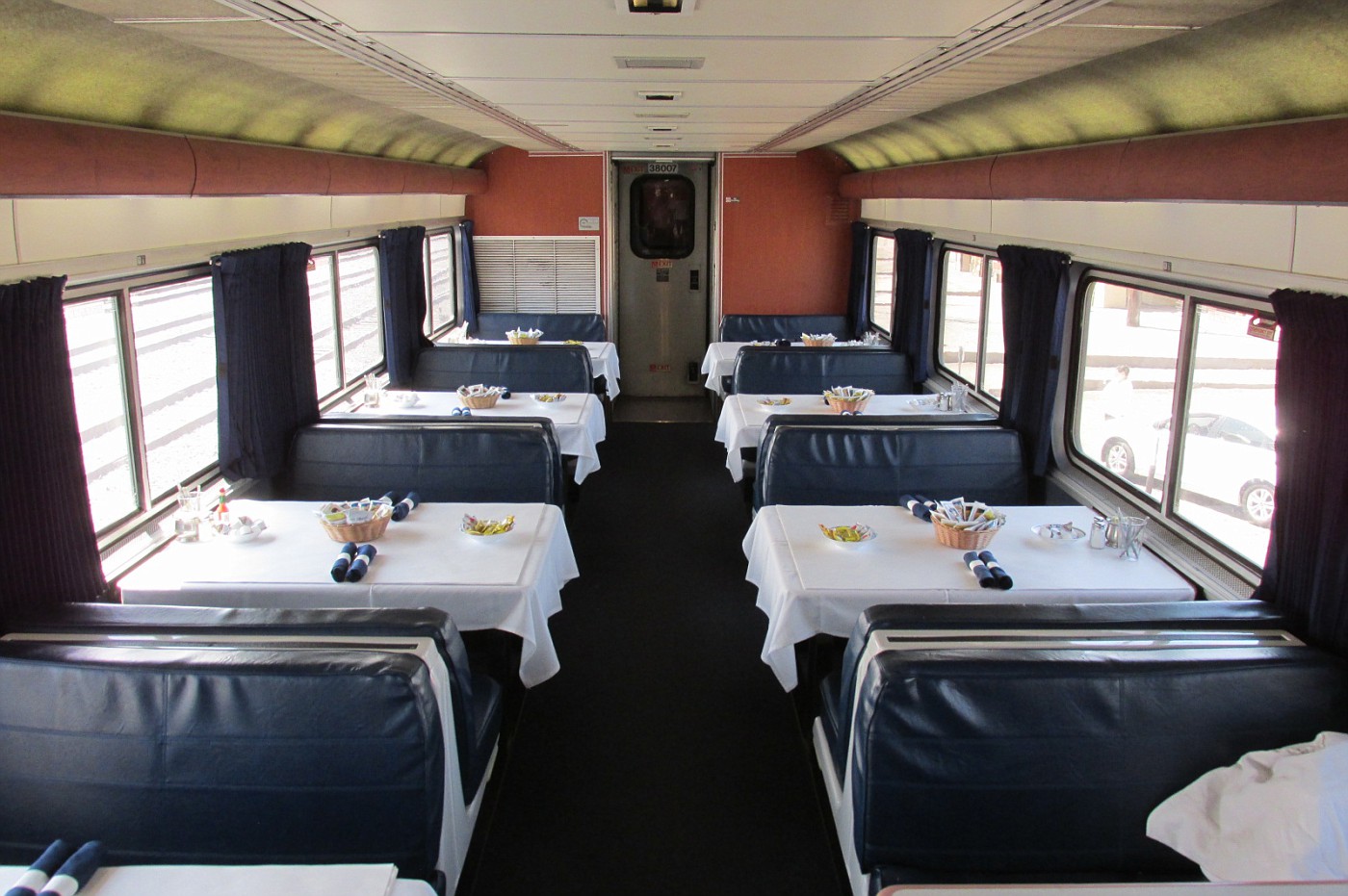
Dining Car – City of New Orleans
In January 2010, the Sightseer Lounge car was restored to the City of New Orleans, once again giving it two food service cars with the Cross Country Café serving as a full dining car and the Sightseer Lounge providing snacks and beverages.
Seating in Amtrak’s diners is communal and, as a dining car steward once put it – you’ll start out as strangers but you may end up as friends. I was led to a table already occupied by a retired couple from Galesburg named Margaret and Andy. Andy was originally from Poland but had lived in the U.S. for over thirty years. Soon we were joined by Carl, a foamer from Franklin, Tennessee.
A “Foamer”, you ask. What’s a “Foamer”?
“Foamer” is railroad speak for people who are so passionate about railroading that they practically foam at the mouth in their exuberance. Carl was wearing a t-shirt bearing the logo of his hometown railroad, the L&N, a.k.a the Louisville & Nashville. It was quickly clear that he really enjoyed riding trains. I know the term “foamer” sounds a bit derogatory but I certainly don’t mean to employ it as such. I’ve enjoyed the company of every foamer I’ve ever met, primarily due to their enthusiasm for the journey. In this regard I’m right there with the Carls of the world, even if I can’t keep up with their technical knowledge. I should add that when Carl wasn’t pursuing his favorite passion of riding trains around the country, he was an over the road trucker for a local freight company.
Introductions were exchanged, water was delivered and menus opened and perused. Let’s have a look at tonight’s MENU...
Hmm… I’ll go with the steak, please. Baked potato with all the trimmings would be fine, thanks! Andy also ordered the steak while Margaret went with the pasta and Carl ordered the chicken.
Every group of strangers inadvertently foisted upon one another develops their own dynamic – sometimes fun and entertaining, sometimes quiet and awkward like a group of people sharing an elevator ride. Thankfully, tonight’s group was fairly entertaining, much of that due to Carl and Andy. Andy started out rather quietly telling us that he had taught pharmaceutical science at a university in Illinois, but then somehow he got on to the topic of medical insurance and became quite animated, peppering his diatribe with multiple F-bombs. Medical insurance! I don’t know why but I actually found his angst rather amusing. Margaret had heard it all before but managed to keep a straight face throughout.
Our meals arrived and the topic soon changed to things like train travel, life in Alaska and how bumpy the ride had become. The tracks were really rough and as we hurtled northward at about 50mph, I couldn’t help but be mightily impressed with our waiter’s ability to carry trays of food around the car without having a single spill.
Carl pointed out that the route between Jackson and Memphis had been rerouted a few years earlier. The train had originally run over the traditional Illinois Central passenger route but over time that route was getting much more freight traffic and the cost of maintaining it to passenger standards for just one daily passenger train in each direction was becoming untenable. Amtrak agreed to reroute the City of New Orleans over to a line farther to the west and so it was that we were now speeding toward Yazoo City and Greenwood rather than Canton and Grenada. From Memphis north we’d return to the traditional mainline.
One point of interest here is the difference in track standards between passenger and freight. Tracks that serve primarily freight are often rougher. I am well acquainted with a couple of guys who have considerable freight hopping experience. Per their accounts, a ride in a boxcar is nowhere near the pleasant experience that’s it’s often depicted to be in the movies where friendly hobos relax on straw and share a cheap bottle of wine.
First of all, hardly anyone gets to ride in a boxcar anymore. Large modern boxcars have 400lb sliding doors and most of the time those doors are closed and locked. Because of their weight they’re extremely difficult for one person to open and this applies to both sides of the door. More than a few hobos have died during the summer months when the motion of the train caused a once open boxcar door to slide shut, trapping them inside on a hot day.
Another factor is shocks. Freight weighs a lot more than passengers and the shocks on boxcars are designed accordingly. So while the shocks on a boxcar might provide reasonable cushion to 15000lbs of freight, they do little to smooth out the ride for your average 180lb human being. For the hobo unfortunate enough to ride in an empty boxcar, speeding along at 70mph can quickly become a nightmarish experience.
That said, it was no joyride on the rough tracks we rolled over tonight. In addition to the rough ride, it was really noisy. The cars bump and scrape against one another much more vigorously over such rough tracks and the resulting cacophony was none too pleasant on the ears!
On a positive note, the 220 miles of rerouted track between Jackson and Memphis represented new trackage for me. I’ve ridden all but 430 miles of Amtrak’s national system so I was excited to add another line my route map. Although it’s not like I had any real memories of the old route, I found myself wishing there was more daylight so I could check out the new scenery.
Therein lies another attraction of train travel. Scenery. The New York Central used to advertise its route between New York and Chicago as the “See Level Route”. How true! Anybody who’s ridden a train through the spectacular scenery of the Hudson River Valley, the Colorado or Canadian Rockies, the Swiss Alps or even through the austere beauty of the African Veld or the Australian Outback can attest to how nice it is to be able to sit back in a comfortable arm chair and watch the world roll by.
What’s that? Another Gin & Tonic? Why yes, please.
Sorry about that – where was I? Oh yeah - just look at those mountains! And the rivers, lakes, valleys, glaciers, seashores, little towns, attractive old train stations and the people. Almost everybody waves when the train goes by. It’s a nice feeling. You don’t get to see stuff like this up close from an airplane.
As the modern society we live in has become increasingly faster paced, many of us have become increasingly separated from - or at the very least less appreciative of - the planet’s natural wonders. Look how many people trade in the view out their airplane window for the movie on the seatback IFE or whatever’s on the screen of their laptop. I can’t believe how many people don’t even bother to leave their window open for even a short while at the lower elevations, preferring instead to immediately close their shades the moment the plane takes off. I understand that air travel is a lot more commonplace than it once was and that the novelty of flight has long since worn off, but as terrestrial beings even those of us who fly a lot don’t often get to see world from the unique vantage point of an airliner thousands of feet above the earth. I like to check out the view, especially at the lower elevations.
I know what some of you are thinking – “Hey buddy! I fly 100000 miles a year! Don’t talk to me about the uniqueness of the view from on high! I see more than enough of it each year!” To which I say “Pffft!” Let’s look at some numbers.
• Last year I flew 293,180 miles, which amounted to 643 hours and 10 minutes spent in the air.
• That’s the equivalent of 26 entire days and about 18 hours in change.
• That means I spent 7.34% of the year in the air.
• Assuming I got 8 hours of sleep each night (yeah, right!), let’s increase that figure by a third to reflect that I spent 9.8% of my conscious hours during the year aloft.
• Out of the 16 hours that I was presumed conscious each day, let’s deduct another four hours for darkness when there was nothing to be seen. Now the percentage of time I spent conscious and aloft during daylight hours throughout the year rises to 12.25%.
• Now let’s say I spend 25% of each flight actively looking out the window (as if I’m really going to spend one entire hour actively looking out the window on a four hour flight!) and the percentage of time that I’m conscious and looking out the window drops to about 3%.
My point is that for most of us, only a tiny fraction of our conscious lives each year is spent inflight. The above numbers reflect having spent way more time in the air than the average person, including frequent flyers. And yet, out of all that time aloft only 3% or 1.8 seconds per minute is spent checking out the scenery. For those of you who actually do average 100000 miles per year of flying, divide the above numbers by about one third. Now you’re at just over ½ second spent per minute actively checking out the view below. Uh huh... And now let’s say you only average 50000 miles per year inflight. Make that about ¼ second per minute checking out that scenery!
For what it’s worth – strictly as a point of reference and/or possible entertainment on a slow day – since January 1st of 2002, I’ve averaged 180,348 miles of flying per year, having logged 2059 flights totaling 2,344,530 miles over the thirteen years since then. In terms of time aloft that comes to 5,150 hours or the equivalent of almost seven months aloft. I honestly have no idea how much time I’ve spent looking out my window but being as I live in one of the most dramatically beautiful places on the planet – Alaska – it’s hard not to resist taking a peak or three at nature’s grandeur as it passes beneath me. To be sure, I look more than most people.

Sunset fjord FAI-SEA
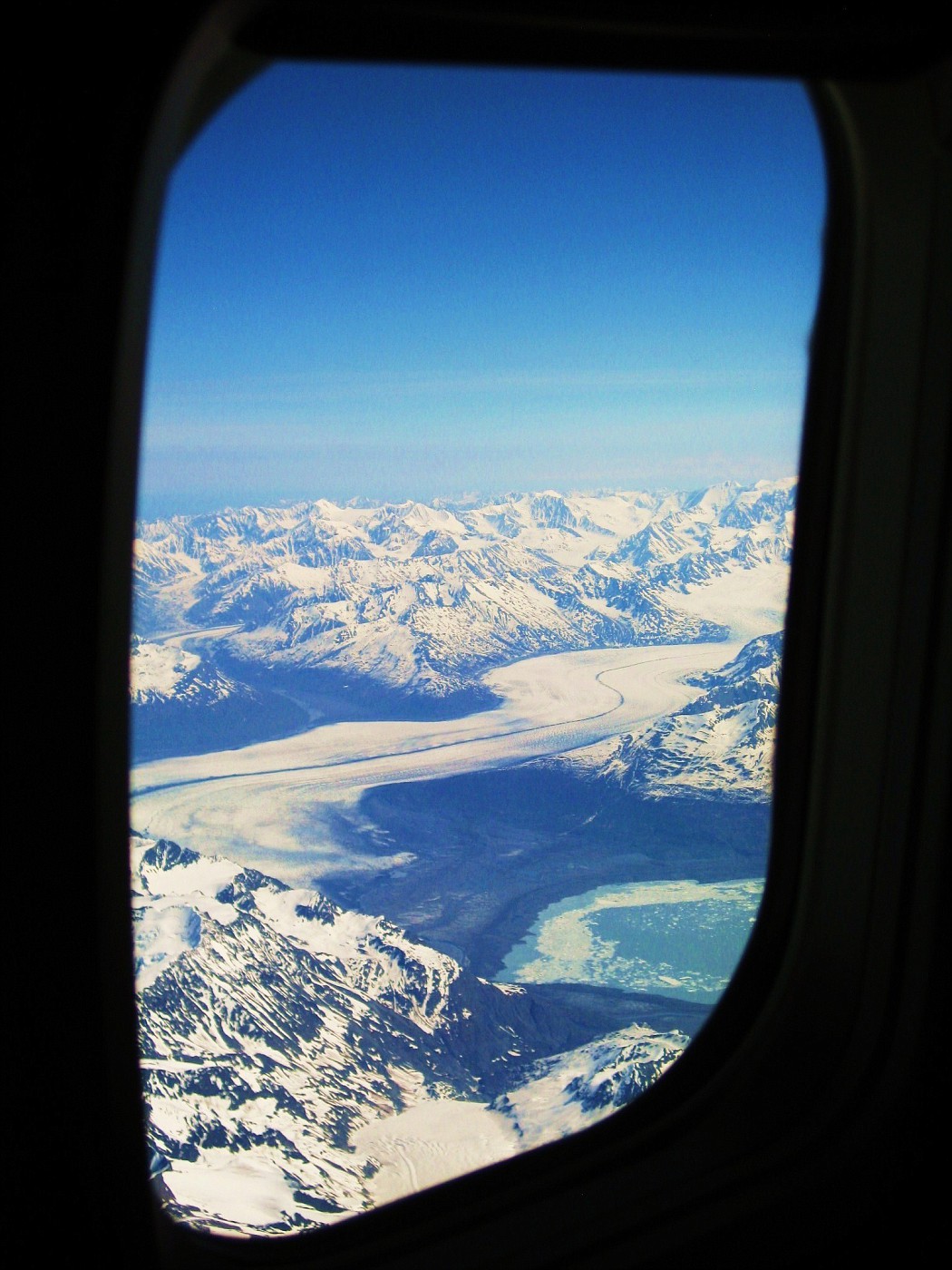
Glaciers between Anchorage and Seattle

Prince William Sound
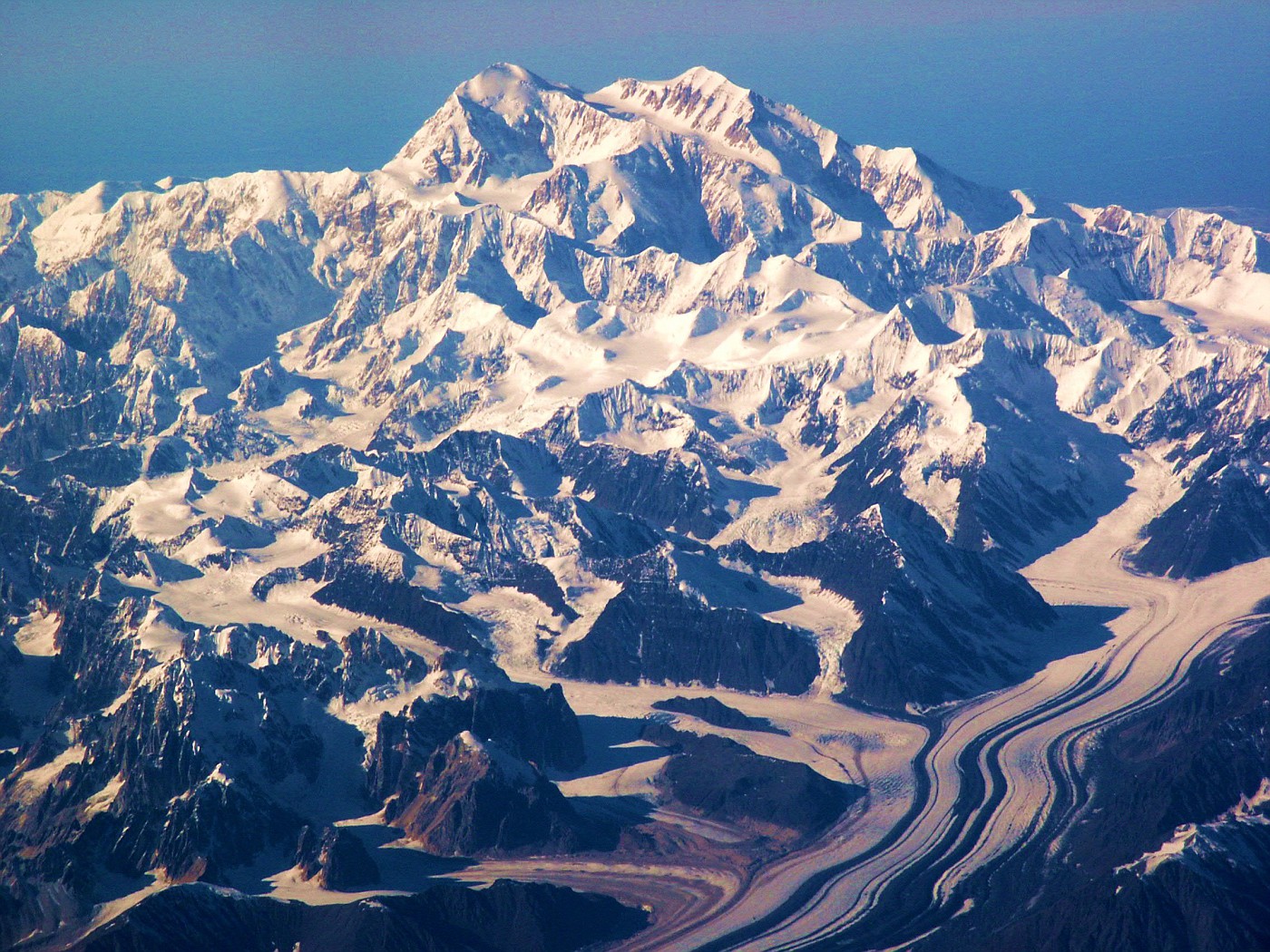
Denali
Many claim that there’s nothing to see from 38000 feet up. Often times that’s true due to clouds, darkness or flight paths over central Kansas or the ocean. Then again, sometimes the beauty emanates from above. I have enjoyed innumerable spectacular cloud formations and sunsets from aloft. I also remember the tranquil beauty of the Pacific Ocean on a warm afternoon jetting between Santiago and Mexico City.
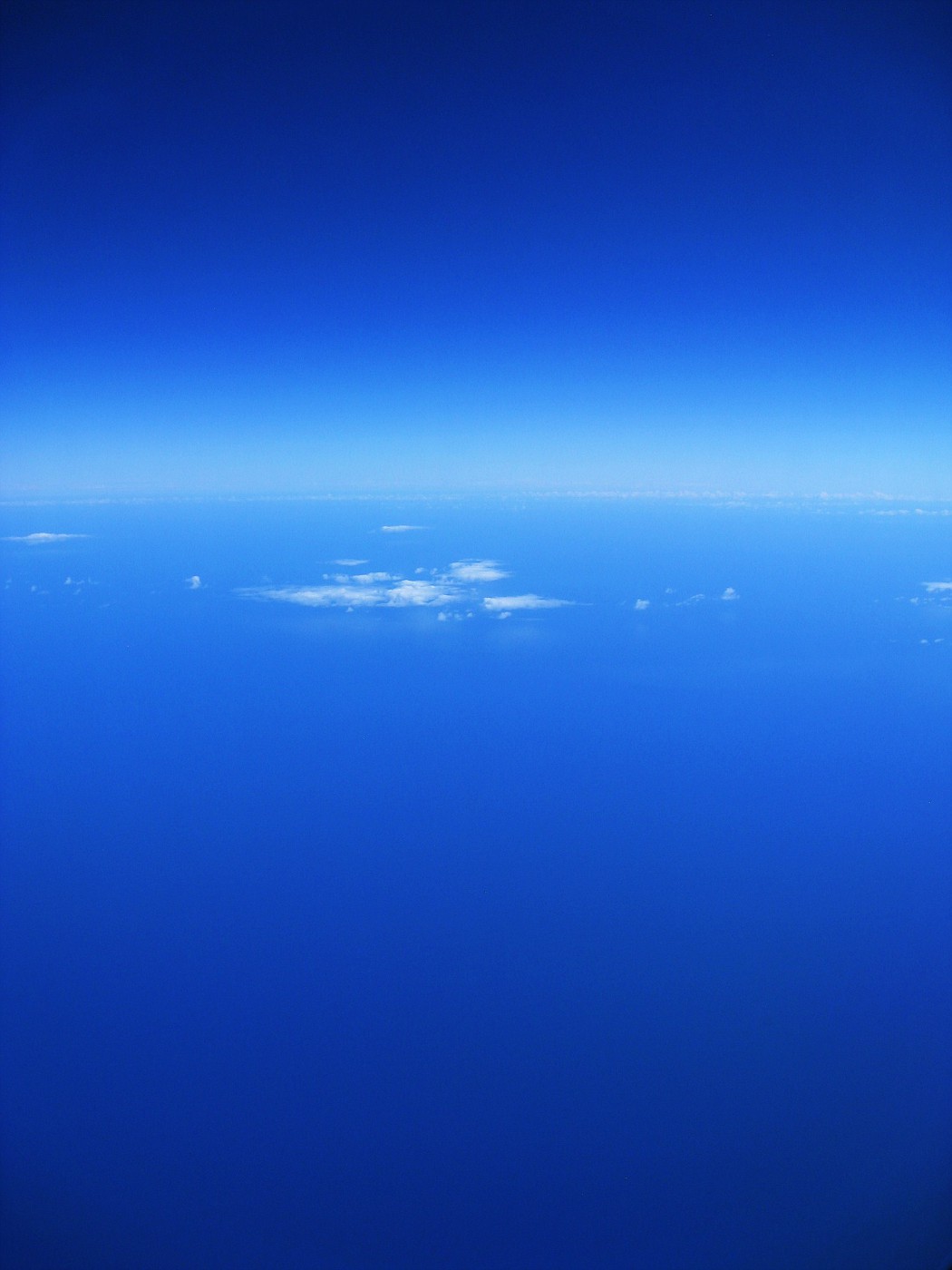
Pacific splendor 800 miles west of Lima, Peru
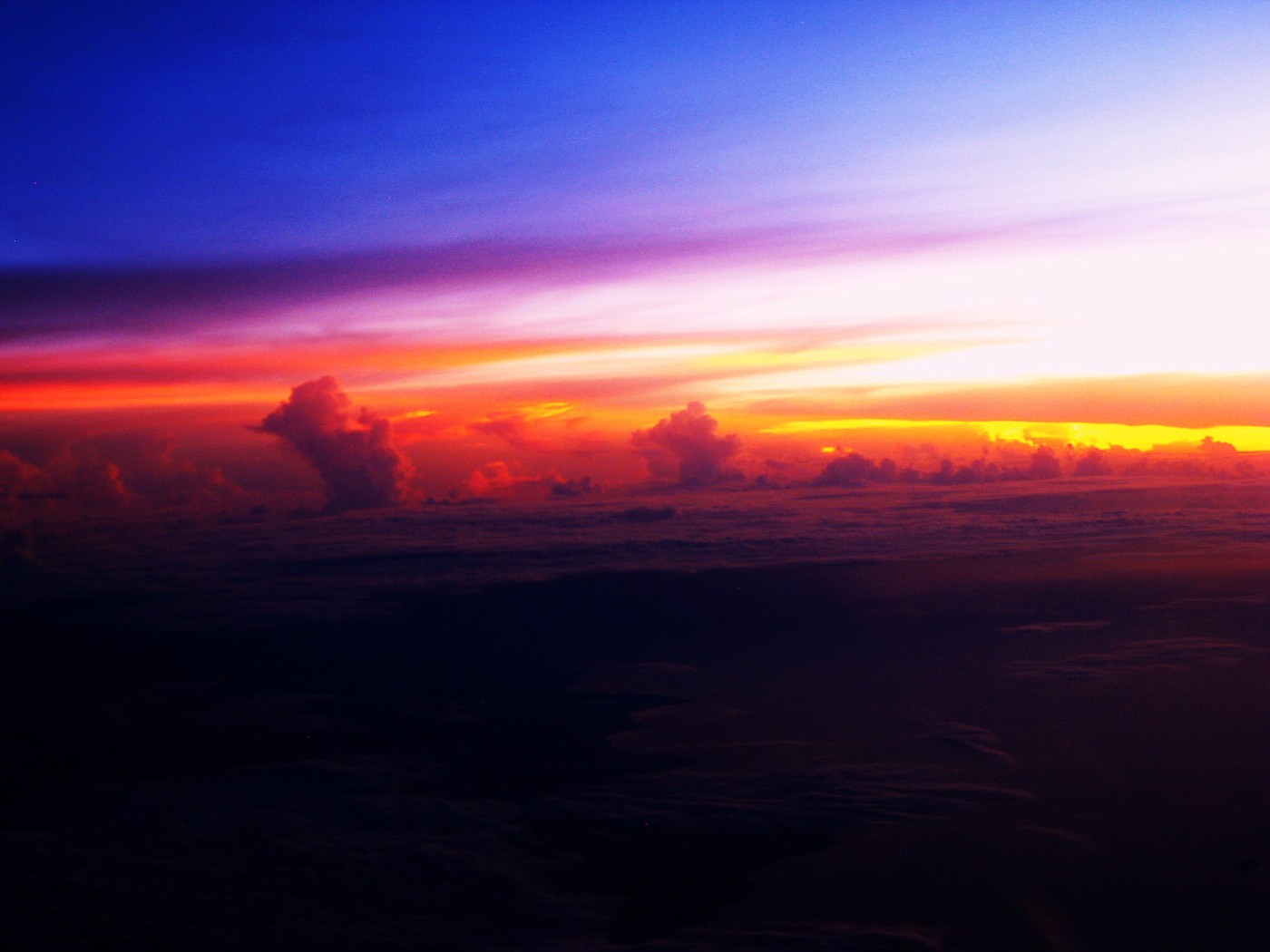
Sunset over the Coral Sea
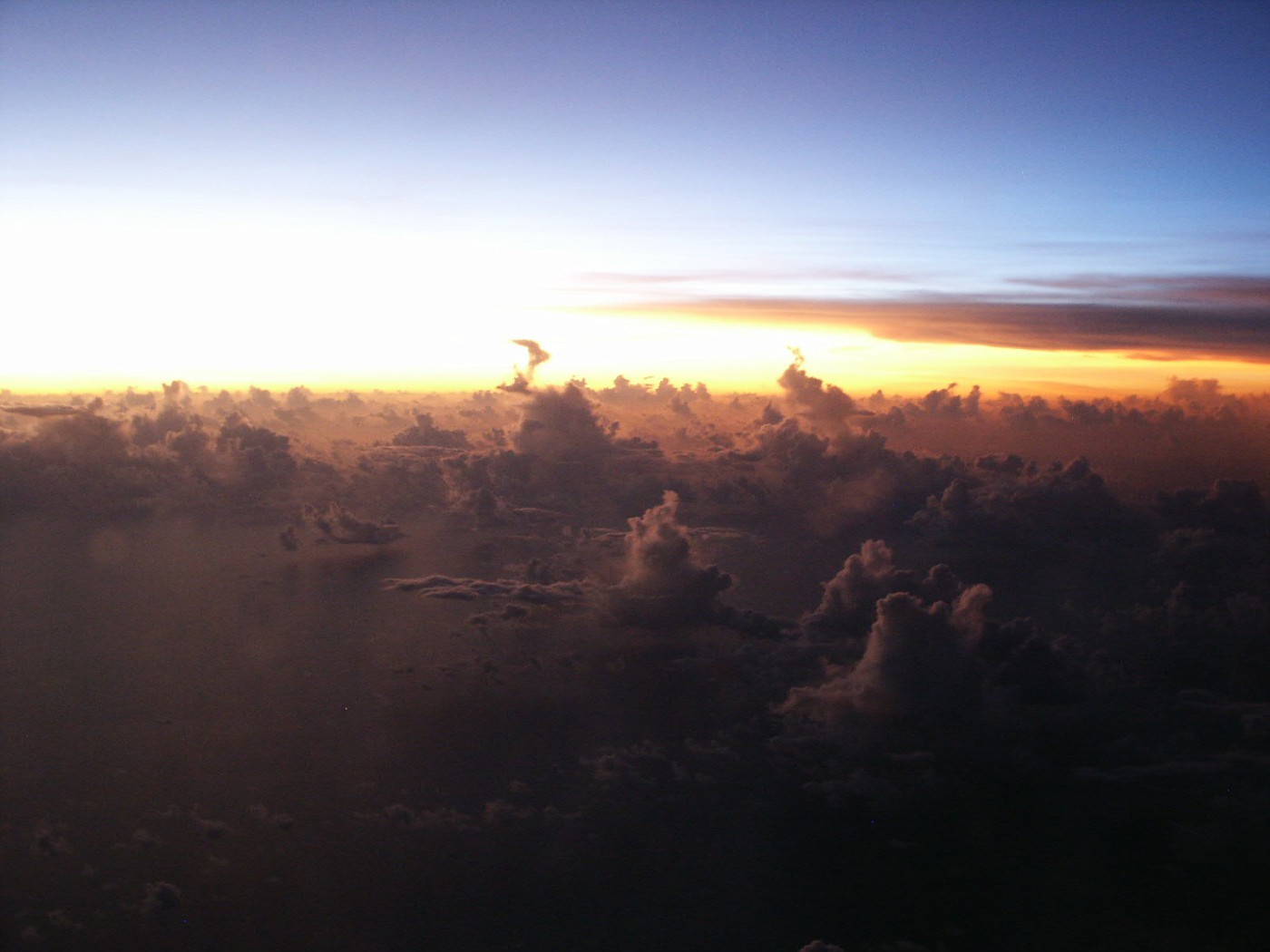
Heavenly clouds over the Java Sea
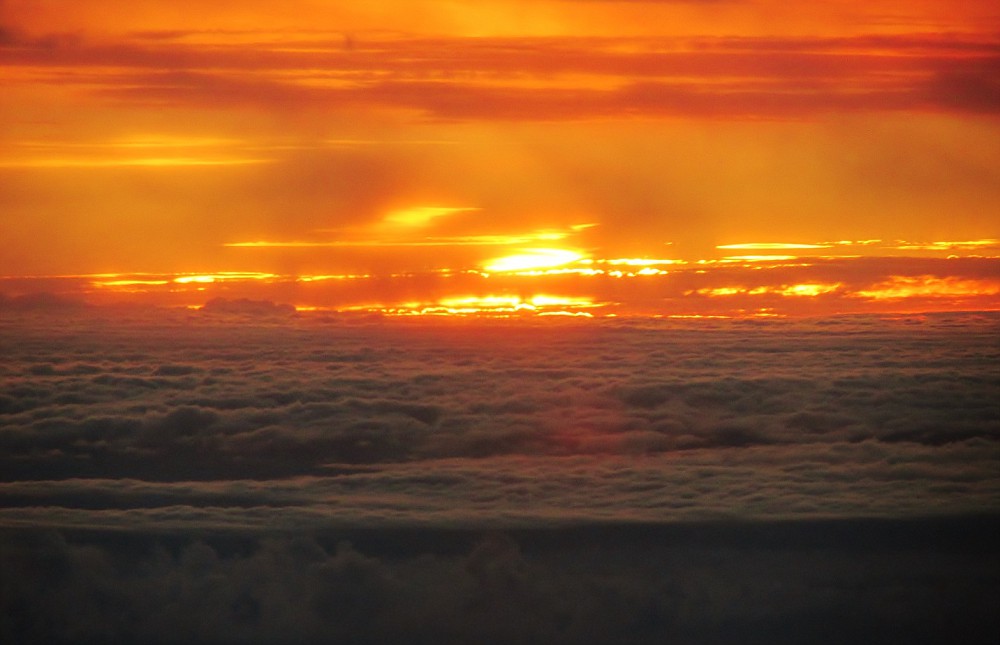
Fire in the sky
Granted, beauty is in the eye of the beholder. I see a lot of it in many different forms from aloft. What a shame that less and less people take the time to check it out these days, instead preferring the artificial substitute provided via their laptops or seatback IFEs.
But wait! I thought we were riding a train here…
Yes we are. And to that end, the scenery is even more front and center. Unfortunately though, it’s dark right now. We just pulled out of Greenwood, Mississippi about fifteen minutes ago. Our next major station stop, Memphis, won’t be coming up for another couple of hours yet. Now is an excellent time to check out another reason why travel by train can be so enjoyable. Let’s head back to the Lounge Car.
It should be noted here that lounge cars have long been synonymous with American train travel. The United States is a large country and traveling across its expanse by rail can often take days rather than hours. Lounges are wonderful places to break the tedium of long journeys and in the process share the experience with your fellow travelers. Here are some examples from America’s golden days of rail travel…
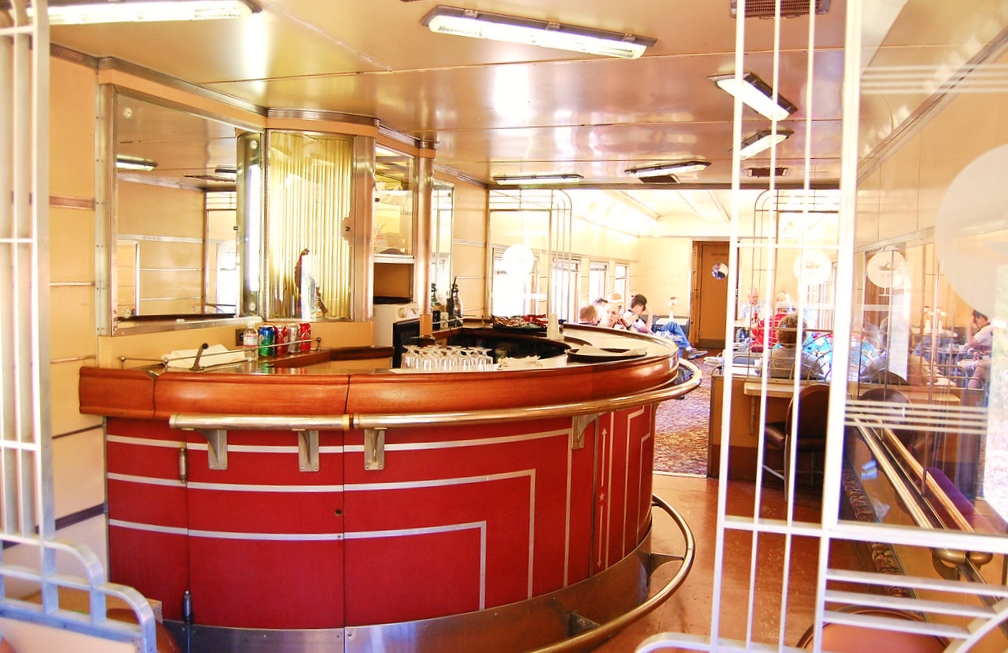
Southern Pacific Daylight Club Lounge
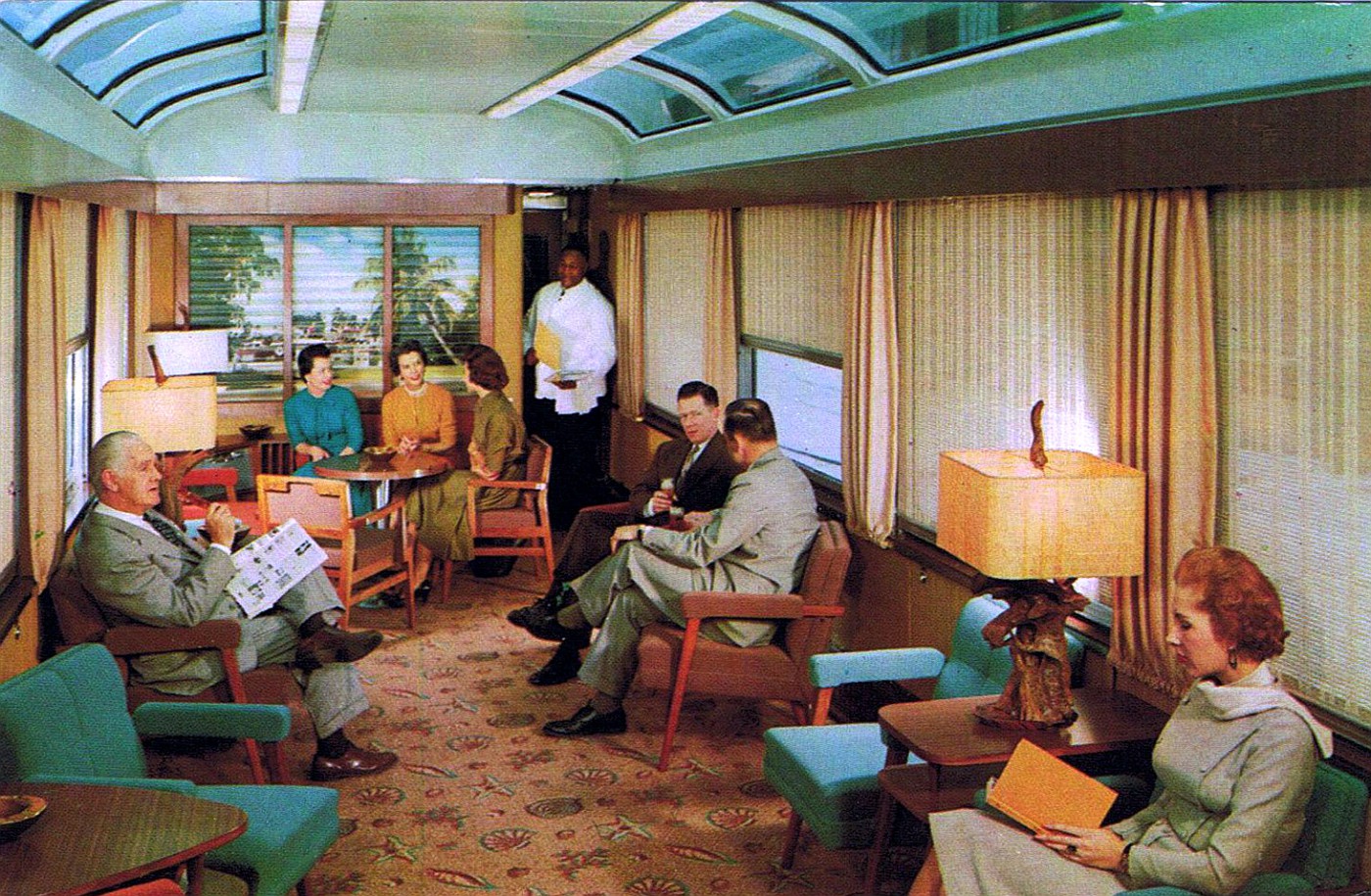
Seaboard Lines’ Silver Meteor Sun Lounge
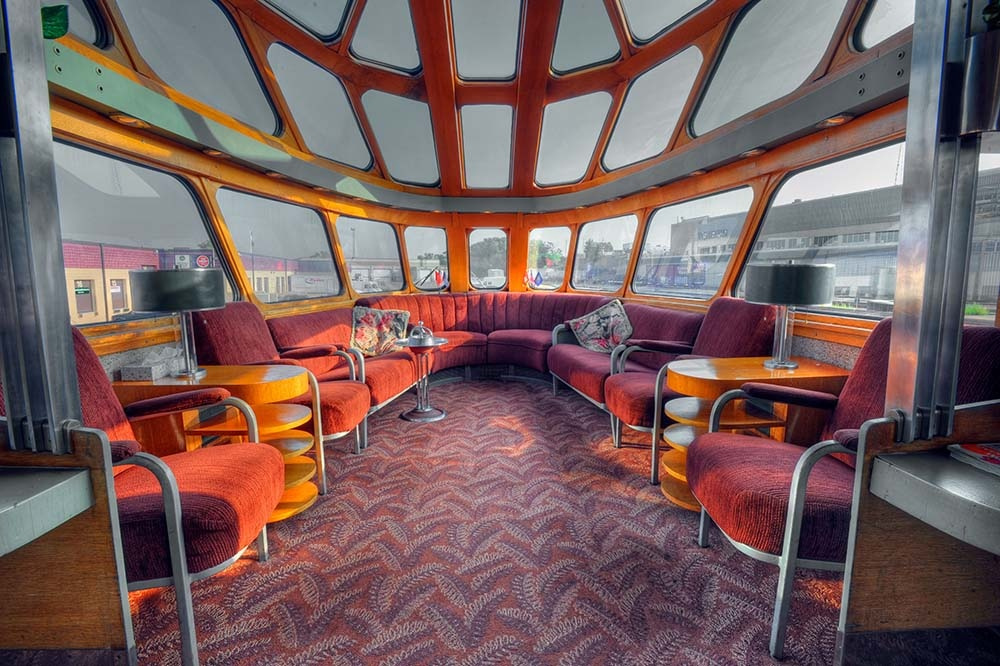
Milwaukee Road’s Hiawatha Dome Lounge
Amtrak’s Sightseer Lounge Cars are available on all long distance trains operating from Chicago to the West Coast, Texas and New Orleans. They are available to all passengers regardless of class traveled. The only train east of Chicago that offers them is the Capitol Limited which operates between Chicago and Washington, DC. The reason you don’t see them back east is because most of the old tunnels and overpasses are not high enough to allow for the 16’ height of the bi-level Superliner cars.
The Sightseer lounges are configured with half the upstairs level offering buffet style seating around tables and the other half providing individual swivel seats and couches that face toward the windows. Downstairs is snack bar that sells a variety of lighter meals such as hot and cold sandwiches, snacks and beverages including alcohol. Four or five buffet booths supply the seating. I was looking for a table on the upper level but when I entered all of them were occupied.
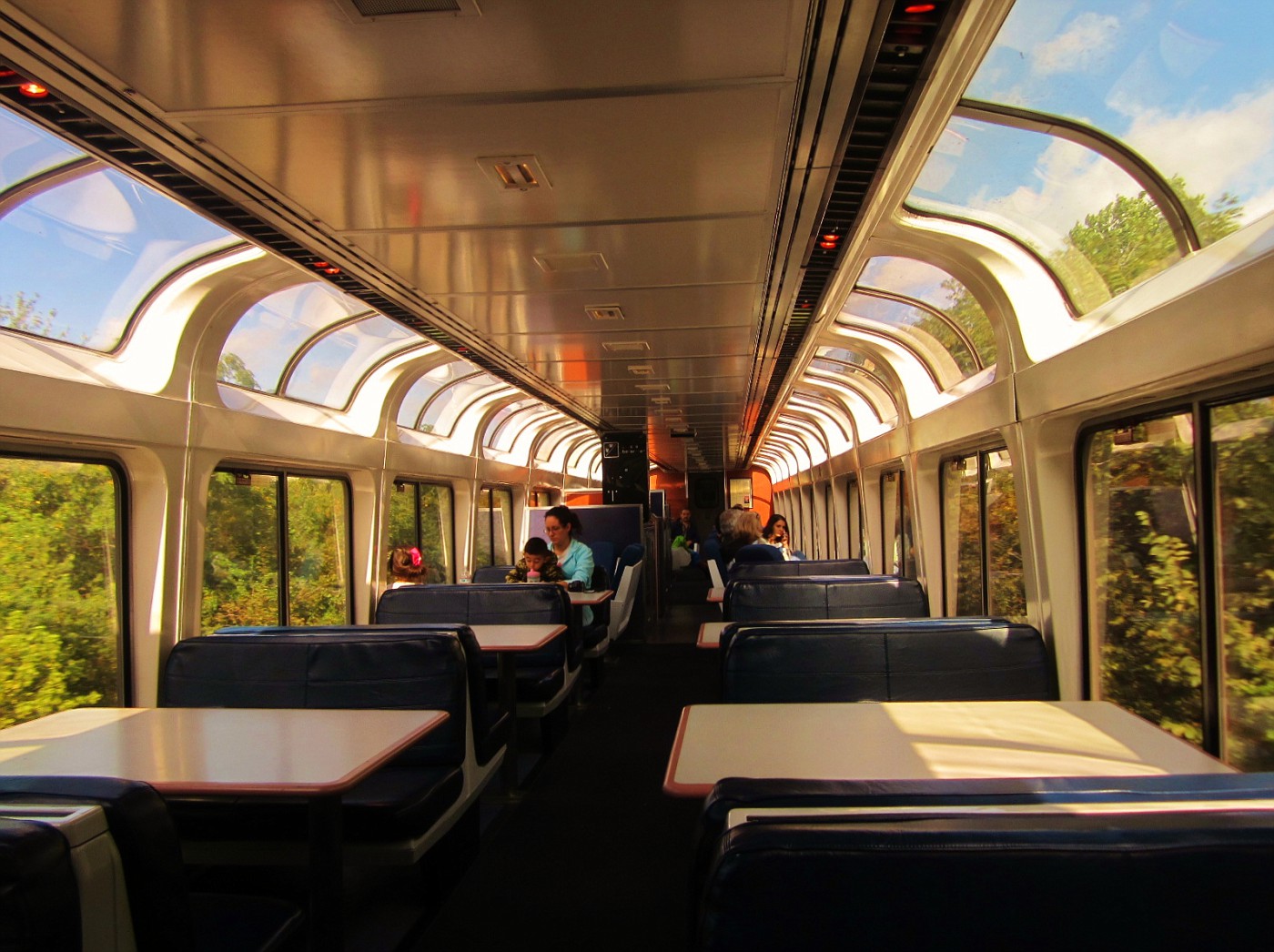
Amtrak’s Sightseer Lounge
As I lurched down the aisle surveying my options, a couple at one of the tables beckoned me over and invited me to join them. Meet Dave and Michelle from Appleton, Wisconsin. They were returning home from a week’s vacation in Louisiana with their two teenaged children who were somewhere else on the train and so there was plenty of room at the table.
They both had drinks in hand and I soon joined them with a Jack Daniels on the rocks. I don’t remember what all we talked about but I do recall that it was like we’d known each other for years and conversation flowed easily. Eventually their kids did show up and they were just as nice and engaging as their parents. I really enjoyed the company of these folks and as will happen in circumstances like this, the hours just melted away.
People who’ve never taken a long distance train trip often worry that they’ll be bored. I’d say that depends on the person. If I make it sound as if I enjoy meeting other travelers and sharing experiences with them, it’s because I do. However, I don’t require that interaction and I’m generally not one to initiate it. On airplanes I’ll say hello to my seatmate when I arrive but unless he/she chooses to initiate further conversation, I’ll happily spend the rest of the flight wrapped up in a book, working on my laptop, listening to music or sometimes even checking out the scenery. I’m the first person to recognize and respect that for some people, travel often represents the best opportunity they get to enjoy a bit of peace and quiet.
As for potential boredom on trains, I’ve already pointed out the scenic and social opportunities available as I’ve experienced them. Whether you choose to interact with your fellow travelers is totally your call. Consider too that I’m traveling alone. For those that aren’t, there’s always a spouse-partner-friend-children to spend time with as well. Conversation notwithstanding, I’ve also seen some pretty rousing board and card games being played in the lounge car.
It was a little past 11 when we called it a night. Dave, Michelle and their kids retired to their seats back in the coaches while I headed forward to the sleepers. Lisa (my car attendant) had already changed my roomette over to its nighttime configuration. Waiting for me was a 6’6” bed made up with sheets and a blanket along with two pillows. I’ve always found the blanket a bit thin and the sheets on the 28” wide mattresses a bit constricting, so I bring along my own larger and heavier wool blanket under which I sleep much more comfortably.
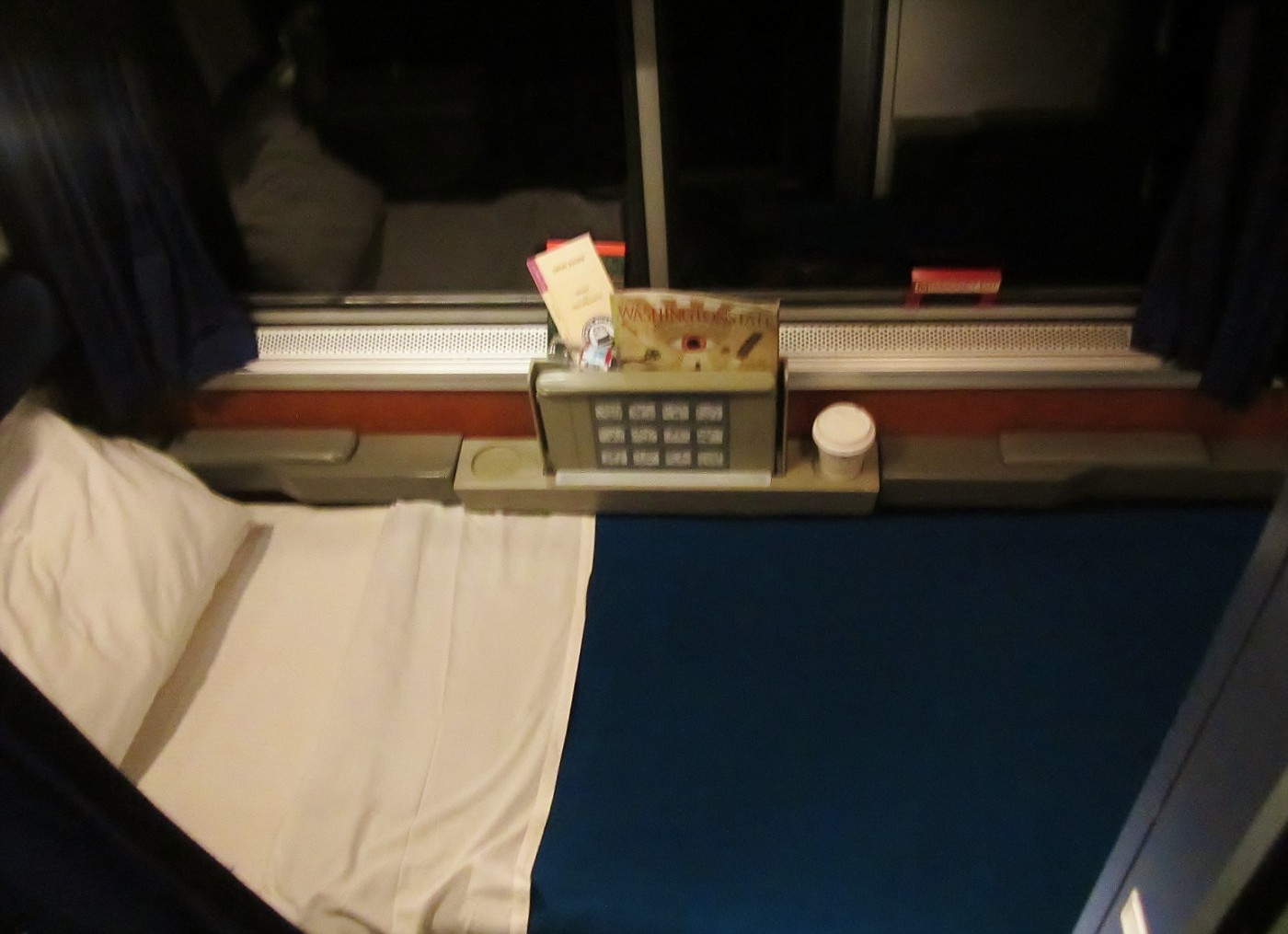
Bedtime on the City of New Orleans
It was about 4:00am when I first awoke, book on the floor and my reading light still on. We were sitting at the station in Centralia, Illinois and the bright light from the sodium halide lamps illuminating the empty platform outside my window had evidently woken me up. Since departing Memphis the tracks had improved considerably, and the gentle rocking motion and rhythmic clickety-clack of the rails (not to mention three Jack Daniels) had lulled me to sleep before I’d had a chance to book mark my place and turn out the light. I closed my curtains and then fell back to sleep for another three hours, awaking shortly after we’d departed Champaign-Urbana.
Swinging my feet to the floor, I discovered that a copy of USA Today had thoughtfully been placed under my door. Throwing on a pair of pants, I took the stairs up to the service area where hot coffee and chilled orange juice awaited. A cup of each and the day’s news tided me over until the shower became available a few minutes later. There was no shortage of hot water and the big, thirsty towels were a welcome treat after the invigorating shower.
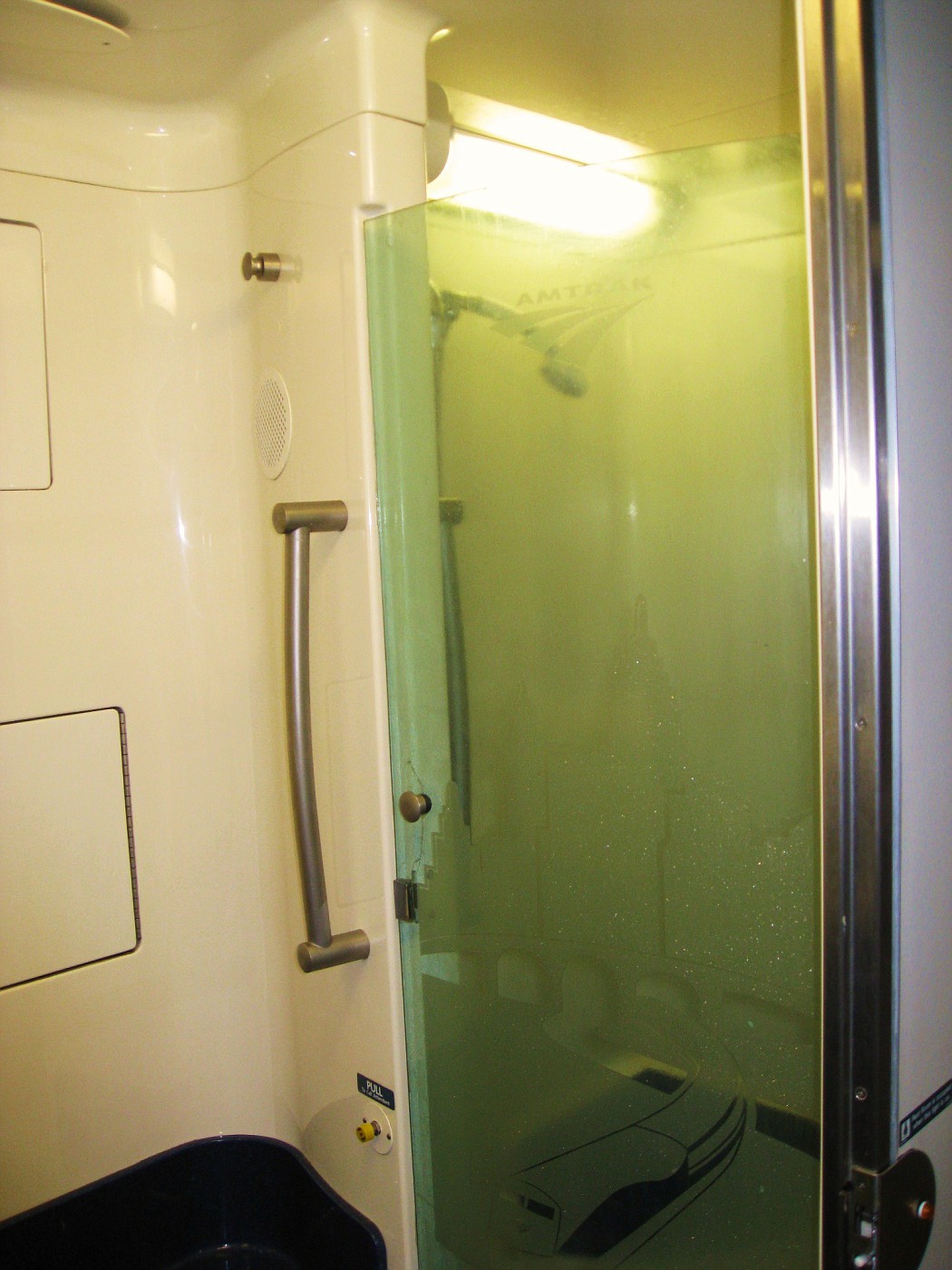
Amtrak Superliner Shower
Surprisingly, I ended up with a table to myself for breakfast. No worries! Newspapers have made wonderful breakfast companions over the years. Lunch is more of a social affair with coworkers and dinner is social with friends and family so really, outside of a plane or train, breakfast is often the best time I get to catch up on what’s going on. And you know what they say about the nation’s leading daily ~ If it’s in USA Today, it must be true!
Returning to my roomette, I repacked my bag and sat down to await our arrival into Chicago’s Union Station. It’s interesting to watch the transition as wide open country morphed into settlements, then towns, then suburbs and finally city proper as we drew ever nearer to the station. The yards outside of Union Station are quite large and for train spotters they occasionally yield some interesting sights. I took note of some old E-8 locomotives with their classic 1950s hoods along with some derelict looking double decker passenger cars from Metra, the local commuter line. A few Amtrak Superliners were parked in the distance as well as a nice looking private car that appeared to be wearing the attractive brown and orange livery of the Illinois Central’s crack streamliner “The Panama Limited”.
It was 9:25 by the time we’d eased to a stop on the platform underneath the station. That’s only twenty-five minutes late – not bad, not bad! For a train that must contend daily with bad tracks and inhospitable host railroads, a 25 minute delay is actually pretty good. Alighting from the train, I bestowed a well-earned tip upon Lisa and thanked her for a job well done. In return I got a pretty smile and an invitation to come back and do it again sometime. I tossed her a wink and said “Gimme five hours, Sweetheart, and I’ll do just that!”
Although there has been a train station operating since 1858 on the spot occupied by today’s Union Station, the current station only dates back to 1925. In fact, it is said to be the third station to operate there. I don’t believe there will be a fourth. The current station is massive, taking up approximately nine and a half city blocks. Built in the popular Beaux-Arts style seen in stations at Kansas City, St. Louis and Denver to name just a few, Union Station is known for its distinctive Corinthian columns and magnificent Great Hall. The station was recently designated as one of America’s “Great Places” by the American Planning Association and for those that have an hour or two between trains, it’s worth having a look around.
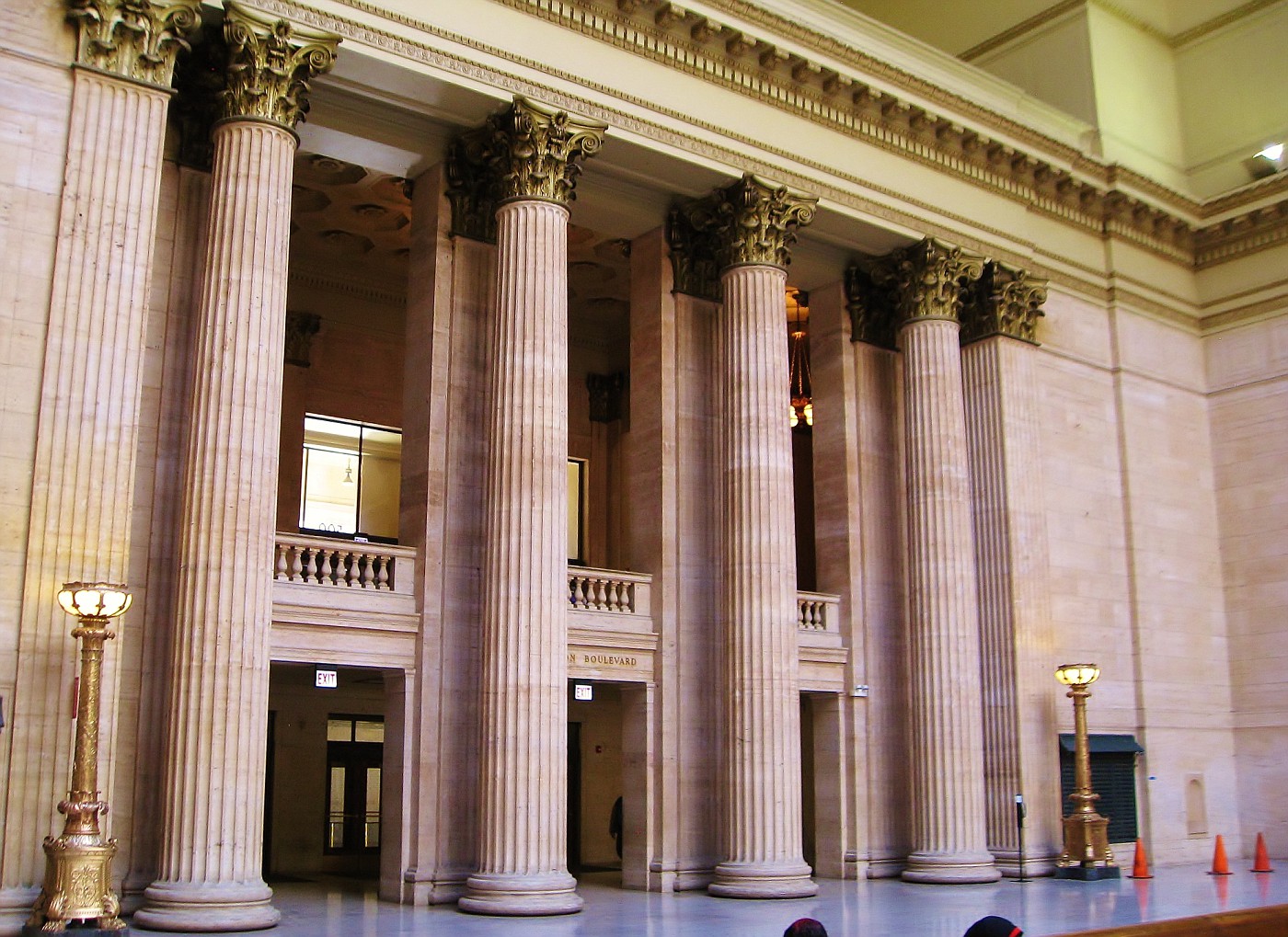
Chicago Union Station Great Hall

Chicago Union Station Great Hall
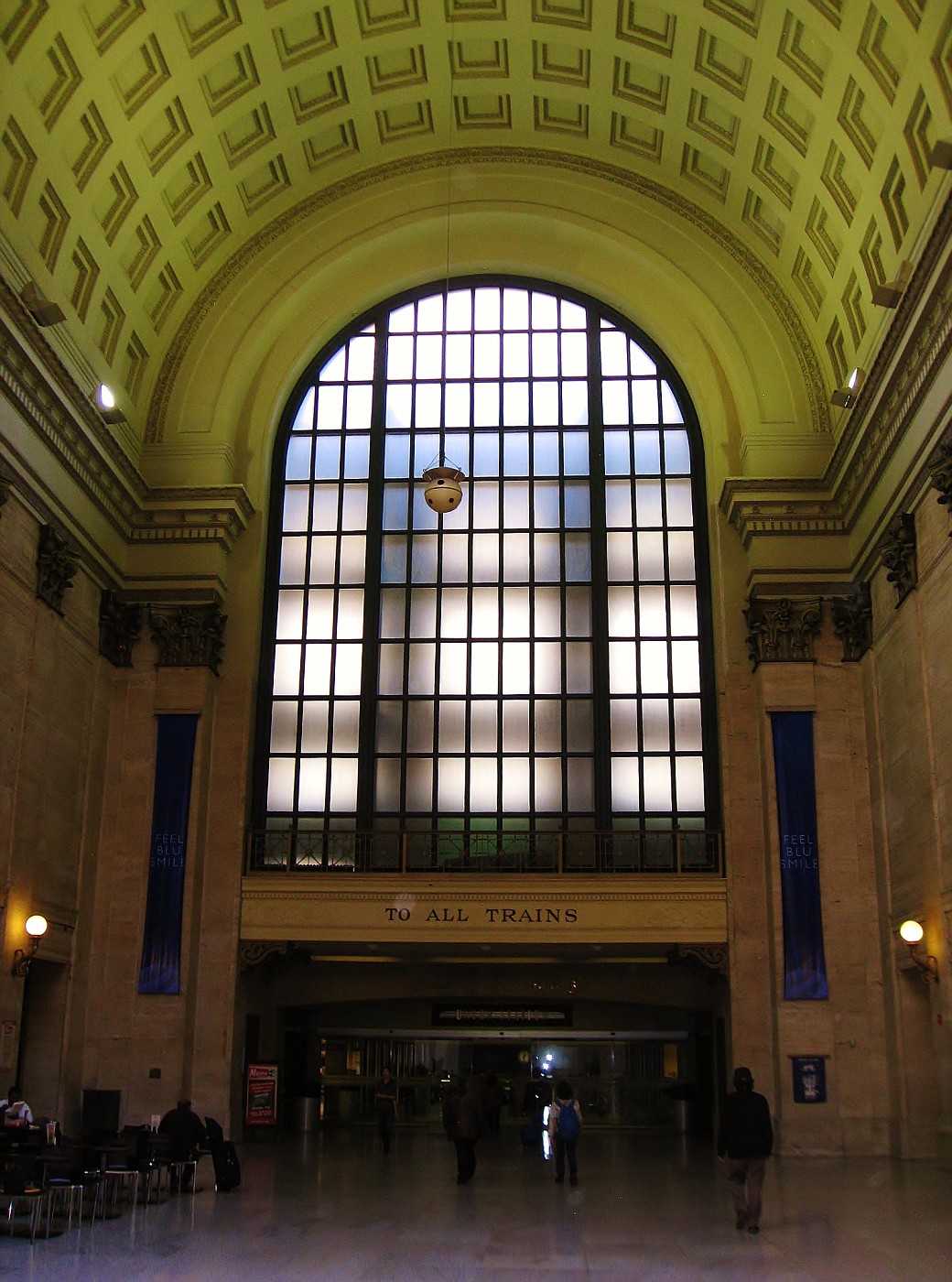
Chicago Union Station Great Hall
So – what to do in Chicago for five hours. In a city this size I’ve no doubt books could be written on the subject! I used to get together with a friend who lived up in Deerfield but he went and chased a girl and/or a job all the way out to Galena, Illinois. I seem to recall invitations from one or more Chicago based Flyertalkers to join them for a beer or two but it’s been so long that I can’t remember which ones they were. I ought to keep an appointment book. I suppose I could’ve gone over to the Communities forum and posted notice of my impending arrival but that just feels a bit too presumptuous – to me, at least.
No, I’ll be just fine on my own, thanks. The first order of business was storing my bag, not always such an easy thing to do given the concerns and security protocols in place following 9-11. Thankfully Union Station has a couple of options for baggage storage – one consisting of public lockers and the other reserved for First Class passengers in the Metropolitan Lounge. That’d be me.
Exiting the station, I headed across the street to the pick-up point for the Shoreline Water Taxi. My now Galena based friend introduced me to the water taxi a few years ago and per my experience it is an excellent and inexpensive way to see Chicago and in particular the architecturally magnificent buildings for which the city is rightfully famous. Unfortunately today’s skies weren’t quite as photogenic as those from my last visit, so I’m going to post a few pictures from that one instead.
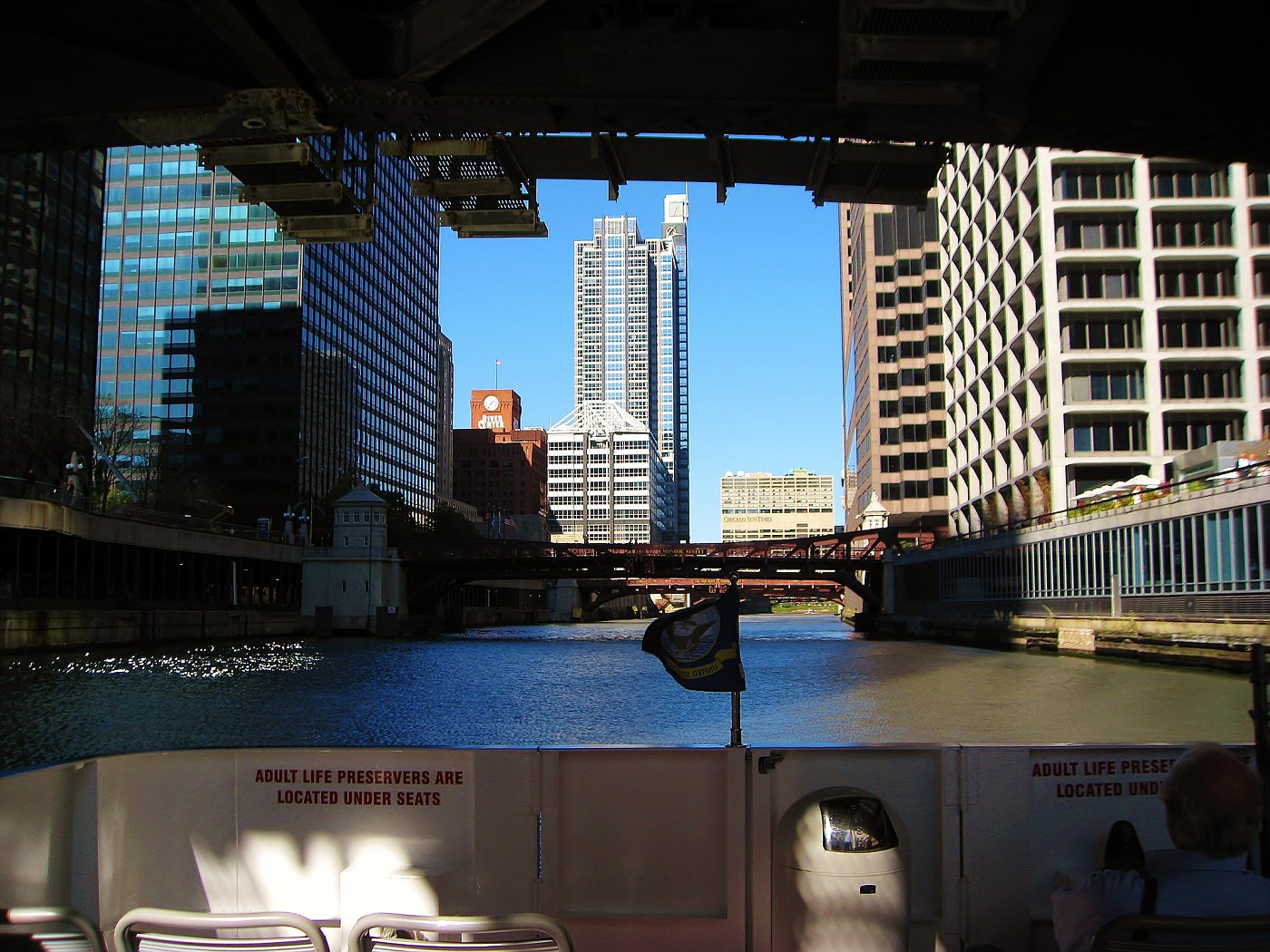
Chicago Skyline as seen from the Chicago River
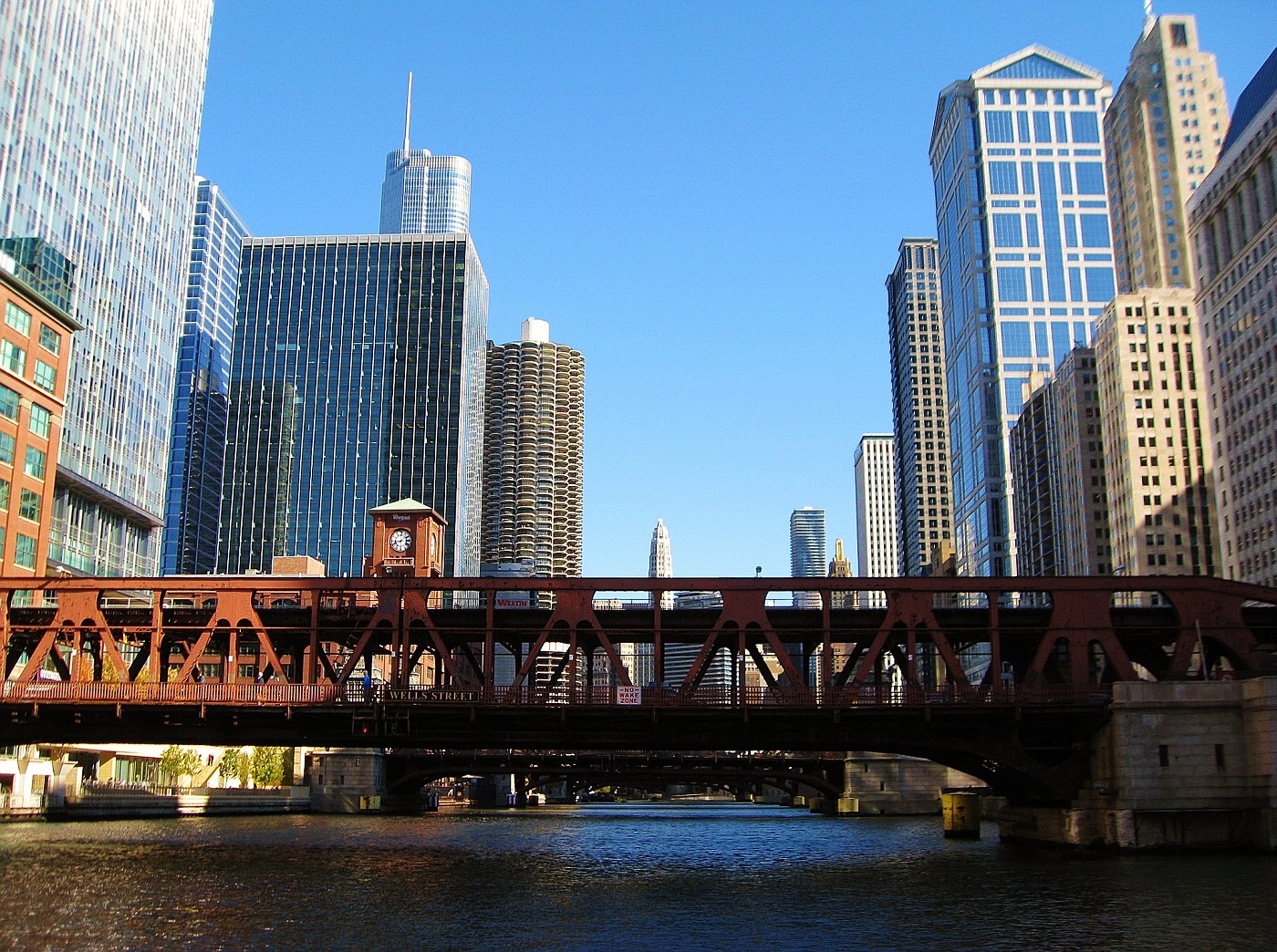
Chicago Skyline as seen from the Chicago River
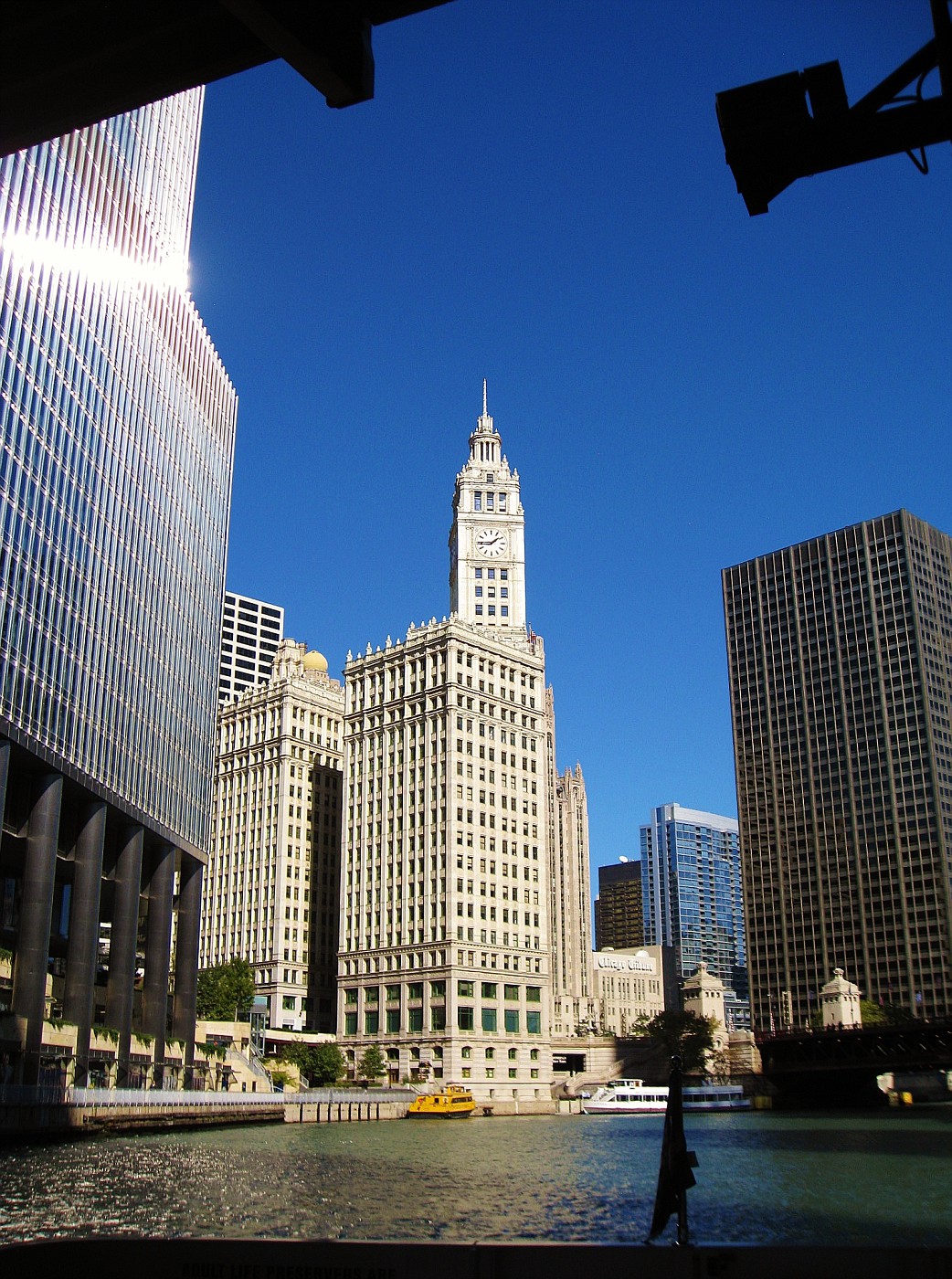
Chicago Skyline as seen from the Chicago River

Chicago Skyline as seen from the Chicago River
It’s a short walk from the Michigan Avenue stop to the famous Billy Goat Tavern. Aside from being a classic old sports bar, the Billy Goat Tavern was also the inspiration for the 1970s Saturday Night Live skit featuring John Belushi slinging burgers and hollering “Cheeze-borger! Cheeze-borger! No Coke! Pepsi!”
Whaaaat? Y’all don’t remember that one? Jeez, I’m getting’ old!
Speaking of sports, I was sat at the bar next to a couple of guys who’d come in for a beer and a burger before heading over to Wrigley for that afternoon’s game against the Diamondbacks. We talked baseball a bit and it was nice to see they were still guardedly optimistic for the Cubbies to have a decent season. Enjoy those good feelings now boys, because reality should set in within the next month or so. If ever there were fans of a team for whom hope springs eternal, it’s Chicago Cubs fans - especially at this time of year when it’s early in the season and not enough time has elapsed for the diehards to become resigned once again to the team’s inevitable elimination from post season participation.
Even though I never lived in Chicago, I was a big fan of Mike Royko, the Chicago Sun Times columnist. Royko brought old fashioned blue collar sensibility – not to mention humor – to everyday life. Here’s an excerpt from an early season interaction with his friend, fervent Cubs fan Slats Grobnik:
Slats: “How bout them Cubbies? They’re lookin’ pretty good this year, yeah?”
Royko: “Yes, they are. Hair neatly combed, no pimples…”
Time flies when you’re having fun. A glance at my watch indicated it was 12:15pm and I still needed to do a bit of shopping prior to the 3:00pm departure of my next train – the Southwest Chief – bound for Los Angeles. Making my way back to the station, I headed across the street to a CVS Pharmacy where beer, bourbon and mixed nuts could be purchased at very reasonable prices. Now properly supplied for the next two days on the rails, I returned to the Metropolitan Lounge to await the call to board.
It should be noted here that even though Amtrak’s Metropolitan Lounge is a perk for First Class travelers, it is hardly a lounge to get excited about. Beyond a bit of peace and quiet relative to the crowded waiting areas out in the station, it offers little in the way of food, beverages or even ambience. Packets of Goldfish crackers were the only food offerings while beverages were limited to coffee and a couple of soft drinks from a dispenser. Muted green and beige comprised the colors while wood trim strived valiantly to provide a bit of class to the mortuary like ambience of the lounge. On a more positive note, there was Wi-Fi access so over the next hour or so I did manage to do a pretty good job of finally cleaning up my email account.

Amtrak’s Metropolitan Lounge in Chicago
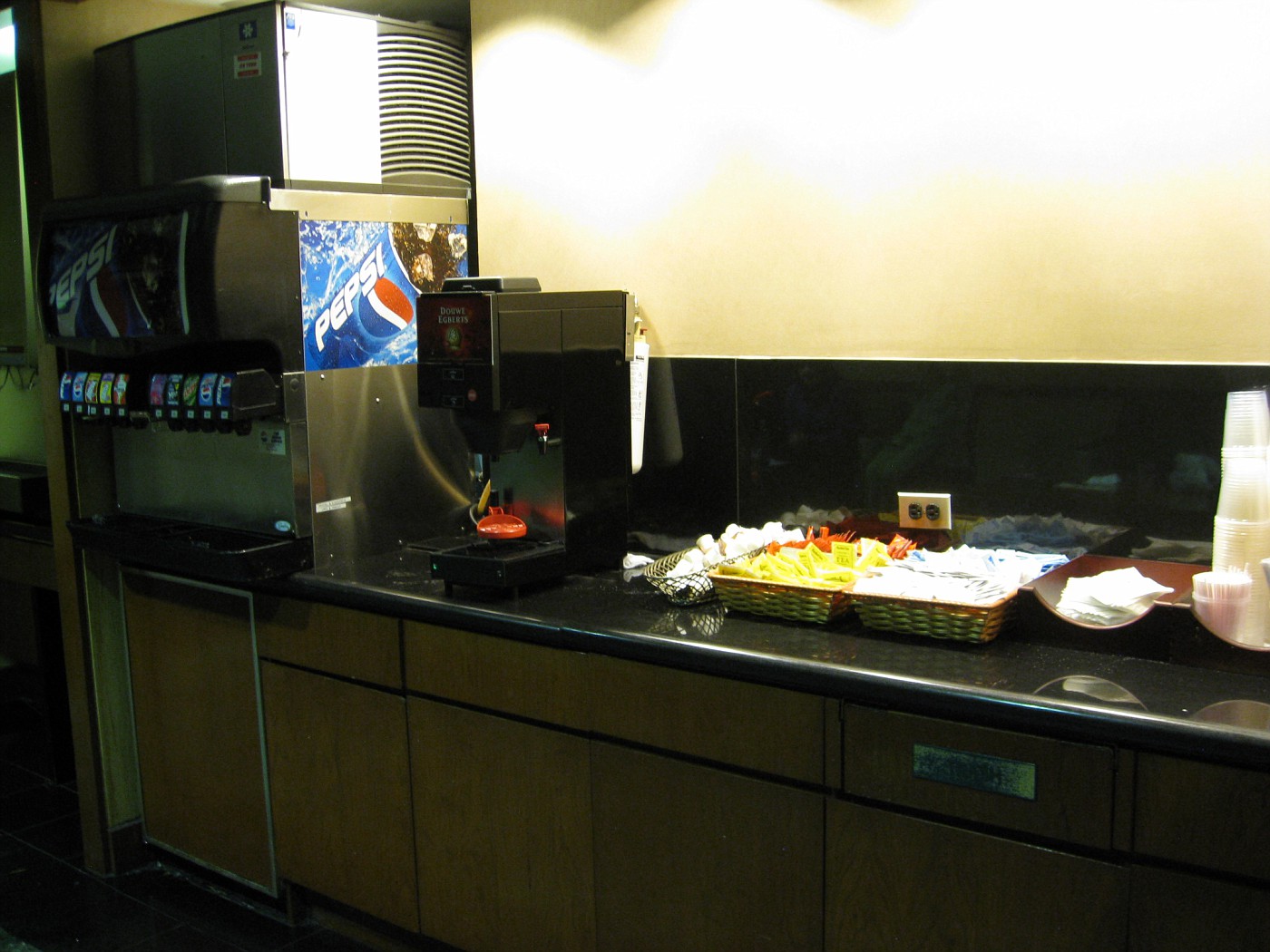
Amtrak’s Metropolitan Lounge Beverage Area
It was 2:35pm when an announcement was made that Train 3 was now ready for boarding. We were instructed to meet in the rear corner of the lounge where an Amtrak agent waited to escort us out to the train. A golf cart was positioned just outside the door to assist those in need of a bit of help. Given the muscle atrophy that I’ve suffered over the years – particularly on my right side – those golf carts look more and more tempting. I can still walk though and so when the agent outside noticed me lurching along and offered me a seat on the cart I declined because the more I walk the better off I’ll be and besides – there was plenty of time yet and it wasn’t all that far to the train.
Here she is. Let’s board!

Dining Car – City of New Orleans
In January 2010, the Sightseer Lounge car was restored to the City of New Orleans, once again giving it two food service cars with the Cross Country Café serving as a full dining car and the Sightseer Lounge providing snacks and beverages.
Seating in Amtrak’s diners is communal and, as a dining car steward once put it – you’ll start out as strangers but you may end up as friends. I was led to a table already occupied by a retired couple from Galesburg named Margaret and Andy. Andy was originally from Poland but had lived in the U.S. for over thirty years. Soon we were joined by Carl, a foamer from Franklin, Tennessee.
A “Foamer”, you ask. What’s a “Foamer”?
“Foamer” is railroad speak for people who are so passionate about railroading that they practically foam at the mouth in their exuberance. Carl was wearing a t-shirt bearing the logo of his hometown railroad, the L&N, a.k.a the Louisville & Nashville. It was quickly clear that he really enjoyed riding trains. I know the term “foamer” sounds a bit derogatory but I certainly don’t mean to employ it as such. I’ve enjoyed the company of every foamer I’ve ever met, primarily due to their enthusiasm for the journey. In this regard I’m right there with the Carls of the world, even if I can’t keep up with their technical knowledge. I should add that when Carl wasn’t pursuing his favorite passion of riding trains around the country, he was an over the road trucker for a local freight company.
Introductions were exchanged, water was delivered and menus opened and perused. Let’s have a look at tonight’s MENU...
Hmm… I’ll go with the steak, please. Baked potato with all the trimmings would be fine, thanks! Andy also ordered the steak while Margaret went with the pasta and Carl ordered the chicken.
Every group of strangers inadvertently foisted upon one another develops their own dynamic – sometimes fun and entertaining, sometimes quiet and awkward like a group of people sharing an elevator ride. Thankfully, tonight’s group was fairly entertaining, much of that due to Carl and Andy. Andy started out rather quietly telling us that he had taught pharmaceutical science at a university in Illinois, but then somehow he got on to the topic of medical insurance and became quite animated, peppering his diatribe with multiple F-bombs. Medical insurance! I don’t know why but I actually found his angst rather amusing. Margaret had heard it all before but managed to keep a straight face throughout.
Our meals arrived and the topic soon changed to things like train travel, life in Alaska and how bumpy the ride had become. The tracks were really rough and as we hurtled northward at about 50mph, I couldn’t help but be mightily impressed with our waiter’s ability to carry trays of food around the car without having a single spill.
Carl pointed out that the route between Jackson and Memphis had been rerouted a few years earlier. The train had originally run over the traditional Illinois Central passenger route but over time that route was getting much more freight traffic and the cost of maintaining it to passenger standards for just one daily passenger train in each direction was becoming untenable. Amtrak agreed to reroute the City of New Orleans over to a line farther to the west and so it was that we were now speeding toward Yazoo City and Greenwood rather than Canton and Grenada. From Memphis north we’d return to the traditional mainline.
One point of interest here is the difference in track standards between passenger and freight. Tracks that serve primarily freight are often rougher. I am well acquainted with a couple of guys who have considerable freight hopping experience. Per their accounts, a ride in a boxcar is nowhere near the pleasant experience that’s it’s often depicted to be in the movies where friendly hobos relax on straw and share a cheap bottle of wine.
First of all, hardly anyone gets to ride in a boxcar anymore. Large modern boxcars have 400lb sliding doors and most of the time those doors are closed and locked. Because of their weight they’re extremely difficult for one person to open and this applies to both sides of the door. More than a few hobos have died during the summer months when the motion of the train caused a once open boxcar door to slide shut, trapping them inside on a hot day.
Another factor is shocks. Freight weighs a lot more than passengers and the shocks on boxcars are designed accordingly. So while the shocks on a boxcar might provide reasonable cushion to 15000lbs of freight, they do little to smooth out the ride for your average 180lb human being. For the hobo unfortunate enough to ride in an empty boxcar, speeding along at 70mph can quickly become a nightmarish experience.
That said, it was no joyride on the rough tracks we rolled over tonight. In addition to the rough ride, it was really noisy. The cars bump and scrape against one another much more vigorously over such rough tracks and the resulting cacophony was none too pleasant on the ears!
On a positive note, the 220 miles of rerouted track between Jackson and Memphis represented new trackage for me. I’ve ridden all but 430 miles of Amtrak’s national system so I was excited to add another line my route map. Although it’s not like I had any real memories of the old route, I found myself wishing there was more daylight so I could check out the new scenery.
Therein lies another attraction of train travel. Scenery. The New York Central used to advertise its route between New York and Chicago as the “See Level Route”. How true! Anybody who’s ridden a train through the spectacular scenery of the Hudson River Valley, the Colorado or Canadian Rockies, the Swiss Alps or even through the austere beauty of the African Veld or the Australian Outback can attest to how nice it is to be able to sit back in a comfortable arm chair and watch the world roll by.
What’s that? Another Gin & Tonic? Why yes, please.
Sorry about that – where was I? Oh yeah - just look at those mountains! And the rivers, lakes, valleys, glaciers, seashores, little towns, attractive old train stations and the people. Almost everybody waves when the train goes by. It’s a nice feeling. You don’t get to see stuff like this up close from an airplane.
As the modern society we live in has become increasingly faster paced, many of us have become increasingly separated from - or at the very least less appreciative of - the planet’s natural wonders. Look how many people trade in the view out their airplane window for the movie on the seatback IFE or whatever’s on the screen of their laptop. I can’t believe how many people don’t even bother to leave their window open for even a short while at the lower elevations, preferring instead to immediately close their shades the moment the plane takes off. I understand that air travel is a lot more commonplace than it once was and that the novelty of flight has long since worn off, but as terrestrial beings even those of us who fly a lot don’t often get to see world from the unique vantage point of an airliner thousands of feet above the earth. I like to check out the view, especially at the lower elevations.
I know what some of you are thinking – “Hey buddy! I fly 100000 miles a year! Don’t talk to me about the uniqueness of the view from on high! I see more than enough of it each year!” To which I say “Pffft!” Let’s look at some numbers.
• Last year I flew 293,180 miles, which amounted to 643 hours and 10 minutes spent in the air.
• That’s the equivalent of 26 entire days and about 18 hours in change.
• That means I spent 7.34% of the year in the air.
• Assuming I got 8 hours of sleep each night (yeah, right!), let’s increase that figure by a third to reflect that I spent 9.8% of my conscious hours during the year aloft.
• Out of the 16 hours that I was presumed conscious each day, let’s deduct another four hours for darkness when there was nothing to be seen. Now the percentage of time I spent conscious and aloft during daylight hours throughout the year rises to 12.25%.
• Now let’s say I spend 25% of each flight actively looking out the window (as if I’m really going to spend one entire hour actively looking out the window on a four hour flight!) and the percentage of time that I’m conscious and looking out the window drops to about 3%.
My point is that for most of us, only a tiny fraction of our conscious lives each year is spent inflight. The above numbers reflect having spent way more time in the air than the average person, including frequent flyers. And yet, out of all that time aloft only 3% or 1.8 seconds per minute is spent checking out the scenery. For those of you who actually do average 100000 miles per year of flying, divide the above numbers by about one third. Now you’re at just over ½ second spent per minute actively checking out the view below. Uh huh... And now let’s say you only average 50000 miles per year inflight. Make that about ¼ second per minute checking out that scenery!
For what it’s worth – strictly as a point of reference and/or possible entertainment on a slow day – since January 1st of 2002, I’ve averaged 180,348 miles of flying per year, having logged 2059 flights totaling 2,344,530 miles over the thirteen years since then. In terms of time aloft that comes to 5,150 hours or the equivalent of almost seven months aloft. I honestly have no idea how much time I’ve spent looking out my window but being as I live in one of the most dramatically beautiful places on the planet – Alaska – it’s hard not to resist taking a peak or three at nature’s grandeur as it passes beneath me. To be sure, I look more than most people.

Sunset fjord FAI-SEA

Glaciers between Anchorage and Seattle

Prince William Sound

Denali
Many claim that there’s nothing to see from 38000 feet up. Often times that’s true due to clouds, darkness or flight paths over central Kansas or the ocean. Then again, sometimes the beauty emanates from above. I have enjoyed innumerable spectacular cloud formations and sunsets from aloft. I also remember the tranquil beauty of the Pacific Ocean on a warm afternoon jetting between Santiago and Mexico City.

Pacific splendor 800 miles west of Lima, Peru

Sunset over the Coral Sea

Heavenly clouds over the Java Sea

Fire in the sky
Granted, beauty is in the eye of the beholder. I see a lot of it in many different forms from aloft. What a shame that less and less people take the time to check it out these days, instead preferring the artificial substitute provided via their laptops or seatback IFEs.
But wait! I thought we were riding a train here…
Yes we are. And to that end, the scenery is even more front and center. Unfortunately though, it’s dark right now. We just pulled out of Greenwood, Mississippi about fifteen minutes ago. Our next major station stop, Memphis, won’t be coming up for another couple of hours yet. Now is an excellent time to check out another reason why travel by train can be so enjoyable. Let’s head back to the Lounge Car.
It should be noted here that lounge cars have long been synonymous with American train travel. The United States is a large country and traveling across its expanse by rail can often take days rather than hours. Lounges are wonderful places to break the tedium of long journeys and in the process share the experience with your fellow travelers. Here are some examples from America’s golden days of rail travel…

Southern Pacific Daylight Club Lounge

Seaboard Lines’ Silver Meteor Sun Lounge

Milwaukee Road’s Hiawatha Dome Lounge
Amtrak’s Sightseer Lounge Cars are available on all long distance trains operating from Chicago to the West Coast, Texas and New Orleans. They are available to all passengers regardless of class traveled. The only train east of Chicago that offers them is the Capitol Limited which operates between Chicago and Washington, DC. The reason you don’t see them back east is because most of the old tunnels and overpasses are not high enough to allow for the 16’ height of the bi-level Superliner cars.
The Sightseer lounges are configured with half the upstairs level offering buffet style seating around tables and the other half providing individual swivel seats and couches that face toward the windows. Downstairs is snack bar that sells a variety of lighter meals such as hot and cold sandwiches, snacks and beverages including alcohol. Four or five buffet booths supply the seating. I was looking for a table on the upper level but when I entered all of them were occupied.

Amtrak’s Sightseer Lounge
As I lurched down the aisle surveying my options, a couple at one of the tables beckoned me over and invited me to join them. Meet Dave and Michelle from Appleton, Wisconsin. They were returning home from a week’s vacation in Louisiana with their two teenaged children who were somewhere else on the train and so there was plenty of room at the table.
They both had drinks in hand and I soon joined them with a Jack Daniels on the rocks. I don’t remember what all we talked about but I do recall that it was like we’d known each other for years and conversation flowed easily. Eventually their kids did show up and they were just as nice and engaging as their parents. I really enjoyed the company of these folks and as will happen in circumstances like this, the hours just melted away.
People who’ve never taken a long distance train trip often worry that they’ll be bored. I’d say that depends on the person. If I make it sound as if I enjoy meeting other travelers and sharing experiences with them, it’s because I do. However, I don’t require that interaction and I’m generally not one to initiate it. On airplanes I’ll say hello to my seatmate when I arrive but unless he/she chooses to initiate further conversation, I’ll happily spend the rest of the flight wrapped up in a book, working on my laptop, listening to music or sometimes even checking out the scenery. I’m the first person to recognize and respect that for some people, travel often represents the best opportunity they get to enjoy a bit of peace and quiet.
As for potential boredom on trains, I’ve already pointed out the scenic and social opportunities available as I’ve experienced them. Whether you choose to interact with your fellow travelers is totally your call. Consider too that I’m traveling alone. For those that aren’t, there’s always a spouse-partner-friend-children to spend time with as well. Conversation notwithstanding, I’ve also seen some pretty rousing board and card games being played in the lounge car.
It was a little past 11 when we called it a night. Dave, Michelle and their kids retired to their seats back in the coaches while I headed forward to the sleepers. Lisa (my car attendant) had already changed my roomette over to its nighttime configuration. Waiting for me was a 6’6” bed made up with sheets and a blanket along with two pillows. I’ve always found the blanket a bit thin and the sheets on the 28” wide mattresses a bit constricting, so I bring along my own larger and heavier wool blanket under which I sleep much more comfortably.

Bedtime on the City of New Orleans
It was about 4:00am when I first awoke, book on the floor and my reading light still on. We were sitting at the station in Centralia, Illinois and the bright light from the sodium halide lamps illuminating the empty platform outside my window had evidently woken me up. Since departing Memphis the tracks had improved considerably, and the gentle rocking motion and rhythmic clickety-clack of the rails (not to mention three Jack Daniels) had lulled me to sleep before I’d had a chance to book mark my place and turn out the light. I closed my curtains and then fell back to sleep for another three hours, awaking shortly after we’d departed Champaign-Urbana.
Swinging my feet to the floor, I discovered that a copy of USA Today had thoughtfully been placed under my door. Throwing on a pair of pants, I took the stairs up to the service area where hot coffee and chilled orange juice awaited. A cup of each and the day’s news tided me over until the shower became available a few minutes later. There was no shortage of hot water and the big, thirsty towels were a welcome treat after the invigorating shower.

Amtrak Superliner Shower
Surprisingly, I ended up with a table to myself for breakfast. No worries! Newspapers have made wonderful breakfast companions over the years. Lunch is more of a social affair with coworkers and dinner is social with friends and family so really, outside of a plane or train, breakfast is often the best time I get to catch up on what’s going on. And you know what they say about the nation’s leading daily ~ If it’s in USA Today, it must be true!
Returning to my roomette, I repacked my bag and sat down to await our arrival into Chicago’s Union Station. It’s interesting to watch the transition as wide open country morphed into settlements, then towns, then suburbs and finally city proper as we drew ever nearer to the station. The yards outside of Union Station are quite large and for train spotters they occasionally yield some interesting sights. I took note of some old E-8 locomotives with their classic 1950s hoods along with some derelict looking double decker passenger cars from Metra, the local commuter line. A few Amtrak Superliners were parked in the distance as well as a nice looking private car that appeared to be wearing the attractive brown and orange livery of the Illinois Central’s crack streamliner “The Panama Limited”.
It was 9:25 by the time we’d eased to a stop on the platform underneath the station. That’s only twenty-five minutes late – not bad, not bad! For a train that must contend daily with bad tracks and inhospitable host railroads, a 25 minute delay is actually pretty good. Alighting from the train, I bestowed a well-earned tip upon Lisa and thanked her for a job well done. In return I got a pretty smile and an invitation to come back and do it again sometime. I tossed her a wink and said “Gimme five hours, Sweetheart, and I’ll do just that!”
Although there has been a train station operating since 1858 on the spot occupied by today’s Union Station, the current station only dates back to 1925. In fact, it is said to be the third station to operate there. I don’t believe there will be a fourth. The current station is massive, taking up approximately nine and a half city blocks. Built in the popular Beaux-Arts style seen in stations at Kansas City, St. Louis and Denver to name just a few, Union Station is known for its distinctive Corinthian columns and magnificent Great Hall. The station was recently designated as one of America’s “Great Places” by the American Planning Association and for those that have an hour or two between trains, it’s worth having a look around.

Chicago Union Station Great Hall

Chicago Union Station Great Hall

Chicago Union Station Great Hall
So – what to do in Chicago for five hours. In a city this size I’ve no doubt books could be written on the subject! I used to get together with a friend who lived up in Deerfield but he went and chased a girl and/or a job all the way out to Galena, Illinois. I seem to recall invitations from one or more Chicago based Flyertalkers to join them for a beer or two but it’s been so long that I can’t remember which ones they were. I ought to keep an appointment book. I suppose I could’ve gone over to the Communities forum and posted notice of my impending arrival but that just feels a bit too presumptuous – to me, at least.
No, I’ll be just fine on my own, thanks. The first order of business was storing my bag, not always such an easy thing to do given the concerns and security protocols in place following 9-11. Thankfully Union Station has a couple of options for baggage storage – one consisting of public lockers and the other reserved for First Class passengers in the Metropolitan Lounge. That’d be me.
Exiting the station, I headed across the street to the pick-up point for the Shoreline Water Taxi. My now Galena based friend introduced me to the water taxi a few years ago and per my experience it is an excellent and inexpensive way to see Chicago and in particular the architecturally magnificent buildings for which the city is rightfully famous. Unfortunately today’s skies weren’t quite as photogenic as those from my last visit, so I’m going to post a few pictures from that one instead.

Chicago Skyline as seen from the Chicago River

Chicago Skyline as seen from the Chicago River

Chicago Skyline as seen from the Chicago River

Chicago Skyline as seen from the Chicago River
It’s a short walk from the Michigan Avenue stop to the famous Billy Goat Tavern. Aside from being a classic old sports bar, the Billy Goat Tavern was also the inspiration for the 1970s Saturday Night Live skit featuring John Belushi slinging burgers and hollering “Cheeze-borger! Cheeze-borger! No Coke! Pepsi!”
Whaaaat? Y’all don’t remember that one? Jeez, I’m getting’ old!
Speaking of sports, I was sat at the bar next to a couple of guys who’d come in for a beer and a burger before heading over to Wrigley for that afternoon’s game against the Diamondbacks. We talked baseball a bit and it was nice to see they were still guardedly optimistic for the Cubbies to have a decent season. Enjoy those good feelings now boys, because reality should set in within the next month or so. If ever there were fans of a team for whom hope springs eternal, it’s Chicago Cubs fans - especially at this time of year when it’s early in the season and not enough time has elapsed for the diehards to become resigned once again to the team’s inevitable elimination from post season participation.
Even though I never lived in Chicago, I was a big fan of Mike Royko, the Chicago Sun Times columnist. Royko brought old fashioned blue collar sensibility – not to mention humor – to everyday life. Here’s an excerpt from an early season interaction with his friend, fervent Cubs fan Slats Grobnik:
Slats: “How bout them Cubbies? They’re lookin’ pretty good this year, yeah?”
Royko: “Yes, they are. Hair neatly combed, no pimples…”
Time flies when you’re having fun. A glance at my watch indicated it was 12:15pm and I still needed to do a bit of shopping prior to the 3:00pm departure of my next train – the Southwest Chief – bound for Los Angeles. Making my way back to the station, I headed across the street to a CVS Pharmacy where beer, bourbon and mixed nuts could be purchased at very reasonable prices. Now properly supplied for the next two days on the rails, I returned to the Metropolitan Lounge to await the call to board.
It should be noted here that even though Amtrak’s Metropolitan Lounge is a perk for First Class travelers, it is hardly a lounge to get excited about. Beyond a bit of peace and quiet relative to the crowded waiting areas out in the station, it offers little in the way of food, beverages or even ambience. Packets of Goldfish crackers were the only food offerings while beverages were limited to coffee and a couple of soft drinks from a dispenser. Muted green and beige comprised the colors while wood trim strived valiantly to provide a bit of class to the mortuary like ambience of the lounge. On a more positive note, there was Wi-Fi access so over the next hour or so I did manage to do a pretty good job of finally cleaning up my email account.

Amtrak’s Metropolitan Lounge in Chicago

Amtrak’s Metropolitan Lounge Beverage Area
It was 2:35pm when an announcement was made that Train 3 was now ready for boarding. We were instructed to meet in the rear corner of the lounge where an Amtrak agent waited to escort us out to the train. A golf cart was positioned just outside the door to assist those in need of a bit of help. Given the muscle atrophy that I’ve suffered over the years – particularly on my right side – those golf carts look more and more tempting. I can still walk though and so when the agent outside noticed me lurching along and offered me a seat on the cart I declined because the more I walk the better off I’ll be and besides – there was plenty of time yet and it wasn’t all that far to the train.
Here she is. Let’s board!
Last edited by Seat 2A; Jan 1, 2015 at 5:36 pm
#5
FlyerTalk Evangelist
Original Poster
Join Date: Apr 2001
Location: East Ester, Alaska
Programs: Alaska Million Miler, United Million Miler, Wyndham Rewards Diamond, Choice Hotels Diamond
Posts: 12,148
Day Six
Amtrak Chicago to Los Angeles 300p – 815a Southwest Chief First Class Car 5 Room 11
The predecessor to Amtrak’s Southwest Chief was the Santa Fe’s Super Chief. Its gleaming silver cars were a standard bearer for the all-Pullman trains of its era. Memorable were the Southwest themed lounge cars, the Fred Harvey run dining cars and the luxurious Pleasure Domes with their large, overstuffed loungers upstairs under the glass. The Chief was synonymous with luxury on rails and was known as “The Train of The Stars” due to its popularity with the Hollywood glitterati.
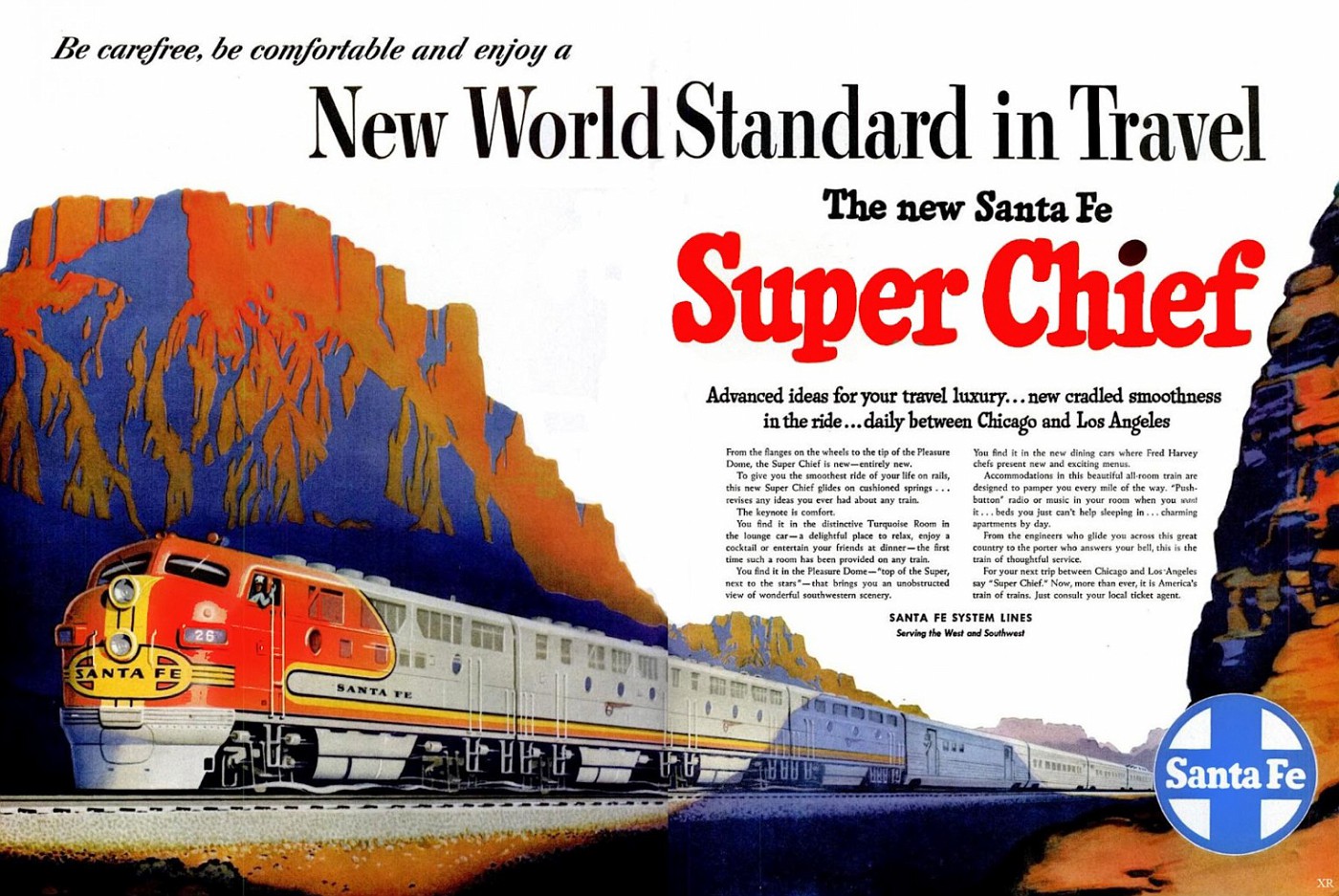
Santa Fe’s Super Chief
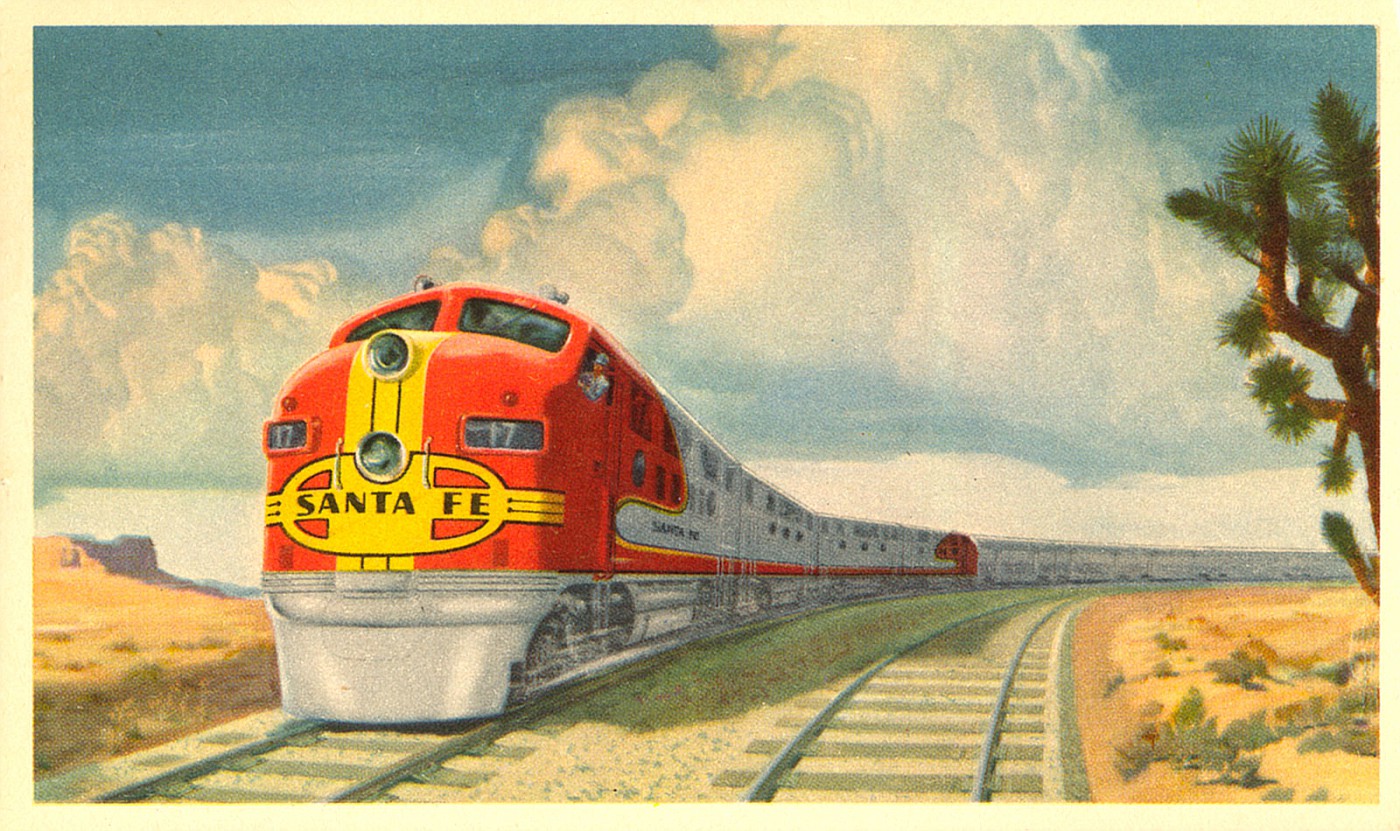
Santa Fe’s Super Chief Postcard
I used to live in Durango, Colorado where I went to school at Fort Lewis College. Back in the mid-1970s I’d occasionally hitch-hike down to Gallup, New Mexico and catch the train over to Flagstaff, Arizona – about three hours and 180 miles down the line. Alas, I was a few years too late to have ridden The Super Chief for by then Amtrak had taken over the nation’s passenger rail service and the train was now known as the Southwest Limited. The story behind the name change to Southwest Limited and thence to the Southwest Chief is interesting and reflective of Amtrak’s history as a whole.
When Amtrak assumed operation of the nation’s passenger rail service back in May of 1971, train travel in America was in serious decline. The increasing popularity of travel by car and the interstate highway system combined with ever more affordable (and faster) air travel made rail travel increasingly passé. Worse yet, the government provided assistance to the competition in the form of federal subsidies for highways as well as to the airlines via the Essential Air Service program.
Over time, rail passenger traffic declined to the point where it was no longer profitable to operate long distance passenger trains. By 1970 many once esteemed streamliners that rolled across America with the pride and dignity that came with a tradition of world class service and accommodations were eventually reduced to just three or four lonely cars carrying a smattering of passengers and a demoralized crew. Like Arlo Guthrie sang, America had a bad case of the “disappearing railroad blues”.
Amtrak inherited a fleet of aging equipment and unhappy employees, many of whom faced an uncertain future. Indeed, about 70% of trains (and jobs) that had operated in the months before Amtrak took over immediately ceased to exist the day after. Most of the trains that Amtrak did choose to continue operating kept their original names.
Throughout the “Good Old Days” of post-World War II railroading, many people developed relationships with trains based upon the expectation of the quality services that had once been consistently provided. You could always count on your shoes being shined overnight and ready for you in the morning aboard the Broadway Limited. Some folks said the consistently excellent food aboard the Fred Harvey run dining cars of the Santa Fe was worth the extra cost of riding it. The pecan pie on the Kansas City Southern’s New Orleans bound “Southern Belle” was justifiably famous and what better way to end a successful business presentation in Chicago than with a perfectly made “Highball” in the stylish tavern/lounge car that brought up the rear of the “Pere Marquette”. There were years of pride and tradition associated with these named trains and it really was sad to see them slide into decline - much like witnessing a cherished relative slowly wasting away from a chronic disease.
Throughout the decline of the sixties and early seventies, a few railroads such as the Santa Fe and the New York Central still strived to provide a high level of service on their premier trains. When Amtrak took over, the subsequent standardization of services nationwide resulted in a considerable drop in quality for trains like the Super Chief and the Twentieth Century Limited.
After witnessing three years of substandard service under Amtrak administration, the Santa Fe went to court in 1974 and won an injunction forcing Amtrak to stop using the name Super Chief because the level of service was so far beneath the standard traditionally associated with the train – and by extension - the railroad. For the next ten years the ex-Santa Fe Chicago to Los Angeles train was called the Southwest Limited. It wasn’t until the arrival of Amtrak’s new bi-level Superliner equipment in the early 1980s along with a system wide enhancement of passenger services that the Santa Fe relented and allowed Amtrak to change the name of the train to the Southwest Chief.
Fast forward to the present and today’s Southwest Chief is one of the most popular and well patronized trains in the Amtrak system. Although its First Class service bears little resemblance to the standard set by the Santa Fe’s all-Pullman Chiefs of the 1950s, a ride aboard this train still provides a comfortable and scenic adventure for those willing to slow down and spend a couple of days traveling across America at “See Level”.
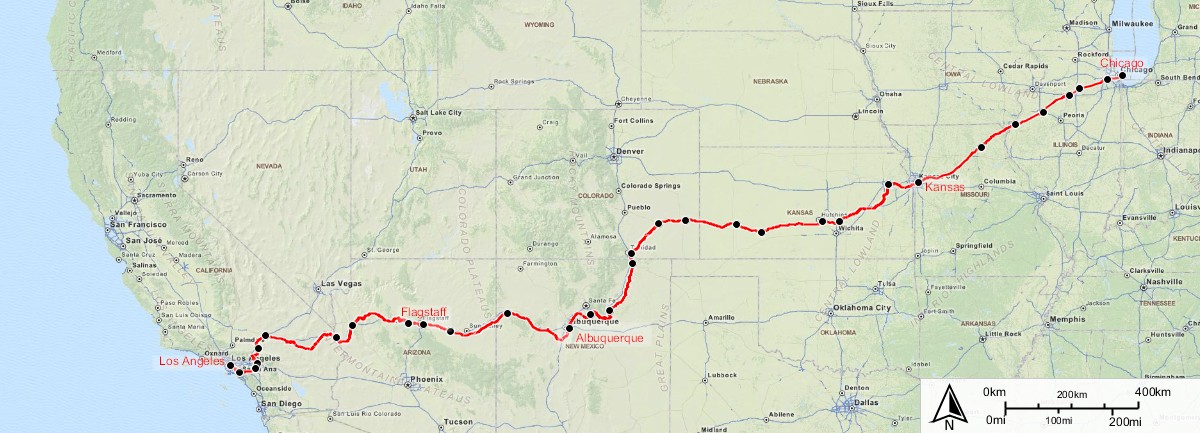
Route of the Southwest Chief
The 2265 mile route will take us through Illinois, Iowa, Missouri, Kansas, Colorado, New Mexico, Arizona, and California before pulling into Los Angeles two days from now at 8:15am. Anticipating the pleasant journey to come, I strolled down the platform to car 331 where car attendant Maria stood with bright eyes and a pretty smile, ready to greet and assist her passengers.

Train time at Union Station
As always, I’ve booked Roomette 11, located downstairs on the lower level. Maria helped me stow my bag and promised to stop by with more information about the trip ahead once we were underway. Grabbing my camera, I headed upstairs to take a few pictures of Amtrak’s spacious bedroom accommodations – hopefully before any of their occupants arrived.
When it comes to taking pictures onboard a train, the best time to do so is while sitting in the station. Since the train is not moving, you can get much better photos than you would while it’s rocking and rolling its way down the tracks. As for those wonderful bedroom accommodations, I would love to enjoy such spaciousness but of course, they come at a considerably higher price – to wit twice the amount of points that I’ve cashed in for my humble roomette. Still, one can always dream. Let’s go upstairs and check ‘em out!
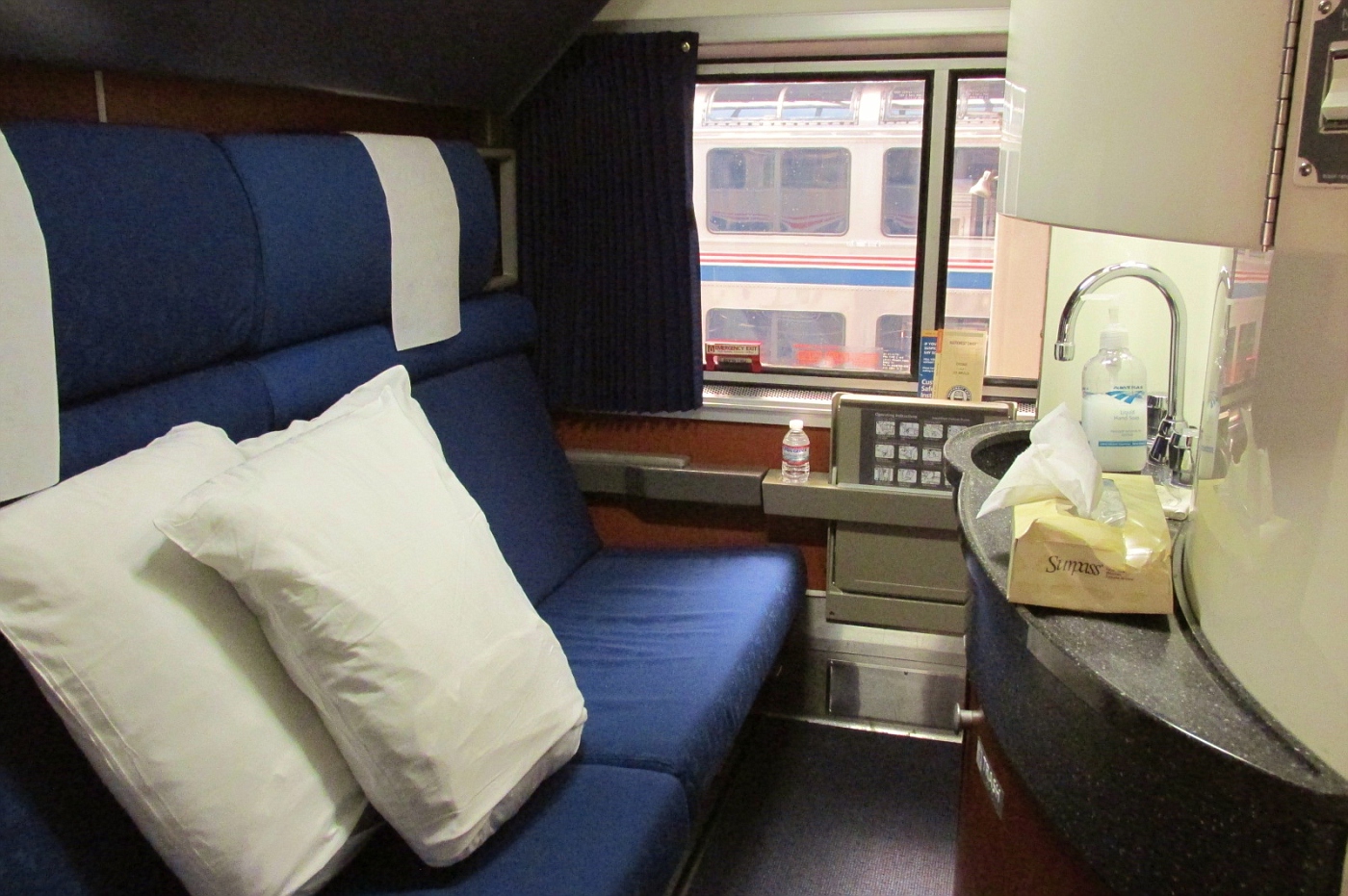
Amtrak’s Superliner Bedroom Seating
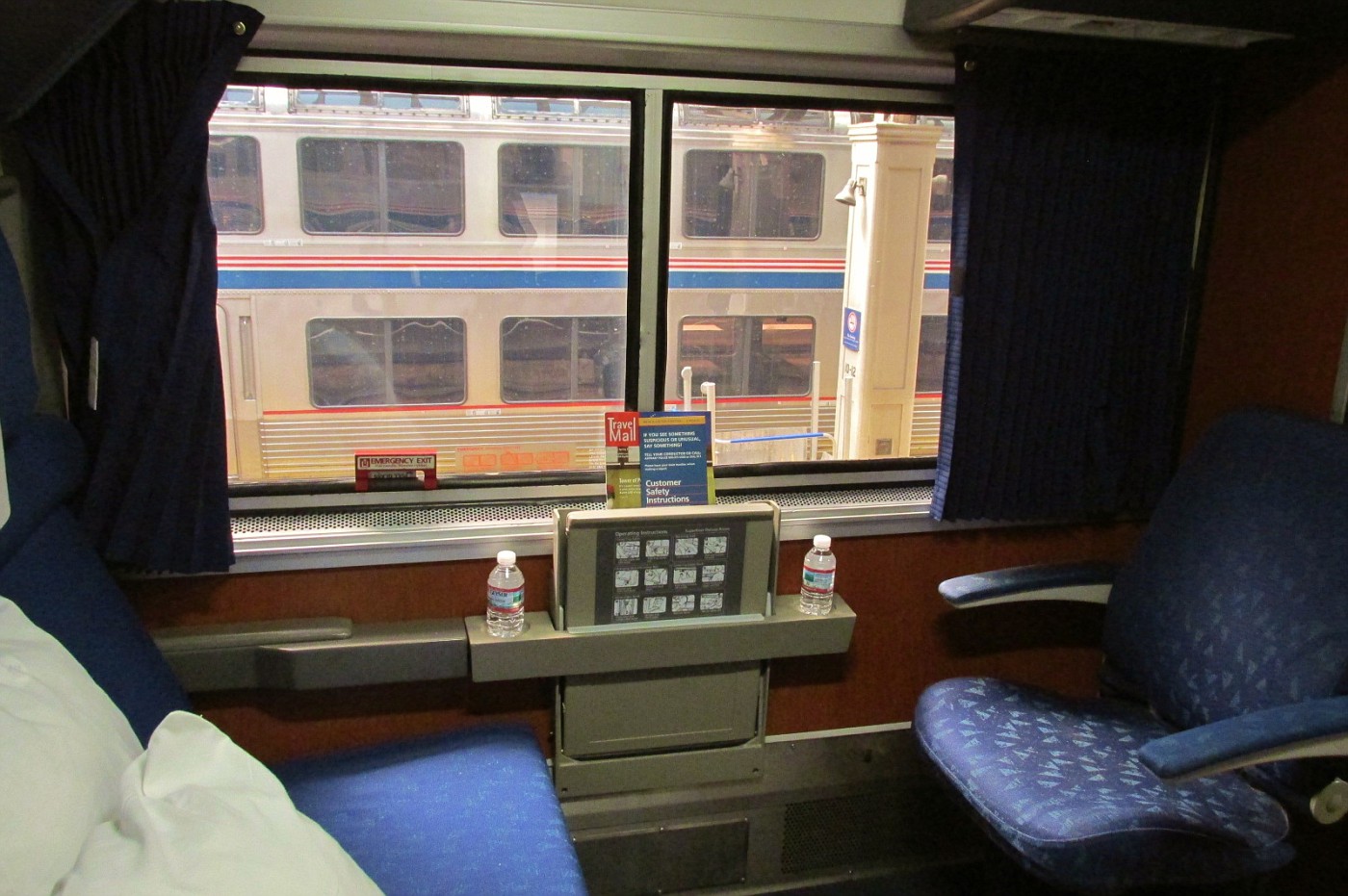
Amtrak’s Superliner Bedroom Seating
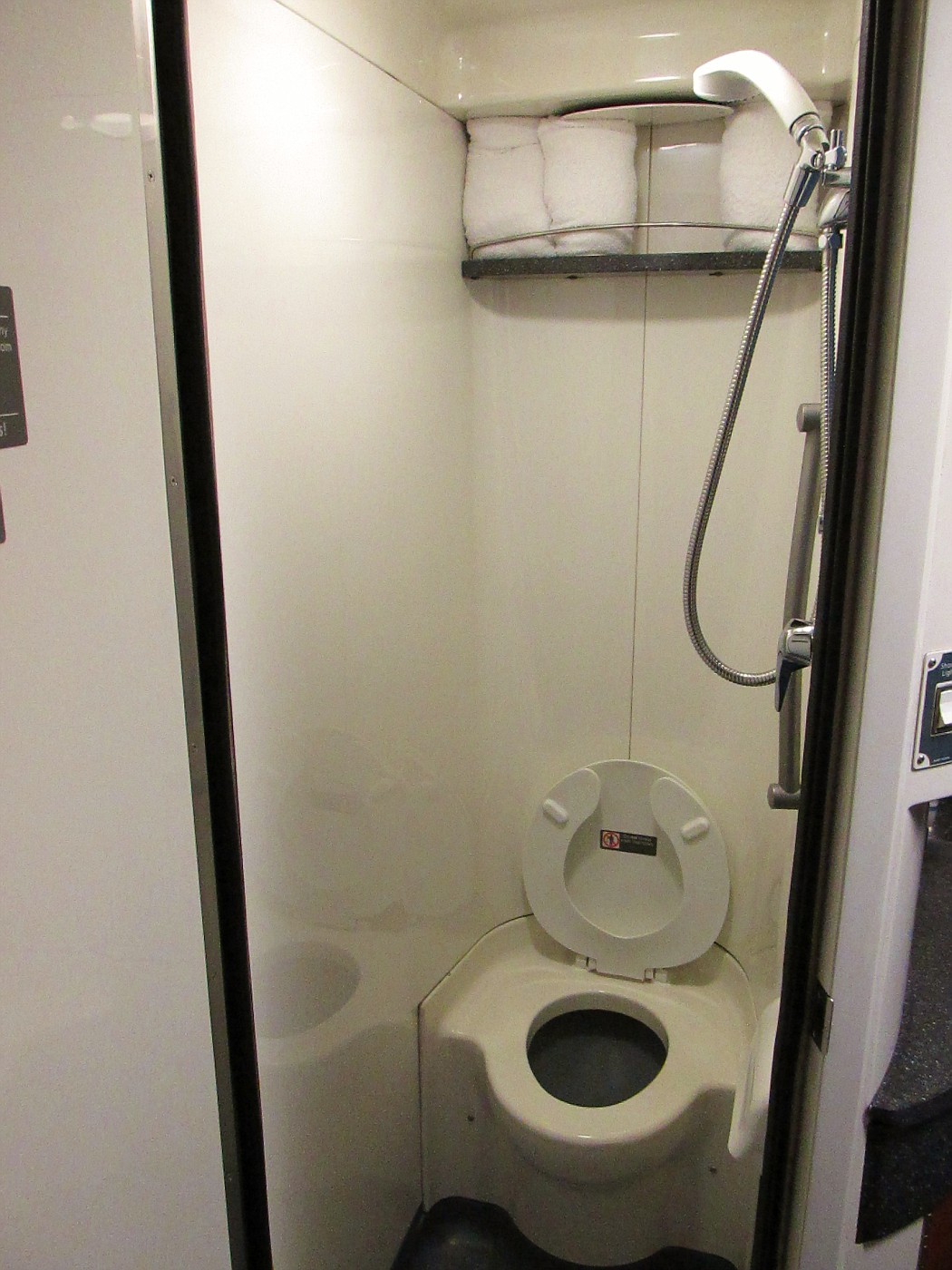
Amtrak’s Superliner Bedroom Toilet and Shower
When I heard the “All Aboard” call ring out, a glance at my watch indicated it was 2:58pm. Last minute photographers and laggardly passengers scampered onboard, the doors were closed and at 3 o’clock on the dot the twin P42DC locomotives powered up and slowly eased us out of the station.
Like many big city terminals, the boarding platforms at Chicago’s Union Station are underground so the first five minutes of this trip were spent rolling through a subterranean world of support beams, bare dirty light bulbs, dark railroad cars and the occasional human being. In the darkness it was difficult to discern whether the people I saw were railroad employees or homeless denizens of the station’s underworld.
As we emerged into bright afternoon sunlight, I reached down into the makeshift cooler I’d created from my garbage can and extracted a nicely chilled can of beer. Reclining my seat, I opened a sleeve of mixed nuts and took that first long pull off the beer. Ah… I love this part of the trip! It’s like Friday night with the whole weekend ahead of you. Here we are rolling along through the Chicago suburbs with the promise of forty-three more hours of pretty scenery, good company, tasty meals and comfortable accommodations. Play that out from the comfort of a big wide seat accompanied by the rhythmic clickety-clack of the rails and you’ve got a wonderful recipe for travel contentment. I had another pull on my beer and considered my lot in life. It’s good. It’s all good…
The Southwest Chief follows one of the most historic and scenic routes in the nation. First blazed by native Americans, then Spanish conquistadors, pioneers and gold miners, the route eventually became known as the Santa Fe Trail. The Atchison, Topeka and Santa Fe Railway traces its beginnings back to 1859 when work began to lay rail connecting Atchison and Topeka, Kansas with Santa Fe, New Mexico. Why stop there though? Albuquerque was reached in 1880 and the next year the ATS&F tracks reached Deming, New Mexico where they connected with the Southern Pacific’s line to the West Coast. The combination of these two lines resulted in the nation’s second transcontinental rail route, the first being the Union and Central Pacific Railroads’ more northerly mainline through Nebraska, Wyoming, Utah and Nevada. Through a combination of construction and trades with the Southern Pacific, the Santa Fe reached Los Angeles in 1897, thus making the ATS&F the first railroad to have its own tracks from Chicago all the way to the Pacific coast.
But enough of the history lesson. Let’s check out the view!
The maximum speed for Amtrak’s Superliners is 79mph. The one exception is out in western New Mexico and through most of Arizona where speeds of up to 90mph are attained. While this would be considered slow by European and Asian rail standards, here in America’s heartland it looks and feels pretty fast. I think it’s a good speed to appreciate the landscape zipping past my window which at present is comprised of low rolling farmland offset by attractive old farmhouses, barns, silos and the occasional copse of cottonwood trees. This is what airline passengers refer to as “fly over” country. While not the dramatic scenery of the mountain west, it still holds a rustic appeal that could never be appreciated from the air. I particularly like the colorful old barns I see out here. Some of the communities we passed through were little more than a collection of houses set amidst a nicely treed meadow. As we flashed through the occasional small town I was impressed by the old brick buildings and quaint storefronts, most of them housing businesses owned by real people rather than large corporations. There are no Burger Kings or CVS Pharmacies on these streets. This is the small town America that many people only get to read about. Most tourists, especially those from overseas, rarely ever venture out to towns like these but I’d like to think that if they did they’d leave with a very favorable impression of their visit, and indeed America as a whole.
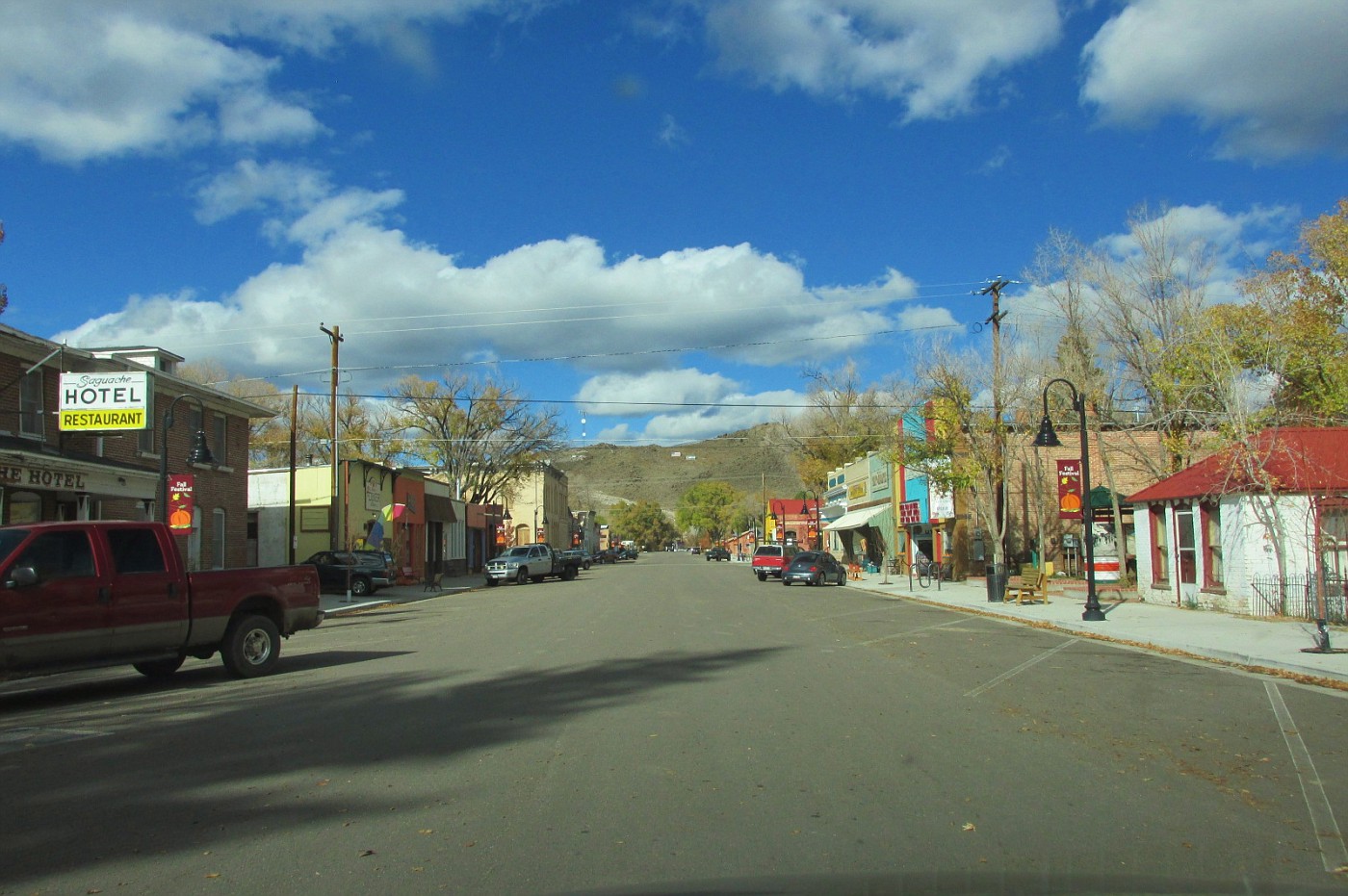
Main Street USA
As seen in Saguache, Colorado
So, it’s been said that a train is a place that’s going somewhere. On this train that place includes a full service dining car and the Sightseer Lounge Car. A trip of this length can be very long and uneventful if you confine yourself to your seat or bedroom. Let’s go out and mingle!
Unlike an airplane where everyone is going to the same place, the train is constantly dropping off and picking up new passengers along the way. As such, spending some time in the lounge or diner provides a unique opportunity to meet a constantly changing collection of travelers as well as the train crew who are there to serve you. The lounge car in particular invites conviviality.
Unless you’re a hardened road warrior, for most of us the act of traveling somewhere is still pretty exciting. Sitting in the lounge car with your favorite libation while enjoying a close up view of the land you’re traveling through invokes a sense of shared experience in a way that the comparatively sterile confines of a modern day airliner never will. Honestly – the midflight experience aboard most airplanes these days is pretty darned boring since you’re sitting in a darkened tube where most people have their window shades drawn, their Bose headsets on and they’re hooked into their laptops, IFEs or mp3s. The social environment screams “Leave me alone!” and invites isolation.
By comparison, on a train you’re surrounded by light and scenery. The single window in my roomette is huge, measuring approximately 2 feet high by 5 feet long. In the Sightseer Lounge the multiple windows are even larger, starting at knee height and measuring approximately 3 ½ feet high by 6 feet long. Where the wall curves into the ceiling are even more windows allowing for better viewing when traveling through canyons or past high mountains. As one who’s always related to the earth’s natural wonders more so than its manmade ones, I really appreciate the light and view afforded by all those windows.
The lounge car on a train is a social place where the shared excitement of the trip fosters interaction. People like to talk about their upcoming adventures – be it a quick trip to their cousin’s wedding 300 miles down the line in Kansas City or a month long excursion through the American West on an Amtrak Railpass. I’ve often found that once I’ve located an open seat in the lounge car, a simple “Hey there – how’s it going? Where you headed?” can often result in some great conversation and occasionally even friendships. Other times it’s a pleasant place to take in the scenery through the huge windows. Electrical outlets are available throughout the car for those wanting to plug in a laptop or DVD player.
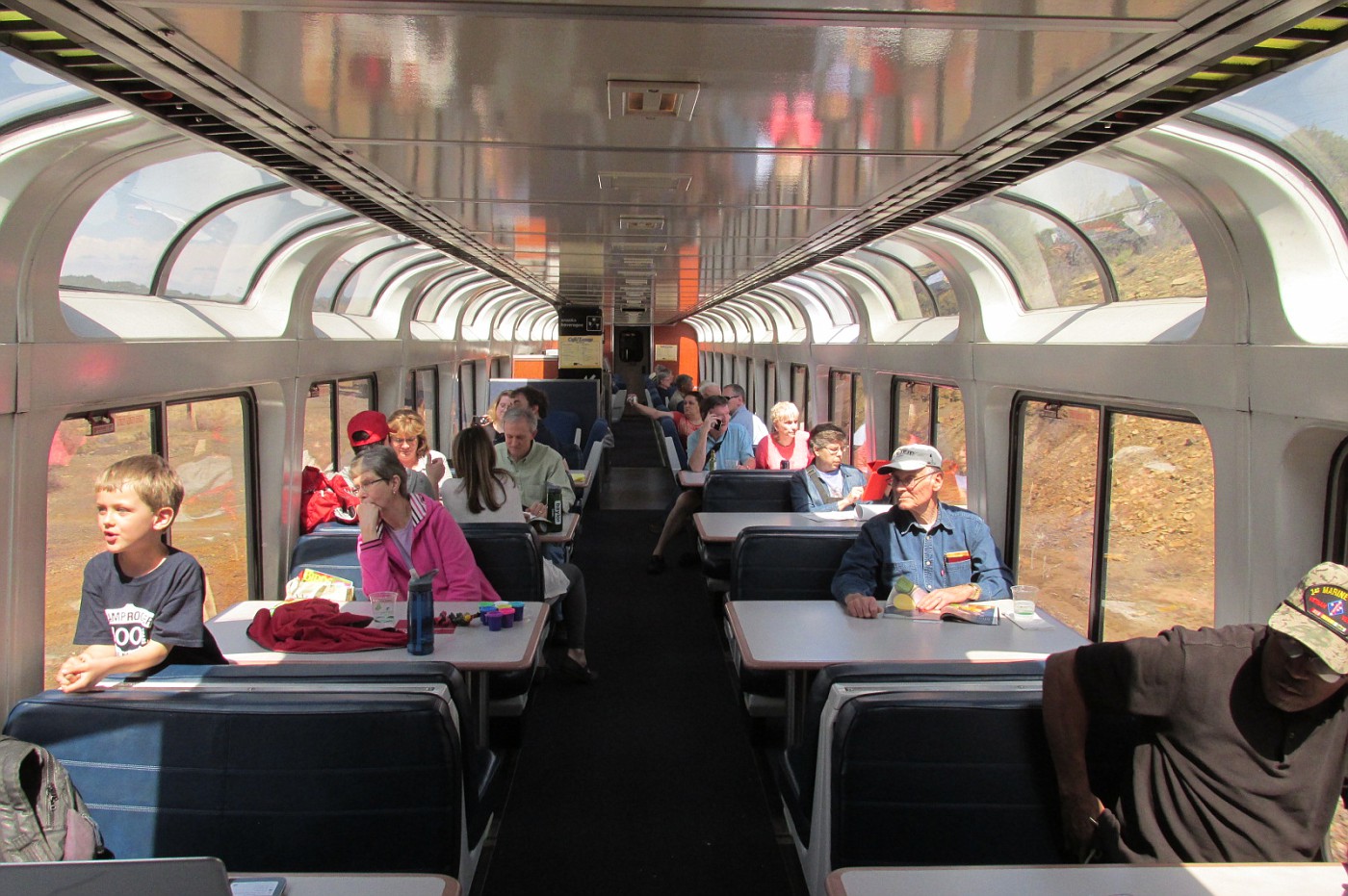
Amtrak’s Superliner Sightseer Lounge
One half of the lounge car is booth and table seating

Amtrak’s Superliner Sightseer Lounge
The other half is individual seats and couchettes. These swivel to face either side of the train.
A group of four could conceivably turn two from each side to face eachother
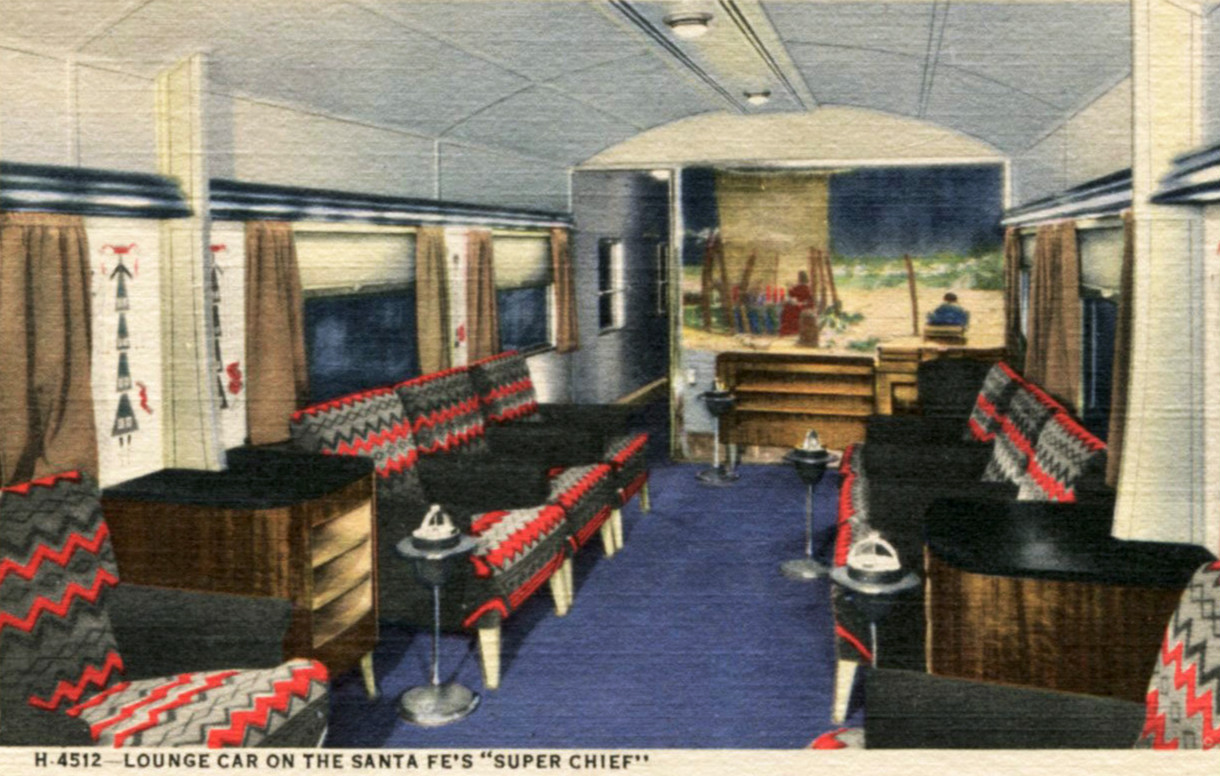
Santa Fe Chief Lounge
Today I met Joe and Wendy who were on their way back home to Newton, Kansas after a week visiting family in upstate New York. Their journey had started the day before aboard the Lakeshore Limited out of Albany, New York and this was the second time they’d done this trip by train. Wendy explained that they’d discovered the train five years ago when a search for low airfares between Wichita and Albany proved to be an unpleasant and unfulfilling experience. Amtrak offered a great fare and although the departure and arrival times out of Newton weren’t ideal, at least they wouldn’t have to drive down to Wichita and pay for airport parking.
Since we all had 6:00pm dinner reservations, we decided to continue our conversation over dinner in the diner. I should add here that I usually try to arrange for an earlier seating because experience has taught me that the more popular entrees – such as the steak – occasionally run out later in the evening.
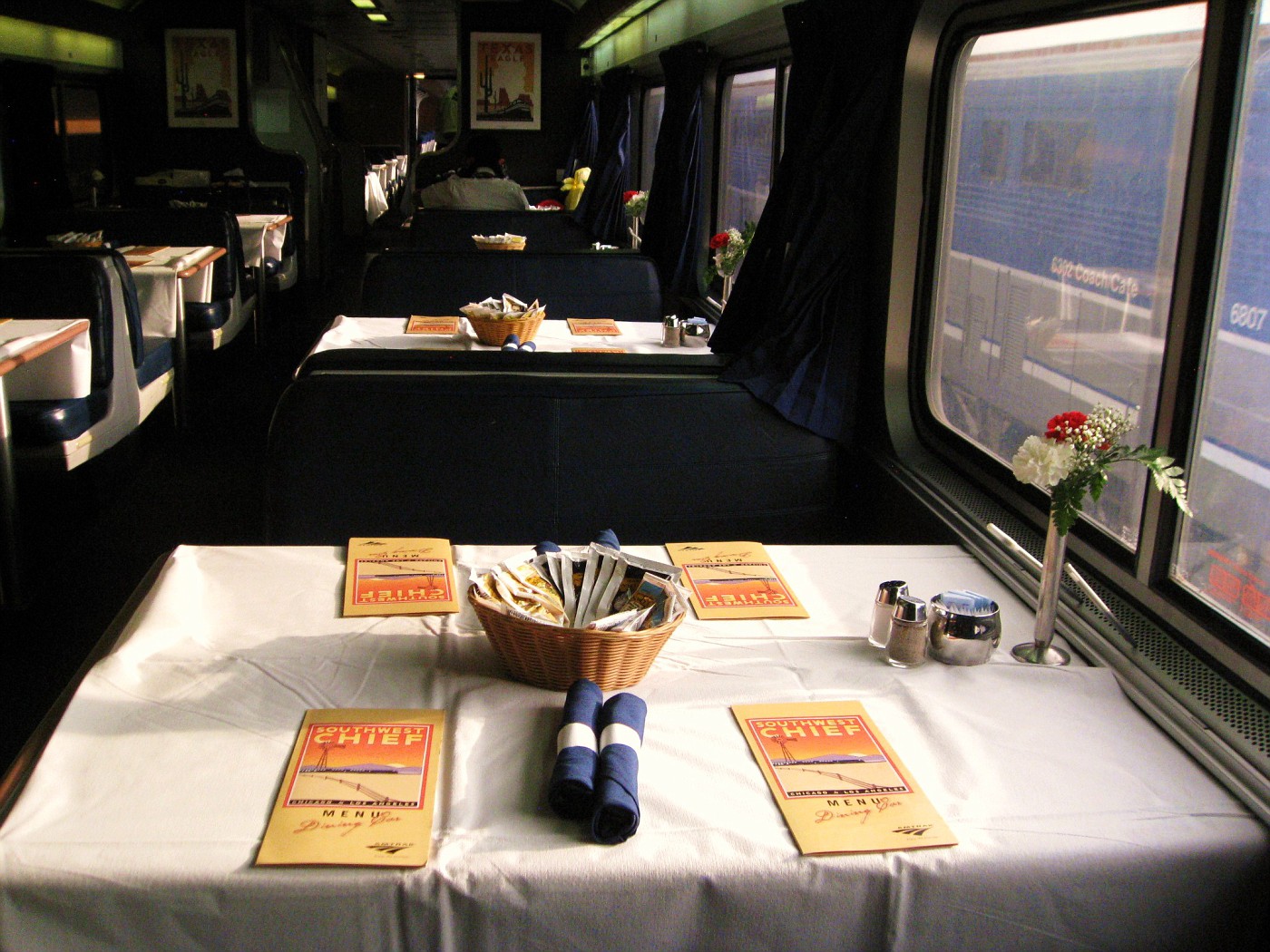
Dining car on the Southwest Chief
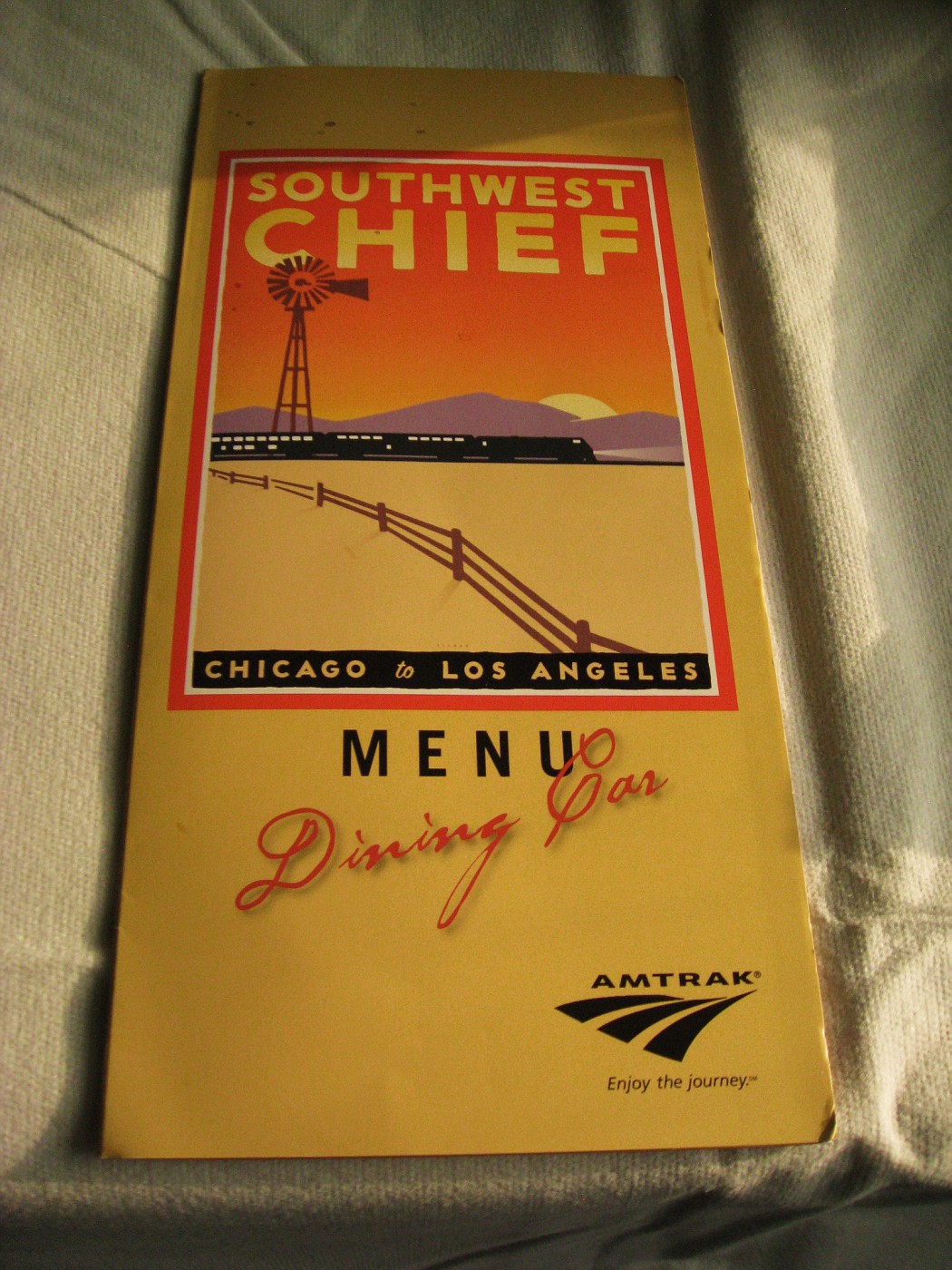
Menu Covers are unique to the train
Our waitress Bonnie arrived with a cheerful “Good evening” and an offer to bring drinks while we looked over our menus. After informing us that the Chef’s Special was a Turkey Shank, she then headed off to fetch a Jack Daniels for me and a Sam Adams for Joe. Shortly we were joined by Jorg, a young traveler from Austria who was on his way to Flagstaff to see the Grand Canyon.
Bonnie returned with drinks and salads and we placed our orders – the Turkey Shank for me and Wendy, a flat iron steak for Joe and the baked chicken for Jorg. It’s interesting to note that passengers are required to fill out their own meal order forms – the wait staff is not allowed to do so. There’s some archaic reason behind this but as of this writing I simply can’t recall so it’ll have to remain a mystery for now. Perhaps the next trip report!
Amongst our group, I was the only one traveling in the Sleeper. As such all of my meals were included in the fare, which is a big plus when you figure in the cost of eating three meals a day onboard. Indeed, the inclusion of meals is in large part why I’m willing to spend the extra money or points to travel in First Class on Amtrak. The quality of those meals is why I’m willing to part with several thousand extra miles to travel in First Class aboard the world’s finest airlines. Those of you who’ve read my other trip reports know that for me at least, meals are an integral part of an enjoyable travel experience. They represent delicious respite from the ennui of long distance travel, especially on airplanes where we’re so often isolated in our own private suites for hours on end.
The Swiss-British writer and philosopher Alain de Botton puts it best in his book "A week at the airport - A Heathrow Diary": "Naturally airline food is dismal when we compare it to what we'd get on the ground but this is to miss the point. The thrill of airline food lies in the interaction between the meal and the odd place in which one is eating it. Food that, if eaten in a kitchen, would have been banal or offensive, acquires a new taste in the presence of the clouds. With the in-flight tray, we make ourselves at home in an unhomely place: we appropriate the extraterrestrial skyscape with the help of a chilled bread roll and a plastic tray of potato salad."
And to think de Botton would appear to be writing about Economy Class meals! Here at FlyerTalk, more than a few of us have come to appreciate the elegance – not to mention deliciousness - of a well prepared and presented meal in International First Class. Some of you have also noted that I sure seem to eat a lot of food on my flights. Part of this perception is due to the fact that I focus on it and part of it is due to the fact that I take full advantage of the wonderful service being offered. After all, it’s not every day I’m presented with beautifully presented multi-course meals and on the rare occasion where it does happen, it’s either at Thanksgiving or at a very nice restaurant where I’m also going to be presented with a substantial bill afterwards.
So what I’m saying is if there are any self-righteous food police out there who cringe at what they consider to be my personal gluttony, go stick a fork in it because in this regard I am totally unrepentant. Indeed, one of my personal commandments when traveling in First Class is “Thou shalt not count calories!.
And what about all that food?! Well let me tell you, that turkey shank dinner was absolutely delicious! I accompanied it with a baked potato while Amtrak threw in some kind of a vegetable mix on the side. Joe, Wendy and Jorg all liked their meals as well. Conversation flowed and I enjoyed listening while my dinner companions provided some color to their personal lives and travels.
Interestingly, Joe turned out to be – as he put it – a vegetarian gone bad. Now he’s really into barbecue! I can totally relate because back in the eighties I dabbled in vegetarianism for almost a year before eventually returning meat to my diet. That said, I love vegetarian food and to this day still eat lots of millet, couscous, quinoa and other things which many of my fellow Americans tend to shy away from.
It also turned out we had something else in common. We were fellow newgrass and jamband fans. Joe and Wendy had been to a good number of festivals over the years, including my old favorite each summer in Telluride, Colorado. I raised a few eyebrows when I related that the cost of a three day pass for my first Telluride Bluegrass Festival in 1976 was a mere $19.00. These days that same ticket runs over $200.00!
Jorg was on his first trip to America and though he didn’t have much to add to the music related parts of our conversation, his tales of his present travels were quite interesting. He’d purchased an Amtrak Railpass and managed to put together an impressive itinerary that over the past two weeks had taken him from New York down to Florida, then back up to Washington DC and down to New Orleans. He’d actually ridden up to Chicago on the City of New Orleans with me but somehow our paths had never crossed while on that train. After visiting the Grand Canyon, he was headed for Los Angeles and then up to San Francisco and on to Denver before returning to New York and back home to Salzburg for the summer. He had a good spirit of adventure about him and was already looking forward to his next trip to the U.S. when he hoped to spend more time in Florida as well as see Yellowstone National Park.
After dinner, Jorg headed back to his seat in the coach while Joe, Wendy and I returned to the lounge car. I also made a quick trip back to my roomette to grab that bottle of Jim Beam Black Label that I’d purchased in Chicago.
For those of you who may be concerned about my beer and whiskey purchases prior to this trip, I don’t buy it all for myself. The last thing I want to do is sit in my roomette and drink all alone. I’m a social drinker and to that end I certainly don’t want to pay $7.00 per single serving bottle of Jack Daniels or $6.00 for a beer when with a little advance planning a $23.00 bottle of bourbon will supply the equivalent of about twelve of those $7.00 minis. I’m into sharing a good time and it’s a lot less expensive to “buy” rounds from my $23.00 bottle of bourbon than it is to pay $21.00 for a single round of three plus tip. Additionally, I’m not into getting drunk. I never have been. I appreciate the flavor of good beer and/or bourbon as well as the affect – but only to a point. My bottle would serve us well for this night.
Amtrak allows First Class passengers to bring their own liquor on board, though consumption is permitted only in their private compartments. Now for the most part I’m a fairly law abiding guy and were I to have had the spaciousness of a Superliner bedroom I would have gladly invited Joe and Wendy back for a drink. Unfortunately, Amtrak’s roomettes are a bit tight for any more than two people and so I decided to bring my bottle up to the lounge and enjoy it there. Discreetly.
The main thing in situations like this is to be discreet and be cool. Joe and Wendy seemed like pretty even keeled people so it was worth the chance. If we got caught we’d probably only be admonished to stop although you never know – some hard a$$ed conductor might decide to take a more Draconian stance and kick us off the train at the next stop.
For my part, I enjoy the challenge. After all, years of practice smoking pot in school taught me the benefits of discreet behavior. Those who were incapable of being discreet often got caught and were subsequently kicked out of school. Definitely not cool. I learned my manners while going to school in California with a bunch of pretty smart kids. We did mainly pot and LSD (back when it was still good!) and yet we still got our work done. My graduating class (all 16 of us) had a cumulative grade point average of over 3.1. We weren’t a bunch of down and out stoners. We used pot, sure, but the responsible ones amongst us didn’t abuse it to the point where we didn’t get our work done. Mind you I’m not putting this out there in support of drug use – I’m just saying this is what I went through back in the 1970s and how it’s colored my attitude and approach today. Different people will have different experiences. Mine were positive.
I told my dreadlocked nephew recently that if he ever got caught smoking pot, he ought to get a ticket for stupidity rather than 6th degree possession because it’s so easy to just enjoy your smoke, be cool and not get noticed. It’s the idiots that need to hoot and holler and generally draw negative attention to themselves that ruin it for the rest of us. That said, I quit smoking pot by the time I was 25. Although I enjoyed every bong hit I ever took, I returned from a trip to Australia one day and just decided I’d had enough. It was that simple.
We’d polished off about a third of the bottle (Wendy was drinking Screwdrivers from the bar) when we decided to call it a night. At this point we were about forty-five minutes out of Kansas City, sitting on a siding waiting for yet another freight to zoom by. There sure are a lot of trains on this line, and all of them except for us are freights. In those places that are double tracked, the sight and sound of these freights roaring by is quite impressive. I mean, we’re rolling along at close to 80mph and they’re heading in the opposite direction at similar speeds. The two of us are only about five feet apart and our combined speed when we meet is about 150mph. It’s all quite sudden. And noisy.
Since Joe and Wendy would be detraining at 3:30am in Newton, I bid so long to them and exchanged addresses so I could send them a couple CDs worth of music. We shared similar musical tastes and in our conversations it turned out I had all kinds of music from bands they’d never heard of. I spend a lot of time on sites like livedownloads.com searching out eclectic bands and performances, and I’m always happy to spread the good tunes. And who knows – maybe we’ll cross paths at a festival someday!
Back in my roomette, the temperature was pleasantly cool. My bed had already been put down and set up for the night so after breaking in a new tooth brush, I grabbed my latest book and put in a half hour or so of reading before lapsing into a comfortable sleep.
Amtrak Chicago to Los Angeles 300p – 815a Southwest Chief First Class Car 5 Room 11
The predecessor to Amtrak’s Southwest Chief was the Santa Fe’s Super Chief. Its gleaming silver cars were a standard bearer for the all-Pullman trains of its era. Memorable were the Southwest themed lounge cars, the Fred Harvey run dining cars and the luxurious Pleasure Domes with their large, overstuffed loungers upstairs under the glass. The Chief was synonymous with luxury on rails and was known as “The Train of The Stars” due to its popularity with the Hollywood glitterati.

Santa Fe’s Super Chief

Santa Fe’s Super Chief Postcard
I used to live in Durango, Colorado where I went to school at Fort Lewis College. Back in the mid-1970s I’d occasionally hitch-hike down to Gallup, New Mexico and catch the train over to Flagstaff, Arizona – about three hours and 180 miles down the line. Alas, I was a few years too late to have ridden The Super Chief for by then Amtrak had taken over the nation’s passenger rail service and the train was now known as the Southwest Limited. The story behind the name change to Southwest Limited and thence to the Southwest Chief is interesting and reflective of Amtrak’s history as a whole.
When Amtrak assumed operation of the nation’s passenger rail service back in May of 1971, train travel in America was in serious decline. The increasing popularity of travel by car and the interstate highway system combined with ever more affordable (and faster) air travel made rail travel increasingly passé. Worse yet, the government provided assistance to the competition in the form of federal subsidies for highways as well as to the airlines via the Essential Air Service program.
Over time, rail passenger traffic declined to the point where it was no longer profitable to operate long distance passenger trains. By 1970 many once esteemed streamliners that rolled across America with the pride and dignity that came with a tradition of world class service and accommodations were eventually reduced to just three or four lonely cars carrying a smattering of passengers and a demoralized crew. Like Arlo Guthrie sang, America had a bad case of the “disappearing railroad blues”.
Amtrak inherited a fleet of aging equipment and unhappy employees, many of whom faced an uncertain future. Indeed, about 70% of trains (and jobs) that had operated in the months before Amtrak took over immediately ceased to exist the day after. Most of the trains that Amtrak did choose to continue operating kept their original names.
Throughout the “Good Old Days” of post-World War II railroading, many people developed relationships with trains based upon the expectation of the quality services that had once been consistently provided. You could always count on your shoes being shined overnight and ready for you in the morning aboard the Broadway Limited. Some folks said the consistently excellent food aboard the Fred Harvey run dining cars of the Santa Fe was worth the extra cost of riding it. The pecan pie on the Kansas City Southern’s New Orleans bound “Southern Belle” was justifiably famous and what better way to end a successful business presentation in Chicago than with a perfectly made “Highball” in the stylish tavern/lounge car that brought up the rear of the “Pere Marquette”. There were years of pride and tradition associated with these named trains and it really was sad to see them slide into decline - much like witnessing a cherished relative slowly wasting away from a chronic disease.
Throughout the decline of the sixties and early seventies, a few railroads such as the Santa Fe and the New York Central still strived to provide a high level of service on their premier trains. When Amtrak took over, the subsequent standardization of services nationwide resulted in a considerable drop in quality for trains like the Super Chief and the Twentieth Century Limited.
After witnessing three years of substandard service under Amtrak administration, the Santa Fe went to court in 1974 and won an injunction forcing Amtrak to stop using the name Super Chief because the level of service was so far beneath the standard traditionally associated with the train – and by extension - the railroad. For the next ten years the ex-Santa Fe Chicago to Los Angeles train was called the Southwest Limited. It wasn’t until the arrival of Amtrak’s new bi-level Superliner equipment in the early 1980s along with a system wide enhancement of passenger services that the Santa Fe relented and allowed Amtrak to change the name of the train to the Southwest Chief.
Fast forward to the present and today’s Southwest Chief is one of the most popular and well patronized trains in the Amtrak system. Although its First Class service bears little resemblance to the standard set by the Santa Fe’s all-Pullman Chiefs of the 1950s, a ride aboard this train still provides a comfortable and scenic adventure for those willing to slow down and spend a couple of days traveling across America at “See Level”.

Route of the Southwest Chief
The 2265 mile route will take us through Illinois, Iowa, Missouri, Kansas, Colorado, New Mexico, Arizona, and California before pulling into Los Angeles two days from now at 8:15am. Anticipating the pleasant journey to come, I strolled down the platform to car 331 where car attendant Maria stood with bright eyes and a pretty smile, ready to greet and assist her passengers.

Train time at Union Station
As always, I’ve booked Roomette 11, located downstairs on the lower level. Maria helped me stow my bag and promised to stop by with more information about the trip ahead once we were underway. Grabbing my camera, I headed upstairs to take a few pictures of Amtrak’s spacious bedroom accommodations – hopefully before any of their occupants arrived.
When it comes to taking pictures onboard a train, the best time to do so is while sitting in the station. Since the train is not moving, you can get much better photos than you would while it’s rocking and rolling its way down the tracks. As for those wonderful bedroom accommodations, I would love to enjoy such spaciousness but of course, they come at a considerably higher price – to wit twice the amount of points that I’ve cashed in for my humble roomette. Still, one can always dream. Let’s go upstairs and check ‘em out!

Amtrak’s Superliner Bedroom Seating

Amtrak’s Superliner Bedroom Seating

Amtrak’s Superliner Bedroom Toilet and Shower
When I heard the “All Aboard” call ring out, a glance at my watch indicated it was 2:58pm. Last minute photographers and laggardly passengers scampered onboard, the doors were closed and at 3 o’clock on the dot the twin P42DC locomotives powered up and slowly eased us out of the station.
Like many big city terminals, the boarding platforms at Chicago’s Union Station are underground so the first five minutes of this trip were spent rolling through a subterranean world of support beams, bare dirty light bulbs, dark railroad cars and the occasional human being. In the darkness it was difficult to discern whether the people I saw were railroad employees or homeless denizens of the station’s underworld.
As we emerged into bright afternoon sunlight, I reached down into the makeshift cooler I’d created from my garbage can and extracted a nicely chilled can of beer. Reclining my seat, I opened a sleeve of mixed nuts and took that first long pull off the beer. Ah… I love this part of the trip! It’s like Friday night with the whole weekend ahead of you. Here we are rolling along through the Chicago suburbs with the promise of forty-three more hours of pretty scenery, good company, tasty meals and comfortable accommodations. Play that out from the comfort of a big wide seat accompanied by the rhythmic clickety-clack of the rails and you’ve got a wonderful recipe for travel contentment. I had another pull on my beer and considered my lot in life. It’s good. It’s all good…
The Southwest Chief follows one of the most historic and scenic routes in the nation. First blazed by native Americans, then Spanish conquistadors, pioneers and gold miners, the route eventually became known as the Santa Fe Trail. The Atchison, Topeka and Santa Fe Railway traces its beginnings back to 1859 when work began to lay rail connecting Atchison and Topeka, Kansas with Santa Fe, New Mexico. Why stop there though? Albuquerque was reached in 1880 and the next year the ATS&F tracks reached Deming, New Mexico where they connected with the Southern Pacific’s line to the West Coast. The combination of these two lines resulted in the nation’s second transcontinental rail route, the first being the Union and Central Pacific Railroads’ more northerly mainline through Nebraska, Wyoming, Utah and Nevada. Through a combination of construction and trades with the Southern Pacific, the Santa Fe reached Los Angeles in 1897, thus making the ATS&F the first railroad to have its own tracks from Chicago all the way to the Pacific coast.
But enough of the history lesson. Let’s check out the view!
The maximum speed for Amtrak’s Superliners is 79mph. The one exception is out in western New Mexico and through most of Arizona where speeds of up to 90mph are attained. While this would be considered slow by European and Asian rail standards, here in America’s heartland it looks and feels pretty fast. I think it’s a good speed to appreciate the landscape zipping past my window which at present is comprised of low rolling farmland offset by attractive old farmhouses, barns, silos and the occasional copse of cottonwood trees. This is what airline passengers refer to as “fly over” country. While not the dramatic scenery of the mountain west, it still holds a rustic appeal that could never be appreciated from the air. I particularly like the colorful old barns I see out here. Some of the communities we passed through were little more than a collection of houses set amidst a nicely treed meadow. As we flashed through the occasional small town I was impressed by the old brick buildings and quaint storefronts, most of them housing businesses owned by real people rather than large corporations. There are no Burger Kings or CVS Pharmacies on these streets. This is the small town America that many people only get to read about. Most tourists, especially those from overseas, rarely ever venture out to towns like these but I’d like to think that if they did they’d leave with a very favorable impression of their visit, and indeed America as a whole.

Main Street USA
As seen in Saguache, Colorado
So, it’s been said that a train is a place that’s going somewhere. On this train that place includes a full service dining car and the Sightseer Lounge Car. A trip of this length can be very long and uneventful if you confine yourself to your seat or bedroom. Let’s go out and mingle!
Unlike an airplane where everyone is going to the same place, the train is constantly dropping off and picking up new passengers along the way. As such, spending some time in the lounge or diner provides a unique opportunity to meet a constantly changing collection of travelers as well as the train crew who are there to serve you. The lounge car in particular invites conviviality.
Unless you’re a hardened road warrior, for most of us the act of traveling somewhere is still pretty exciting. Sitting in the lounge car with your favorite libation while enjoying a close up view of the land you’re traveling through invokes a sense of shared experience in a way that the comparatively sterile confines of a modern day airliner never will. Honestly – the midflight experience aboard most airplanes these days is pretty darned boring since you’re sitting in a darkened tube where most people have their window shades drawn, their Bose headsets on and they’re hooked into their laptops, IFEs or mp3s. The social environment screams “Leave me alone!” and invites isolation.
By comparison, on a train you’re surrounded by light and scenery. The single window in my roomette is huge, measuring approximately 2 feet high by 5 feet long. In the Sightseer Lounge the multiple windows are even larger, starting at knee height and measuring approximately 3 ½ feet high by 6 feet long. Where the wall curves into the ceiling are even more windows allowing for better viewing when traveling through canyons or past high mountains. As one who’s always related to the earth’s natural wonders more so than its manmade ones, I really appreciate the light and view afforded by all those windows.
The lounge car on a train is a social place where the shared excitement of the trip fosters interaction. People like to talk about their upcoming adventures – be it a quick trip to their cousin’s wedding 300 miles down the line in Kansas City or a month long excursion through the American West on an Amtrak Railpass. I’ve often found that once I’ve located an open seat in the lounge car, a simple “Hey there – how’s it going? Where you headed?” can often result in some great conversation and occasionally even friendships. Other times it’s a pleasant place to take in the scenery through the huge windows. Electrical outlets are available throughout the car for those wanting to plug in a laptop or DVD player.

Amtrak’s Superliner Sightseer Lounge
One half of the lounge car is booth and table seating

Amtrak’s Superliner Sightseer Lounge
The other half is individual seats and couchettes. These swivel to face either side of the train.
A group of four could conceivably turn two from each side to face eachother

Santa Fe Chief Lounge
Today I met Joe and Wendy who were on their way back home to Newton, Kansas after a week visiting family in upstate New York. Their journey had started the day before aboard the Lakeshore Limited out of Albany, New York and this was the second time they’d done this trip by train. Wendy explained that they’d discovered the train five years ago when a search for low airfares between Wichita and Albany proved to be an unpleasant and unfulfilling experience. Amtrak offered a great fare and although the departure and arrival times out of Newton weren’t ideal, at least they wouldn’t have to drive down to Wichita and pay for airport parking.
Since we all had 6:00pm dinner reservations, we decided to continue our conversation over dinner in the diner. I should add here that I usually try to arrange for an earlier seating because experience has taught me that the more popular entrees – such as the steak – occasionally run out later in the evening.

Dining car on the Southwest Chief

Menu Covers are unique to the train
Our waitress Bonnie arrived with a cheerful “Good evening” and an offer to bring drinks while we looked over our menus. After informing us that the Chef’s Special was a Turkey Shank, she then headed off to fetch a Jack Daniels for me and a Sam Adams for Joe. Shortly we were joined by Jorg, a young traveler from Austria who was on his way to Flagstaff to see the Grand Canyon.
Bonnie returned with drinks and salads and we placed our orders – the Turkey Shank for me and Wendy, a flat iron steak for Joe and the baked chicken for Jorg. It’s interesting to note that passengers are required to fill out their own meal order forms – the wait staff is not allowed to do so. There’s some archaic reason behind this but as of this writing I simply can’t recall so it’ll have to remain a mystery for now. Perhaps the next trip report!
Amongst our group, I was the only one traveling in the Sleeper. As such all of my meals were included in the fare, which is a big plus when you figure in the cost of eating three meals a day onboard. Indeed, the inclusion of meals is in large part why I’m willing to spend the extra money or points to travel in First Class on Amtrak. The quality of those meals is why I’m willing to part with several thousand extra miles to travel in First Class aboard the world’s finest airlines. Those of you who’ve read my other trip reports know that for me at least, meals are an integral part of an enjoyable travel experience. They represent delicious respite from the ennui of long distance travel, especially on airplanes where we’re so often isolated in our own private suites for hours on end.
The Swiss-British writer and philosopher Alain de Botton puts it best in his book "A week at the airport - A Heathrow Diary": "Naturally airline food is dismal when we compare it to what we'd get on the ground but this is to miss the point. The thrill of airline food lies in the interaction between the meal and the odd place in which one is eating it. Food that, if eaten in a kitchen, would have been banal or offensive, acquires a new taste in the presence of the clouds. With the in-flight tray, we make ourselves at home in an unhomely place: we appropriate the extraterrestrial skyscape with the help of a chilled bread roll and a plastic tray of potato salad."
And to think de Botton would appear to be writing about Economy Class meals! Here at FlyerTalk, more than a few of us have come to appreciate the elegance – not to mention deliciousness - of a well prepared and presented meal in International First Class. Some of you have also noted that I sure seem to eat a lot of food on my flights. Part of this perception is due to the fact that I focus on it and part of it is due to the fact that I take full advantage of the wonderful service being offered. After all, it’s not every day I’m presented with beautifully presented multi-course meals and on the rare occasion where it does happen, it’s either at Thanksgiving or at a very nice restaurant where I’m also going to be presented with a substantial bill afterwards.
So what I’m saying is if there are any self-righteous food police out there who cringe at what they consider to be my personal gluttony, go stick a fork in it because in this regard I am totally unrepentant. Indeed, one of my personal commandments when traveling in First Class is “Thou shalt not count calories!.
And what about all that food?! Well let me tell you, that turkey shank dinner was absolutely delicious! I accompanied it with a baked potato while Amtrak threw in some kind of a vegetable mix on the side. Joe, Wendy and Jorg all liked their meals as well. Conversation flowed and I enjoyed listening while my dinner companions provided some color to their personal lives and travels.
Interestingly, Joe turned out to be – as he put it – a vegetarian gone bad. Now he’s really into barbecue! I can totally relate because back in the eighties I dabbled in vegetarianism for almost a year before eventually returning meat to my diet. That said, I love vegetarian food and to this day still eat lots of millet, couscous, quinoa and other things which many of my fellow Americans tend to shy away from.
It also turned out we had something else in common. We were fellow newgrass and jamband fans. Joe and Wendy had been to a good number of festivals over the years, including my old favorite each summer in Telluride, Colorado. I raised a few eyebrows when I related that the cost of a three day pass for my first Telluride Bluegrass Festival in 1976 was a mere $19.00. These days that same ticket runs over $200.00!
Jorg was on his first trip to America and though he didn’t have much to add to the music related parts of our conversation, his tales of his present travels were quite interesting. He’d purchased an Amtrak Railpass and managed to put together an impressive itinerary that over the past two weeks had taken him from New York down to Florida, then back up to Washington DC and down to New Orleans. He’d actually ridden up to Chicago on the City of New Orleans with me but somehow our paths had never crossed while on that train. After visiting the Grand Canyon, he was headed for Los Angeles and then up to San Francisco and on to Denver before returning to New York and back home to Salzburg for the summer. He had a good spirit of adventure about him and was already looking forward to his next trip to the U.S. when he hoped to spend more time in Florida as well as see Yellowstone National Park.
After dinner, Jorg headed back to his seat in the coach while Joe, Wendy and I returned to the lounge car. I also made a quick trip back to my roomette to grab that bottle of Jim Beam Black Label that I’d purchased in Chicago.
For those of you who may be concerned about my beer and whiskey purchases prior to this trip, I don’t buy it all for myself. The last thing I want to do is sit in my roomette and drink all alone. I’m a social drinker and to that end I certainly don’t want to pay $7.00 per single serving bottle of Jack Daniels or $6.00 for a beer when with a little advance planning a $23.00 bottle of bourbon will supply the equivalent of about twelve of those $7.00 minis. I’m into sharing a good time and it’s a lot less expensive to “buy” rounds from my $23.00 bottle of bourbon than it is to pay $21.00 for a single round of three plus tip. Additionally, I’m not into getting drunk. I never have been. I appreciate the flavor of good beer and/or bourbon as well as the affect – but only to a point. My bottle would serve us well for this night.
Amtrak allows First Class passengers to bring their own liquor on board, though consumption is permitted only in their private compartments. Now for the most part I’m a fairly law abiding guy and were I to have had the spaciousness of a Superliner bedroom I would have gladly invited Joe and Wendy back for a drink. Unfortunately, Amtrak’s roomettes are a bit tight for any more than two people and so I decided to bring my bottle up to the lounge and enjoy it there. Discreetly.
The main thing in situations like this is to be discreet and be cool. Joe and Wendy seemed like pretty even keeled people so it was worth the chance. If we got caught we’d probably only be admonished to stop although you never know – some hard a$$ed conductor might decide to take a more Draconian stance and kick us off the train at the next stop.
For my part, I enjoy the challenge. After all, years of practice smoking pot in school taught me the benefits of discreet behavior. Those who were incapable of being discreet often got caught and were subsequently kicked out of school. Definitely not cool. I learned my manners while going to school in California with a bunch of pretty smart kids. We did mainly pot and LSD (back when it was still good!) and yet we still got our work done. My graduating class (all 16 of us) had a cumulative grade point average of over 3.1. We weren’t a bunch of down and out stoners. We used pot, sure, but the responsible ones amongst us didn’t abuse it to the point where we didn’t get our work done. Mind you I’m not putting this out there in support of drug use – I’m just saying this is what I went through back in the 1970s and how it’s colored my attitude and approach today. Different people will have different experiences. Mine were positive.
I told my dreadlocked nephew recently that if he ever got caught smoking pot, he ought to get a ticket for stupidity rather than 6th degree possession because it’s so easy to just enjoy your smoke, be cool and not get noticed. It’s the idiots that need to hoot and holler and generally draw negative attention to themselves that ruin it for the rest of us. That said, I quit smoking pot by the time I was 25. Although I enjoyed every bong hit I ever took, I returned from a trip to Australia one day and just decided I’d had enough. It was that simple.
We’d polished off about a third of the bottle (Wendy was drinking Screwdrivers from the bar) when we decided to call it a night. At this point we were about forty-five minutes out of Kansas City, sitting on a siding waiting for yet another freight to zoom by. There sure are a lot of trains on this line, and all of them except for us are freights. In those places that are double tracked, the sight and sound of these freights roaring by is quite impressive. I mean, we’re rolling along at close to 80mph and they’re heading in the opposite direction at similar speeds. The two of us are only about five feet apart and our combined speed when we meet is about 150mph. It’s all quite sudden. And noisy.
Since Joe and Wendy would be detraining at 3:30am in Newton, I bid so long to them and exchanged addresses so I could send them a couple CDs worth of music. We shared similar musical tastes and in our conversations it turned out I had all kinds of music from bands they’d never heard of. I spend a lot of time on sites like livedownloads.com searching out eclectic bands and performances, and I’m always happy to spread the good tunes. And who knows – maybe we’ll cross paths at a festival someday!
Back in my roomette, the temperature was pleasantly cool. My bed had already been put down and set up for the night so after breaking in a new tooth brush, I grabbed my latest book and put in a half hour or so of reading before lapsing into a comfortable sleep.
Last edited by Seat 2A; May 12, 2015 at 8:54 am
#6
FlyerTalk Evangelist
Original Poster
Join Date: Apr 2001
Location: East Ester, Alaska
Programs: Alaska Million Miler, United Million Miler, Wyndham Rewards Diamond, Choice Hotels Diamond
Posts: 12,148
Day Seven
Enroute aboard the Southwest Chief
I awoke early to a bright sunny day as we rolled westward through southwestern Kansas. The low hills and dales of the Arkansas River valley were very pretty, much more appealing than the Interstate 70 corridor up north which appears to be little more than an endless field of … well, whatever it’s made up of. I do remember a few sunflowers here and there. And some corn. Mainly though it was just a lot of low beige flatlands. Down here however there were low buttes and green trees and generally it was all much more to my liking.
Yawn. Strrrettttch. It sure feels good to be out in the wide open spaces again!
According to the schedule and assuming we were on time, we ought to have been somewhere between Dodge City and Garden City, Kansas. As it turned out however, we were running about 40 minutes late and had only recently pulled out of Dodge City. Had we been running just a bit later I would like to have been awake for the Dodge City stop because I’d read that toward the far end of the station platform there are two large sundials. One is set to show the time in the Central Time Zone and the other is set to show the time in the Mountain Time Zone. For those who may not know, time zones were originally established by the railroads back in 1883 and the original time zone line in this area ran between these two sundials. These days the change doesn't come until we’re west of Garden City.
Superliner bedrooms have their own toilet and shower ensuite but the roomettes all share a single shower downstairs, just off the vestibule. Nobody was in the shower at present however, so I wasted no time in picking up a towel and relocating. Since my luggage was stowed just adjacent to the shower area, I grabbed a change of clothes and some shampoo as well.
Amtrak Superliner showers are spacious and supply a good stream of hot water. They’re quite a treat compared to my shower at home. Because I’m not on city water, I have to haul water in once or twice a week. For a shower I just heat up a couple gallons of water on my stove and then transfer it to a 4 gallon wastebasket. From there I’ve rigged up an old electric pump from a motorhome that pulls the water up out of the wastebasket and pumps it into my shower stall. Voila!
That said, I do appreciate the luxury of being able to just walk into a shower and have hot water available on demand. What a treat! And on a train, no less!
Fifteen minutes later I presented myself in the dining car where I was directed to a table already occupied by a couple in their fifties. My salutation of “Good Morning” was returned with a mumbled “Marnin” from the man and nothing from his wife. They reminded me of that couple in the movie “Fargo” that was disappointed upon arriving to pick up their new car and then discovering that they were expected to pay for a layer of “True Coat” which they hadn’t ordered. It quickly became apparent that neither of these folks were comfortable with conversation, so we ordered our breakfasts and spent the next twenty minutes watching the country roll by. It happens sometimes…
After breakfast I relocated to the lounge car where I nursed a cup of coffee and watched as we rolled from Kansas into Colorado.
“Where are the Rocky Mountains?” I heard a lady ask who was seated a few seats down from me.
About 150 miles to the west of us, I silently answered. This train doesn’t present classic views of the Rockies like the California Zephyr, whose journey from Chicago to Emeryville, California (Oakland) takes it right through the heart of the Rockies as it climbs west out of Denver through 29 tunnels, under the continental divide via the 9000’ high Moffatt Tunnel and then follows the Colorado River for another two hundred some odd miles out of the Rockies and into Utah.
Our route takes us through the plains and buttes of southeastern Colorado before turning south at Trinidad and heading down into New Mexico. During the summer months, volunteer rangers with the Trails & Rails program from the National Park Service travel onboard and provide a narrative between La Junta, Colorado, and Albuquerque, New Mexico. None were onboard today though, so perhaps that service won’t begin until June.
At Trinidad we’re just a bit to the east of the Sangre de Christo Mountains where a couple of the peaks top out at over 14000 feet. Those peaks are best viewed from the western side however. Also located on the western side of the range is the Great Sand Dunes National Park. Continuing south we slowed a bit as we began the long and scenic climb up over Raton Pass and Glorieta Pass. Technically speaking, we could be said to be traveling through the southern end of the Rocky Mountains, even though the main thrust of them is a bit farther to the west – over by Taos. The landscape here, while not as dramatic as the Zephyr’s route through the Rockies, is nonetheless quite pretty with lots of reddish and ochre tinted rock providing plenty of color, especially in the numerous shallow canyons we traversed.
The man seated next to me had a guide book and as we passed through Glorieta Canyon he mentioned that this was the westernmost battlefield of the Civil War. A little farther down the tracks in Apache Canyon we eased through a very narrow passage where the rock walls came within only a foot or two of the train. Eventually we passed over the Pecos River and around a large S curve before easing into Raton, New Mexico where the elevation is 7,588 feet.
Raton looks very much like a town right off the set of a western movie. The dry and dusty streets looked perfect for a gunfight at high noon. We spent about ten minutes on the platform which was also perfect for all the smokers onboard who cherish any stop longer than five minutes as smoking is not allowed on Amtrak trains.
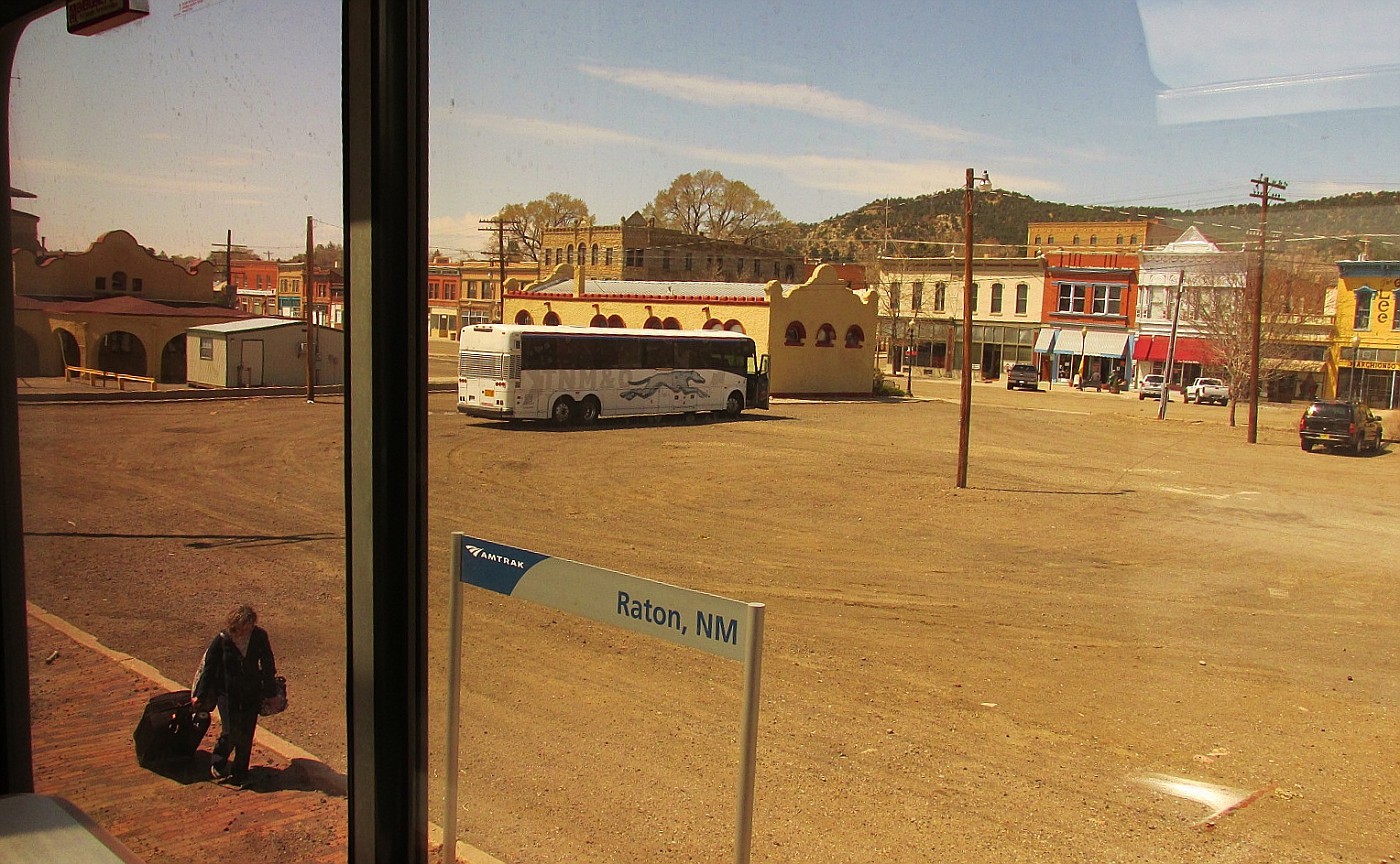
Raton, New Mexico
I was in the dining car enjoying my favorite black bean burger with bacon when we powered out of Raton and continued our journey south. The next smoke stop wouldn’t be until we reached Albuquerque - another three hours down the tracks. I’m sure glad I quit back in the days when you could still smoke onboard these trains!
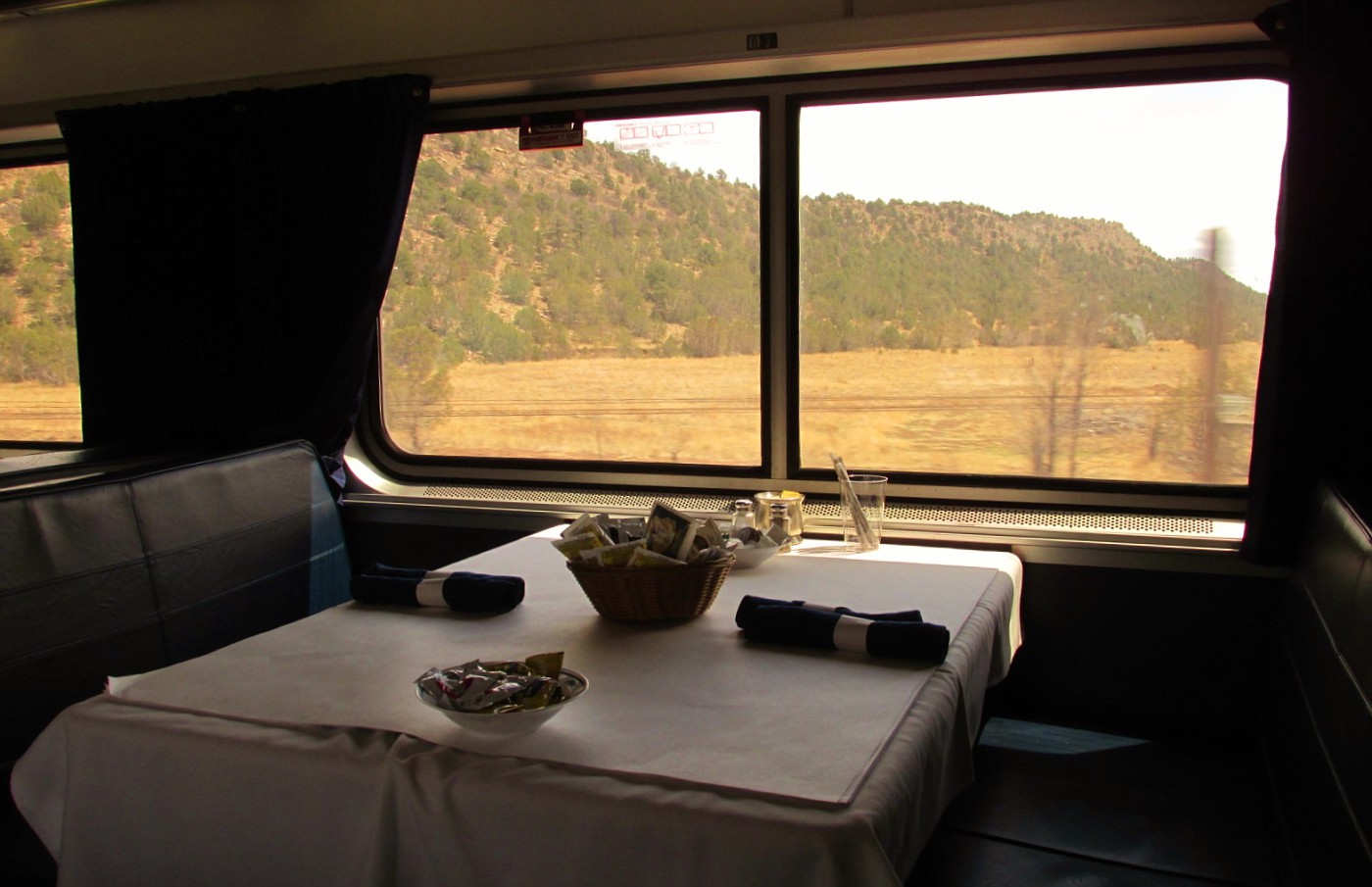
Lunchtime on the Southwest Chief

Table setting on the Southwest Chief
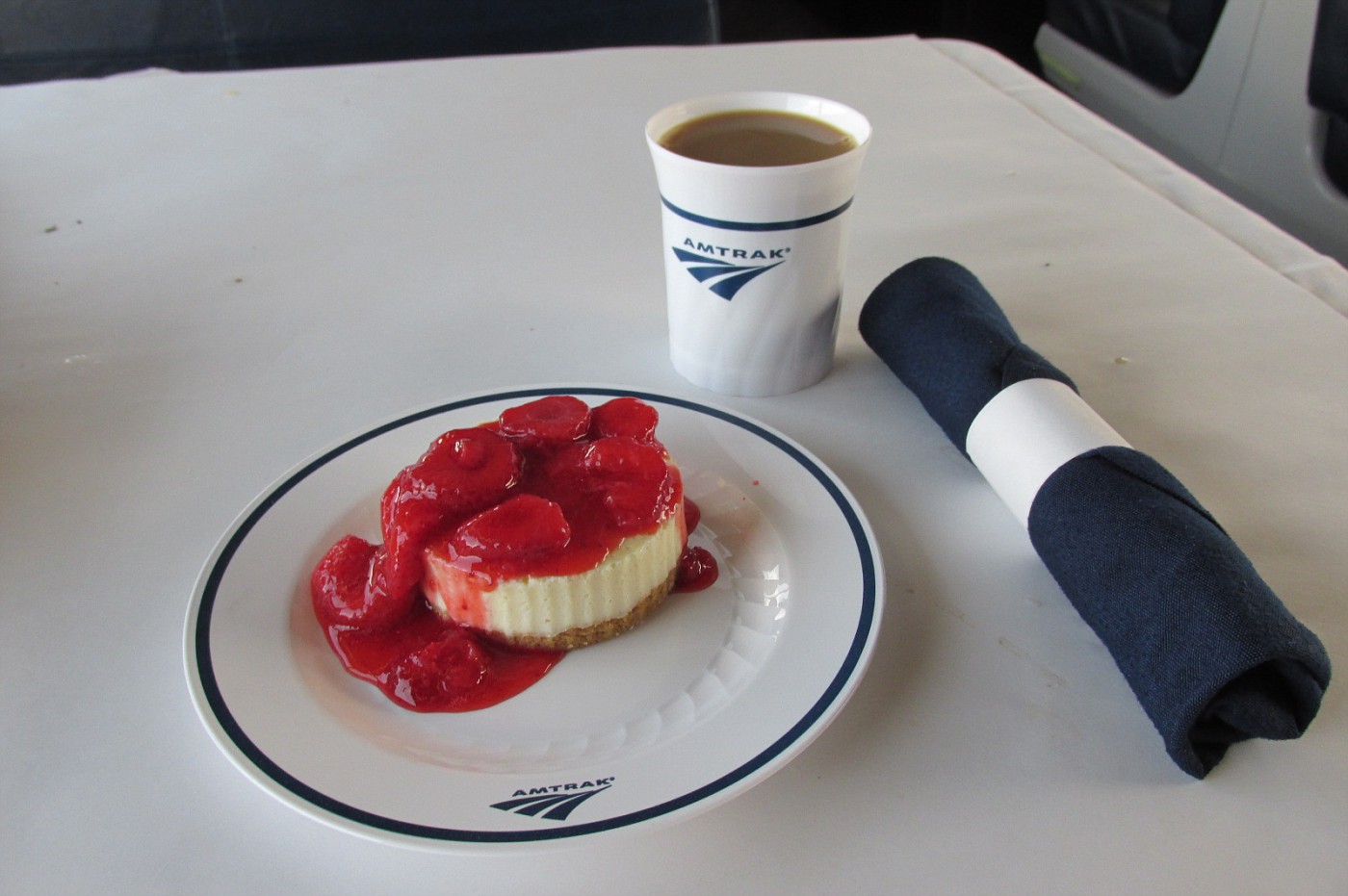
Cheesecake on the Chief
An announcement was made over the PA that we’d soon be arriving in Las Vegas. Our time there would be very brief so anybody not detraining in Las Vegas please remain onboard. As we eased to a stop in front of the small, adobe station I heard a man exclaim with surprise “THIS is Las Vegas?!”
New Mexico, Dude… not Nevada.
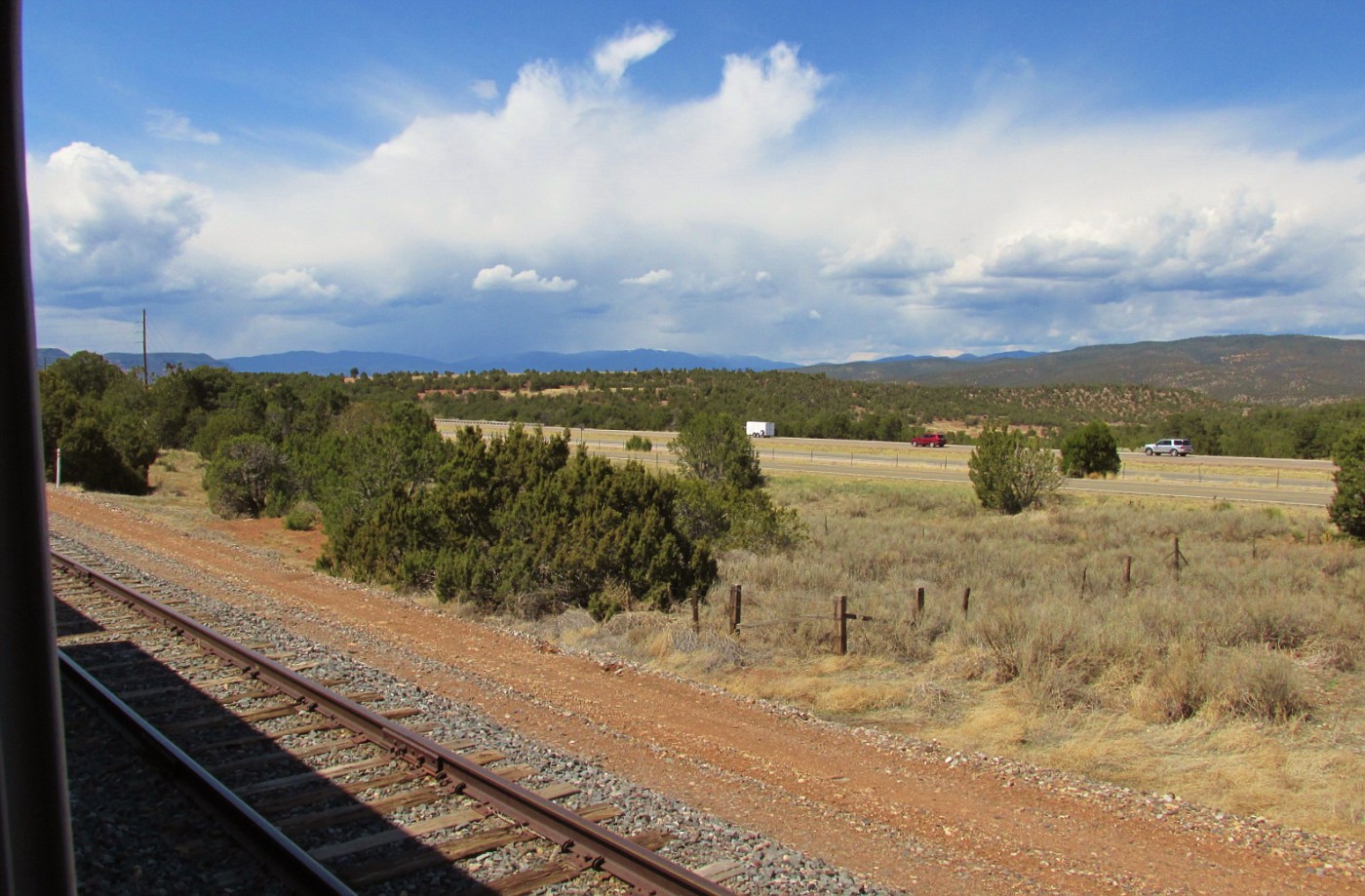
Racing traffic to Albuquerque
Albuquerque is both a service stop and a crew change point for the Southwest Limited. By crew I mean the conductor and engineers – not the train staff. Either way, it meant that we’d be here for a good half hour before continuing westward. Because of the extended time traditionally spent in the station, the platform hosts a number of local vendors selling everything from Navajo jewelry to Kachina dolls to Mexican blankets. Judging by the small crowds gathered around a couple of them, business was brisk. I wish they had a place selling good New Mexican tamales down here. What a treat!
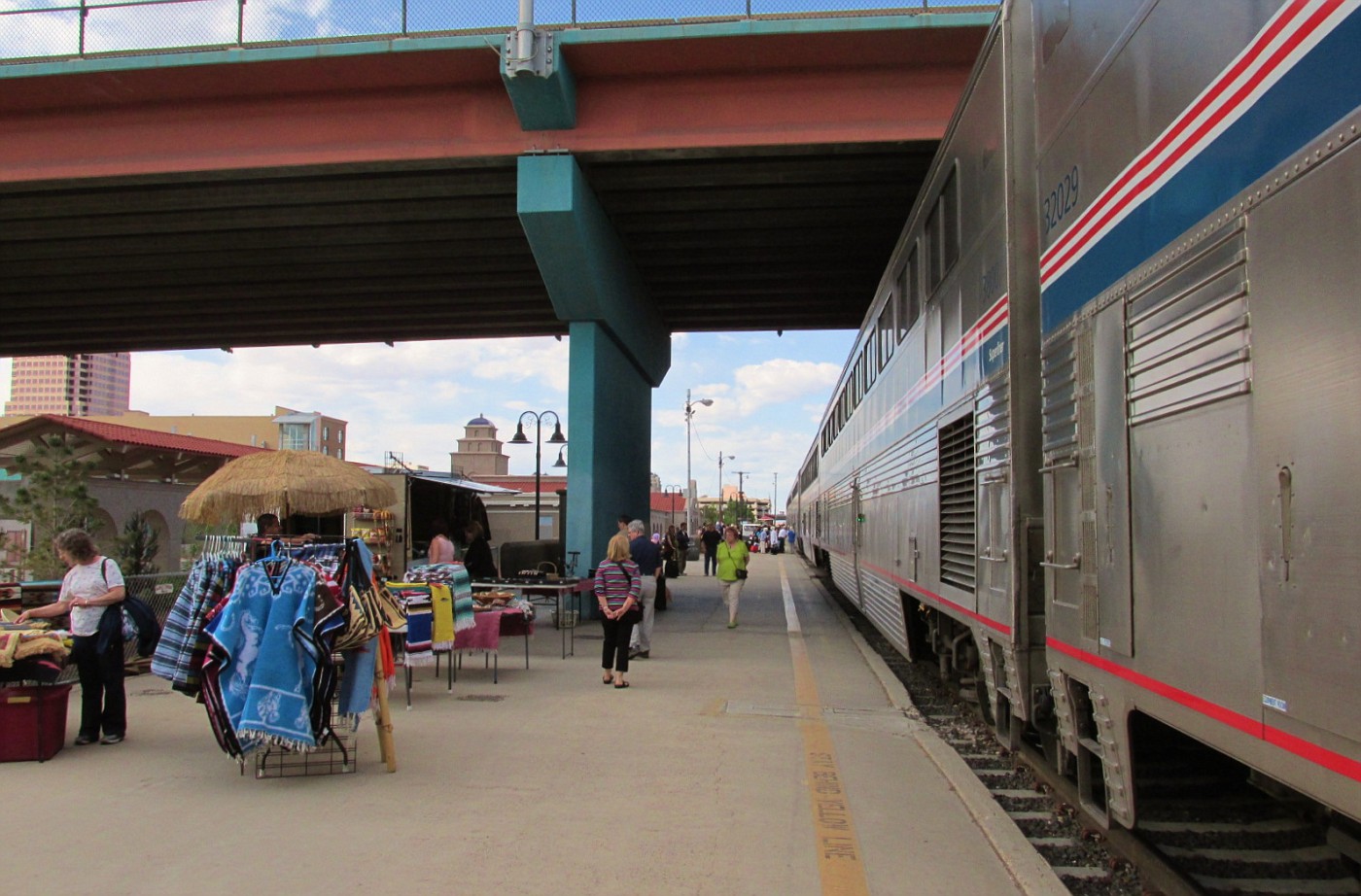
Buyers and Sellers on the platform at Albuquerque
As we re-boarded the train, I glanced at my watch and noted that at this point we were running about 45 minutes late. I had an hour and forty-five minute layover in Los Angeles and wasn’t too concerned - yet. If however we were to incur more substantial delays, those of us connecting to points north of San Francisco on the Coast Starlight would be bussed from Barstow up to Sacramento. To me at least this would be disastrous because it would mean I’d miss the beautiful coastal scenery seen north of Santa Barbara as well as the pretty mountain scenery in and around San Luis Obispo. Frank – our ever jovial lounge car attendant – said not to worry. We’d make up a good chunk of that time as we sped across the desert between Gallup, New Mexico and Needles, California. Heck – we might even get into LA early! Hmm… we’ll see…
Once we’d cleared the Albuquerque suburbs, our pace increased substantially. The speed limit out here is 90mph and the engineers seemed determined to utilize every last bit of it. The Santa Fe was one of the first railroads (if not the first) to lay electrically welded rail and so our tracks not only allowed for faster speed but they also provided a wonderfully smooth ride. Out my window was a panorama of colorful buttes and painted desert. Yellow, red, brown, ochre and beige were the colors of the day. I was enjoying it all from the comfort of my roomette where I had my seat reclined and my legs up on the seat across from me. It was a pretty afternoon and life could not have been finer… It sure is good to be back home in the west!
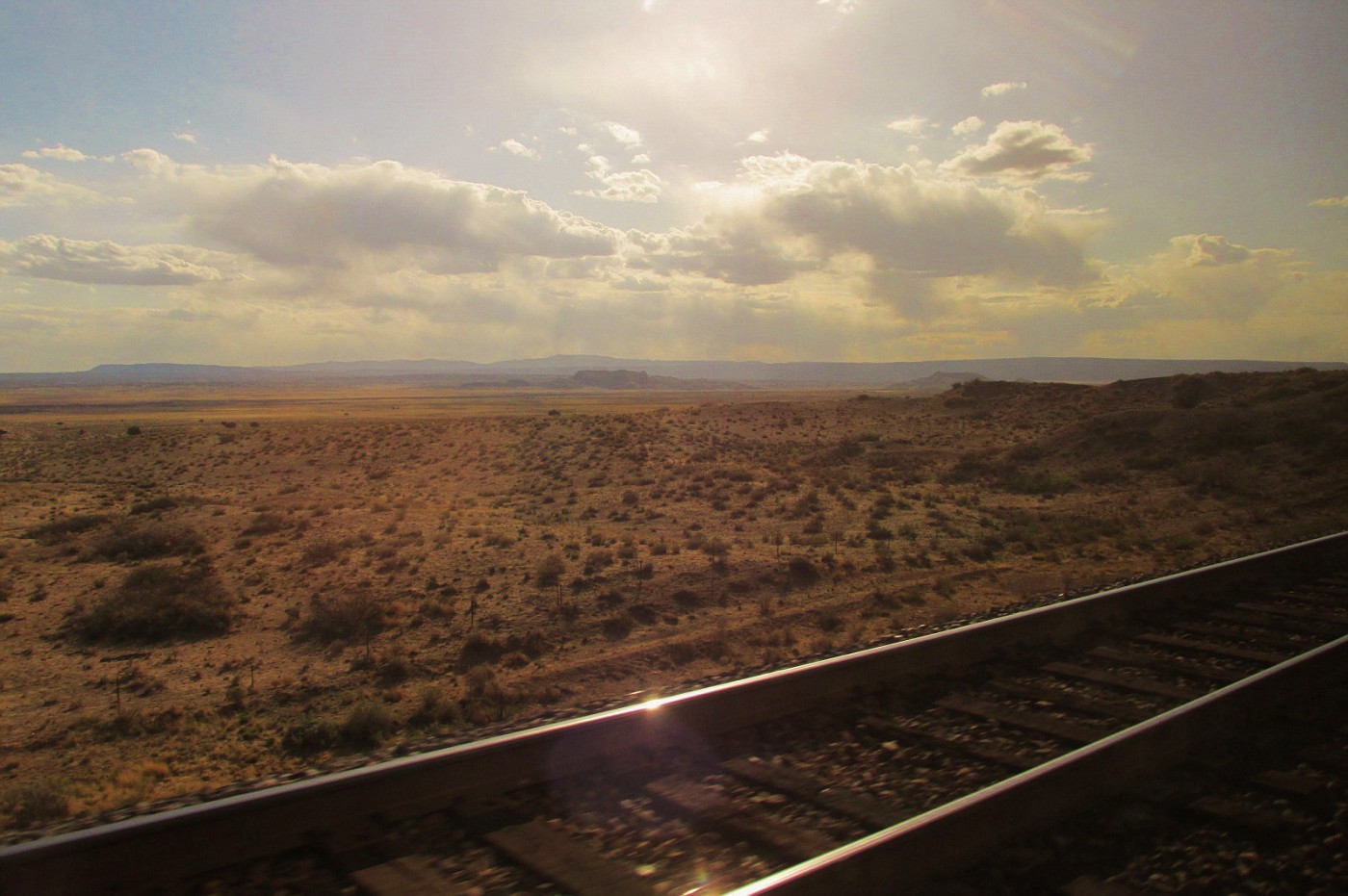
Speeding across the Chihuahua Desert
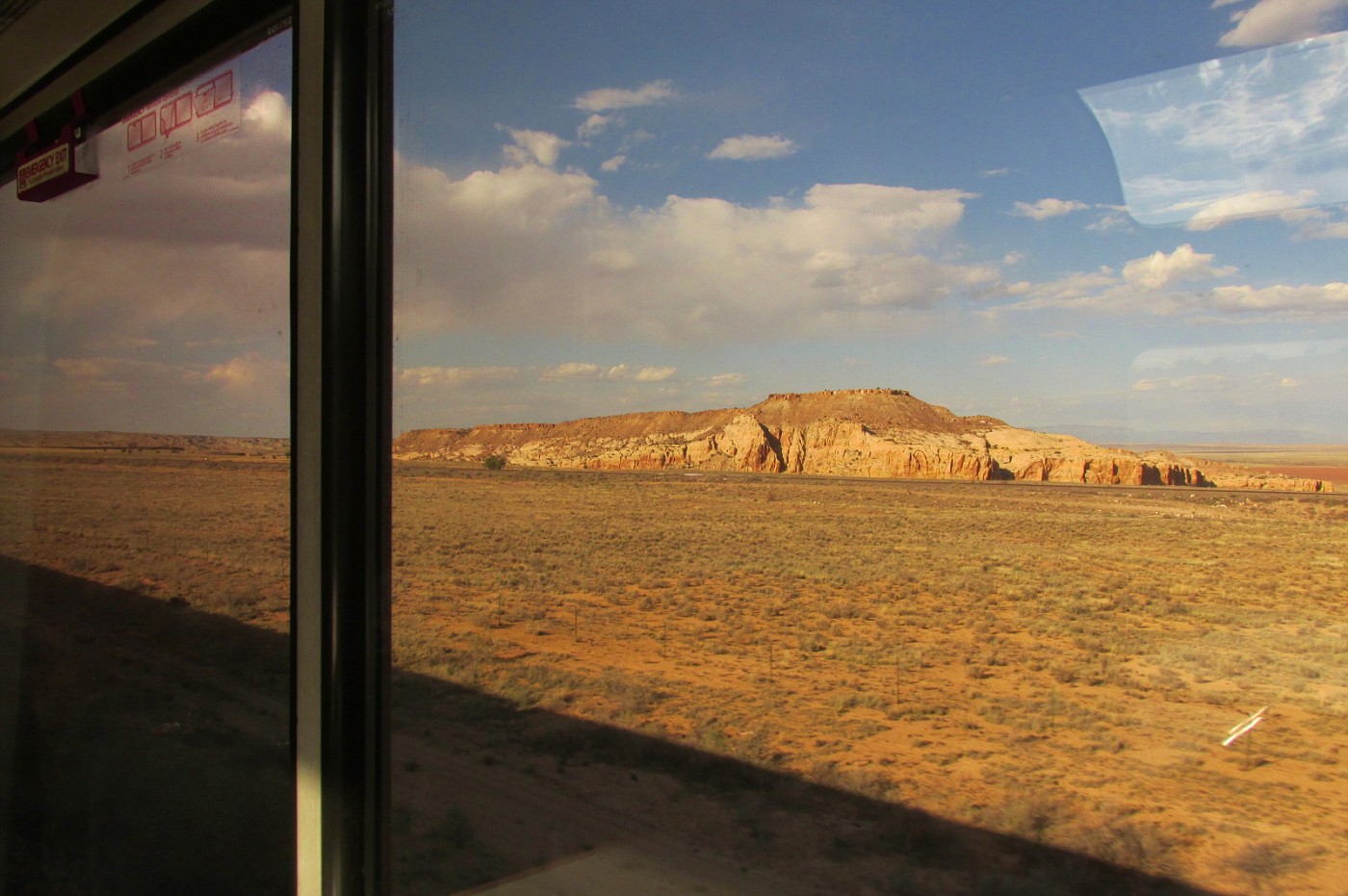
Grants, New Mexico in 20 minutes…
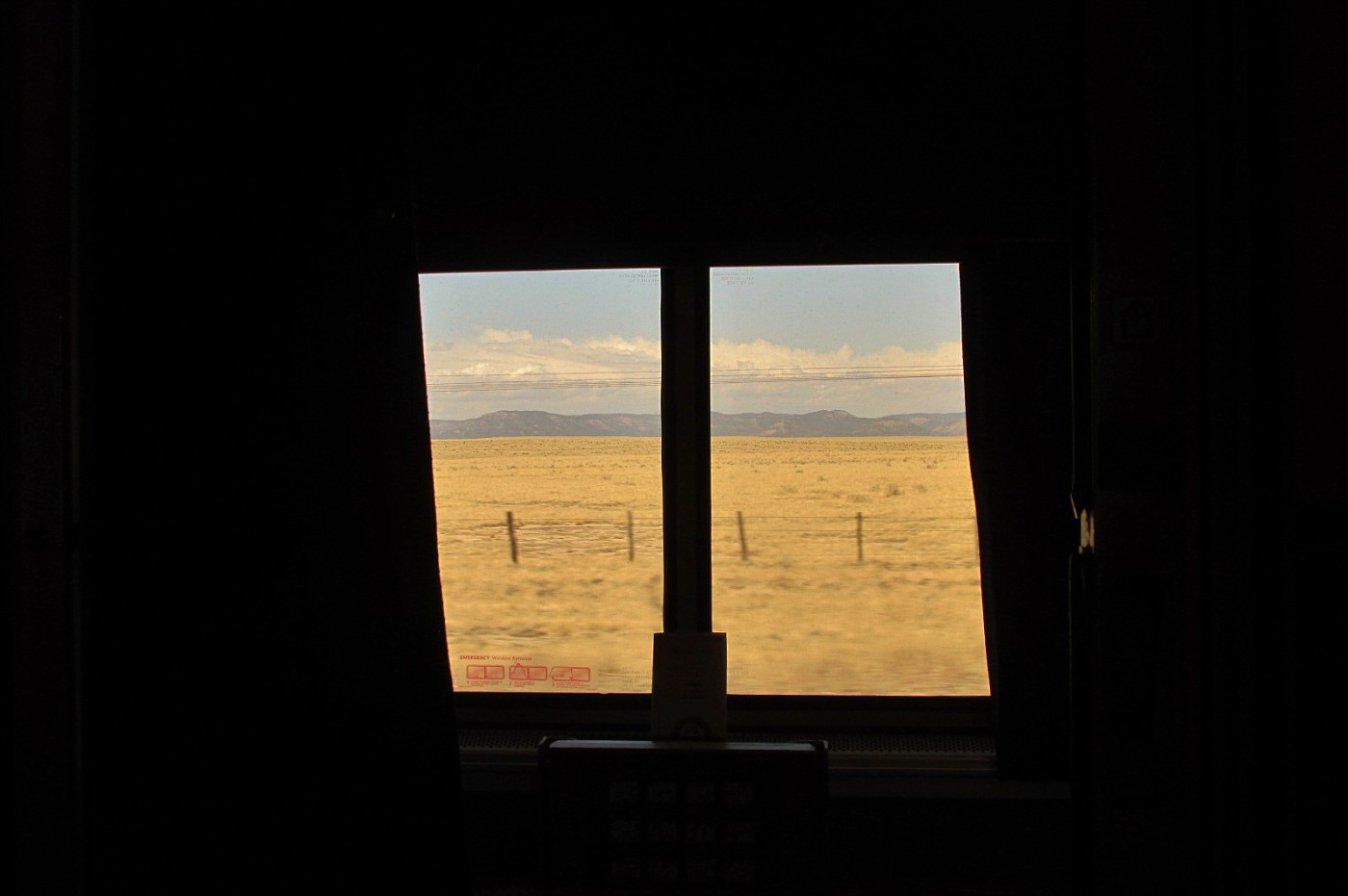
The view from my roomette
At dinner I was joined by two sisters from Missouri who were headed to Riverside, California to visit their other sister. It would be the first time all three of them had been together in over fifteen years. They were excited and chatty as we worked our way through salads, steaks and dessert. I’ve usually been pretty full after the main course but tonight I decided to splurge and go with the strawberry cheesecake.
It’s surprising how fast the time has sped by on this trip. At this point I’ve been onboard the Southwest Chief for twenty-nine hours and not once have I experienced a sense of boredom or a desire to get to Los Angeles quicker. Granted, I actually enjoy the act of going somewhere more than most but even then – between the scenery and the camaraderie of the shared travel experience as experienced in both the dining car and the lounge car – time has just flown by! That’s a huge part of it, really – the ability to get up out of your seat and do something other than head for the lav. On some trains you can even get in some decent exercise climbing up and down the stairway or walking almost a fifth of a mile from one end of the train to the other. Frankly I wouldn’t mind another full day onboard before we get to LA. The longest single train ride I’ve ever taken was aboard Amtrak’s Sunset Limited from Miami to Los Angeles back in 1994. That trip began on a Monday at noon in Miami and didn’t end until we’d arrived in Los Angeles three days later on Thursday at 8:00am. That said, I’m connecting to a thirty-five hour ride to Seattle aboard the Coast Starlight tomorrow, so there’s still plenty of train travel ahead for me. Honestly though, what I’d really like to do someday is ride the trans-Siberian from Beijing across Asia to Moscow. Seven straight days of bliss on rails! Ideally, I’d like to ride the train all the way through in one direction and then get off and visit a few destinations on the return trip. Stay tuned for that report someday…

Sunset on the Southwest Chief
I called it a night shortly after we’d pulled out of Flagstaff. The old brick and Tudor styled station brought back fond memories from the days when I used to ride down here to visit friends at Northern Arizona University. I also managed a hostel up in Page, Arizona a few years ago. I’ve spent a lot of time in Northern Arizona and if Amtrak were ever to allow stopovers on its itineraries, I’d gladly take advantage of one here in the “Ponderosa Pine Capitol of the world”.
Earlier in the evening it was announced that due to our 8:15am arrival in Los Angeles, breakfast would be an abbreviated affair. The onboard kitchen crew is responsible for cleaning up and closing down the kitchen and dining car prior to arrival. As such, a full hot breakfast would only be offered between 5:30 and 6:30am. Lighter fare as well as microwaved breakfast sandwiches could be had in the lounge car café until 7:30am. To me at least, sleeping in was more important than a complimentary meal. I could always buy something during my layover in LA’s Union Station.
And so it was that I slept in until a little after 7:00am. Parting the window curtains revealed sunshine and suburbia as we rolled through one of the many suburbs that make up East Los Angeles. The only station stop out here is Fullerton and assuming we’re running on time, that stop should’ve come about 45 minutes ago. I threw on some pants and padded upstairs to the service area for coffee and orange juice. Maria was just down the hall making up roomettes so I asked her about our progress.
“On time!” she replied. “In fact, we’ll probably get in a couple minutes early”
Right on. The longer the layover in LA the better since I know of a place that’s got great breakfast burritos just a couple blocks up from the station.
And so it was we did indeed ease to a stop on platform 10 at 8:09am by my watch – six minutes early. For most people – especially those of us in the sleepers – a pleasurable two day ride across the country had just come to an end and a beautiful southern California day awaited. I on the other hand was just as excited for the comfortable accommodations and beautiful scenery that awaited me aboard Amtrak’s Coast Starlight. The 10:10am departure allowed plenty of time to store my bag at the Metropolitan Lounge and then head outside the station for breakfast at one of the many Mexican restaurants on Olvera Street.
Enroute aboard the Southwest Chief
I awoke early to a bright sunny day as we rolled westward through southwestern Kansas. The low hills and dales of the Arkansas River valley were very pretty, much more appealing than the Interstate 70 corridor up north which appears to be little more than an endless field of … well, whatever it’s made up of. I do remember a few sunflowers here and there. And some corn. Mainly though it was just a lot of low beige flatlands. Down here however there were low buttes and green trees and generally it was all much more to my liking.
Yawn. Strrrettttch. It sure feels good to be out in the wide open spaces again!
According to the schedule and assuming we were on time, we ought to have been somewhere between Dodge City and Garden City, Kansas. As it turned out however, we were running about 40 minutes late and had only recently pulled out of Dodge City. Had we been running just a bit later I would like to have been awake for the Dodge City stop because I’d read that toward the far end of the station platform there are two large sundials. One is set to show the time in the Central Time Zone and the other is set to show the time in the Mountain Time Zone. For those who may not know, time zones were originally established by the railroads back in 1883 and the original time zone line in this area ran between these two sundials. These days the change doesn't come until we’re west of Garden City.
Superliner bedrooms have their own toilet and shower ensuite but the roomettes all share a single shower downstairs, just off the vestibule. Nobody was in the shower at present however, so I wasted no time in picking up a towel and relocating. Since my luggage was stowed just adjacent to the shower area, I grabbed a change of clothes and some shampoo as well.
Amtrak Superliner showers are spacious and supply a good stream of hot water. They’re quite a treat compared to my shower at home. Because I’m not on city water, I have to haul water in once or twice a week. For a shower I just heat up a couple gallons of water on my stove and then transfer it to a 4 gallon wastebasket. From there I’ve rigged up an old electric pump from a motorhome that pulls the water up out of the wastebasket and pumps it into my shower stall. Voila!
That said, I do appreciate the luxury of being able to just walk into a shower and have hot water available on demand. What a treat! And on a train, no less!
Fifteen minutes later I presented myself in the dining car where I was directed to a table already occupied by a couple in their fifties. My salutation of “Good Morning” was returned with a mumbled “Marnin” from the man and nothing from his wife. They reminded me of that couple in the movie “Fargo” that was disappointed upon arriving to pick up their new car and then discovering that they were expected to pay for a layer of “True Coat” which they hadn’t ordered. It quickly became apparent that neither of these folks were comfortable with conversation, so we ordered our breakfasts and spent the next twenty minutes watching the country roll by. It happens sometimes…
After breakfast I relocated to the lounge car where I nursed a cup of coffee and watched as we rolled from Kansas into Colorado.
“Where are the Rocky Mountains?” I heard a lady ask who was seated a few seats down from me.
About 150 miles to the west of us, I silently answered. This train doesn’t present classic views of the Rockies like the California Zephyr, whose journey from Chicago to Emeryville, California (Oakland) takes it right through the heart of the Rockies as it climbs west out of Denver through 29 tunnels, under the continental divide via the 9000’ high Moffatt Tunnel and then follows the Colorado River for another two hundred some odd miles out of the Rockies and into Utah.
Our route takes us through the plains and buttes of southeastern Colorado before turning south at Trinidad and heading down into New Mexico. During the summer months, volunteer rangers with the Trails & Rails program from the National Park Service travel onboard and provide a narrative between La Junta, Colorado, and Albuquerque, New Mexico. None were onboard today though, so perhaps that service won’t begin until June.
At Trinidad we’re just a bit to the east of the Sangre de Christo Mountains where a couple of the peaks top out at over 14000 feet. Those peaks are best viewed from the western side however. Also located on the western side of the range is the Great Sand Dunes National Park. Continuing south we slowed a bit as we began the long and scenic climb up over Raton Pass and Glorieta Pass. Technically speaking, we could be said to be traveling through the southern end of the Rocky Mountains, even though the main thrust of them is a bit farther to the west – over by Taos. The landscape here, while not as dramatic as the Zephyr’s route through the Rockies, is nonetheless quite pretty with lots of reddish and ochre tinted rock providing plenty of color, especially in the numerous shallow canyons we traversed.
The man seated next to me had a guide book and as we passed through Glorieta Canyon he mentioned that this was the westernmost battlefield of the Civil War. A little farther down the tracks in Apache Canyon we eased through a very narrow passage where the rock walls came within only a foot or two of the train. Eventually we passed over the Pecos River and around a large S curve before easing into Raton, New Mexico where the elevation is 7,588 feet.
Raton looks very much like a town right off the set of a western movie. The dry and dusty streets looked perfect for a gunfight at high noon. We spent about ten minutes on the platform which was also perfect for all the smokers onboard who cherish any stop longer than five minutes as smoking is not allowed on Amtrak trains.

Raton, New Mexico
I was in the dining car enjoying my favorite black bean burger with bacon when we powered out of Raton and continued our journey south. The next smoke stop wouldn’t be until we reached Albuquerque - another three hours down the tracks. I’m sure glad I quit back in the days when you could still smoke onboard these trains!

Lunchtime on the Southwest Chief

Table setting on the Southwest Chief

Cheesecake on the Chief
An announcement was made over the PA that we’d soon be arriving in Las Vegas. Our time there would be very brief so anybody not detraining in Las Vegas please remain onboard. As we eased to a stop in front of the small, adobe station I heard a man exclaim with surprise “THIS is Las Vegas?!”
New Mexico, Dude… not Nevada.

Racing traffic to Albuquerque
Albuquerque is both a service stop and a crew change point for the Southwest Limited. By crew I mean the conductor and engineers – not the train staff. Either way, it meant that we’d be here for a good half hour before continuing westward. Because of the extended time traditionally spent in the station, the platform hosts a number of local vendors selling everything from Navajo jewelry to Kachina dolls to Mexican blankets. Judging by the small crowds gathered around a couple of them, business was brisk. I wish they had a place selling good New Mexican tamales down here. What a treat!

Buyers and Sellers on the platform at Albuquerque
As we re-boarded the train, I glanced at my watch and noted that at this point we were running about 45 minutes late. I had an hour and forty-five minute layover in Los Angeles and wasn’t too concerned - yet. If however we were to incur more substantial delays, those of us connecting to points north of San Francisco on the Coast Starlight would be bussed from Barstow up to Sacramento. To me at least this would be disastrous because it would mean I’d miss the beautiful coastal scenery seen north of Santa Barbara as well as the pretty mountain scenery in and around San Luis Obispo. Frank – our ever jovial lounge car attendant – said not to worry. We’d make up a good chunk of that time as we sped across the desert between Gallup, New Mexico and Needles, California. Heck – we might even get into LA early! Hmm… we’ll see…
Once we’d cleared the Albuquerque suburbs, our pace increased substantially. The speed limit out here is 90mph and the engineers seemed determined to utilize every last bit of it. The Santa Fe was one of the first railroads (if not the first) to lay electrically welded rail and so our tracks not only allowed for faster speed but they also provided a wonderfully smooth ride. Out my window was a panorama of colorful buttes and painted desert. Yellow, red, brown, ochre and beige were the colors of the day. I was enjoying it all from the comfort of my roomette where I had my seat reclined and my legs up on the seat across from me. It was a pretty afternoon and life could not have been finer… It sure is good to be back home in the west!

Speeding across the Chihuahua Desert

Grants, New Mexico in 20 minutes…

The view from my roomette
At dinner I was joined by two sisters from Missouri who were headed to Riverside, California to visit their other sister. It would be the first time all three of them had been together in over fifteen years. They were excited and chatty as we worked our way through salads, steaks and dessert. I’ve usually been pretty full after the main course but tonight I decided to splurge and go with the strawberry cheesecake.
It’s surprising how fast the time has sped by on this trip. At this point I’ve been onboard the Southwest Chief for twenty-nine hours and not once have I experienced a sense of boredom or a desire to get to Los Angeles quicker. Granted, I actually enjoy the act of going somewhere more than most but even then – between the scenery and the camaraderie of the shared travel experience as experienced in both the dining car and the lounge car – time has just flown by! That’s a huge part of it, really – the ability to get up out of your seat and do something other than head for the lav. On some trains you can even get in some decent exercise climbing up and down the stairway or walking almost a fifth of a mile from one end of the train to the other. Frankly I wouldn’t mind another full day onboard before we get to LA. The longest single train ride I’ve ever taken was aboard Amtrak’s Sunset Limited from Miami to Los Angeles back in 1994. That trip began on a Monday at noon in Miami and didn’t end until we’d arrived in Los Angeles three days later on Thursday at 8:00am. That said, I’m connecting to a thirty-five hour ride to Seattle aboard the Coast Starlight tomorrow, so there’s still plenty of train travel ahead for me. Honestly though, what I’d really like to do someday is ride the trans-Siberian from Beijing across Asia to Moscow. Seven straight days of bliss on rails! Ideally, I’d like to ride the train all the way through in one direction and then get off and visit a few destinations on the return trip. Stay tuned for that report someday…

Sunset on the Southwest Chief
I called it a night shortly after we’d pulled out of Flagstaff. The old brick and Tudor styled station brought back fond memories from the days when I used to ride down here to visit friends at Northern Arizona University. I also managed a hostel up in Page, Arizona a few years ago. I’ve spent a lot of time in Northern Arizona and if Amtrak were ever to allow stopovers on its itineraries, I’d gladly take advantage of one here in the “Ponderosa Pine Capitol of the world”.
Earlier in the evening it was announced that due to our 8:15am arrival in Los Angeles, breakfast would be an abbreviated affair. The onboard kitchen crew is responsible for cleaning up and closing down the kitchen and dining car prior to arrival. As such, a full hot breakfast would only be offered between 5:30 and 6:30am. Lighter fare as well as microwaved breakfast sandwiches could be had in the lounge car café until 7:30am. To me at least, sleeping in was more important than a complimentary meal. I could always buy something during my layover in LA’s Union Station.
And so it was that I slept in until a little after 7:00am. Parting the window curtains revealed sunshine and suburbia as we rolled through one of the many suburbs that make up East Los Angeles. The only station stop out here is Fullerton and assuming we’re running on time, that stop should’ve come about 45 minutes ago. I threw on some pants and padded upstairs to the service area for coffee and orange juice. Maria was just down the hall making up roomettes so I asked her about our progress.
“On time!” she replied. “In fact, we’ll probably get in a couple minutes early”
Right on. The longer the layover in LA the better since I know of a place that’s got great breakfast burritos just a couple blocks up from the station.
And so it was we did indeed ease to a stop on platform 10 at 8:09am by my watch – six minutes early. For most people – especially those of us in the sleepers – a pleasurable two day ride across the country had just come to an end and a beautiful southern California day awaited. I on the other hand was just as excited for the comfortable accommodations and beautiful scenery that awaited me aboard Amtrak’s Coast Starlight. The 10:10am departure allowed plenty of time to store my bag at the Metropolitan Lounge and then head outside the station for breakfast at one of the many Mexican restaurants on Olvera Street.
Last edited by Seat 2A; Jan 1, 2015 at 5:39 pm
#7
FlyerTalk Evangelist
Original Poster
Join Date: Apr 2001
Location: East Ester, Alaska
Programs: Alaska Million Miler, United Million Miler, Wyndham Rewards Diamond, Choice Hotels Diamond
Posts: 12,148
Day Eight
Amtrak Los Angeles to Seattle 1010a – 830p Coast Starlight First Class Car 1431 Room 11
Before Amtrak, no single passenger train had ever operated over the entire length of the West Coast. The closest equivalent was the Southern Pacific’s West Coast, which ran from Los Angeles via the San Joaquin Valley (Bakersfield, Fresno, Modesto) up to Portland. Through cars to Seattle were hooked up in Portland to a separate train that was operated by the Great Northern Railway.
Those desiring the more scenic coastal route could travel via the Southern Pacific’s Daylight between Los Angeles and San Francisco. Upon arrival they’d make then their way across the bay to Oakland and board the overnight Cascade up to Portland. Aside from the route’s scenic attributes, the SP’s Daylight is considered by many to have been the most beautiful passenger train ever built.
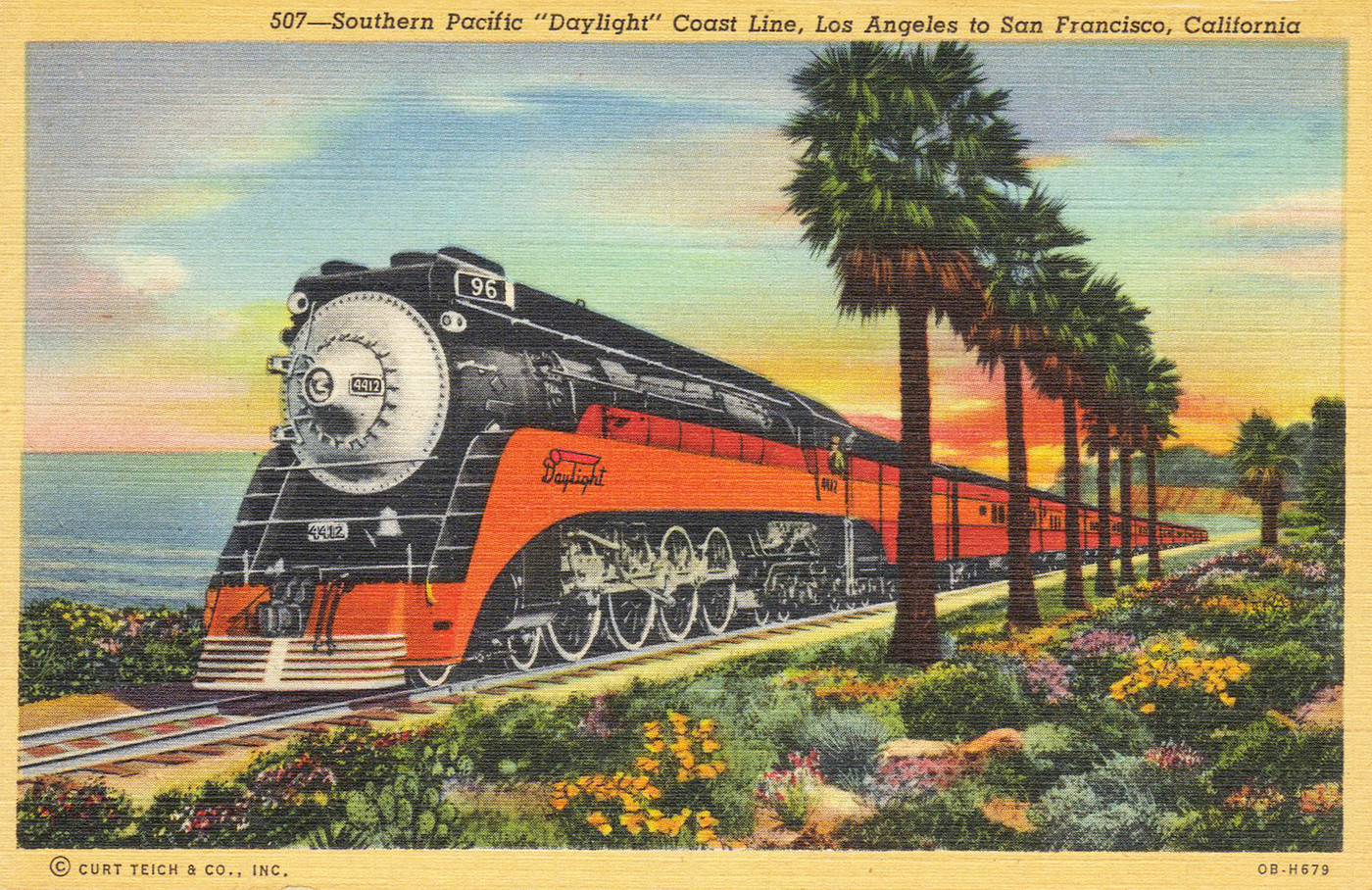
Southern Pacific’s Daylight
When Amtrak took over the nation’s passenger railroad operations in 1971, the decision was made to operate a single train from San Diego all the way up to Seattle. Eventually this was changed to originate in Los Angeles and the train came to be known as the Coast Starlight. It’s a nice sounding name but rather an odd one inasmuch as the only coastal portion of the1377 mile journey (a 113 mile stretch from Ventura to a little north of Surf Beach in the Lompoc area) is traveled during broad daylight in each direction.
This will be my 32nd ride aboard the Coast Starlight and I am no less excited today than I was prior to my first ride back in June of 1975. Walking back to the station allowed me a good opportunity to observe the building’s California Mission style architecture. This is not a large station on the scale of New York’s Grand Central or Chicago’s Union Station, but it may well be the prettiest. Columns of palm trees tower above the entrance and to walk into the elegant and airy main hall is to be transported back into the 1930s. The high ceiling, the Spanish-style arches, the large brown leather chairs… I’d almost feel more appropriate if I were wearing one of those 1940s era zoot suits with a proper fedora. Picture Nick Nolte in Mulholland Falls…
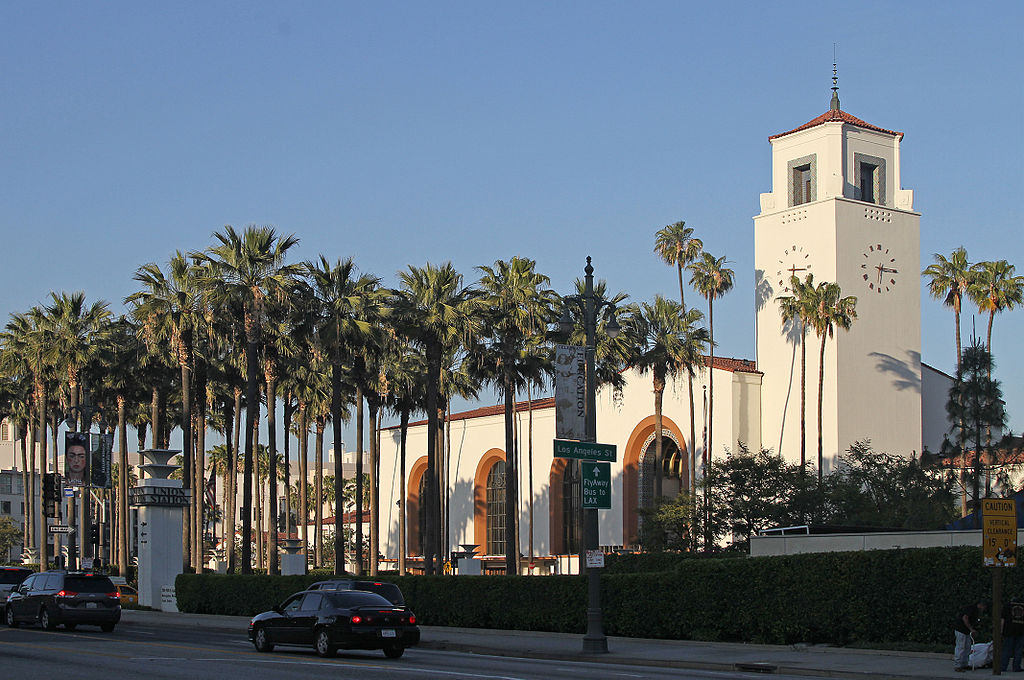
Los Angeles Union Station
Photo courtesy of John O’Neill

Los Angeles Union Station Man Hall
First Class passengers on the Starlight are entitled to use Amtrak’s recently opened Metropolitan Lounge. It’s located on the second floor above the Amtrak ticketing counter and accessed via an elevator. This lounge is quite an improvement over the smaller First Class lounge that it replaced. Everything is new and improved, especially the seats which are much more comfortable and come equipped with attached swivel tables and drink holders. The drink and snack selection is on par with most airline clubs though it should be noted that there is no bar and no alcohol is available.
I poured myself a cup of coffee and took a seat at one of the tables set around the lounge. Complimentary Wi-Fi is provided, so I logged on and addressed a few outstanding emails until the call to board was made at about 9:45am.
As is done in Chicago, First Class passengers are escorted out a side door to the train. Motorized golf cart type transports are available to deliver the physically challenged across to the train. I was amongst the last to exit the lounge and although I walk with a bit of limp I’m more than capable of making it out to the train on my own. Even so, the cart operator offered me a ride and as there were only two other people on board I said sure, why not?!
We had a pretty good sized train today – eleven cars in all. There was an old heritage fleet baggage car, a transition sleeper (for the crew), three sleeping cars, the Pacific Parlour Car, a diner, the Sightseer Lounge and three coaches. A pair of handsome Genesis P42DC locomotives led up the front of the consist, providing up to 8,500 horsepower for the 1377 mile journey up the coast and through the mountains to Seattle.
The Coast Starlight is one of the most popular long distance trains in the Amtrak system. First Class accommodations – though substantially more expensive than a coach seat – can be difficult to find on short notice, especially during the spring, summer and fall months. Thankfully I’d booked my reservation about three months ago and was now the proud inhabitant of roomette11 in car 1431.
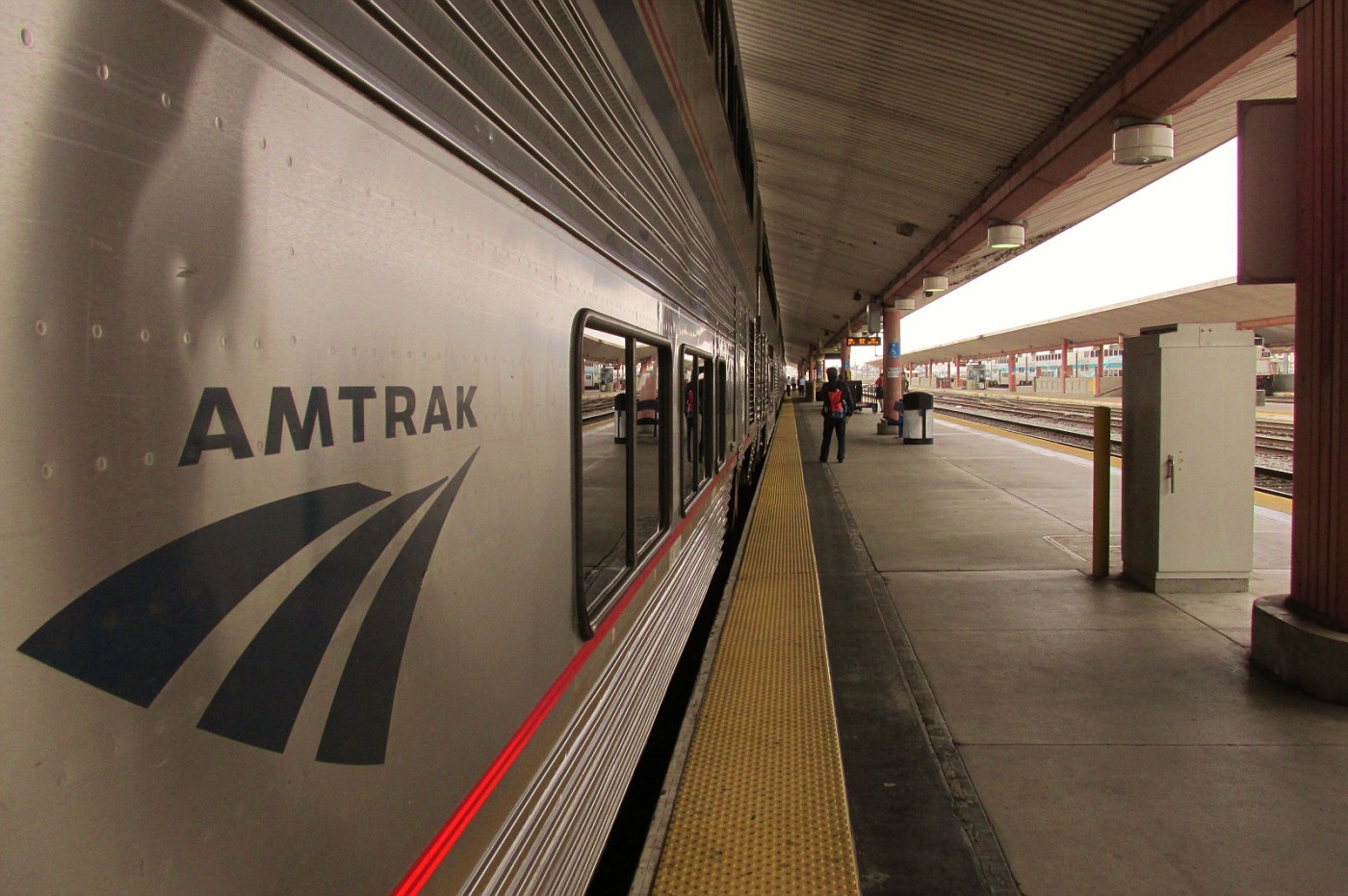
Train time at Los Angeles
Now here’s a surprise. My car attendant was Jay – who I’d first and last met back in 2005 on a three day ferry ride down the coast of Chile from Puerto Montt to Puerto Natales. What a small world! There’d be plenty of time to catch up later in the trip, so I left Jay to his duties while I took a walk down the platform toward the rear of the train. Of particular interest to me was the Pacific Parlour Car – a special lounge car available only to First Class passengers.
Lounge cars are available on all of Amtrak’s long distance trains but only the Coast Starlight has the Pacific Parlour Car in addition to a Sightseer Lounge Car for general use. By the way – I’m not British. For some odd reason Amtrak chose to use the British spelling for parlor – probably because some higher up thought it sounded classier. We Americans have such an inferiority complex for this kind of stuff…
However you choose to spell it – these Pacific Parlour Cars are wonderful additions to the Coast Starlight, and for many people they are reason enough to pay the extra money for First Class accommodations. Each Parlour Car is outfitted with eight large swivel chairs, a small lounge area with sofas and cocktail tables and six four seat tables with buffet style seating. At one end of the lounge is a stand-up bar offering a full range of beer, wine and spirits in addition to coffee, tea and soft drinks. At the other end is a small library with a collection of used books and board games. Downstairs is a 21 seat movie theater. Full meals featuring a menu unique to the Pacific Parlour Car are also available upstairs in the lounge. Honestly, aside from sleeping and showers, it’d be very easy to spend the entire journey in this car. Oh yeah – did I mention that it also features complimentary Wi-Fi?
Between the Pacific Parlour Car and the wonderful scenery enroute, the Coast Starlight really epitomizes the fact that train trips are about the journey, not the destination.

Amtrak’s Pacific Parlour Car
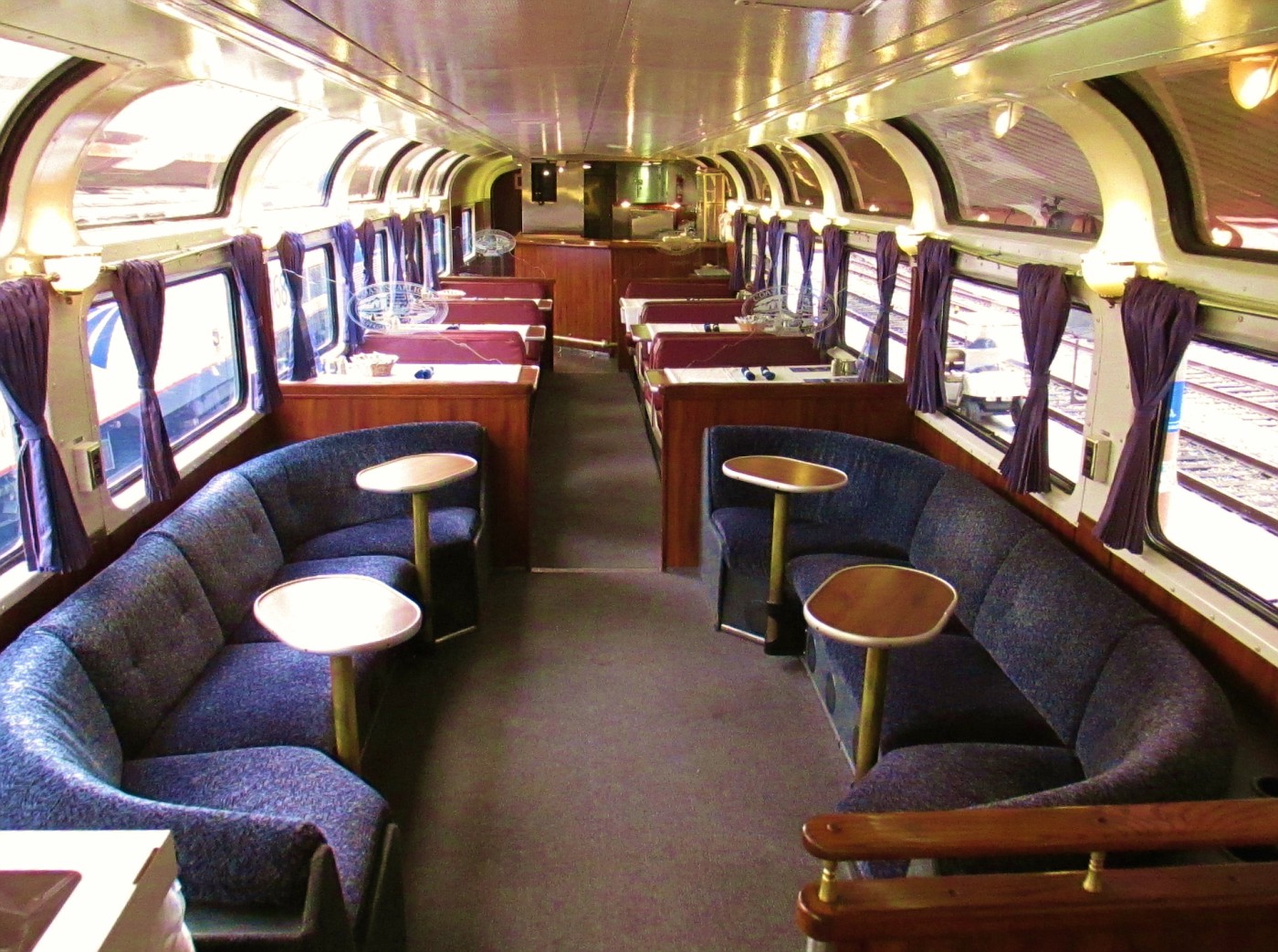
Amtrak’s Pacific Parlour Car Cocktail Lounge Seating

Amtrak’s Pacific Parlour Car Swivel Chairs
Making my way back to car 1431, I stepped aboard and settled in for the thirty-four hour journey ahead. Jay stopped by to see that everything was okay and we promised to get together later this afternoon. Only one other person was seated downstairs but Jay assured me that this car would be full by the time we pulled out of San Luis Obispo.
There’s not much to see during the first hour of this trip. We rolled through a lot of industrial areas and run down suburbs – visages that will never make their way into any promotional brochures. At least it was a sunny day. Hoisting my daypack, I ascended the stairway and made my way back to the Pacific Parlour Car. All of the big easy chairs were already taken but I did find an empty table where soon I was sipping from a cup of surprisingly good coffee while firing up my laptop to put in a bit of work on this trip report.
Now I realize that photo reports are all the rage these days but let me just say that anybody who’s ever written a long trip report knows that you need to keep up lest you get so far behind that the thought of just forgetting about it all can become increasingly attractive, very quickly transitioning from concept to reality. Now for guys like me who will never publish a trip report until it’s complete, you’d never know but look how often people have started trip reports only to leave us hanging in some place like Tripoli or Tuktoyaktuk.
I’ve got an excellent memory but even so, I find it really helpful to take notes along the way – things like something I saw that stood out for whatever reason, people I met along the way, what I had for dinner and why it was worthy of mention as well as any of those annoyingly deep thoughts about the whole experience that occasionally invade my consciousness. This way even if a fair amount of time should pass before I get around to actually writing the report, I’ve at least got some good notes to work with. The memories get stimulated and in the long run it usually all ends up translating well to report form. Unless that is you’re into the quick and easy gratification derived from speeding through a photo report, in which case my writing becomes little more than annoying blather – especially the longer words – only to be endured between the occasional photographs. Thank goodness for the scroll function!

Hard at work on yet another trip report
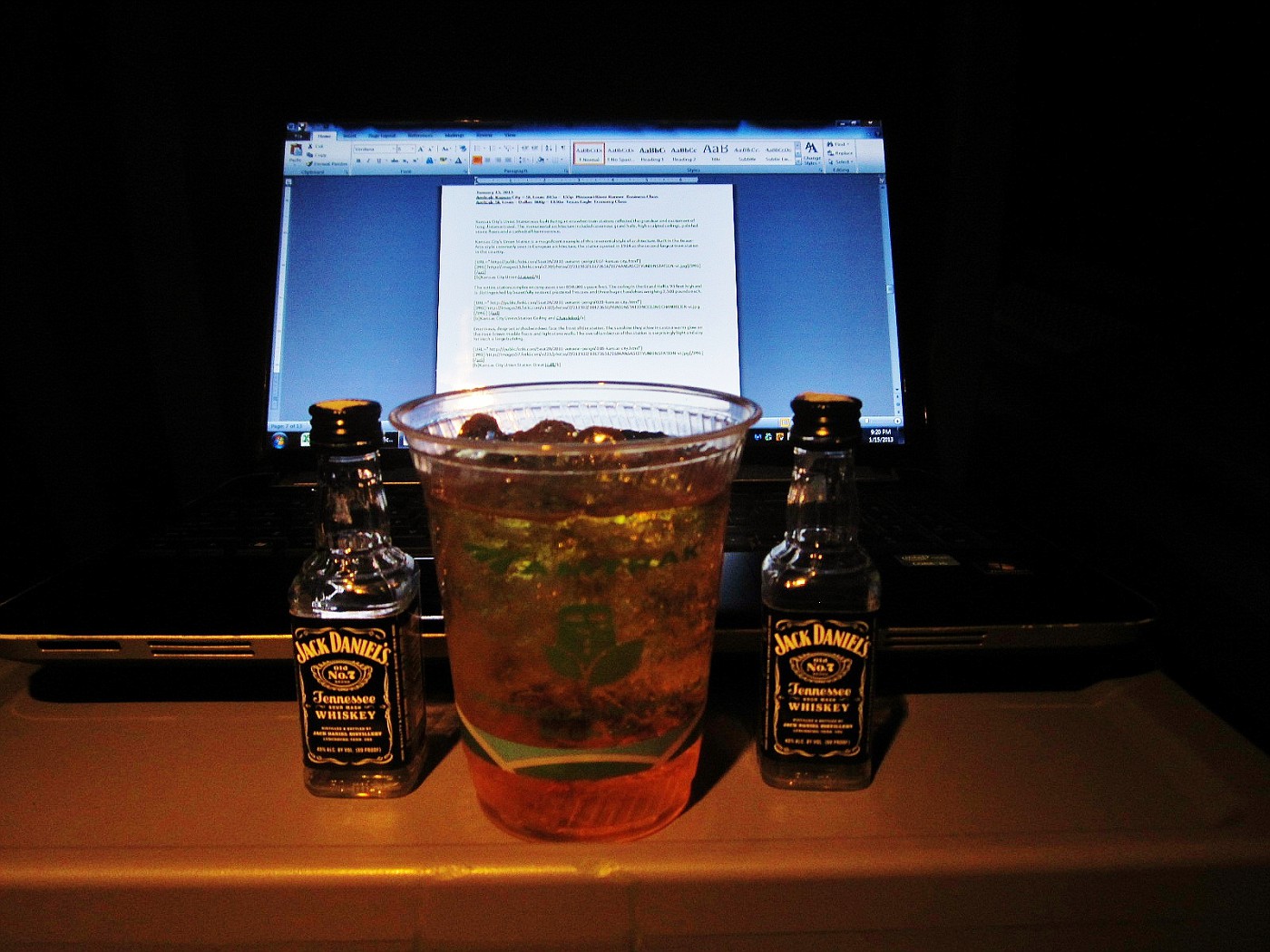
Trip Report Fuel
Burbank, Van Nuys, Simi Valley and Oxnard all rolled by without much notice. Then came Ventura and our first views of the ocean. The level of excitement in the lounge car perked up perceptibly. Cameras emerged and lots of photos were taken. Save some space on those film cards, folks! The best of the scenery is yet to come!
The first call for lunch rang out at 12:00. Because meals are also served in the Pacific Parlour Car, it became necessary for me to vacate my table. Thankfully the timing could not have been better as a couple who were sat in the swivel chairs got up to eat. I and another gentleman quickly occupied their empty seats.
The guy who sat down next to me was named Eric and he turned out to be a near encyclopedic source of really interesting information about the train and the surrounding countryside. All of us sat around him enjoyed the information he shared.
Speaking about the Pacific Parlour Cars, Eric told us that there were five of them. They were all originally built back in the 1950s for the Santa Fe's El Capitan, an all-Coach streamliner that offered an inexpensive alternative to the all-Pullman Super Chief. I mentioned that I remembered riding on these cars back in the 70s and 80s when they served as the lounges on the Southwest Limited and the Sunset Limited. Their interiors back then hadn’t changed a whit since their days on the El Cap, complete with the original Southwest tones of turquoise, beige and rust. Downstairs in what is now a movie theater was the Kachina Coffee Shop. By the late 1980s these cars were showing their age and though they weren’t as nice as the newer Sightseer Lounge cars, I always enjoyed the historical aspect of riding them. In any event, as more Superliner equipment came online these old lounge cars were eventually retired to spend the next few years sitting neglected in the LA yards. I remember seeing them out there with broken windows after kids had used them for target practice. It was a sad sight for those of us familiar with their heritage.
In the mid-1990s Amtrak decided to spruce up the Coast Starlight, at that time the most profitable train in the Amtrak system. (Who knows – it may still be!) As part of the improvements, they decided to bring some of the old Santa Fe Hi-Level lounges out of retirement and refurbish them as the dedicated First Class lounges we now call Pacific Parlour Cars. Eric explained that the cost of renovating these cars came to about 2 million each.
I remember riding in these Pacific Parlour Cars back in the late 1990s and early 2000s when you could redeem Alaska Airlines miles for a roundtrip roomette anywhere between Seattle and Los Angeles. I cashed in six of those awards but only about half the trains ever had the Parlour cars on them. I suspect the problem was that while the interiors had been refurbished, the cars themselves were almost 50 years old and they needed a lot of maintenance. In 2008 they went back to Amtrak’s Beech Grove shops where more work was done and I’m happy to report that based upon my seven rides since 2010, they’re now a lot more reliable. They truly are some of the nicest cars to be found anywhere on North American rails and I sincerely hope Amtrak can get another ten good years out of them.
As we approached the Santa Barbara Station, Eric pointed out the Mission Revival architecture so commonly seen in many of the stations along the way. I’ve gotten off here so many times that it feels strange to stay onboard. Santa Barbara enjoys one of the finest climates in the world and today was certainly a fine example. The attractive shops and restaurants of State Street are only a short walk from the station and darn it! Next time I ride a train into SBA, I want to get off for a while!
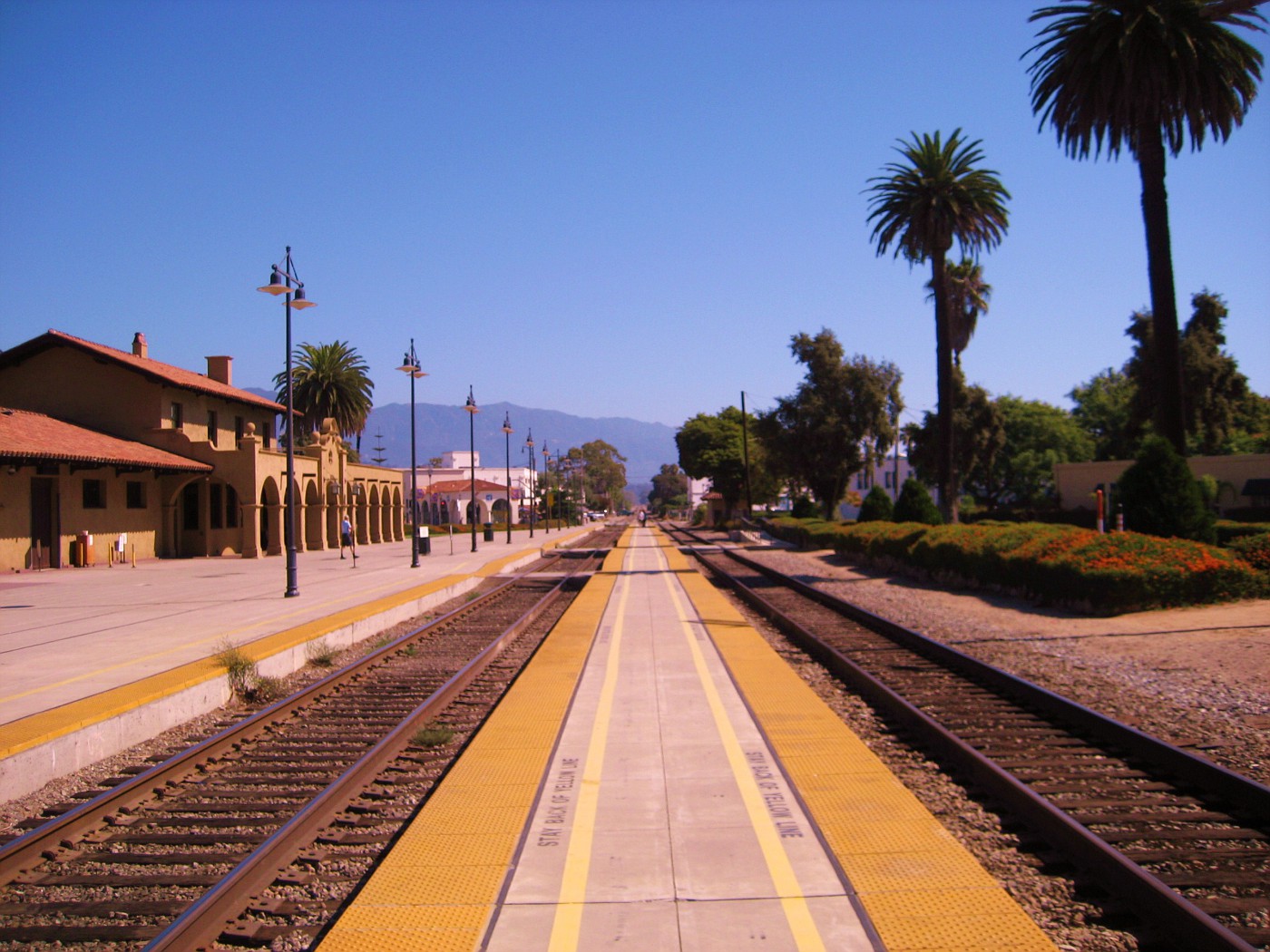
So long, Santa Barbara!
Shortly after leaving Santa Barbara we returned to the coast. Unlike the tracks south of SBA, there is no highway up here since US 101 heads inland. I suspect the location of Vandenburg Air Force Base a few miles to the north may have something to do with this. There is a small road that serves a couple of these beaches immediately north of Santa Barbara but beyond that, the only way to see the beautiful coastal scenery is to ride the train. Or join the Air Force and get a job at Vandenburg. Let’s check out some pictures!

Coast Starlight running along the Southern California coast
Photo courtesy of Amtrak
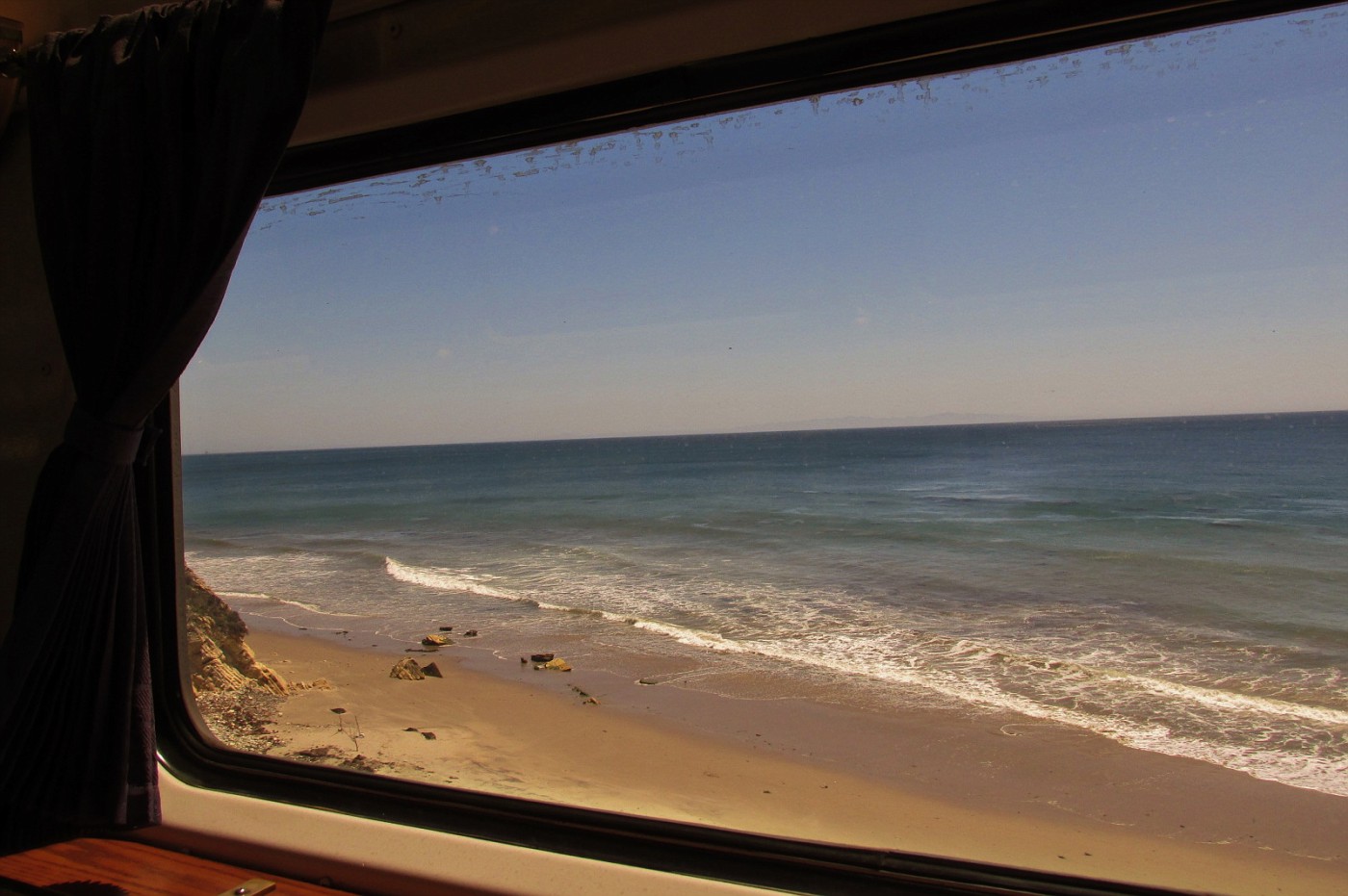
Coast Starlight running along the Southern California coast
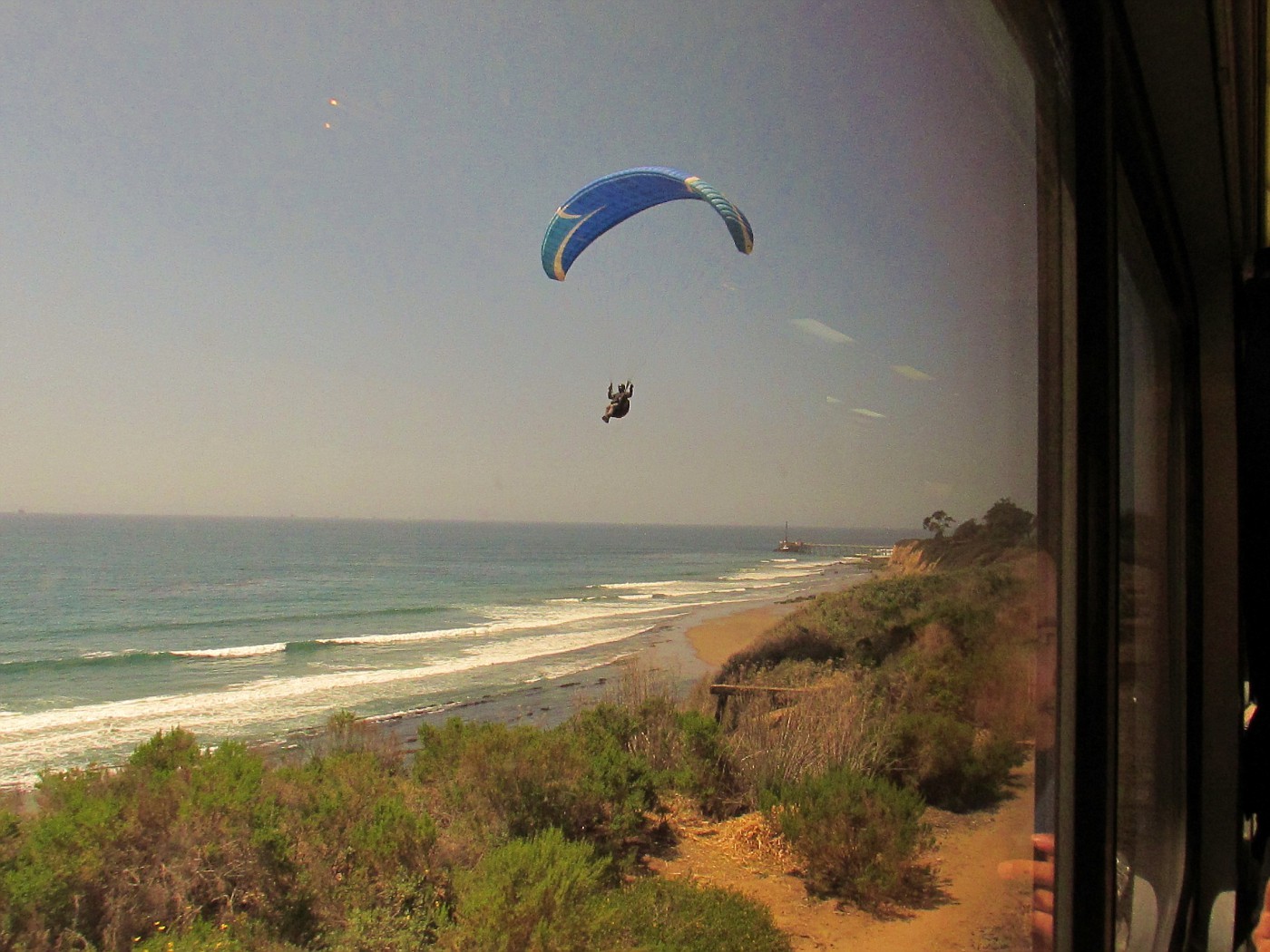
Coast Starlight running along the Southern California coast
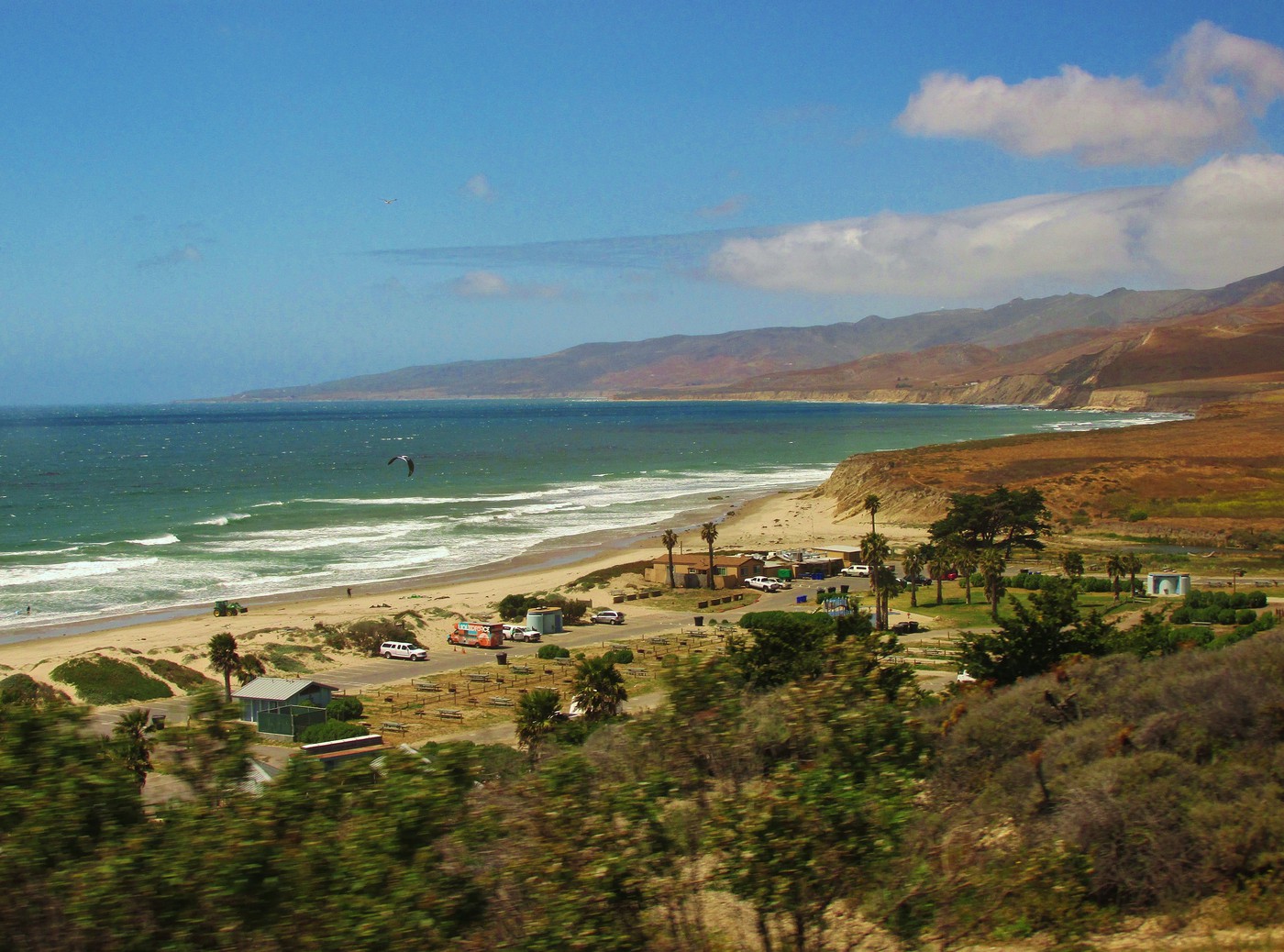
Coast Starlight running along the Southern California coast
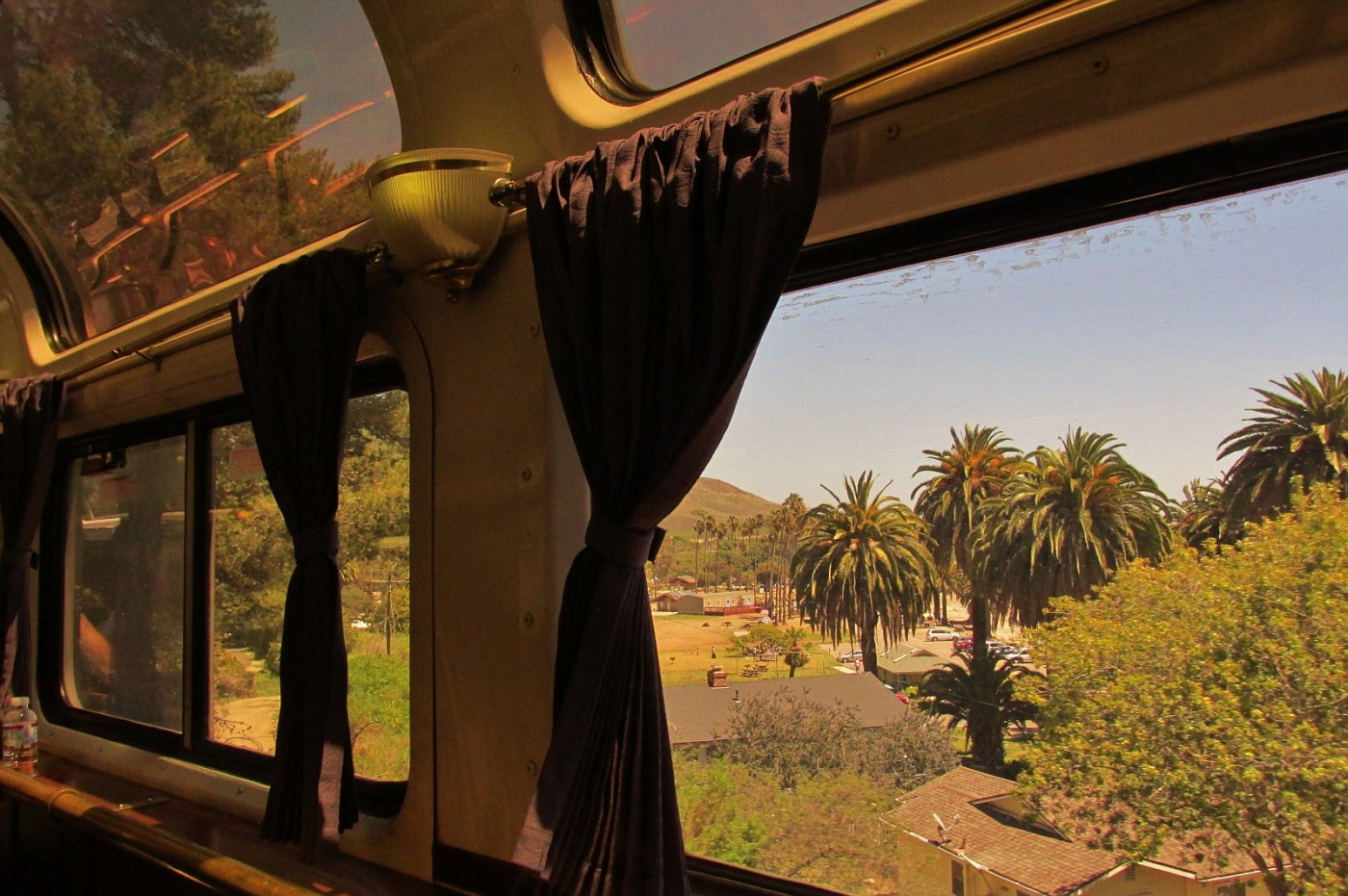
Coast Starlight running along the Southern California coast
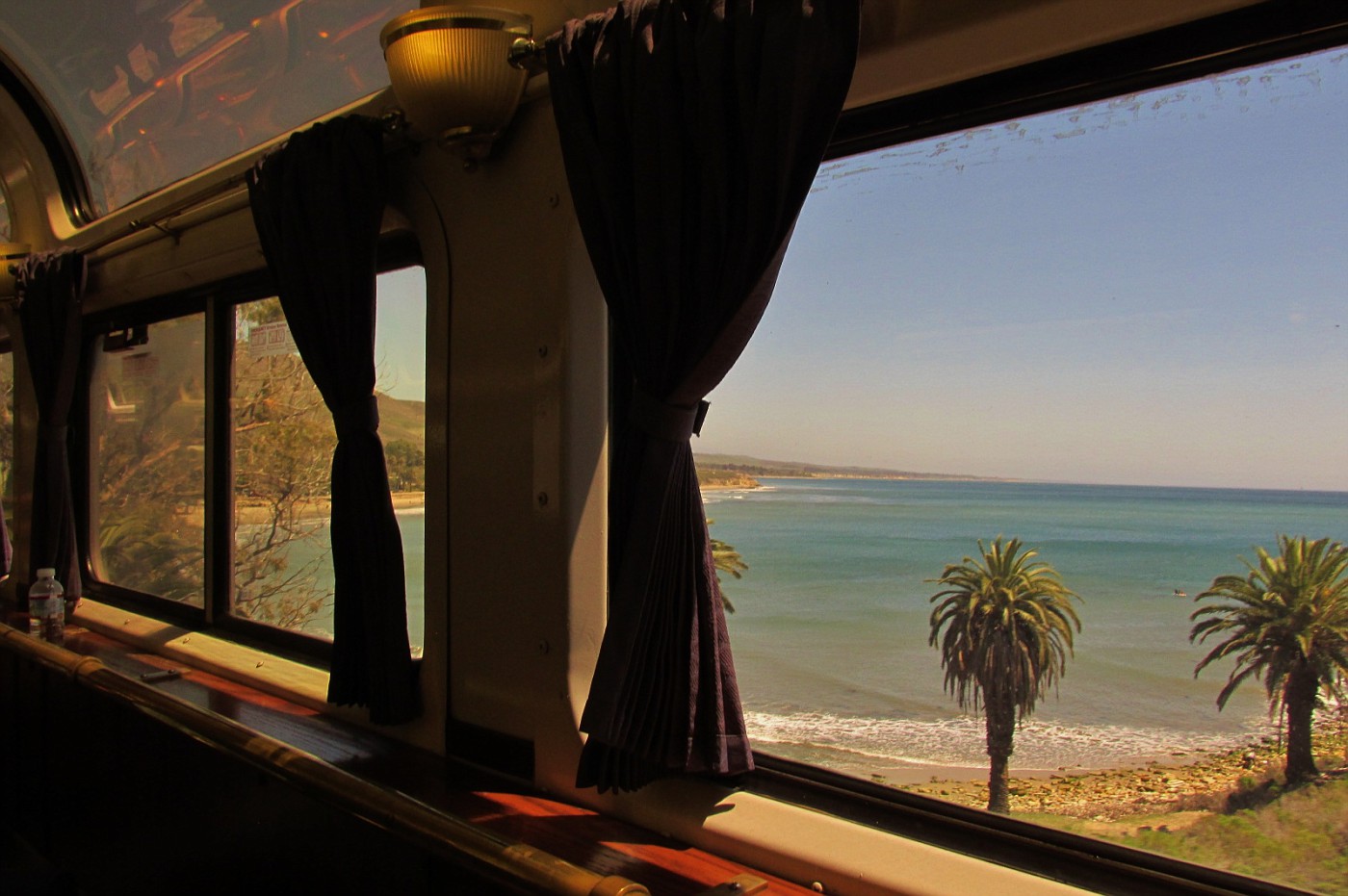
Coast Starlight running along the Southern California coast
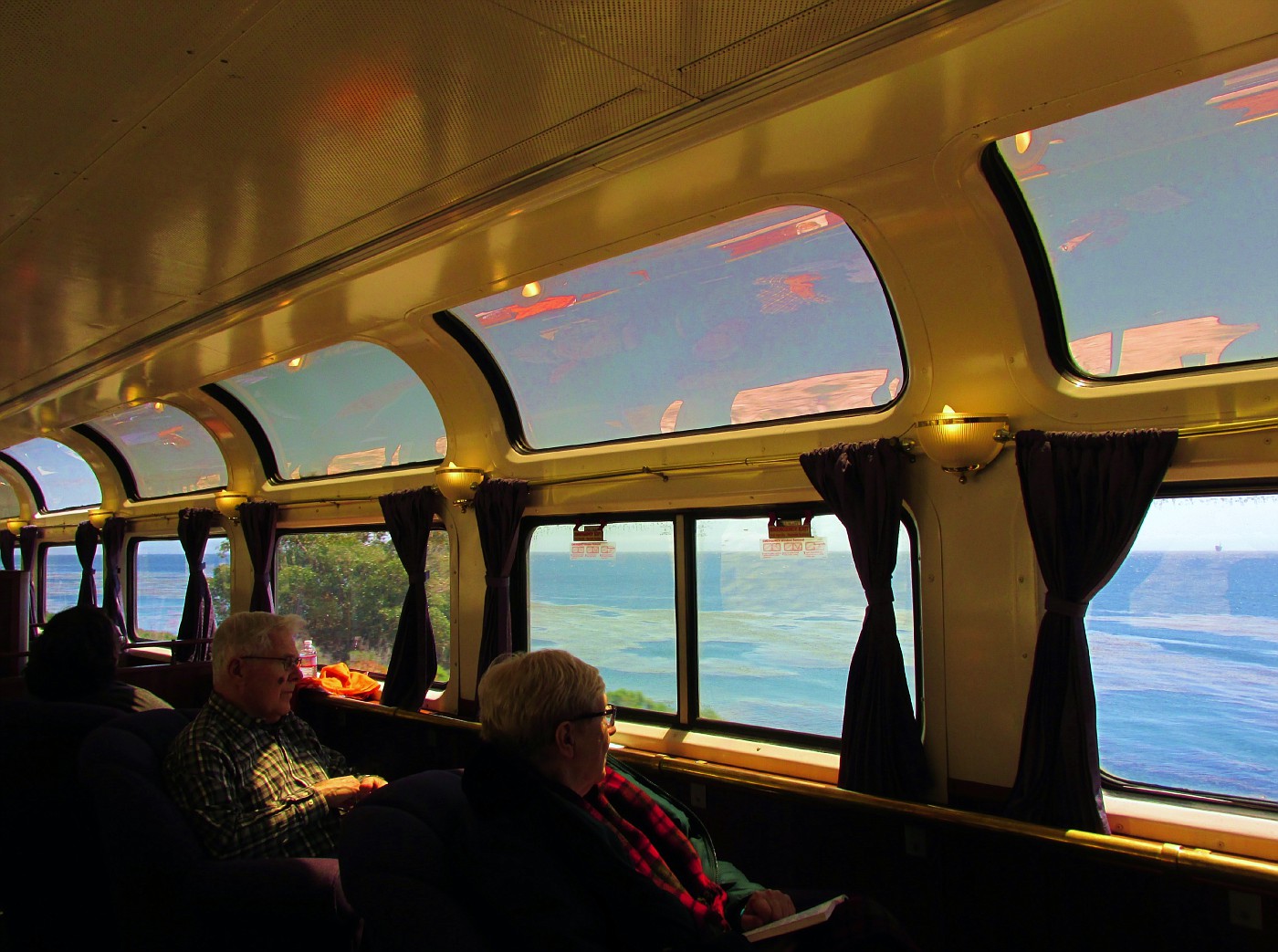
Enjoying the view from the Pacific Parlour Car
Throughout this time I was one of the fortunate few to have a comfy swivel seat in the Pacific Parlour Car. I cannot imagine a better perch from which to view such a beautiful area. At the same time, there are only eight seats so it is nice to share in the bounty with others. My 1:15pm luncheon call could not have been better timed as both Eric and I had picked that time, so we bid farewell to the couple sat across the car from us and headed back to the dining car, conveniently located just one car back. Our plush swivel chairs were quickly taken by new passengers.
Our luncheon companions were Graham and Roma, a couple from Adelaide, Australia. They’d only been in the U.S. for only a couple of weeks but already had visited Las Vegas, Zion and Grand Canyon National Parks and San Diego. They’d rented a car for that portion of the journey but were riding the Coast Starlight now on the recommendation of a friend back home who’d spoken highly of his experience on it.
Menus were distributed and drink orders were taken. Burgers for all of us except Roma who ordered the Chef’s Special – a pasta dish that also came with a salad.
Graham had been to the U.S. before but had never ridden on Amtrak. I asked if he’d ridden any trains in Australia and he replied that when he was a kid his family rode across to Melbourne once, but that was it. Both he and Roma were mightily impressed by everything from the spaciousness of their coach seats to the Sightseer Lounge Car, but they especially liked the coastal views. They were getting off in Emeryville and spending a few days in San Francisco before flying back down to LA and home to Australia. I suggested they come back someday and ride the California Zephyr across to Colorado, my favorite Amtrak ride.
We were just coming up on Point Conception as our drinks arrived. Our waiter pointed it out to us and said it’s considered the place where Southern California ends. Eric added that the coast runs east and west here - the only spot on the Pacific coast between Alaska and the tip of South America where this happens.
Roma expressed surprise at the many eucalyptus trees she’d seen in southern California since she thought they were native to Australia. They are, Eric said. They were imported from Australia by the railroad in the hopes that they’d provide good wood for railroad ties. They didn’t and these days they’re employed more as wind breaks than anything else.
Eric had a route guide – heck, Eric was a route guide! - and as we approached Vandenberg Air Force Base he pointed out that given the classified nature of activities on the base, it had once been a requirement for northbound passengers to close their window shades on the eastern side of the train as it passed through the base. Because the lounge car didn’t have any blinds, the entire car had to be closed! Those restrictions came to an end when many of the activities at the base (mostly commercial satellite launches, I believe) were declassified in the mid-nineties.
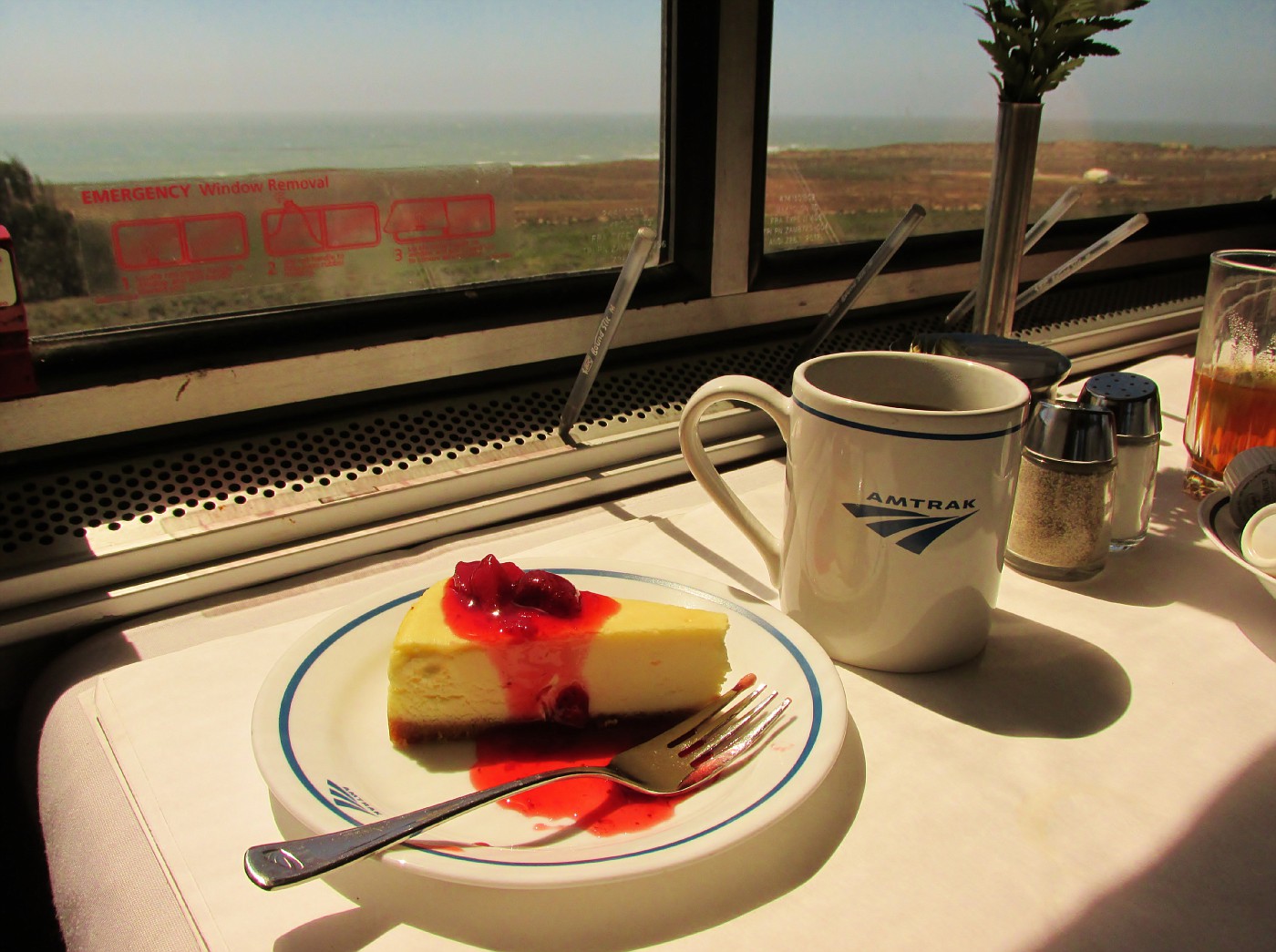
Cheesecake along the Pacific Coast
It was a gorgeous afternoon as we eased into San Luis Obispo. Sunshine, blue skies, a slight breeze, temps in the 70s – just heavenly. We’d arrived a couple of minutes ahead of schedule which allowed that much more time for smokers to attend to their addictions. Honestly, they really are something to see as the train approaches any station stop long enough for a smoke break. Assembling in the lower vestibule, they are poised near the door like runners in the blocks, ready to leap off the train and quickly apply flame to tobacco in pursuit of that first long puff of rich, flavorful smoke. And if they smoke fast enough, they might even be able to fire up a second cigarette!
On a lighter note, I love this painting by Amtrak artist Eric Smith of the Coast Starlight stopped at San Luis Obispo. The original is hanging in the LA Metropolitan Lounge but it also made it onto the cover of Amtrak’s timetable. To me at least, it captures perfectly the ambience of a nice afternoon during train time at SLO. Check it out!
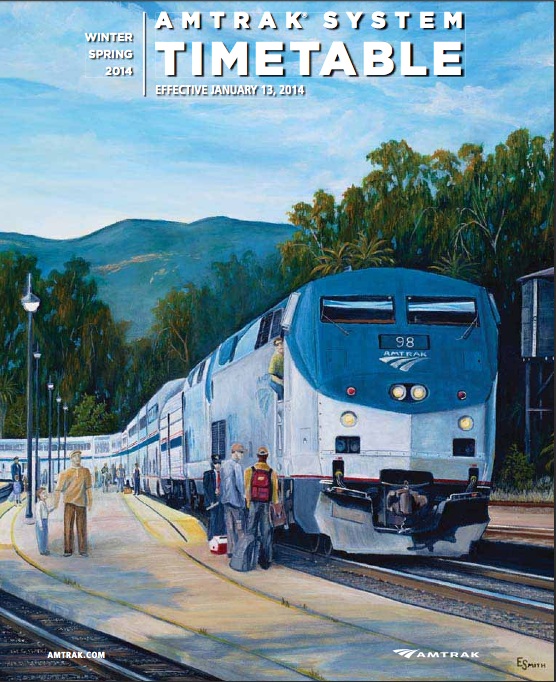
Amtrak Timetable featuring Eric Smith’s painting of San Luis Obispo station stop
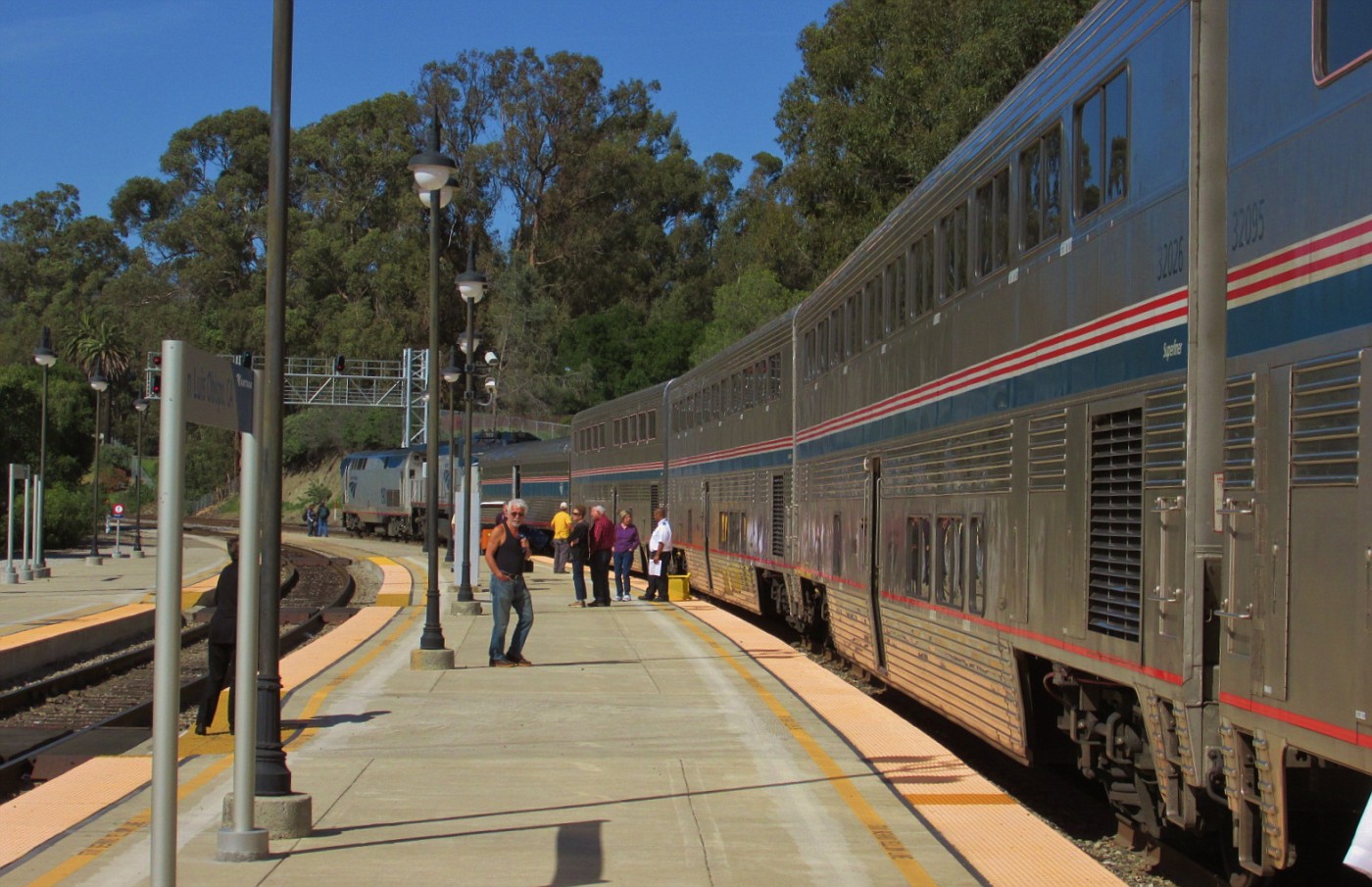
Coast Starlight at San Luis Obispo
During our stop I took some time to catch up with my car attendant, Jay. We’d both done our share of traveling since our paths first crossed in South America nine years ago. Jay’s job and seniority allow him and his wife a fair amount of free time each year and from the places he mentioned, they’d taken full advantage of it. They still hadn’t made it up to Alaska yet, so we exchanged addresses and I promised him a good ride into Denali National Park though I had to hedge on the cloudless mountain view day…
The fact that we’re running on time today is quite a plus in its own right. All of my trains have been on time on this trip. It wasn’t that many years ago that the Coast Starlight was commonly referred to as the “Coast Starlate”. Back in 2006 there was a period of several months where less than 5% of this train’s arrivals were on time. It was not unheard of for the southbound Starlight to limp into Los Angeles five or more hours late. Most of us considered the primary culprit to be the host railroad – the Union Pacific – because they’d give priority to freight traffic. There were also many areas of track construction, especially in the LA area. I remember a few LA bound trains that I’d ridden ending in bus rides due to construction related problems between Santa Barbara and Los Angeles.
Amtrak has yet to make a profit throughout its 43 year history. Better cooperation from the host railroads would go a long way toward at least having a chance at someday realizing those profits through more reliable on-time performances. The Supreme Court will be hearing a case to decide just how that cooperation should be implemented later this fall.
Amtrak Los Angeles to Seattle 1010a – 830p Coast Starlight First Class Car 1431 Room 11
Before Amtrak, no single passenger train had ever operated over the entire length of the West Coast. The closest equivalent was the Southern Pacific’s West Coast, which ran from Los Angeles via the San Joaquin Valley (Bakersfield, Fresno, Modesto) up to Portland. Through cars to Seattle were hooked up in Portland to a separate train that was operated by the Great Northern Railway.
Those desiring the more scenic coastal route could travel via the Southern Pacific’s Daylight between Los Angeles and San Francisco. Upon arrival they’d make then their way across the bay to Oakland and board the overnight Cascade up to Portland. Aside from the route’s scenic attributes, the SP’s Daylight is considered by many to have been the most beautiful passenger train ever built.

Southern Pacific’s Daylight
When Amtrak took over the nation’s passenger railroad operations in 1971, the decision was made to operate a single train from San Diego all the way up to Seattle. Eventually this was changed to originate in Los Angeles and the train came to be known as the Coast Starlight. It’s a nice sounding name but rather an odd one inasmuch as the only coastal portion of the1377 mile journey (a 113 mile stretch from Ventura to a little north of Surf Beach in the Lompoc area) is traveled during broad daylight in each direction.
This will be my 32nd ride aboard the Coast Starlight and I am no less excited today than I was prior to my first ride back in June of 1975. Walking back to the station allowed me a good opportunity to observe the building’s California Mission style architecture. This is not a large station on the scale of New York’s Grand Central or Chicago’s Union Station, but it may well be the prettiest. Columns of palm trees tower above the entrance and to walk into the elegant and airy main hall is to be transported back into the 1930s. The high ceiling, the Spanish-style arches, the large brown leather chairs… I’d almost feel more appropriate if I were wearing one of those 1940s era zoot suits with a proper fedora. Picture Nick Nolte in Mulholland Falls…

Los Angeles Union Station
Photo courtesy of John O’Neill

Los Angeles Union Station Man Hall
First Class passengers on the Starlight are entitled to use Amtrak’s recently opened Metropolitan Lounge. It’s located on the second floor above the Amtrak ticketing counter and accessed via an elevator. This lounge is quite an improvement over the smaller First Class lounge that it replaced. Everything is new and improved, especially the seats which are much more comfortable and come equipped with attached swivel tables and drink holders. The drink and snack selection is on par with most airline clubs though it should be noted that there is no bar and no alcohol is available.
I poured myself a cup of coffee and took a seat at one of the tables set around the lounge. Complimentary Wi-Fi is provided, so I logged on and addressed a few outstanding emails until the call to board was made at about 9:45am.
As is done in Chicago, First Class passengers are escorted out a side door to the train. Motorized golf cart type transports are available to deliver the physically challenged across to the train. I was amongst the last to exit the lounge and although I walk with a bit of limp I’m more than capable of making it out to the train on my own. Even so, the cart operator offered me a ride and as there were only two other people on board I said sure, why not?!
We had a pretty good sized train today – eleven cars in all. There was an old heritage fleet baggage car, a transition sleeper (for the crew), three sleeping cars, the Pacific Parlour Car, a diner, the Sightseer Lounge and three coaches. A pair of handsome Genesis P42DC locomotives led up the front of the consist, providing up to 8,500 horsepower for the 1377 mile journey up the coast and through the mountains to Seattle.
The Coast Starlight is one of the most popular long distance trains in the Amtrak system. First Class accommodations – though substantially more expensive than a coach seat – can be difficult to find on short notice, especially during the spring, summer and fall months. Thankfully I’d booked my reservation about three months ago and was now the proud inhabitant of roomette11 in car 1431.

Train time at Los Angeles
Now here’s a surprise. My car attendant was Jay – who I’d first and last met back in 2005 on a three day ferry ride down the coast of Chile from Puerto Montt to Puerto Natales. What a small world! There’d be plenty of time to catch up later in the trip, so I left Jay to his duties while I took a walk down the platform toward the rear of the train. Of particular interest to me was the Pacific Parlour Car – a special lounge car available only to First Class passengers.
Lounge cars are available on all of Amtrak’s long distance trains but only the Coast Starlight has the Pacific Parlour Car in addition to a Sightseer Lounge Car for general use. By the way – I’m not British. For some odd reason Amtrak chose to use the British spelling for parlor – probably because some higher up thought it sounded classier. We Americans have such an inferiority complex for this kind of stuff…
However you choose to spell it – these Pacific Parlour Cars are wonderful additions to the Coast Starlight, and for many people they are reason enough to pay the extra money for First Class accommodations. Each Parlour Car is outfitted with eight large swivel chairs, a small lounge area with sofas and cocktail tables and six four seat tables with buffet style seating. At one end of the lounge is a stand-up bar offering a full range of beer, wine and spirits in addition to coffee, tea and soft drinks. At the other end is a small library with a collection of used books and board games. Downstairs is a 21 seat movie theater. Full meals featuring a menu unique to the Pacific Parlour Car are also available upstairs in the lounge. Honestly, aside from sleeping and showers, it’d be very easy to spend the entire journey in this car. Oh yeah – did I mention that it also features complimentary Wi-Fi?
Between the Pacific Parlour Car and the wonderful scenery enroute, the Coast Starlight really epitomizes the fact that train trips are about the journey, not the destination.

Amtrak’s Pacific Parlour Car

Amtrak’s Pacific Parlour Car Cocktail Lounge Seating

Amtrak’s Pacific Parlour Car Swivel Chairs
Making my way back to car 1431, I stepped aboard and settled in for the thirty-four hour journey ahead. Jay stopped by to see that everything was okay and we promised to get together later this afternoon. Only one other person was seated downstairs but Jay assured me that this car would be full by the time we pulled out of San Luis Obispo.
There’s not much to see during the first hour of this trip. We rolled through a lot of industrial areas and run down suburbs – visages that will never make their way into any promotional brochures. At least it was a sunny day. Hoisting my daypack, I ascended the stairway and made my way back to the Pacific Parlour Car. All of the big easy chairs were already taken but I did find an empty table where soon I was sipping from a cup of surprisingly good coffee while firing up my laptop to put in a bit of work on this trip report.
Now I realize that photo reports are all the rage these days but let me just say that anybody who’s ever written a long trip report knows that you need to keep up lest you get so far behind that the thought of just forgetting about it all can become increasingly attractive, very quickly transitioning from concept to reality. Now for guys like me who will never publish a trip report until it’s complete, you’d never know but look how often people have started trip reports only to leave us hanging in some place like Tripoli or Tuktoyaktuk.
I’ve got an excellent memory but even so, I find it really helpful to take notes along the way – things like something I saw that stood out for whatever reason, people I met along the way, what I had for dinner and why it was worthy of mention as well as any of those annoyingly deep thoughts about the whole experience that occasionally invade my consciousness. This way even if a fair amount of time should pass before I get around to actually writing the report, I’ve at least got some good notes to work with. The memories get stimulated and in the long run it usually all ends up translating well to report form. Unless that is you’re into the quick and easy gratification derived from speeding through a photo report, in which case my writing becomes little more than annoying blather – especially the longer words – only to be endured between the occasional photographs. Thank goodness for the scroll function!

Hard at work on yet another trip report

Trip Report Fuel
Burbank, Van Nuys, Simi Valley and Oxnard all rolled by without much notice. Then came Ventura and our first views of the ocean. The level of excitement in the lounge car perked up perceptibly. Cameras emerged and lots of photos were taken. Save some space on those film cards, folks! The best of the scenery is yet to come!
The first call for lunch rang out at 12:00. Because meals are also served in the Pacific Parlour Car, it became necessary for me to vacate my table. Thankfully the timing could not have been better as a couple who were sat in the swivel chairs got up to eat. I and another gentleman quickly occupied their empty seats.
The guy who sat down next to me was named Eric and he turned out to be a near encyclopedic source of really interesting information about the train and the surrounding countryside. All of us sat around him enjoyed the information he shared.
Speaking about the Pacific Parlour Cars, Eric told us that there were five of them. They were all originally built back in the 1950s for the Santa Fe's El Capitan, an all-Coach streamliner that offered an inexpensive alternative to the all-Pullman Super Chief. I mentioned that I remembered riding on these cars back in the 70s and 80s when they served as the lounges on the Southwest Limited and the Sunset Limited. Their interiors back then hadn’t changed a whit since their days on the El Cap, complete with the original Southwest tones of turquoise, beige and rust. Downstairs in what is now a movie theater was the Kachina Coffee Shop. By the late 1980s these cars were showing their age and though they weren’t as nice as the newer Sightseer Lounge cars, I always enjoyed the historical aspect of riding them. In any event, as more Superliner equipment came online these old lounge cars were eventually retired to spend the next few years sitting neglected in the LA yards. I remember seeing them out there with broken windows after kids had used them for target practice. It was a sad sight for those of us familiar with their heritage.
In the mid-1990s Amtrak decided to spruce up the Coast Starlight, at that time the most profitable train in the Amtrak system. (Who knows – it may still be!) As part of the improvements, they decided to bring some of the old Santa Fe Hi-Level lounges out of retirement and refurbish them as the dedicated First Class lounges we now call Pacific Parlour Cars. Eric explained that the cost of renovating these cars came to about 2 million each.
I remember riding in these Pacific Parlour Cars back in the late 1990s and early 2000s when you could redeem Alaska Airlines miles for a roundtrip roomette anywhere between Seattle and Los Angeles. I cashed in six of those awards but only about half the trains ever had the Parlour cars on them. I suspect the problem was that while the interiors had been refurbished, the cars themselves were almost 50 years old and they needed a lot of maintenance. In 2008 they went back to Amtrak’s Beech Grove shops where more work was done and I’m happy to report that based upon my seven rides since 2010, they’re now a lot more reliable. They truly are some of the nicest cars to be found anywhere on North American rails and I sincerely hope Amtrak can get another ten good years out of them.
As we approached the Santa Barbara Station, Eric pointed out the Mission Revival architecture so commonly seen in many of the stations along the way. I’ve gotten off here so many times that it feels strange to stay onboard. Santa Barbara enjoys one of the finest climates in the world and today was certainly a fine example. The attractive shops and restaurants of State Street are only a short walk from the station and darn it! Next time I ride a train into SBA, I want to get off for a while!

So long, Santa Barbara!
Shortly after leaving Santa Barbara we returned to the coast. Unlike the tracks south of SBA, there is no highway up here since US 101 heads inland. I suspect the location of Vandenburg Air Force Base a few miles to the north may have something to do with this. There is a small road that serves a couple of these beaches immediately north of Santa Barbara but beyond that, the only way to see the beautiful coastal scenery is to ride the train. Or join the Air Force and get a job at Vandenburg. Let’s check out some pictures!

Coast Starlight running along the Southern California coast
Photo courtesy of Amtrak

Coast Starlight running along the Southern California coast

Coast Starlight running along the Southern California coast

Coast Starlight running along the Southern California coast

Coast Starlight running along the Southern California coast

Coast Starlight running along the Southern California coast

Enjoying the view from the Pacific Parlour Car
Throughout this time I was one of the fortunate few to have a comfy swivel seat in the Pacific Parlour Car. I cannot imagine a better perch from which to view such a beautiful area. At the same time, there are only eight seats so it is nice to share in the bounty with others. My 1:15pm luncheon call could not have been better timed as both Eric and I had picked that time, so we bid farewell to the couple sat across the car from us and headed back to the dining car, conveniently located just one car back. Our plush swivel chairs were quickly taken by new passengers.
Our luncheon companions were Graham and Roma, a couple from Adelaide, Australia. They’d only been in the U.S. for only a couple of weeks but already had visited Las Vegas, Zion and Grand Canyon National Parks and San Diego. They’d rented a car for that portion of the journey but were riding the Coast Starlight now on the recommendation of a friend back home who’d spoken highly of his experience on it.
Menus were distributed and drink orders were taken. Burgers for all of us except Roma who ordered the Chef’s Special – a pasta dish that also came with a salad.
Graham had been to the U.S. before but had never ridden on Amtrak. I asked if he’d ridden any trains in Australia and he replied that when he was a kid his family rode across to Melbourne once, but that was it. Both he and Roma were mightily impressed by everything from the spaciousness of their coach seats to the Sightseer Lounge Car, but they especially liked the coastal views. They were getting off in Emeryville and spending a few days in San Francisco before flying back down to LA and home to Australia. I suggested they come back someday and ride the California Zephyr across to Colorado, my favorite Amtrak ride.
We were just coming up on Point Conception as our drinks arrived. Our waiter pointed it out to us and said it’s considered the place where Southern California ends. Eric added that the coast runs east and west here - the only spot on the Pacific coast between Alaska and the tip of South America where this happens.
Roma expressed surprise at the many eucalyptus trees she’d seen in southern California since she thought they were native to Australia. They are, Eric said. They were imported from Australia by the railroad in the hopes that they’d provide good wood for railroad ties. They didn’t and these days they’re employed more as wind breaks than anything else.
Eric had a route guide – heck, Eric was a route guide! - and as we approached Vandenberg Air Force Base he pointed out that given the classified nature of activities on the base, it had once been a requirement for northbound passengers to close their window shades on the eastern side of the train as it passed through the base. Because the lounge car didn’t have any blinds, the entire car had to be closed! Those restrictions came to an end when many of the activities at the base (mostly commercial satellite launches, I believe) were declassified in the mid-nineties.

Cheesecake along the Pacific Coast
It was a gorgeous afternoon as we eased into San Luis Obispo. Sunshine, blue skies, a slight breeze, temps in the 70s – just heavenly. We’d arrived a couple of minutes ahead of schedule which allowed that much more time for smokers to attend to their addictions. Honestly, they really are something to see as the train approaches any station stop long enough for a smoke break. Assembling in the lower vestibule, they are poised near the door like runners in the blocks, ready to leap off the train and quickly apply flame to tobacco in pursuit of that first long puff of rich, flavorful smoke. And if they smoke fast enough, they might even be able to fire up a second cigarette!
On a lighter note, I love this painting by Amtrak artist Eric Smith of the Coast Starlight stopped at San Luis Obispo. The original is hanging in the LA Metropolitan Lounge but it also made it onto the cover of Amtrak’s timetable. To me at least, it captures perfectly the ambience of a nice afternoon during train time at SLO. Check it out!

Amtrak Timetable featuring Eric Smith’s painting of San Luis Obispo station stop

Coast Starlight at San Luis Obispo
During our stop I took some time to catch up with my car attendant, Jay. We’d both done our share of traveling since our paths first crossed in South America nine years ago. Jay’s job and seniority allow him and his wife a fair amount of free time each year and from the places he mentioned, they’d taken full advantage of it. They still hadn’t made it up to Alaska yet, so we exchanged addresses and I promised him a good ride into Denali National Park though I had to hedge on the cloudless mountain view day…
The fact that we’re running on time today is quite a plus in its own right. All of my trains have been on time on this trip. It wasn’t that many years ago that the Coast Starlight was commonly referred to as the “Coast Starlate”. Back in 2006 there was a period of several months where less than 5% of this train’s arrivals were on time. It was not unheard of for the southbound Starlight to limp into Los Angeles five or more hours late. Most of us considered the primary culprit to be the host railroad – the Union Pacific – because they’d give priority to freight traffic. There were also many areas of track construction, especially in the LA area. I remember a few LA bound trains that I’d ridden ending in bus rides due to construction related problems between Santa Barbara and Los Angeles.
Amtrak has yet to make a profit throughout its 43 year history. Better cooperation from the host railroads would go a long way toward at least having a chance at someday realizing those profits through more reliable on-time performances. The Supreme Court will be hearing a case to decide just how that cooperation should be implemented later this fall.
Last edited by Seat 2A; Jan 1, 2015 at 5:42 pm
#8
FlyerTalk Evangelist
Original Poster
Join Date: Apr 2001
Location: East Ester, Alaska
Programs: Alaska Million Miler, United Million Miler, Wyndham Rewards Diamond, Choice Hotels Diamond
Posts: 12,148
From San Luis Obispo, the Coast Starlight begins the long climb up the Cuesta Grade, climbing 1,000 feet in 10 miles. This would involve numerous tunnels and tight curves through dry brown hills dotted with California Oaks and the occasional cow. We could clearly see the back of the train as we made our way around these sharp curves. Also of interest was a large prison below us – the California Men’s Colony. I remember a car attendant once mentioning that its most famous inmate had been Timothy Leary. Had I not left my daypack and camera back in my room, I’d grace you all with a photo or two.
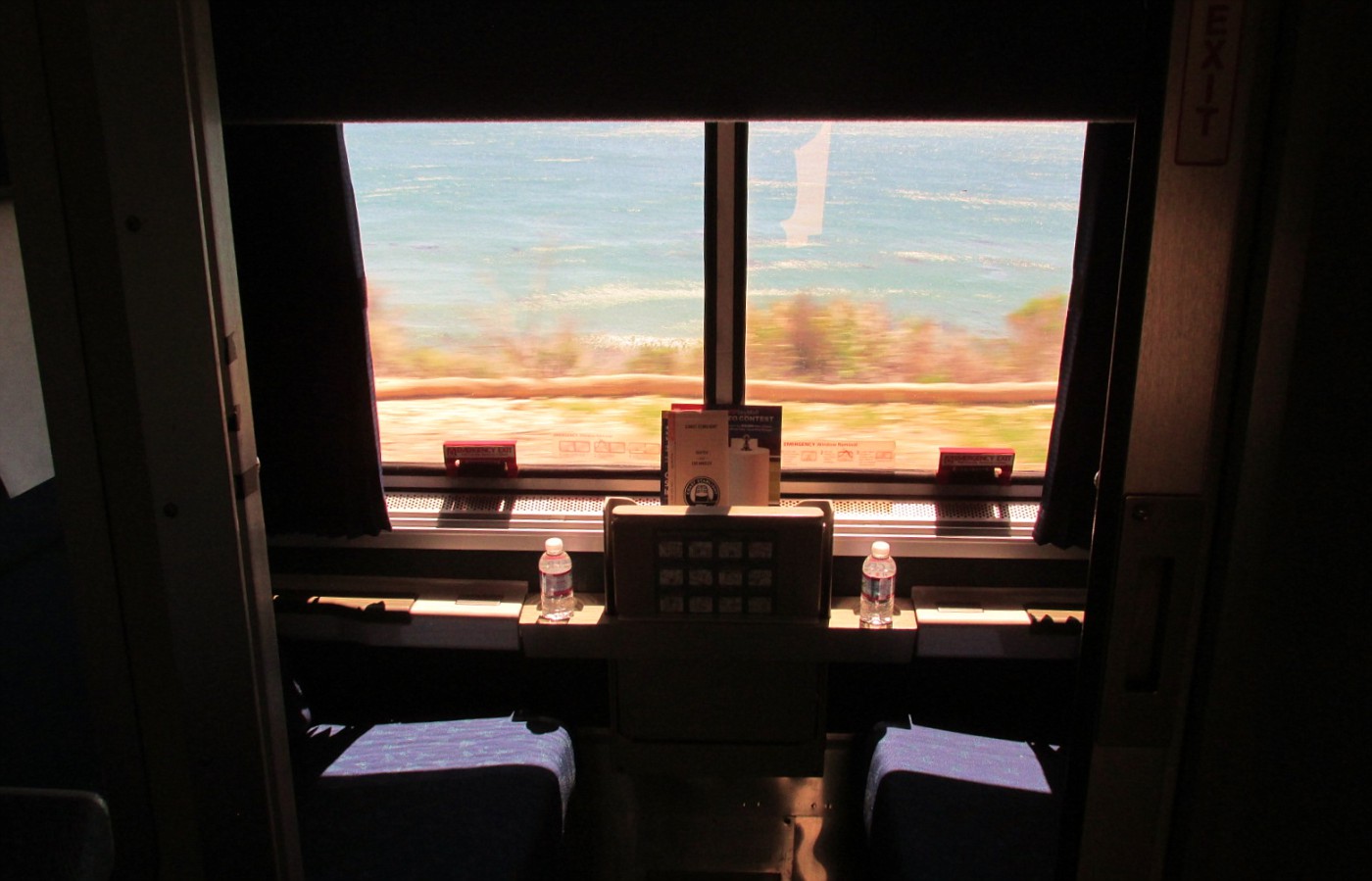
Coast Starlight Roomette view
Our journey continued through the wine country of Paso Robles and I was reminded of the afternoon wine tastings which used to be a highlight of a trip on the Coast Starlight. They were available to First Class passengers only and involved three or four different wines accompanied by plates of various cheeses and crackers. Amtrak related trivia questions would be asked with the winners receiving a complimentary bottle of wine. Quick! How many revolutions does your train car wheel make over the course of one mile? It was all in good fun and a very pleasant diversion as the day wore on. Unfortunately those wine tastings were discontinued as part of a cost cutting move earlier this year.

Pacific Parlour Car set up for the afternoon wine tasting
Ah… the good old days on Amtrak…
As the sun sank ever lower on the western horizon, we rolled through the farmland in and around Salinas. According to Amtrak’s Route Guide, the Salinas Valley is known as the “Salad Bowl of the World”. I could certainly see why as I gazed out upon mile after mile of fields.
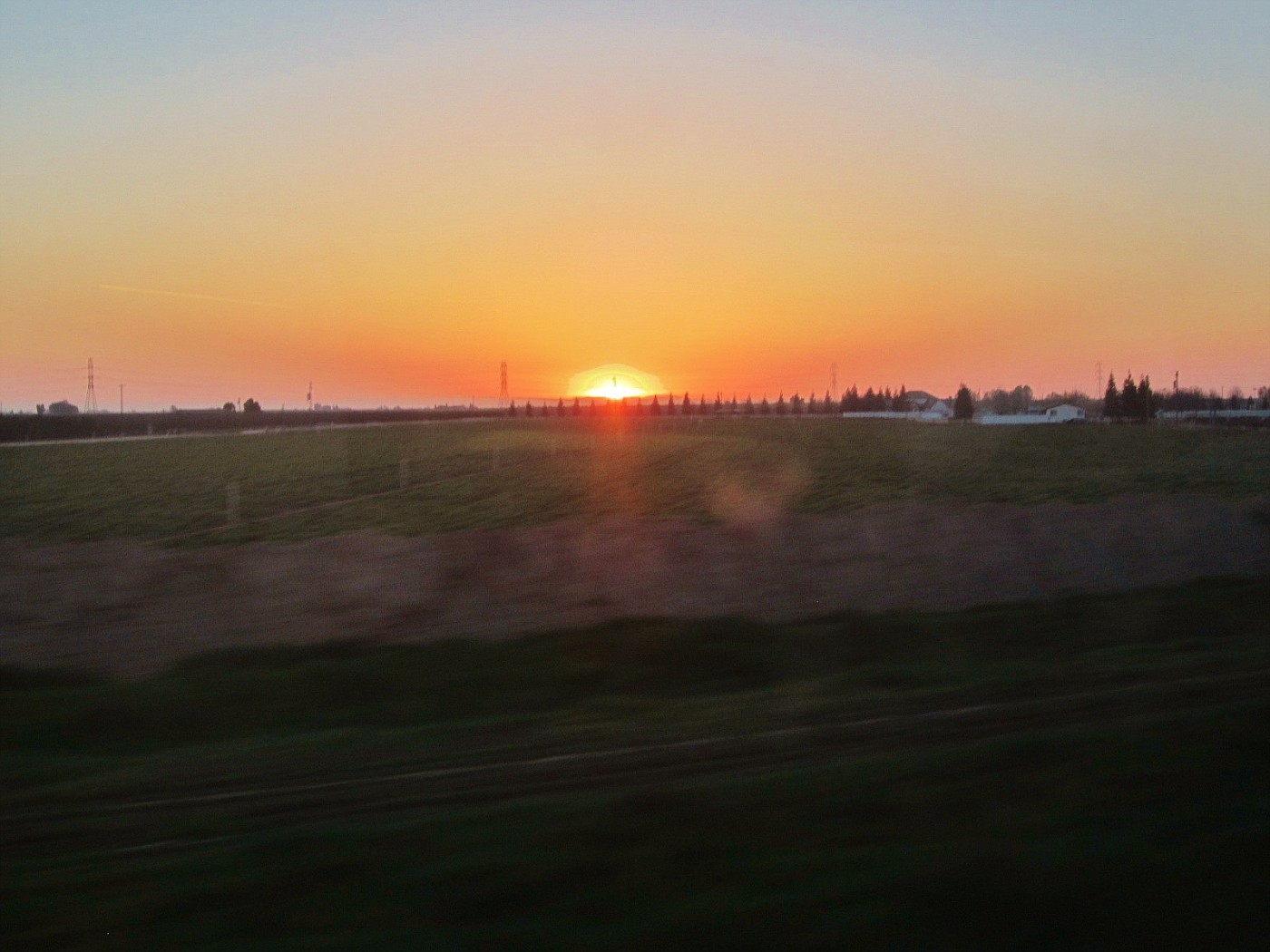
Central California Sunset
At dinner I was joined by Willie and Marsha, a couple from Littleton, Colorado who were getting off in Sacramento before continuing on to Colorado in a couple of days aboard the California Zephyr. Also joining us was a lady from Tampa, Florida who’d flown out to Burbank to visit her college roommate. She was riding the Starlight up to Emeryville on the advice of her friend in Burbank. While she’d enjoyed the ride so far, she said she was ready to get off by the time we’d reached San Luis Obispo. The scenery and all was nice but…
To be sure, train travel isn’t for everyone. Certainly it does take a lot longer than flying and for those who just want to get there, no amount of fancy prose from me is going to change their minds. But again, it’s all about the journey. Some of us are into that and some of us aren’t.
For those of into a nice meal while rolling through the countryside, Amtrak’s Dinner Menu offers some nice options. Once again however, I was in the mood for steak. Willie’s short rib looked really good though, and I made a mental note to order that for tomorrow’s dinner.
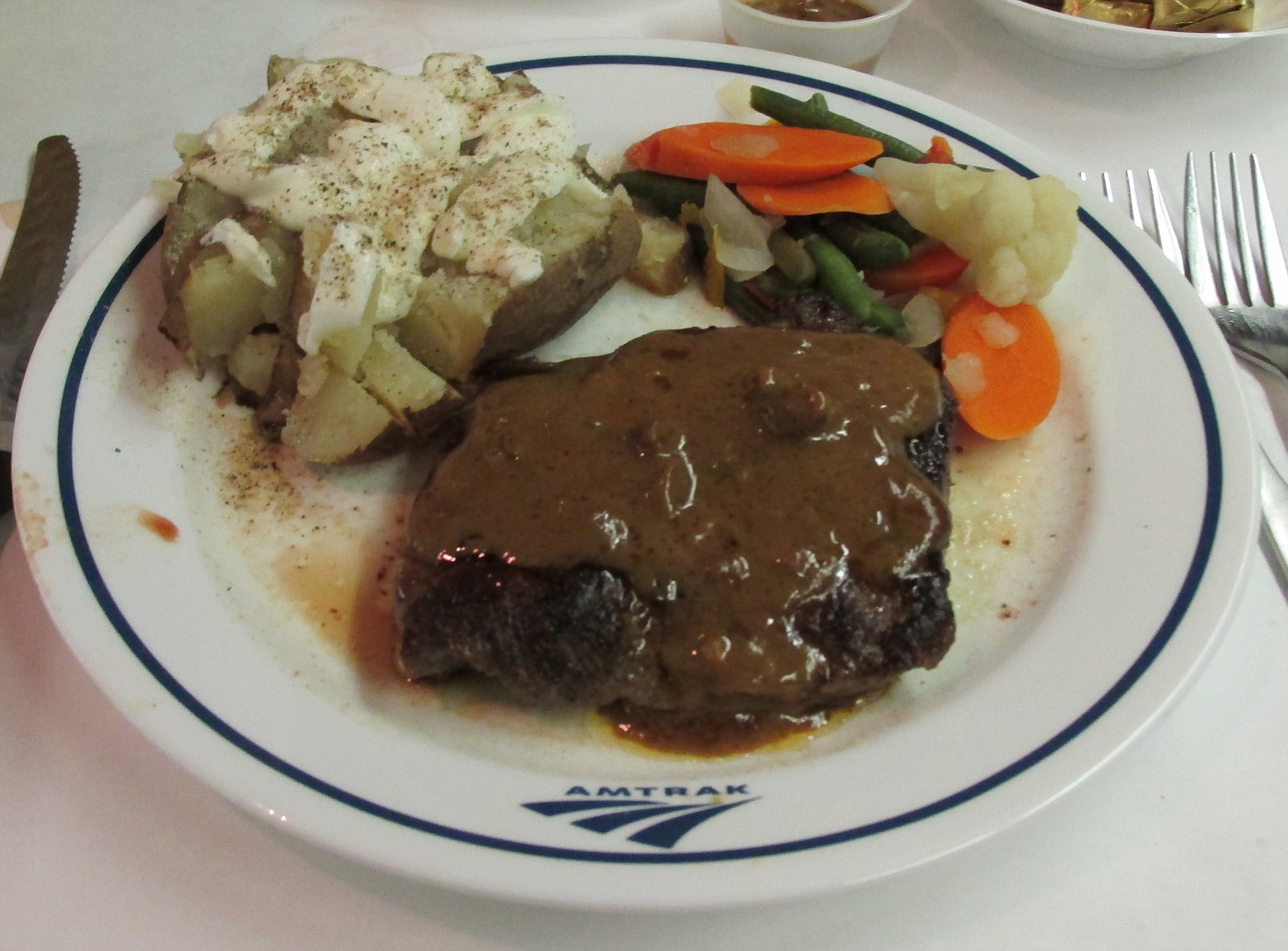
Amtrak’s Flat Iron Steak
The Coast Starlight is quite popular with day trippers looking to travel from Southern California up to San Jose. Our lounge car attendant claimed that San Jose is the most popular stop on this route, especially northbound. This is understandable given the favorable schedule which features a mid-morning departure from all LA area stations and an early evening arrival into San Jose. From what I could see, we lost a lot more people than we gained at SJC and as we continued our journey north to Oakland and beyond, the crowd in the Pacific Parlour Car was noticeably thinner.
Not to worry said our lounge car attendant. We’d probably be replacing them all between Emeryville and Sacramento.
Unless you live in the East Bay, you may not be familiar with Emeryville. Frankly I’m not all that familiar with Emeryville, so HERE, you can read all about it via Wikipedia’s surprisingly extensive entry. Amtrak used to serve downtown Oakland via the old 16th Street Station. That station was damaged in the Loma Prieta Earthquake of 1989 and it was ultimately replaced by the new facility in Emeryville. What I remember about the old Oakland station is that it looked like something out of one of those post-apocalyptic movies – cavernous, dark, foreboding… Earthquake damage notwithstanding, the station was still extremely unsafe due to the deteriorating neighborhood which was home to all manner of hoodlums and other nefarious types, many of whom exhibited poor posture and questionable hygiene. When I used to ride through here back in the 70s and 80s the train staff took great pains to make it abundantly clear that getting off the train and wandering around outside the station would be a very bad idea indeed.
Since the Pacific Parlous Car offered free Wi-Fi, I spent an hour or so surfing the net before deciding to call it a night at Davis. By the time we pulled out of Sacramento at midnight, I was sound asleep.
Day Nine
Enroute to Seattle aboard the Coast Starlight
It’s a shame that the area between Sacramento and the Oregon border is traversed at night, because it is some very pretty country indeed. Still, there’s no getting around it if you want to enjoy that pretty scenery along the Pacific coast during the day.
Those who wake early enough in the summer months will be treated to a very pretty view of Mt. Shasta. Or – if you’re lucky – the train will be running an hour or so late and you can take in the view at a more civilized hour. Today we were pretty much on time and I slept in, which meant I awoke about a half hour out of Klamath Falls.
You know, I’ve just spent the past four nights aboard Amtrak Superliners and I gotta say that I feel just great! I mean, I’ve had a comfortable bed to sleep in each night, a hot shower each morning, coffee and orange juice conveniently located nearby and three square meals each day. As travel experiences go, for guys like me who are into the journey it just doesn’t get much better.
We were running about twenty minutes late by the time we rolled into Klamath Falls at 8:35am. This is a service stop for the train, which means we’ll have about ten minutes here while garbage is disposed of and food and ice are replenished. This is also the place where newspapers are picked up for delivery to First Class passengers. I accepted my copy and headed upstairs to the dining car where hot coffee, a good veggie omelet with cheese, black beans, corn, chicken sausage and a croissant gave me a good start for the day.
Out of Klamath we rolled north along the shores of Klamath Lake where a very pretty view was had of 9,495’ Mt. McLoughlin, a classic steep sided conical volcano that last erupted about 30000 years ago. I think it’s due!
Up in the Pacific Parlour Car I had a nice chat with a man and his son about trains, planes, the Alaska Ferry system, the Boston Red Sox, National Parks, things we’d seen and done in South America, the best store bought pizzas, who’s going to win the Super Bowl this season, Toyota trucks – looking back on it I’m thinking what didn’t we talk about? We just had a great time chatting it up over coffee and sweet rolls as the Starlight rolled north on a windy day through Chemult, up over Cascade Summit, down to the Willamette Valley and on into Eugene. At that point we had arrived at their destination and so bid each other farewells and good travels.
Now some of you might be thinking – why is this worthy of mention again – I’ve had plenty of good conversations on flights. No doubt, but unless you were on a lounge equipped 747 from the 1970s, how many of you managed to do so from the ambience of big overstuffed chairs (where seat pitch and legroom were not concerns) with coffee, snacks and a stand up bar (with alcohol available) all while outside your large sidewall and ceiling windows passed giant spruce trees, deep valleys, rivers, lakes, mountains and lots of natural daylight? The overall environment was so much nicer than the narrow confines of a dark airplane cabin filled with seats and the artificial light from laptops and IFEs.
A couple of interesting points from the route guide:
• Eugene is the westernmost city served in the Amtrak system
• The Willamette is one of the few rivers in North America that flow from the south to the north
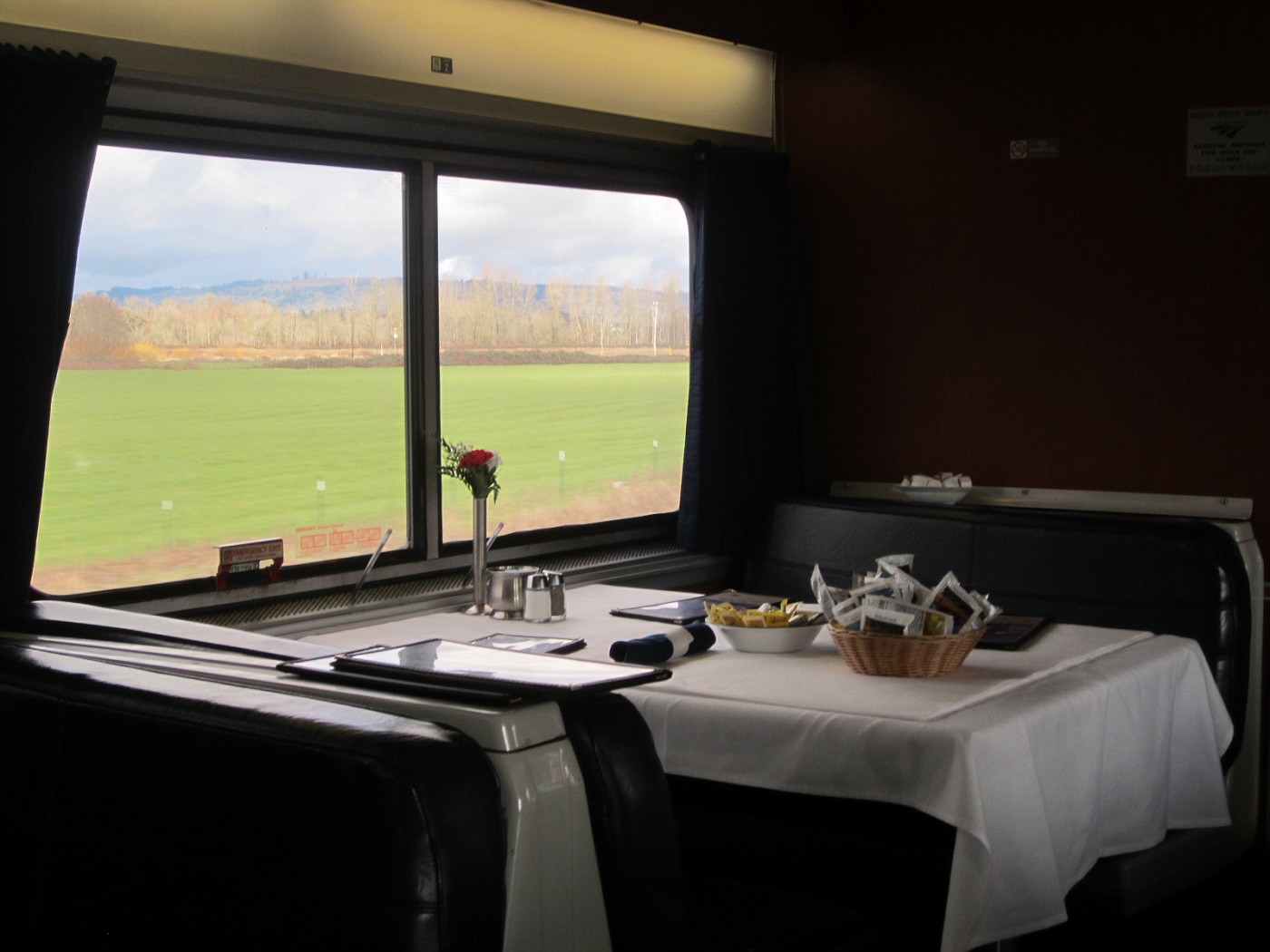
Lunchtime in the Willamette Valley
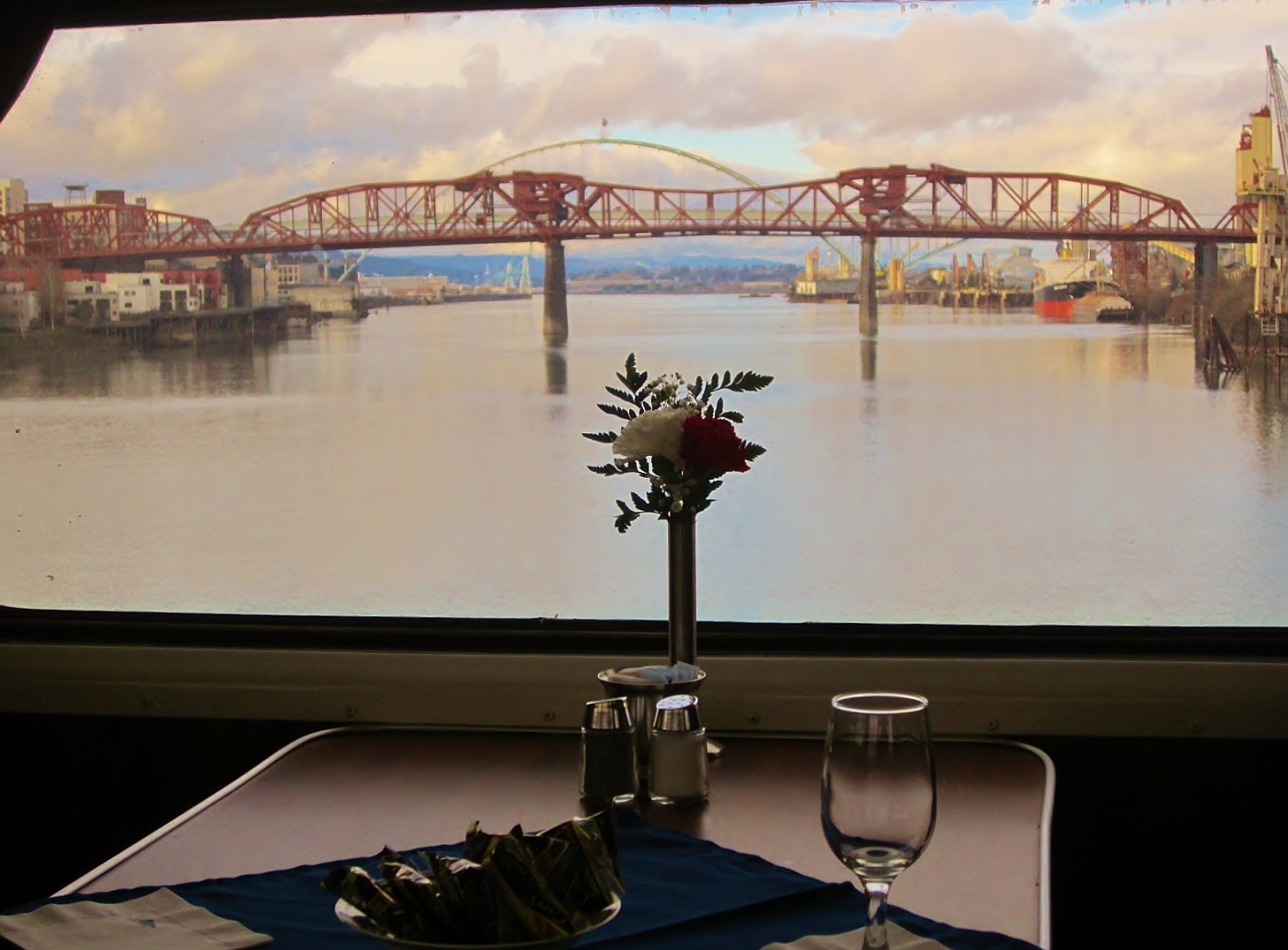
Arrival into Portland over the famous Steel Bridge
In Portland we stopped for a good half hour, allowing plenty of time for through passengers to go inside the historic brick station, opened in 1896. This is one of my all-time favorite train stations with its distinctive clock tower and polished Italian marble waiting room. Like Denver’s Union Station, there’s a 1940s era neon sign encouraging passengers to “Go By Train”. In Portland this is mounted up high on the clock tower. A small convenience store inside the station offers a small selection of railroad collectibles in addition to the usual convenience store stuff. I purchased a copy of Trains magazine and headed over to the Metropolitan Lounge for a quick coffee before re-boarding.
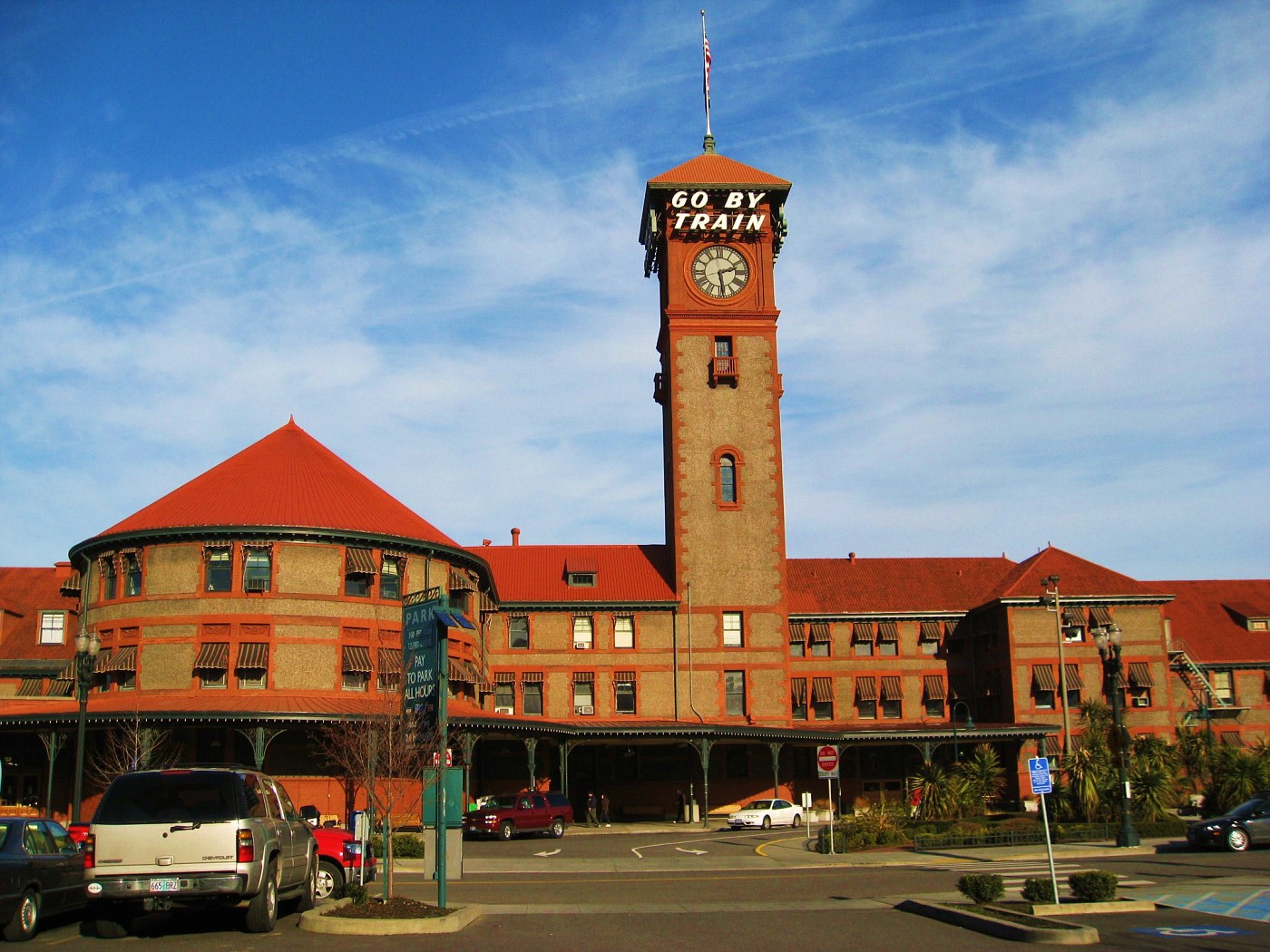
Portland Union Station
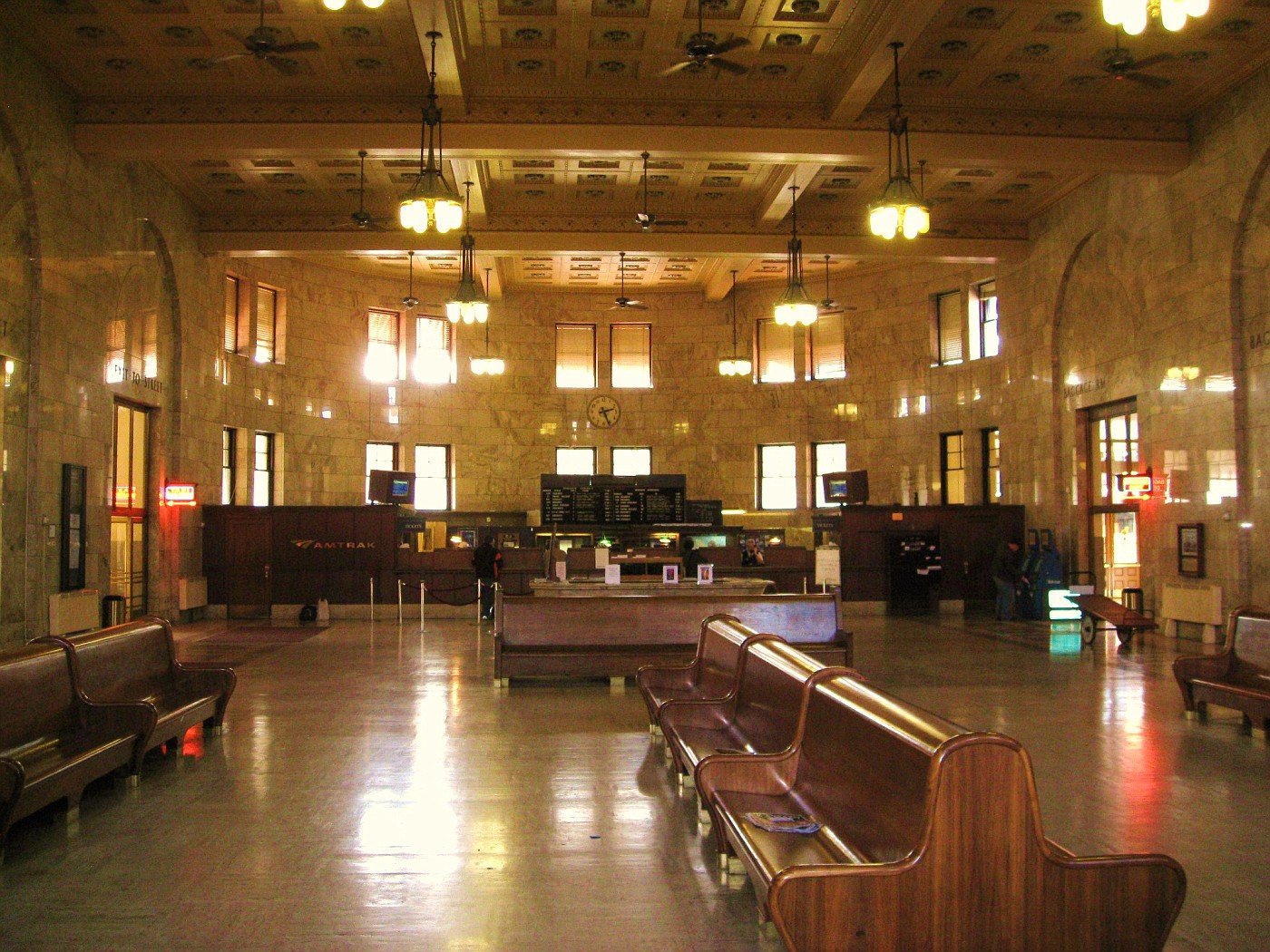
Portland Union Station Main Hall
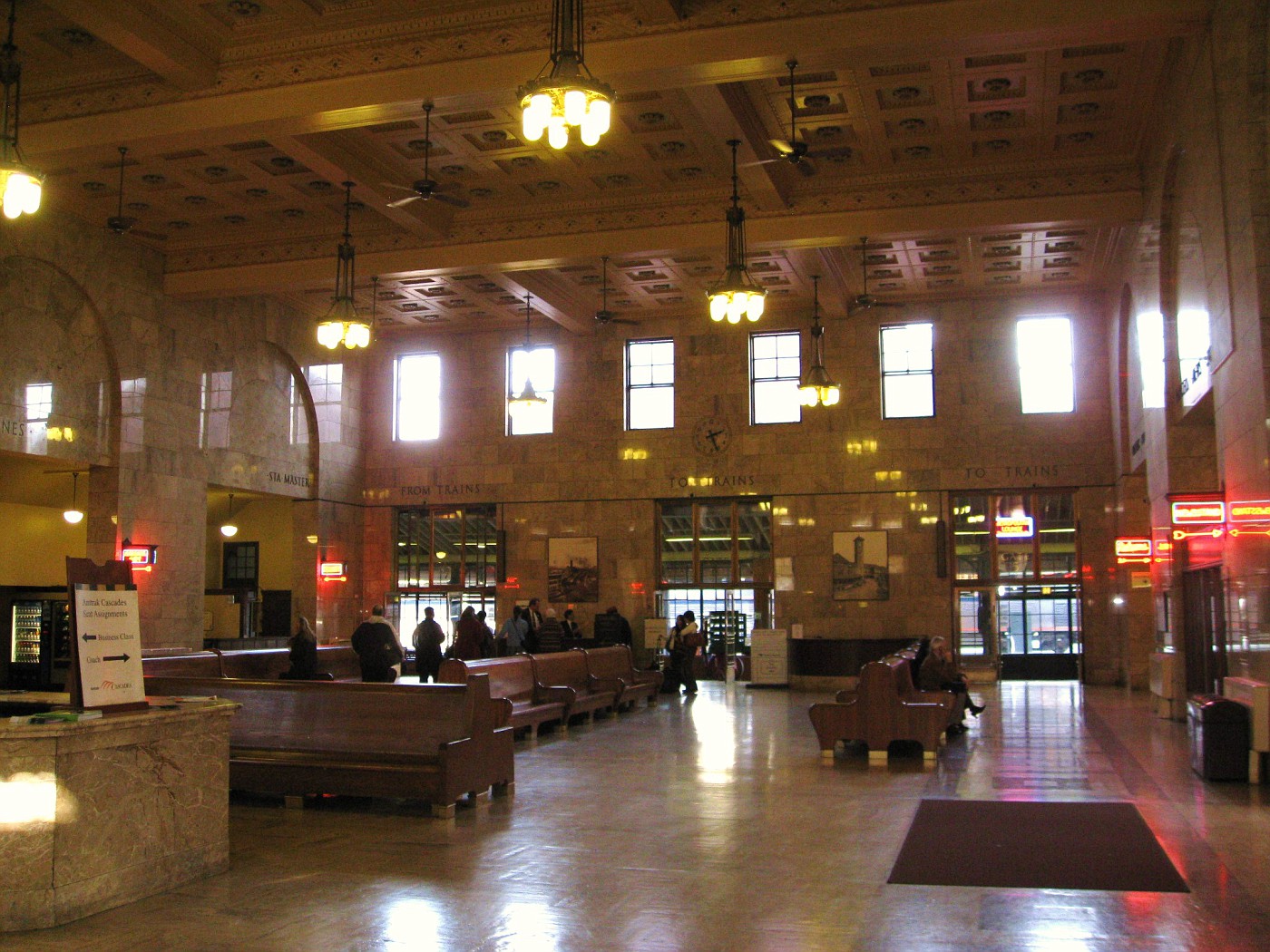
Portland Union Station Main Hall
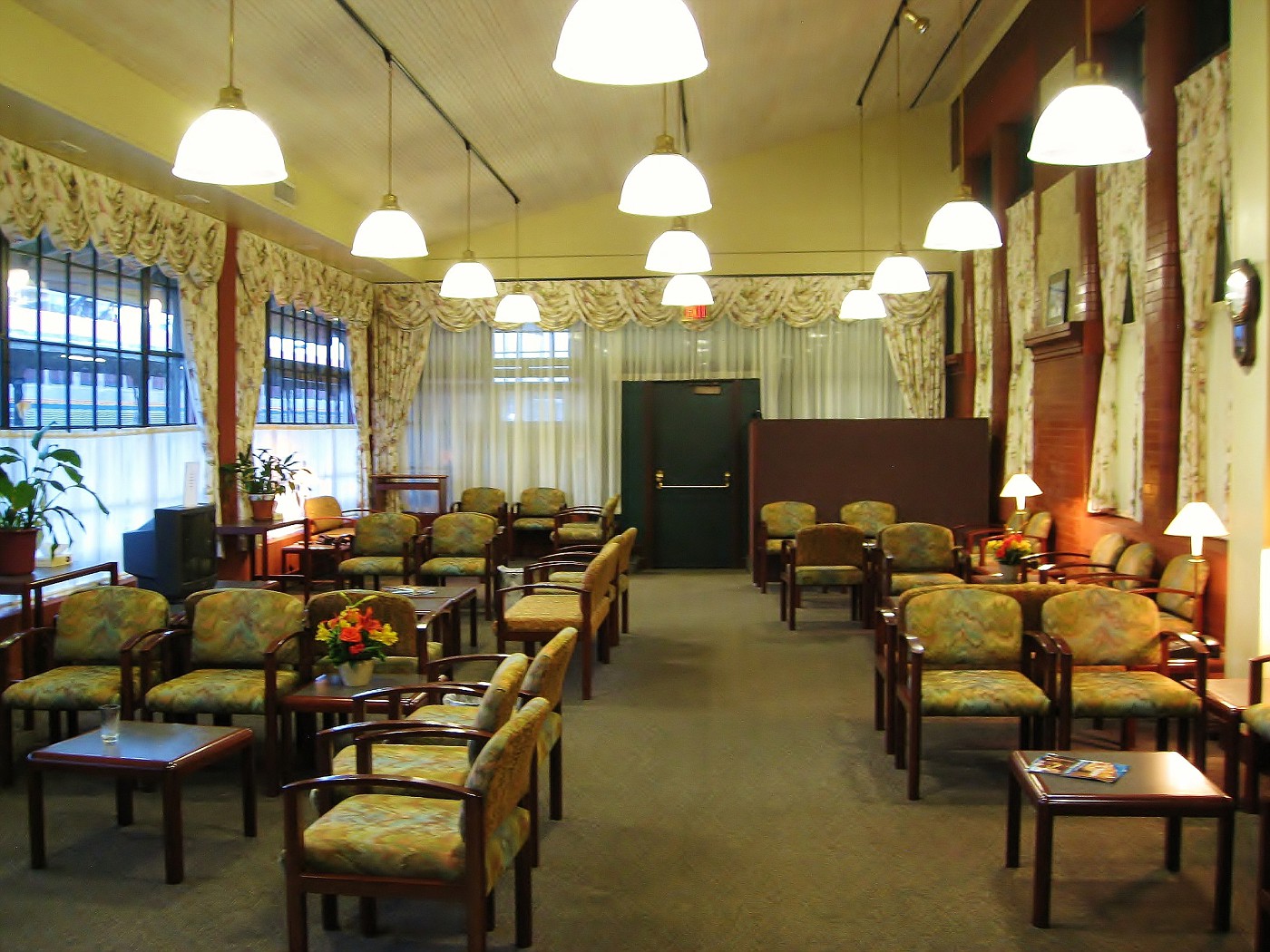
Metropolitan Lounge at PDX
The four hour ride from Portland up to Seattle is fairly nondescript. It’s essentially 170 miles of tree lined tracks with the occasional river and highway crossing. It becomes a lot more interesting north of Tacoma as the tracks run along or near the Puget Sound. The view of the Tacoma Narrows Bridge is stunning. It was close to dark by the time we passed by but here’s a photo from a trip I took at an earlier time of day.
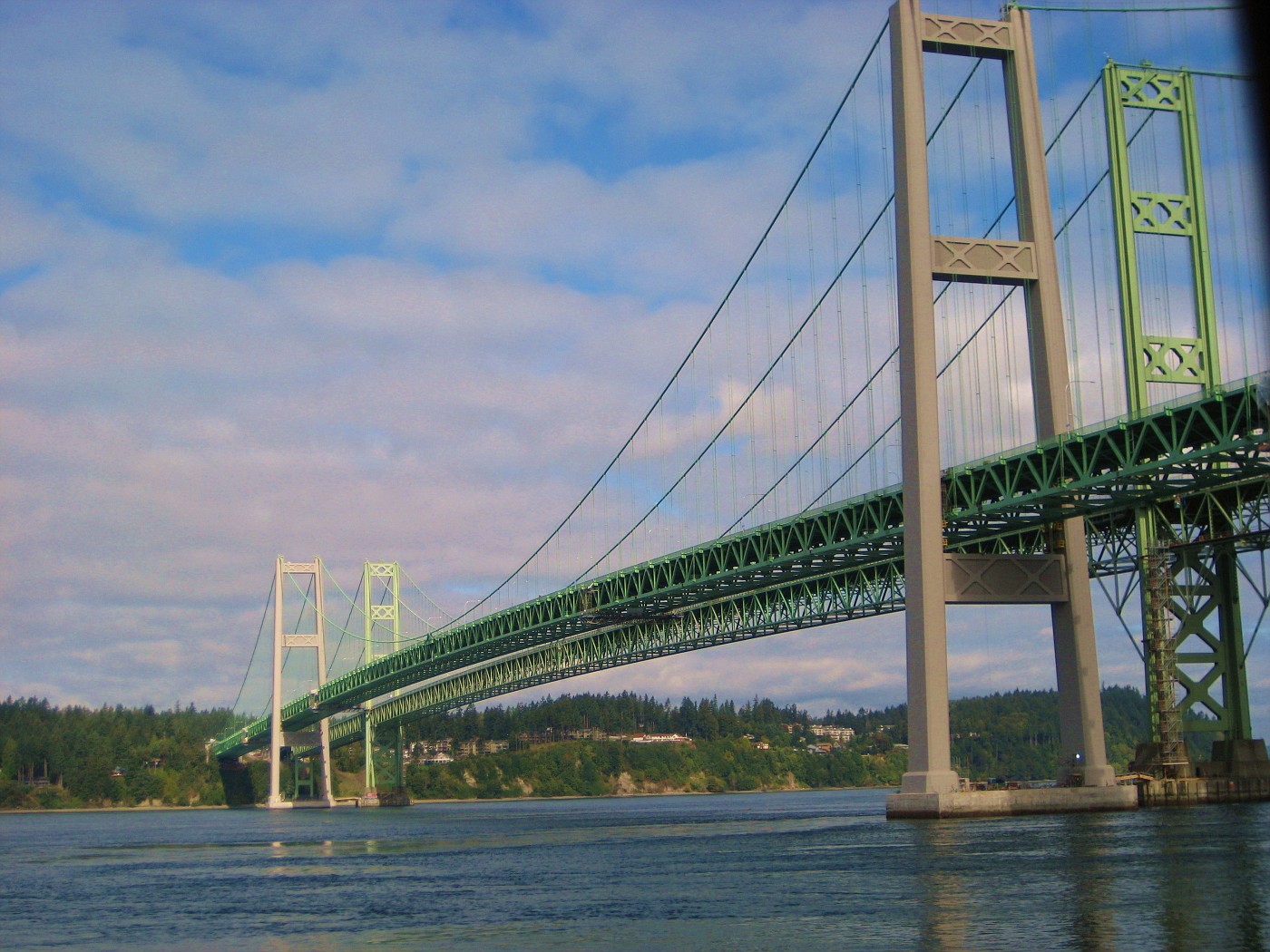
Tacoma Narrows Bridge
Arrival into Seattle was at 8:45pm – just 15 minutes late. I stopped briefly to say so long to Jay and leave him a well-deserved tip. The man is a true professional and did a great job throughout the trip interacting with his passengers and keeping the car clean and well stocked in addition to setting up and breaking down this car’s fourteen roomettes and six bedrooms for daytime or nighttime use each day. It’s not an easy job being a car attendant but Jay does it as well as anyone I’ve met on the Amtrak system. Good job, man!
Once upon a time, Seattle’s King Street Station was as busy as it was grand. The same architects who created New York’s magnificent Grand Central Station designed the King Street Station. It was constructed of brick and granite from the quarries at Index, WA. The interior of the building was white marble, and ornate plaster decorated the ceiling. Most of the floors were terrazzo and mosaic tiling, forming borders and dramatic designs. The building's most notable feature, the clock tower, was designed to mimic the bell tower at St. Mark's Church in Venice, Italy. The King Street Station truly looked like and indeed was a place where great rail journeys began. The Empire Builder, the North Coast Limited, the Western Star – they all departed from the King Street Station.
The decline in the nation’s passenger rail traffic was mirrored in the once grand central waiting room. For years this station sat dirty and neglected, looking more like a third world bus station than the glorious big city station it once was. Over the years I saw many posters promising renovation, but the pace was glacial at best.
Imagine then my surprise and delight as I walked into King Street Station tonight and discovered that the long renovation project has finally been completed! The high ornate ceiling, once hidden behind dingy particleboard tiles, has been completely restored. The beautiful white marble walls that were once covered with dry wall now provide an elegant backdrop to the attractive main hall. Even the terrazzo and mosaic tiling on the floor has been beautifully restored and polished. The end result is a station every bit as beautiful as the city it serves. Bravo, Seattle, bravo!!
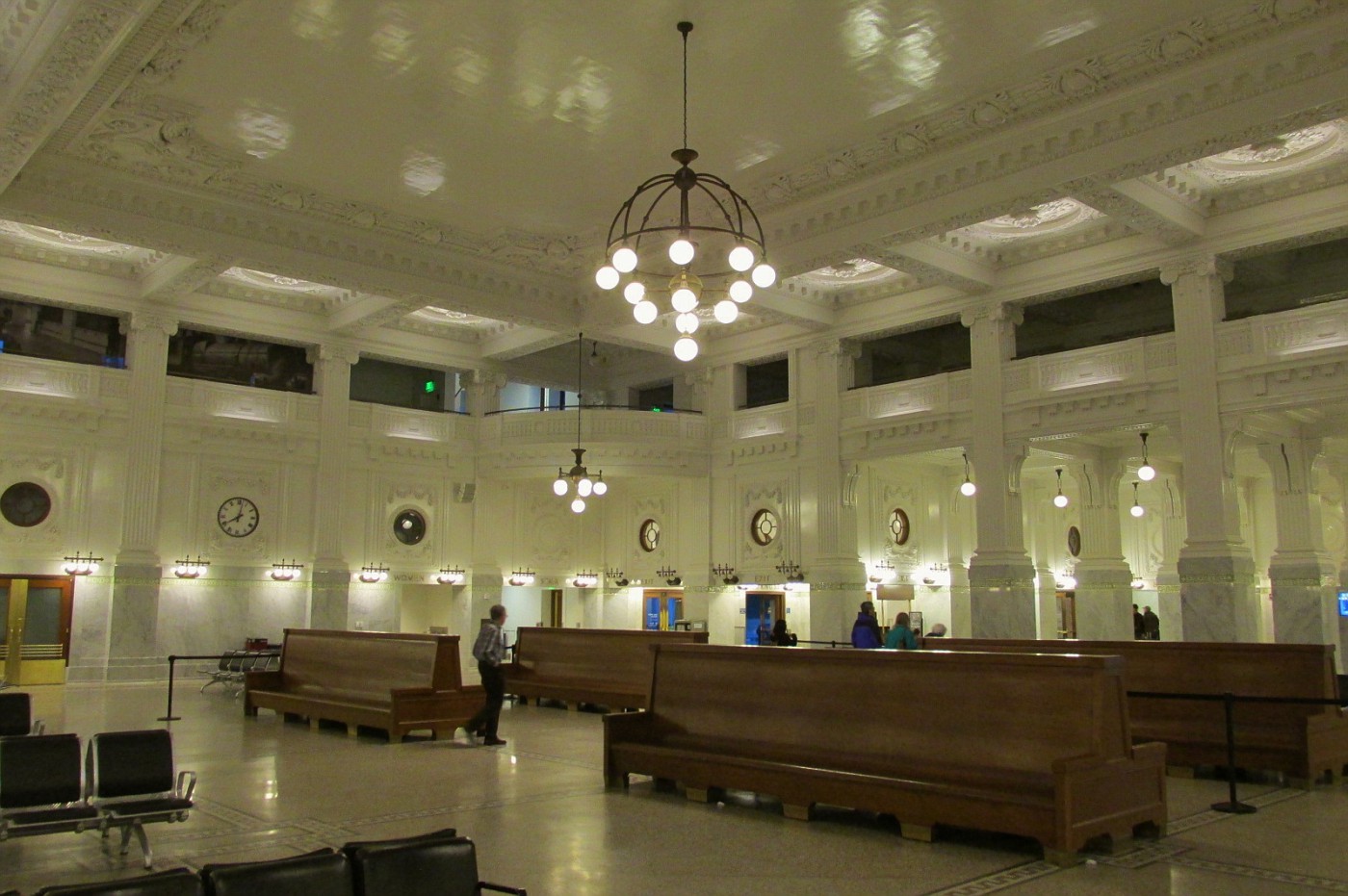
Seattle’s King Street Station Main Hall
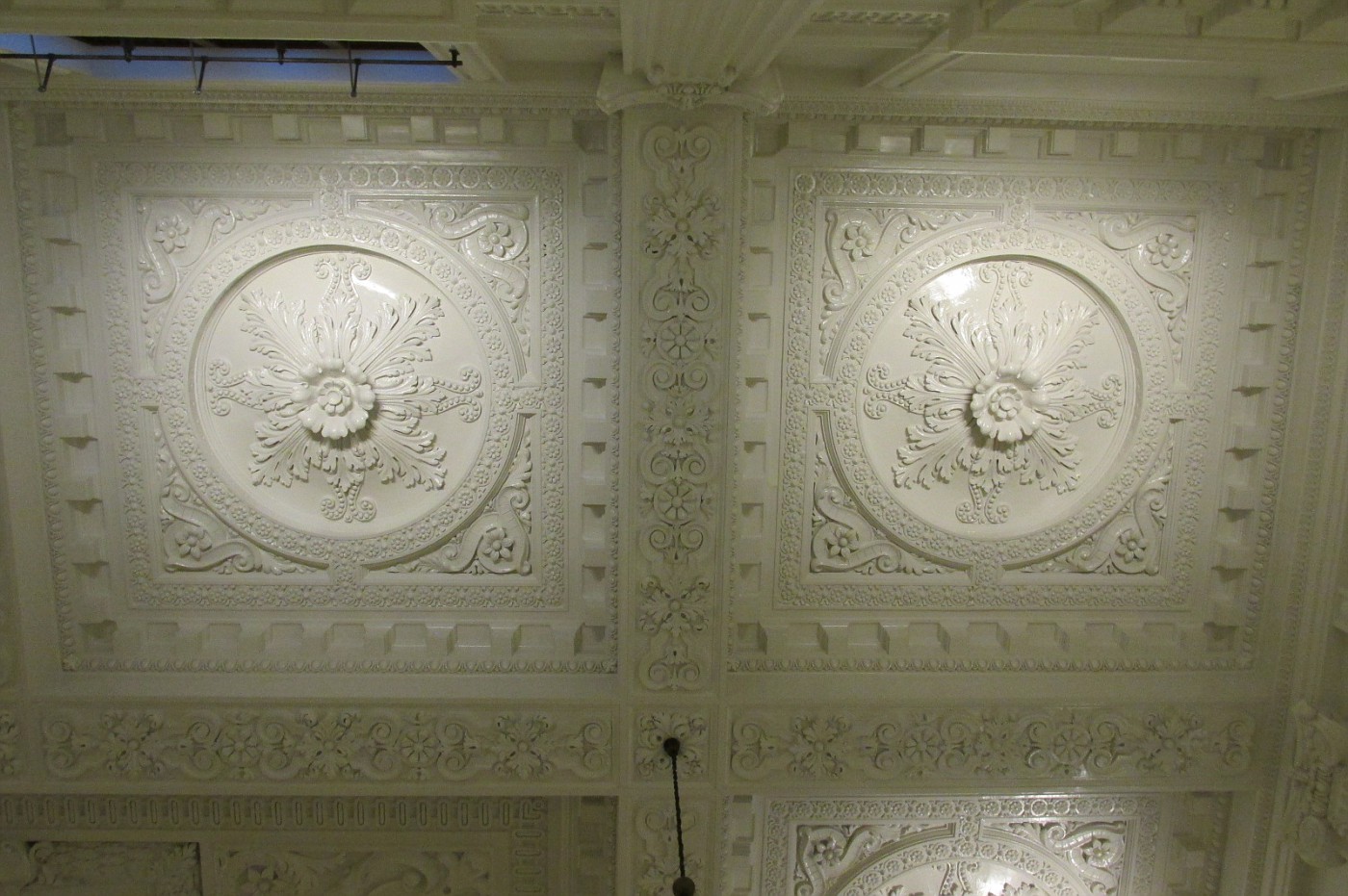
Seattle’s King Street Station Ceiling
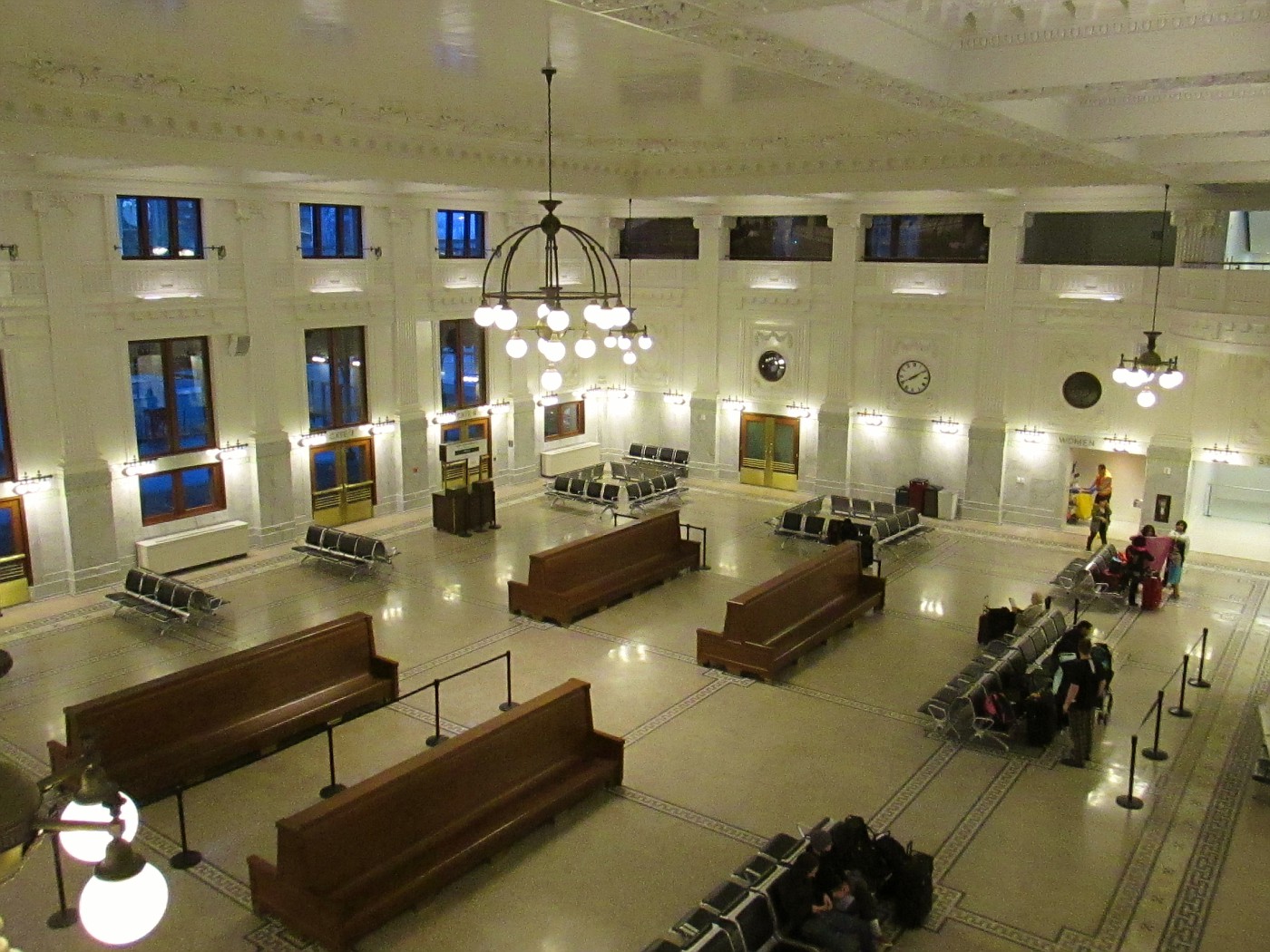
Seattle’s King Street Station Main Hall from Above

Coast Starlight Roomette view
Our journey continued through the wine country of Paso Robles and I was reminded of the afternoon wine tastings which used to be a highlight of a trip on the Coast Starlight. They were available to First Class passengers only and involved three or four different wines accompanied by plates of various cheeses and crackers. Amtrak related trivia questions would be asked with the winners receiving a complimentary bottle of wine. Quick! How many revolutions does your train car wheel make over the course of one mile? It was all in good fun and a very pleasant diversion as the day wore on. Unfortunately those wine tastings were discontinued as part of a cost cutting move earlier this year.

Pacific Parlour Car set up for the afternoon wine tasting
Ah… the good old days on Amtrak…
As the sun sank ever lower on the western horizon, we rolled through the farmland in and around Salinas. According to Amtrak’s Route Guide, the Salinas Valley is known as the “Salad Bowl of the World”. I could certainly see why as I gazed out upon mile after mile of fields.

Central California Sunset
At dinner I was joined by Willie and Marsha, a couple from Littleton, Colorado who were getting off in Sacramento before continuing on to Colorado in a couple of days aboard the California Zephyr. Also joining us was a lady from Tampa, Florida who’d flown out to Burbank to visit her college roommate. She was riding the Starlight up to Emeryville on the advice of her friend in Burbank. While she’d enjoyed the ride so far, she said she was ready to get off by the time we’d reached San Luis Obispo. The scenery and all was nice but…
To be sure, train travel isn’t for everyone. Certainly it does take a lot longer than flying and for those who just want to get there, no amount of fancy prose from me is going to change their minds. But again, it’s all about the journey. Some of us are into that and some of us aren’t.
For those of into a nice meal while rolling through the countryside, Amtrak’s Dinner Menu offers some nice options. Once again however, I was in the mood for steak. Willie’s short rib looked really good though, and I made a mental note to order that for tomorrow’s dinner.

Amtrak’s Flat Iron Steak
The Coast Starlight is quite popular with day trippers looking to travel from Southern California up to San Jose. Our lounge car attendant claimed that San Jose is the most popular stop on this route, especially northbound. This is understandable given the favorable schedule which features a mid-morning departure from all LA area stations and an early evening arrival into San Jose. From what I could see, we lost a lot more people than we gained at SJC and as we continued our journey north to Oakland and beyond, the crowd in the Pacific Parlour Car was noticeably thinner.
Not to worry said our lounge car attendant. We’d probably be replacing them all between Emeryville and Sacramento.
Unless you live in the East Bay, you may not be familiar with Emeryville. Frankly I’m not all that familiar with Emeryville, so HERE, you can read all about it via Wikipedia’s surprisingly extensive entry. Amtrak used to serve downtown Oakland via the old 16th Street Station. That station was damaged in the Loma Prieta Earthquake of 1989 and it was ultimately replaced by the new facility in Emeryville. What I remember about the old Oakland station is that it looked like something out of one of those post-apocalyptic movies – cavernous, dark, foreboding… Earthquake damage notwithstanding, the station was still extremely unsafe due to the deteriorating neighborhood which was home to all manner of hoodlums and other nefarious types, many of whom exhibited poor posture and questionable hygiene. When I used to ride through here back in the 70s and 80s the train staff took great pains to make it abundantly clear that getting off the train and wandering around outside the station would be a very bad idea indeed.
Since the Pacific Parlous Car offered free Wi-Fi, I spent an hour or so surfing the net before deciding to call it a night at Davis. By the time we pulled out of Sacramento at midnight, I was sound asleep.
Day Nine
Enroute to Seattle aboard the Coast Starlight
It’s a shame that the area between Sacramento and the Oregon border is traversed at night, because it is some very pretty country indeed. Still, there’s no getting around it if you want to enjoy that pretty scenery along the Pacific coast during the day.
Those who wake early enough in the summer months will be treated to a very pretty view of Mt. Shasta. Or – if you’re lucky – the train will be running an hour or so late and you can take in the view at a more civilized hour. Today we were pretty much on time and I slept in, which meant I awoke about a half hour out of Klamath Falls.
You know, I’ve just spent the past four nights aboard Amtrak Superliners and I gotta say that I feel just great! I mean, I’ve had a comfortable bed to sleep in each night, a hot shower each morning, coffee and orange juice conveniently located nearby and three square meals each day. As travel experiences go, for guys like me who are into the journey it just doesn’t get much better.
We were running about twenty minutes late by the time we rolled into Klamath Falls at 8:35am. This is a service stop for the train, which means we’ll have about ten minutes here while garbage is disposed of and food and ice are replenished. This is also the place where newspapers are picked up for delivery to First Class passengers. I accepted my copy and headed upstairs to the dining car where hot coffee, a good veggie omelet with cheese, black beans, corn, chicken sausage and a croissant gave me a good start for the day.
Out of Klamath we rolled north along the shores of Klamath Lake where a very pretty view was had of 9,495’ Mt. McLoughlin, a classic steep sided conical volcano that last erupted about 30000 years ago. I think it’s due!
Up in the Pacific Parlour Car I had a nice chat with a man and his son about trains, planes, the Alaska Ferry system, the Boston Red Sox, National Parks, things we’d seen and done in South America, the best store bought pizzas, who’s going to win the Super Bowl this season, Toyota trucks – looking back on it I’m thinking what didn’t we talk about? We just had a great time chatting it up over coffee and sweet rolls as the Starlight rolled north on a windy day through Chemult, up over Cascade Summit, down to the Willamette Valley and on into Eugene. At that point we had arrived at their destination and so bid each other farewells and good travels.
Now some of you might be thinking – why is this worthy of mention again – I’ve had plenty of good conversations on flights. No doubt, but unless you were on a lounge equipped 747 from the 1970s, how many of you managed to do so from the ambience of big overstuffed chairs (where seat pitch and legroom were not concerns) with coffee, snacks and a stand up bar (with alcohol available) all while outside your large sidewall and ceiling windows passed giant spruce trees, deep valleys, rivers, lakes, mountains and lots of natural daylight? The overall environment was so much nicer than the narrow confines of a dark airplane cabin filled with seats and the artificial light from laptops and IFEs.
A couple of interesting points from the route guide:
• Eugene is the westernmost city served in the Amtrak system
• The Willamette is one of the few rivers in North America that flow from the south to the north

Lunchtime in the Willamette Valley

Arrival into Portland over the famous Steel Bridge
In Portland we stopped for a good half hour, allowing plenty of time for through passengers to go inside the historic brick station, opened in 1896. This is one of my all-time favorite train stations with its distinctive clock tower and polished Italian marble waiting room. Like Denver’s Union Station, there’s a 1940s era neon sign encouraging passengers to “Go By Train”. In Portland this is mounted up high on the clock tower. A small convenience store inside the station offers a small selection of railroad collectibles in addition to the usual convenience store stuff. I purchased a copy of Trains magazine and headed over to the Metropolitan Lounge for a quick coffee before re-boarding.

Portland Union Station

Portland Union Station Main Hall

Portland Union Station Main Hall

Metropolitan Lounge at PDX
The four hour ride from Portland up to Seattle is fairly nondescript. It’s essentially 170 miles of tree lined tracks with the occasional river and highway crossing. It becomes a lot more interesting north of Tacoma as the tracks run along or near the Puget Sound. The view of the Tacoma Narrows Bridge is stunning. It was close to dark by the time we passed by but here’s a photo from a trip I took at an earlier time of day.

Tacoma Narrows Bridge
Arrival into Seattle was at 8:45pm – just 15 minutes late. I stopped briefly to say so long to Jay and leave him a well-deserved tip. The man is a true professional and did a great job throughout the trip interacting with his passengers and keeping the car clean and well stocked in addition to setting up and breaking down this car’s fourteen roomettes and six bedrooms for daytime or nighttime use each day. It’s not an easy job being a car attendant but Jay does it as well as anyone I’ve met on the Amtrak system. Good job, man!
Once upon a time, Seattle’s King Street Station was as busy as it was grand. The same architects who created New York’s magnificent Grand Central Station designed the King Street Station. It was constructed of brick and granite from the quarries at Index, WA. The interior of the building was white marble, and ornate plaster decorated the ceiling. Most of the floors were terrazzo and mosaic tiling, forming borders and dramatic designs. The building's most notable feature, the clock tower, was designed to mimic the bell tower at St. Mark's Church in Venice, Italy. The King Street Station truly looked like and indeed was a place where great rail journeys began. The Empire Builder, the North Coast Limited, the Western Star – they all departed from the King Street Station.
The decline in the nation’s passenger rail traffic was mirrored in the once grand central waiting room. For years this station sat dirty and neglected, looking more like a third world bus station than the glorious big city station it once was. Over the years I saw many posters promising renovation, but the pace was glacial at best.
Imagine then my surprise and delight as I walked into King Street Station tonight and discovered that the long renovation project has finally been completed! The high ornate ceiling, once hidden behind dingy particleboard tiles, has been completely restored. The beautiful white marble walls that were once covered with dry wall now provide an elegant backdrop to the attractive main hall. Even the terrazzo and mosaic tiling on the floor has been beautifully restored and polished. The end result is a station every bit as beautiful as the city it serves. Bravo, Seattle, bravo!!

Seattle’s King Street Station Main Hall

Seattle’s King Street Station Ceiling

Seattle’s King Street Station Main Hall from Above
Last edited by Seat 2A; Jan 1, 2015 at 5:44 pm
#9
FlyerTalk Evangelist
Original Poster
Join Date: Apr 2001
Location: East Ester, Alaska
Programs: Alaska Million Miler, United Million Miler, Wyndham Rewards Diamond, Choice Hotels Diamond
Posts: 12,148
Day Ten
Alaska Airlines Seattle to San Diego 1115a – 156p 737-900 First Class
Grey clouds and a gentle rain were the order of the day in the Pacific Northwest, so it was with considerable anticipation that I looked forward to relocating down to sunny San Diego where a full sized rental car and a 1500 mile road trip awaited.
Coffee, yogurt and an apple got the morning off to a good start in the Alaska Airlines Boardroom. As a twenty year member of the Boardroom, I know the ladies who work there well as do they know me. Today was highlighted by a rare sighting of Leslie who’s often off enjoying the sun and surf of Maui. She’s like Boardroom royalty in my book though – always a pretty smile and a sunny disposition to greet her guests. It was good to see her again and we took a couple moments to catch up before the demands for her attention forced me to continue on into the Boardroom.
Boarding of my 737-900 was over on the North Satellite. United used to be the primary tenant at this facility but Alaska’s growth combined with United’s cutbacks to its Seattle operations have resulted in United’s relocation to the newer A concourse while Alaska has completely taken over the North Satellite. Unfortunately, United’s departure from the North Satellite also resulted in the closure of its lounge – the United Club, one of my favorite SEA lounges and locations. I go back to the days when that lounge was known as the Red Carpet Club and used to be located upstairs in a small room off gate N-9. About fifteen years ago it relocated to the old SAS First and Business Class lounge, located downstairs behind the escalators at train level. United did a great job with that lounge! For a room that had no windows, United managed to make it into a cozy, comfortable and welcoming cave – a great place to spend an hour or two before your flight. I miss it.
Unfortunately, there are no longer lounges of any stripe over on the North Satellite. By contrast, the South Satellite hosts three lounges (Delta’s Sky Club, BA’s Terraces and the Club International). Alaska claims to have plans to build a new facility up on top of the satellite, similar to Delta’s Sky Club over on the South Satellite. As of this writing however, it won’t be until 2018 before that lounge will be a reality. In the meantime word is that Alaska will open a temporary Boardroom sometime in the next year on the North Satellite but it’s anybody’s guess as to whether that’ll be the next three months or the final three months of the year. Until it opens, I am not a big fan of North Satellite departures.
Is anybody here old enough to remember those old Clairol hair coloring ads? Remember the jingle? “Hate those grays? Rinse them away!” For some reason that came to mind as we broke through the gloomy day gray beneath the cloud cover and zoomed into the bright sunny world above it. Ahh…
What’s that? Oh yes, a Bloody Mary would be fine, thanks.
Breakfast on today’s two hour and twenty minute flight down to San Diego was described as French Toast and Scrambled Eggs. While that sounded good in theory, the reality of it was a rounded puck of scrambled eggs and a deep fried half piece of French Toast. I can’t imagine anyone of French descent would be proud to have this version associated with their country. The eggs were topped with marinara sauce and accompanied by a sausage patty. It was an odd flavor combination to go with the “French” toast but being the omnivore that I am, I managed to wolf it all down along with a second helping of Bloody Mary.
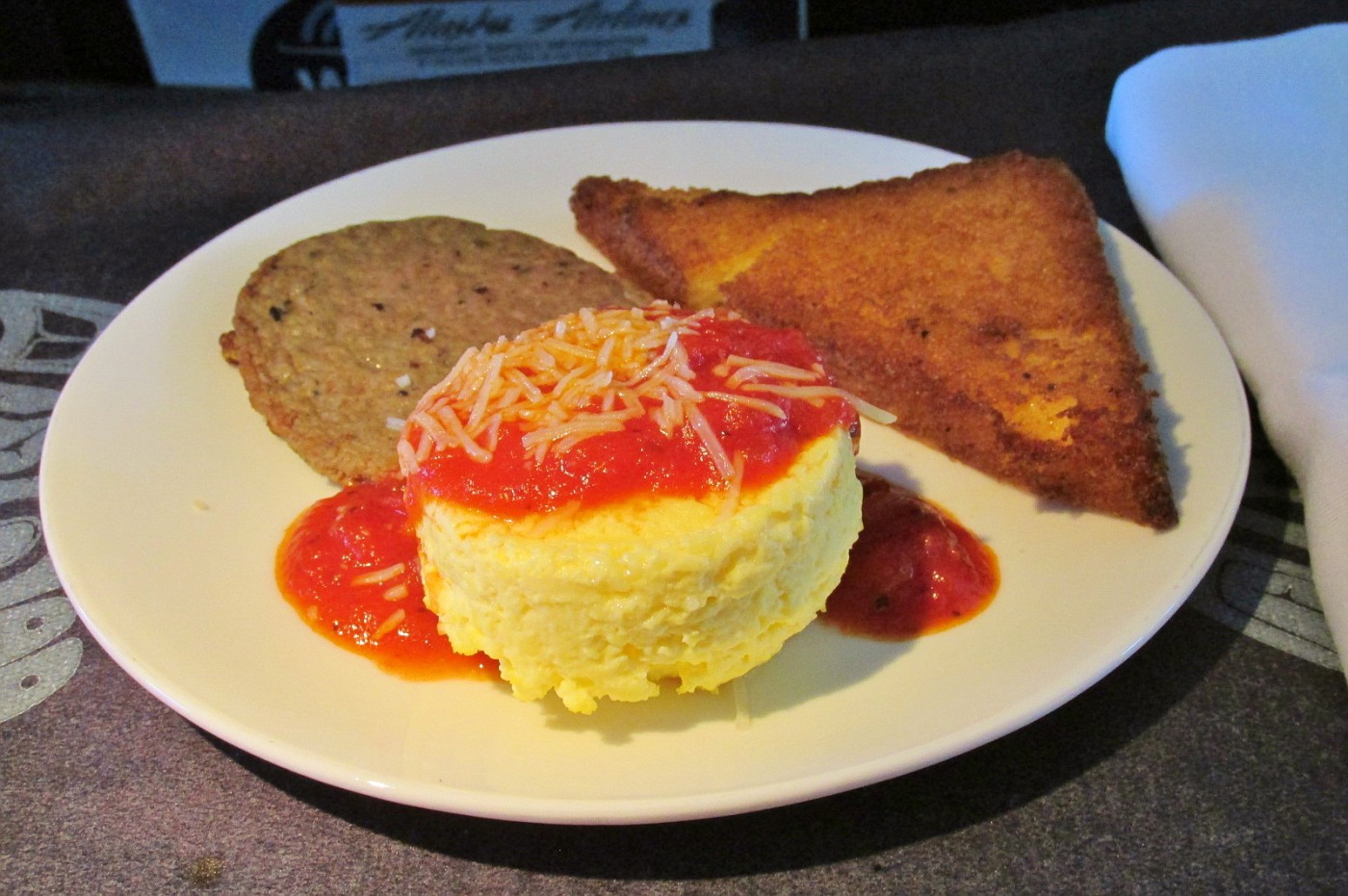
French Toast and Scrambled Eggs
Upon arrival at San Diego’s old Terminal 1, I made my way outside and across to the rental car pick-up area. Thirty minutes later I was speeding east along Interstate 8 in a silver Hyundai Sonata with only 8000 miles on it. Sonatas have become downright ubiquitous amongst North American car rental companies. Thankfully I’ve come to rather like these cars. They’re decently sized, their seats are easy on my back and if you put good quality gas in them they’ll reward you with exceptional gas mileage.
Now when it comes to road trips, there’s no place I’d rather drive than the American West. Here’s that map again:
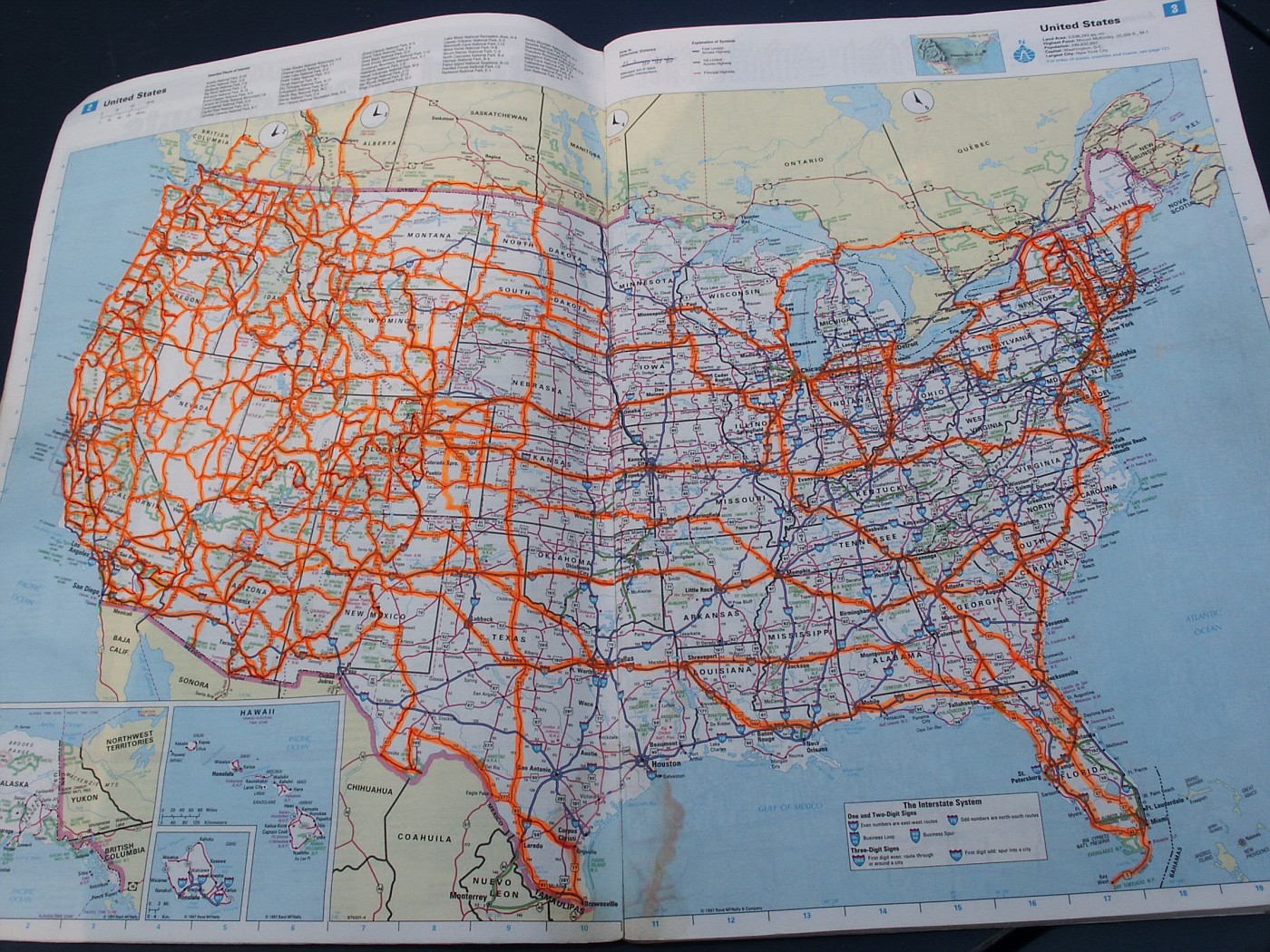
Roads I’ve Driven in my 1988 Mazda B2200
All of those roads were driven in my 1988 Mazda B2200 truck. I drove that truck for twenty-one years, putting 493,000 miles on three different engines, but just the one transmission. I kept the map because it was fun to see where I’d been, but at the same time when you’ve covered as much territory as I have that map was also helpful in showing me where I hadn’t been. From 1988 to 2005, I drove my little blue truck through all forty-nine contiguous states as well as most of Western Canada. In the western United States (from Montana down through Wyoming and Colorado to New Mexico and everywhere west), I’ve driven over 80% of all the state and federal highways. And that’s not even counting roads I traveled in my vehicles prior to 1988 or since 2009.
A few years ago, I met an 84-year-old man who claimed to have been in all but four counties in the United States. Four counties! There must be two hundred counties between the Dakotas and Nebraska alone! I was impressed.
Sometime later, I took a look at my roadmap with the idea of seeing just how many counties in the Western United States I’d been to. I’ve neither the time nor the inclination to see every county in America, but the West is where I’ve done most of my driving and frankly, that’s where my real interest lies.
To make a long story shorter, there were nine counties in the Western U.S. that I’d not yet driven through. Six of them were in Eastern Montana, two were in New Mexico and one in Idaho. Neither I nor my truck were getting any younger, so in 2005 I drove down to the lower 48 and knocked them off. In the process I got to see and visit a lot of cool places I’d likely not have driven otherwise. Places like Fort Benton, Montana – the end of the line for riverboats on the Missouri River. Or Lovington, New Mexico – the home of Chicago Bears linebacker Brian Urlacher. Being a fan of the Denver Broncos, I stopped for lunch in a local café before continuing on to Carlsbad Caverns National Park.
Getting back to this trip, driving is very relaxing for me. I love the pace of the scenery going by and I enjoy the physical act of driving. Unlike most guys, speed has nothing to do with it. If I were to win a Maserati tomorrow, I’d immediately trade it in for a something more practical, like my truck. Or a 1975 Cadillac Eldorado convertible. Now there’s a proper car for me to cruise across the country in!
I particularly enjoy driving through the Desert Southwest. Whereas some people are intimidated by the expansive desolation of the desert – not to mention the climate – I am attracted to it. My favorite desert is the Mojave, which occupies more than 25,000 square miles of southeastern California with portions of it extending into Nevada, Arizona and Utah. It is home to Death Valley and Joshua Tree National Parks as well as the 1.4 million acre Mojave National Preserve – my favorite of the three. Although I don’t log drives like I do flights, if I did I would guess that I’ve driven over 50000 miles around the Mojave.
My favorite road across the Mojave is Route 66 – the Mother Road. Route 66 like an old friend to me. I love the old 1940s and 50s era cafes and motels that populate the small towns it runs through. I also love the old look and feel of the road. With the exception of business districts through larger towns like Kingman, Arizona, Route 66 is a two lane road throughout the Southwest. On this trip I’ll drive it from Amboy, California to Seligman, Arizona. So buckle your seatbelts and let’s go!
Rather than give you a mile by mile travelogue, I thought I’d present most of this drive through pictures. The captions will give a bit more information…
San Diego, CA to Amboy, CA
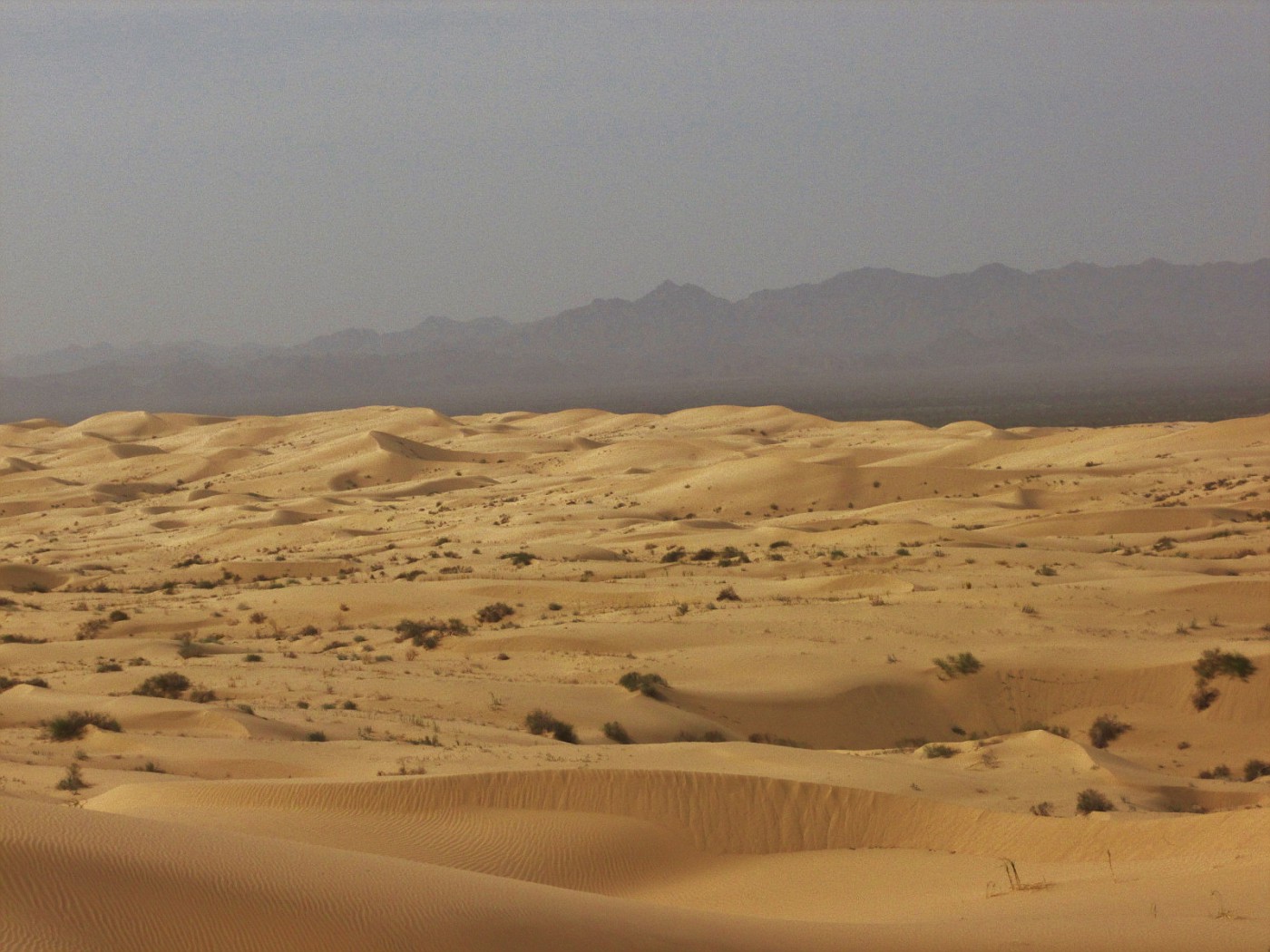
Driving California Highway 78 through the Imperial Sand Dunes
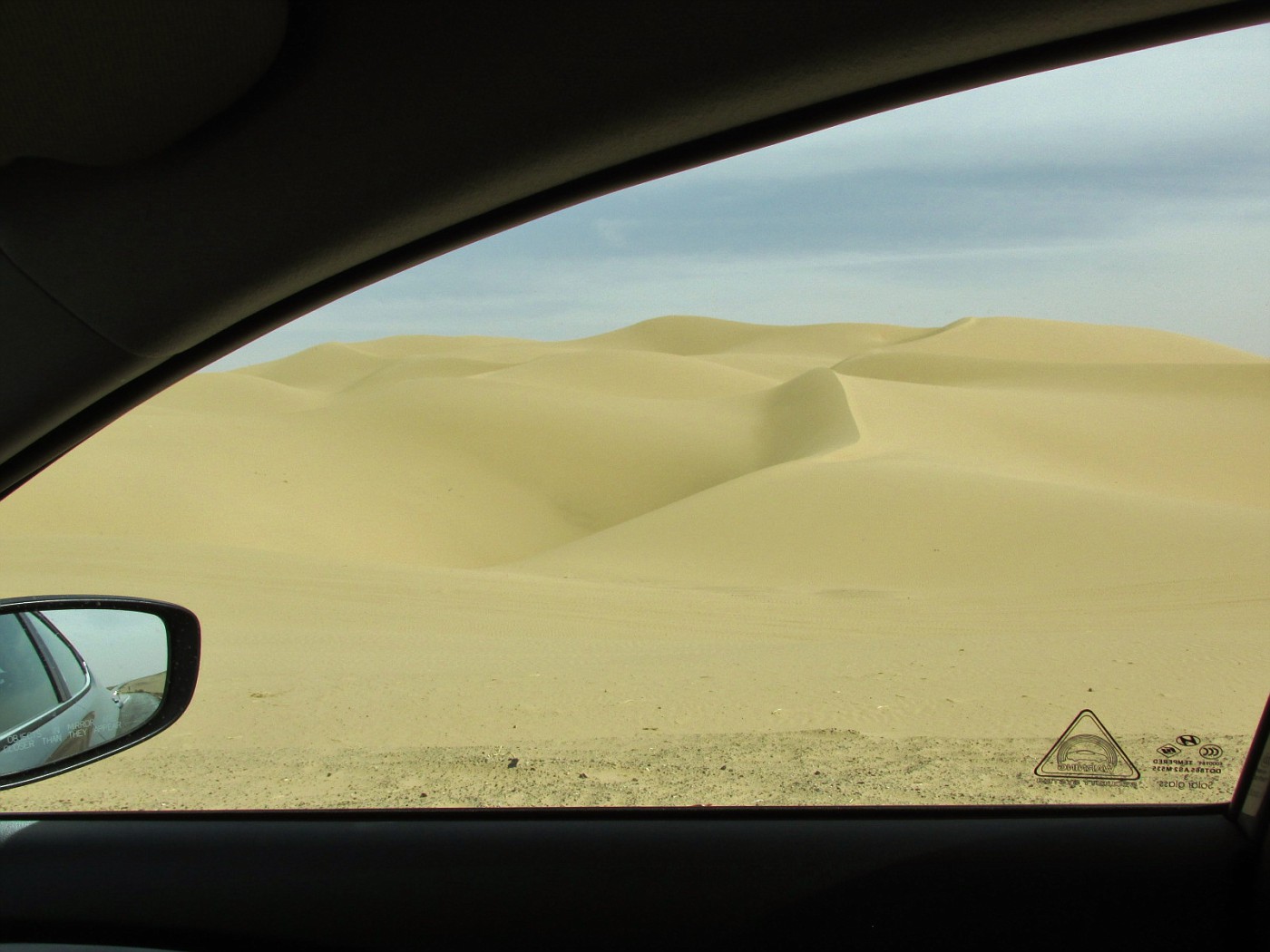
These are impressive dunes!
They are also a recreation area, so there are a lot of dune buggies out and about
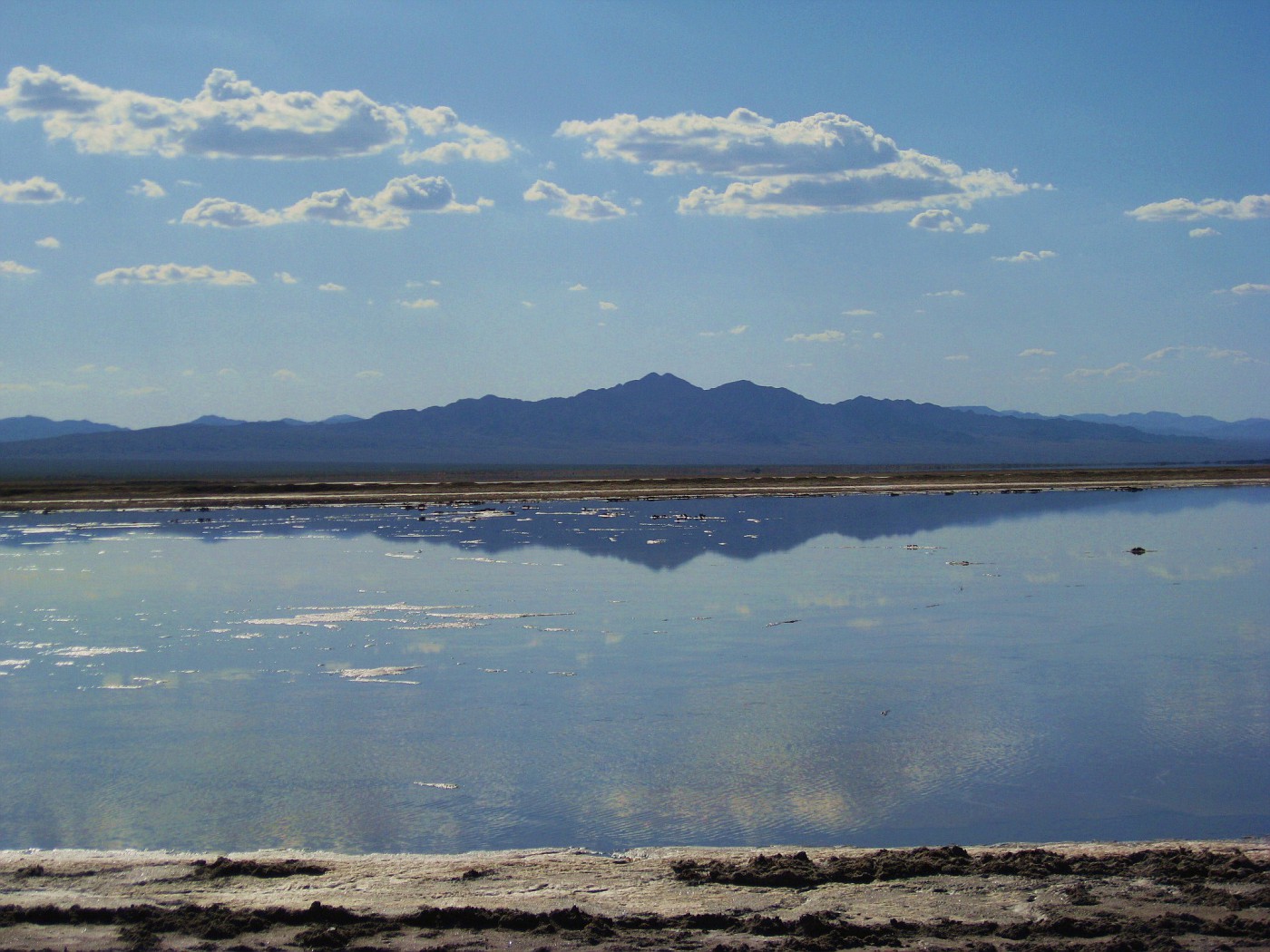
Bristol Lake just outside Amboy, CA
This lake is often dry. Salt is actively mined here.
ROUTE 66: Amboy, CA to Needles, CA
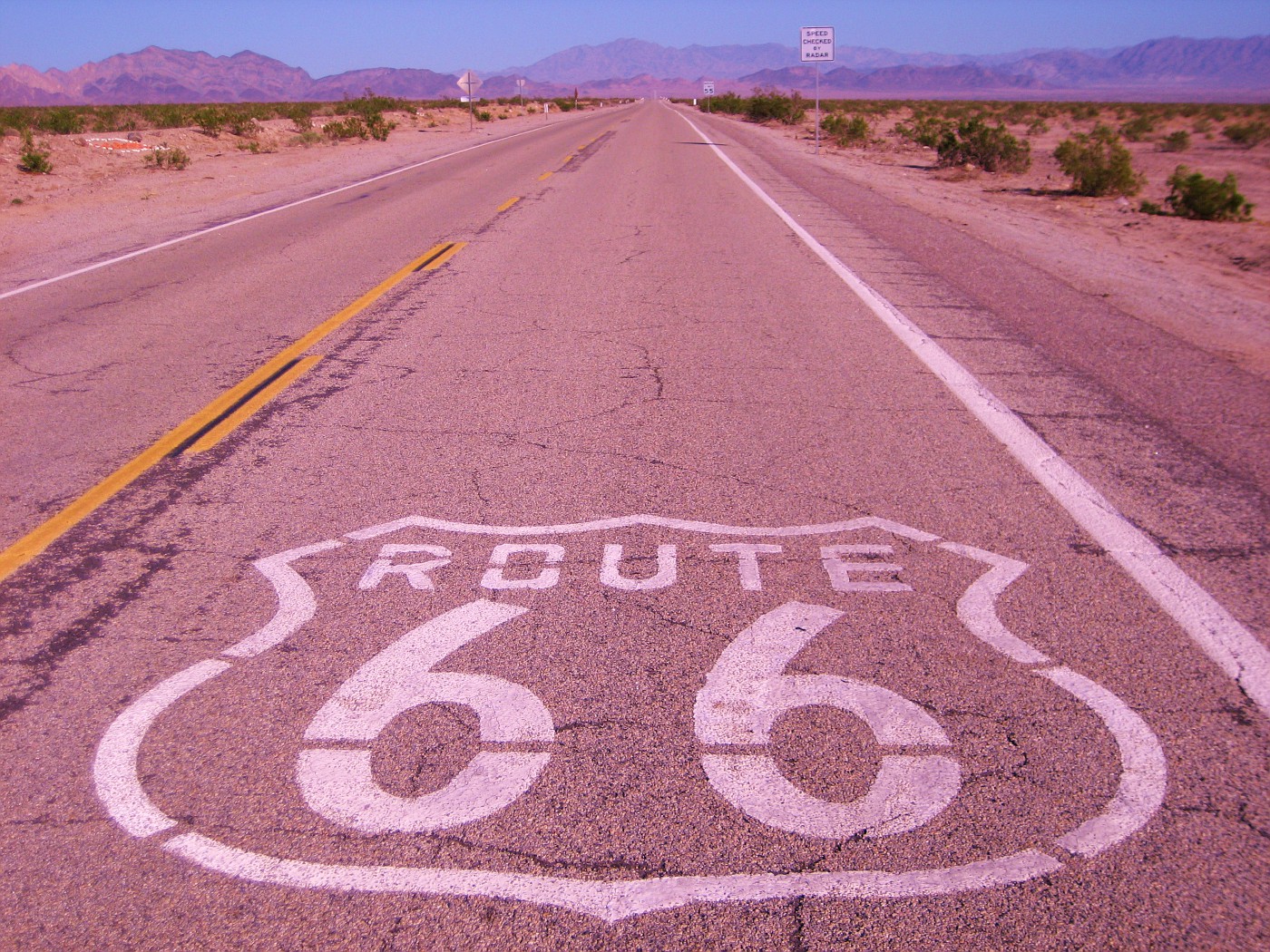
Get your kicks on Route 66!
This iconic image is stenciled on the roadway every few miles

Roy’s Motel & Cafe
Roy’s opened in 1938. In its heyday (the 1950s) it employed over 70 people.
The completion of Interstate 40 in 1972 effectively cut off Amboy from the main traffic flow in the region.
The motel has long since closed. Amboy’s population in 2003 was 7.
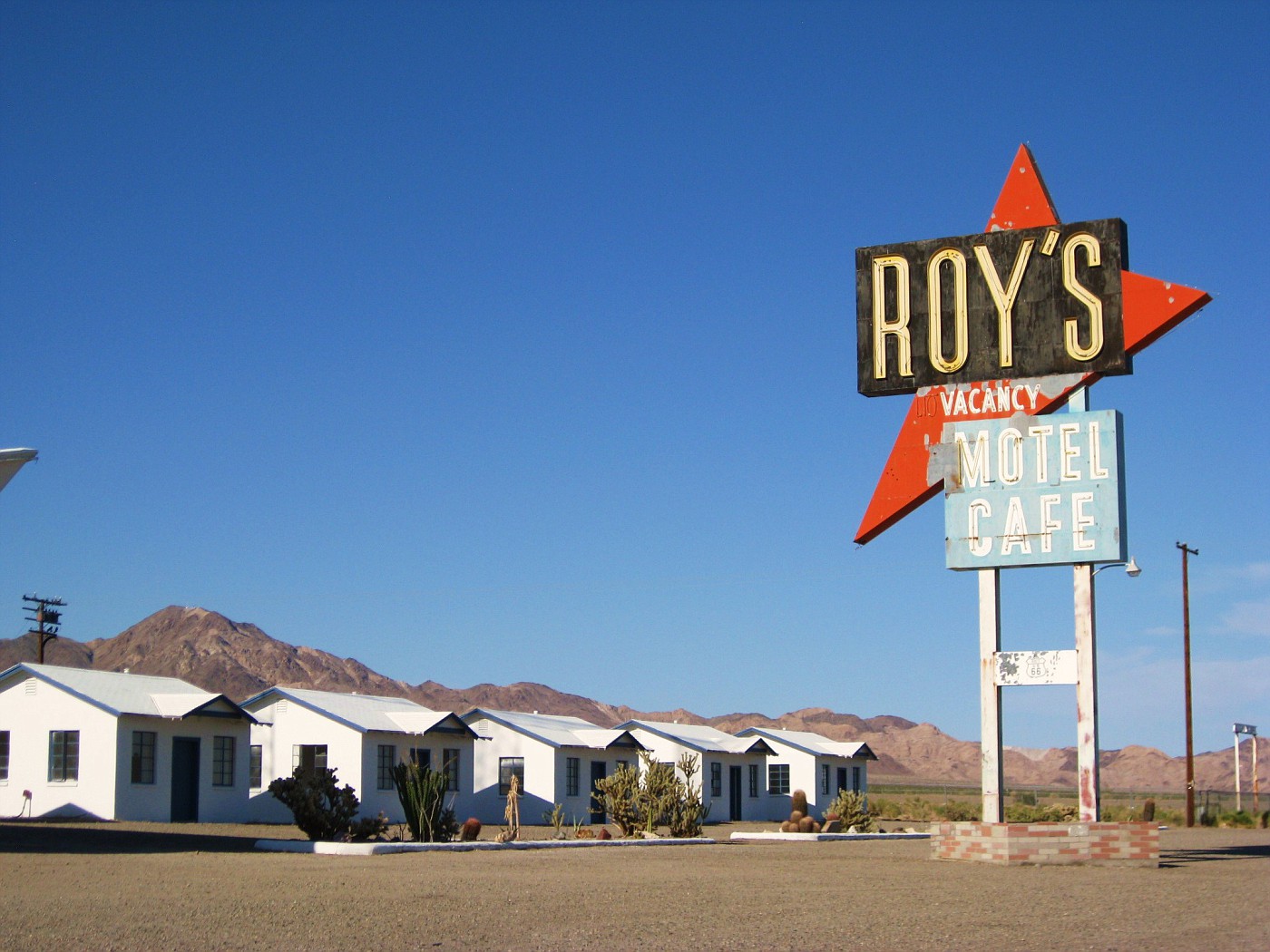
Roy’s Motel & Cafe
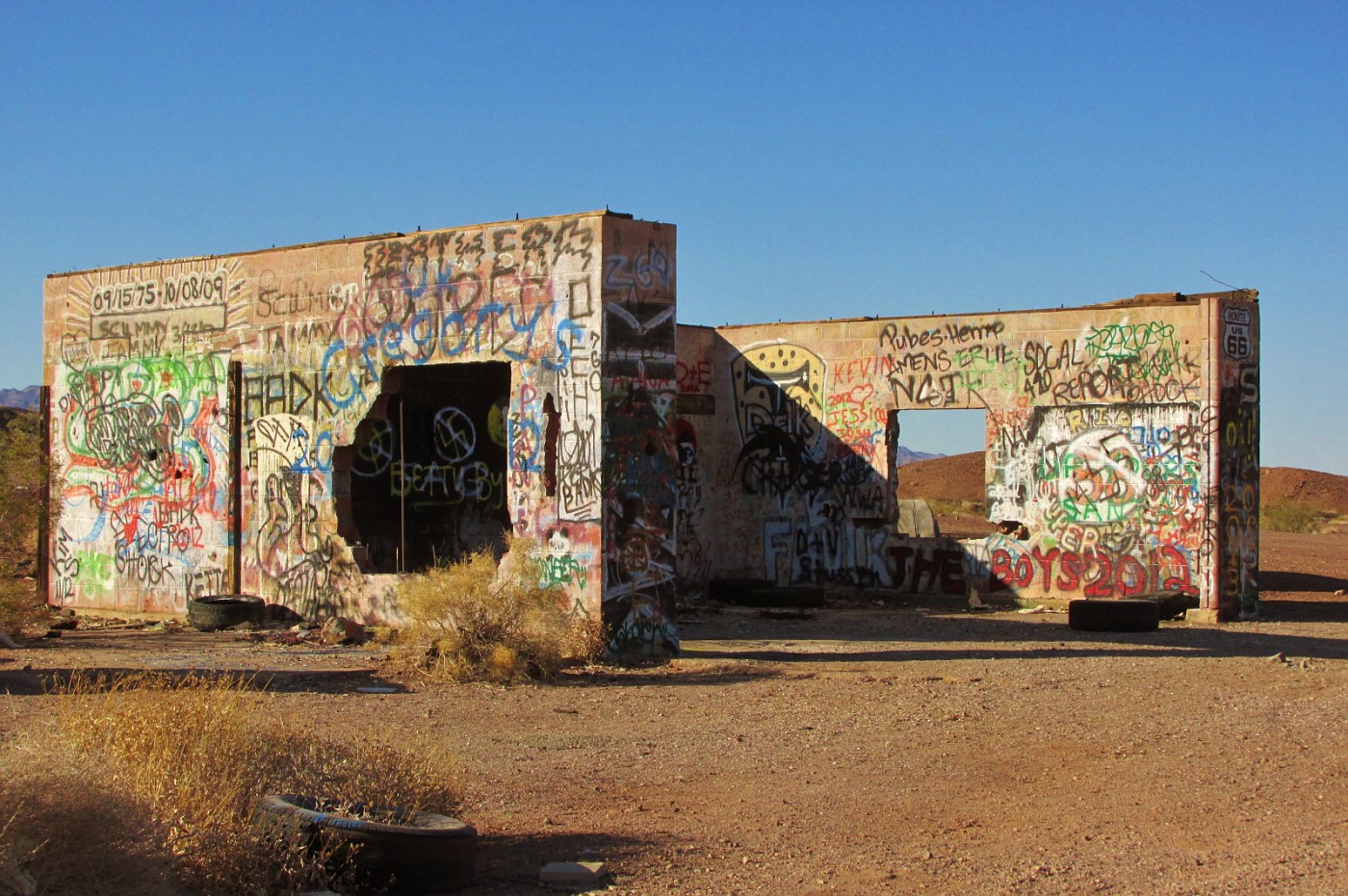
Colorful ruins east of Amboy
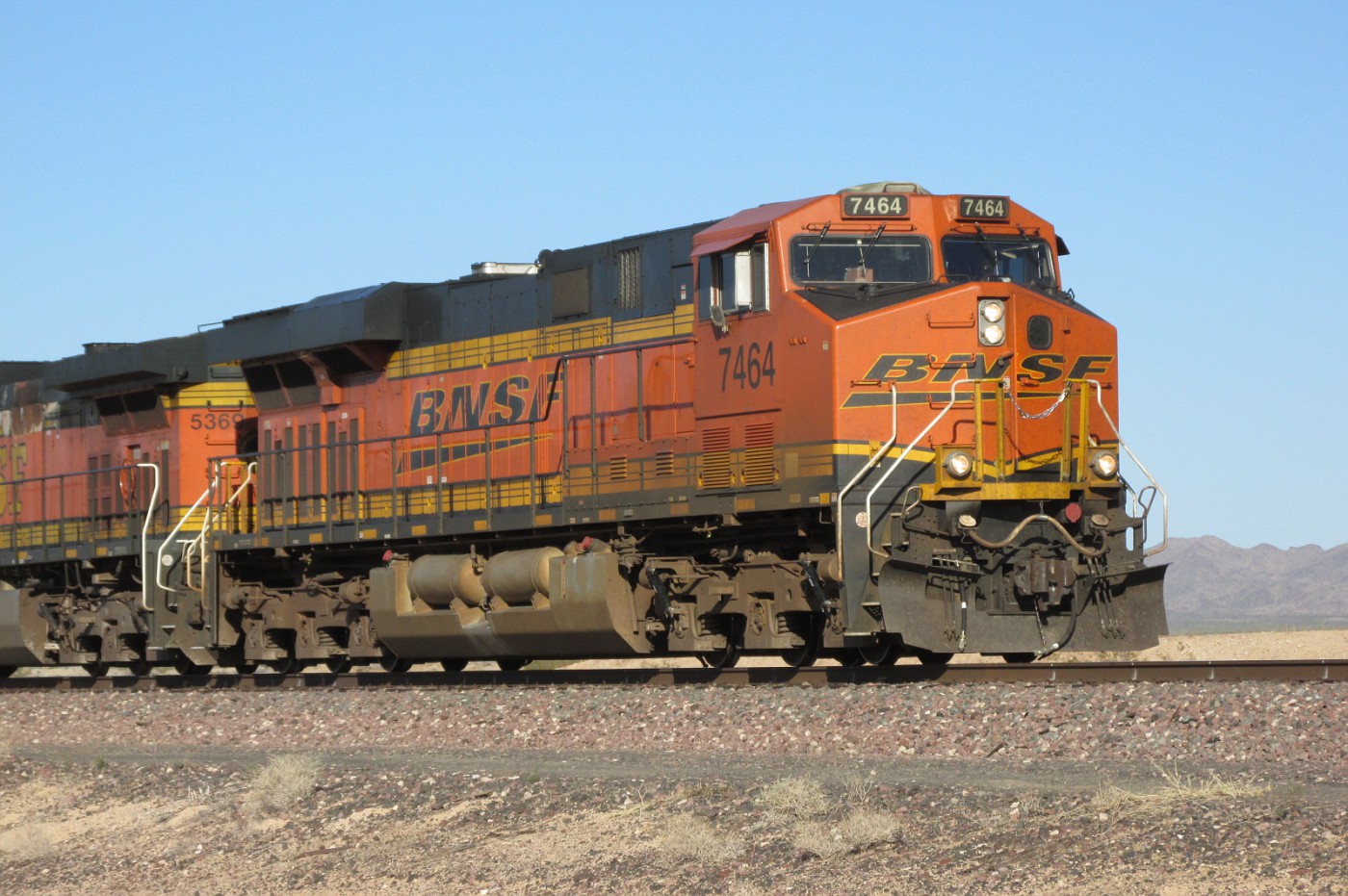
Train spotting on Goffs Road (Old Rt. 66)
The BNSF mainline runs through here. I once saw nine trains in an hour!
That’s a lot of traffic for being out in the middle of nowhere!
River Valley Inn – Needles, CA
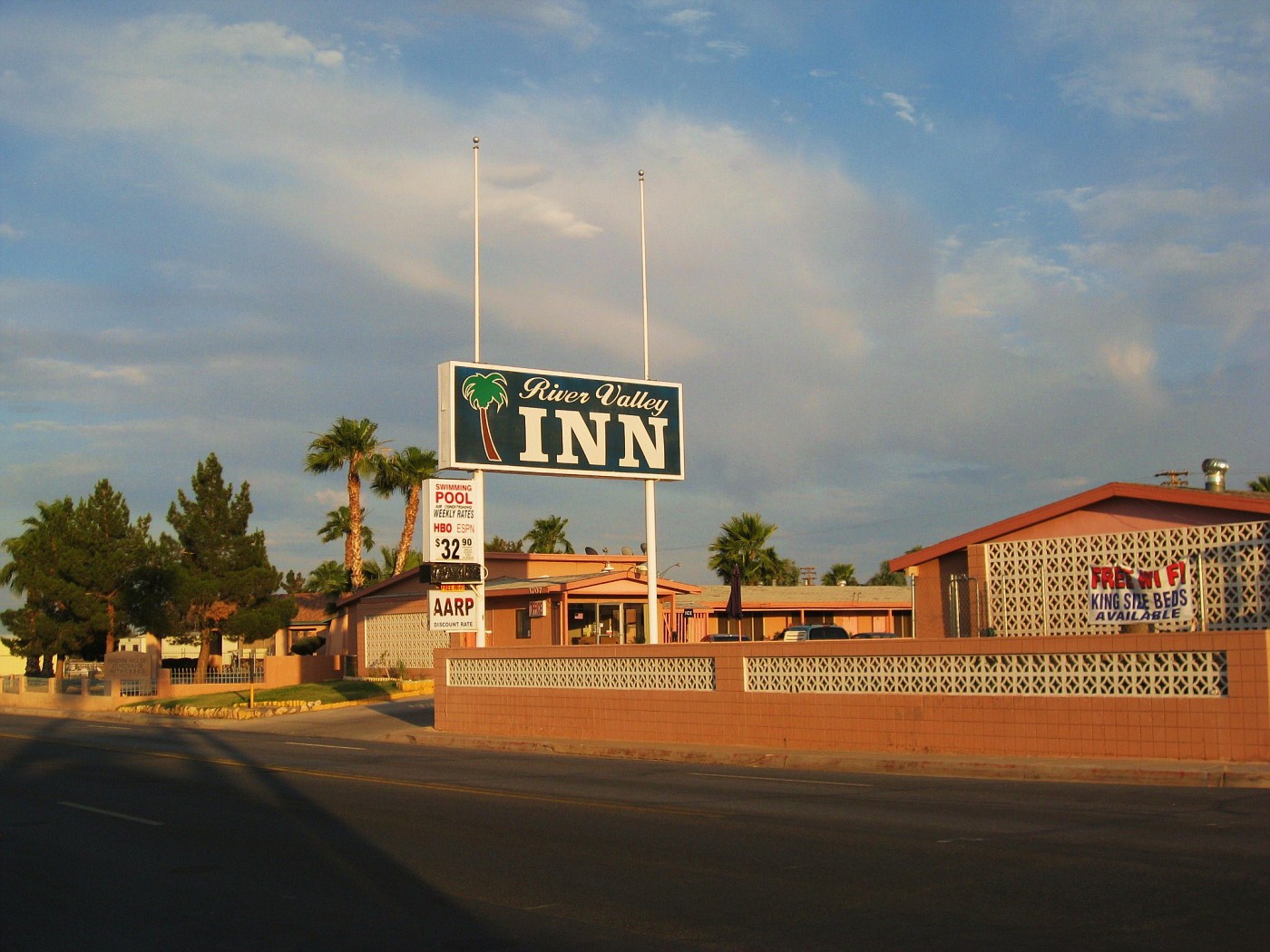
River Valley Inn
This is my favorite motel in all of the Mojave Desert
It was built in 1950 and has been well looked after.

After a long day of ripping around the Mojave, a nice cool swim really hits the spot!
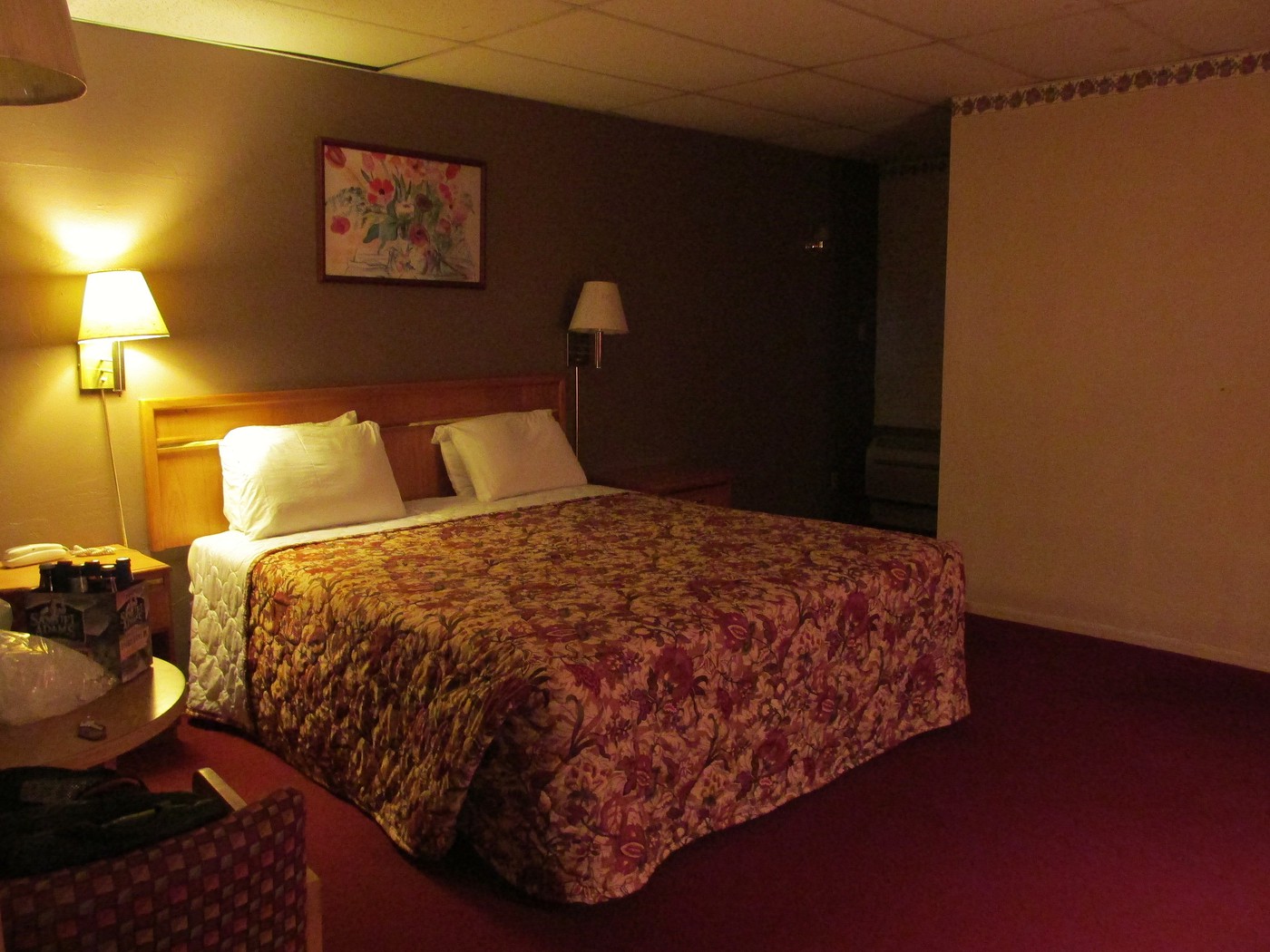
Comfortable accommodations at the River Valley Inn
The rooms are large and the air-conditioners are quiet and cool.
All rooms come with satellite TV, microwave and refrigerator
ROUTE 66: Needles, CA to Kingman, AZ

Route 66 winds through the desert south of Oatman, AZ
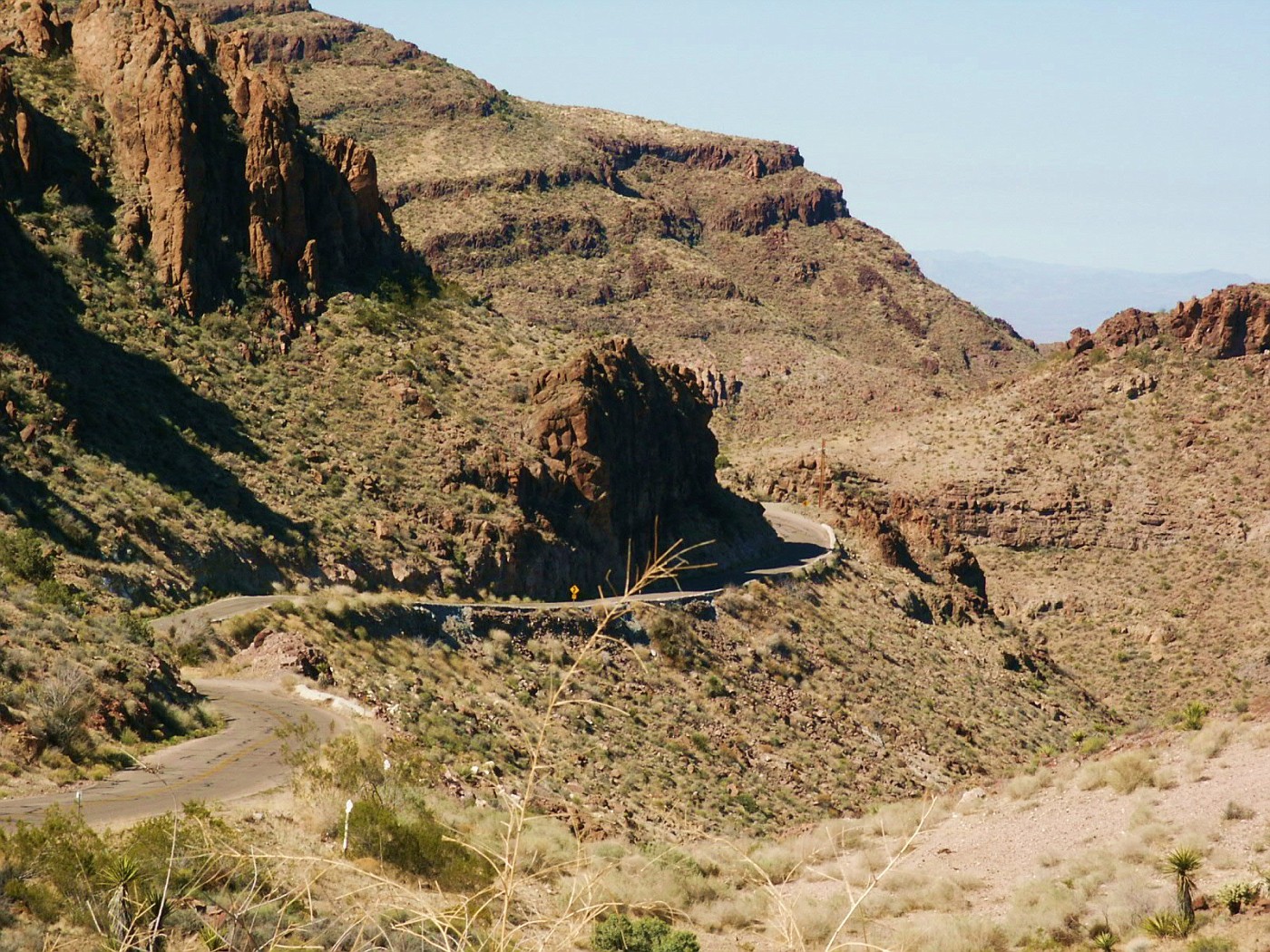
Climbing up Sitgreaves Pass
With its steep grades, narrow road and hairpin curves, Sitgreaves Pass was considered to be the
most challenging portion of Route 66. It was not uncommon for cars to overheat on the steep climb.
Summertime temperatures routinely soar above 100°. Make sure your water bag is filled!
This view is looking west into California from the summit.
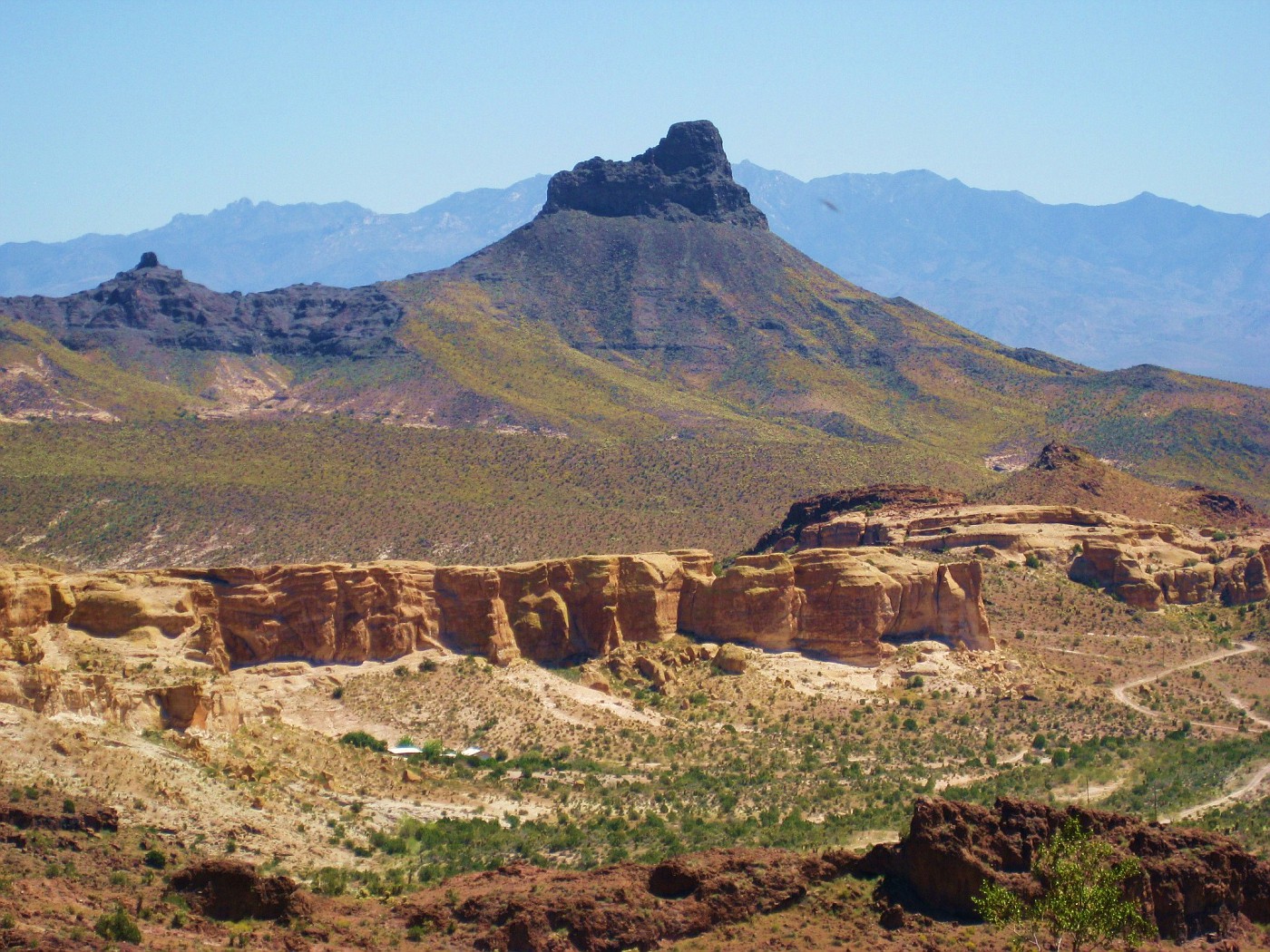
Descending Sitgreaves Pass
Looking east into Arizona. Kingman is 25 miles away.
Kingman, AZ Airliner Boneyard
Built at the start of WW II, the Kingman airport was originally called the Kingman Army Air Field. Its primary mission was training gunners for the B-17 Flying Fortress. After the war it was decommissioned and used to store, sell or scrap surplus war aircraft. Renamed Storage Depot No. 41, it is estimated that in 1945 and 1946 a total of about 5,500 airplanes were flown to Kingman for sale and disposal.
Known today as the Kingman Airport & Industrial Park, it is one of the six major southwestern airliner graveyards. I always make it a point to stop by whenever I’m in the area. Here are some of the planes I’ve seen over the years…
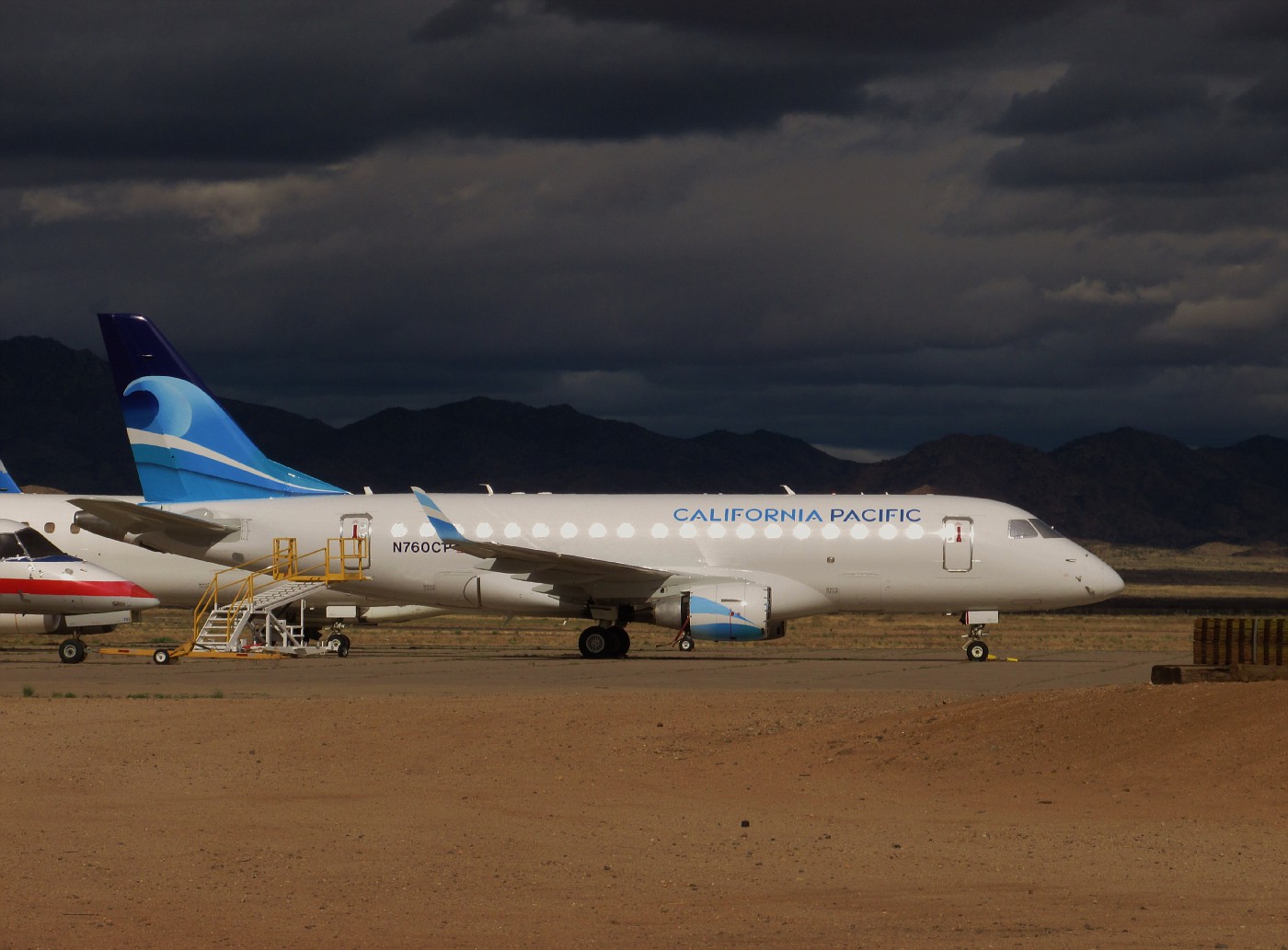
California Pacific Airlines Embraer 170
This airplane is being stored until California Pacific Airlines finally receives its FAA certification.
The airline plans offer regional service from Carlsbad, CA.
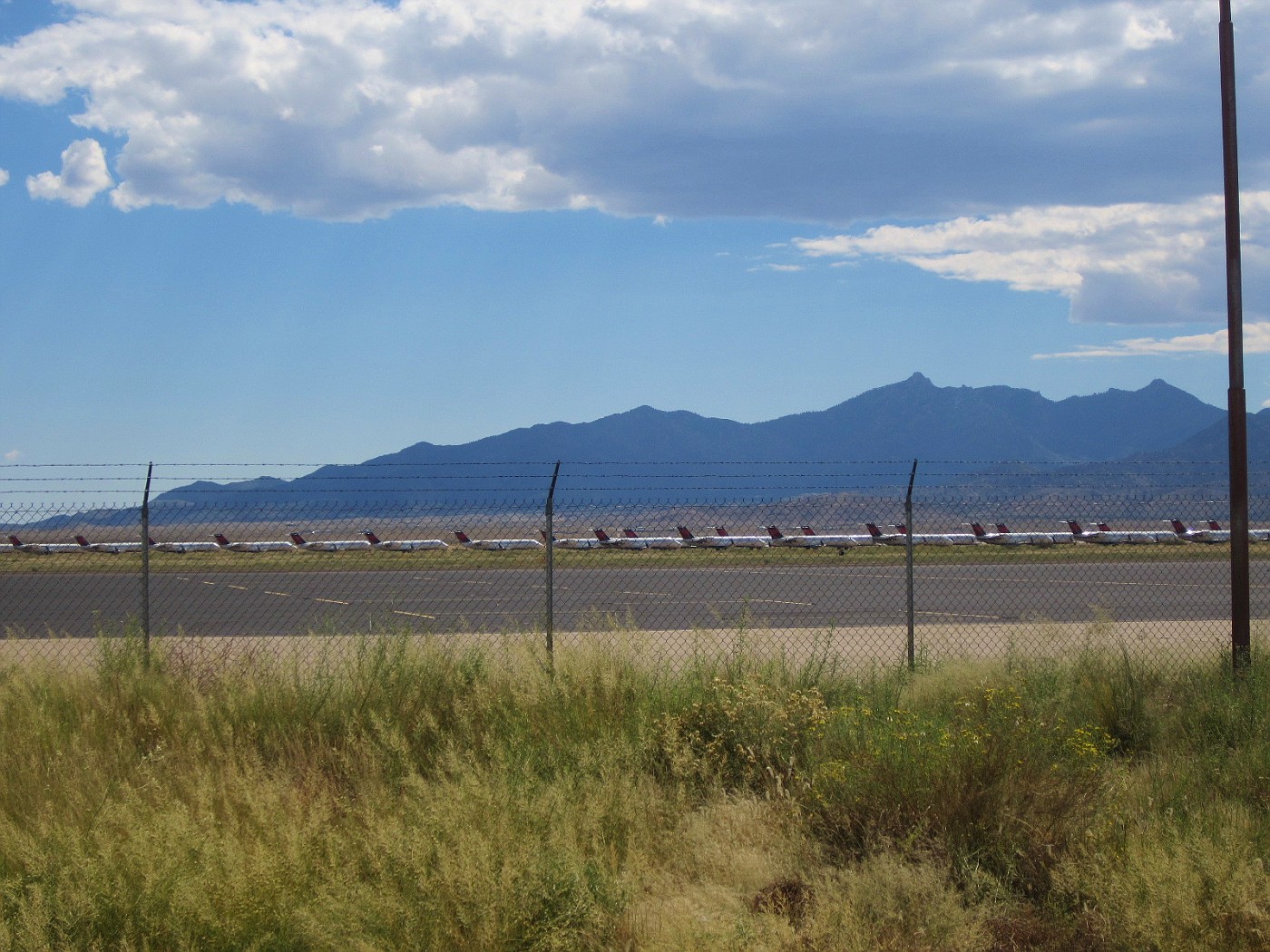
Ever wonder what happened to the Comair fleet of CRJs?
They’re all parked in Kingman awaiting new operators.
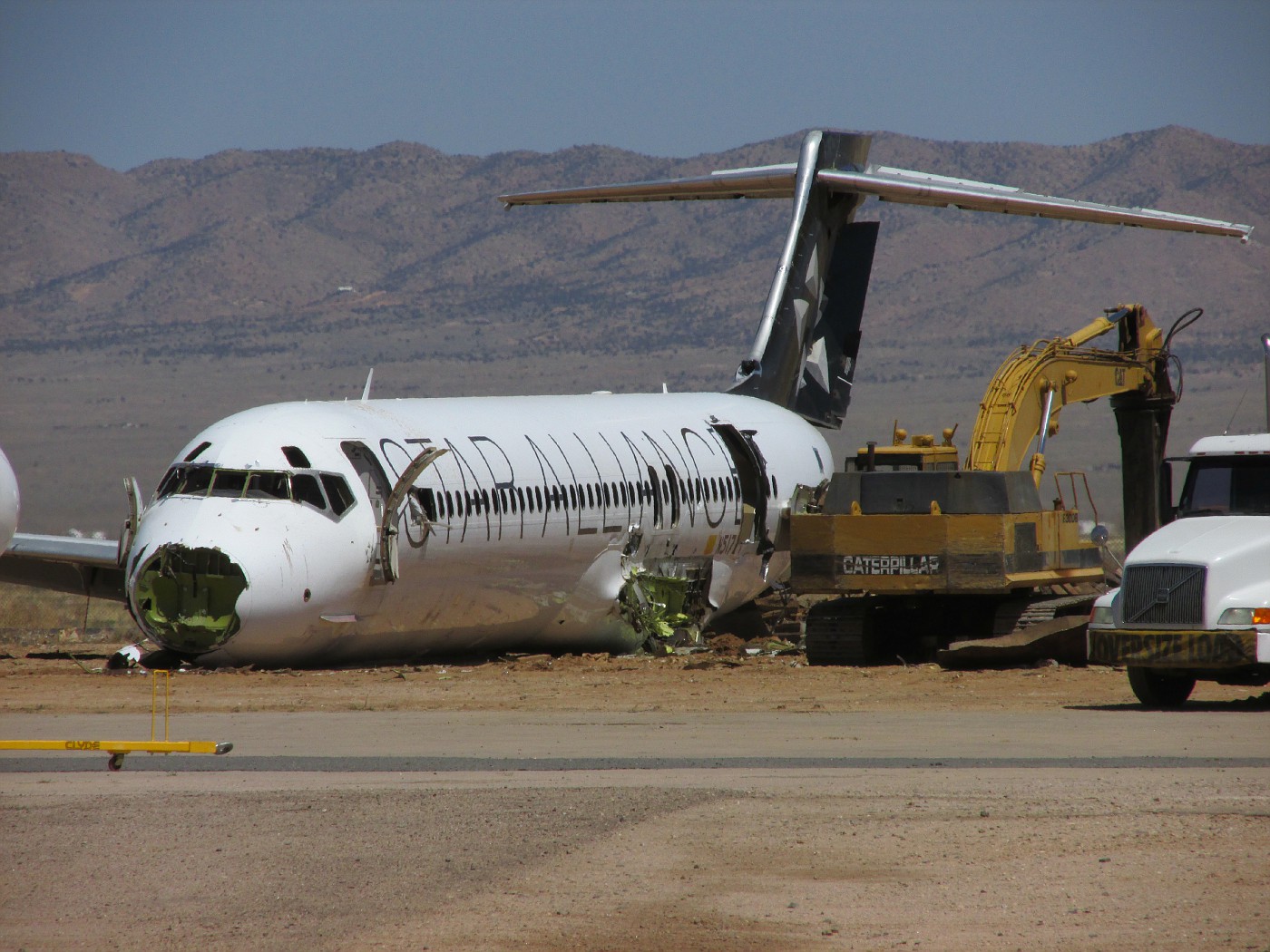
A sad sight as this ex-Spanair MD-87 meets the scrapper
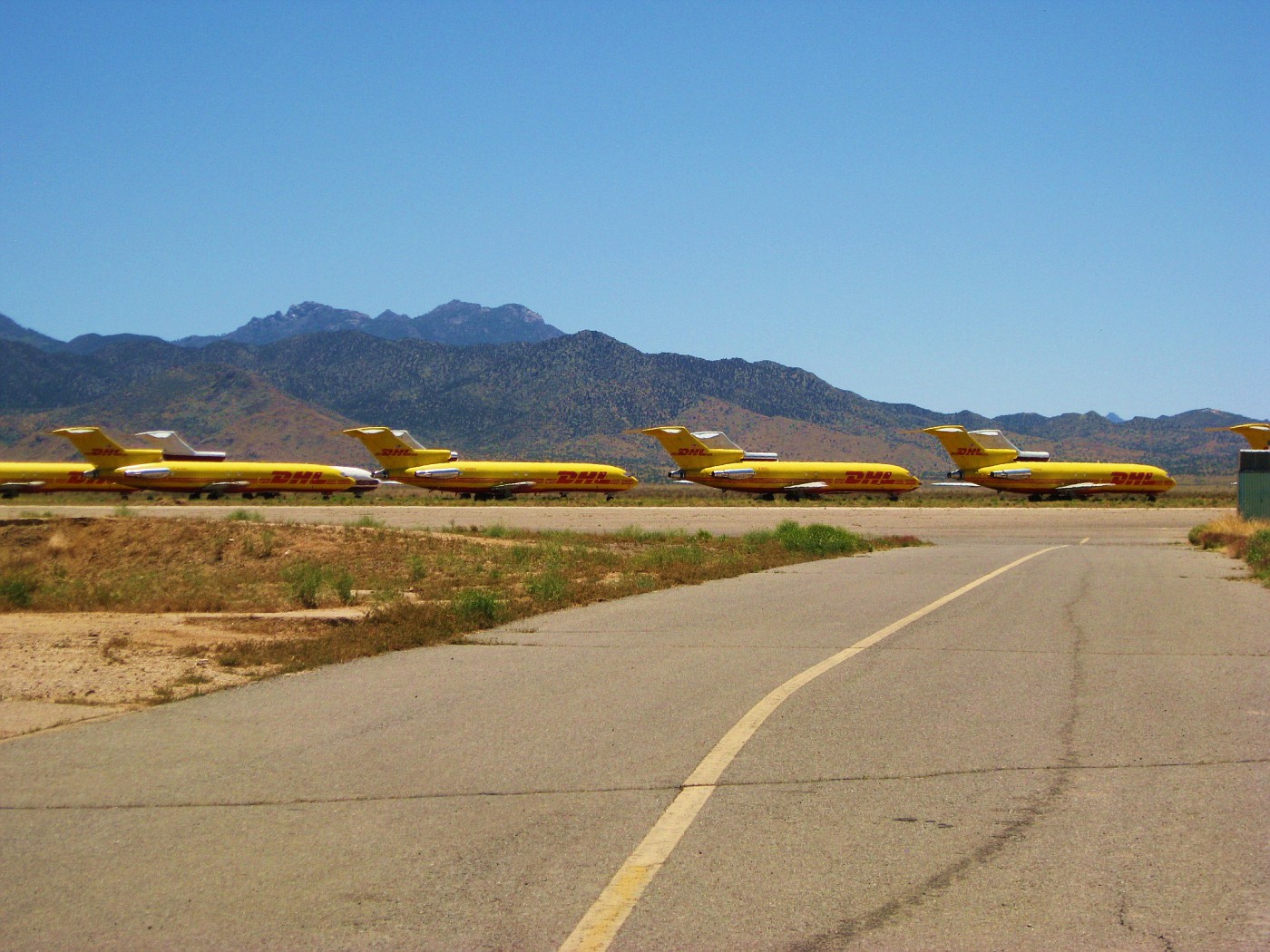
DHL 727-100s and -200s bake under a hot sun at Kingman
These airplanes have now all been scrapped
ROUTE 66: Kingman, AZ to Seligman, AZ
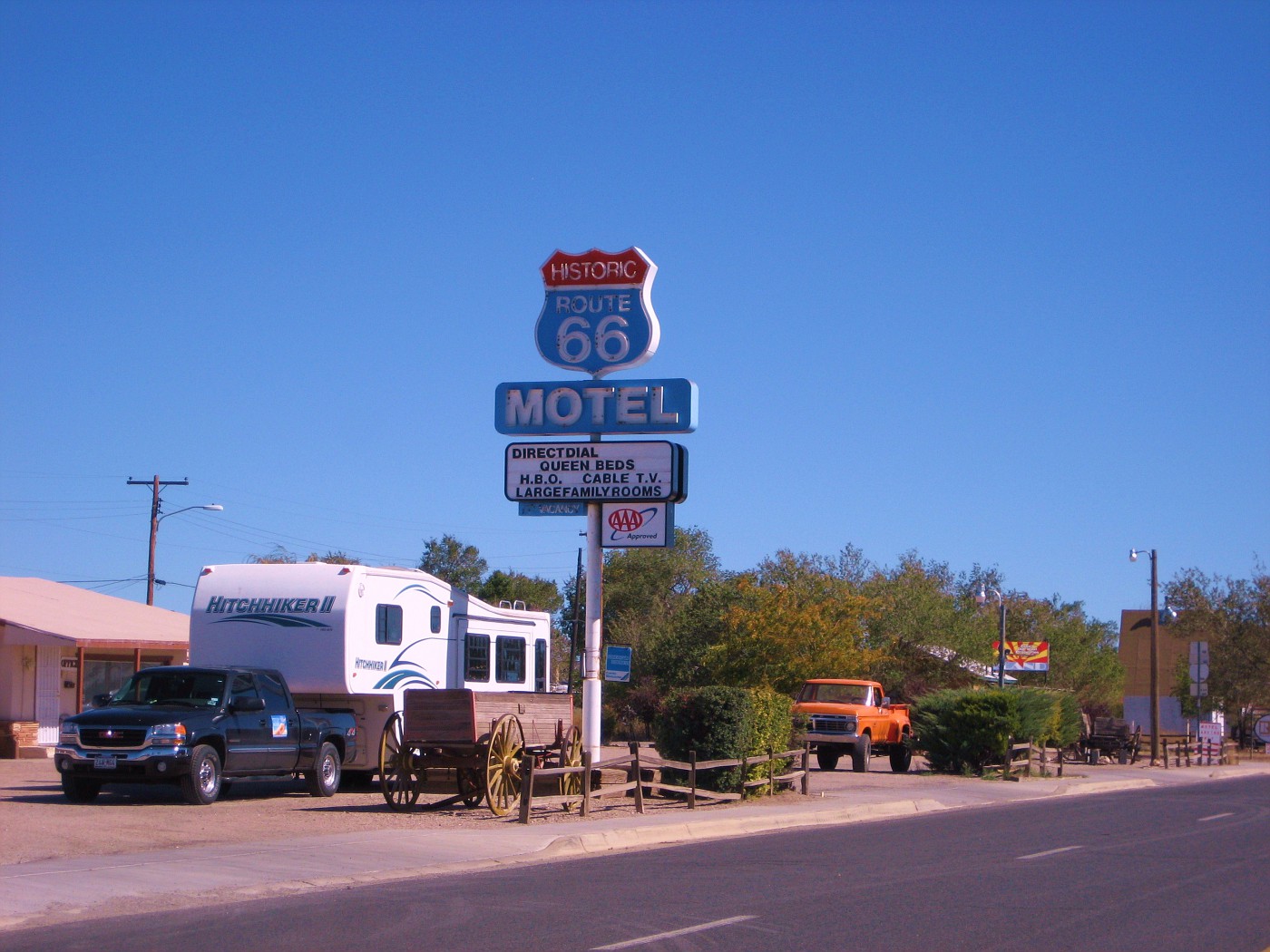
Lots of great neon signage along Route 66
The historic Route 66 Motel is located in Peach Springs, AZ
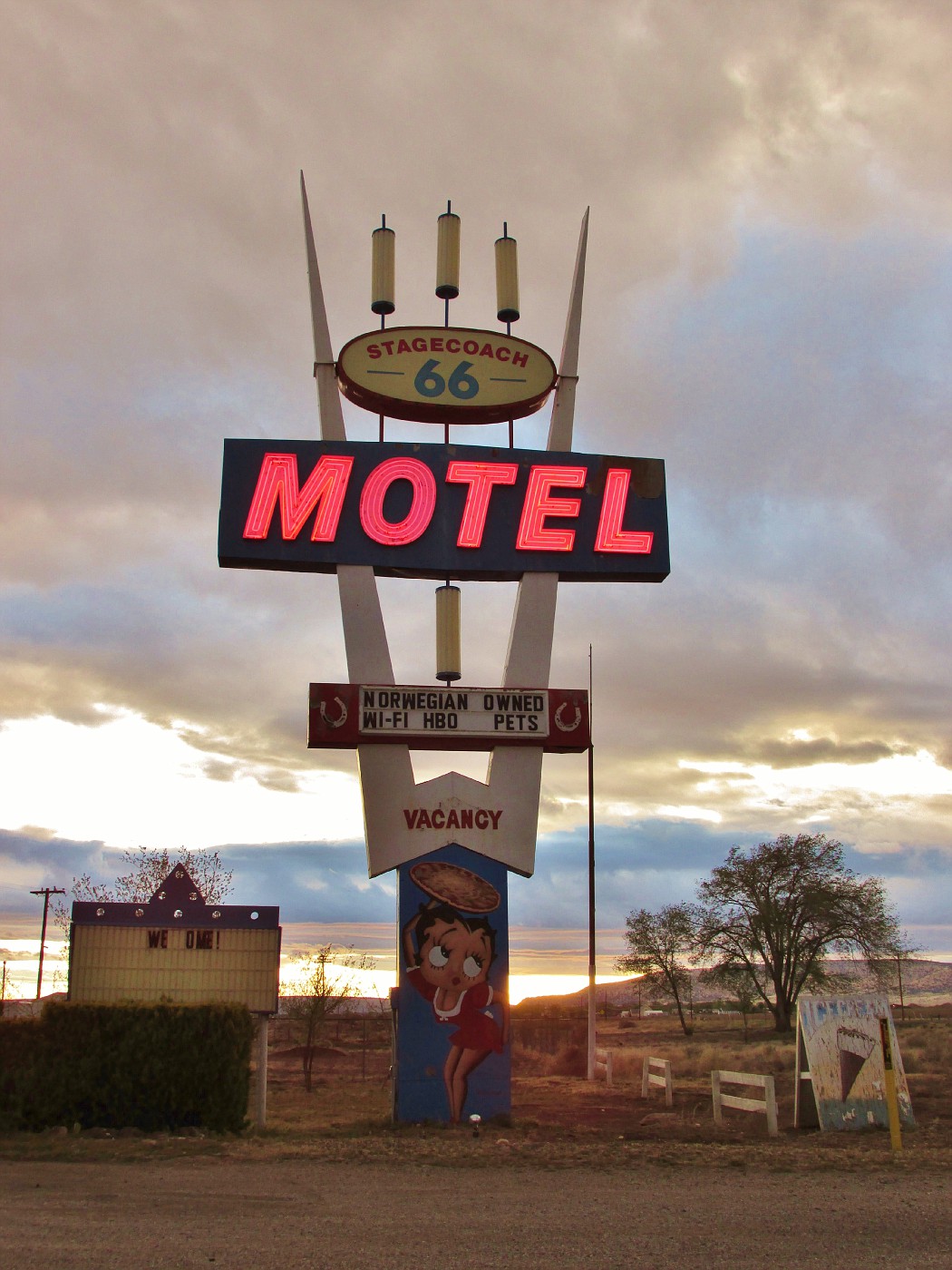
I stayed at this motel in Seligman, AZ
Note the sign indicating “Norwegian Owned”
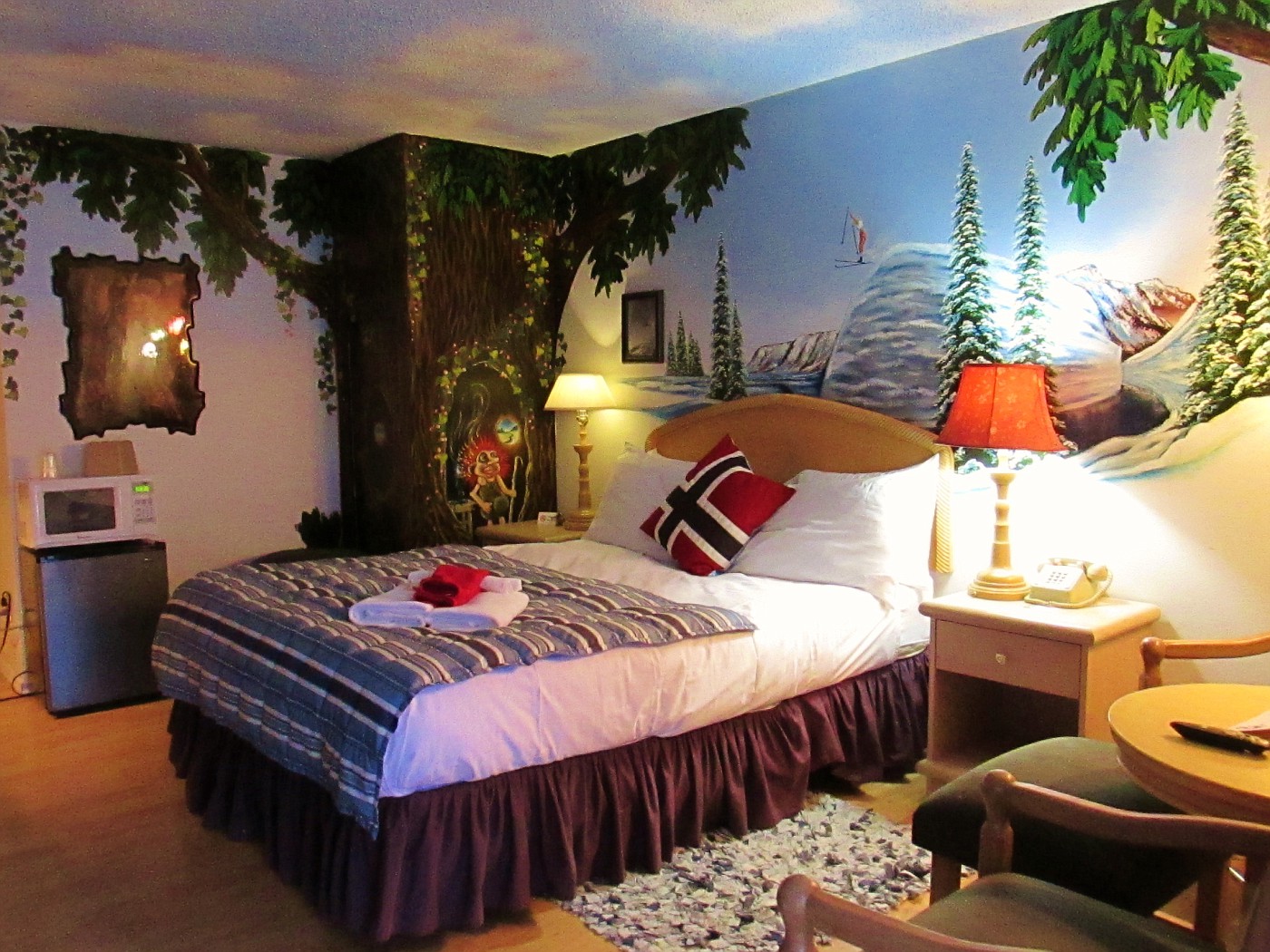
The “Norway Room” at the Stagecoach 66 Motel
This was quite a nice room for $50.00/night.
There’s a bar and pizza joint next door that was a lot of fun.
From Seligman it’s a short 45 mile drive east to Williams, Arizona - home to the Grand Canyon Railway. Williams is located 35 miles west of Flagstaff, Arizona. It’s situated right on the Santa Fe (now BNSF) mainline between Chicago and Los Angeles. Indeed, I rolled through here aboard Amtrak’s Southwest Chief just six days ago.
Back at the turn of the century, railroads played a huge role in promoting tourism in our national parks, many of which were inaccessible to automobiles at the time. They handled not only transport to the parks but often food and lodging within the parks as well. In Denali National Park where I work, the railroad arrived in 1922. It was not possible to drive from Anchorage or Fairbanks to Denali until 1957.
The tracks between Williams and the south rim of the Grand Canyon were completed in 1901 and passenger service started soon thereafter. The Grand Canyon didn’t become a park until 1919 and the area was largely unimproved with little more than tent camps set up along the route. By 1905 the Santa Fe Railway had completed construction of its flagship hotel, the El Tovar. It contracted the Fred Harvey Company, its longtime catering and hospitality partner, to manage that and other hotels and restaurants at the Grand Canyon. To this day the El Tovar remains the finest lodging available at the rim.
Passengers were not the only things transported along this line. Ranchers and timber companies provided plenty of revenue and the train also brought all water up to the Grand Canyon until 1926. After World War II, as automobiles became more popular and roads into the area became more numerous, ridership declined and the line was finally shut down in 1968.
It took another twenty-one years before a couple of progressively minded entrepreneurs once again recognized the value of providing train travel to the Grand Canyon. With increasing numbers of visitors from all over the world, overcrowding was beginning to impact the visitor experience. More cars, more traffic, more noise, more exhaust…
Consider the numbers… In 1968, 1.98 million people visited the Grand Canyon. By 1989 that total was up to 3.96 million. As of 2013 the Grand Canyon was our nation’s 2nd most visited National Park with 4.56 million visitors.
How ironic that this train which was once shut down due to the popularity of automobiles is now responsible for keeping approximately 50,000 cars per year outside of the Grand Canyon.
I’ve been aware of the Grand Canyon Railway for many years. I drive by their yards every time I’m on my way to Flagstaff and points north. After years of thinking I really ought to ride this train up to the Grand Canyon someday, I’ve finally pulled the trigger and purchased a round trip ticket. The railway offers six different classes of transport:
• Pullman
• Coach
• First Class
• Observation Dome
• Luxury Dome
• Luxury Parlor Car
I purchased Coach Class for the ride up to the park and Luxury Parlor Car Class for the ride back.
Alaska Airlines Seattle to San Diego 1115a – 156p 737-900 First Class
Grey clouds and a gentle rain were the order of the day in the Pacific Northwest, so it was with considerable anticipation that I looked forward to relocating down to sunny San Diego where a full sized rental car and a 1500 mile road trip awaited.
Coffee, yogurt and an apple got the morning off to a good start in the Alaska Airlines Boardroom. As a twenty year member of the Boardroom, I know the ladies who work there well as do they know me. Today was highlighted by a rare sighting of Leslie who’s often off enjoying the sun and surf of Maui. She’s like Boardroom royalty in my book though – always a pretty smile and a sunny disposition to greet her guests. It was good to see her again and we took a couple moments to catch up before the demands for her attention forced me to continue on into the Boardroom.
Boarding of my 737-900 was over on the North Satellite. United used to be the primary tenant at this facility but Alaska’s growth combined with United’s cutbacks to its Seattle operations have resulted in United’s relocation to the newer A concourse while Alaska has completely taken over the North Satellite. Unfortunately, United’s departure from the North Satellite also resulted in the closure of its lounge – the United Club, one of my favorite SEA lounges and locations. I go back to the days when that lounge was known as the Red Carpet Club and used to be located upstairs in a small room off gate N-9. About fifteen years ago it relocated to the old SAS First and Business Class lounge, located downstairs behind the escalators at train level. United did a great job with that lounge! For a room that had no windows, United managed to make it into a cozy, comfortable and welcoming cave – a great place to spend an hour or two before your flight. I miss it.
Unfortunately, there are no longer lounges of any stripe over on the North Satellite. By contrast, the South Satellite hosts three lounges (Delta’s Sky Club, BA’s Terraces and the Club International). Alaska claims to have plans to build a new facility up on top of the satellite, similar to Delta’s Sky Club over on the South Satellite. As of this writing however, it won’t be until 2018 before that lounge will be a reality. In the meantime word is that Alaska will open a temporary Boardroom sometime in the next year on the North Satellite but it’s anybody’s guess as to whether that’ll be the next three months or the final three months of the year. Until it opens, I am not a big fan of North Satellite departures.
Is anybody here old enough to remember those old Clairol hair coloring ads? Remember the jingle? “Hate those grays? Rinse them away!” For some reason that came to mind as we broke through the gloomy day gray beneath the cloud cover and zoomed into the bright sunny world above it. Ahh…
What’s that? Oh yes, a Bloody Mary would be fine, thanks.
Breakfast on today’s two hour and twenty minute flight down to San Diego was described as French Toast and Scrambled Eggs. While that sounded good in theory, the reality of it was a rounded puck of scrambled eggs and a deep fried half piece of French Toast. I can’t imagine anyone of French descent would be proud to have this version associated with their country. The eggs were topped with marinara sauce and accompanied by a sausage patty. It was an odd flavor combination to go with the “French” toast but being the omnivore that I am, I managed to wolf it all down along with a second helping of Bloody Mary.

French Toast and Scrambled Eggs
Upon arrival at San Diego’s old Terminal 1, I made my way outside and across to the rental car pick-up area. Thirty minutes later I was speeding east along Interstate 8 in a silver Hyundai Sonata with only 8000 miles on it. Sonatas have become downright ubiquitous amongst North American car rental companies. Thankfully I’ve come to rather like these cars. They’re decently sized, their seats are easy on my back and if you put good quality gas in them they’ll reward you with exceptional gas mileage.
Now when it comes to road trips, there’s no place I’d rather drive than the American West. Here’s that map again:

Roads I’ve Driven in my 1988 Mazda B2200
All of those roads were driven in my 1988 Mazda B2200 truck. I drove that truck for twenty-one years, putting 493,000 miles on three different engines, but just the one transmission. I kept the map because it was fun to see where I’d been, but at the same time when you’ve covered as much territory as I have that map was also helpful in showing me where I hadn’t been. From 1988 to 2005, I drove my little blue truck through all forty-nine contiguous states as well as most of Western Canada. In the western United States (from Montana down through Wyoming and Colorado to New Mexico and everywhere west), I’ve driven over 80% of all the state and federal highways. And that’s not even counting roads I traveled in my vehicles prior to 1988 or since 2009.
A few years ago, I met an 84-year-old man who claimed to have been in all but four counties in the United States. Four counties! There must be two hundred counties between the Dakotas and Nebraska alone! I was impressed.
Sometime later, I took a look at my roadmap with the idea of seeing just how many counties in the Western United States I’d been to. I’ve neither the time nor the inclination to see every county in America, but the West is where I’ve done most of my driving and frankly, that’s where my real interest lies.
To make a long story shorter, there were nine counties in the Western U.S. that I’d not yet driven through. Six of them were in Eastern Montana, two were in New Mexico and one in Idaho. Neither I nor my truck were getting any younger, so in 2005 I drove down to the lower 48 and knocked them off. In the process I got to see and visit a lot of cool places I’d likely not have driven otherwise. Places like Fort Benton, Montana – the end of the line for riverboats on the Missouri River. Or Lovington, New Mexico – the home of Chicago Bears linebacker Brian Urlacher. Being a fan of the Denver Broncos, I stopped for lunch in a local café before continuing on to Carlsbad Caverns National Park.
Getting back to this trip, driving is very relaxing for me. I love the pace of the scenery going by and I enjoy the physical act of driving. Unlike most guys, speed has nothing to do with it. If I were to win a Maserati tomorrow, I’d immediately trade it in for a something more practical, like my truck. Or a 1975 Cadillac Eldorado convertible. Now there’s a proper car for me to cruise across the country in!
I particularly enjoy driving through the Desert Southwest. Whereas some people are intimidated by the expansive desolation of the desert – not to mention the climate – I am attracted to it. My favorite desert is the Mojave, which occupies more than 25,000 square miles of southeastern California with portions of it extending into Nevada, Arizona and Utah. It is home to Death Valley and Joshua Tree National Parks as well as the 1.4 million acre Mojave National Preserve – my favorite of the three. Although I don’t log drives like I do flights, if I did I would guess that I’ve driven over 50000 miles around the Mojave.
My favorite road across the Mojave is Route 66 – the Mother Road. Route 66 like an old friend to me. I love the old 1940s and 50s era cafes and motels that populate the small towns it runs through. I also love the old look and feel of the road. With the exception of business districts through larger towns like Kingman, Arizona, Route 66 is a two lane road throughout the Southwest. On this trip I’ll drive it from Amboy, California to Seligman, Arizona. So buckle your seatbelts and let’s go!
Rather than give you a mile by mile travelogue, I thought I’d present most of this drive through pictures. The captions will give a bit more information…
San Diego, CA to Amboy, CA

Driving California Highway 78 through the Imperial Sand Dunes

These are impressive dunes!
They are also a recreation area, so there are a lot of dune buggies out and about

Bristol Lake just outside Amboy, CA
This lake is often dry. Salt is actively mined here.
ROUTE 66: Amboy, CA to Needles, CA

Get your kicks on Route 66!
This iconic image is stenciled on the roadway every few miles

Roy’s Motel & Cafe
Roy’s opened in 1938. In its heyday (the 1950s) it employed over 70 people.
The completion of Interstate 40 in 1972 effectively cut off Amboy from the main traffic flow in the region.
The motel has long since closed. Amboy’s population in 2003 was 7.

Roy’s Motel & Cafe

Colorful ruins east of Amboy

Train spotting on Goffs Road (Old Rt. 66)
The BNSF mainline runs through here. I once saw nine trains in an hour!
That’s a lot of traffic for being out in the middle of nowhere!
River Valley Inn – Needles, CA

River Valley Inn
This is my favorite motel in all of the Mojave Desert
It was built in 1950 and has been well looked after.

After a long day of ripping around the Mojave, a nice cool swim really hits the spot!

Comfortable accommodations at the River Valley Inn
The rooms are large and the air-conditioners are quiet and cool.
All rooms come with satellite TV, microwave and refrigerator
ROUTE 66: Needles, CA to Kingman, AZ

Route 66 winds through the desert south of Oatman, AZ

Climbing up Sitgreaves Pass
With its steep grades, narrow road and hairpin curves, Sitgreaves Pass was considered to be the
most challenging portion of Route 66. It was not uncommon for cars to overheat on the steep climb.
Summertime temperatures routinely soar above 100°. Make sure your water bag is filled!
This view is looking west into California from the summit.

Descending Sitgreaves Pass
Looking east into Arizona. Kingman is 25 miles away.
Kingman, AZ Airliner Boneyard
Built at the start of WW II, the Kingman airport was originally called the Kingman Army Air Field. Its primary mission was training gunners for the B-17 Flying Fortress. After the war it was decommissioned and used to store, sell or scrap surplus war aircraft. Renamed Storage Depot No. 41, it is estimated that in 1945 and 1946 a total of about 5,500 airplanes were flown to Kingman for sale and disposal.
Known today as the Kingman Airport & Industrial Park, it is one of the six major southwestern airliner graveyards. I always make it a point to stop by whenever I’m in the area. Here are some of the planes I’ve seen over the years…

California Pacific Airlines Embraer 170
This airplane is being stored until California Pacific Airlines finally receives its FAA certification.
The airline plans offer regional service from Carlsbad, CA.

Ever wonder what happened to the Comair fleet of CRJs?
They’re all parked in Kingman awaiting new operators.

A sad sight as this ex-Spanair MD-87 meets the scrapper

DHL 727-100s and -200s bake under a hot sun at Kingman
These airplanes have now all been scrapped
ROUTE 66: Kingman, AZ to Seligman, AZ

Lots of great neon signage along Route 66
The historic Route 66 Motel is located in Peach Springs, AZ

I stayed at this motel in Seligman, AZ
Note the sign indicating “Norwegian Owned”

The “Norway Room” at the Stagecoach 66 Motel
This was quite a nice room for $50.00/night.
There’s a bar and pizza joint next door that was a lot of fun.
From Seligman it’s a short 45 mile drive east to Williams, Arizona - home to the Grand Canyon Railway. Williams is located 35 miles west of Flagstaff, Arizona. It’s situated right on the Santa Fe (now BNSF) mainline between Chicago and Los Angeles. Indeed, I rolled through here aboard Amtrak’s Southwest Chief just six days ago.
Back at the turn of the century, railroads played a huge role in promoting tourism in our national parks, many of which were inaccessible to automobiles at the time. They handled not only transport to the parks but often food and lodging within the parks as well. In Denali National Park where I work, the railroad arrived in 1922. It was not possible to drive from Anchorage or Fairbanks to Denali until 1957.
The tracks between Williams and the south rim of the Grand Canyon were completed in 1901 and passenger service started soon thereafter. The Grand Canyon didn’t become a park until 1919 and the area was largely unimproved with little more than tent camps set up along the route. By 1905 the Santa Fe Railway had completed construction of its flagship hotel, the El Tovar. It contracted the Fred Harvey Company, its longtime catering and hospitality partner, to manage that and other hotels and restaurants at the Grand Canyon. To this day the El Tovar remains the finest lodging available at the rim.
Passengers were not the only things transported along this line. Ranchers and timber companies provided plenty of revenue and the train also brought all water up to the Grand Canyon until 1926. After World War II, as automobiles became more popular and roads into the area became more numerous, ridership declined and the line was finally shut down in 1968.
It took another twenty-one years before a couple of progressively minded entrepreneurs once again recognized the value of providing train travel to the Grand Canyon. With increasing numbers of visitors from all over the world, overcrowding was beginning to impact the visitor experience. More cars, more traffic, more noise, more exhaust…
Consider the numbers… In 1968, 1.98 million people visited the Grand Canyon. By 1989 that total was up to 3.96 million. As of 2013 the Grand Canyon was our nation’s 2nd most visited National Park with 4.56 million visitors.
How ironic that this train which was once shut down due to the popularity of automobiles is now responsible for keeping approximately 50,000 cars per year outside of the Grand Canyon.
I’ve been aware of the Grand Canyon Railway for many years. I drive by their yards every time I’m on my way to Flagstaff and points north. After years of thinking I really ought to ride this train up to the Grand Canyon someday, I’ve finally pulled the trigger and purchased a round trip ticket. The railway offers six different classes of transport:
• Pullman
• Coach
• First Class
• Observation Dome
• Luxury Dome
• Luxury Parlor Car
I purchased Coach Class for the ride up to the park and Luxury Parlor Car Class for the ride back.
Last edited by Seat 2A; Jan 1, 2015 at 5:50 pm
#10
FlyerTalk Evangelist
Original Poster
Join Date: Apr 2001
Location: East Ester, Alaska
Programs: Alaska Million Miler, United Million Miler, Wyndham Rewards Diamond, Choice Hotels Diamond
Posts: 12,148
Day Thirteen
Grand Canyon Railway South Rim to Williams, AZ 3:30p – 5:45pm Luxury Parlor Car
Since I’m traveling back and forth over the same tracks, I’m going to start my description of this trip up at the El Tovar Hotel. We’ll have lunch in the Arizona Dining Room and then head down to the station to board our luxury parlor car for the two and a half hour ride down to Williams. But first, let’s walk over to the edge and check out the view of the Grand Canyon. Awesome!
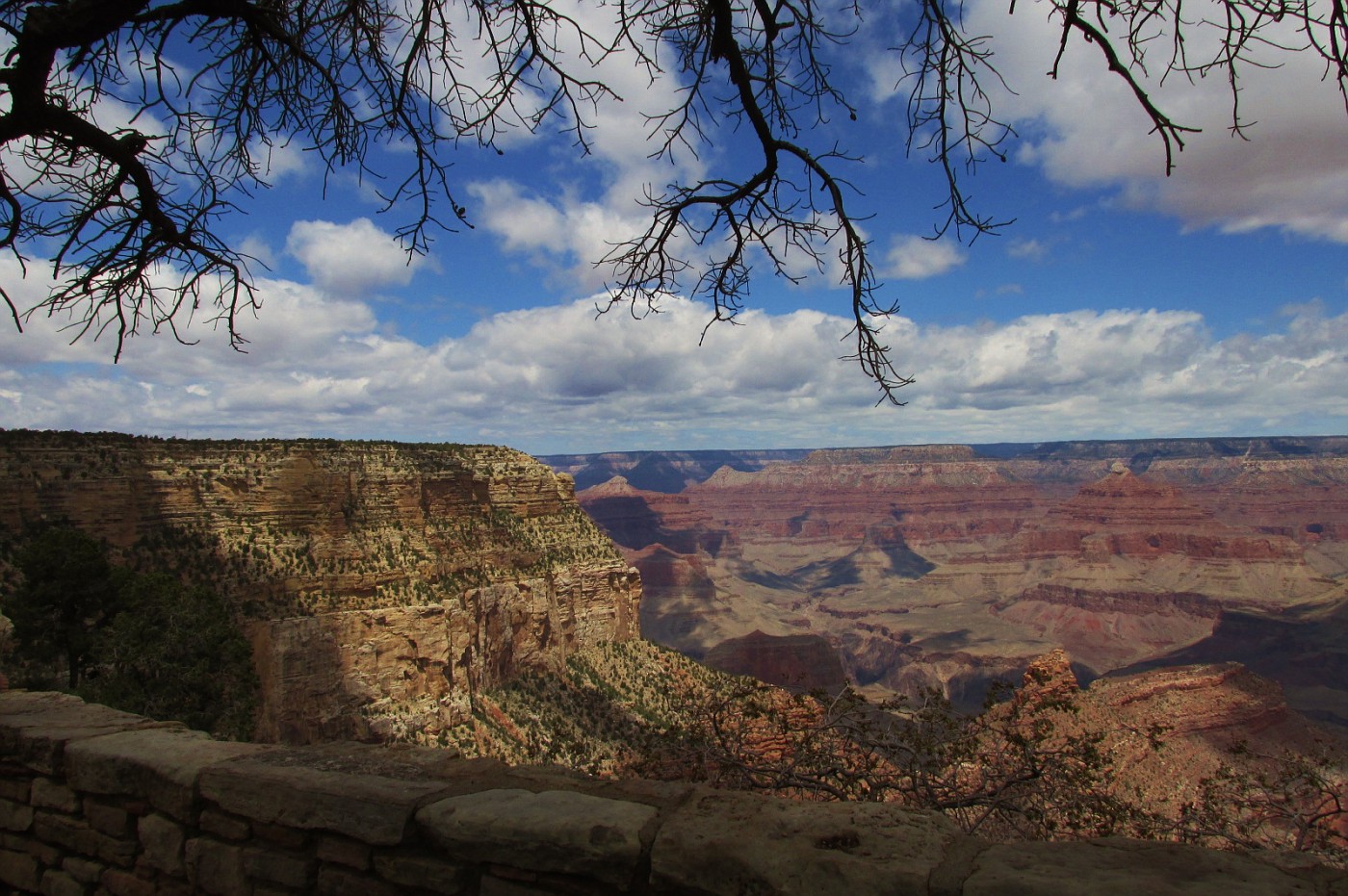
The view from El Tovar – Looking left

The view from El Tovar – Looking right
The main lobby of the El Tovar is a fusion of Swiss Chalet design and colorful Southwestern furnishings. I shielded my eyes and continued straight into the attractive wood and stone dining room where I was warmly greeted and seated at a four top table that provided nice views of the hotel lawn and the canyon beyond.
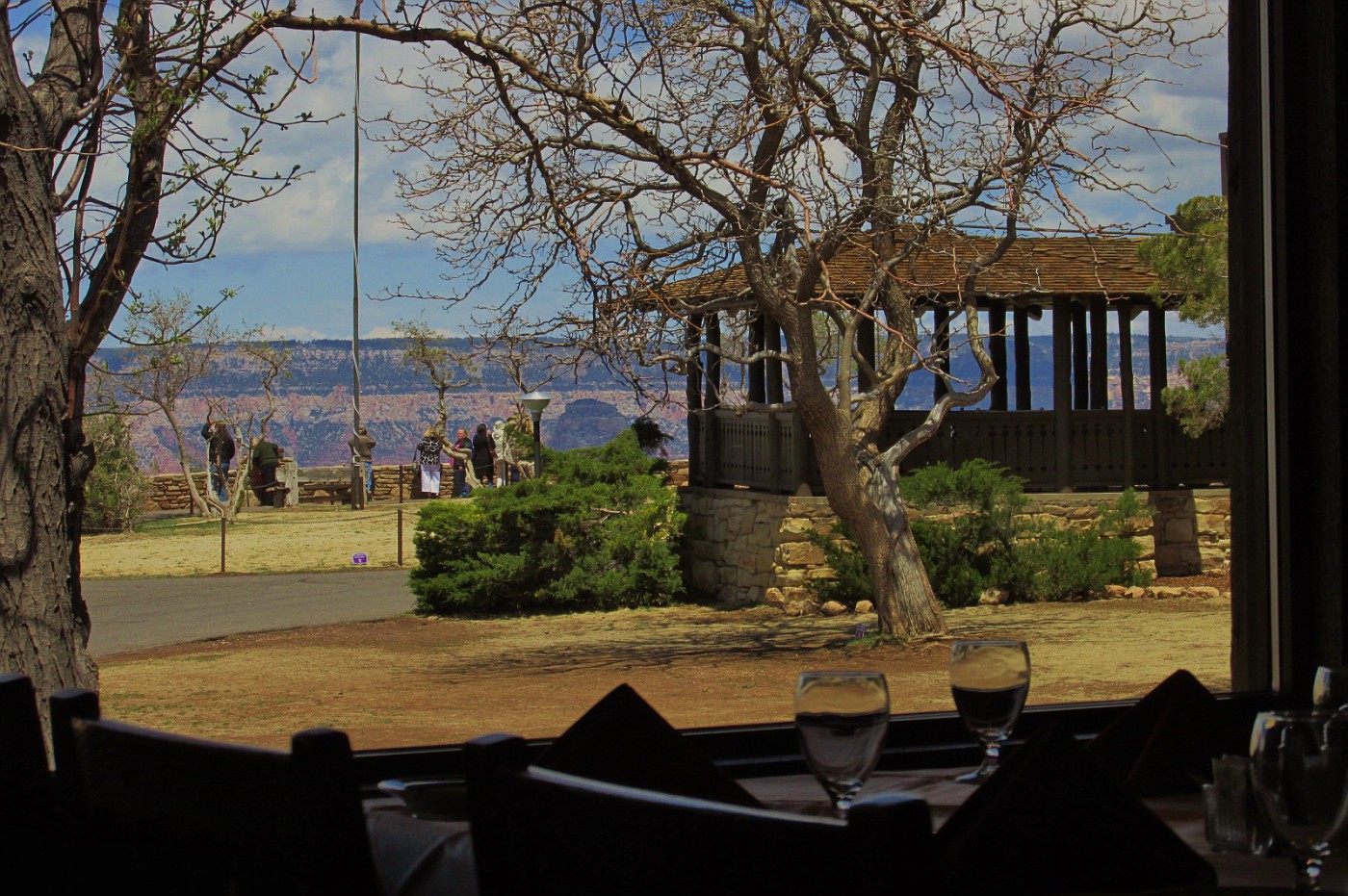
The view from the El Tovar Dining Room
This is a classy dining room that has long been regarded for the high quality of its cuisine as well as its ambience. I thought it fitting then that the management actually enforces a dress code. No –a coat and tie is not required but those who deign to show up in shorts and sandals will be directed toward the snack bar.
The menu offered an enticing array of surprisingly affordable sandwiches and entrees. After a couple minutes of consideration, I selected the Shaved Natural Black Angus Prime Rib Melt on Ciabatta Roll with Sautéed Mushrooms and Onions, Swiss Cheese and Horseradish Garlic Aioli. Believe me when I tell you that this sandwich was every bit as delicious as it sounds. Just typing it all out makes me want to fly down to Arizona right now and order another one! Did I mention it was accompanied by steak fries? Delicious!
After lunch I spent an hour in the bar chatting with the bartender, a nice gal from Beaver County in western Pennsylvania (Go Stillers!) who’d been working at the El Tovar for three years. Time will tell if I piqued her interest in Denali enough to consider working a summer there.
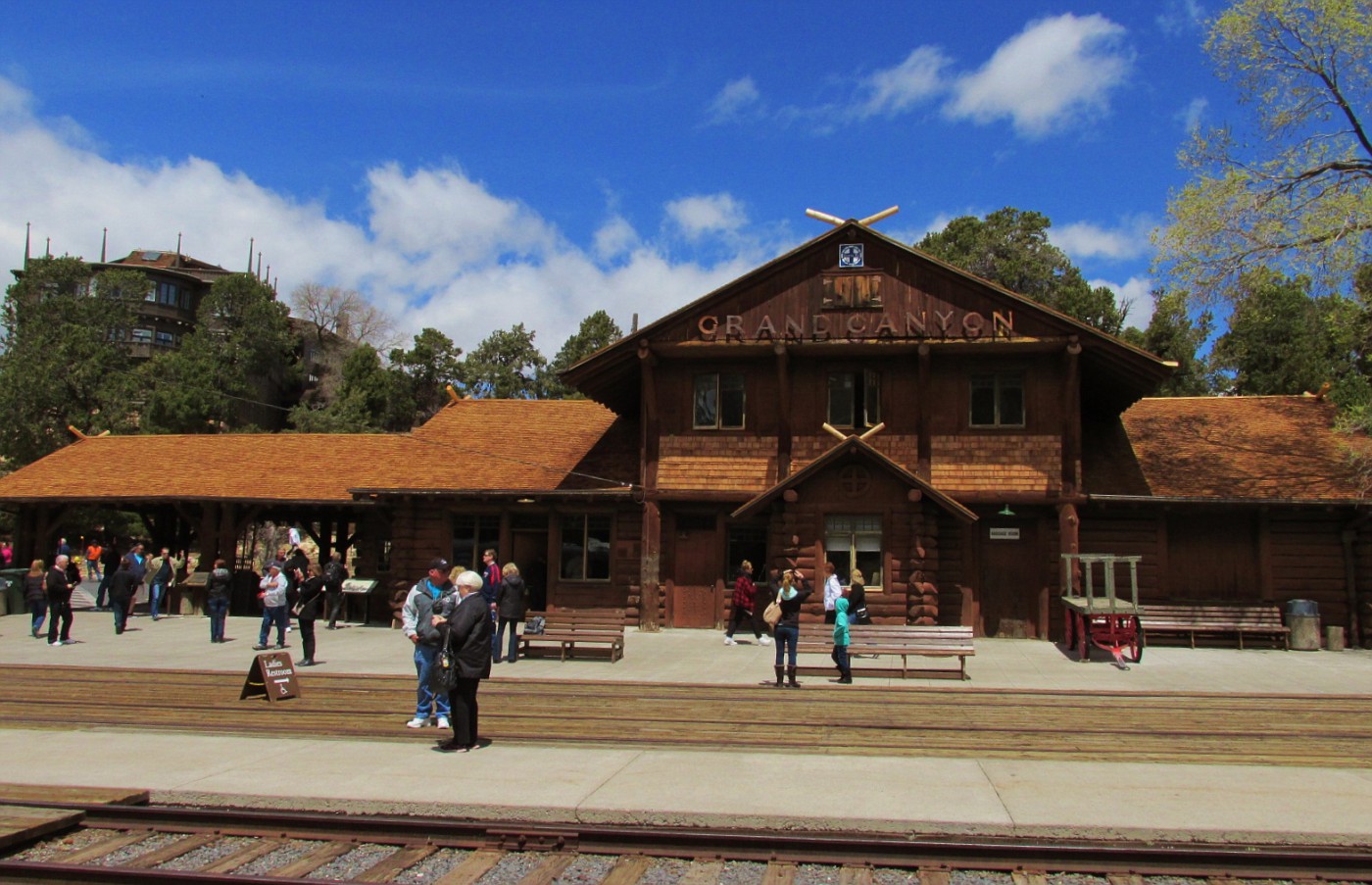
The Grand Canyon Depot
The Grand Canyon Depot is one of only three stations in America that have been constructed primarily with logs. It was such a nice day outside that I never thought to go inside and check it out. Next time. Instead, I walked over to a grove of ponderosa pines and took a couple photographs of the dome cars.
Just as it’s interesting to learn the backgrounds of people we meet, it’s also fascinating to learn the history of some of the individual airplanes and train cars that we fly or ride upon. I’ve flown upon some older airplanes that flew for four or five airlines before I flew on them. In some cases I’ve flown on a plane with one airline only to fly on that exact same airplane years later in the service of another airline. A good example of this would be N765NC, a DC-9-50 that I flew with North Central back in 1978 and flew again under the same registration but owned and operated by Northwest Airlines in 2002.
As for railroad cars, most all of the classic streamlined cars we see on tourist railroads and dinner trains these days were built back in the 1950s. They served proudly for their original owners before going to Amtrak in 1971 or heading off to other railroads (Many in Mexico and Canada) or private owners. Two cars caught my eye this afternoon:
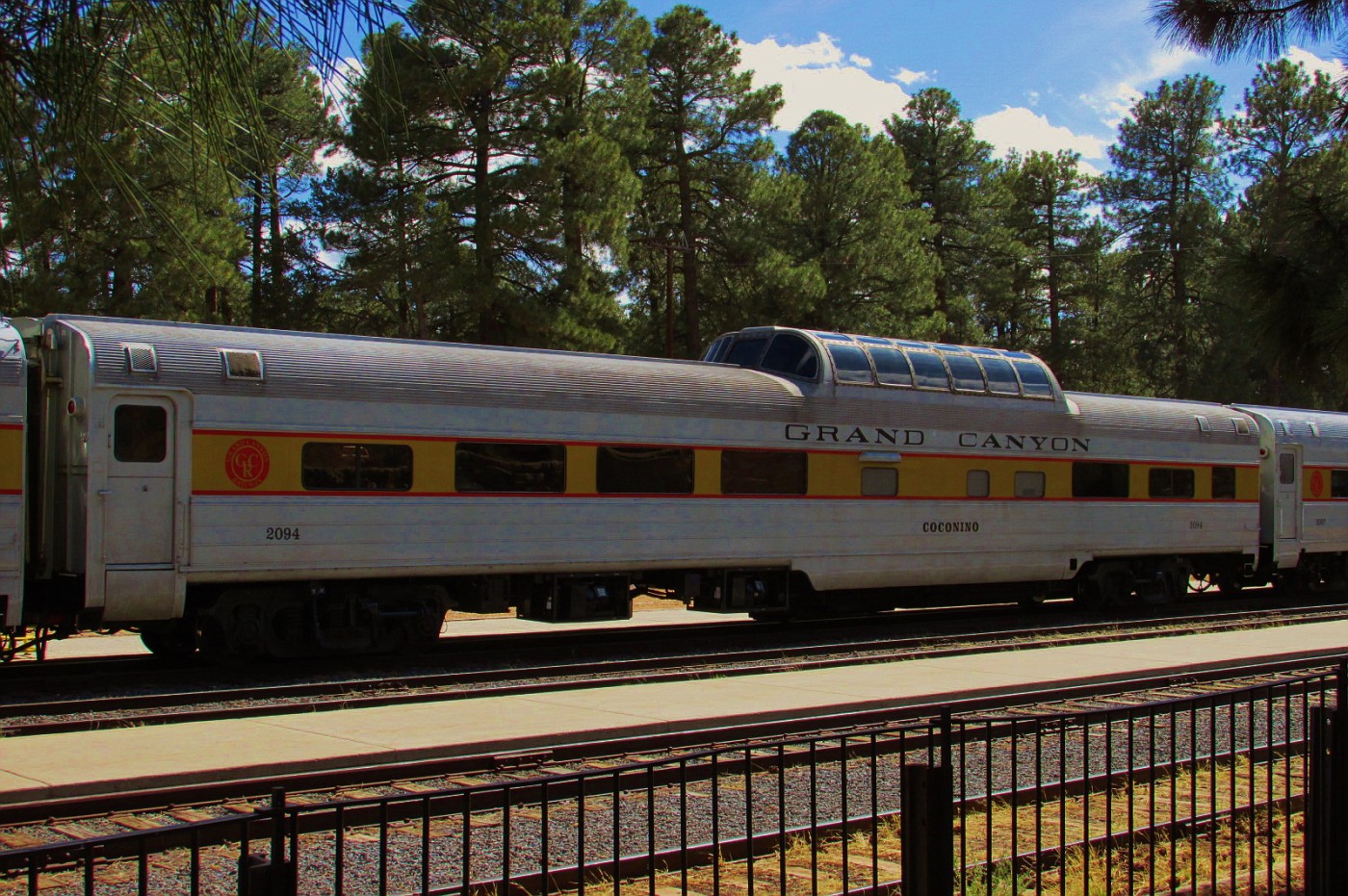
First Class Dome Observation Car “Coconino”
This car was built in 1954 for the Northern Pacific Railways by Budd Manufacturing Company. This style of car was called “Vista Dome” when in service for Northern Pacific’s run between Chicago and Seattle. It went to Amtrak in 1971. The Grand Canyon Railway purchased it in 1996 and after some refurbishment it went into service in March 1997 as “Coconino”. Its name comes from a Native American word that means “dry land” or “land of little water.”
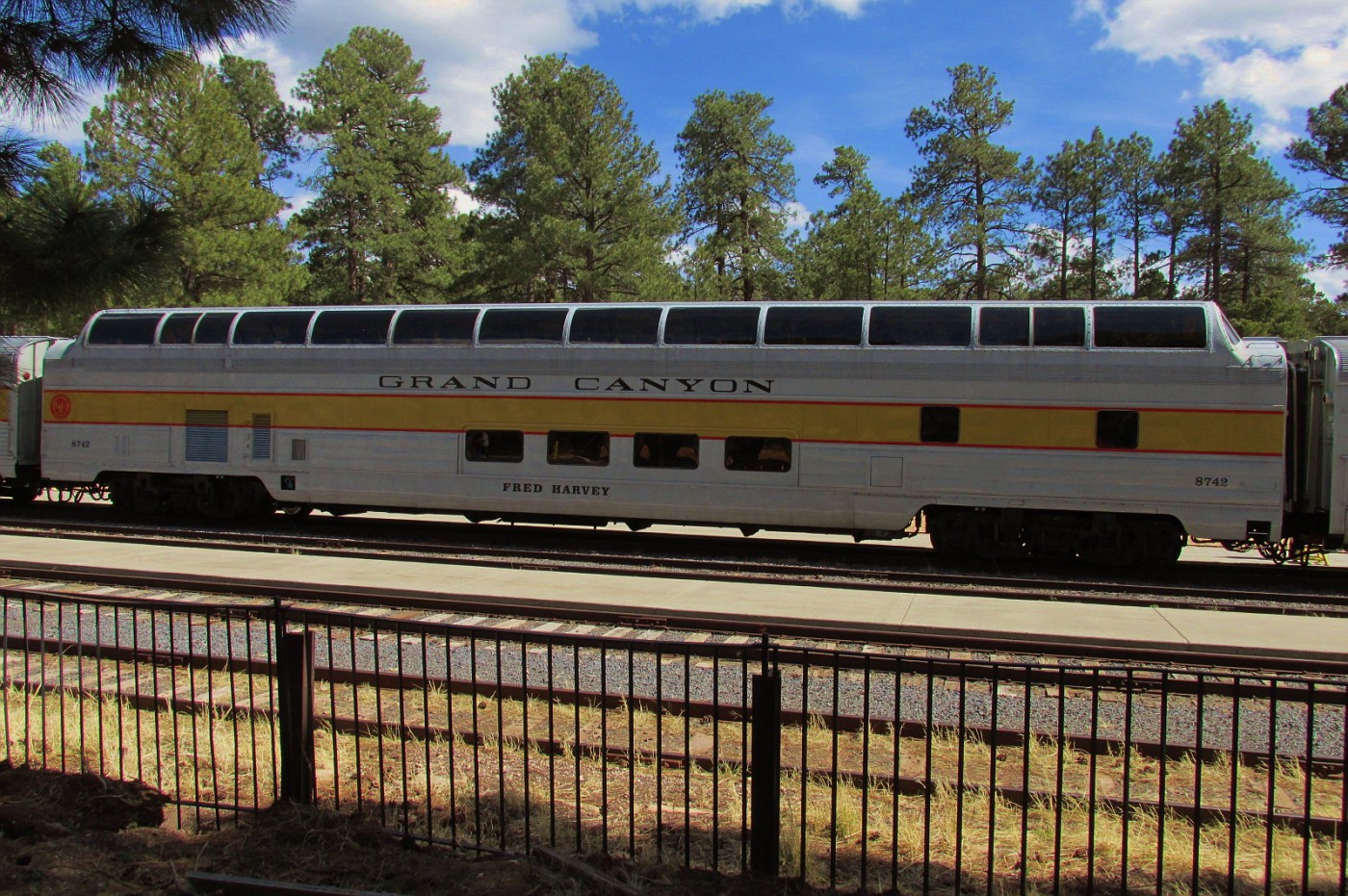
Luxury Dome Car “Fred Harvey”
Constructed by the Budd Company for the Chicago, Burlington and Quincy Railroad in 1955, this dome car was originally named “River View”. The CB&Q operated this luxury streamliner from Chicago to Minneapolis, where the Great Northern Railway took it over for the rest of the journey to Seattle. Amtrak purchased the car in 1971 and operated it in a variety of services, eventually selling it to the American Orient Express in 2001, when it was renamed “Copper Canyon”. Ten years later it was purchased by the Grand Canyon Railway and was renamed “Fred Harvey”. It seats 66 passengers upstairs under the dome with open lounge seating down stairs.
I was booked aboard the luxury parlor car “The Chief”, located at the very end of the train. I did not take any pictures of this car because as seen from the outside it was unremarkable. Its history however was fascinating to say the least!
The Chief was built in 1947 for Atlantic Coast Line’s services between New York and Miami. Amtrak retired it in the early 1980s and for some years it sat in storage until it was extensively refurbished and put into service for the Texas Southern Dinner Train from 1989-1991. After 1991, it served as a dinner car for charter in Mexico until 1993 when it was seized by the Mexican government. After a protracted legal battle the car was returned in 1994 to the US-Mexico border where it was picked up by the Union Pacific for delivery to San Antonio. Somehow the car was lost enroute only to be found later that year in New Orleans. On its return to San Antonio the car was damaged in a rear end collision. Its owner put it into storage before selling it in 1999. The next owner added the observation platform at a cost of $95,000 to cover up the damage caused in the collision, but then decided to sell the car prior to completing the restoration. The Grand Canyon Railway acquired the car in 2002, completed the restoration and named it “The Chief”. It has served faithfully ever since.
Boarding was a casual affair. Many of us were milling around next to the train, taking pictures and enjoying the pleasant afternoon sun. I boarded “The Chief” from the rear platform and found a seat – more of a couch really – along the wall.
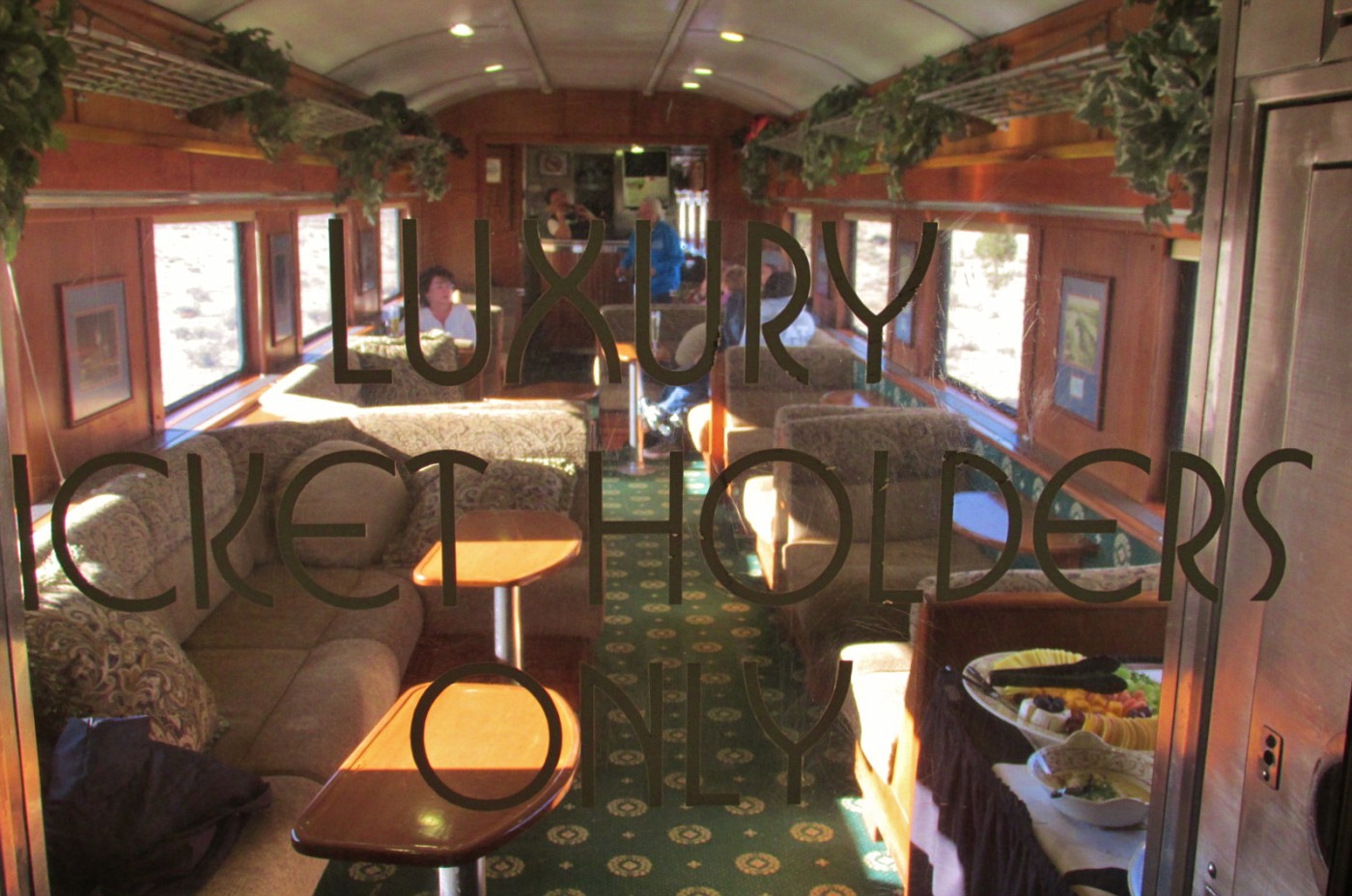
Boarding “The Chief” from the rear platform
One of the train staff approached to collect my ticket and when I asked if it was allowable to go check out the “Fred Harvey” located the next car forward, she informed me that I was welcome to sit up there if I liked.
Well alrighty then! Let’s go check ‘er out!
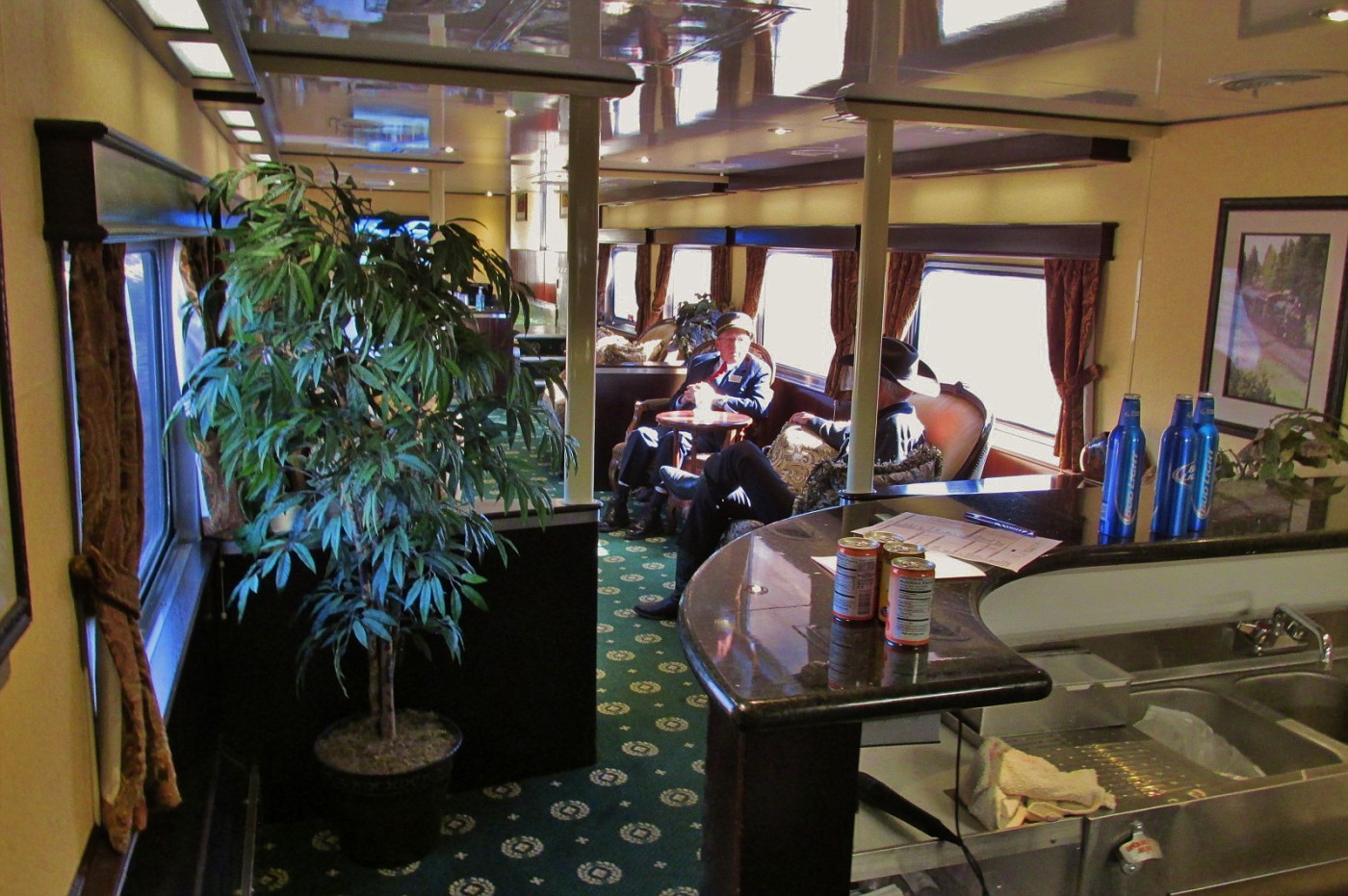
Luxury on rails as seen from the bar of the “Fred Harvey”

Cold beer and good company downstairs on the “Fred Harvey”
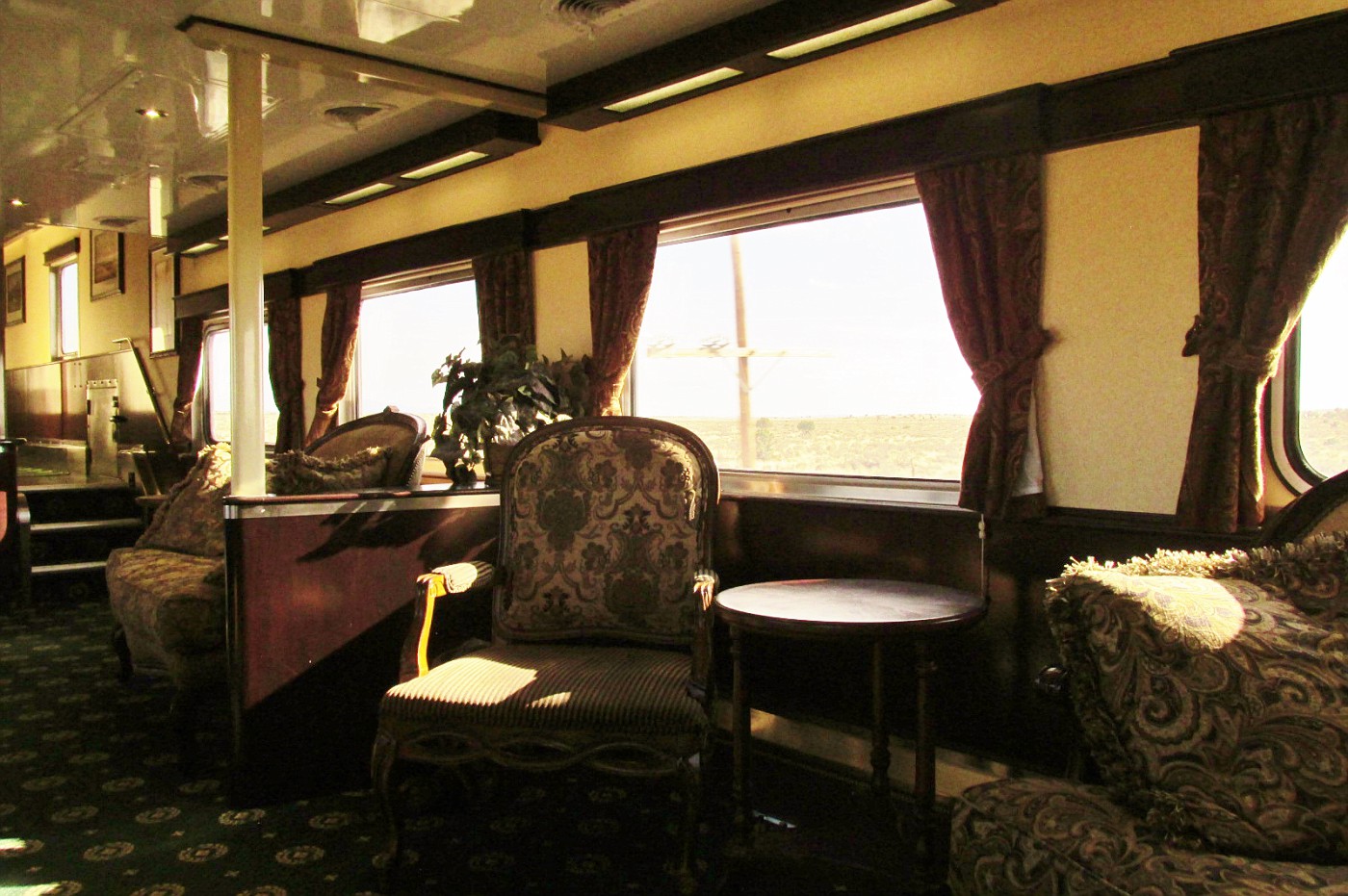
Old time elegance aboard the “Fred Harvey”
Oh yeah! I’ll sit here, please. As a Luxury Parlor Car ticket holder, I had the run of the train – especially today as we were only about two thirds full. More passengers arrived, many of them heading upstairs to sit under the dome. I understand the allure of the dome but frankly, the ambience is much more elegant down here, not to mention that the seating is much more comfortable. There’ll be plenty of time to check out the dome seating later in the trip.
The “All Aboard” cry rang out and then we were off!
What comes to mind when most people think of Arizona is desert. Saguaro cactus, coyotes, beautiful sunsets… While it’s true that about two thirds of Arizona is desert, the other third is comprised of forested mountains and high plateau. The south rim of the Grand Canyon is part of the Colorado Plateau and sits at about 7,000 feet in elevation. Winters can include occasionally heavy snowfall. I remember once getting stuck in Flagstaff after a storm dumped nearly three feet of snow in the region.
Pinion pine forests dominated the landscape as we began the initial portion of our journey down to Flagstaff. Looking at a map, it’s easy to say we were headed “down to Flagstaff” but the reality of it is that Flagstaff is actually a few feet higher than portion of the South Rim where the train station is located. Our journey actually does take us down to prairielands at about 5000’ before climbing back to 7000’ as we make our way “up to” Flagstaff. I would describe the scenery as pleasant more so than dramatic. Old ranch buildings, corrals and loading platforms add spice along the way. As we arrived into the park earlier today, we saw a small group of about a dozen elk resting just a few feet off the tracks.
I was enjoying a conversation with the conductor downstairs in the lounge when two trays bearing a variety of crudités, cheese, crackers, fruit and petit fours were placed in the service area. We were about an hour into the trip and I was ready for some snacking. And a beer. The bar offered a variety of local microbrews as well as the usual selection of spirits. I went with a Pale Ale and then sauntered over to inspect the food offerings.
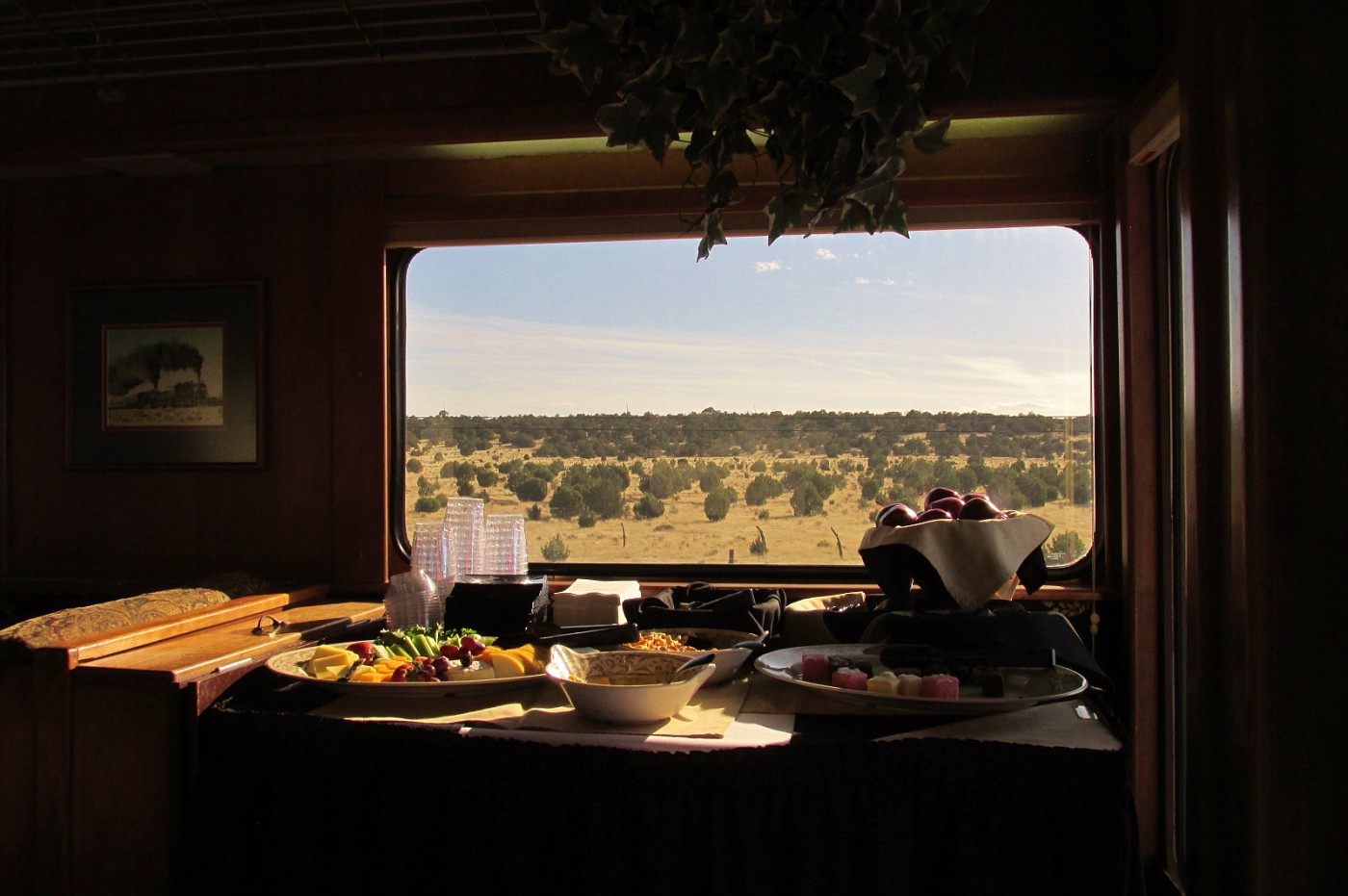
Afternoon snacks against a back drop of Arizona high prairie
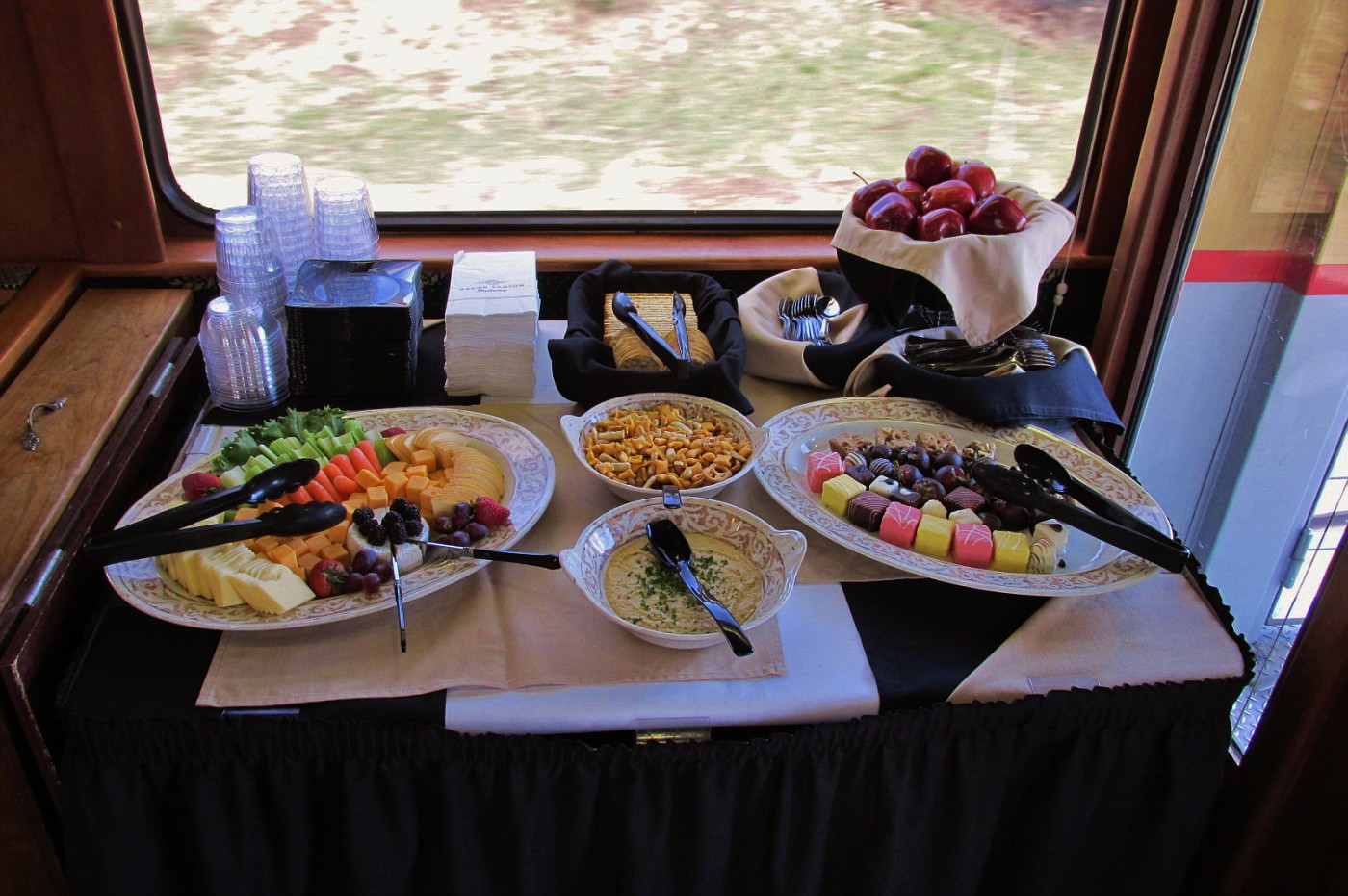
Mmm… so many choices…
An announcement was made over the PA that we were traveling through an area known as the Upper Sonoran Zone. It looked like a lot of sagebrush to me. As I mentioned earlier, the scenery was pleasant though not particularly exciting so a seat downstairs in the elegantly appointed lounge seemed a better choice than upstairs in the non-reclining chairs under the dome.
That said however, this was a classic old domeliner of a type rarely seen on American rails anymore. The view from the dome has always been a major attraction of riding these cars, so I grabbed my beer, refilled my plate with veggies and hummus and headed upstairs.
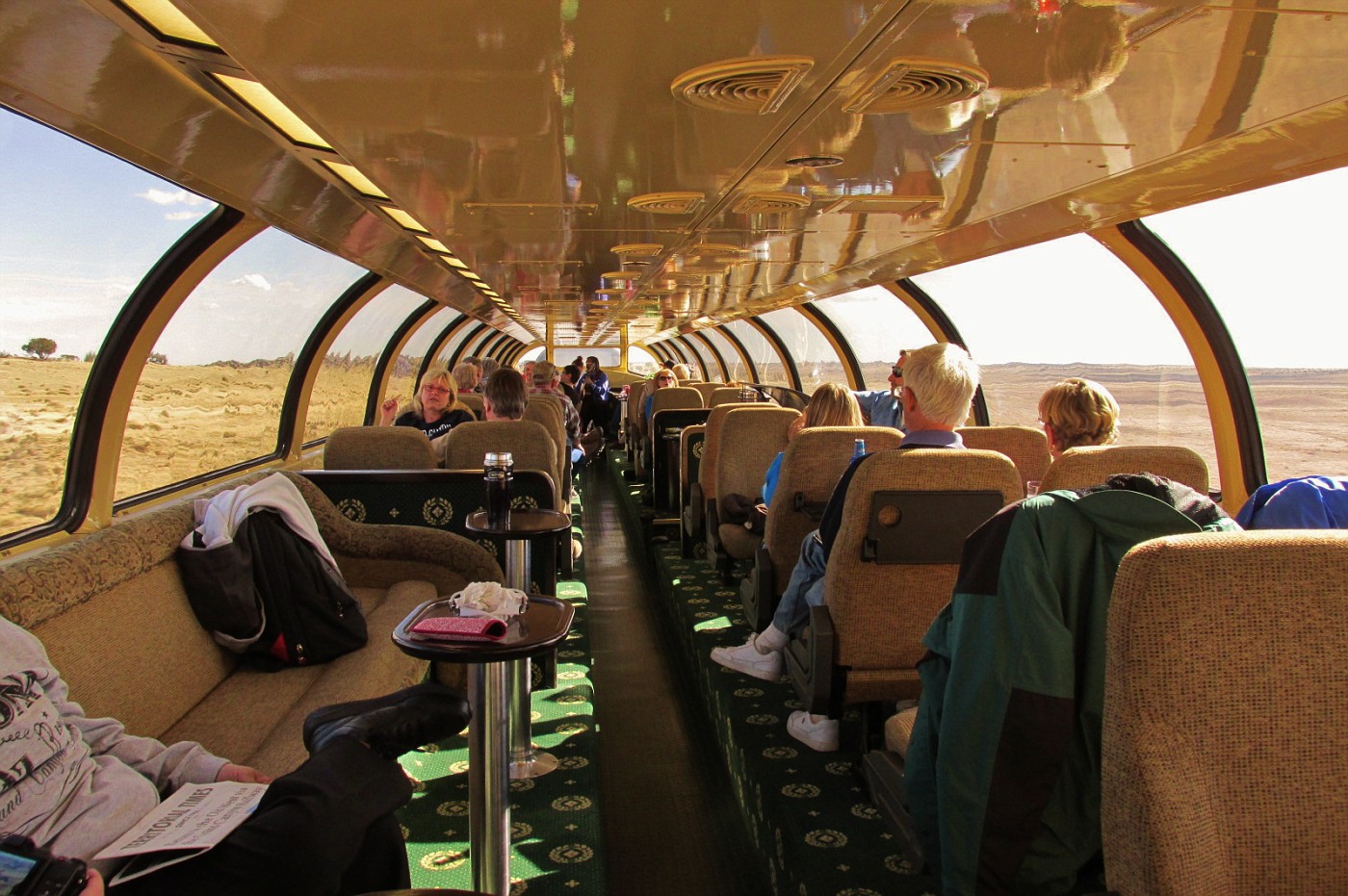
Under the dome…
It wasn’t long before the landscape began to change and soon we were traveling through pretty forests of Douglas fir changing to Ponderosa pine as we gained elevation for the final stretch into Flagstaff. A local musician played cowboy songs off a guitar from the front of the car, and a few minutes later train staff arrived to pour complimentary glasses from bottles of sparkling wine. Nice.
The temperature outside was quite pleasant – in the mid-seventies I’d guess – and so I relocated downstairs and back one car to “The Chief” where there was plenty of space on the open air platform at the end of the car. Check out the view!

Love those domes…
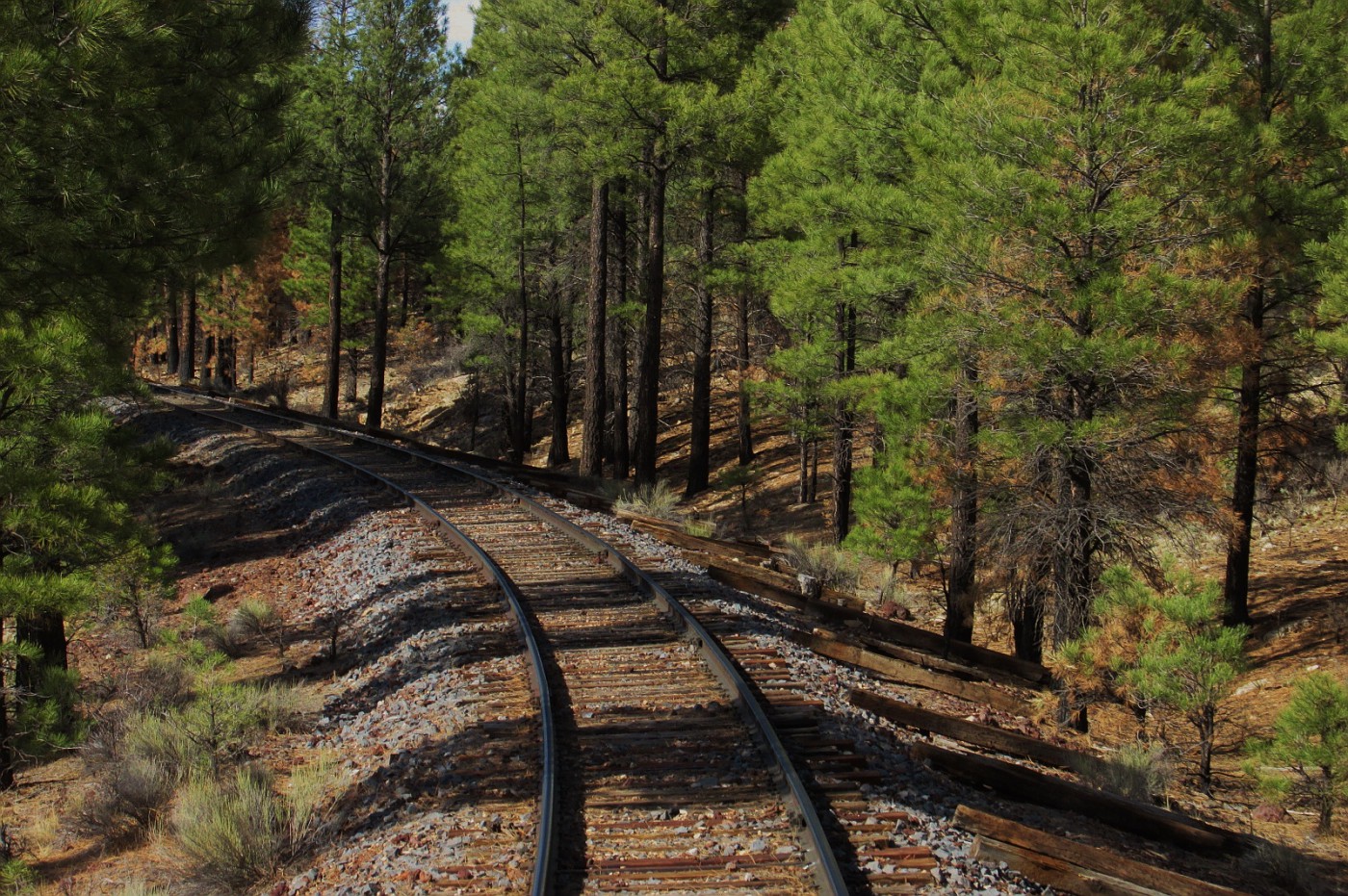
A nice perspective…
If only I had a recliner out here
As we approached Flagstaff, we rolled through the Grand Canyon Railway’s railyard which features an extensive collection of old cars and engines. Many of the cars are there only for parts, but others are being refurbished for use in the future. The highlight for me was a beautiful old Alco FPA-4 locomotive. I’d been hoping that this would’ve been the locomotive to lead our train up to the Grand Canyon and back today but alas, it was not to be. Instead our consist was headed up by a comparatively youthful 37 year old F-40PH that began its career with Amtrak before relocating to northern Arizona.
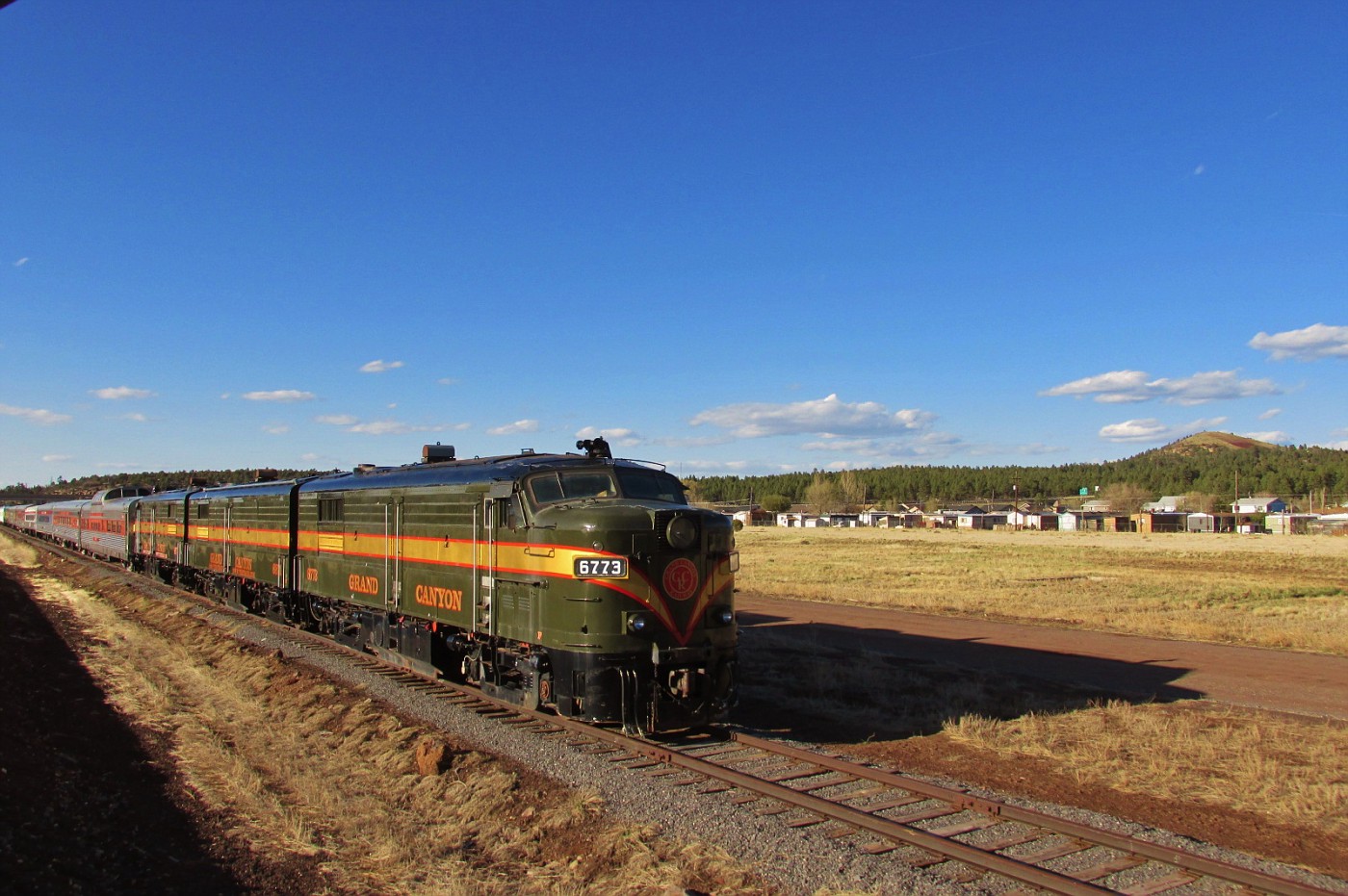
A classic old Alco FPA-4…
Disembarking at Flagstaff, we were treated to another nice sight – an ALCO SP3 steam locomotive. The Grand Canyon railway has a couple of steam locomotives but they are used only 6 weekends a year for special excursion trains.
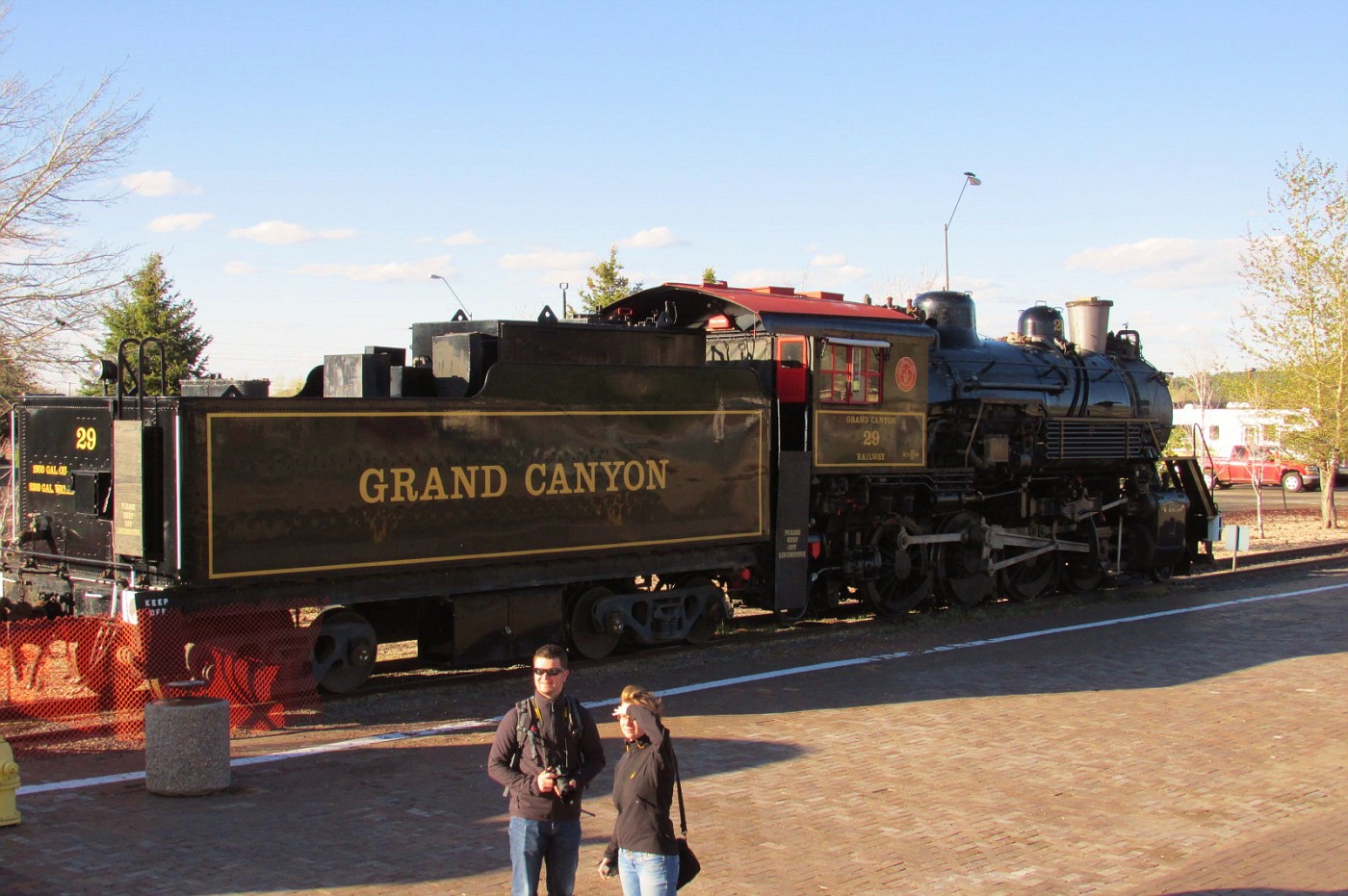
Old No. 29 – An ALCO SP3 built in 1923…
I’ve visited the Grand Canyon on many occasions. While it’s always been nice to have the freedom that comes with having your own car, I must say that taking the train was a unique and entertaining way to travel into the park. The stop at the south rim allows about three and a half hours, plenty of time to utilize the free shuttle busses to see other parts of the canyon and/or visit the El Tovar or Bright Angel Lodge for a bite to eat. Of course, one could always spend an extra day or two in the park as well. There are a variety of hotels and packages available through the railroad website. For anyone who should someday find themselves in Northern Arizona, I highly recommend a ride on this train.
Grand Canyon Railway South Rim to Williams, AZ 3:30p – 5:45pm Luxury Parlor Car
Since I’m traveling back and forth over the same tracks, I’m going to start my description of this trip up at the El Tovar Hotel. We’ll have lunch in the Arizona Dining Room and then head down to the station to board our luxury parlor car for the two and a half hour ride down to Williams. But first, let’s walk over to the edge and check out the view of the Grand Canyon. Awesome!

The view from El Tovar – Looking left

The view from El Tovar – Looking right
The main lobby of the El Tovar is a fusion of Swiss Chalet design and colorful Southwestern furnishings. I shielded my eyes and continued straight into the attractive wood and stone dining room where I was warmly greeted and seated at a four top table that provided nice views of the hotel lawn and the canyon beyond.

The view from the El Tovar Dining Room
This is a classy dining room that has long been regarded for the high quality of its cuisine as well as its ambience. I thought it fitting then that the management actually enforces a dress code. No –a coat and tie is not required but those who deign to show up in shorts and sandals will be directed toward the snack bar.
The menu offered an enticing array of surprisingly affordable sandwiches and entrees. After a couple minutes of consideration, I selected the Shaved Natural Black Angus Prime Rib Melt on Ciabatta Roll with Sautéed Mushrooms and Onions, Swiss Cheese and Horseradish Garlic Aioli. Believe me when I tell you that this sandwich was every bit as delicious as it sounds. Just typing it all out makes me want to fly down to Arizona right now and order another one! Did I mention it was accompanied by steak fries? Delicious!
After lunch I spent an hour in the bar chatting with the bartender, a nice gal from Beaver County in western Pennsylvania (Go Stillers!) who’d been working at the El Tovar for three years. Time will tell if I piqued her interest in Denali enough to consider working a summer there.

The Grand Canyon Depot
The Grand Canyon Depot is one of only three stations in America that have been constructed primarily with logs. It was such a nice day outside that I never thought to go inside and check it out. Next time. Instead, I walked over to a grove of ponderosa pines and took a couple photographs of the dome cars.
Just as it’s interesting to learn the backgrounds of people we meet, it’s also fascinating to learn the history of some of the individual airplanes and train cars that we fly or ride upon. I’ve flown upon some older airplanes that flew for four or five airlines before I flew on them. In some cases I’ve flown on a plane with one airline only to fly on that exact same airplane years later in the service of another airline. A good example of this would be N765NC, a DC-9-50 that I flew with North Central back in 1978 and flew again under the same registration but owned and operated by Northwest Airlines in 2002.
As for railroad cars, most all of the classic streamlined cars we see on tourist railroads and dinner trains these days were built back in the 1950s. They served proudly for their original owners before going to Amtrak in 1971 or heading off to other railroads (Many in Mexico and Canada) or private owners. Two cars caught my eye this afternoon:

First Class Dome Observation Car “Coconino”
This car was built in 1954 for the Northern Pacific Railways by Budd Manufacturing Company. This style of car was called “Vista Dome” when in service for Northern Pacific’s run between Chicago and Seattle. It went to Amtrak in 1971. The Grand Canyon Railway purchased it in 1996 and after some refurbishment it went into service in March 1997 as “Coconino”. Its name comes from a Native American word that means “dry land” or “land of little water.”

Luxury Dome Car “Fred Harvey”
Constructed by the Budd Company for the Chicago, Burlington and Quincy Railroad in 1955, this dome car was originally named “River View”. The CB&Q operated this luxury streamliner from Chicago to Minneapolis, where the Great Northern Railway took it over for the rest of the journey to Seattle. Amtrak purchased the car in 1971 and operated it in a variety of services, eventually selling it to the American Orient Express in 2001, when it was renamed “Copper Canyon”. Ten years later it was purchased by the Grand Canyon Railway and was renamed “Fred Harvey”. It seats 66 passengers upstairs under the dome with open lounge seating down stairs.
I was booked aboard the luxury parlor car “The Chief”, located at the very end of the train. I did not take any pictures of this car because as seen from the outside it was unremarkable. Its history however was fascinating to say the least!
The Chief was built in 1947 for Atlantic Coast Line’s services between New York and Miami. Amtrak retired it in the early 1980s and for some years it sat in storage until it was extensively refurbished and put into service for the Texas Southern Dinner Train from 1989-1991. After 1991, it served as a dinner car for charter in Mexico until 1993 when it was seized by the Mexican government. After a protracted legal battle the car was returned in 1994 to the US-Mexico border where it was picked up by the Union Pacific for delivery to San Antonio. Somehow the car was lost enroute only to be found later that year in New Orleans. On its return to San Antonio the car was damaged in a rear end collision. Its owner put it into storage before selling it in 1999. The next owner added the observation platform at a cost of $95,000 to cover up the damage caused in the collision, but then decided to sell the car prior to completing the restoration. The Grand Canyon Railway acquired the car in 2002, completed the restoration and named it “The Chief”. It has served faithfully ever since.
Boarding was a casual affair. Many of us were milling around next to the train, taking pictures and enjoying the pleasant afternoon sun. I boarded “The Chief” from the rear platform and found a seat – more of a couch really – along the wall.

Boarding “The Chief” from the rear platform
One of the train staff approached to collect my ticket and when I asked if it was allowable to go check out the “Fred Harvey” located the next car forward, she informed me that I was welcome to sit up there if I liked.
Well alrighty then! Let’s go check ‘er out!

Luxury on rails as seen from the bar of the “Fred Harvey”

Cold beer and good company downstairs on the “Fred Harvey”

Old time elegance aboard the “Fred Harvey”
Oh yeah! I’ll sit here, please. As a Luxury Parlor Car ticket holder, I had the run of the train – especially today as we were only about two thirds full. More passengers arrived, many of them heading upstairs to sit under the dome. I understand the allure of the dome but frankly, the ambience is much more elegant down here, not to mention that the seating is much more comfortable. There’ll be plenty of time to check out the dome seating later in the trip.
The “All Aboard” cry rang out and then we were off!
What comes to mind when most people think of Arizona is desert. Saguaro cactus, coyotes, beautiful sunsets… While it’s true that about two thirds of Arizona is desert, the other third is comprised of forested mountains and high plateau. The south rim of the Grand Canyon is part of the Colorado Plateau and sits at about 7,000 feet in elevation. Winters can include occasionally heavy snowfall. I remember once getting stuck in Flagstaff after a storm dumped nearly three feet of snow in the region.
Pinion pine forests dominated the landscape as we began the initial portion of our journey down to Flagstaff. Looking at a map, it’s easy to say we were headed “down to Flagstaff” but the reality of it is that Flagstaff is actually a few feet higher than portion of the South Rim where the train station is located. Our journey actually does take us down to prairielands at about 5000’ before climbing back to 7000’ as we make our way “up to” Flagstaff. I would describe the scenery as pleasant more so than dramatic. Old ranch buildings, corrals and loading platforms add spice along the way. As we arrived into the park earlier today, we saw a small group of about a dozen elk resting just a few feet off the tracks.
I was enjoying a conversation with the conductor downstairs in the lounge when two trays bearing a variety of crudités, cheese, crackers, fruit and petit fours were placed in the service area. We were about an hour into the trip and I was ready for some snacking. And a beer. The bar offered a variety of local microbrews as well as the usual selection of spirits. I went with a Pale Ale and then sauntered over to inspect the food offerings.

Afternoon snacks against a back drop of Arizona high prairie

Mmm… so many choices…
An announcement was made over the PA that we were traveling through an area known as the Upper Sonoran Zone. It looked like a lot of sagebrush to me. As I mentioned earlier, the scenery was pleasant though not particularly exciting so a seat downstairs in the elegantly appointed lounge seemed a better choice than upstairs in the non-reclining chairs under the dome.
That said however, this was a classic old domeliner of a type rarely seen on American rails anymore. The view from the dome has always been a major attraction of riding these cars, so I grabbed my beer, refilled my plate with veggies and hummus and headed upstairs.

Under the dome…
It wasn’t long before the landscape began to change and soon we were traveling through pretty forests of Douglas fir changing to Ponderosa pine as we gained elevation for the final stretch into Flagstaff. A local musician played cowboy songs off a guitar from the front of the car, and a few minutes later train staff arrived to pour complimentary glasses from bottles of sparkling wine. Nice.
The temperature outside was quite pleasant – in the mid-seventies I’d guess – and so I relocated downstairs and back one car to “The Chief” where there was plenty of space on the open air platform at the end of the car. Check out the view!

Love those domes…

A nice perspective…
If only I had a recliner out here
As we approached Flagstaff, we rolled through the Grand Canyon Railway’s railyard which features an extensive collection of old cars and engines. Many of the cars are there only for parts, but others are being refurbished for use in the future. The highlight for me was a beautiful old Alco FPA-4 locomotive. I’d been hoping that this would’ve been the locomotive to lead our train up to the Grand Canyon and back today but alas, it was not to be. Instead our consist was headed up by a comparatively youthful 37 year old F-40PH that began its career with Amtrak before relocating to northern Arizona.

A classic old Alco FPA-4…
Disembarking at Flagstaff, we were treated to another nice sight – an ALCO SP3 steam locomotive. The Grand Canyon railway has a couple of steam locomotives but they are used only 6 weekends a year for special excursion trains.

Old No. 29 – An ALCO SP3 built in 1923…
I’ve visited the Grand Canyon on many occasions. While it’s always been nice to have the freedom that comes with having your own car, I must say that taking the train was a unique and entertaining way to travel into the park. The stop at the south rim allows about three and a half hours, plenty of time to utilize the free shuttle busses to see other parts of the canyon and/or visit the El Tovar or Bright Angel Lodge for a bite to eat. Of course, one could always spend an extra day or two in the park as well. There are a variety of hotels and packages available through the railroad website. For anyone who should someday find themselves in Northern Arizona, I highly recommend a ride on this train.
Last edited by Seat 2A; Jan 1, 2015 at 5:54 pm
#11
FlyerTalk Evangelist
Original Poster
Join Date: Apr 2001
Location: East Ester, Alaska
Programs: Alaska Million Miler, United Million Miler, Wyndham Rewards Diamond, Choice Hotels Diamond
Posts: 12,148
DRIVING BACK TO SAN DIEGO
In a roundabout way
I grew up in Colorado and even as a young kid I was enamored of the landscape of the west and the roads that travel through it. This is such a beautiful part of the country that for me at least, no trip down here is complete without some form of road trip. In so doing I address three of my major likes – driving through this spectacular region, staying in old motels and enjoying the local flavor and culture found in local cafes and restaurants.
It was near 6:00pm by the time I accelerated up the onramp onto Interstate 40 and left Williams in my rearview mirror. I spent the evening in Flagstaff before continuing on the next day through Monument Valley and on up US 191 to Green River, Utah.
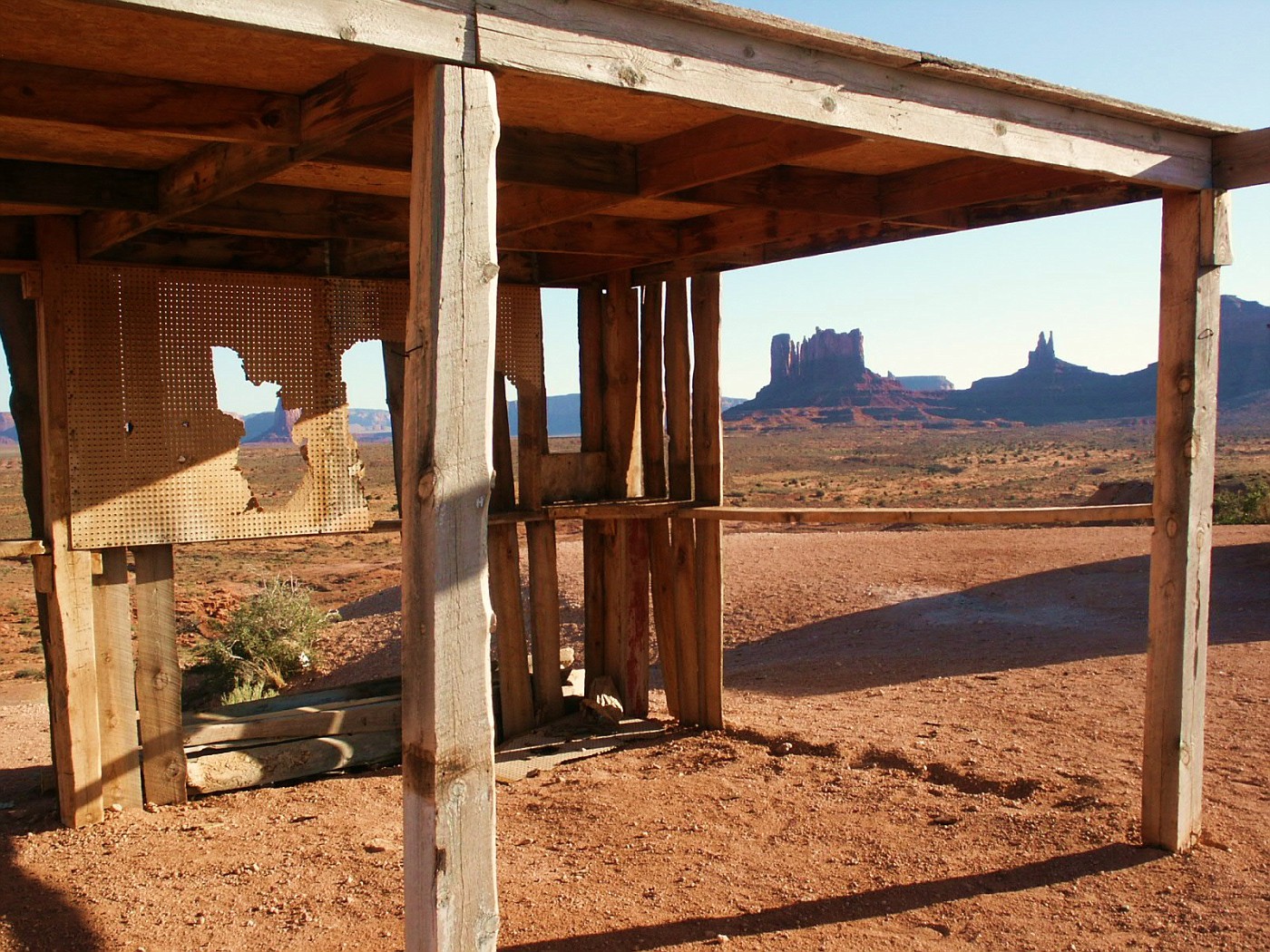
Monument Valley as seen through an abandoned Navajo jewelry stand

Rolling through shallow canyons on US 191 south of Moab, Utah

The Sleepy Hollow Motel in Green River Utah
After a long day of driving through canyon country, this motel offers large rooms and great value.
I’ve probably spent thirty nights here over the years.
Though I generally advocate getting off the Interstate and onto the smaller roads, there are not any other east-west options out of Green River and the route west to Salinas provides some spectacular views of Utah’s gorgeous Canyon Country.
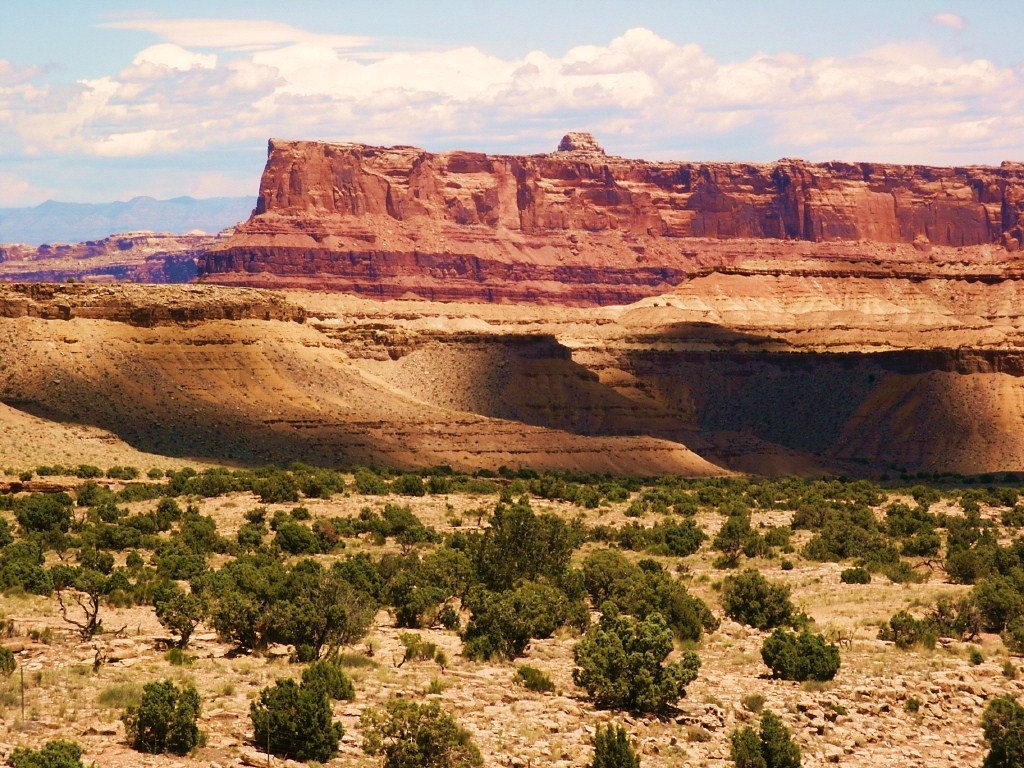
Beautiful buttes west of Green River
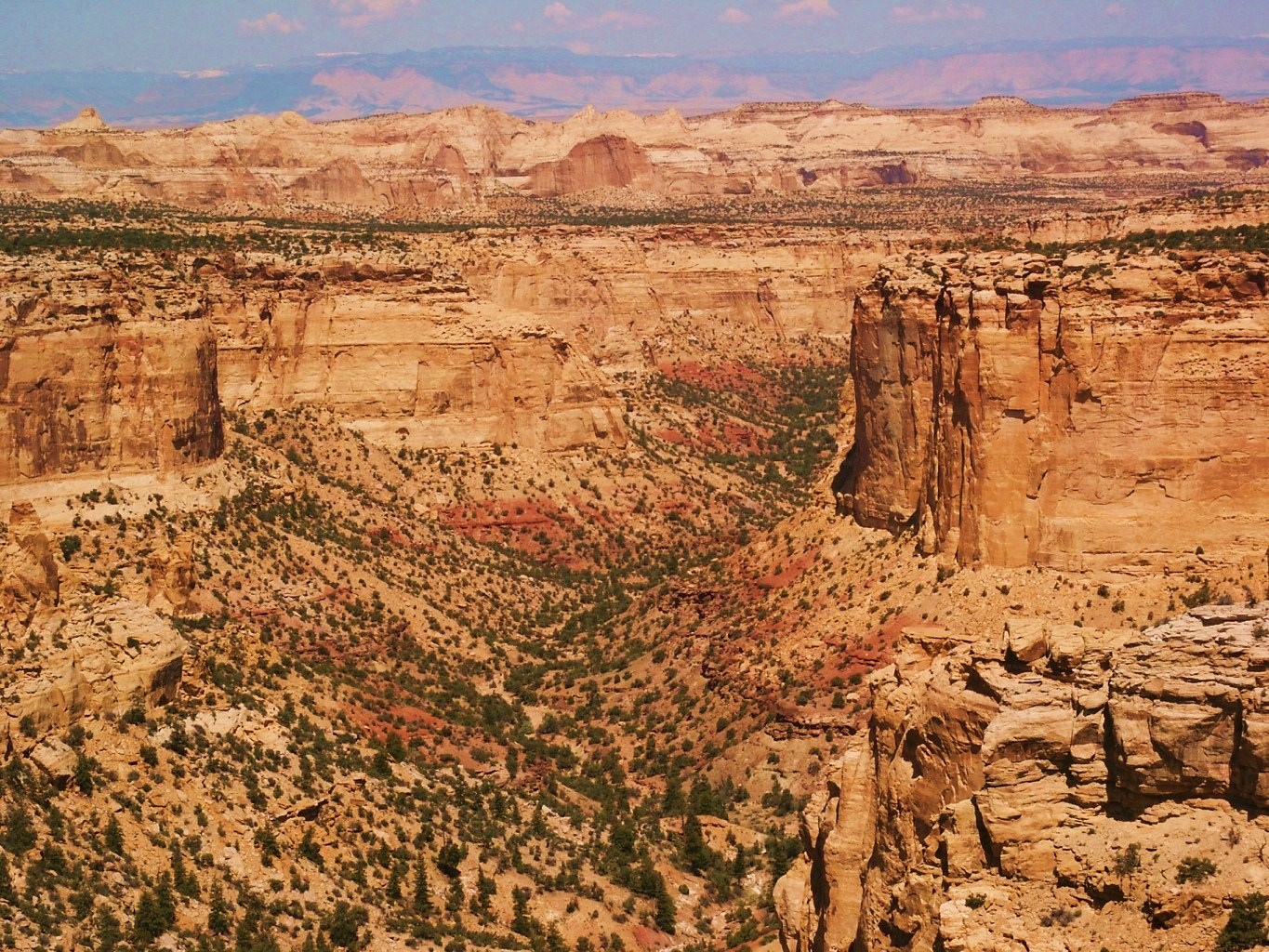
White Canyon
There’s an overlook off Interstate 70 for this view
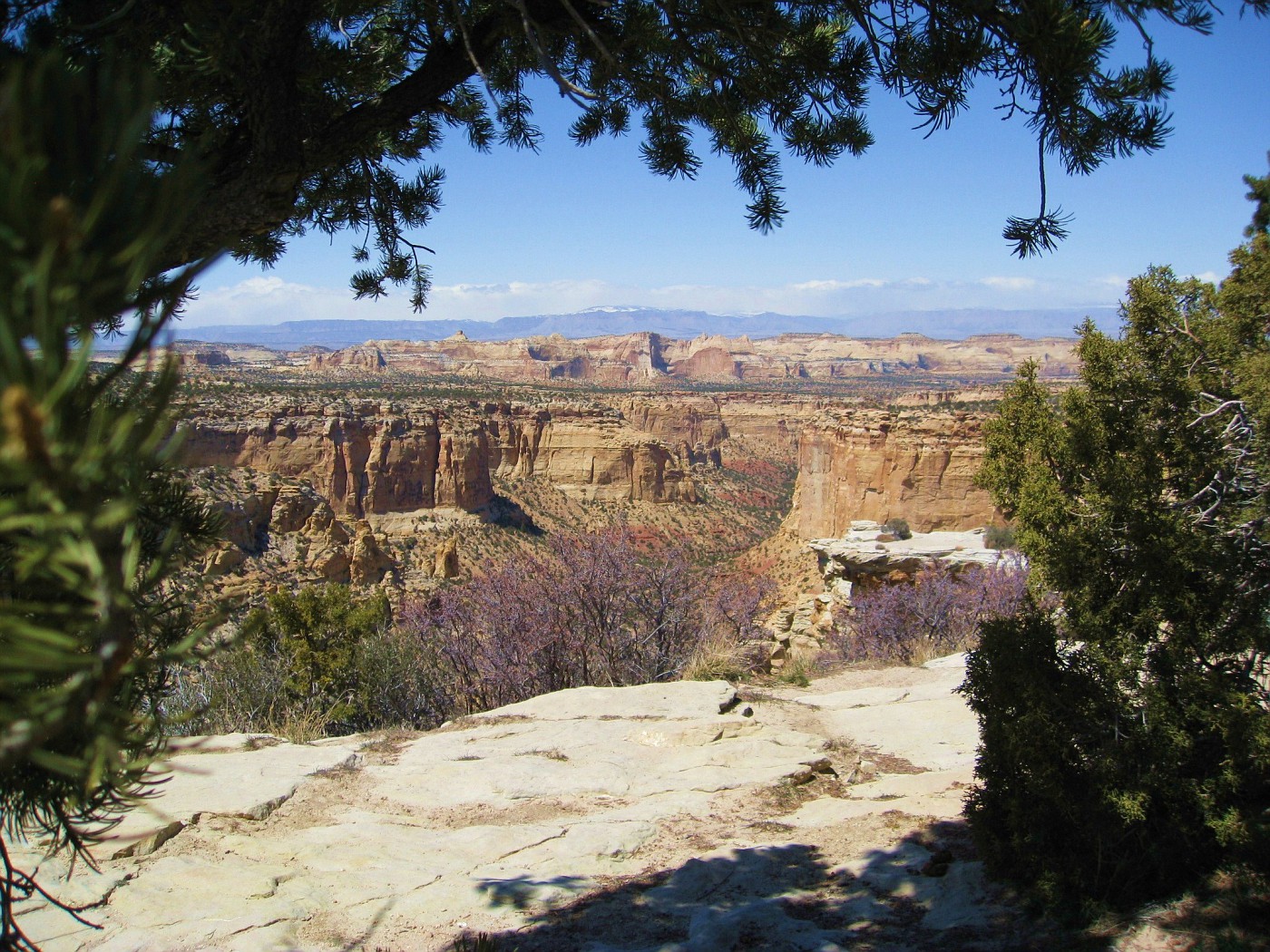
Eagle Canyon
As seen from Interstate 70
Turning south at Richfield, Utah, I headed down US 89 where I stopped for a Mexican dinner in Kanab before continuing on to Fredonia, Arizona. Most of the tourists prefer to stay up in Kanab with its many hotels and restaurants. That’s all well and good but they are missing a real gem just 10 miles down the road in Fredonia.
As viewed from the outside, the Grand Canyon Motel looks pretty run down. Appearances can be deceiving however. Just around the back side of the old adobe main building is a beautiful shady courtyard surrounded by six rock cabin duplexes. Originally built as a hunting lodge in the early 1900s, it was converted into a motel in the 1970s. The old couple who own it have an affection for stray cats and leave plenty of food out for the dozen or so that wander the property. At $38.00 per night, it’s a comfortable and quiet place to stay.
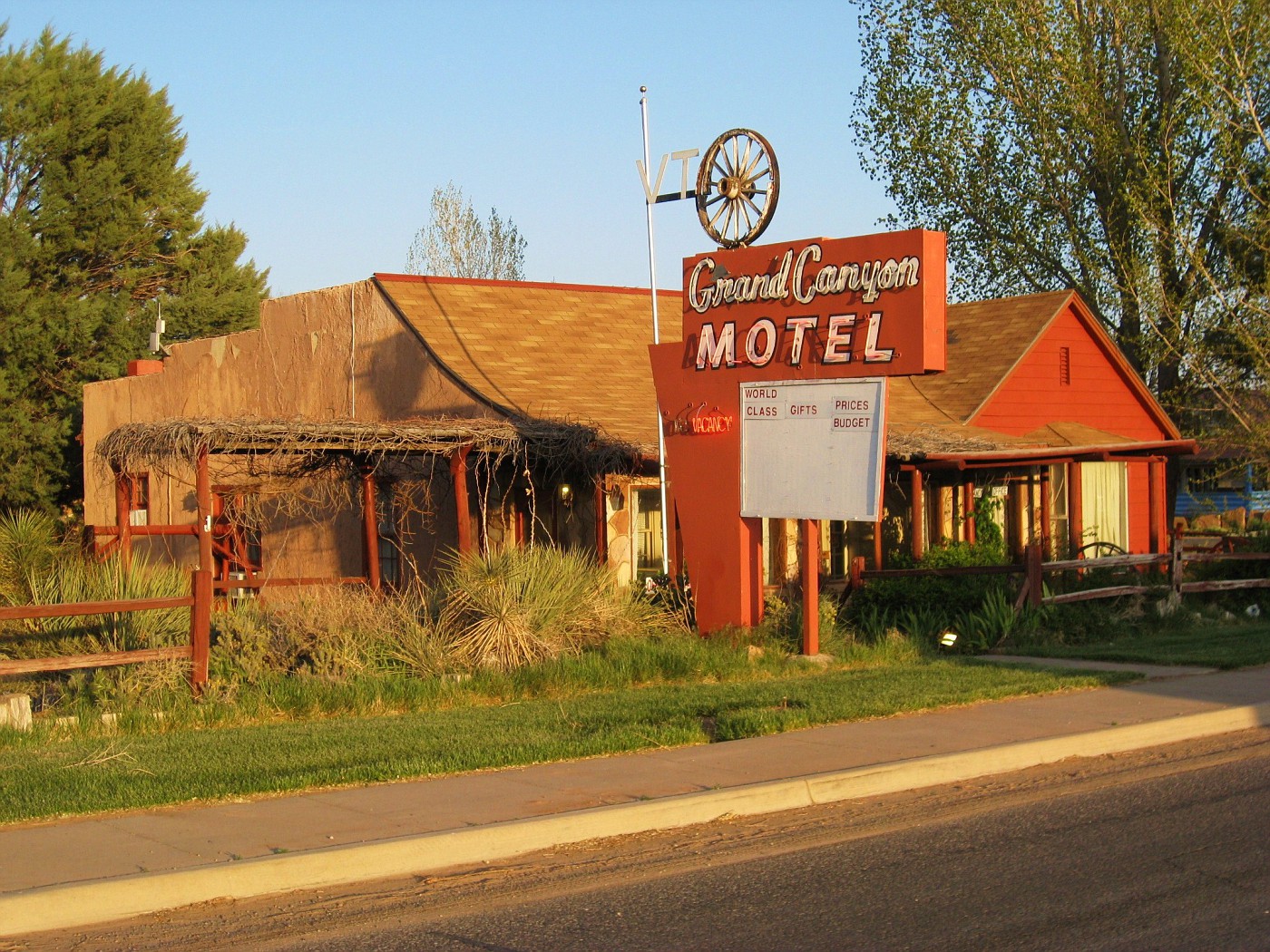
Grand Canyon Motel ~ Fredonia, Arizona
Would YOU stay here?
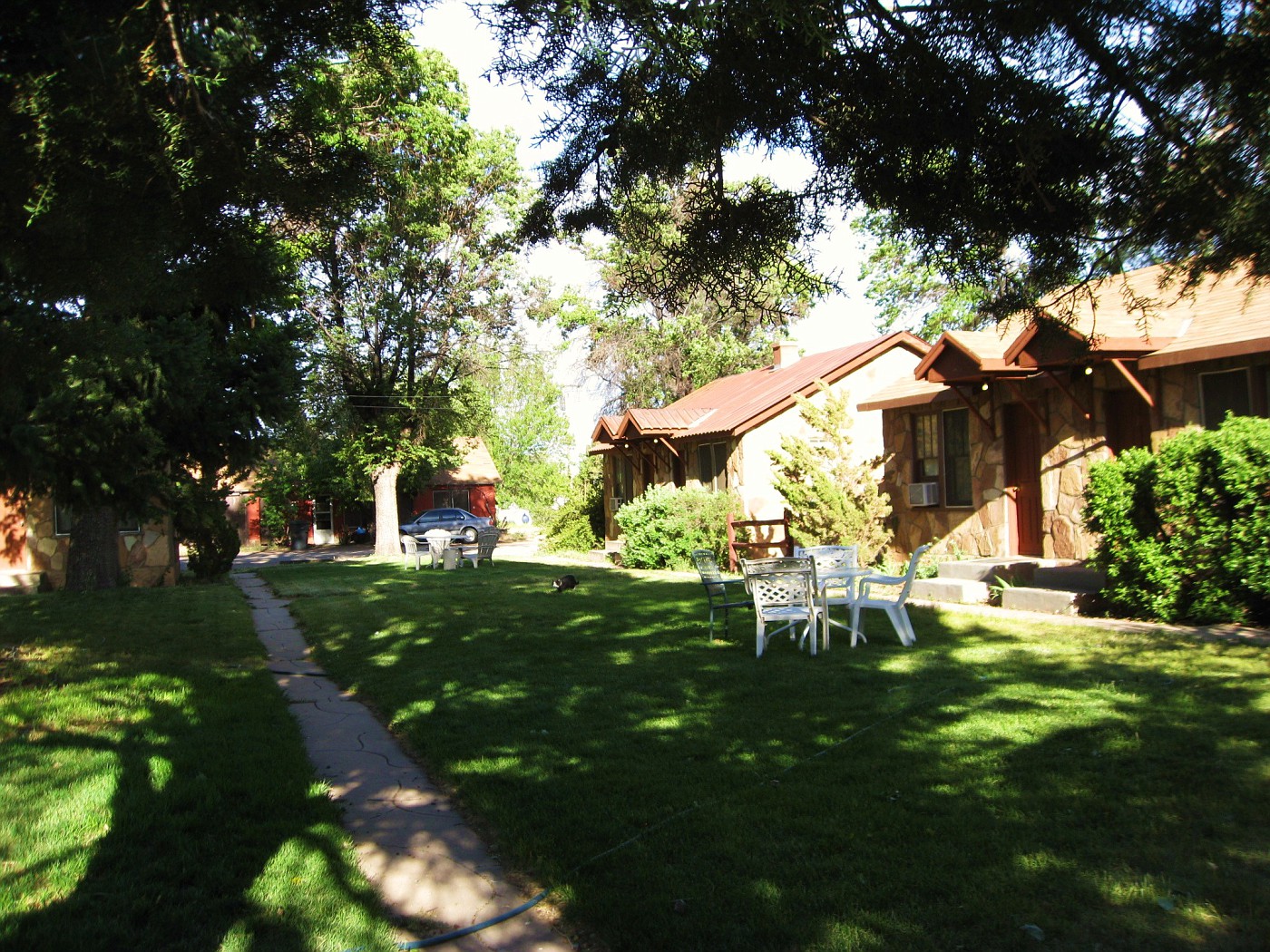
Cabins surround shady courtyard of the Grand Canyon Motel
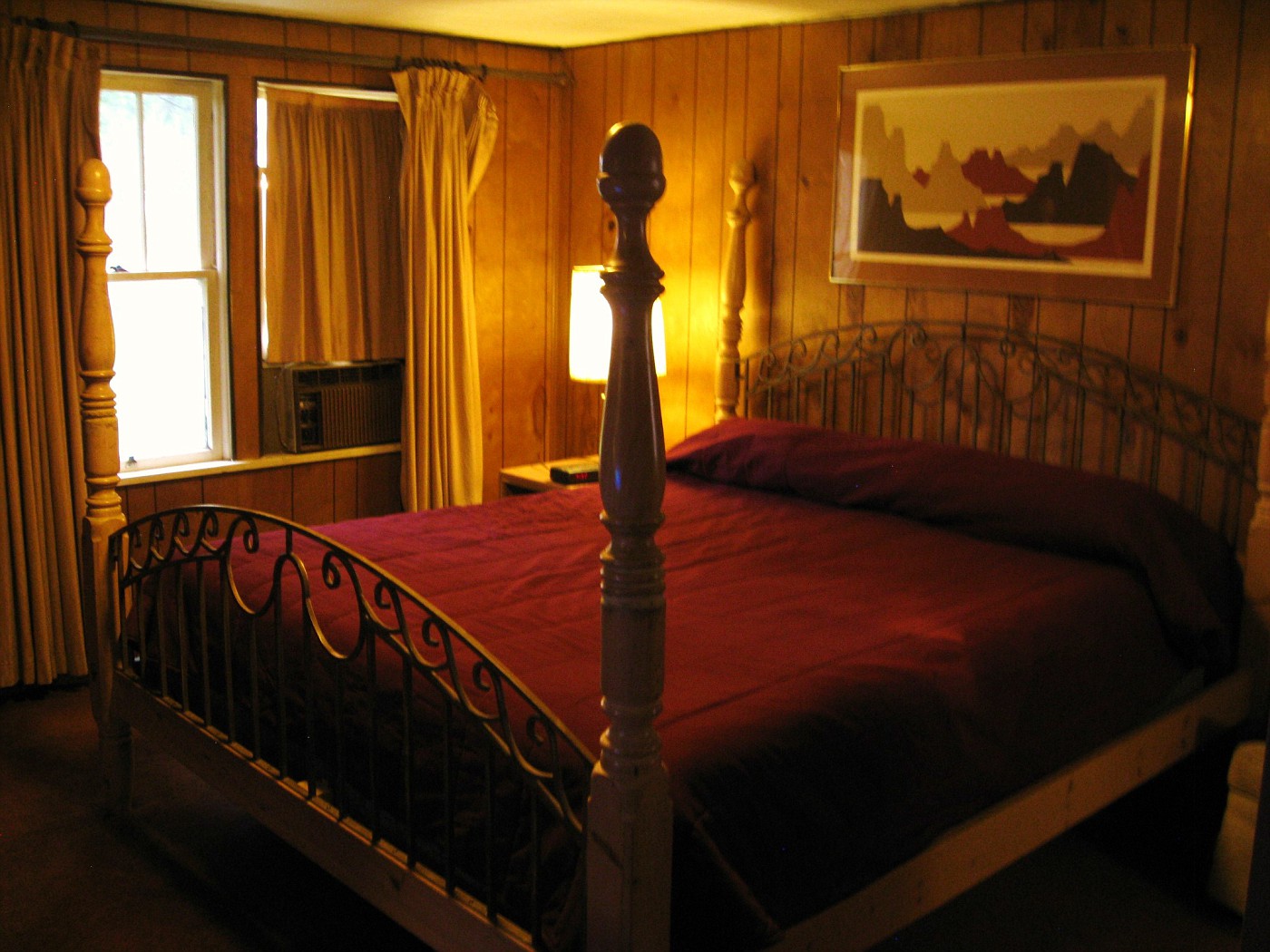
Old fashioned comfort at the Grand Canyon Motel
My next stop was Shoshone, California, located on the southeastern outskirts of Death Valley National Park. As of the 2010 census, the population of Shoshone was 31. With America’s population having recently soared over 300 million, it’s that much nicer to find quiet little desert oases such as this. The 16 room Shoshone Inn was built in 1958 and is the only motel for miles around.
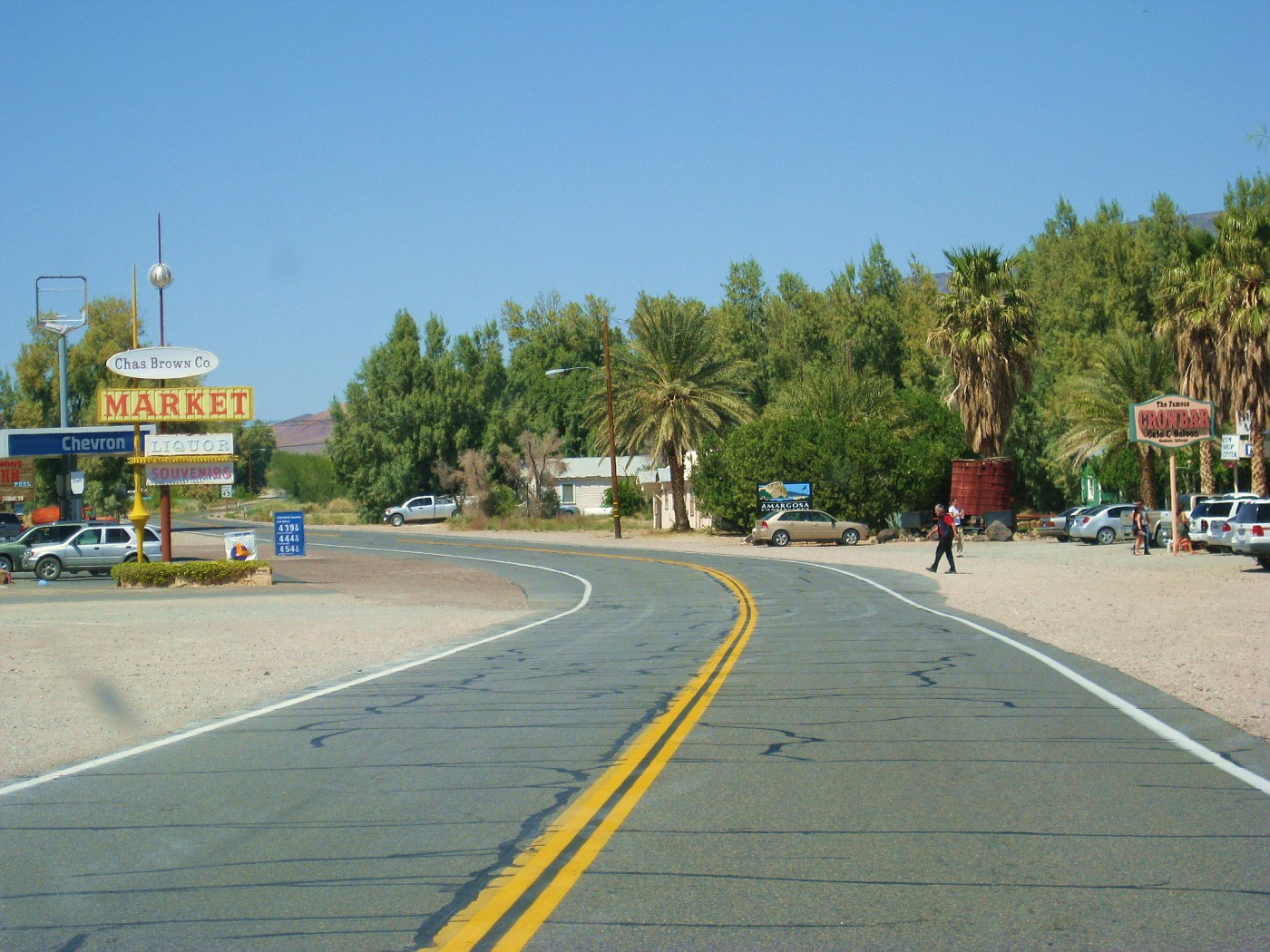
Shoshone, California
This is it – the entire town. You can just make out the sign for the Shoshone Inn on the left.
On the right is the Crow bar – the only restaurant/bar in town.
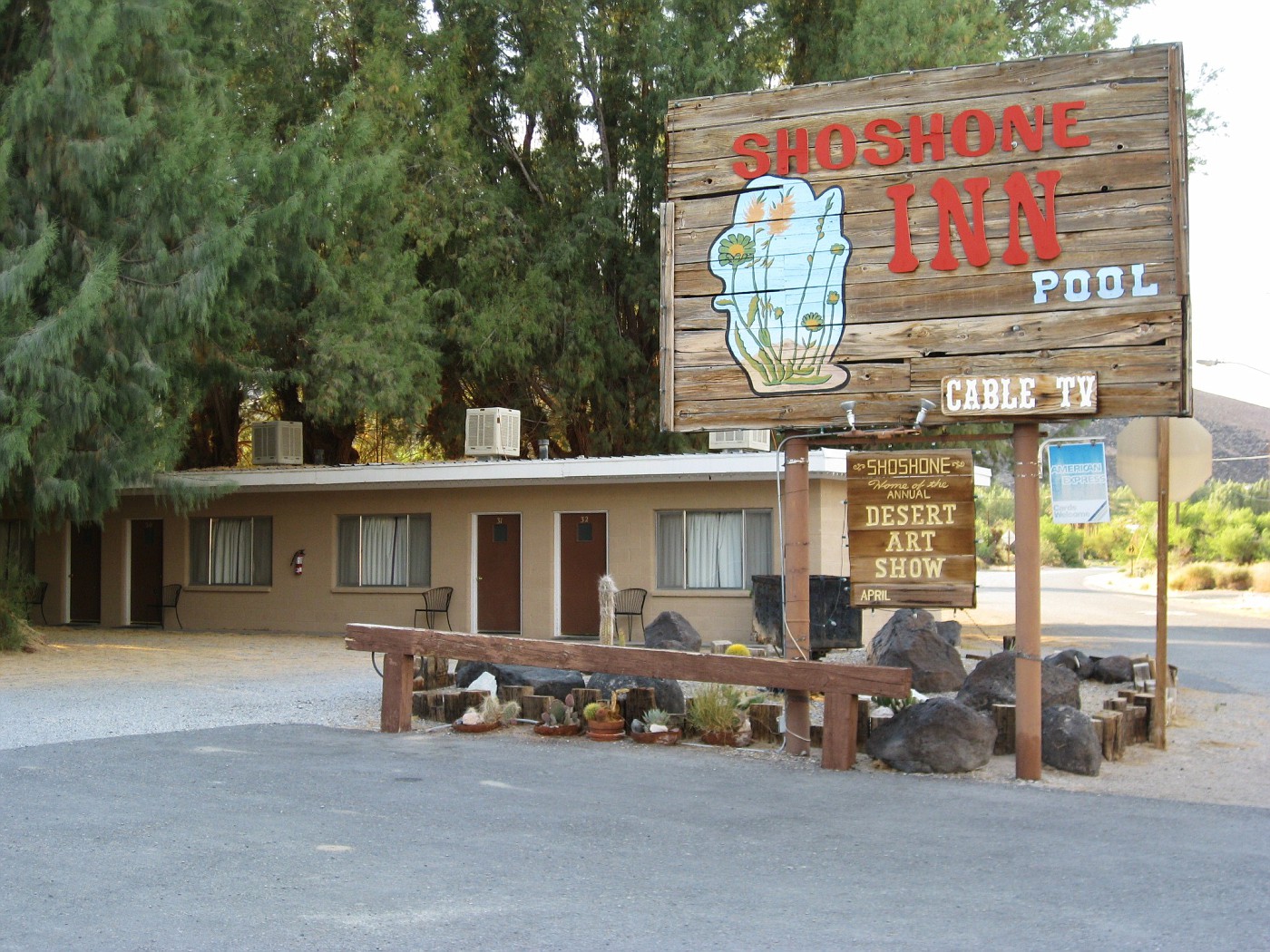
The Shoshone Inn
I love the rustic wooden sign.
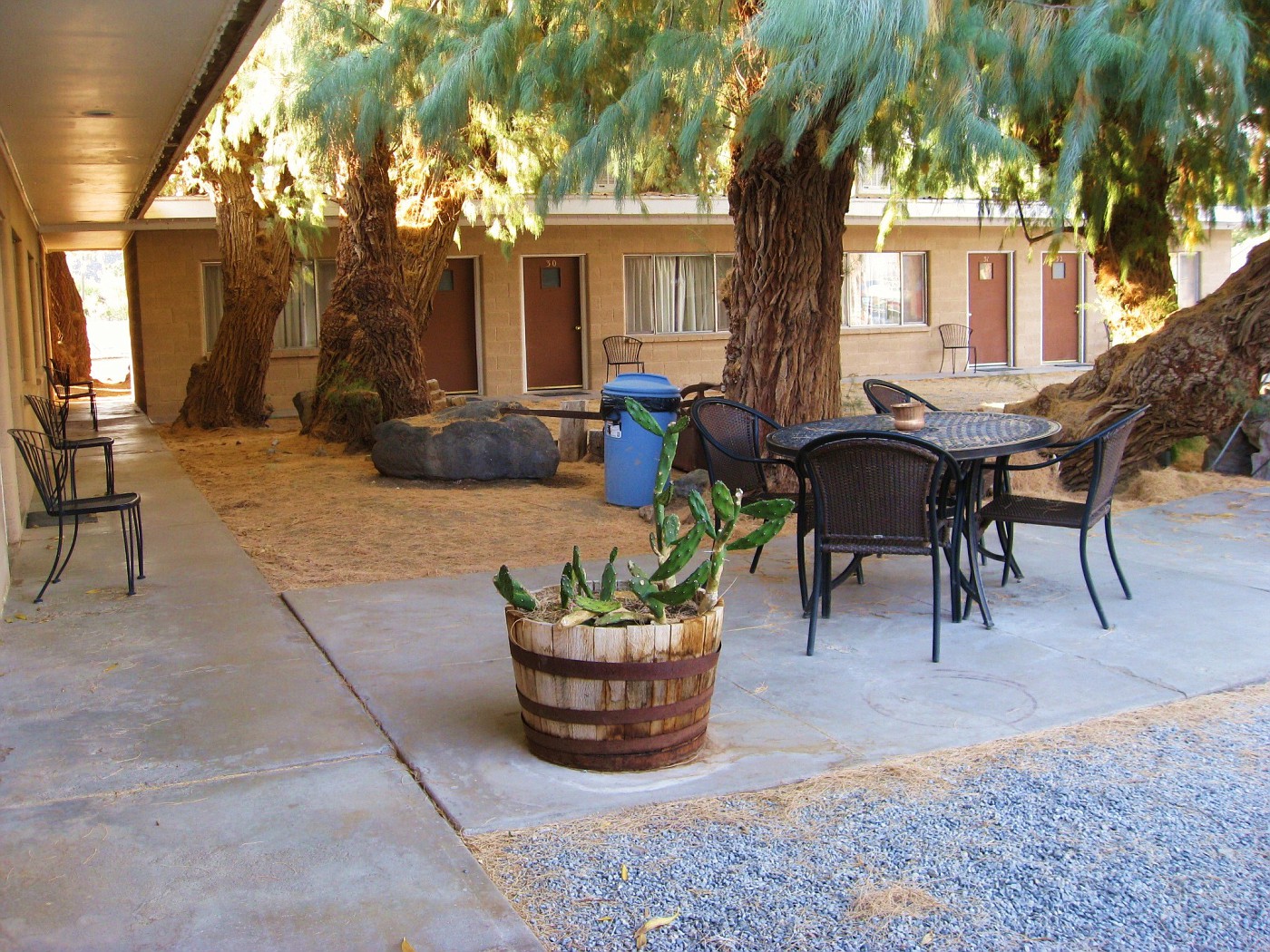
Courtyard under the salt cedar trees at the Shoshone Inn
There’s nothing finer than sitting in the courtyard as the evening cools off while enjoying ice cold beer and trading stories with your fellow road warriors. This motel is very popular with European visitors.
Now many people are put off by the notion of a visit to Death Valley because they fear it will be too hot. To be sure, the hottest temperature ever recorded there was 134°F – arguably the hottest ever recorded on the planet – but November through April are actually quite pleasant. Regardless of the temperature, visitors will find that Death Valley is one of the prettiest of our National Parks with beautiful multi-colored mountains, rugged canyons and vast basins that once were ocean floor. There’s even a fancy hotel in the park!

Zabriskie Point – Death Valley National Park

Artist’s Palette - Death Valley National Park
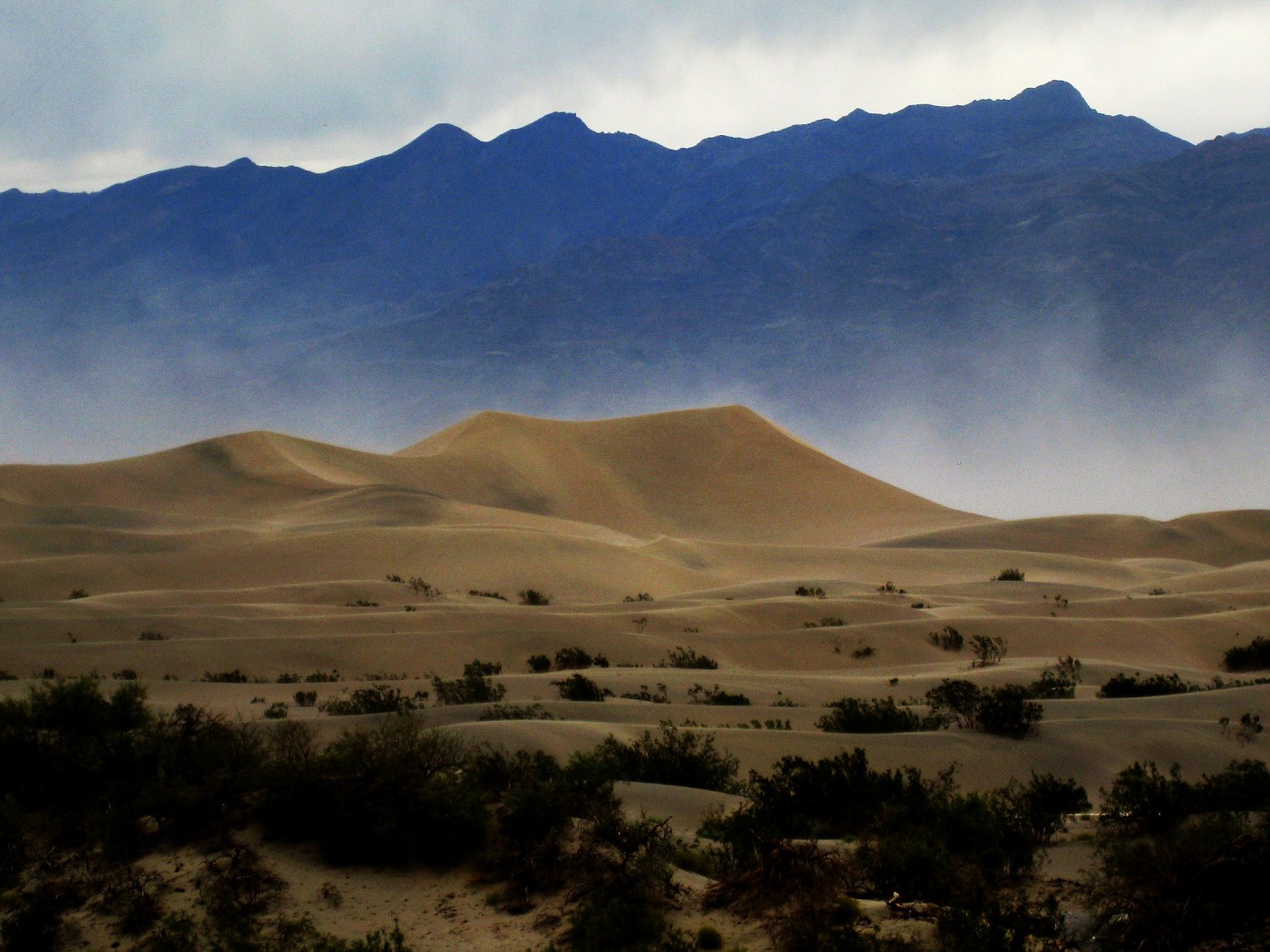
Sand Dunes in the shadow of the Panamint Mountains - Death Valley National Park
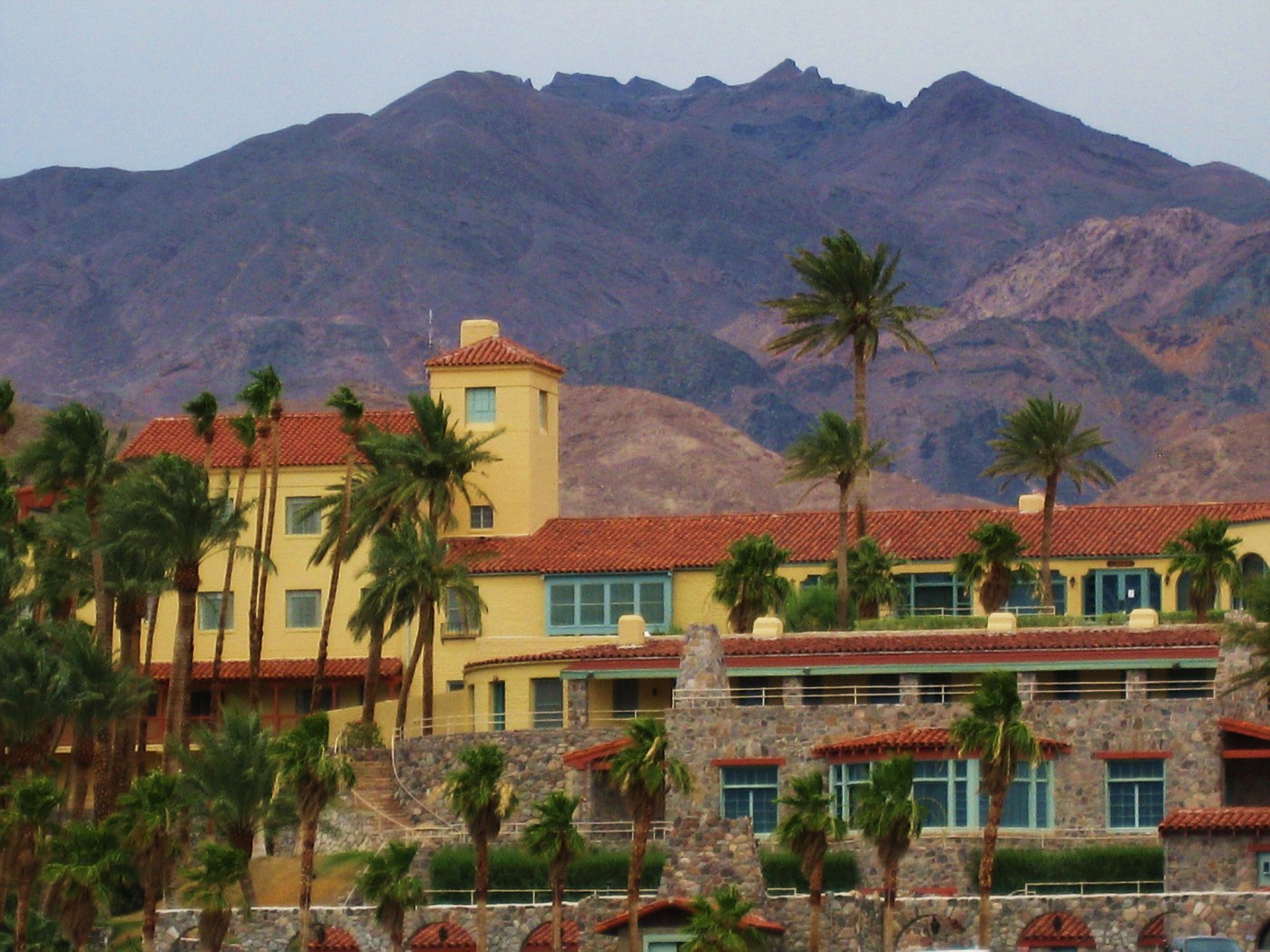
The Furnace Creek Inn - Death Valley National Park
California Highway 127 delivered me down to Baker, California – home to the world’s largest thermometer. I would have taken a picture but it wasn’t working and besides, the temperature was only 87°. Baker’s a bit of a sad town – it seems every time I go through there something new has closed down. These days it’s not much more than a collection of gas stations and fast food restaurants, although one restaurant – the Mad Greek Café – does stand out. I stopped in for a gyro and then sped off up the highway to exit 272. The Cima Road to Mojave National Monument.
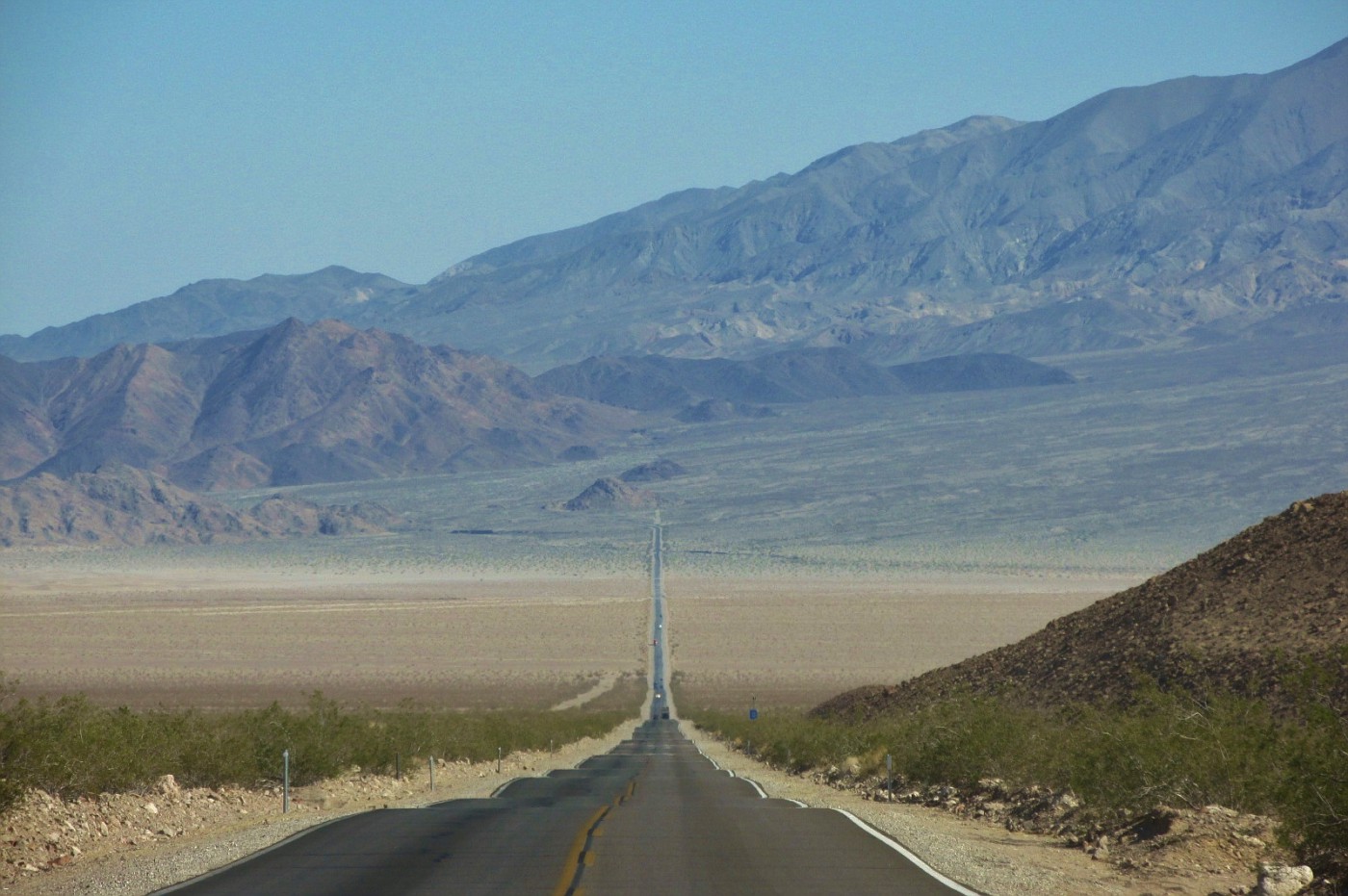
Southbound and down on CA Highway 127
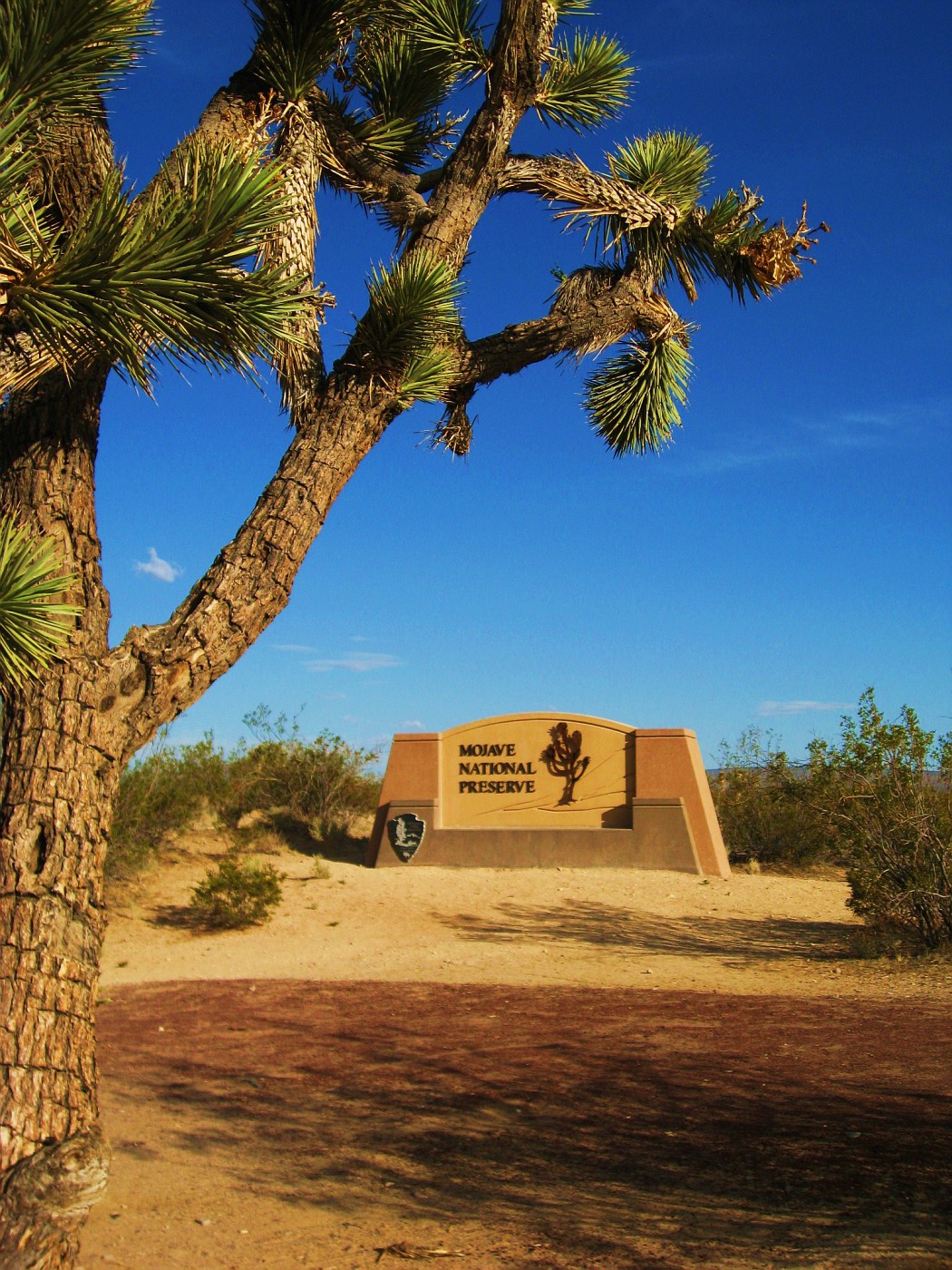
Mojave National Preserve
The third largest preserve in the United States

Mojave Landscape
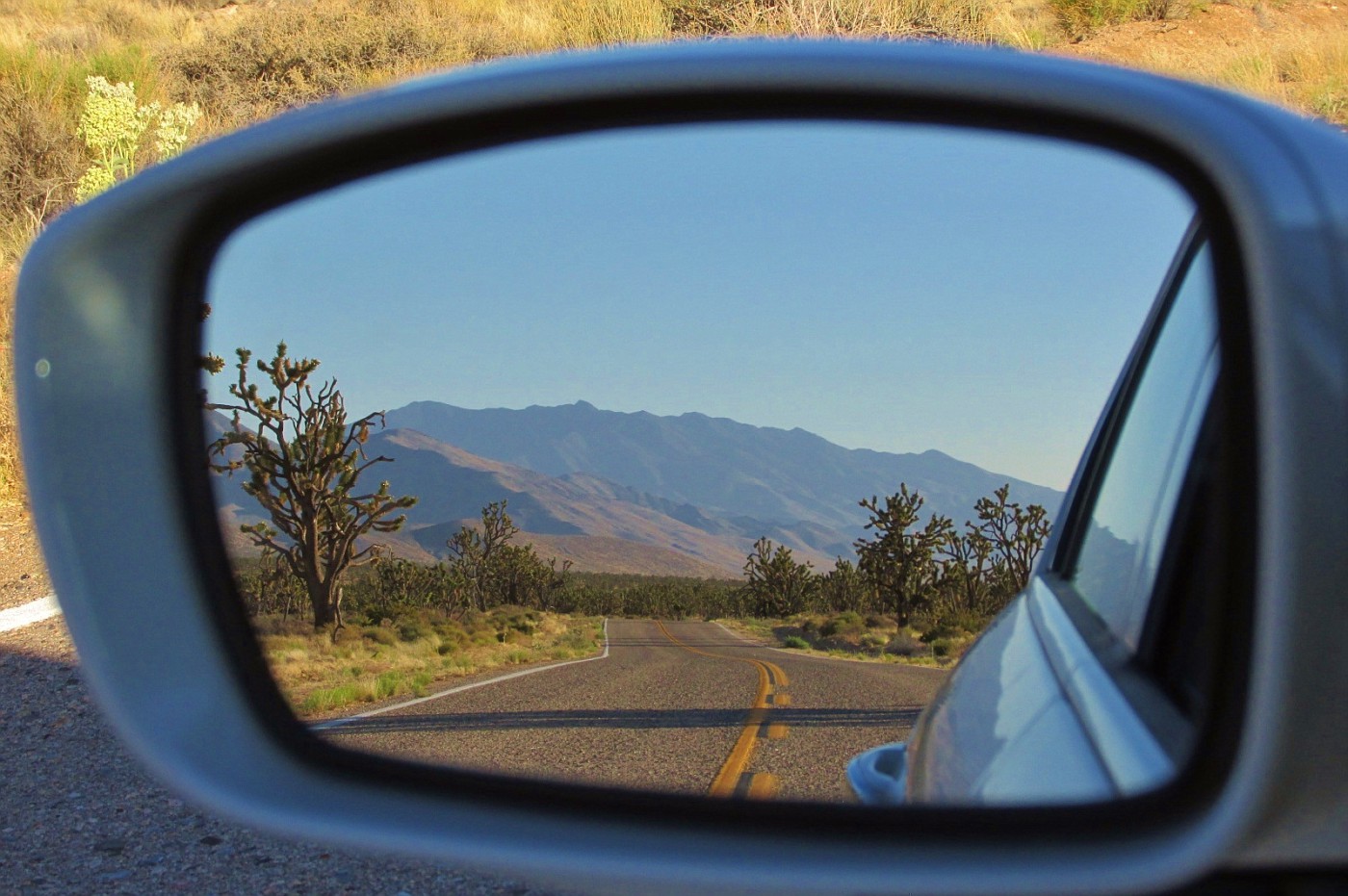
Rearview Mirror – Cima Road
There’s about a fifteen mile stretch where the Union Pacific mainline runs alongside or nearby the Cima/Kelso Road. For train spotters like me, this presents some excellent photographic opportunities. One of those opportunities was a pure stroke of luck as I just happened to be driving the road on the very same day that the UP’s “Big Boy” – one of the largest steam locomotives ever built – was being transported from Los Angeles to the Union Pacific's Steam Shop in Cheyenne, Wyoming. There it will spend the next three to five years being restored to operating condition, after which it will be used for excursion trains. I was wondering why there was a larger than normal number of photographers parked out along the road!
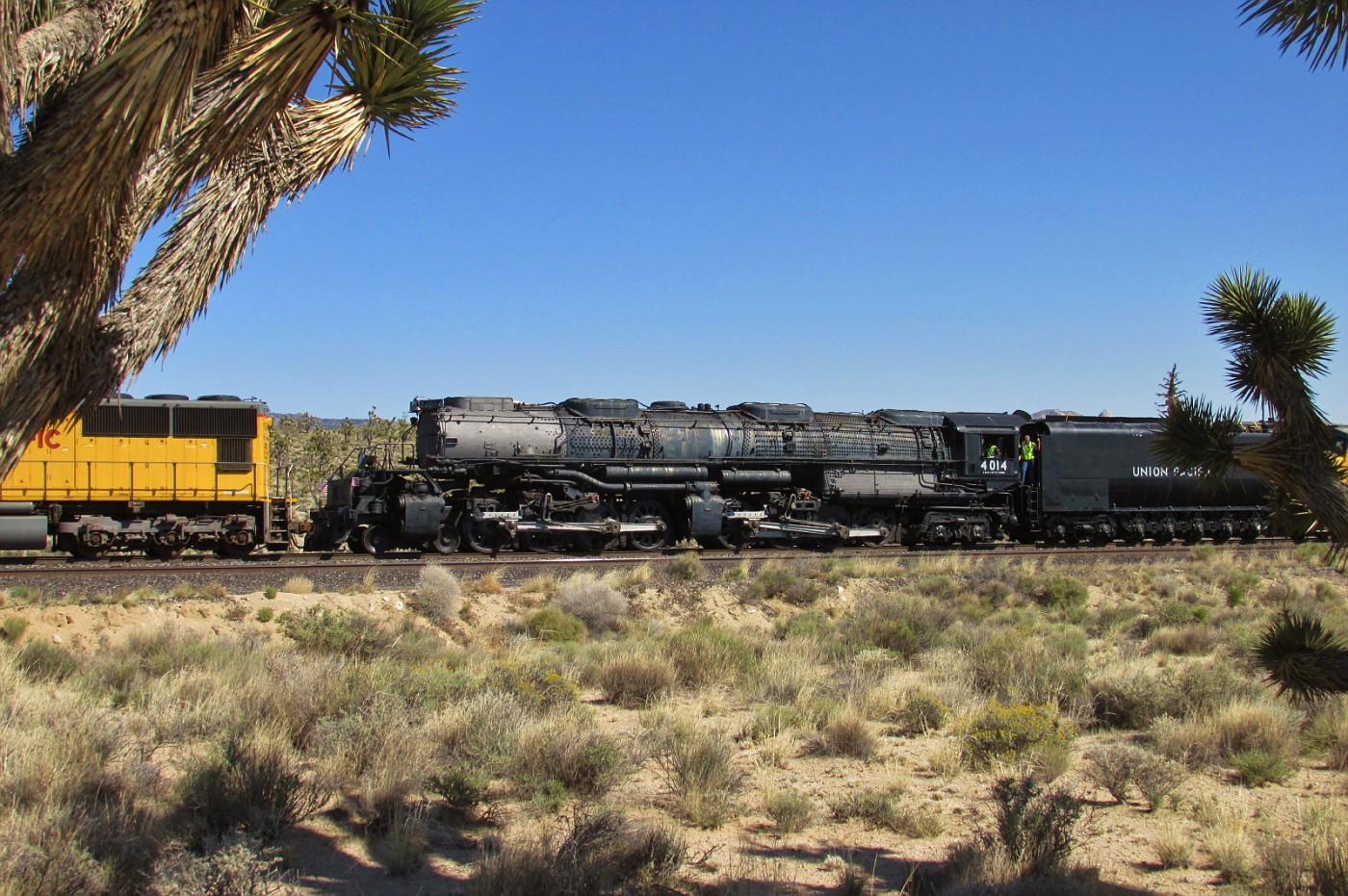
Union Pacific’s Big Boy
Headed home to Wyoming
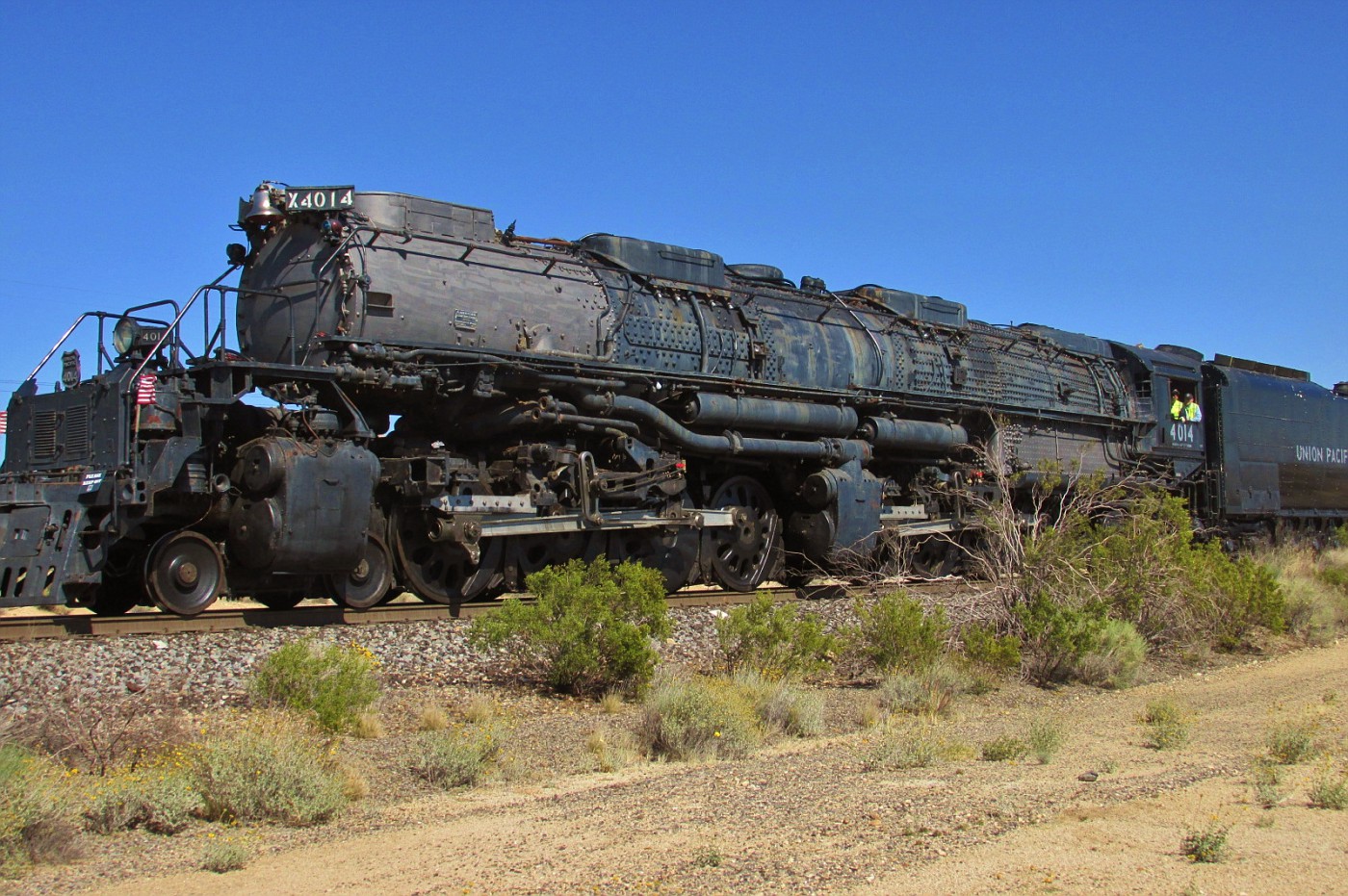
Union Pacific’s Big Boy
Unlike plane spotting, you can walk right up next to the tracks out here
The Mojave National Preserve is managed by the National Park Service. Its headquarters and visitor center are located in the old train depot at Kelso, California, a railroad and mining town that was once home to about 2000 residents but is for all intents and purposes a ghost town today. Kelso is one of those places that you’ve got to want to get to. It’s far enough off the main routes that I can’t imagine anybody ending up there by accident.
The Kelso Depot is no mere train station, however. It is a work of art!
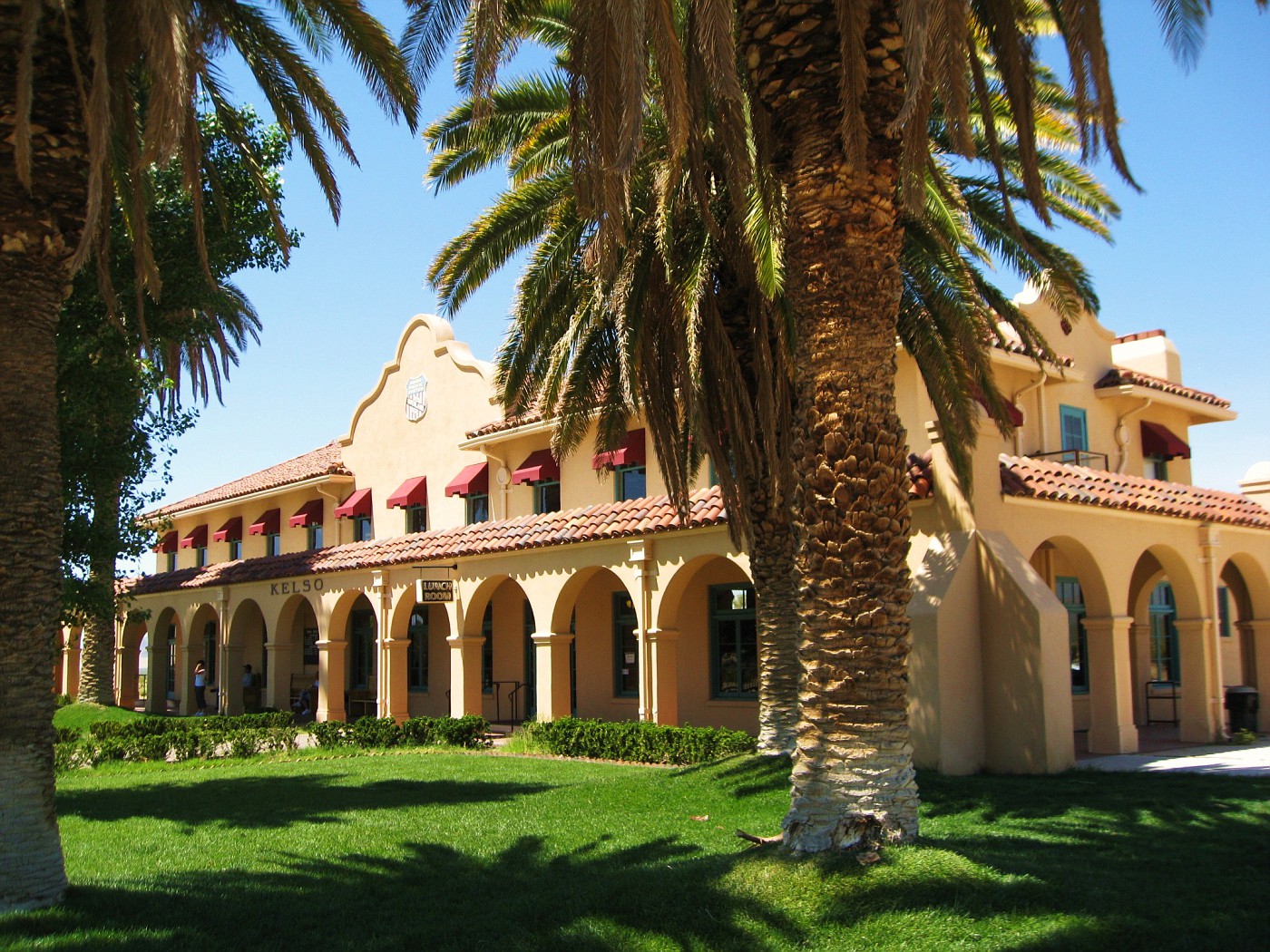
The Union Pacific Depot at Kelso
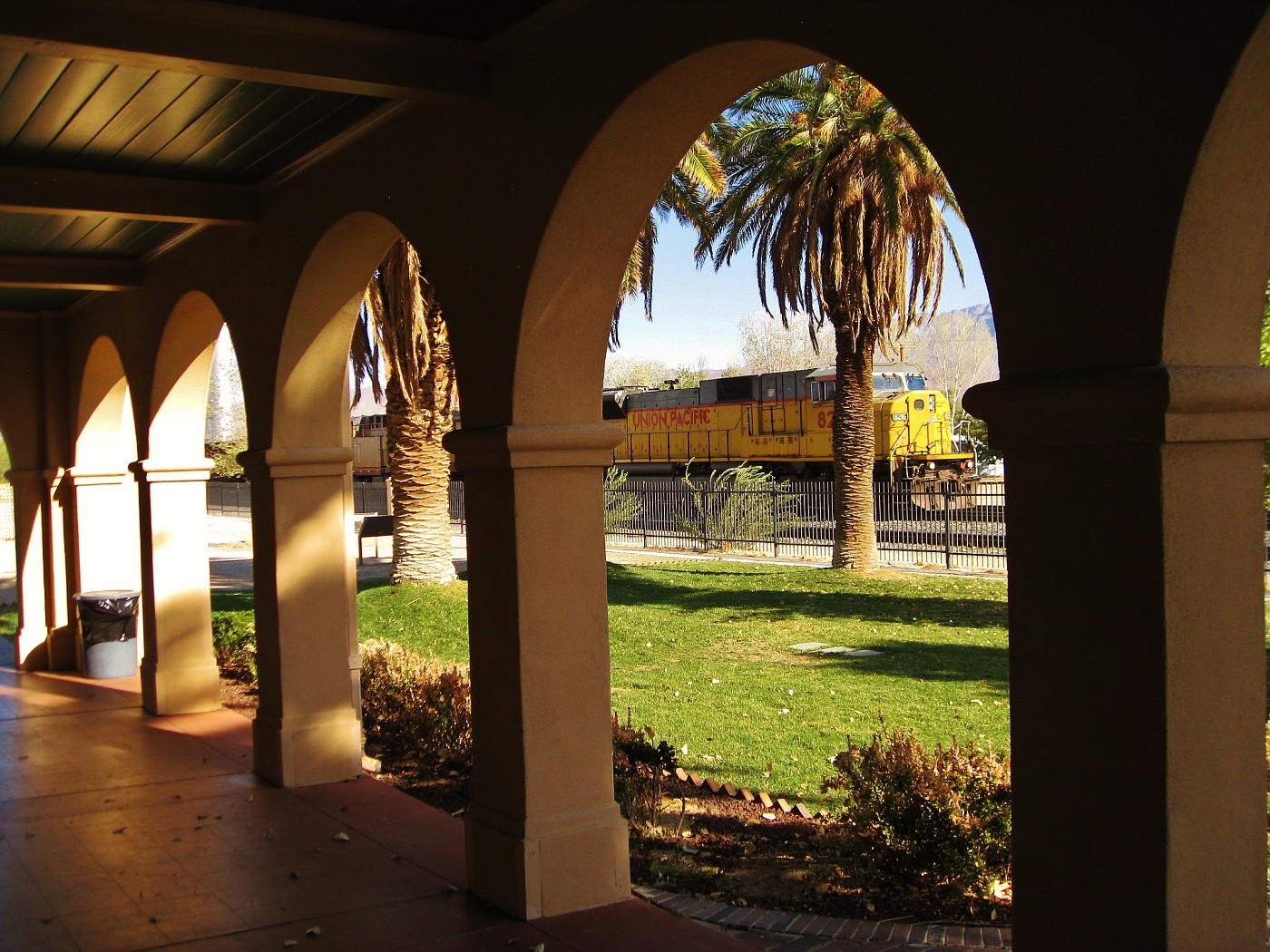
A Union Pacific freight passes through enroute to LA
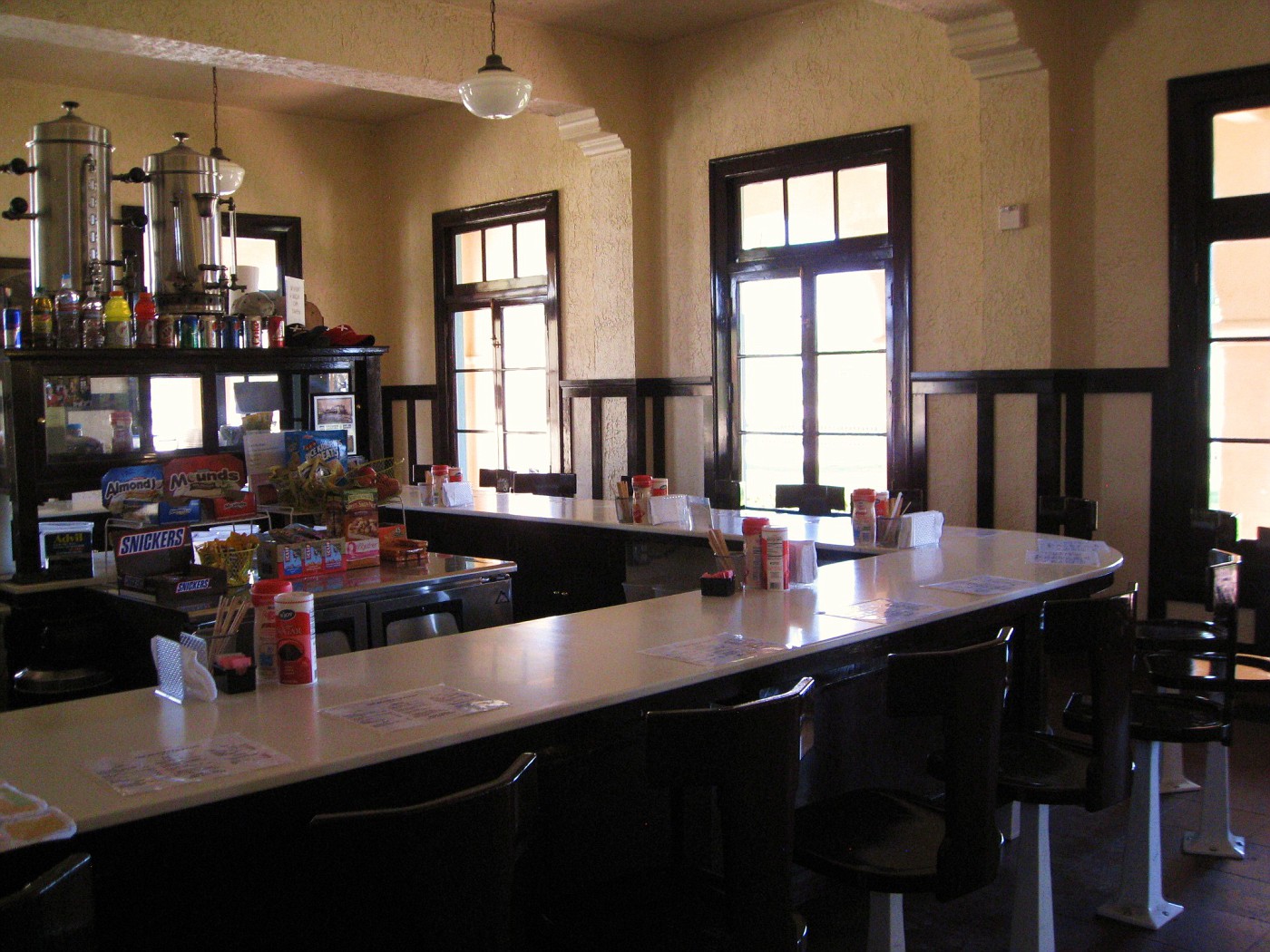
The Kelso Lunch Counter
Sadly, this is not currently in operation. NPS is accepting concession proposals should anyone want to operate it.
The question most people ask is “Why would they build such a beautiful depot in such a forlorn place as Kelso?” Allow me to quote from the National Park Service’s guidebook:
In the early 1920s, the Los Angeles & Salt Lake Railroad began planning for new depots, restaurants and employee facilities at several towns, including Kelso. Competition with the Santa Fe Railway was tight and rail passengers had become accustomed to their famously stylish Harvey House train stations. Therefore, railroad managers chose to design the new buildings on the Salt Lake Route in the Spanish Mission Revival style.
There were three stations built along this style. They are located in Kelso, Caliente, NV and Milford, UT. I’ve also been to the Caliente Depot which is now home to the Caliente city hall, the town library and an art gallery. Sadly, the Milford Depot was razed in 1979, two years before I first showed up looking for it. The Kelso Depot was closed in 1985 and by 1992 was slated for demolition. Were it not for the intervention of a few dedicated individuals and valuable help from local members of Congress, the Kelso Depot would have suffered a similar fate to Milford’s.
In any event, I always make it a point to stop at the Kelso Depot whenever I drive this road. As a fellow “Parkie” myself, it’s always nice to say hello to the NPS folks as well as check out the book store to see if anything new and interesting has been published. As it is I’d like to buy about half the inventory in there.
From Kelso the road continues another 18 miles down to Interstate 40. From there I usually like to continue on and pick up Route 66 which runs about 10 miles south of I-40 but it was getting late in the day and I love driving Goffs Road at sunset. Goffs Road actually was Route 66 until 1931 when a more direct road opened between Needles and Essex. Anyway, it was just a short drive down I-40 until I reached the Goffs Road junction.
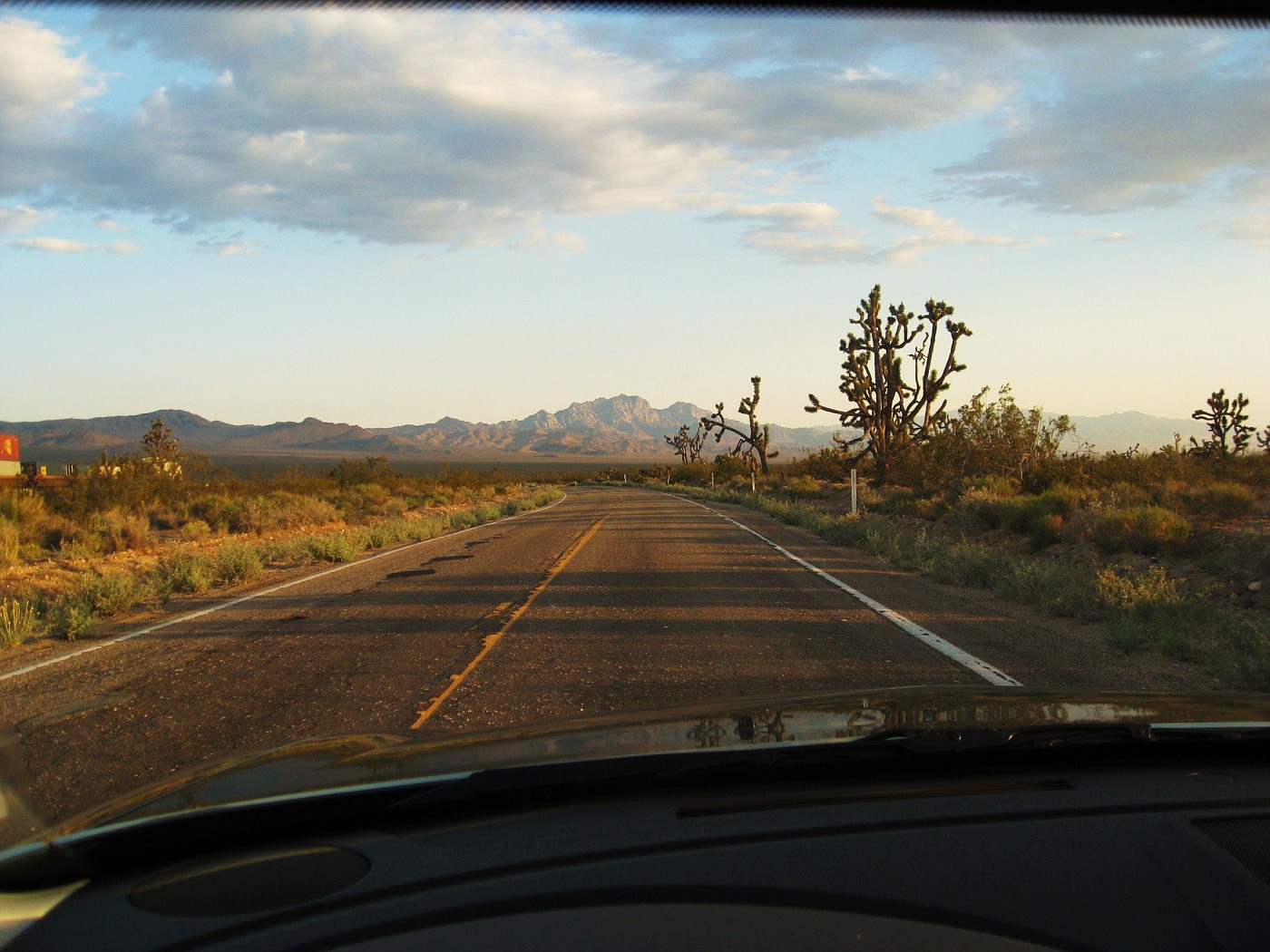
Late day shadows on the Kelso Road

Joshua Tree at Sunset
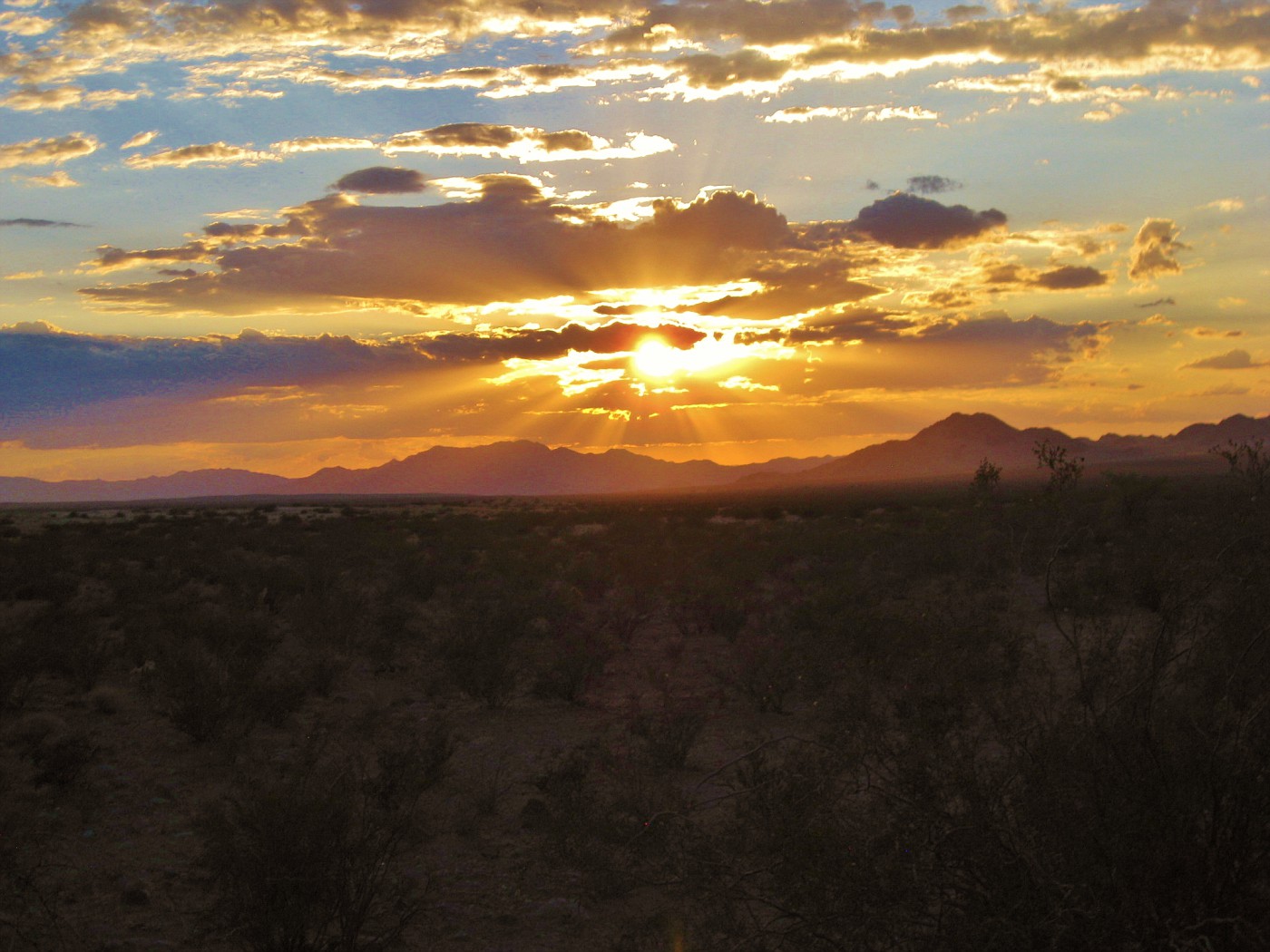
Setting sun at the I-40 junction
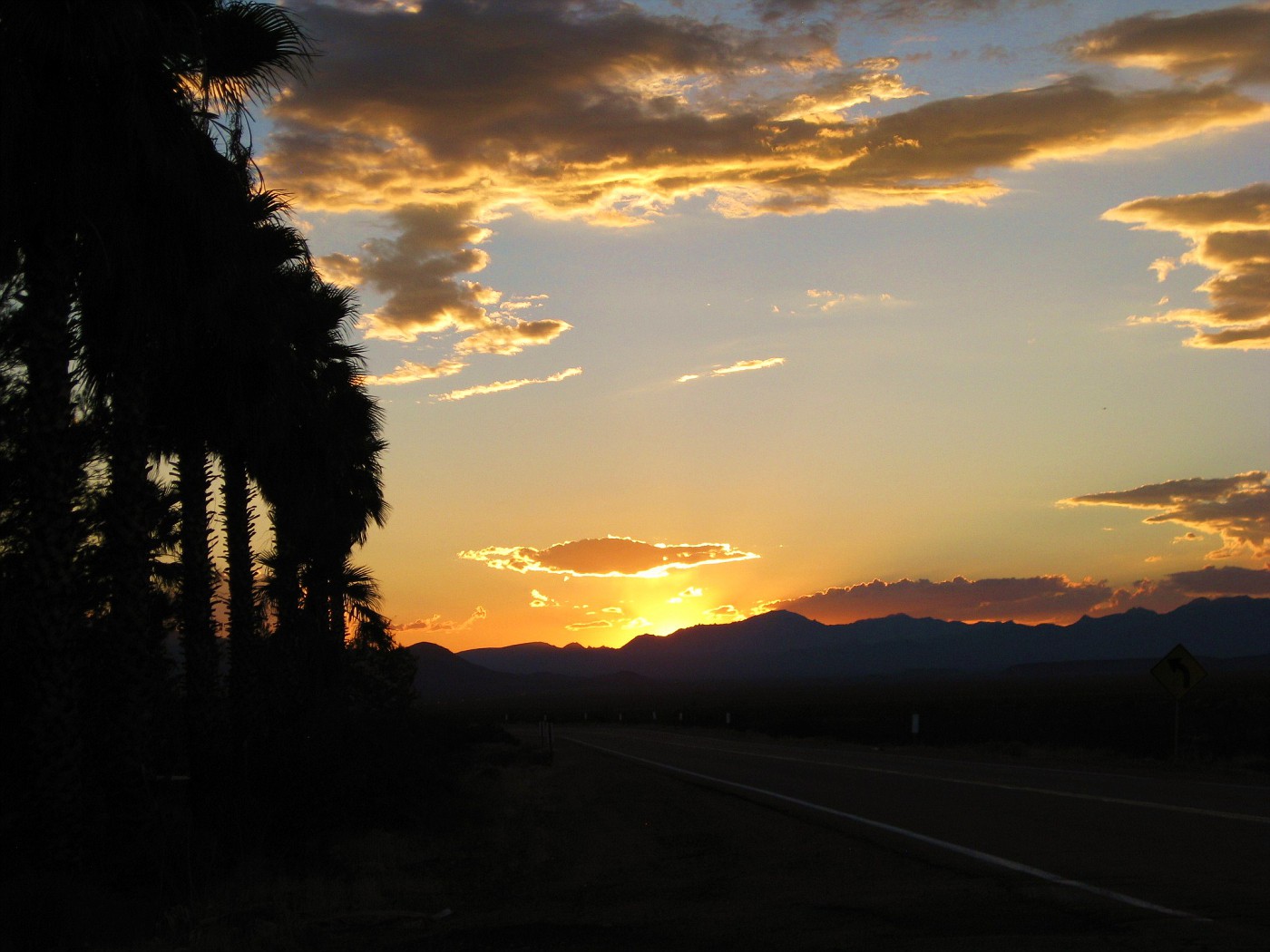
Sunset on Goffs Road
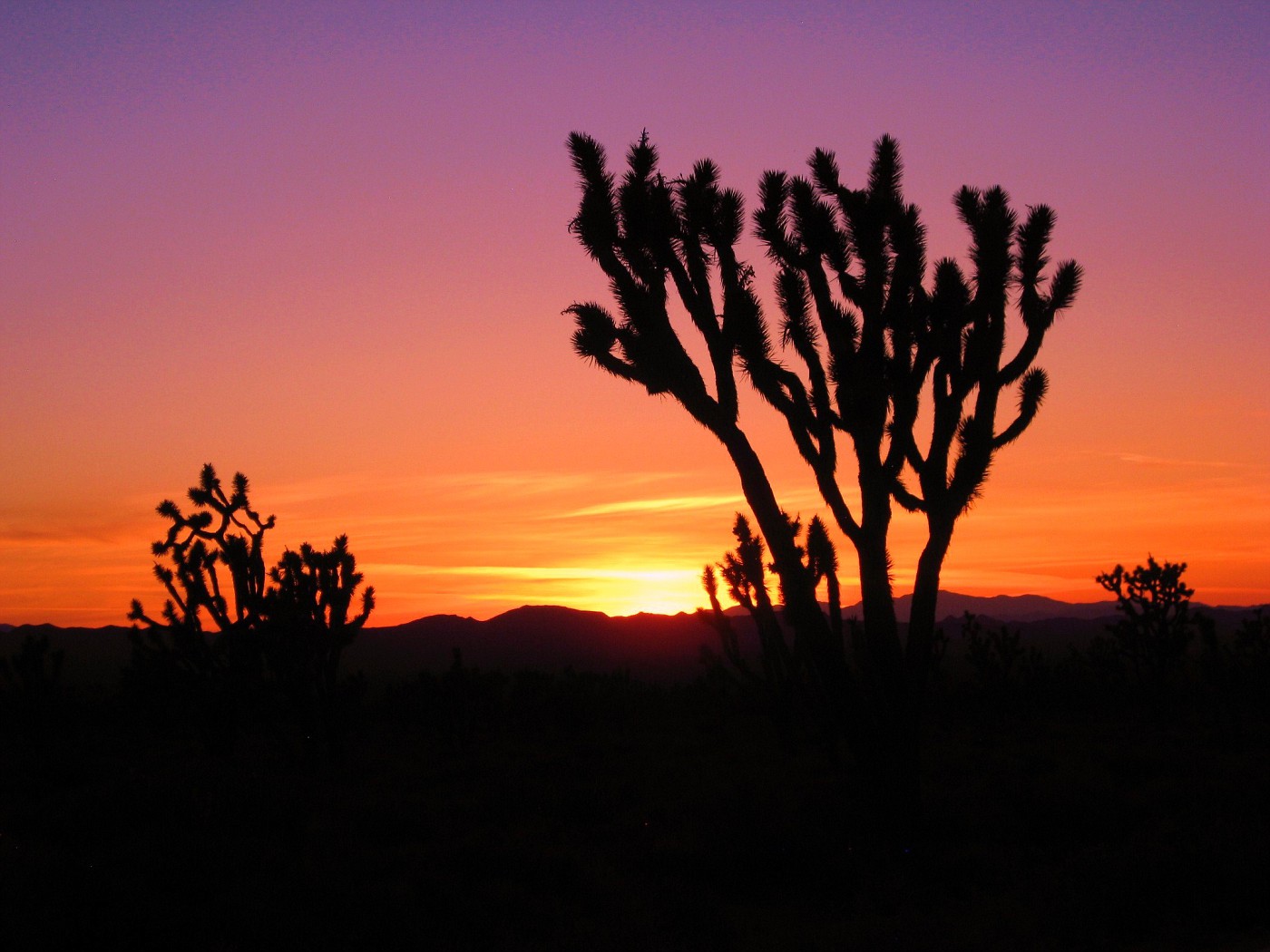
One last Joshua Tree Sunset
I spent the night back at the River Valley Inn in Needles, then drove all the way to San Diego the next day. I had a quick transcon mileage run coming up followed by a trip to Boston to see a baseball game at venerable Fenway Park. But first, I was looking forward to spending the night in yet another of my favorite old motels.
I discovered the Kings Inn last year while taking a day off during a mega-Mileage Run based out of San Diego. Located just off Interstate 8 in Mission Valley’s Hotel Circle, the Kings Inn is advertised as a budget motel but is much more than that meager appellation suggests. Built in 1959, it offers 140 rooms, two restaurants and a classic kidney shaped swimming pool in the courtyard. The rooms come with all of the usual amenities including a small refrigerator and 32 inch LCD televisions with dozens of cable channels. Check out my room and the view out my door:
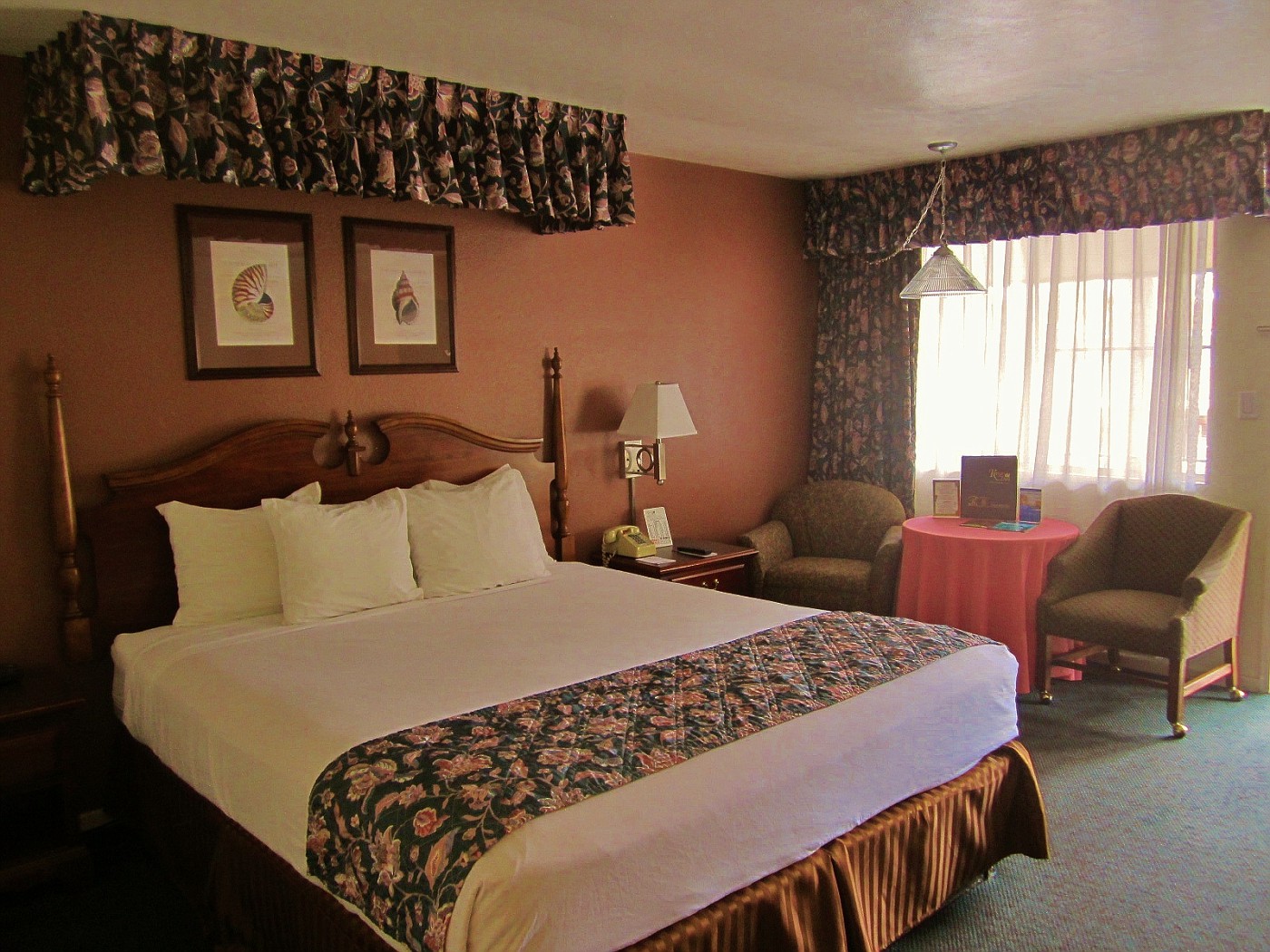
Kings Inn Motel ~ Deluxe King

Kings Inn Motel ~ The view from my room
While some people might be put off by the notion of staying in rooms decorated in 1960s revival style, I thought the furnishings and amenities were just fine. My bed in particular was very comfortable. The hotel bar offered free appetizers that included hot taquitos – one of my favorites – to go with a nice selection of good cold beer. In the morning I had breakfast in the Waffle Spot, a classic 1970s era coffee shop. After running a load of laundry, I repacked and headed out to Lindbergh Field where I returned the rental car and checked in for my early afternoon departure to San Francisco and on to Boston.
In a roundabout way
I grew up in Colorado and even as a young kid I was enamored of the landscape of the west and the roads that travel through it. This is such a beautiful part of the country that for me at least, no trip down here is complete without some form of road trip. In so doing I address three of my major likes – driving through this spectacular region, staying in old motels and enjoying the local flavor and culture found in local cafes and restaurants.
It was near 6:00pm by the time I accelerated up the onramp onto Interstate 40 and left Williams in my rearview mirror. I spent the evening in Flagstaff before continuing on the next day through Monument Valley and on up US 191 to Green River, Utah.

Monument Valley as seen through an abandoned Navajo jewelry stand

Rolling through shallow canyons on US 191 south of Moab, Utah

The Sleepy Hollow Motel in Green River Utah
After a long day of driving through canyon country, this motel offers large rooms and great value.
I’ve probably spent thirty nights here over the years.
Though I generally advocate getting off the Interstate and onto the smaller roads, there are not any other east-west options out of Green River and the route west to Salinas provides some spectacular views of Utah’s gorgeous Canyon Country.

Beautiful buttes west of Green River

White Canyon
There’s an overlook off Interstate 70 for this view

Eagle Canyon
As seen from Interstate 70
Turning south at Richfield, Utah, I headed down US 89 where I stopped for a Mexican dinner in Kanab before continuing on to Fredonia, Arizona. Most of the tourists prefer to stay up in Kanab with its many hotels and restaurants. That’s all well and good but they are missing a real gem just 10 miles down the road in Fredonia.
As viewed from the outside, the Grand Canyon Motel looks pretty run down. Appearances can be deceiving however. Just around the back side of the old adobe main building is a beautiful shady courtyard surrounded by six rock cabin duplexes. Originally built as a hunting lodge in the early 1900s, it was converted into a motel in the 1970s. The old couple who own it have an affection for stray cats and leave plenty of food out for the dozen or so that wander the property. At $38.00 per night, it’s a comfortable and quiet place to stay.

Grand Canyon Motel ~ Fredonia, Arizona
Would YOU stay here?

Cabins surround shady courtyard of the Grand Canyon Motel

Old fashioned comfort at the Grand Canyon Motel
My next stop was Shoshone, California, located on the southeastern outskirts of Death Valley National Park. As of the 2010 census, the population of Shoshone was 31. With America’s population having recently soared over 300 million, it’s that much nicer to find quiet little desert oases such as this. The 16 room Shoshone Inn was built in 1958 and is the only motel for miles around.

Shoshone, California
This is it – the entire town. You can just make out the sign for the Shoshone Inn on the left.
On the right is the Crow bar – the only restaurant/bar in town.

The Shoshone Inn
I love the rustic wooden sign.

Courtyard under the salt cedar trees at the Shoshone Inn
There’s nothing finer than sitting in the courtyard as the evening cools off while enjoying ice cold beer and trading stories with your fellow road warriors. This motel is very popular with European visitors.
Now many people are put off by the notion of a visit to Death Valley because they fear it will be too hot. To be sure, the hottest temperature ever recorded there was 134°F – arguably the hottest ever recorded on the planet – but November through April are actually quite pleasant. Regardless of the temperature, visitors will find that Death Valley is one of the prettiest of our National Parks with beautiful multi-colored mountains, rugged canyons and vast basins that once were ocean floor. There’s even a fancy hotel in the park!

Zabriskie Point – Death Valley National Park

Artist’s Palette - Death Valley National Park

Sand Dunes in the shadow of the Panamint Mountains - Death Valley National Park

The Furnace Creek Inn - Death Valley National Park
California Highway 127 delivered me down to Baker, California – home to the world’s largest thermometer. I would have taken a picture but it wasn’t working and besides, the temperature was only 87°. Baker’s a bit of a sad town – it seems every time I go through there something new has closed down. These days it’s not much more than a collection of gas stations and fast food restaurants, although one restaurant – the Mad Greek Café – does stand out. I stopped in for a gyro and then sped off up the highway to exit 272. The Cima Road to Mojave National Monument.

Southbound and down on CA Highway 127

Mojave National Preserve
The third largest preserve in the United States

Mojave Landscape

Rearview Mirror – Cima Road
There’s about a fifteen mile stretch where the Union Pacific mainline runs alongside or nearby the Cima/Kelso Road. For train spotters like me, this presents some excellent photographic opportunities. One of those opportunities was a pure stroke of luck as I just happened to be driving the road on the very same day that the UP’s “Big Boy” – one of the largest steam locomotives ever built – was being transported from Los Angeles to the Union Pacific's Steam Shop in Cheyenne, Wyoming. There it will spend the next three to five years being restored to operating condition, after which it will be used for excursion trains. I was wondering why there was a larger than normal number of photographers parked out along the road!

Union Pacific’s Big Boy
Headed home to Wyoming

Union Pacific’s Big Boy
Unlike plane spotting, you can walk right up next to the tracks out here
The Mojave National Preserve is managed by the National Park Service. Its headquarters and visitor center are located in the old train depot at Kelso, California, a railroad and mining town that was once home to about 2000 residents but is for all intents and purposes a ghost town today. Kelso is one of those places that you’ve got to want to get to. It’s far enough off the main routes that I can’t imagine anybody ending up there by accident.
The Kelso Depot is no mere train station, however. It is a work of art!

The Union Pacific Depot at Kelso

A Union Pacific freight passes through enroute to LA

The Kelso Lunch Counter
Sadly, this is not currently in operation. NPS is accepting concession proposals should anyone want to operate it.
The question most people ask is “Why would they build such a beautiful depot in such a forlorn place as Kelso?” Allow me to quote from the National Park Service’s guidebook:
In the early 1920s, the Los Angeles & Salt Lake Railroad began planning for new depots, restaurants and employee facilities at several towns, including Kelso. Competition with the Santa Fe Railway was tight and rail passengers had become accustomed to their famously stylish Harvey House train stations. Therefore, railroad managers chose to design the new buildings on the Salt Lake Route in the Spanish Mission Revival style.
There were three stations built along this style. They are located in Kelso, Caliente, NV and Milford, UT. I’ve also been to the Caliente Depot which is now home to the Caliente city hall, the town library and an art gallery. Sadly, the Milford Depot was razed in 1979, two years before I first showed up looking for it. The Kelso Depot was closed in 1985 and by 1992 was slated for demolition. Were it not for the intervention of a few dedicated individuals and valuable help from local members of Congress, the Kelso Depot would have suffered a similar fate to Milford’s.
In any event, I always make it a point to stop at the Kelso Depot whenever I drive this road. As a fellow “Parkie” myself, it’s always nice to say hello to the NPS folks as well as check out the book store to see if anything new and interesting has been published. As it is I’d like to buy about half the inventory in there.
From Kelso the road continues another 18 miles down to Interstate 40. From there I usually like to continue on and pick up Route 66 which runs about 10 miles south of I-40 but it was getting late in the day and I love driving Goffs Road at sunset. Goffs Road actually was Route 66 until 1931 when a more direct road opened between Needles and Essex. Anyway, it was just a short drive down I-40 until I reached the Goffs Road junction.

Late day shadows on the Kelso Road

Joshua Tree at Sunset

Setting sun at the I-40 junction

Sunset on Goffs Road

One last Joshua Tree Sunset
I spent the night back at the River Valley Inn in Needles, then drove all the way to San Diego the next day. I had a quick transcon mileage run coming up followed by a trip to Boston to see a baseball game at venerable Fenway Park. But first, I was looking forward to spending the night in yet another of my favorite old motels.
I discovered the Kings Inn last year while taking a day off during a mega-Mileage Run based out of San Diego. Located just off Interstate 8 in Mission Valley’s Hotel Circle, the Kings Inn is advertised as a budget motel but is much more than that meager appellation suggests. Built in 1959, it offers 140 rooms, two restaurants and a classic kidney shaped swimming pool in the courtyard. The rooms come with all of the usual amenities including a small refrigerator and 32 inch LCD televisions with dozens of cable channels. Check out my room and the view out my door:

Kings Inn Motel ~ Deluxe King

Kings Inn Motel ~ The view from my room
While some people might be put off by the notion of staying in rooms decorated in 1960s revival style, I thought the furnishings and amenities were just fine. My bed in particular was very comfortable. The hotel bar offered free appetizers that included hot taquitos – one of my favorites – to go with a nice selection of good cold beer. In the morning I had breakfast in the Waffle Spot, a classic 1970s era coffee shop. After running a load of laundry, I repacked and headed out to Lindbergh Field where I returned the rental car and checked in for my early afternoon departure to San Francisco and on to Boston.
Last edited by Seat 2A; Jan 3, 2015 at 11:16 pm
#12
FlyerTalk Evangelist
Original Poster
Join Date: Apr 2001
Location: East Ester, Alaska
Programs: Alaska Million Miler, United Million Miler, Wyndham Rewards Diamond, Choice Hotels Diamond
Posts: 12,148
Day Twenty
United Airlines San Diego to San Francisco 224p – 345p A320-200 First Class
United Airlines San Francisco to Chicago 637p – 1253p 737-800 Coach Class
It’s always a good feeling to check in for your flights secure in the knowledge that both your upgrades have cleared and now all you have to do is sit back, relax and enjoy the trip. I started by paying a visit to the new United Club, located on the Mezzanine Level in the main terminal. United recently relocated from Terminal 1 into the newly renovated Terminal 2 and the new lounge, while quite bright and airy, is lacking some of the warmth and comfort of the old facility. I did like the seating out on the porch overlooking the concourse below though. Very nice.
The first sign of trouble came at the gate when our departure was delayed by twenty minutes. I had a 45 minute connection in San Francisco and so long as my connecting flight didn’t depart from over on the international terminal I should be okay. The plane was in, so one could only hope it wasn’t a lengthy mechanical situation of some sort.
Boarding was announced at 2:25pm and I settled into seat 2B where I gratefully accepted a bourbon on the rocks while we finished the boarding process. The bad news was delivered just a few minutes later. A power outage up in LA had shut down the computers that air traffic control uses to coordinate all flights arriving, departing or even flying over the region. As such, we wouldn’t be able to take off until they got the power back up.
Well then – there goes my transcon upgrade for this afternoon. Bummer… On a positive note my return flights to San Diego weren’t due to depart until 4:00pm the next day, so I had plenty of time to get to Boston. A quick call to United reservations got me rebooked to Boston, though hardly in the style I’d been looking forward to just a few minutes earlier.
My new reservations had me connecting in San Francisco to a 6:30pm flight to Chicago where I’d overnight before continuing on the next morning via Newark. I could’ve flown nonstop from Chicago to Boston but I didn’t want to get up for the 6:00am departure. The 8:05am Newark flight would allow me a couple of hours extra sleep and in my advancing years, that’s something I’ve really come to appreciate. The only real downside to this reservation was that no First Class was available on such short notice. Instead I had a choice of center seats on the flight to Chicago (I’ll take the exit row, please) and an aisle seat into Newark the next day. I was waitlisted for First on the EWR-BOS flight. But hey – at least I had seats booked and would arrive into Logan with plenty of time to make my return flights to San Diego, two of which were already confirmed in First Class.
So rather than bore you further with tales of middle seat misery to Chicago, suffice it to say that we arrived at O’Hare on schedule, whereupon I quickly set up camp and – with the help of Melatonin and a quarter hit of Ambien - knocked off a good five and a half hours of sleep.
Day Twenty One
Shuttle Express Chicago to Newark 805a – 1110a ERJ-170 Coach Class
United Airlines Newark to Boston 1230p – 140p A319-100 First Class
United Airlines Boston to Denver 400p – 648p 737-800 First Class
United Airlines Denver to San Francisco 740p – 924p 737-800 First Class
United Airlines San Francisco to San Diego 1055p – 1228p 737-800 Coach Class
By the time I woke up, broke camp, cleaned up and made it through security there was no time to visit the United Club for coffee and a Danish. That’s alright - United’s terminals at O’Hare offer a wide selection of coffee kiosks and eateries, so I had no problem finding a cup of coffee and a fairly decent breakfast sandwich.
I still find it a bit hard to believe that I’m flying aboard a regional jet between Chicago and Newark. I’ve flown this route on DC-10s and stretch 8s, not to mention all manner of 727s and 737s and now all it rates at 8:00am is a regional jet? Welcome to 2014, old boy.
Well if one must fly on a regional jet, Embraer’s RJ-170/190 family of jets is about as nice as it gets. Their cabins can comfortably accommodate spacious 2-2 seating in economy as well as a 1-2 configured First Class cabin. As an added plus, they are large enough to stand up in, They are a worthy successor to the BAe-146, my favorite regional jet of all time.
Flight time to Newark was a quick one hour and forty-eight minutes. We landed on a gray, blustery day and I took a small measure of comfort in the fact that I’d be back in San Diego later this evening. Yeah, but only to turn around and fly back to Portland, Maine tomorrow morning. Sigh… such is life for a mileage runner.
Ship 801 did the honors for my short flight up to Boston. That’d be N801UA, United’s very first A319-100 and an airplane that I’ve flown on two occasions before today, the last time having come back in 2001. It’s hard to believe that this airplane was now 17 years old! In any event, I have a fondness for older airplanes and better yet, my upgrade had cleared so I got to enjoy our rekindled relationship from seat 1C.
What’s that? Oh yes, a Bloody Mary would be just fine, thanks!
Arrival in Boston was at the newly renovated Terminal B. These gates are much nicer than United’s old facilities in Terminal C. Truth be known, since its merger with Continental United flights have departed from all over the darned airport. Ex-Continental flights departed from Terminal A, traditional United flights from Terminal C and now they’re departing from Terminal B. I’m sure I speak for many when I say I look forward to the day United consolidates its BOS operations into one terminal – hopefully Terminal B.
A short stroll around the terminal led me to a restaurant called Ryo Asian Fusion. Which reminds me of a joke – What do nuclear scientists like to do in their free time? They go fission! Uh, right then – back to the restaurant. I’ve yet to encounter any Asian food that I didn’t like so with foods from Japan, China, Thailand, Malaysia, Singapore and India I reckon you could fuse it about any way you pleased and I’d be a happy camper. To that end, I have absolutely no recollection of what I ordered but I do remember enjoying it at a seat by the window and if I should once again find myself looking for food in Terminal B, I wouldn’t mind revisiting this restaurant.
The elevator to the United Club was located just down the hallway from my departure gate, so I popped up there for a refreshing club soda with lime and a handful of snack mix before grabbing a newspaper and heading down to the gate.
I was born and raised in Colorado and even though Alaska’s been my home for thirty years, it always feels good to fly into or through Denver. I still have family and property in the state and my travels normally take me through Denver or the Durango area seven or eight times per year. Even a one hour connection like today’s still brings about that good warm feeling of going home.
My routing back to San Diego is via Denver and San Francisco, aboard a trio of 737-800s. I am fast approaching the one half million mile mark of flights flown only aboard 737-800s. In fact, by the time I get back to Alaska I’ll be just 320 miles shy. Another upcoming milestone will be 1.5 million miles flown aboard 737s of all types. That should be passed sometime this fall. It’s fun to watch these records fall. I realize that most of you have neither the time nor inclination to log your flights, but I’ve been doing it since I was about 12 years old. At that time I had only flown 15 times but each and every one of those flights was indelibly etched into my memory banks. I am confident that my numbers are as accurate as reasonably possible, not counting miles flown while stuck in holding patterns or diverting around large storm cells. Seriously! I was recently on a flight from Seattle to Baltimore where we diverted all the way down to northern Mississippi before heading back up to BWI.
Getting back to the flights though - there’s really not much more to report. They were pretty standard domestic First Class flights as experienced on United these days. We were served dinner between Boston and Denver and a decently sized snack between Denver and San Francisco. Here are pictures of both:
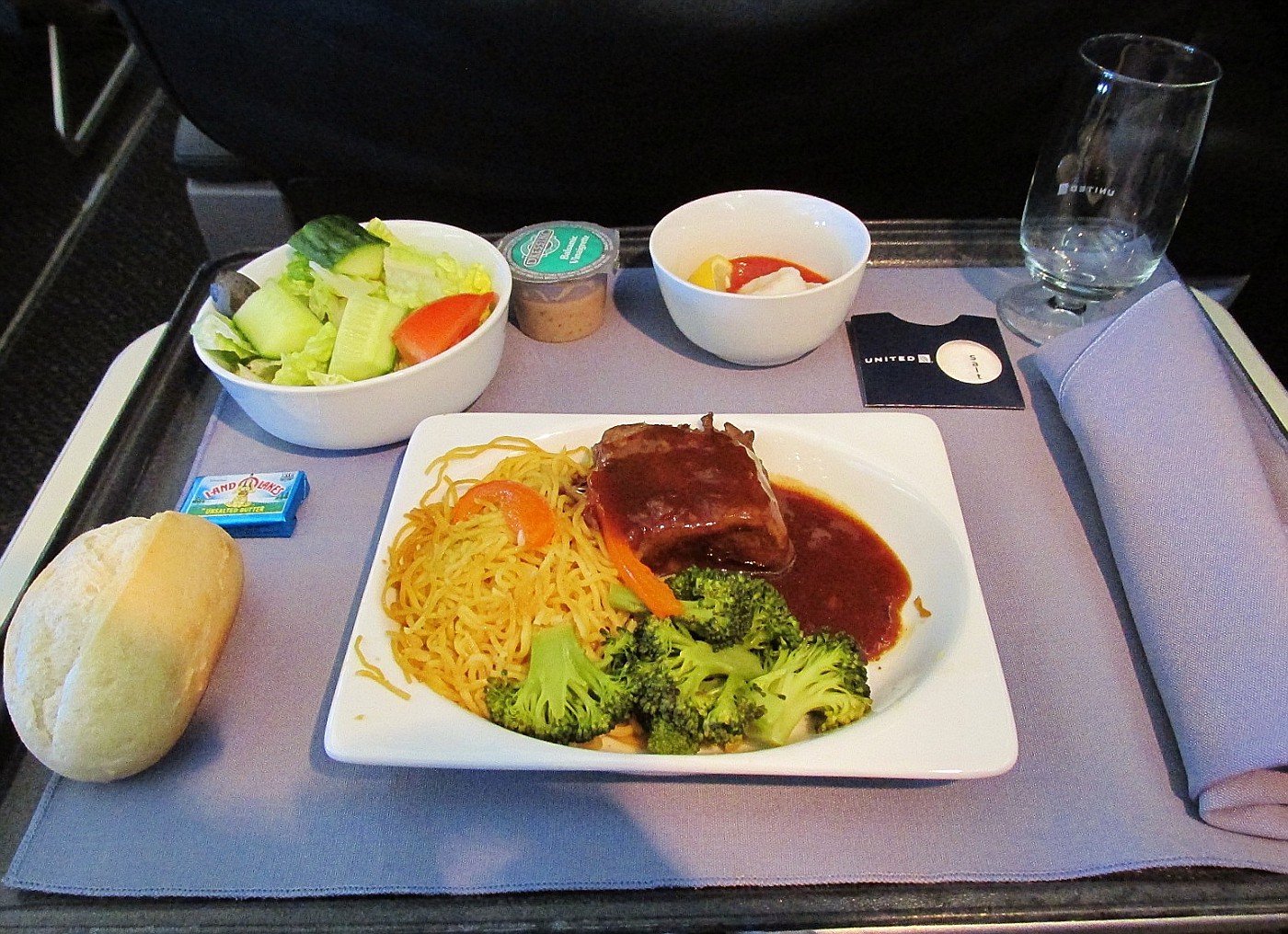
Asian Short Ribs
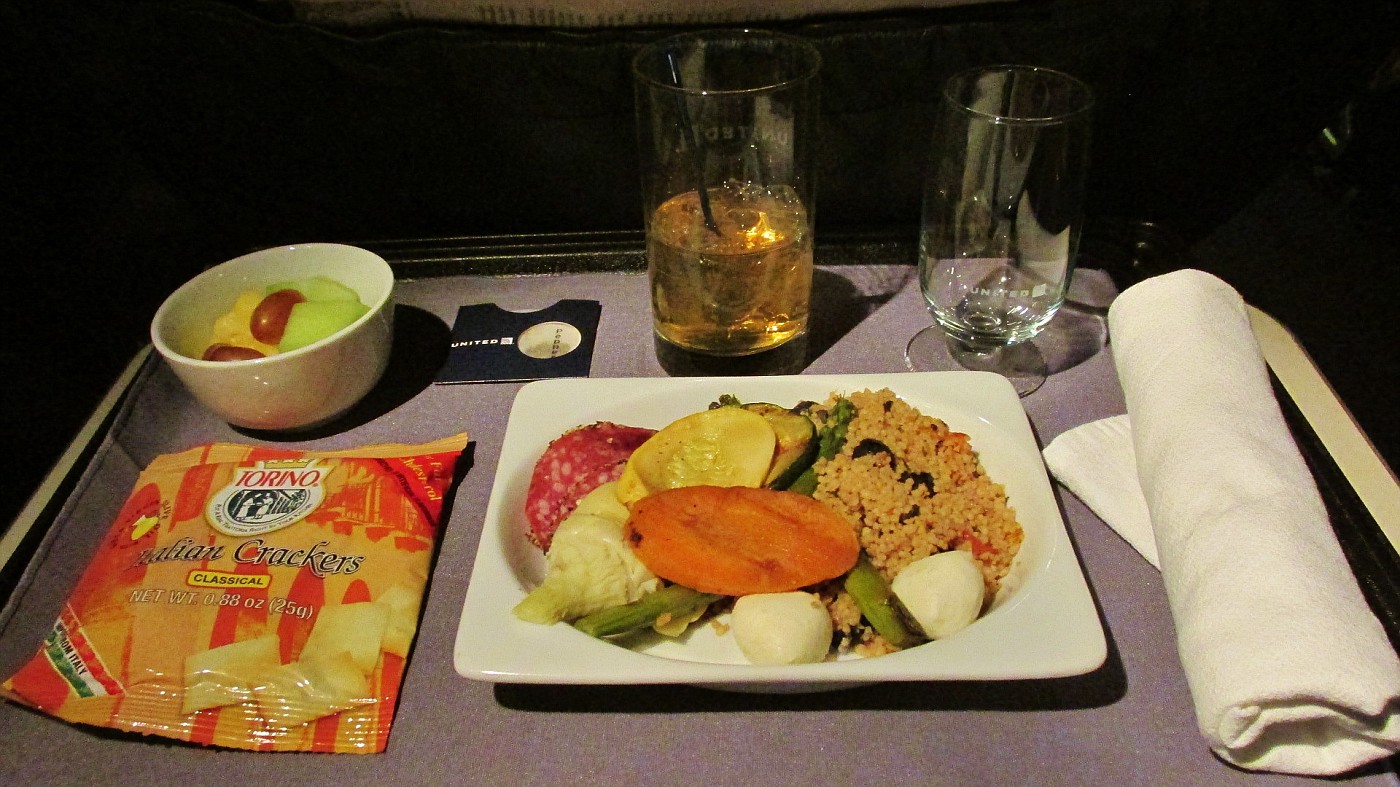
Antipasto Plate
It was after midnight by the time we pulled into the gate in San Diego. This had been a long day and thankfully my first flight tomorrow wouldn’t depart until after 1000am. Now if I can just find a nice quiet place to crash for the night.
To my dismay the construction continued at San Diego International, with much of it taking place at night. There are jackhammers and power saws and loud beeps from motorized equipment as it moves about. I really ought to get a hotel but it never hurts to ask around first. Sure enough I found a foreman who assured me that no work would be being done anywhere near the far end of Terminal 2, so I found myself a secluded corner behind the baggage carousels and, after reading a few pages of John Lescroart’s latest novel, I called it a night.
Day Twenty Two
Delta Connection San Diego to Los Angeles 1011a – 1105a CRJ-900 Coach Class
Delta Airlines Los Angeles to Detroit 133p – 900p 737-900 Coach Class
Delta Connection Detroit to Portland 947p – 1146p CRJ-900 Coach Class
My alarm went off at 7:30am and shortly thereafter I set about the business of breaking camp. I realize many of you haven’t slept in an airport before or if you have it was very likely due to circumstances over which you had no control. As such, you may have spent the night slouched in a chair or maybe you got lucky and found a padded bench to lie down upon. However it went, please accept my condolences.
Because I actually plan to overnight in the airport, I come prepared to sleep as comfortably as possible. It’s worth mentioning here that as part of my personal flight log, I also note any nights spent in the airport. As of this writing that total is 652 nights, over which time I’ve developed a system that works pretty well for me. Having also spent many a night on the trail while backpacking through the Rockies, Sierras and Cascades, I think “breaking camp” is an apt analogy for what I do each morning in the airport. Here’s what it entails…
First, the wool blanket has to be folded up. Just like my tent, it’s got to be folded a certain way or it’s not going to fit properly into my standard sized rollabord, the bottom half of which is filled with clothing. The Thermarest pad is next. It’s got to be deflated and then pressed down and rolled up tight so it’ll fit into its 20” x 5” storage bag. The alarm clock needs to have its batteries removed and then both clock and batteries go into a plastic Ziploc bag. Next I grab any new clothes I’ll need – usually a shirt. Now I’m ready to put them back in the suitcase. The blanket is first, with half of it placed on top of the clothing just so. The Thermarest pad is next, placed on top of the blanket at the front of the suitcase. In the remaining space go the pillow, headlamp, alarm clock and eye shades. The rest of the blanket is then folded back over them to the Thermarest pad and then half folded again. Tuck in the edges, tamp it all down, then close and zip up the suitcase. Pick up the water bottle and any papers that may have been left around and Bob’s your uncle. We’re good to go!
The point of today’s trip is to get back to Boston so that I can attend tomorrow’s baseball game between the Oakland A’s and the Boston Red Sox. Unfortunately, the good low fares that I’d utilized on my recent United roundtrip weren’t available today. Indeed, the fare between San Diego and Boston today was so much more expensive that flying into Boston was not an option. Thankfully, Delta had a great low fare into Portland, Maine. From there it was only a two hour train ride down to Boston. Book it, Danno! Business Class!
Over the past few months, Delta has embarked on an aggressive incursion into markets traditionally served by Alaska. In particular Delta has expanded its presence in Seattle and now competes more vigorously with Alaska in some prime markets such as Seattle to Anchorage as well as up and down the west coast. Alaska has responded by offering new service from Seattle to Salt Lake City and Detroit, both Delta strongholds. Additionally, Delta has rescinded some of the benefits which Alaska’s elite level flyers have come to appreciate over the years. Gone are Sky Priority check-in and boarding as well as free checked baggage.
There’s been a bit of wailing and gnashing of teeth about this over at the Alaska forum but I personally am not all that bothered by it. We’ll still be able to use so-called priority check-in lines, book preferred seating, enjoy Zone 1 boarding and be eligible for upgrades in the unlikely event there are any leftover seats after all the Delta elites get upgraded. As partner airline benefits go, I think those are still quite reasonable – especially amongst two partners competing as vigorously as Delta and Alaska.
On the other hand, Delta’s decision to award mileage based upon fare type purchased will very definitely steer my patronage elsewhere. That won’t take effect until next January though, so let’s enjoy the good times while we have them.
Since my first flight is aboard Delta Connection, I’ll have to catch the bus over to the Commuter Terminal. For guys like me who logged a few flights down here in the seventies, this is like a trip down memory lane since the Commuter Terminal used to be both the terminal and headquarters building for San Diego based Pacific Southwest Airlines. I remember walking out onto that ramp when there’d be five or six of PSA’s brightly colored 727s in attendance, flying to destinations all over the state. Today the largest jet you’ll see operating out of this terminal is the one I’m booked to fly this morning – the Canadair CRJ-900.
Speaking of old memories, my first ever flight out of San Diego was back in November of 1973 aboard a Delta DC-8-61. That was also my first ever flight aboard either Delta or the stretch 8 and I still remember the exact ticket cost to this day: $6.83. That was a walk up K class fare that could be gotten at any time before departure. Factoring in inflation that would come to about $36.50 in today’s money but when I checked this morning, the lowest walkup fare between San Diego and LA was $350.10. When I checked for a month and a half out, flying on a Tuesday, it dropped to “just” $134.60. This for a 110 mile, 30 minute flight.
Then again, last year I was buying one way tickets between San Diego and Baltimore for just $83.00. Go figure!
*** *** ***
One of the nice things about flying through LAX on Delta is the opportunity to visit Delta’s Sky Club. With a two and a half hour layover there’d be plenty of time to take advantage of its comfort and amenities, one of which is a couple of very nicely appointed shower rooms. Big fluffy towels, fancy shampoo, lots of hot water – what a treat to have in an airport!
Since I was number 22 on the upgrade list, I figured I’d better get something to eat beforehand. There used to be a McDonalds in this terminal but unfortunately it’s been replaced by some trendy looking market selling $14.00 sandwiches. I know it’s in vogue to look down on McDonalds but I think their salads offer excellent value – not to mention taste – and their grilled chicken sandwiches aren’t half bad either. While I suppose it’s nice to have these stylish looking kiosks selling trendy Californian themed sandwiches and salads (add a slice of avocado), it’s not right that we should be gouged for the right to enjoy them. Perhaps the powers that be are worried that if there were a McDonalds in the terminal, none of the other restaurants would get enough business. I say perhaps they would if pricing were based more upon substance than style. In any event a coffee kiosk in the food court yielded a turkey sandwich for about $10.00.
This was to be my first flight aboard a Delta 737-900. In the old days one could really look forward to flying a different airlines’ aircraft because it used to be that not all airplanes were alike despite being the same aircraft type. Consider the once ubiquitous 727-100. Continental’s used to offer spacious 2-3 seating, Braniff’s were the first to have the wide bodied interior installed, United and TWA’s had fold down middle seats that could double as a table if they were unoccupied, Alaska’s interiors were designed to look like a Klondike saloon.
These days, if you’ve been on one US airline’s 737-900, you’ve been on ‘em all. Delta, United, Alaska – they all look alike inside. Sure, Delta and United have a few rows of economy plus style seating and seatback IFEs but other than that all three airlines sport solid dark blueish grey seating fabrics throughout First Class and Coach. It’s really boring and yet this bland style is supported by endless studies that indicate most passengers prefer the uniform look.
Check out the difference in these two DC-10s from years ago

American DC-10

Continental DC-10
Flight time to the Motor City was a long four hours and fifteen minutes. We parked down at the very last gate on the far end of the long McNamara Terminal Building and upon exiting the jetway I bee-lined it over to the nearest departures board. Hmph! Just my luck that my onward flight to Portland was departing from over on the B concourse – once again from the very last gate down. Better get going! From train to inter-terminal people mover to the long walk down concourse B, my timing couldn’t have been better. I arrived at the gate, pausing only to display my boarding pass, then strolled right on board to my exit row aisle seat and five minutes later we were closing the doors and preparing for pushback.
It’s been thirty years since I last flew through Portland and as might be expected, the airport has been completely renovated and looks nothing like the humble little facility I once knew. What I remember most about the old airport was the clam chowder. That’s right. Clam chowda! It was served from a little local food concession and very likely made from scratch. To this day I have never had a better bowl of clam chowder and believe me, I’ve tried hard to find one.
In any event, I had an early start tomorrow morning and so, after checking in with the two old boys who provided airport security, I reconnoitered the airport and found a nice dark hollow behind a stairway. I set my alarm for 6:30 and that was that.
Day Twenty Three
Amtrak Portland to Boston 800a – 1030a Downeaster Business Class
Alaska Airlines Boston to San Diego 710p – 1030p 737-800 First Class
It’s a short taxi ride from the airport across the river to the Portland Transportation Center, an intermodal facility serving both intercity busses and Amtrak trains. It’s a good thing I brought my coffee from the airport because outside of a couple of vending machines there was nothing to eat at the Transportation Center. If I thought the building looked busy when I got there, it soon became positively crowded as throngs of baseball and hockey fans showed up for this morning’s ride down to Boston. The Bruins were hosting the Montreal Canadiens in a hockey playoff game while the Red Sox were hosting the A’s at Fenway. The crowd was buoyant and fully expectant of their team’s victory. I love this kind of energy and so found myself with mixed feelings about sitting up in the quiet and relaxed ambience of Business Class as opposed to joining the party back in the coaches.
Still, there’d be plenty of time to party at Fenway and so when boarding was called I walked all the way down to the first car on the train and climbed aboard. Today’s consist was headed up by a single P42DC locomotive followed by a Café/Business Class car and three coach cars. The Business car featured five rows of spacious seating in the front of the car, a café service area in the middle and a small lounge/dining area at the rear of the car. The wide leather upholstered seats were configured 1-2 and provided about 50” pitch between seats. 120v outlets are available at each seat. Business Class tickets on Amtrak also include a free soft drink and a newspaper. To that end a copy of the Boston Globe was already at my seat.
Soon we were on our way, hurtling down the tracks at about 60mph. Compared to trains in other developed countries, trains in America must seem more like a children’s amusement park ride than a modern intercity transport. Trains in Europe, Japan and China routinely exceed 100mph and some, such as France’s TGV, speed along in excess of 200mph. Be that as it may, I rather like this pace. I mean, here I am in a large, comfy recliner enjoying hot coffee and a breakfast sandwich while out my window the forests and rivers of New England pass by at a pace that allows me to enjoy viewing them individually rather than as a collective blur.
Arrival at Boston’s North Station was right on time. Bruins fans had only to head right upstairs as the TD Garden was located directly on top of the station. I made my way over to the subway where I was ultimately dropped off just a short four block walk from Fenway.
Keep in mind that I was dragging a suitcase along and of course no suitcases would be allowed into Fenway. No problem. A bit of pre-departure checking on the internet revealed that a nearby hotel – The Commodore – would store my bag and daypack for $10.00 each.
Fenway is the oldest major league baseball park in America. It has been a part of some of baseball’s richest history and is once again home to the World Series champions. Some of you may recall that the Sox beat the Cardinals for that honor just a few months ago. Fenway is a true baseball shrine and to sit in there amidst what are arguably the most loyal and passionate fans in baseball is a wonderful experience. And I say that as an A’s fan!
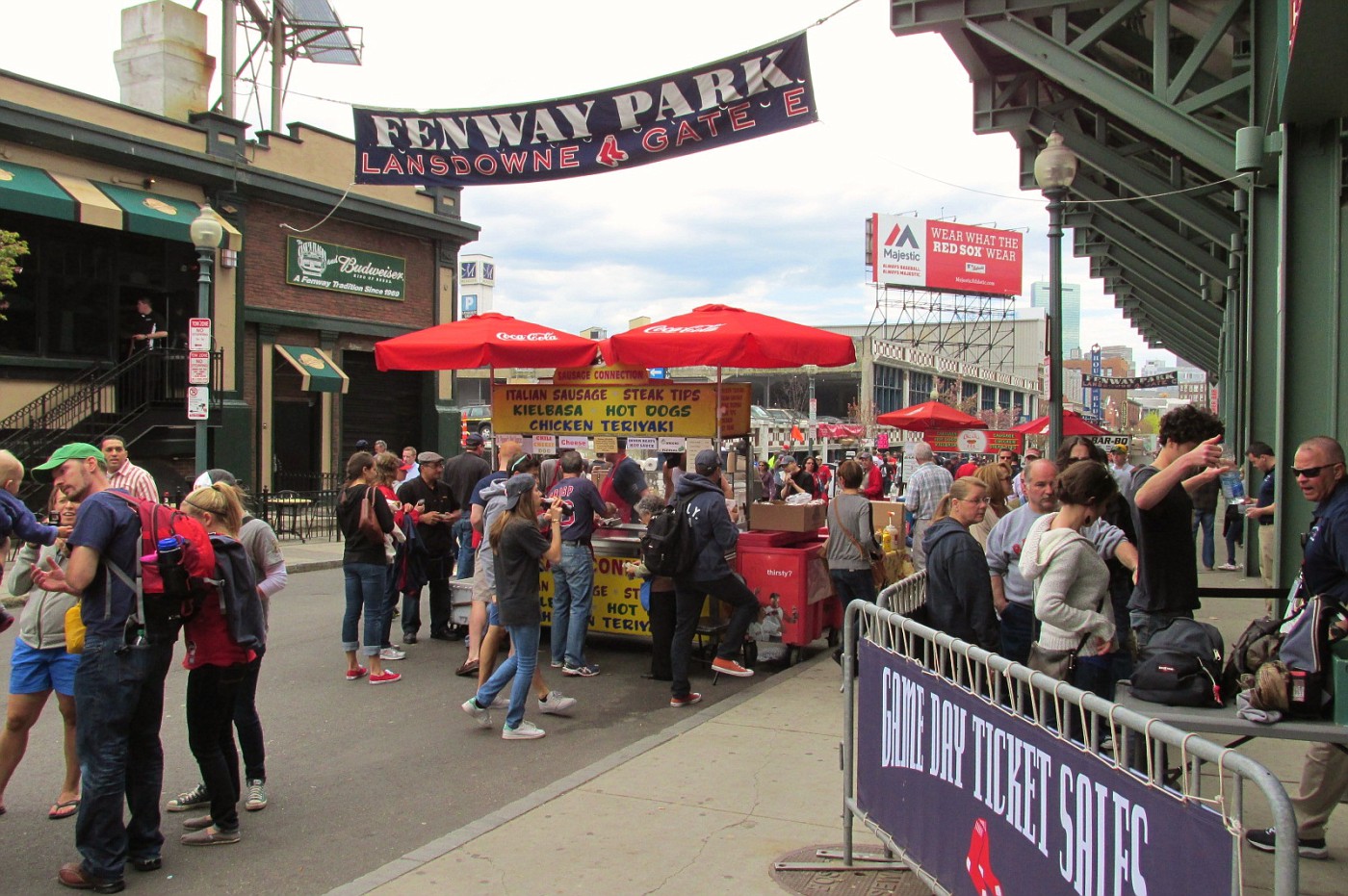
Excellent sausages outside the park

I had great seats!

Derek Norris swings at a Jon Lester fastball
Now I could fill the next couple of pages waxing eloquent on the many things I saw and experienced this afternoon at Fenway and outside the park afterwards but this is a trip report, not a game report. Suffice to say that Red Sox ace Jon Lester was in top form, tossing one hit ball through seven innings to handcuff the A’s and lead his team to victory. Little could any of us have known that just two months later Lester would be shipped to the A’s in a blockbuster trade for star outfielder Yeonis Cespedes.
After the game I collected my bags and made my way out to Logan Airport. This was easily done via subway and a dedicated airport bus that regularly picks up right at the subway stop and makes stops at each terminal. Alaska operates out of Terminal A, which is also home to Delta’s Sky Club. I had time for a couple of nicely chilled Sam Adams and a long chat with the bartender before making my way down to gate A-22 where my San Diego bound 737-800 awaited.
Reclining my seat as we sped westward into the setting sun, I took a long pull from my glass of Jack Daniels and considered my lot in life. Pretty darned nice really; having the time to take trips like this one, traveling all over the country in First Class comfort, enjoying a great afternoon at Fenway Park and now sitting here in First Class while awaiting a nice chicken dinner. Winner, Winner! Chicken Dinner! Oh yeah – life is good!

Farro Salad
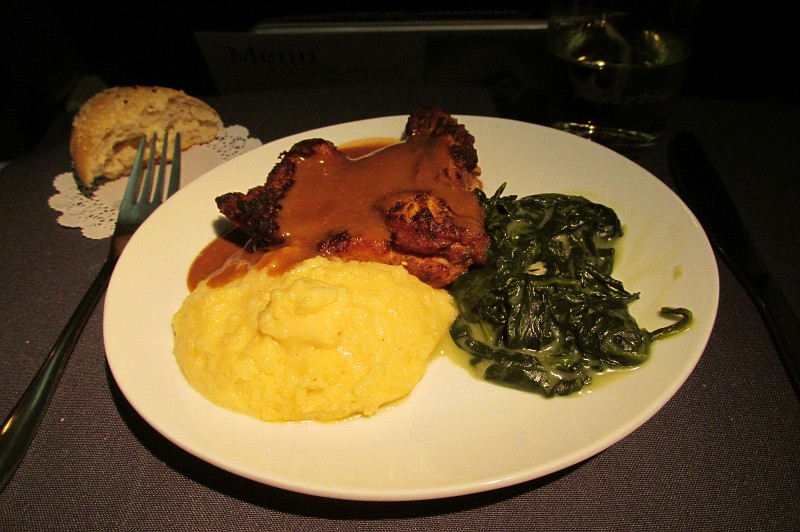
Blackened Chicken with polenta and spinach
Day Twenty Four
Alaska Airlines San Diego to Seattle 800a – 1050a 737-800 First Class
Alaska Airlines Seattle to Denver 705p – 1034p 737-900 First Class
I really don’t need to go to Colorado but what the heck – the price is right and since I don’t have to report back to work for another week yet, a couple days visiting family and friends in the Centennial State is always time well spent. Add to that a great deal on a rental car plus upgrades on both segments and I’m one happy camper - or traveler, if you will.
I’d specifically booked an early morning flight into Seattle so that I’d have time to visit with an old friend from Ballard. I managed to lure her into downtown Seattle with an offer of lunch at one of our favorite restaurants - the Athenian in Pike Place Market. Since she doesn’t have a car, I agreed to meet her at the restaurant.
It was a little after 3 when we parted ways at the bronze pig outside the market entrance. She had to go to work and I had a plane to catch. But first I had to pay a visit to my favorite haberdashery – Byrnie Utz Hats on 3rd and Union. I’ve been wearing hats pretty regularly since I was in college. I’ve never owned a baseball cap but I have owned a fair variety of caps, fedoras and what I would call western outdoor hats. Byrnie Utz always has something to pique my interest and I don’t believe I’ve ever left there without making a purchase. Today was no different.
Seattle’s had a rail link to the airport for four or five years now. It’s not very convenient though and frankly, I think the old 194 express bus was faster. Half the problem is the distance you have to walk between the “Airport” station and the terminal. The station is located closer to Tukwila and getting from it to the terminal involves first walking 150 or so yards just to get to the far reaches of the parking structure. From there it’s another couple hundred yards to the bridges that take you over the roadway and into the terminal. Add to that the long walk out to gate C-20 and you’ve had a pretty good hike.
Once again I found myself flying aboard ship 318, a 737-990 bearing the colorful “Spirit of Disneyland II” livery. Some of you may recall that this is the same aircraft that delivered me to Kansas City three weeks ago. Indeed, a check of my Alaska Airlines statistics reveals that this is my fourteenth flight for a total of 15390 miles aboard this airplane. Of Alaska’s 34 737-900s, it is the one upon which I have logged the most flights though surprisingly not the most mileage. That “honor” goes to ship 312 checking in with 15510 miles.
I fly this flight a lot and perhaps because of the hour, the flight attendants usually say that dinner will be served up front on this flight. I would suggest that it’s really more of a hot snack. Consider tonight’s offering – Chicken Parmesan. On a flight as short as SEA-DEN there are no other choices. Now check out the picture:
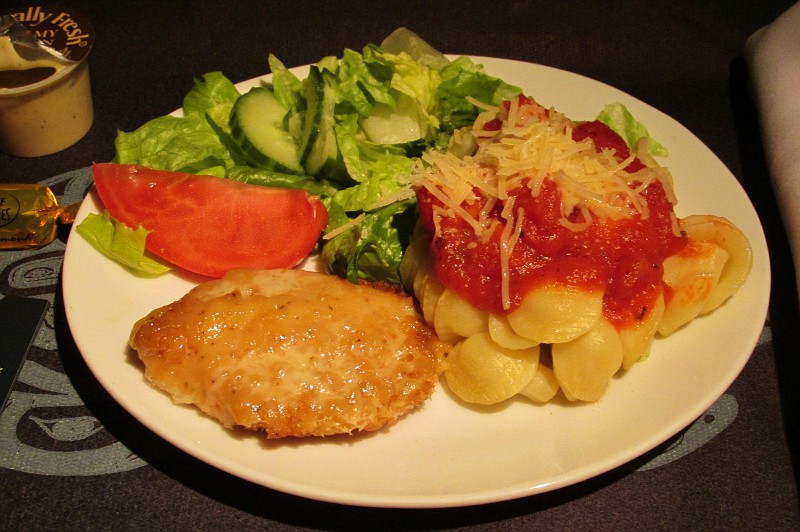
Chicken Parmesan with Pasta Marinara
As you can plainly see, the chicken breast pictured above is only about 3" across - more of a chicken medallion than a chicken breast. In terms of flavor though, it’s pretty good. I just wish it were a bit more substantial. I’ve had larger appetizers on international flights.
I’ve flown this same flight three more times since the one I’m describing here and the other “dinners” offered have provided similarly diminutive portions. One thing I’ve taken to doing now – even if I’m in First Class - is purchasing a chicken and veggie bowl from Waji’s, a Philippine styled restaurant which operates a concession near the end of the C Concourse. I’ve had seatmates ask me why I do this given that we’re in First Class. Didn’t I know that a meal was being offered? I just find the Waji’s meal more enjoyable and filling and I don’t feel at all put out by having paid $8.00 for it. I also bring along my own sleeves of Blue Diamond almonds because I like them better than those pretzel laden sachets of “Deluxe” Snack Mix that most airlines offer these days.
I can’t help it - I’m an old fashioned guy. I grew up in an era when packets of almonds were served with drinks. In Economy Class, no less. Macadamia nuts or mixed nuts were served up front. Even on shorter flights. I’ve heard people complain about the snack mix but I figure why complain when I can so easily rectify the situation by bringing along my own almonds at only $1.19 a sleeve? I also bring along my own condiments because the airlines either don’t offer them or they offer a brand I don’t care for such as that bright yellow French’s mustard. In my daypack I keep a stash of single serving Grey Poupon and Gulden’s mustard packets along with Tabasco and Cholula hot sauce, soy sauce, salsa, salt & pepper and horseradish sauce. Any time I’m in a place that offers these condiments in PC form, I always pick up a couple to add to my collection.
One of the reasons I like the late flight into Denver is because DIA is a great airport to sleep in. One of the best things about overnighting at DIA is that they allow you to do so on the airside of security. On every concourse, behind the podiums at each gate are nice dark areas, many of which are completely secluded and out of sight. All you need do is check the arrivals/departures board and find a gate that has a late morning departure so you can sleep undisturbed until a civilized hour. While there are no guarantees (i.e. gates can occasionally be changed), I’ve never had it happen to me over my many nights at DIA. One of my favorite spots was a gate on the A Concourse that was out of service for about a year.
As an added bonus DIA has a couple of really nice breakfast places that offer good food at decent prices with great views of the tarmac outside. It’s usually about 10 or 11 in the morning by the time I finally get around to picking up my rental car. I should add though that my pick-up time is usually predicated upon my departure time, which is often Alaska’s late-morning flight back up to Seattle. This way I don’t end up paying for an extra day on the rental car which I would have had I picked it up the night before.
By the way, a couple of Denver based FlyerTalkers have graciously offered to ply me with beer or bourbon should we manage to get together sometime in Denver. You know who you are and I both appreciate your offer as well as look forward to getting together with you someday. On short visits like this however, it just didn’t work out – especially since I’m usually up in either Fort Collins or Eagle County.
In any event, two nice days in Colorado were followed by my return to Alaska using a one way award ticket on Alaska Airlines. That means three flights in economy class and I think we’ve all heard more than enough about that in this report at least.
So, without further ado let’s fast forward to three weeks later. It’s now late May. I’m back at work in Denali National Park and I’ve got a three day weekend to work with. Hmm… What to do? What to do?
United Airlines San Diego to San Francisco 224p – 345p A320-200 First Class
United Airlines San Francisco to Chicago 637p – 1253p 737-800 Coach Class
It’s always a good feeling to check in for your flights secure in the knowledge that both your upgrades have cleared and now all you have to do is sit back, relax and enjoy the trip. I started by paying a visit to the new United Club, located on the Mezzanine Level in the main terminal. United recently relocated from Terminal 1 into the newly renovated Terminal 2 and the new lounge, while quite bright and airy, is lacking some of the warmth and comfort of the old facility. I did like the seating out on the porch overlooking the concourse below though. Very nice.
The first sign of trouble came at the gate when our departure was delayed by twenty minutes. I had a 45 minute connection in San Francisco and so long as my connecting flight didn’t depart from over on the international terminal I should be okay. The plane was in, so one could only hope it wasn’t a lengthy mechanical situation of some sort.
Boarding was announced at 2:25pm and I settled into seat 2B where I gratefully accepted a bourbon on the rocks while we finished the boarding process. The bad news was delivered just a few minutes later. A power outage up in LA had shut down the computers that air traffic control uses to coordinate all flights arriving, departing or even flying over the region. As such, we wouldn’t be able to take off until they got the power back up.
Well then – there goes my transcon upgrade for this afternoon. Bummer… On a positive note my return flights to San Diego weren’t due to depart until 4:00pm the next day, so I had plenty of time to get to Boston. A quick call to United reservations got me rebooked to Boston, though hardly in the style I’d been looking forward to just a few minutes earlier.
My new reservations had me connecting in San Francisco to a 6:30pm flight to Chicago where I’d overnight before continuing on the next morning via Newark. I could’ve flown nonstop from Chicago to Boston but I didn’t want to get up for the 6:00am departure. The 8:05am Newark flight would allow me a couple of hours extra sleep and in my advancing years, that’s something I’ve really come to appreciate. The only real downside to this reservation was that no First Class was available on such short notice. Instead I had a choice of center seats on the flight to Chicago (I’ll take the exit row, please) and an aisle seat into Newark the next day. I was waitlisted for First on the EWR-BOS flight. But hey – at least I had seats booked and would arrive into Logan with plenty of time to make my return flights to San Diego, two of which were already confirmed in First Class.
So rather than bore you further with tales of middle seat misery to Chicago, suffice it to say that we arrived at O’Hare on schedule, whereupon I quickly set up camp and – with the help of Melatonin and a quarter hit of Ambien - knocked off a good five and a half hours of sleep.
Day Twenty One
Shuttle Express Chicago to Newark 805a – 1110a ERJ-170 Coach Class
United Airlines Newark to Boston 1230p – 140p A319-100 First Class
United Airlines Boston to Denver 400p – 648p 737-800 First Class
United Airlines Denver to San Francisco 740p – 924p 737-800 First Class
United Airlines San Francisco to San Diego 1055p – 1228p 737-800 Coach Class
By the time I woke up, broke camp, cleaned up and made it through security there was no time to visit the United Club for coffee and a Danish. That’s alright - United’s terminals at O’Hare offer a wide selection of coffee kiosks and eateries, so I had no problem finding a cup of coffee and a fairly decent breakfast sandwich.
I still find it a bit hard to believe that I’m flying aboard a regional jet between Chicago and Newark. I’ve flown this route on DC-10s and stretch 8s, not to mention all manner of 727s and 737s and now all it rates at 8:00am is a regional jet? Welcome to 2014, old boy.
Well if one must fly on a regional jet, Embraer’s RJ-170/190 family of jets is about as nice as it gets. Their cabins can comfortably accommodate spacious 2-2 seating in economy as well as a 1-2 configured First Class cabin. As an added plus, they are large enough to stand up in, They are a worthy successor to the BAe-146, my favorite regional jet of all time.
Flight time to Newark was a quick one hour and forty-eight minutes. We landed on a gray, blustery day and I took a small measure of comfort in the fact that I’d be back in San Diego later this evening. Yeah, but only to turn around and fly back to Portland, Maine tomorrow morning. Sigh… such is life for a mileage runner.
Ship 801 did the honors for my short flight up to Boston. That’d be N801UA, United’s very first A319-100 and an airplane that I’ve flown on two occasions before today, the last time having come back in 2001. It’s hard to believe that this airplane was now 17 years old! In any event, I have a fondness for older airplanes and better yet, my upgrade had cleared so I got to enjoy our rekindled relationship from seat 1C.
What’s that? Oh yes, a Bloody Mary would be just fine, thanks!
Arrival in Boston was at the newly renovated Terminal B. These gates are much nicer than United’s old facilities in Terminal C. Truth be known, since its merger with Continental United flights have departed from all over the darned airport. Ex-Continental flights departed from Terminal A, traditional United flights from Terminal C and now they’re departing from Terminal B. I’m sure I speak for many when I say I look forward to the day United consolidates its BOS operations into one terminal – hopefully Terminal B.
A short stroll around the terminal led me to a restaurant called Ryo Asian Fusion. Which reminds me of a joke – What do nuclear scientists like to do in their free time? They go fission! Uh, right then – back to the restaurant. I’ve yet to encounter any Asian food that I didn’t like so with foods from Japan, China, Thailand, Malaysia, Singapore and India I reckon you could fuse it about any way you pleased and I’d be a happy camper. To that end, I have absolutely no recollection of what I ordered but I do remember enjoying it at a seat by the window and if I should once again find myself looking for food in Terminal B, I wouldn’t mind revisiting this restaurant.
The elevator to the United Club was located just down the hallway from my departure gate, so I popped up there for a refreshing club soda with lime and a handful of snack mix before grabbing a newspaper and heading down to the gate.
I was born and raised in Colorado and even though Alaska’s been my home for thirty years, it always feels good to fly into or through Denver. I still have family and property in the state and my travels normally take me through Denver or the Durango area seven or eight times per year. Even a one hour connection like today’s still brings about that good warm feeling of going home.
My routing back to San Diego is via Denver and San Francisco, aboard a trio of 737-800s. I am fast approaching the one half million mile mark of flights flown only aboard 737-800s. In fact, by the time I get back to Alaska I’ll be just 320 miles shy. Another upcoming milestone will be 1.5 million miles flown aboard 737s of all types. That should be passed sometime this fall. It’s fun to watch these records fall. I realize that most of you have neither the time nor inclination to log your flights, but I’ve been doing it since I was about 12 years old. At that time I had only flown 15 times but each and every one of those flights was indelibly etched into my memory banks. I am confident that my numbers are as accurate as reasonably possible, not counting miles flown while stuck in holding patterns or diverting around large storm cells. Seriously! I was recently on a flight from Seattle to Baltimore where we diverted all the way down to northern Mississippi before heading back up to BWI.
Getting back to the flights though - there’s really not much more to report. They were pretty standard domestic First Class flights as experienced on United these days. We were served dinner between Boston and Denver and a decently sized snack between Denver and San Francisco. Here are pictures of both:

Asian Short Ribs

Antipasto Plate
It was after midnight by the time we pulled into the gate in San Diego. This had been a long day and thankfully my first flight tomorrow wouldn’t depart until after 1000am. Now if I can just find a nice quiet place to crash for the night.
To my dismay the construction continued at San Diego International, with much of it taking place at night. There are jackhammers and power saws and loud beeps from motorized equipment as it moves about. I really ought to get a hotel but it never hurts to ask around first. Sure enough I found a foreman who assured me that no work would be being done anywhere near the far end of Terminal 2, so I found myself a secluded corner behind the baggage carousels and, after reading a few pages of John Lescroart’s latest novel, I called it a night.
Day Twenty Two
Delta Connection San Diego to Los Angeles 1011a – 1105a CRJ-900 Coach Class
Delta Airlines Los Angeles to Detroit 133p – 900p 737-900 Coach Class
Delta Connection Detroit to Portland 947p – 1146p CRJ-900 Coach Class
My alarm went off at 7:30am and shortly thereafter I set about the business of breaking camp. I realize many of you haven’t slept in an airport before or if you have it was very likely due to circumstances over which you had no control. As such, you may have spent the night slouched in a chair or maybe you got lucky and found a padded bench to lie down upon. However it went, please accept my condolences.
Because I actually plan to overnight in the airport, I come prepared to sleep as comfortably as possible. It’s worth mentioning here that as part of my personal flight log, I also note any nights spent in the airport. As of this writing that total is 652 nights, over which time I’ve developed a system that works pretty well for me. Having also spent many a night on the trail while backpacking through the Rockies, Sierras and Cascades, I think “breaking camp” is an apt analogy for what I do each morning in the airport. Here’s what it entails…
First, the wool blanket has to be folded up. Just like my tent, it’s got to be folded a certain way or it’s not going to fit properly into my standard sized rollabord, the bottom half of which is filled with clothing. The Thermarest pad is next. It’s got to be deflated and then pressed down and rolled up tight so it’ll fit into its 20” x 5” storage bag. The alarm clock needs to have its batteries removed and then both clock and batteries go into a plastic Ziploc bag. Next I grab any new clothes I’ll need – usually a shirt. Now I’m ready to put them back in the suitcase. The blanket is first, with half of it placed on top of the clothing just so. The Thermarest pad is next, placed on top of the blanket at the front of the suitcase. In the remaining space go the pillow, headlamp, alarm clock and eye shades. The rest of the blanket is then folded back over them to the Thermarest pad and then half folded again. Tuck in the edges, tamp it all down, then close and zip up the suitcase. Pick up the water bottle and any papers that may have been left around and Bob’s your uncle. We’re good to go!
The point of today’s trip is to get back to Boston so that I can attend tomorrow’s baseball game between the Oakland A’s and the Boston Red Sox. Unfortunately, the good low fares that I’d utilized on my recent United roundtrip weren’t available today. Indeed, the fare between San Diego and Boston today was so much more expensive that flying into Boston was not an option. Thankfully, Delta had a great low fare into Portland, Maine. From there it was only a two hour train ride down to Boston. Book it, Danno! Business Class!
Over the past few months, Delta has embarked on an aggressive incursion into markets traditionally served by Alaska. In particular Delta has expanded its presence in Seattle and now competes more vigorously with Alaska in some prime markets such as Seattle to Anchorage as well as up and down the west coast. Alaska has responded by offering new service from Seattle to Salt Lake City and Detroit, both Delta strongholds. Additionally, Delta has rescinded some of the benefits which Alaska’s elite level flyers have come to appreciate over the years. Gone are Sky Priority check-in and boarding as well as free checked baggage.
There’s been a bit of wailing and gnashing of teeth about this over at the Alaska forum but I personally am not all that bothered by it. We’ll still be able to use so-called priority check-in lines, book preferred seating, enjoy Zone 1 boarding and be eligible for upgrades in the unlikely event there are any leftover seats after all the Delta elites get upgraded. As partner airline benefits go, I think those are still quite reasonable – especially amongst two partners competing as vigorously as Delta and Alaska.
On the other hand, Delta’s decision to award mileage based upon fare type purchased will very definitely steer my patronage elsewhere. That won’t take effect until next January though, so let’s enjoy the good times while we have them.
Since my first flight is aboard Delta Connection, I’ll have to catch the bus over to the Commuter Terminal. For guys like me who logged a few flights down here in the seventies, this is like a trip down memory lane since the Commuter Terminal used to be both the terminal and headquarters building for San Diego based Pacific Southwest Airlines. I remember walking out onto that ramp when there’d be five or six of PSA’s brightly colored 727s in attendance, flying to destinations all over the state. Today the largest jet you’ll see operating out of this terminal is the one I’m booked to fly this morning – the Canadair CRJ-900.
Speaking of old memories, my first ever flight out of San Diego was back in November of 1973 aboard a Delta DC-8-61. That was also my first ever flight aboard either Delta or the stretch 8 and I still remember the exact ticket cost to this day: $6.83. That was a walk up K class fare that could be gotten at any time before departure. Factoring in inflation that would come to about $36.50 in today’s money but when I checked this morning, the lowest walkup fare between San Diego and LA was $350.10. When I checked for a month and a half out, flying on a Tuesday, it dropped to “just” $134.60. This for a 110 mile, 30 minute flight.
Then again, last year I was buying one way tickets between San Diego and Baltimore for just $83.00. Go figure!
*** *** ***
One of the nice things about flying through LAX on Delta is the opportunity to visit Delta’s Sky Club. With a two and a half hour layover there’d be plenty of time to take advantage of its comfort and amenities, one of which is a couple of very nicely appointed shower rooms. Big fluffy towels, fancy shampoo, lots of hot water – what a treat to have in an airport!
Since I was number 22 on the upgrade list, I figured I’d better get something to eat beforehand. There used to be a McDonalds in this terminal but unfortunately it’s been replaced by some trendy looking market selling $14.00 sandwiches. I know it’s in vogue to look down on McDonalds but I think their salads offer excellent value – not to mention taste – and their grilled chicken sandwiches aren’t half bad either. While I suppose it’s nice to have these stylish looking kiosks selling trendy Californian themed sandwiches and salads (add a slice of avocado), it’s not right that we should be gouged for the right to enjoy them. Perhaps the powers that be are worried that if there were a McDonalds in the terminal, none of the other restaurants would get enough business. I say perhaps they would if pricing were based more upon substance than style. In any event a coffee kiosk in the food court yielded a turkey sandwich for about $10.00.
This was to be my first flight aboard a Delta 737-900. In the old days one could really look forward to flying a different airlines’ aircraft because it used to be that not all airplanes were alike despite being the same aircraft type. Consider the once ubiquitous 727-100. Continental’s used to offer spacious 2-3 seating, Braniff’s were the first to have the wide bodied interior installed, United and TWA’s had fold down middle seats that could double as a table if they were unoccupied, Alaska’s interiors were designed to look like a Klondike saloon.
These days, if you’ve been on one US airline’s 737-900, you’ve been on ‘em all. Delta, United, Alaska – they all look alike inside. Sure, Delta and United have a few rows of economy plus style seating and seatback IFEs but other than that all three airlines sport solid dark blueish grey seating fabrics throughout First Class and Coach. It’s really boring and yet this bland style is supported by endless studies that indicate most passengers prefer the uniform look.
Check out the difference in these two DC-10s from years ago

American DC-10

Continental DC-10
Flight time to the Motor City was a long four hours and fifteen minutes. We parked down at the very last gate on the far end of the long McNamara Terminal Building and upon exiting the jetway I bee-lined it over to the nearest departures board. Hmph! Just my luck that my onward flight to Portland was departing from over on the B concourse – once again from the very last gate down. Better get going! From train to inter-terminal people mover to the long walk down concourse B, my timing couldn’t have been better. I arrived at the gate, pausing only to display my boarding pass, then strolled right on board to my exit row aisle seat and five minutes later we were closing the doors and preparing for pushback.
It’s been thirty years since I last flew through Portland and as might be expected, the airport has been completely renovated and looks nothing like the humble little facility I once knew. What I remember most about the old airport was the clam chowder. That’s right. Clam chowda! It was served from a little local food concession and very likely made from scratch. To this day I have never had a better bowl of clam chowder and believe me, I’ve tried hard to find one.
In any event, I had an early start tomorrow morning and so, after checking in with the two old boys who provided airport security, I reconnoitered the airport and found a nice dark hollow behind a stairway. I set my alarm for 6:30 and that was that.
Day Twenty Three
Amtrak Portland to Boston 800a – 1030a Downeaster Business Class
Alaska Airlines Boston to San Diego 710p – 1030p 737-800 First Class
It’s a short taxi ride from the airport across the river to the Portland Transportation Center, an intermodal facility serving both intercity busses and Amtrak trains. It’s a good thing I brought my coffee from the airport because outside of a couple of vending machines there was nothing to eat at the Transportation Center. If I thought the building looked busy when I got there, it soon became positively crowded as throngs of baseball and hockey fans showed up for this morning’s ride down to Boston. The Bruins were hosting the Montreal Canadiens in a hockey playoff game while the Red Sox were hosting the A’s at Fenway. The crowd was buoyant and fully expectant of their team’s victory. I love this kind of energy and so found myself with mixed feelings about sitting up in the quiet and relaxed ambience of Business Class as opposed to joining the party back in the coaches.
Still, there’d be plenty of time to party at Fenway and so when boarding was called I walked all the way down to the first car on the train and climbed aboard. Today’s consist was headed up by a single P42DC locomotive followed by a Café/Business Class car and three coach cars. The Business car featured five rows of spacious seating in the front of the car, a café service area in the middle and a small lounge/dining area at the rear of the car. The wide leather upholstered seats were configured 1-2 and provided about 50” pitch between seats. 120v outlets are available at each seat. Business Class tickets on Amtrak also include a free soft drink and a newspaper. To that end a copy of the Boston Globe was already at my seat.
Soon we were on our way, hurtling down the tracks at about 60mph. Compared to trains in other developed countries, trains in America must seem more like a children’s amusement park ride than a modern intercity transport. Trains in Europe, Japan and China routinely exceed 100mph and some, such as France’s TGV, speed along in excess of 200mph. Be that as it may, I rather like this pace. I mean, here I am in a large, comfy recliner enjoying hot coffee and a breakfast sandwich while out my window the forests and rivers of New England pass by at a pace that allows me to enjoy viewing them individually rather than as a collective blur.
Arrival at Boston’s North Station was right on time. Bruins fans had only to head right upstairs as the TD Garden was located directly on top of the station. I made my way over to the subway where I was ultimately dropped off just a short four block walk from Fenway.
Keep in mind that I was dragging a suitcase along and of course no suitcases would be allowed into Fenway. No problem. A bit of pre-departure checking on the internet revealed that a nearby hotel – The Commodore – would store my bag and daypack for $10.00 each.
Fenway is the oldest major league baseball park in America. It has been a part of some of baseball’s richest history and is once again home to the World Series champions. Some of you may recall that the Sox beat the Cardinals for that honor just a few months ago. Fenway is a true baseball shrine and to sit in there amidst what are arguably the most loyal and passionate fans in baseball is a wonderful experience. And I say that as an A’s fan!

Excellent sausages outside the park

I had great seats!

Derek Norris swings at a Jon Lester fastball
Now I could fill the next couple of pages waxing eloquent on the many things I saw and experienced this afternoon at Fenway and outside the park afterwards but this is a trip report, not a game report. Suffice to say that Red Sox ace Jon Lester was in top form, tossing one hit ball through seven innings to handcuff the A’s and lead his team to victory. Little could any of us have known that just two months later Lester would be shipped to the A’s in a blockbuster trade for star outfielder Yeonis Cespedes.
After the game I collected my bags and made my way out to Logan Airport. This was easily done via subway and a dedicated airport bus that regularly picks up right at the subway stop and makes stops at each terminal. Alaska operates out of Terminal A, which is also home to Delta’s Sky Club. I had time for a couple of nicely chilled Sam Adams and a long chat with the bartender before making my way down to gate A-22 where my San Diego bound 737-800 awaited.
Reclining my seat as we sped westward into the setting sun, I took a long pull from my glass of Jack Daniels and considered my lot in life. Pretty darned nice really; having the time to take trips like this one, traveling all over the country in First Class comfort, enjoying a great afternoon at Fenway Park and now sitting here in First Class while awaiting a nice chicken dinner. Winner, Winner! Chicken Dinner! Oh yeah – life is good!

Farro Salad

Blackened Chicken with polenta and spinach
Day Twenty Four
Alaska Airlines San Diego to Seattle 800a – 1050a 737-800 First Class
Alaska Airlines Seattle to Denver 705p – 1034p 737-900 First Class
I really don’t need to go to Colorado but what the heck – the price is right and since I don’t have to report back to work for another week yet, a couple days visiting family and friends in the Centennial State is always time well spent. Add to that a great deal on a rental car plus upgrades on both segments and I’m one happy camper - or traveler, if you will.
I’d specifically booked an early morning flight into Seattle so that I’d have time to visit with an old friend from Ballard. I managed to lure her into downtown Seattle with an offer of lunch at one of our favorite restaurants - the Athenian in Pike Place Market. Since she doesn’t have a car, I agreed to meet her at the restaurant.
It was a little after 3 when we parted ways at the bronze pig outside the market entrance. She had to go to work and I had a plane to catch. But first I had to pay a visit to my favorite haberdashery – Byrnie Utz Hats on 3rd and Union. I’ve been wearing hats pretty regularly since I was in college. I’ve never owned a baseball cap but I have owned a fair variety of caps, fedoras and what I would call western outdoor hats. Byrnie Utz always has something to pique my interest and I don’t believe I’ve ever left there without making a purchase. Today was no different.
Seattle’s had a rail link to the airport for four or five years now. It’s not very convenient though and frankly, I think the old 194 express bus was faster. Half the problem is the distance you have to walk between the “Airport” station and the terminal. The station is located closer to Tukwila and getting from it to the terminal involves first walking 150 or so yards just to get to the far reaches of the parking structure. From there it’s another couple hundred yards to the bridges that take you over the roadway and into the terminal. Add to that the long walk out to gate C-20 and you’ve had a pretty good hike.
Once again I found myself flying aboard ship 318, a 737-990 bearing the colorful “Spirit of Disneyland II” livery. Some of you may recall that this is the same aircraft that delivered me to Kansas City three weeks ago. Indeed, a check of my Alaska Airlines statistics reveals that this is my fourteenth flight for a total of 15390 miles aboard this airplane. Of Alaska’s 34 737-900s, it is the one upon which I have logged the most flights though surprisingly not the most mileage. That “honor” goes to ship 312 checking in with 15510 miles.
I fly this flight a lot and perhaps because of the hour, the flight attendants usually say that dinner will be served up front on this flight. I would suggest that it’s really more of a hot snack. Consider tonight’s offering – Chicken Parmesan. On a flight as short as SEA-DEN there are no other choices. Now check out the picture:

Chicken Parmesan with Pasta Marinara
As you can plainly see, the chicken breast pictured above is only about 3" across - more of a chicken medallion than a chicken breast. In terms of flavor though, it’s pretty good. I just wish it were a bit more substantial. I’ve had larger appetizers on international flights.
I’ve flown this same flight three more times since the one I’m describing here and the other “dinners” offered have provided similarly diminutive portions. One thing I’ve taken to doing now – even if I’m in First Class - is purchasing a chicken and veggie bowl from Waji’s, a Philippine styled restaurant which operates a concession near the end of the C Concourse. I’ve had seatmates ask me why I do this given that we’re in First Class. Didn’t I know that a meal was being offered? I just find the Waji’s meal more enjoyable and filling and I don’t feel at all put out by having paid $8.00 for it. I also bring along my own sleeves of Blue Diamond almonds because I like them better than those pretzel laden sachets of “Deluxe” Snack Mix that most airlines offer these days.
I can’t help it - I’m an old fashioned guy. I grew up in an era when packets of almonds were served with drinks. In Economy Class, no less. Macadamia nuts or mixed nuts were served up front. Even on shorter flights. I’ve heard people complain about the snack mix but I figure why complain when I can so easily rectify the situation by bringing along my own almonds at only $1.19 a sleeve? I also bring along my own condiments because the airlines either don’t offer them or they offer a brand I don’t care for such as that bright yellow French’s mustard. In my daypack I keep a stash of single serving Grey Poupon and Gulden’s mustard packets along with Tabasco and Cholula hot sauce, soy sauce, salsa, salt & pepper and horseradish sauce. Any time I’m in a place that offers these condiments in PC form, I always pick up a couple to add to my collection.
One of the reasons I like the late flight into Denver is because DIA is a great airport to sleep in. One of the best things about overnighting at DIA is that they allow you to do so on the airside of security. On every concourse, behind the podiums at each gate are nice dark areas, many of which are completely secluded and out of sight. All you need do is check the arrivals/departures board and find a gate that has a late morning departure so you can sleep undisturbed until a civilized hour. While there are no guarantees (i.e. gates can occasionally be changed), I’ve never had it happen to me over my many nights at DIA. One of my favorite spots was a gate on the A Concourse that was out of service for about a year.
As an added bonus DIA has a couple of really nice breakfast places that offer good food at decent prices with great views of the tarmac outside. It’s usually about 10 or 11 in the morning by the time I finally get around to picking up my rental car. I should add though that my pick-up time is usually predicated upon my departure time, which is often Alaska’s late-morning flight back up to Seattle. This way I don’t end up paying for an extra day on the rental car which I would have had I picked it up the night before.
By the way, a couple of Denver based FlyerTalkers have graciously offered to ply me with beer or bourbon should we manage to get together sometime in Denver. You know who you are and I both appreciate your offer as well as look forward to getting together with you someday. On short visits like this however, it just didn’t work out – especially since I’m usually up in either Fort Collins or Eagle County.
In any event, two nice days in Colorado were followed by my return to Alaska using a one way award ticket on Alaska Airlines. That means three flights in economy class and I think we’ve all heard more than enough about that in this report at least.
So, without further ado let’s fast forward to three weeks later. It’s now late May. I’m back at work in Denali National Park and I’ve got a three day weekend to work with. Hmm… What to do? What to do?
Last edited by Seat 2A; Dec 25, 2014 at 1:03 pm
#13
FlyerTalk Evangelist
Original Poster
Join Date: Apr 2001
Location: East Ester, Alaska
Programs: Alaska Million Miler, United Million Miler, Wyndham Rewards Diamond, Choice Hotels Diamond
Posts: 12,148
May 30, 2014
Alaska Railroad Anchorage to Whittier 945a – 1205p “Glacier Discovery”
Phillips Cruises 26 Glacier Cruise 1230p – 530p “Klondike Express”
Alaska Railroad Whittier to Anchorage 645p – 915p “Glacier Discovery”
In all my years in Alaska, I have yet to take a glacier cruise. This is primarily due to the fact that I live and work hundreds of miles from the coast. Additionally, I really enjoy life in Alaska’s Interior (All that land immediately north of the Alaska Range) and am not particularly drawn to the coastal regions. I’ve always enjoyed visiting them but life on or near the sea is not of great value to me.
That said, some of Alaska’s most spectacular scenery can be found along its coastal regions. The state has over 2000 miles of coastline that includes fjords, glaciers and high rugged peaks that jut precipitously skyward from the coast. There are 616 officially named glaciers in Alaska and many more unnamed glaciers. The Alaska Almanac estimates that Alaska has over 100,000 glaciers with the majority of those being found in the coastal regions. After nearly thirty years of living here, I reckon it’s high time I went down to the coast and got a close up view of some of them.
Generally the best way to see coastal or tidewater glaciers is from the sea. To that end, a number of tour companies operate sight-seeing excursions from a variety of Alaskan ports. I’ve chosen to go with Phillips Cruises out of Whittier because they’ve got a good reputation for a quality experience AND they offered me a great industry discount!
Though it’s possible to drive all the way down to Whittier, I chose to drive as far south as Anchorage and then take the train from there. I’ve got friends in Anchorage I can visit and the 9:45am departure time for the train allows for a relaxed and leisurely pace. So - in the interests of brevity, let’s head on down to the Alaska Railroad Depot and get underway.
* * * * * * * * *
I remember a boat trip I once did in New Zealand’s Doubtful Sound. All of the brochures I’d looked at prior to booking the trip showed an area of spectacular beauty, made all the more so by an abundance of sunshine. The southwest coast of New Zealand’s South Island is one of the world’s wetter places however – something the brochures uniformly failed to mention - and on the day we arrived it must’ve rained a good five inches! Mist and fog shrouded the waters of the sound, obscuring any views of the lushly forested mountains that rose from the shore. As for the boat trip, we spent two hours huddled in the tiny cabin drinking tea and munching biscuits.
Whittier averages 197 inches of rain and 241 inches of snowfall per year, so I was particularly happy to see that today’s forecast indicated some clouds and sun but no precipitation. Truth be known, I’d been monitoring the forecast for a week and had it indicated a typically rainy day I would have stayed up north.
The Anchorage Railroad Depot was completed in 1942. A three story concrete building that can only be described as architecturally uninspired, it is more serviceable than attractive. I stayed inside long enough to pick up my tickets and visit the men’s room before heading outside to check out the train.
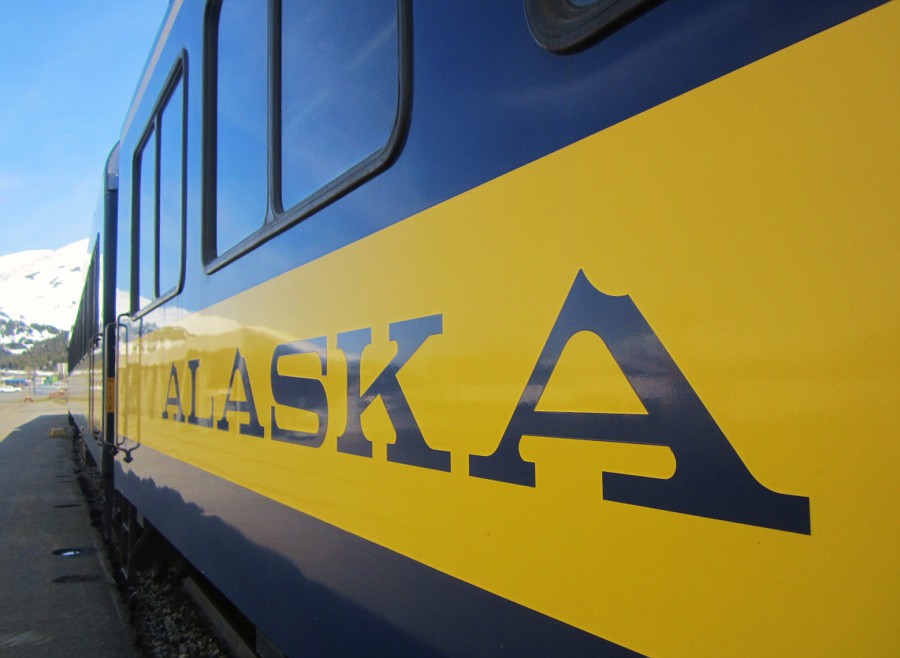
Alaska Railroad Coach Car
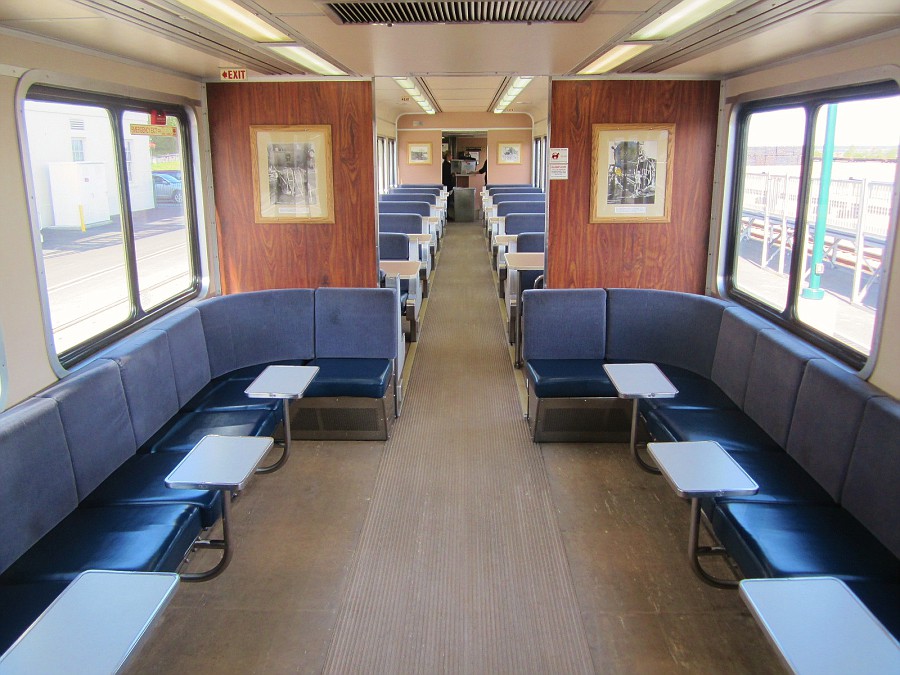
Café/Lounge Car
Service to Whittier is all-economy class with today’s consist featuring two flat top coaches and one café/lounge. Whittier is on the west side of Prince William Sound, about 60 miles southeast of Anchorage. That translates into a little over two hours ride each way.
Surprisingly we were only about half full, so boarding was a leisurely affair. Soon we were accelerating through the Anchorage suburbs, literally rolling past one back yard after another. Those of us standing in the vestibules exchanged waves with almost everybody we passed. I don’t know what it is with waving at trains, but it’s a nice gesture that seems to leave everyone involved feeling just a little bit better about their day.
Before long the city environs were behind us, replaced by the shimmering blue waters of Turnagain Arm. During the summer months the railroad employs high school age guides onboard each car. Our guide turned out to be the son of a lady who used to drive in Denali Park about 20 years ago. I was acquainted with his mom but as we worked in different divisions of the Transportation Department I can’t say as I knew her well. She clearly had done a good job of passing along some of her interpretive skills because her son who did an excellent job of explaining the history and geology of the area. Since I wasn’’t taking notes, I’ll let these pictures tell some of the story …
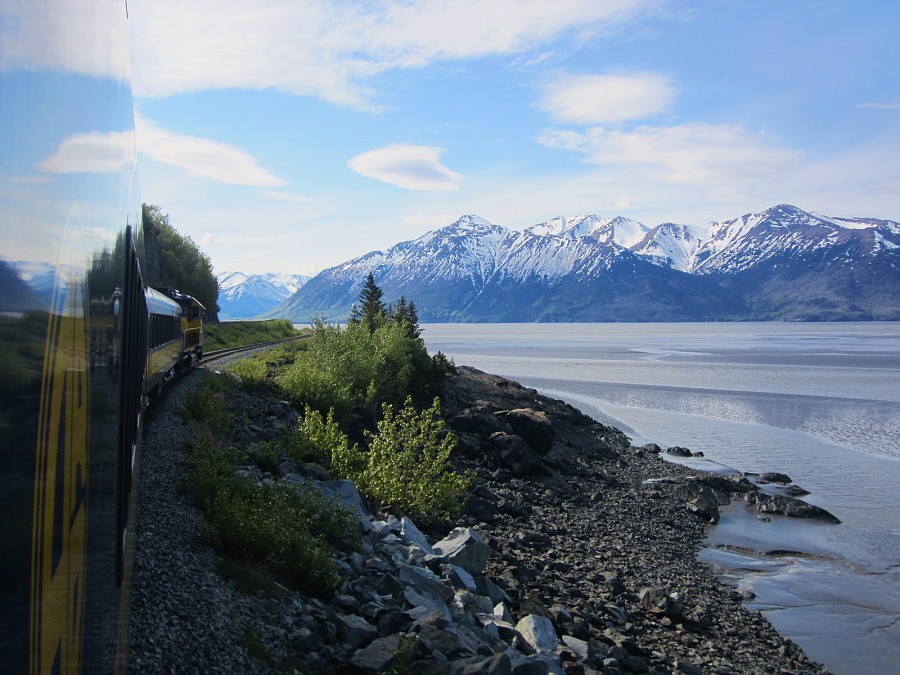
Rollin’ southbound along Turnagain Arm
Wow! This is even closer to the shore than the Coast Starlight!
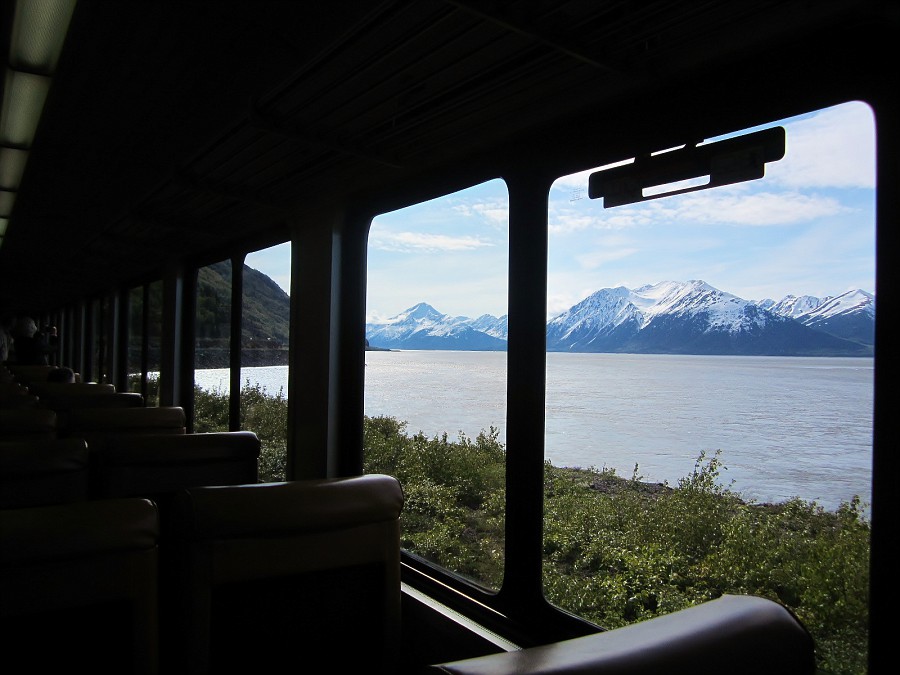
Turnagain Arm as viewed from the coach car
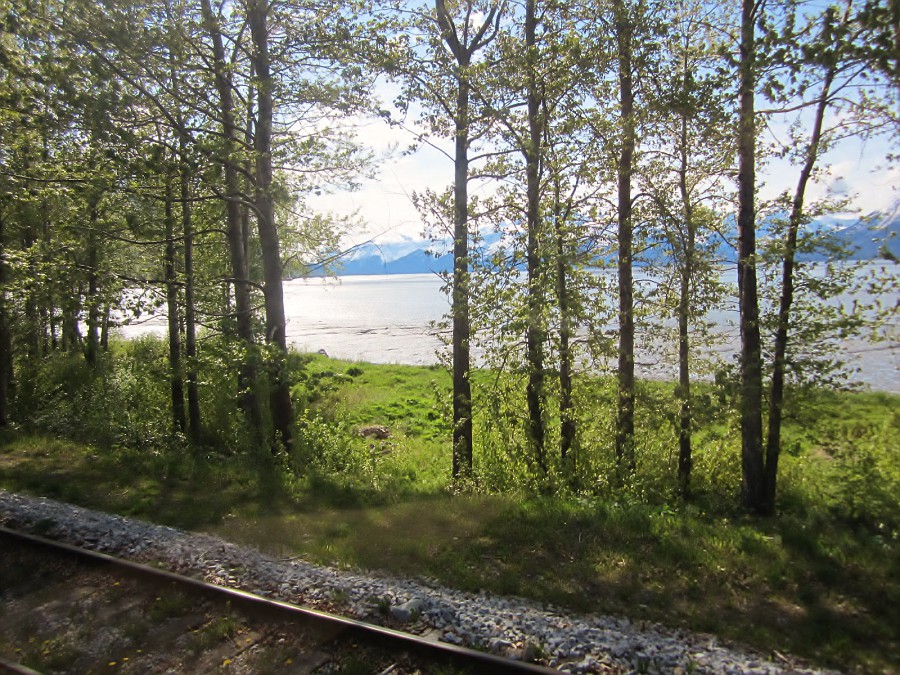
Springtime along the coast
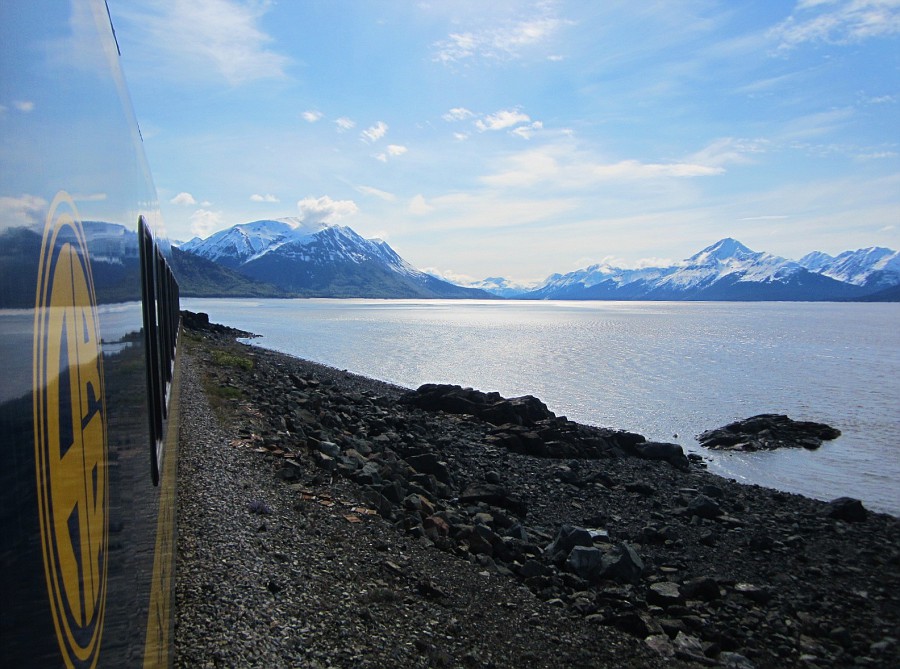
Approaching the tunnel
Just prior to arrival in Whittier we had to go through two tunnels that have an interesting history dating back to the beginnings of Whittier itself. Originally known as Camp Sullivan, Whittier was constructed to be a military facility, complete with port and railroad terminus. The real problem was getting the railroad in there. Whittier sits at the top of Passage Canal and two large mountains cut off the port from the broad Portage Valley where the main line of the Alaska Railroad runs. Prior to the Army constructing Camp Sullivan, the only way out of the port was to climb over Portage Pass and traverse the eastern edge of Portage Glacier down to Bear Valley. From there one could walk the front of the glacier onto the base of Begich Peak and then drop down to Portage Valley. No way were they going to lay tracks over that! A tunnel would have to be built. Two tunnels, in fact. A one mile tunnel was needed to get under Begich Peak, and a 2.5 mile tunnel to get through Maynard Mountain. Construction began in 1941 and two years later it was completed.
For years both tunnels were limited to the railroad. Cars coming into Whittier were loaded onto flatbed railcars. Increasing tourism spurred the modification of the longer tunnel to allow for automobile use as well.
That tunnel was transformed into a one-lane, combination highway and railway tunnel that allows cars and trains to take turns traveling through the tunnel. At 13,300 feet long or 2.5 miles, it is the second longest highway tunnel and the longest combined rail and highway tunnel in North America. Our guide also pointed out that this was the first tunnel to have jet turbine and portal fan ventilation. Additionally the tunnel is designed to be operational in 150 mph winds and in temperatures as low as -40° F. Why anybody would be out in those conditions is a mystery to me, but the tunnel would be there for them if they were.
You’ve pretty much arrived in Whittier – what of it there is – as soon as you exit the tunnel. We proceeded another couple hundred yards and then stopped. Welcome to Whittier - one of the most unique towns I have ever visited. Even though Whittier is now a cruise ship port, it is hardly a bustling tourism port. There is basically just the one road in town and a handful of businesses. The year round population is just over 200 people, 90% of whom live in the Begich Towers, a 14 story structure built by the Army in the 1950s for family housing and bachelor officer quarters. When the Army pulled out of Whittier in 1960, the building was converted to condominiums and offices. In town are a couple of small restaurants and cafes with the remainder of the businesses appearing to be tourism related such as boat charters and kayak rentals.
The cruise dock is just across the street from the Railroad Depot. Since lunch was included in the price of the cruise, I had no need to buy anything in town. As such, I presented my ticket and climbed aboard our boat for today’s cruise, the 137 foot long catamaran “Klondike Express”.
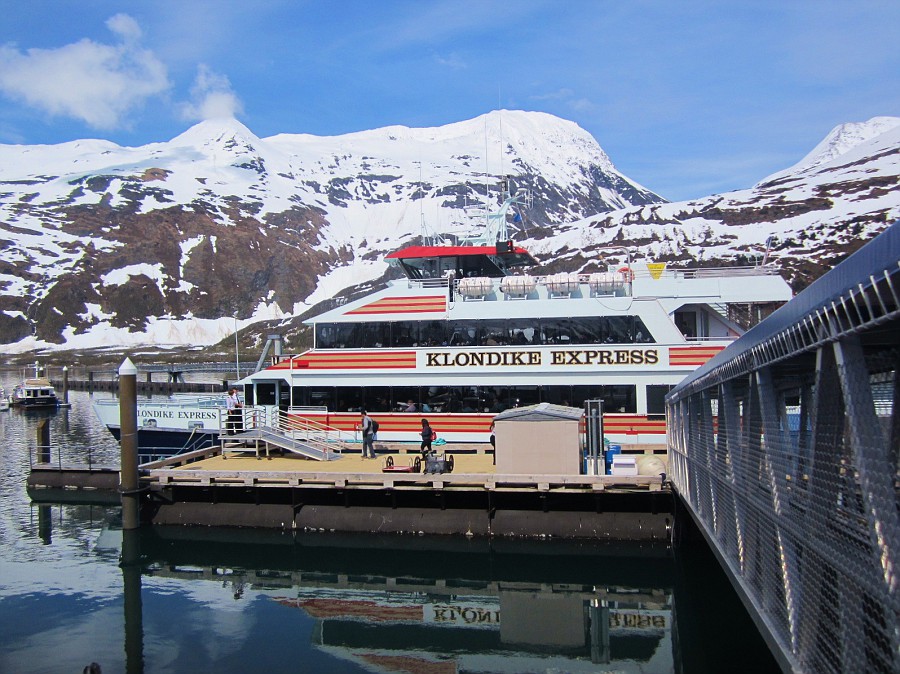
The M.V. Klondike Express
Wow! This is an impressive boat! A brochure at my table indicated that the Klondike Express is the largest, fastest and most luxurious catamaran in Alaska. Well uh, how many catamarans are there in Alaska? It really was an impressive boat though, holding up to 338 passengers on three decks, two of which are enclosed and heated. One statement I found interesting was the company’s No Sea Sickness guarantee. Seriously? I have never thrown up on a plane but three foot swells will have me running for the rails! Apparently however, the combination of the larger, more stable catamarans and the protected waters of Prince William Sound make for a much smoother ride - enough so that Phillips will guarantee a trip without sea sickness or your money back.
So the trip I’ve elected to do today is called the 26 Glacier cruise. It’s a five hour journey that takes us 145 miles around the narrow canals and fjords of Prince William Sound. It’s called the 26 Glacier cruise because that’s how many glaciers we’ll see today. Weather-wise, we had a nice mix of sun and clouds, mostly sunny. Temperatures were cool but pleasant. This should be a great trip!
Ropes were untied from the dock, engines were started and soon we were underway motoring smoothly away from the docks. The first part of the journey took us east out of Passage Canal to a narrow waterway called the Esther Passage. High mountains protect this narrow channel from rough seas and winds.
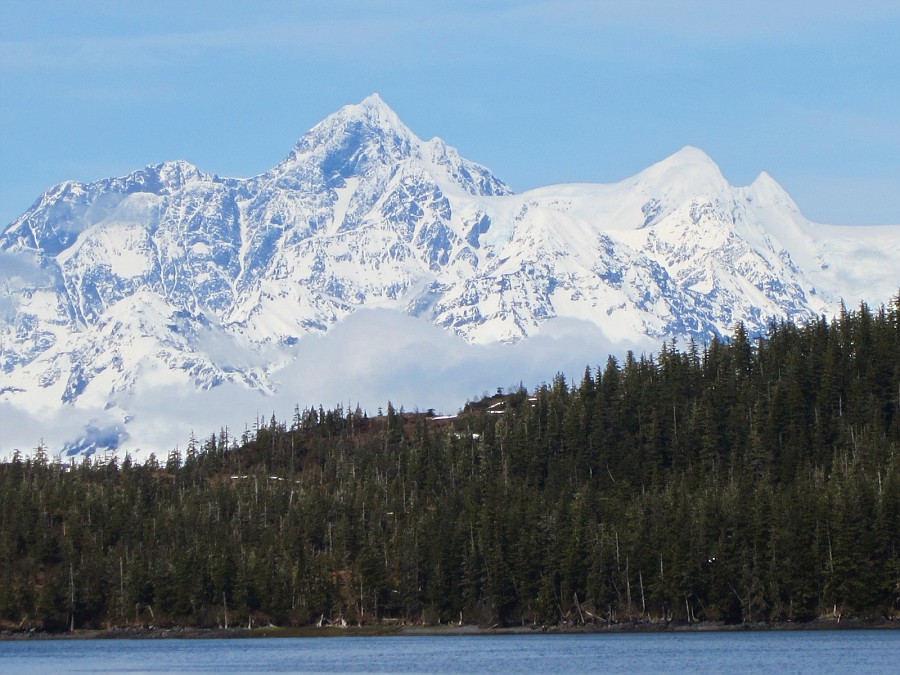
Rugged peaks rise from the Esther Passage
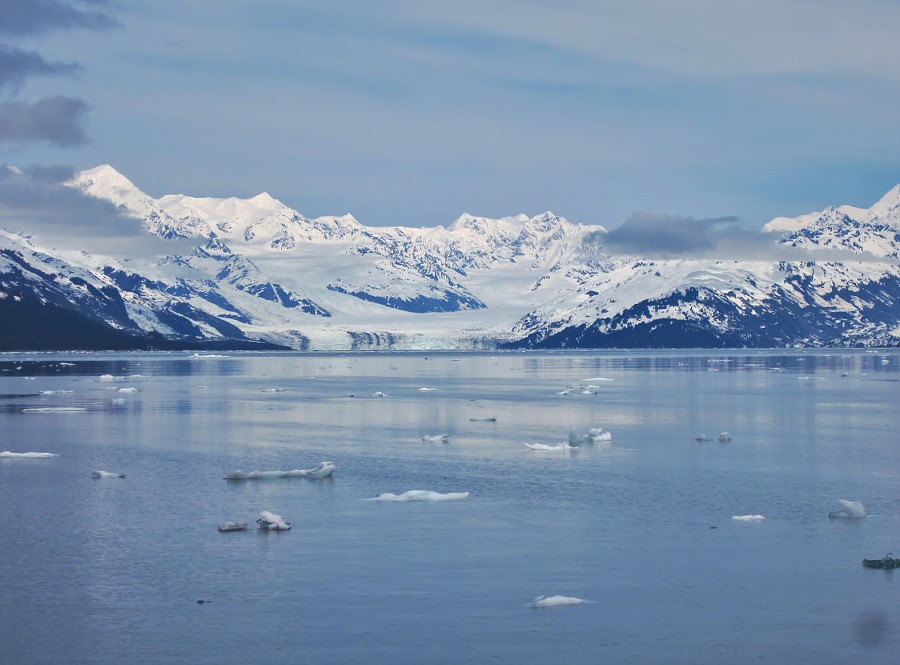
Heading out into the sound
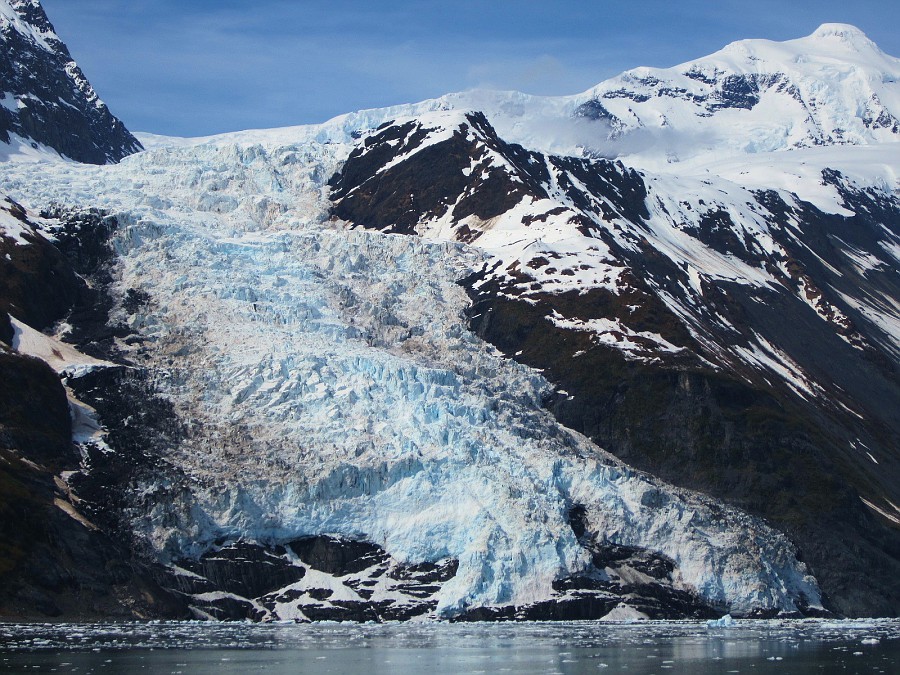
Baker Glacier
Along the way, narration about the natural history of the area was provided by the crew. They pointed out a sea lion rookery not far from Whittier but as all of the animals appeared to be lying down, they blended in too well with the surrounding rocks for a good photo.
Esther Passage opens into College Fjord where our boat turned for a panoramic view of the glaciers, all of which are named after eastern colleges.
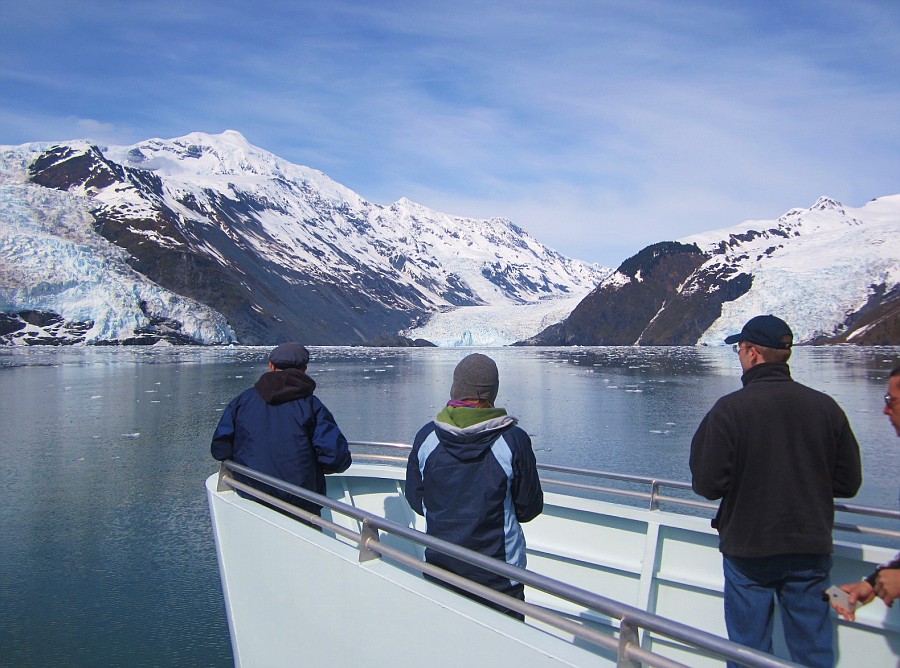
College Fjord
Next, we continued on to the Barry Arm and Surprise Glacier, located in Harriman Fjord. The water was dotted with chunks of ice and we got within a couple hundred yards of the glacier before the captain cut the motors and allowed us to drift and take in the magnificent view for a while.
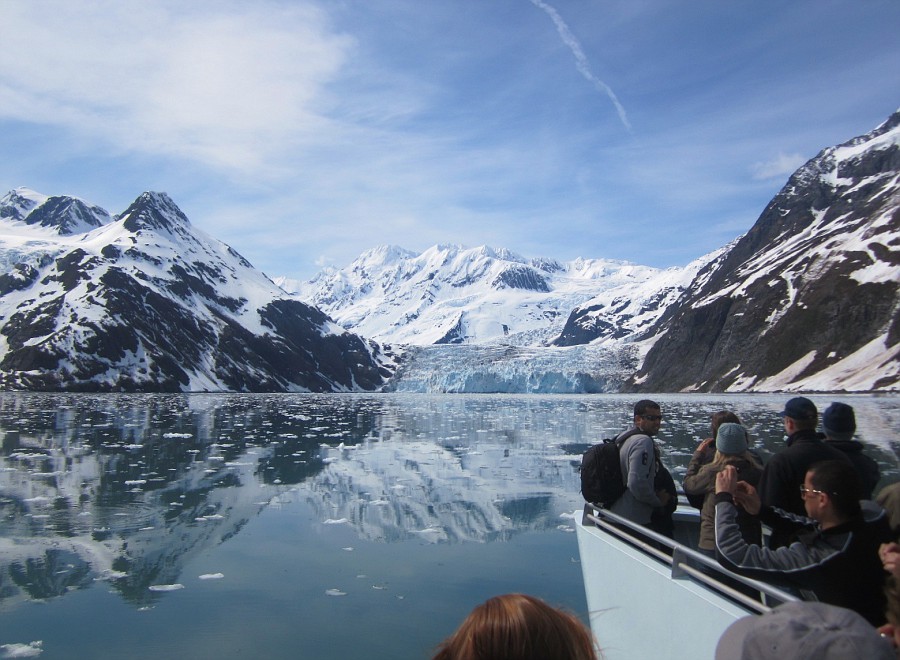
Approaching Surprise Glacier
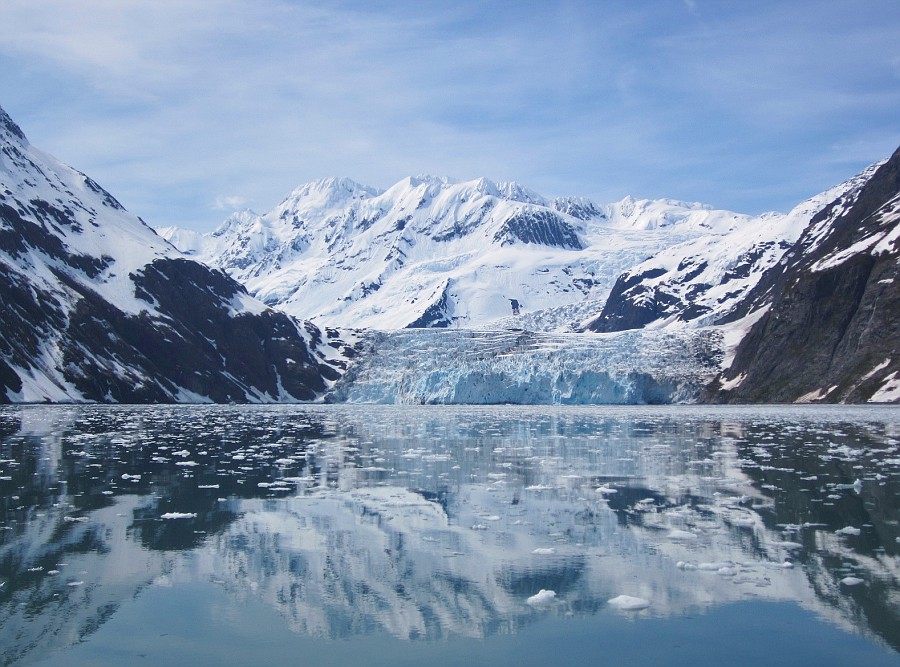
Surprise Glacier
While we were here, now seemed like an excellent time for lunch. It’s included in the cost of the cruise and comes with a choice of three different entrees. You make your selection when you make your reservation, so everyone gets what they want! Let’s consider the options…
•Alaskan Amber Beer Battered Wild Alaska Cod served with Alaska Chip Company potato chips and coleslaw
•All White Meat Chicken Strips served with Alaska Chip Company potato chips with coleslaw
•Teriyaki Bowl with tofu, vegetables and brown rice served with rice pudding and a side of coleslaw
The beer battered cod sounded good to me and indeed it was. Too bad there weren’t seconds because I could easily have downed another couple of pieces!
One of the nicest aspects of this boat was that all of the seating was in comfortable upholstered booths with tables and large picture windows. Seating is not assigned so sit wherever’s open. Perhaps it was because of the early season but our load was light today – maybe one hundred people – and so I got a table to myself. The views during lunch were spectacular!
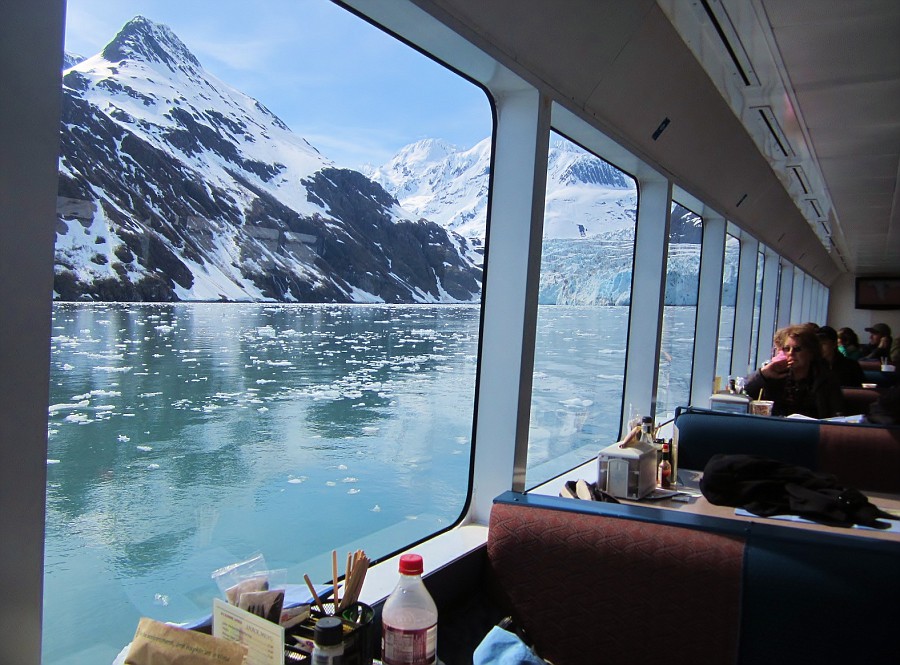
Glacier Scenery from my table
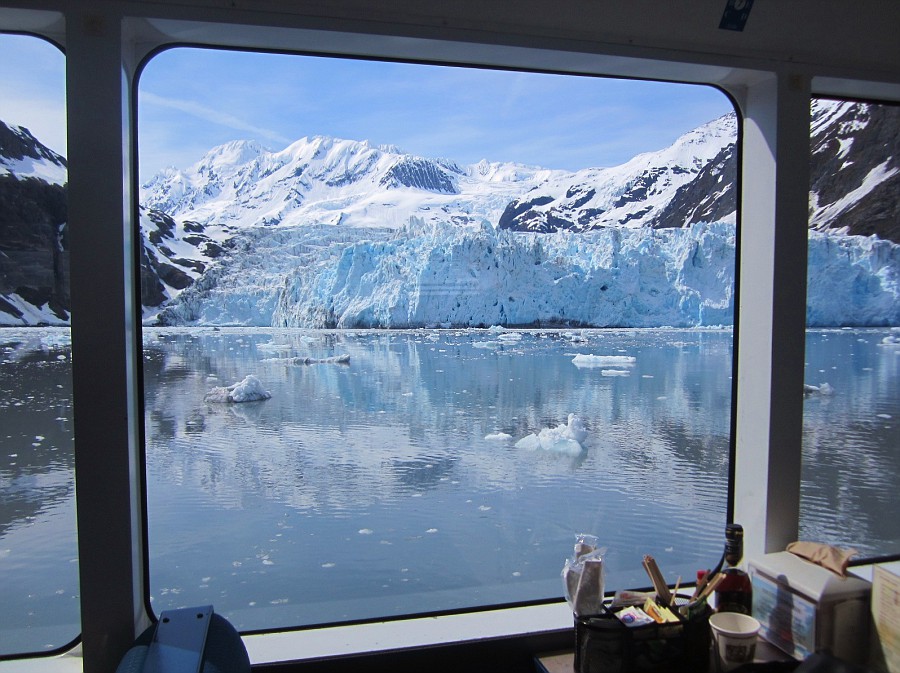
Glacier Scenery from my table
Time flies when you’re having fun and before long we were on our way back to Whittier. On the return trip we stopped at a kittiwake bird rookery that is located just across the bay from Whittier. Our guide explained that about 10,000 birds nest in these rocky cliffs each summer. They train their young in the art of fishing kittiwake-style and then come August they all fly south for the winter.
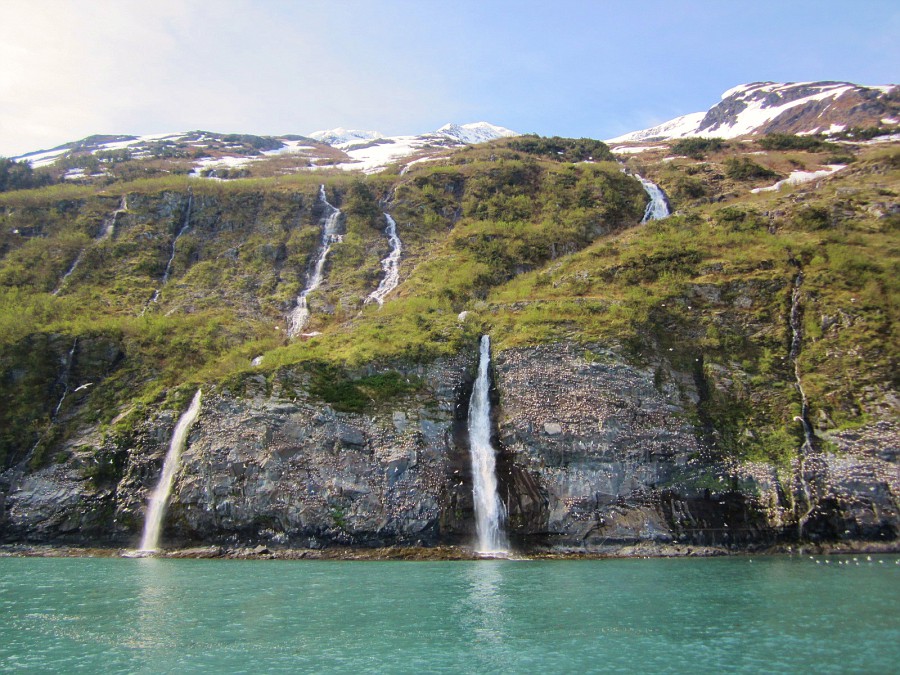
Glacial waterfalls crash into the sound

Kittiwake Rookery
Arriving back in port, I thanked the crew for a great trip and then made my way across the road to our waiting train.

All Aboard at Whittier
It’s a two and a half hour ride from Whittier back up to Anchorage. It was a beautiful late spring evening and the lower angle of the sun promised some beautiful photographs on the way back. Check ‘em out!
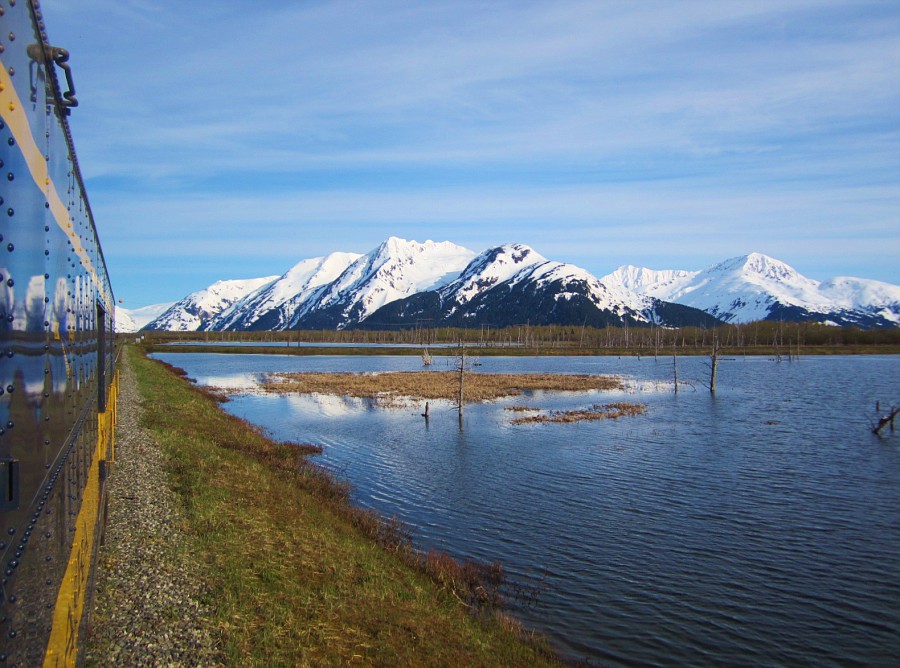
North to Anchorage through the Portage Valley
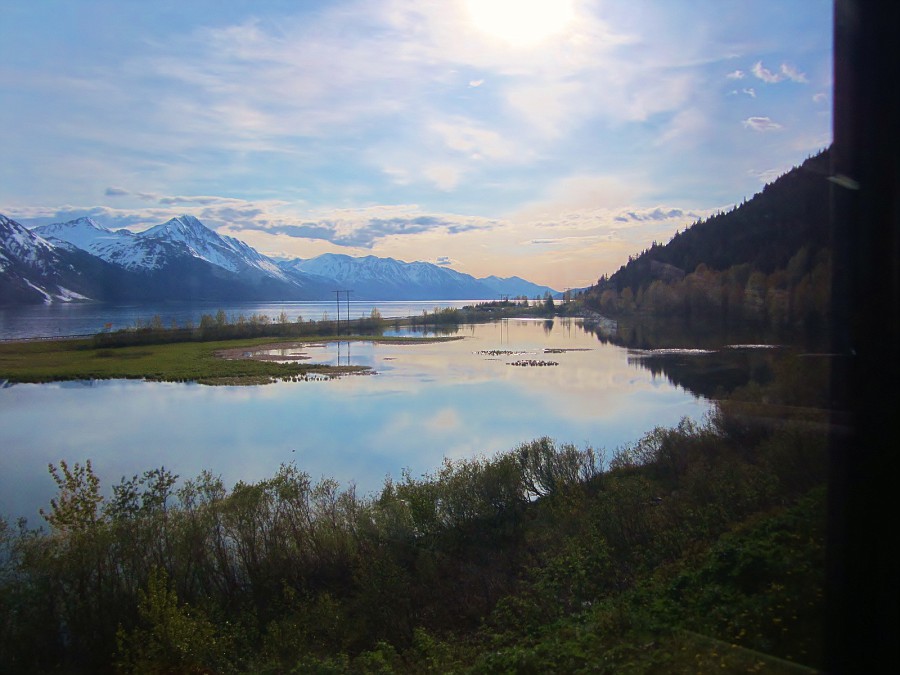
Early evening shadows on Turnagain Arm
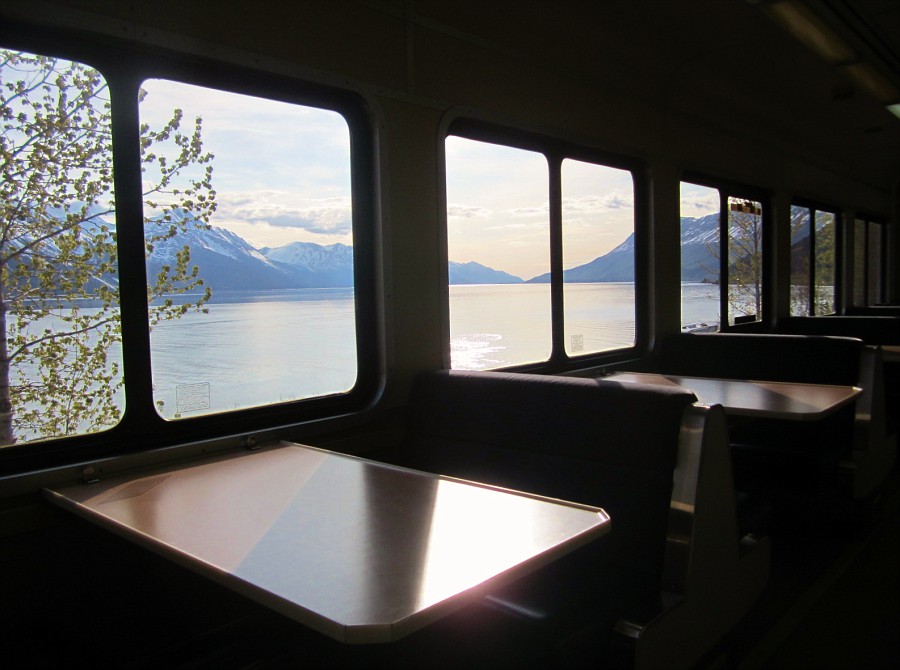
Evening view from the Café Lounge

Alaska Railroad at Girdwood – 20 miles south of Anchorage
Photo courtesy of Alaska Railroad
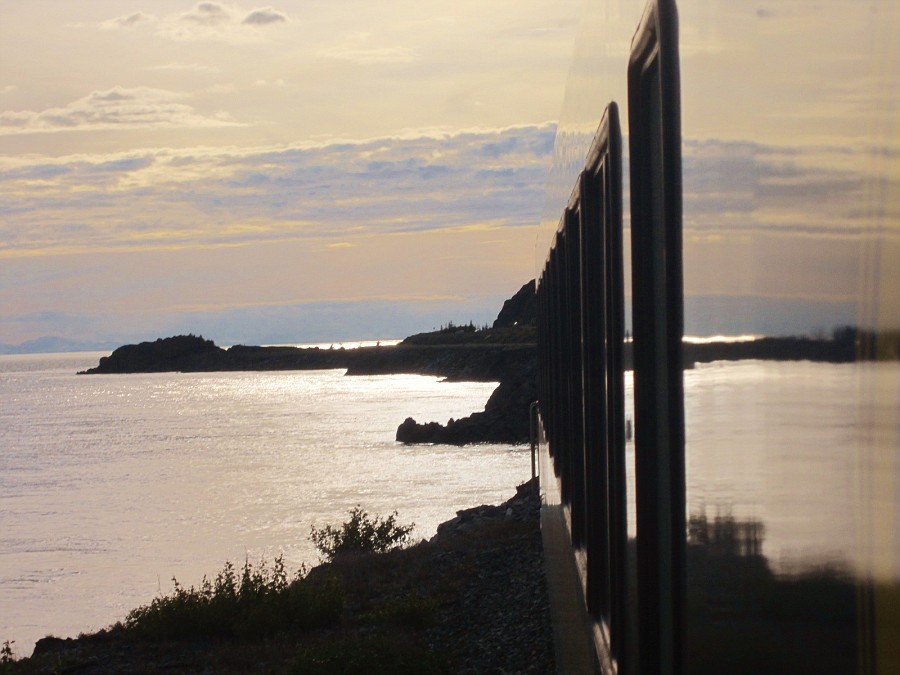
Approaching Anchorage at 9:00pm
For anyone with a spare day in Anchorage, this trip would be a great way to spend the day. I particularly liked the leisurely mid-morning departure of the train. After all, if you’re on vacation, who wants to get up at 5:30am? The cruise is easily booked through the link I highlighted and of course another option would be to drive from Anchorage down to Whittier. However you go, I hope you get a sunny day!
Alaska Railroad Anchorage to Whittier 945a – 1205p “Glacier Discovery”
Phillips Cruises 26 Glacier Cruise 1230p – 530p “Klondike Express”
Alaska Railroad Whittier to Anchorage 645p – 915p “Glacier Discovery”
In all my years in Alaska, I have yet to take a glacier cruise. This is primarily due to the fact that I live and work hundreds of miles from the coast. Additionally, I really enjoy life in Alaska’s Interior (All that land immediately north of the Alaska Range) and am not particularly drawn to the coastal regions. I’ve always enjoyed visiting them but life on or near the sea is not of great value to me.
That said, some of Alaska’s most spectacular scenery can be found along its coastal regions. The state has over 2000 miles of coastline that includes fjords, glaciers and high rugged peaks that jut precipitously skyward from the coast. There are 616 officially named glaciers in Alaska and many more unnamed glaciers. The Alaska Almanac estimates that Alaska has over 100,000 glaciers with the majority of those being found in the coastal regions. After nearly thirty years of living here, I reckon it’s high time I went down to the coast and got a close up view of some of them.
Generally the best way to see coastal or tidewater glaciers is from the sea. To that end, a number of tour companies operate sight-seeing excursions from a variety of Alaskan ports. I’ve chosen to go with Phillips Cruises out of Whittier because they’ve got a good reputation for a quality experience AND they offered me a great industry discount!
Though it’s possible to drive all the way down to Whittier, I chose to drive as far south as Anchorage and then take the train from there. I’ve got friends in Anchorage I can visit and the 9:45am departure time for the train allows for a relaxed and leisurely pace. So - in the interests of brevity, let’s head on down to the Alaska Railroad Depot and get underway.
* * * * * * * * *
I remember a boat trip I once did in New Zealand’s Doubtful Sound. All of the brochures I’d looked at prior to booking the trip showed an area of spectacular beauty, made all the more so by an abundance of sunshine. The southwest coast of New Zealand’s South Island is one of the world’s wetter places however – something the brochures uniformly failed to mention - and on the day we arrived it must’ve rained a good five inches! Mist and fog shrouded the waters of the sound, obscuring any views of the lushly forested mountains that rose from the shore. As for the boat trip, we spent two hours huddled in the tiny cabin drinking tea and munching biscuits.
Whittier averages 197 inches of rain and 241 inches of snowfall per year, so I was particularly happy to see that today’s forecast indicated some clouds and sun but no precipitation. Truth be known, I’d been monitoring the forecast for a week and had it indicated a typically rainy day I would have stayed up north.
The Anchorage Railroad Depot was completed in 1942. A three story concrete building that can only be described as architecturally uninspired, it is more serviceable than attractive. I stayed inside long enough to pick up my tickets and visit the men’s room before heading outside to check out the train.

Alaska Railroad Coach Car

Café/Lounge Car
Service to Whittier is all-economy class with today’s consist featuring two flat top coaches and one café/lounge. Whittier is on the west side of Prince William Sound, about 60 miles southeast of Anchorage. That translates into a little over two hours ride each way.
Surprisingly we were only about half full, so boarding was a leisurely affair. Soon we were accelerating through the Anchorage suburbs, literally rolling past one back yard after another. Those of us standing in the vestibules exchanged waves with almost everybody we passed. I don’t know what it is with waving at trains, but it’s a nice gesture that seems to leave everyone involved feeling just a little bit better about their day.
Before long the city environs were behind us, replaced by the shimmering blue waters of Turnagain Arm. During the summer months the railroad employs high school age guides onboard each car. Our guide turned out to be the son of a lady who used to drive in Denali Park about 20 years ago. I was acquainted with his mom but as we worked in different divisions of the Transportation Department I can’t say as I knew her well. She clearly had done a good job of passing along some of her interpretive skills because her son who did an excellent job of explaining the history and geology of the area. Since I wasn’’t taking notes, I’ll let these pictures tell some of the story …

Rollin’ southbound along Turnagain Arm
Wow! This is even closer to the shore than the Coast Starlight!

Turnagain Arm as viewed from the coach car

Springtime along the coast

Approaching the tunnel
Just prior to arrival in Whittier we had to go through two tunnels that have an interesting history dating back to the beginnings of Whittier itself. Originally known as Camp Sullivan, Whittier was constructed to be a military facility, complete with port and railroad terminus. The real problem was getting the railroad in there. Whittier sits at the top of Passage Canal and two large mountains cut off the port from the broad Portage Valley where the main line of the Alaska Railroad runs. Prior to the Army constructing Camp Sullivan, the only way out of the port was to climb over Portage Pass and traverse the eastern edge of Portage Glacier down to Bear Valley. From there one could walk the front of the glacier onto the base of Begich Peak and then drop down to Portage Valley. No way were they going to lay tracks over that! A tunnel would have to be built. Two tunnels, in fact. A one mile tunnel was needed to get under Begich Peak, and a 2.5 mile tunnel to get through Maynard Mountain. Construction began in 1941 and two years later it was completed.
For years both tunnels were limited to the railroad. Cars coming into Whittier were loaded onto flatbed railcars. Increasing tourism spurred the modification of the longer tunnel to allow for automobile use as well.
That tunnel was transformed into a one-lane, combination highway and railway tunnel that allows cars and trains to take turns traveling through the tunnel. At 13,300 feet long or 2.5 miles, it is the second longest highway tunnel and the longest combined rail and highway tunnel in North America. Our guide also pointed out that this was the first tunnel to have jet turbine and portal fan ventilation. Additionally the tunnel is designed to be operational in 150 mph winds and in temperatures as low as -40° F. Why anybody would be out in those conditions is a mystery to me, but the tunnel would be there for them if they were.
You’ve pretty much arrived in Whittier – what of it there is – as soon as you exit the tunnel. We proceeded another couple hundred yards and then stopped. Welcome to Whittier - one of the most unique towns I have ever visited. Even though Whittier is now a cruise ship port, it is hardly a bustling tourism port. There is basically just the one road in town and a handful of businesses. The year round population is just over 200 people, 90% of whom live in the Begich Towers, a 14 story structure built by the Army in the 1950s for family housing and bachelor officer quarters. When the Army pulled out of Whittier in 1960, the building was converted to condominiums and offices. In town are a couple of small restaurants and cafes with the remainder of the businesses appearing to be tourism related such as boat charters and kayak rentals.
The cruise dock is just across the street from the Railroad Depot. Since lunch was included in the price of the cruise, I had no need to buy anything in town. As such, I presented my ticket and climbed aboard our boat for today’s cruise, the 137 foot long catamaran “Klondike Express”.

The M.V. Klondike Express
Wow! This is an impressive boat! A brochure at my table indicated that the Klondike Express is the largest, fastest and most luxurious catamaran in Alaska. Well uh, how many catamarans are there in Alaska? It really was an impressive boat though, holding up to 338 passengers on three decks, two of which are enclosed and heated. One statement I found interesting was the company’s No Sea Sickness guarantee. Seriously? I have never thrown up on a plane but three foot swells will have me running for the rails! Apparently however, the combination of the larger, more stable catamarans and the protected waters of Prince William Sound make for a much smoother ride - enough so that Phillips will guarantee a trip without sea sickness or your money back.
So the trip I’ve elected to do today is called the 26 Glacier cruise. It’s a five hour journey that takes us 145 miles around the narrow canals and fjords of Prince William Sound. It’s called the 26 Glacier cruise because that’s how many glaciers we’ll see today. Weather-wise, we had a nice mix of sun and clouds, mostly sunny. Temperatures were cool but pleasant. This should be a great trip!
Ropes were untied from the dock, engines were started and soon we were underway motoring smoothly away from the docks. The first part of the journey took us east out of Passage Canal to a narrow waterway called the Esther Passage. High mountains protect this narrow channel from rough seas and winds.

Rugged peaks rise from the Esther Passage

Heading out into the sound

Baker Glacier
Along the way, narration about the natural history of the area was provided by the crew. They pointed out a sea lion rookery not far from Whittier but as all of the animals appeared to be lying down, they blended in too well with the surrounding rocks for a good photo.
Esther Passage opens into College Fjord where our boat turned for a panoramic view of the glaciers, all of which are named after eastern colleges.

College Fjord
Next, we continued on to the Barry Arm and Surprise Glacier, located in Harriman Fjord. The water was dotted with chunks of ice and we got within a couple hundred yards of the glacier before the captain cut the motors and allowed us to drift and take in the magnificent view for a while.

Approaching Surprise Glacier

Surprise Glacier
While we were here, now seemed like an excellent time for lunch. It’s included in the cost of the cruise and comes with a choice of three different entrees. You make your selection when you make your reservation, so everyone gets what they want! Let’s consider the options…
•Alaskan Amber Beer Battered Wild Alaska Cod served with Alaska Chip Company potato chips and coleslaw
•All White Meat Chicken Strips served with Alaska Chip Company potato chips with coleslaw
•Teriyaki Bowl with tofu, vegetables and brown rice served with rice pudding and a side of coleslaw
The beer battered cod sounded good to me and indeed it was. Too bad there weren’t seconds because I could easily have downed another couple of pieces!
One of the nicest aspects of this boat was that all of the seating was in comfortable upholstered booths with tables and large picture windows. Seating is not assigned so sit wherever’s open. Perhaps it was because of the early season but our load was light today – maybe one hundred people – and so I got a table to myself. The views during lunch were spectacular!

Glacier Scenery from my table

Glacier Scenery from my table
Time flies when you’re having fun and before long we were on our way back to Whittier. On the return trip we stopped at a kittiwake bird rookery that is located just across the bay from Whittier. Our guide explained that about 10,000 birds nest in these rocky cliffs each summer. They train their young in the art of fishing kittiwake-style and then come August they all fly south for the winter.

Glacial waterfalls crash into the sound

Kittiwake Rookery
Arriving back in port, I thanked the crew for a great trip and then made my way across the road to our waiting train.

All Aboard at Whittier
It’s a two and a half hour ride from Whittier back up to Anchorage. It was a beautiful late spring evening and the lower angle of the sun promised some beautiful photographs on the way back. Check ‘em out!

North to Anchorage through the Portage Valley

Early evening shadows on Turnagain Arm

Evening view from the Café Lounge

Alaska Railroad at Girdwood – 20 miles south of Anchorage
Photo courtesy of Alaska Railroad

Approaching Anchorage at 9:00pm
For anyone with a spare day in Anchorage, this trip would be a great way to spend the day. I particularly liked the leisurely mid-morning departure of the train. After all, if you’re on vacation, who wants to get up at 5:30am? The cruise is easily booked through the link I highlighted and of course another option would be to drive from Anchorage down to Whittier. However you go, I hope you get a sunny day!
Last edited by Seat 2A; Dec 25, 2014 at 1:38 pm
#14
FlyerTalk Evangelist
Original Poster
Join Date: Apr 2001
Location: East Ester, Alaska
Programs: Alaska Million Miler, United Million Miler, Wyndham Rewards Diamond, Choice Hotels Diamond
Posts: 12,148
July 10, 2014
Alaska Railroad Seward to Anchorage 600p – 1015p “Coastal Classic”
Alright then, let’s fast forward to mid-July. I only had my usual two day weekend to work with but that would be enough for what I’d like to do. Specifically I want to ride the Alaska Railroad between Seward and Anchorage. Having done so, I’ll have completed riding over every mile of passenger rail available on the Alaska Railroad. The Seward to Anchorage route, while not as heavily travelled as the Anchorage – Denali Park – Fairbanks run, is from what I have heard the more scenic of the two. Indeed, now that I’ve ridden it I’d have to say it offers the most dramatic scenery of any standard gauge railway I’ve ever ridden upon. Anywhere.
So – feel like tagging along?
Hellooooooooooooooo! Is anyone still out there? I can’t say as I’d blame any of you if you’ve nodded off or even moved on to a more traditional photo report depicting the good life at 38000’. After all, we’re nearly 40000 words into this saga and not one international airline has been flown upon nor even a moderately fancy hotel stayed at. What a gyp! For what it’s worth I’d love to be typing up delicious descriptions of the suite life aboard some exotic airline’s First Class but unfortunately I just don’t see anything like that coming up in the immediate future. There is this big open space between South America and Africa on my international route map that I’d like to fill someday soon. I’m also available for hire if anyone wants to me to write their trip report. All I require is an unobtrusive seat in the last row of First Class on your flights.
But seriously, for those of you that are still with me – a big Thank You for hangin’ in there! You’re real troopers and I hope you’ve found the time invested ini reading this far worthy of your time.
So then – let’s head on down to Seward and get this trip report back on the rails.
I’m starting the descriptive portion of this report from Seward because I drove to Anchorage and then took a bus down to Seward. There was nothing particularly interesting about that save for my first visit to the Moose’s Tooth Brewery. It was located just around the corner from the bus office and provided good beer and pizza in advance of my three hour bus ride to Seward.
Seward is the origin of the Alaska Railroad. Blessed with a deep water port and a relatively mild climate that leaves the port ice free year round, it is understandable how Alaska's railroad pioneers visualized a railroad that would reach Anchorage when construction began from Seward in 1903. Due to the terrain it took six years to build the first 50 miles. Due to bankruptcies of the first two host railroads, the tracks didn’t reach Anchorage until 1914.
I should mention and indeed emphasize here that Seward is worthy of a proper visit in its own right. Whether you drive there or take the train, you’re in for a beautiful trip and once you arrive, you’ll find no shortage of things to see and do. Seward is considered the Gateway to Kenai Fjords National Park with numerous tour operators providing anything from daylong boat tours into the park to week long getaways to remote fishing lodges. Speaking of fishing, halibut charters are plentiful as are flight seeing excursions and sea kayak rentals and tours. For those who choose to stay closer to town, the Sea Life Center will provide hours of entertainment and education.
I’ve been to Seward on a couple of previous occasions and while it would have been nice to stay a little longer on this trip, with only a two day weekend to work with there’s simply no time. Thankfully Seward’s just 490 miles down the road from my home outside of Fairbanks so I’m confident I’ll be back. In the meantime, I had about an hour to kill before train time and on the advice of friends I walked over to the Smoke Shack, a barbecue restaurant located just a couple of blocks up from the train station. The restaurant operates out of an old 1930s era Alaska Railroad car and is renowned for its pulled pork sandwiches as well as its homemade sauces. I bought two sandwiches – one for eating at the restaurant and the other for later on the train. You can now add my voice to the chorus of those singing this restaurant’s praises. The pulled pork sandwiches were served on ciabatta buns with sides of baked beans and coleslaw. With the addition of the Smoke Shack’s highly regarded sweet and spicy barbecue sauce they were simply excellent!
The Alaska Railroad offers two classes of service on the 114 mile four hour trip from Seward to Anchorage. Adventure Class offers coach style seating with spacious reclining chairs, a food/bar car and a 1950s era dome car. Gold Star Class offers seating in full length dome cars featuring large curved glass windows that run from seat side up over the roof of the car. A restaurant accessible only to Gold Star passengers is located downstairs while upstairs a bartender is available to deliver complimentary non-alcoholic beverages or the usual variety of beers, wines and spirits for sale. In consideration of the beautiful scenery we’d be passing through, I think the most exciting benefit of Gold Star Class is the outdoor viewing platform located up on the second level. The railroad claims it is the only one of its kind in the world.
Here at FlyerTalk we’ve established a standard of excellence that demands only the finest in accommodations whenever reasonably possible. As such, I booked myself a seat under the glass in Gold Star Class and now awaited the call to board. Until then, let’s check out the outside of the train:
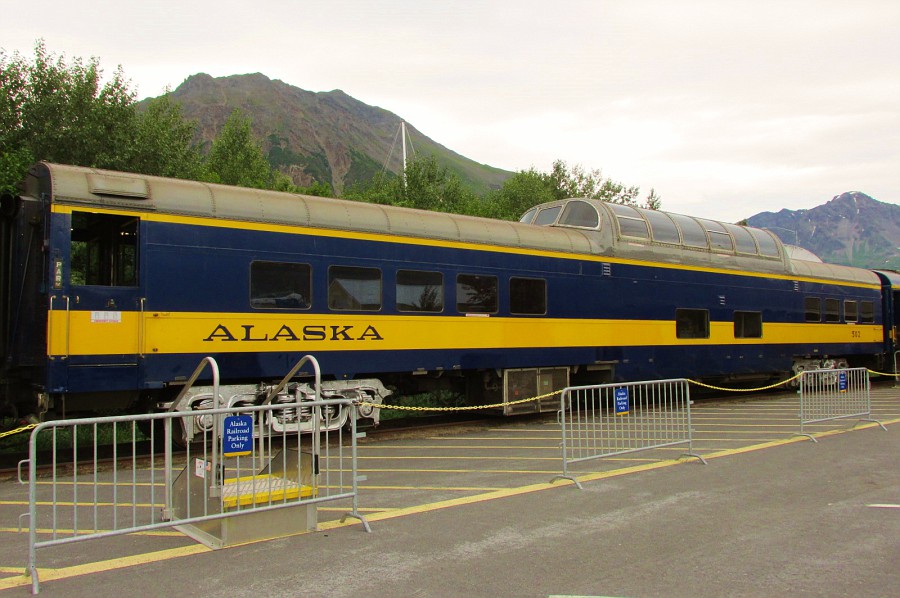
1950s era dome car on the Alaska Railroad’s “Coastal Classic”
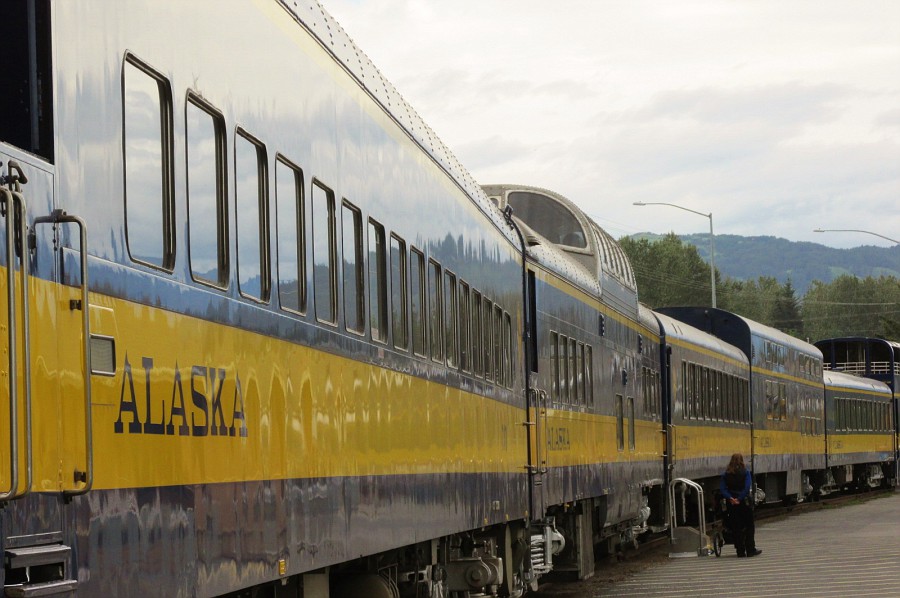
Looking down the unevenly shaped collection of cars
Unfortunately I didn’t get any decent shots of the Gold Star domes from the outside, so HERE is a photo of one courtesy of the John Combs Collection.
Once boarding was called I was able to add this view from the inside before my fellow passengers boarded.
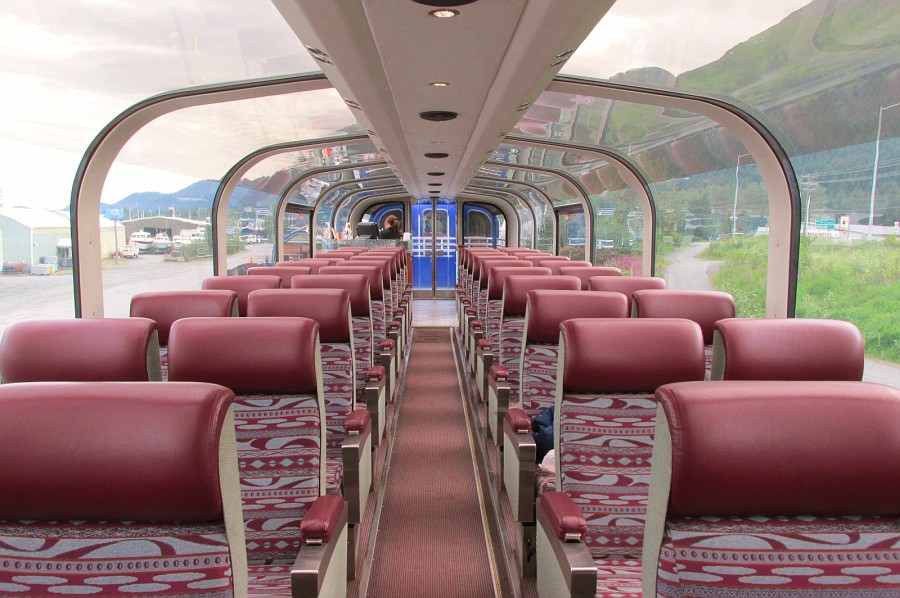
Seating under the glass on the Alaska Railroad’s Gold Star Domes
The load was fairly light this afternoon. Only about one third of the 78 available seats were taken in my car. While I hope for the railroad’s sake that on the whole they’re operating at a profit, I much prefer a half full car to a full one. There’s that much more room to spread out and with less people on board, the service often seems more relaxed and personable.
The engineer gave a couple of toots on his horn and moments later we slowly eased north out of Seward. I was standing out on the open platform. Children waved, a couple of cars honked, I thought I heard a dog bark – it was a nice send off. The skies overhead were cloudy but up ahead one could see patches of blue. I crossed my fingers and hoped for the best.
The first twenty miles of the trip was through forests and swampy land along the Snow River. The scenery along here would be considered the highlight of many rail trips but the best was yet to come. As such, I decided that now might be a good time to check out the bar/café Bistro car that serves Adventure Class travelers. This is one of the more unique railroad cars I have ever seen and for casual dining, it is also the finest I have ever seen. Here’s the MENU.
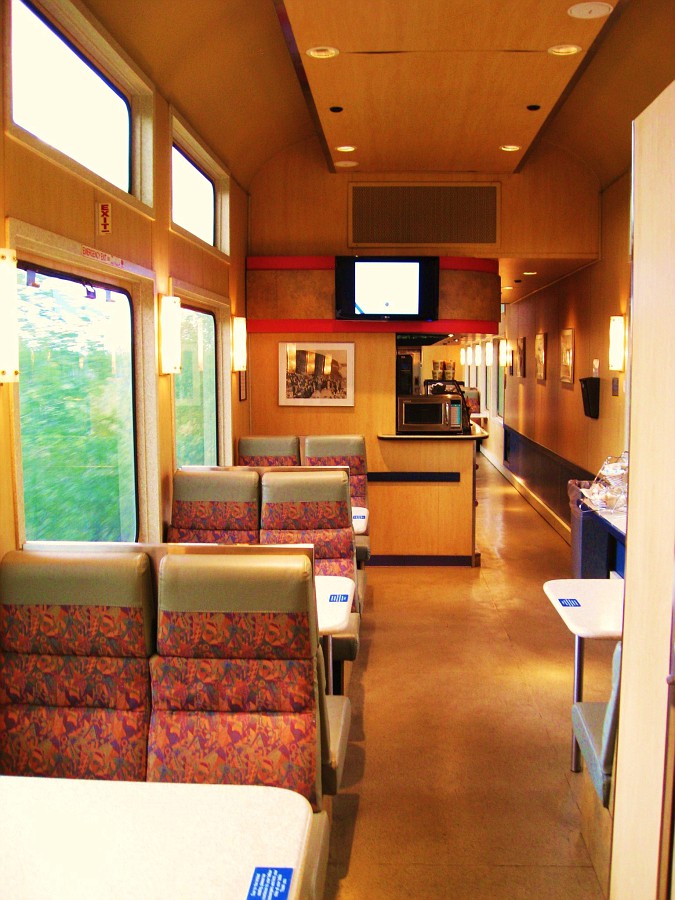
Alaska Railroad Bistro Car
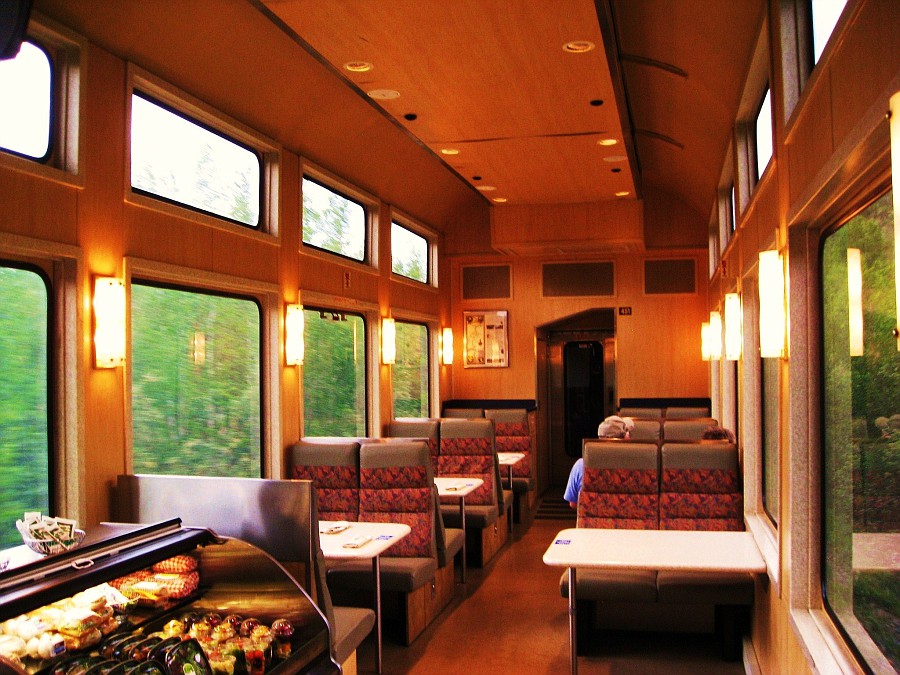
Alaska Railroad Bistro Car
Also along for the ride was an ex-Union Pacific dome coach as well as three flat top coaches. I’ve ridden on these cars plenty of times between Denali and Fairbanks, so my primary interest was in the Bistro Car. I plunked down $6.00 for a beer and chatted briefly with a couple from Bedford, New York before returning to the Gold Star car for our climb into the Kenai Mountains. Here are pictures from our run along the Snow River and Kenai Lake.
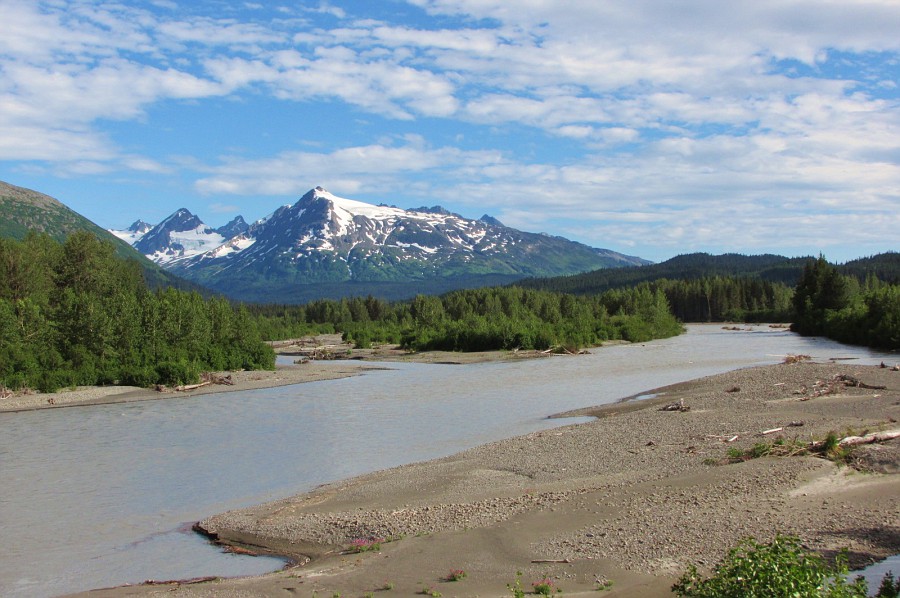
Rolling along the Snow River
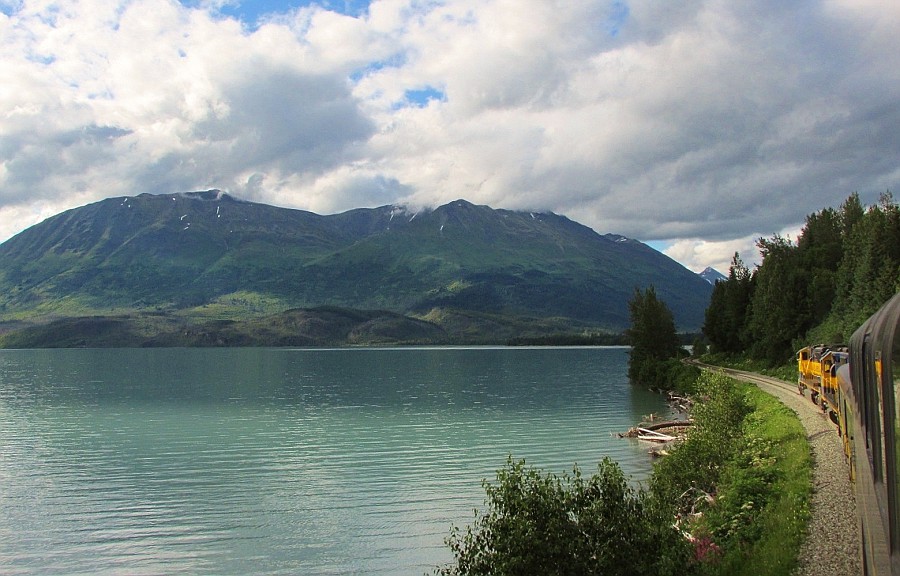
Kenai Lake
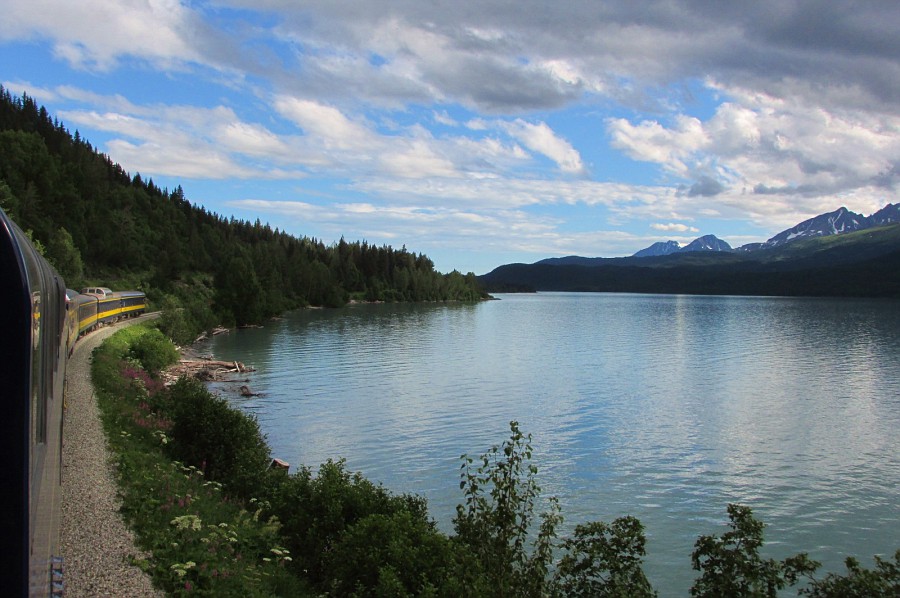
A beautiful evening along Kenai Lake
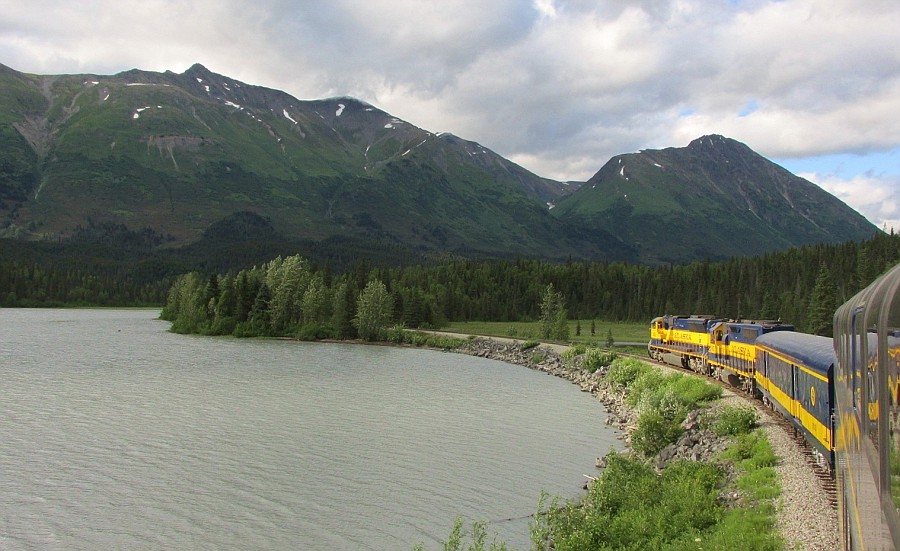
Kenai Lake
Kenai Lake is 22 miles long, though the tracks only parallel about 10 miles of it. We were fortunate to have only partly cloudy conditions as the sunshine really enhanced the beauty of the area. Keep in mind too that this is summer in Alaska and the sun stays up a lot longer. These photos were taken at about 7:00pm.
As we left Kenai Lake behind us, the tracks began to climb at a noticeably steeper grade as we made our way up through spruce forests and towering mountains toward the summit of Grandview Pass.
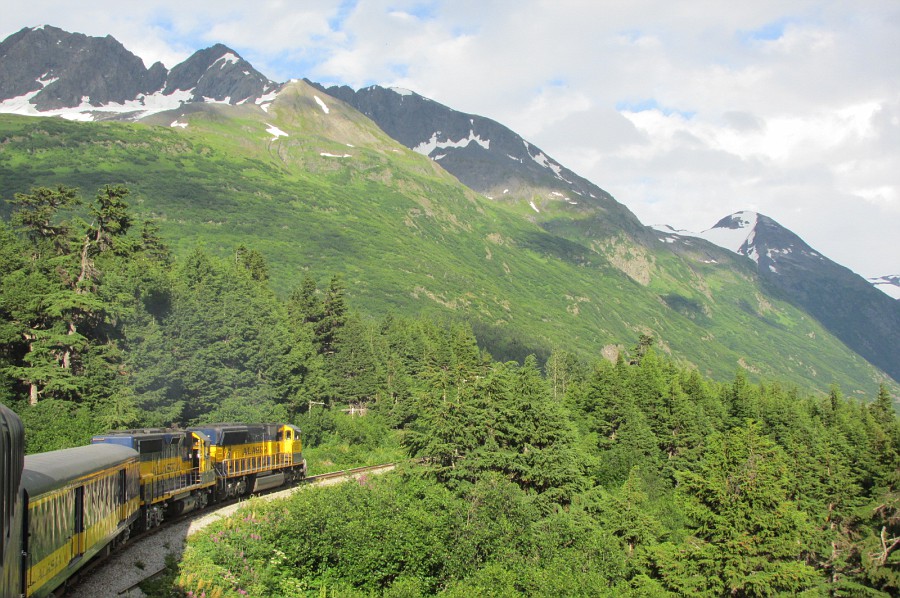
Gaining elevation…
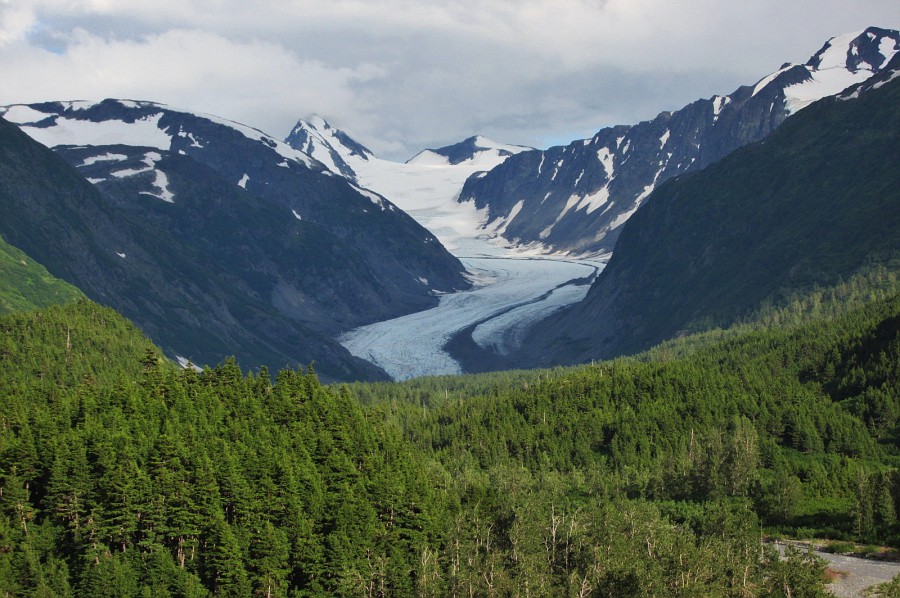
Trail Glacier
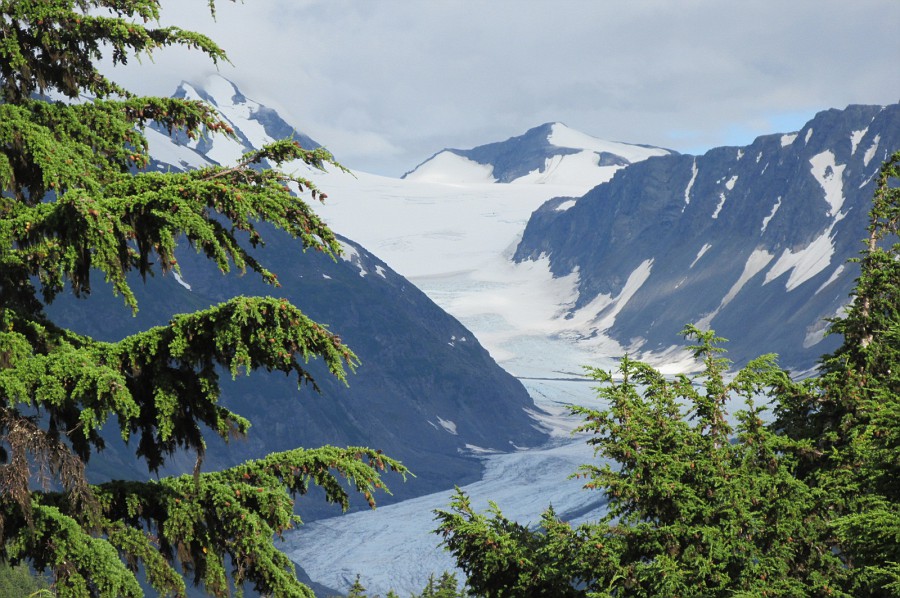
Hard to believe this view is from a train!
The highlight of this portion is the historic Loop District where the tracks make almost a complete circle to gain elevation up to the pass from the south. It is rugged spectacular scenery, and several glaciers were visible from the train.
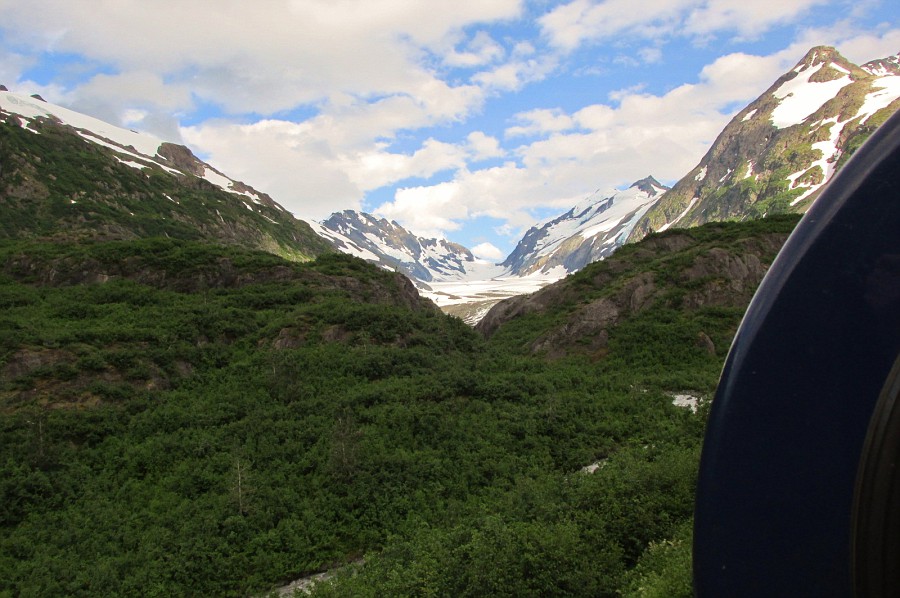
Majestic landscape
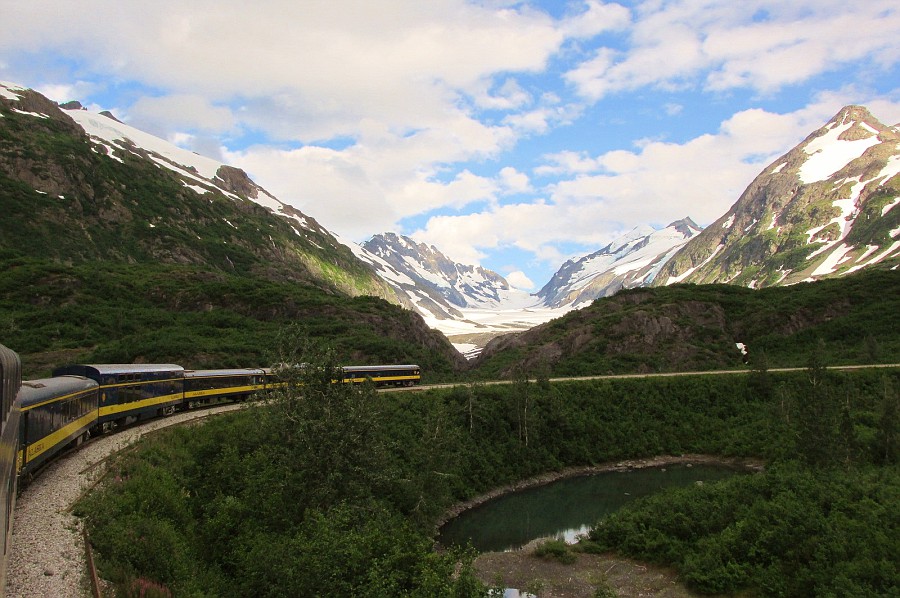
Descending through the Loop past Grandview
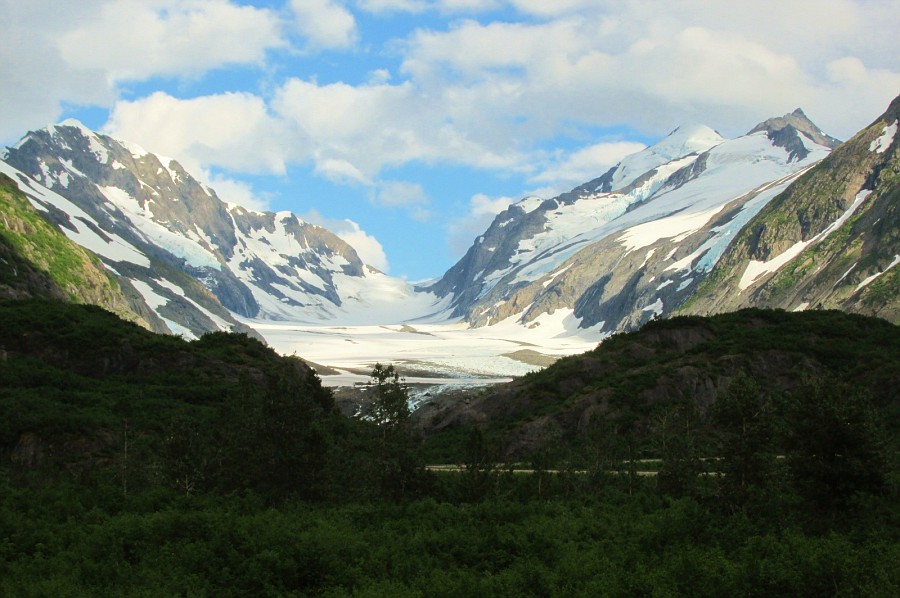
Descending through the Loop past Grandview
From Grandview we commenced a long gradual descent through lush green mountains of the Placer Valley down to sea.
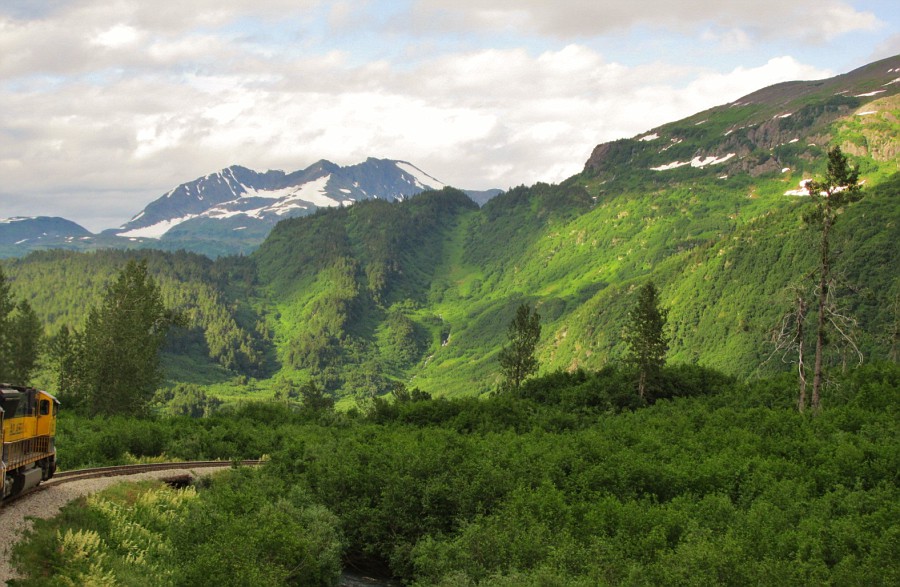
Descending from 1062’ to sea level
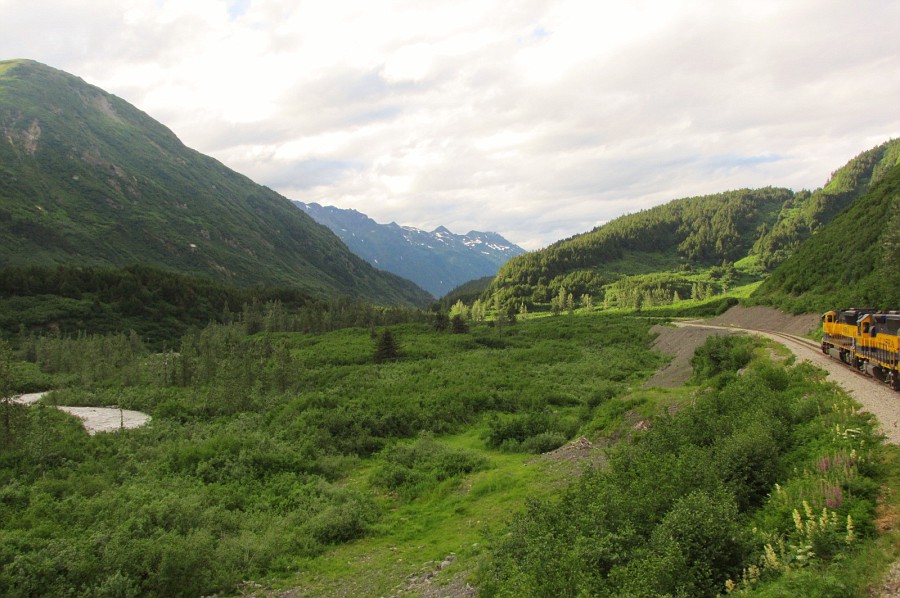
It’s a long way down that valley to the sea…
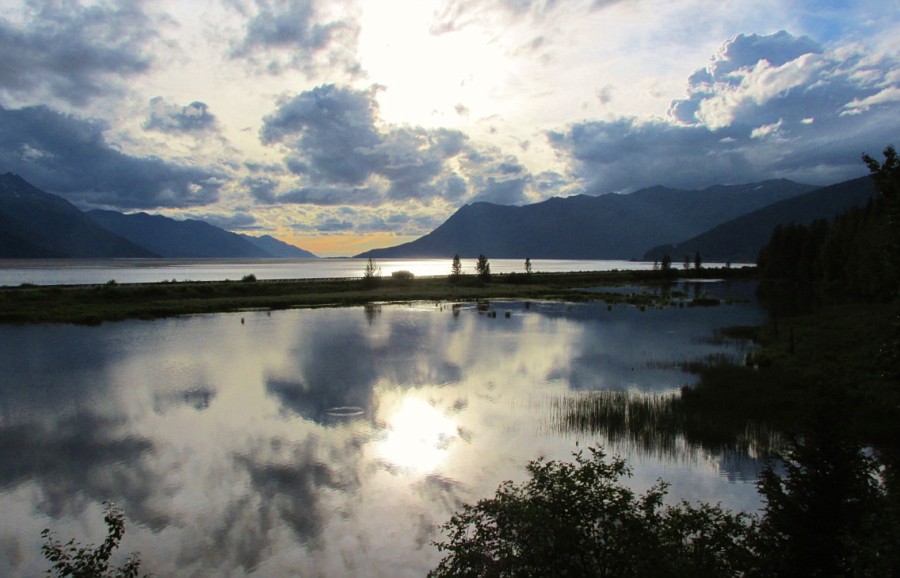
Ponds and river above Turnagain Arm
The next thirty miles were spent hugging the shores of Turnagain Arm, one of two narrow branches of the Cook Inlet which is part of the larger Gulf of Alaska. The views, particularly at this hour of day (8:30 – 9:00pm) were magnificent and once again I was thankful for even a bit of sun to brighten up the vistas.
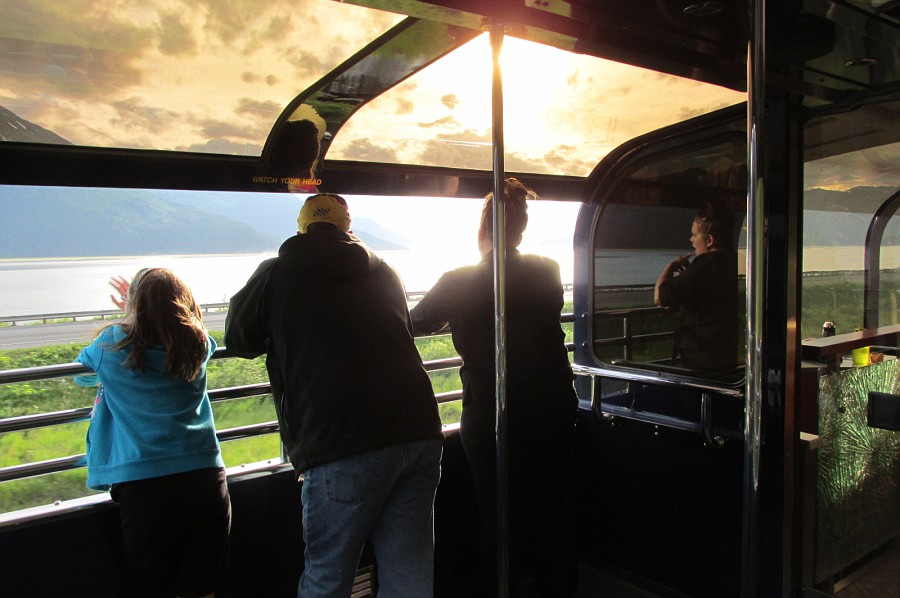
Taking in the scenery from the Gold Star car’s viewing platform
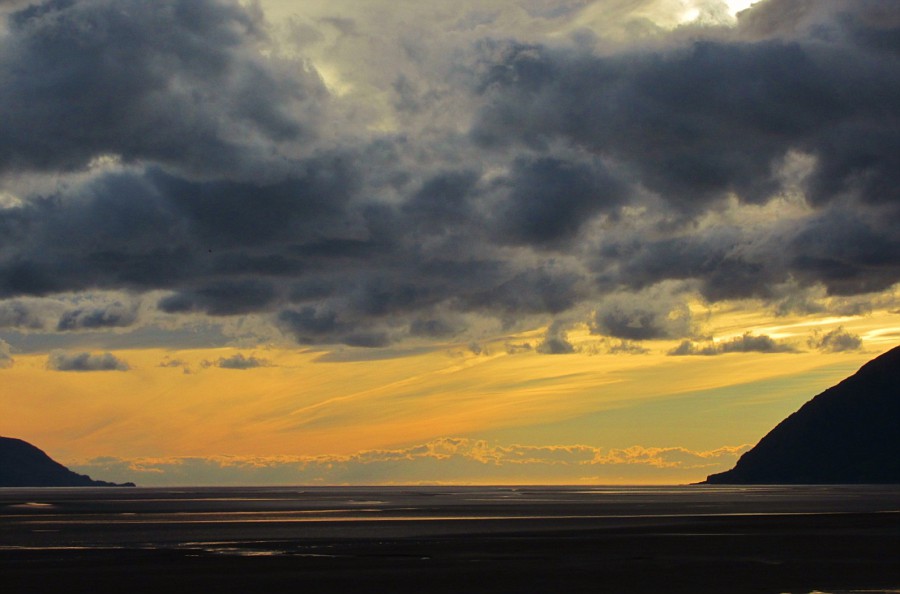
Tide’s out on Turnagain Arm
This area has some of the highest tides in the world
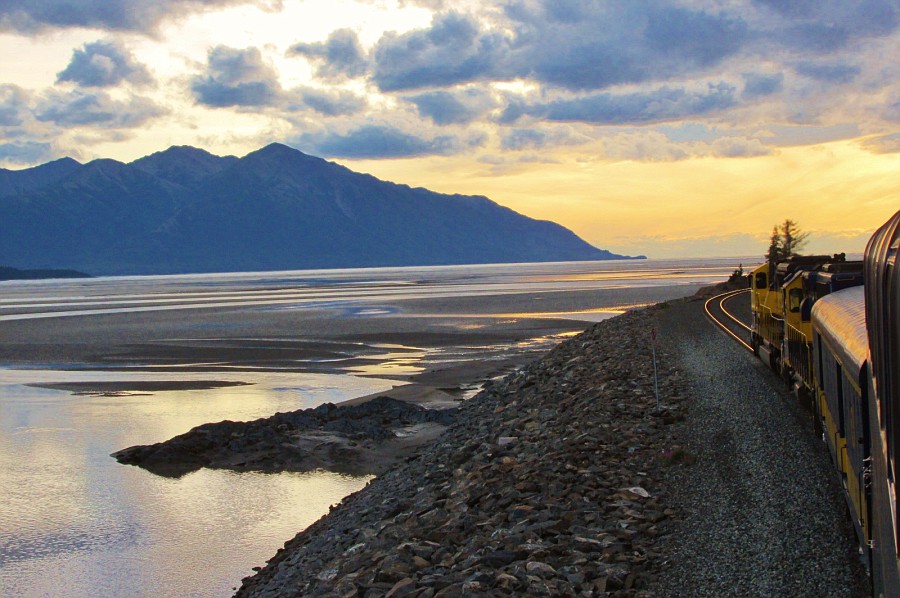
Hugging the coast of Turnagain Arm
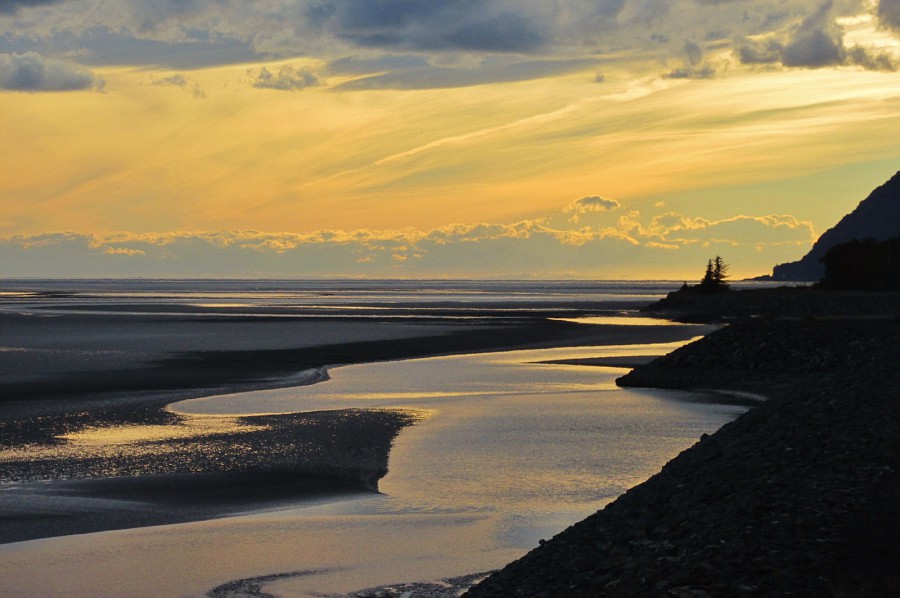
Coastal splendor
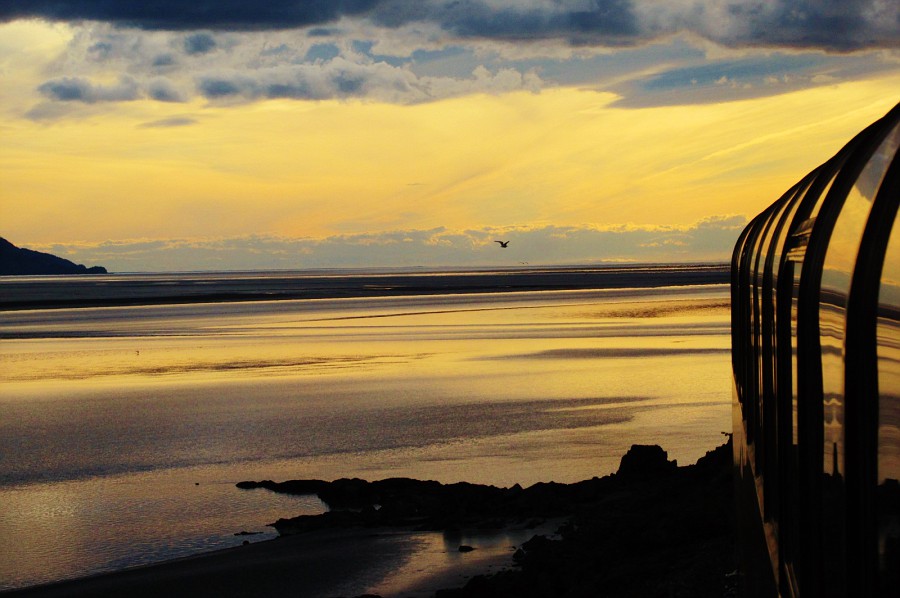
Sunset along the shore
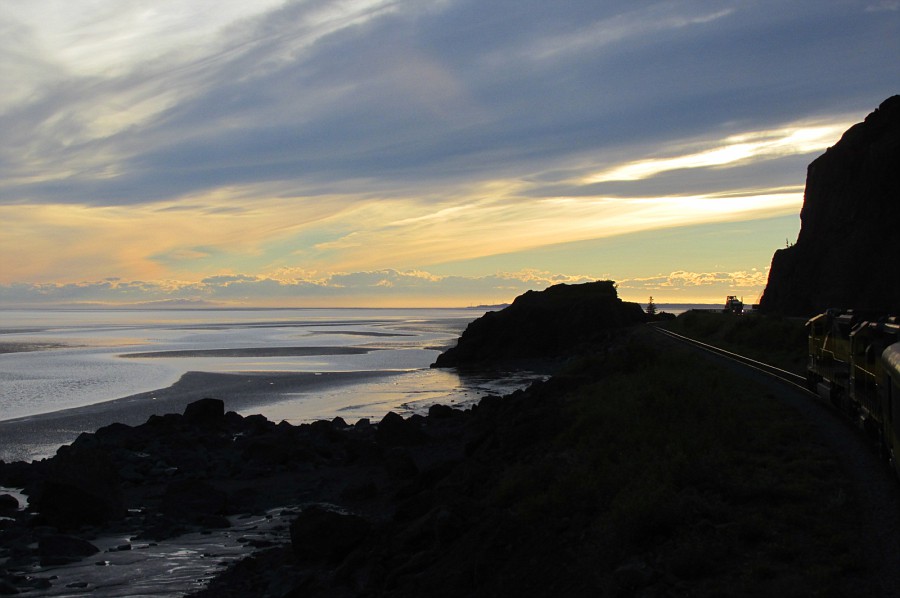
Thirty miles out of Anchorage
There was still plenty of light in the sky as we rolled into Anchorage right on time. I had a 240 mile drive back up to Denali but tonight would drive just 110 miles up to Talkeetna. It’s funny but to be honest I’ve never much cared for the drive down to Anchorage. That said, I would gladly do it again for a chance to ride this train once again. Forests, glaciers, towering snow covered mountains and gorgeous coastal scenery - mile for mile, I have to say the Seward to Anchorage branch of the Alaska Railroad has the greatest concentration of spectacular scenery I’ve ever seen anywhere in the world on a standard gauge railway. I sincerely hope that any of you that visit Alaska will be fortunate enough to ride this train yourselves under the same sunny skies that I enjoyed.
Alaska Railroad Seward to Anchorage 600p – 1015p “Coastal Classic”
Alright then, let’s fast forward to mid-July. I only had my usual two day weekend to work with but that would be enough for what I’d like to do. Specifically I want to ride the Alaska Railroad between Seward and Anchorage. Having done so, I’ll have completed riding over every mile of passenger rail available on the Alaska Railroad. The Seward to Anchorage route, while not as heavily travelled as the Anchorage – Denali Park – Fairbanks run, is from what I have heard the more scenic of the two. Indeed, now that I’ve ridden it I’d have to say it offers the most dramatic scenery of any standard gauge railway I’ve ever ridden upon. Anywhere.
So – feel like tagging along?
Hellooooooooooooooo! Is anyone still out there? I can’t say as I’d blame any of you if you’ve nodded off or even moved on to a more traditional photo report depicting the good life at 38000’. After all, we’re nearly 40000 words into this saga and not one international airline has been flown upon nor even a moderately fancy hotel stayed at. What a gyp! For what it’s worth I’d love to be typing up delicious descriptions of the suite life aboard some exotic airline’s First Class but unfortunately I just don’t see anything like that coming up in the immediate future. There is this big open space between South America and Africa on my international route map that I’d like to fill someday soon. I’m also available for hire if anyone wants to me to write their trip report. All I require is an unobtrusive seat in the last row of First Class on your flights.
But seriously, for those of you that are still with me – a big Thank You for hangin’ in there! You’re real troopers and I hope you’ve found the time invested ini reading this far worthy of your time.
So then – let’s head on down to Seward and get this trip report back on the rails.
I’m starting the descriptive portion of this report from Seward because I drove to Anchorage and then took a bus down to Seward. There was nothing particularly interesting about that save for my first visit to the Moose’s Tooth Brewery. It was located just around the corner from the bus office and provided good beer and pizza in advance of my three hour bus ride to Seward.
Seward is the origin of the Alaska Railroad. Blessed with a deep water port and a relatively mild climate that leaves the port ice free year round, it is understandable how Alaska's railroad pioneers visualized a railroad that would reach Anchorage when construction began from Seward in 1903. Due to the terrain it took six years to build the first 50 miles. Due to bankruptcies of the first two host railroads, the tracks didn’t reach Anchorage until 1914.
I should mention and indeed emphasize here that Seward is worthy of a proper visit in its own right. Whether you drive there or take the train, you’re in for a beautiful trip and once you arrive, you’ll find no shortage of things to see and do. Seward is considered the Gateway to Kenai Fjords National Park with numerous tour operators providing anything from daylong boat tours into the park to week long getaways to remote fishing lodges. Speaking of fishing, halibut charters are plentiful as are flight seeing excursions and sea kayak rentals and tours. For those who choose to stay closer to town, the Sea Life Center will provide hours of entertainment and education.
I’ve been to Seward on a couple of previous occasions and while it would have been nice to stay a little longer on this trip, with only a two day weekend to work with there’s simply no time. Thankfully Seward’s just 490 miles down the road from my home outside of Fairbanks so I’m confident I’ll be back. In the meantime, I had about an hour to kill before train time and on the advice of friends I walked over to the Smoke Shack, a barbecue restaurant located just a couple of blocks up from the train station. The restaurant operates out of an old 1930s era Alaska Railroad car and is renowned for its pulled pork sandwiches as well as its homemade sauces. I bought two sandwiches – one for eating at the restaurant and the other for later on the train. You can now add my voice to the chorus of those singing this restaurant’s praises. The pulled pork sandwiches were served on ciabatta buns with sides of baked beans and coleslaw. With the addition of the Smoke Shack’s highly regarded sweet and spicy barbecue sauce they were simply excellent!
The Alaska Railroad offers two classes of service on the 114 mile four hour trip from Seward to Anchorage. Adventure Class offers coach style seating with spacious reclining chairs, a food/bar car and a 1950s era dome car. Gold Star Class offers seating in full length dome cars featuring large curved glass windows that run from seat side up over the roof of the car. A restaurant accessible only to Gold Star passengers is located downstairs while upstairs a bartender is available to deliver complimentary non-alcoholic beverages or the usual variety of beers, wines and spirits for sale. In consideration of the beautiful scenery we’d be passing through, I think the most exciting benefit of Gold Star Class is the outdoor viewing platform located up on the second level. The railroad claims it is the only one of its kind in the world.
Here at FlyerTalk we’ve established a standard of excellence that demands only the finest in accommodations whenever reasonably possible. As such, I booked myself a seat under the glass in Gold Star Class and now awaited the call to board. Until then, let’s check out the outside of the train:

1950s era dome car on the Alaska Railroad’s “Coastal Classic”

Looking down the unevenly shaped collection of cars
Unfortunately I didn’t get any decent shots of the Gold Star domes from the outside, so HERE is a photo of one courtesy of the John Combs Collection.
Once boarding was called I was able to add this view from the inside before my fellow passengers boarded.

Seating under the glass on the Alaska Railroad’s Gold Star Domes
The load was fairly light this afternoon. Only about one third of the 78 available seats were taken in my car. While I hope for the railroad’s sake that on the whole they’re operating at a profit, I much prefer a half full car to a full one. There’s that much more room to spread out and with less people on board, the service often seems more relaxed and personable.
The engineer gave a couple of toots on his horn and moments later we slowly eased north out of Seward. I was standing out on the open platform. Children waved, a couple of cars honked, I thought I heard a dog bark – it was a nice send off. The skies overhead were cloudy but up ahead one could see patches of blue. I crossed my fingers and hoped for the best.
The first twenty miles of the trip was through forests and swampy land along the Snow River. The scenery along here would be considered the highlight of many rail trips but the best was yet to come. As such, I decided that now might be a good time to check out the bar/café Bistro car that serves Adventure Class travelers. This is one of the more unique railroad cars I have ever seen and for casual dining, it is also the finest I have ever seen. Here’s the MENU.

Alaska Railroad Bistro Car

Alaska Railroad Bistro Car
Also along for the ride was an ex-Union Pacific dome coach as well as three flat top coaches. I’ve ridden on these cars plenty of times between Denali and Fairbanks, so my primary interest was in the Bistro Car. I plunked down $6.00 for a beer and chatted briefly with a couple from Bedford, New York before returning to the Gold Star car for our climb into the Kenai Mountains. Here are pictures from our run along the Snow River and Kenai Lake.

Rolling along the Snow River

Kenai Lake

A beautiful evening along Kenai Lake

Kenai Lake
Kenai Lake is 22 miles long, though the tracks only parallel about 10 miles of it. We were fortunate to have only partly cloudy conditions as the sunshine really enhanced the beauty of the area. Keep in mind too that this is summer in Alaska and the sun stays up a lot longer. These photos were taken at about 7:00pm.
As we left Kenai Lake behind us, the tracks began to climb at a noticeably steeper grade as we made our way up through spruce forests and towering mountains toward the summit of Grandview Pass.

Gaining elevation…

Trail Glacier

Hard to believe this view is from a train!
The highlight of this portion is the historic Loop District where the tracks make almost a complete circle to gain elevation up to the pass from the south. It is rugged spectacular scenery, and several glaciers were visible from the train.

Majestic landscape

Descending through the Loop past Grandview

Descending through the Loop past Grandview
From Grandview we commenced a long gradual descent through lush green mountains of the Placer Valley down to sea.

Descending from 1062’ to sea level

It’s a long way down that valley to the sea…

Ponds and river above Turnagain Arm
The next thirty miles were spent hugging the shores of Turnagain Arm, one of two narrow branches of the Cook Inlet which is part of the larger Gulf of Alaska. The views, particularly at this hour of day (8:30 – 9:00pm) were magnificent and once again I was thankful for even a bit of sun to brighten up the vistas.

Taking in the scenery from the Gold Star car’s viewing platform

Tide’s out on Turnagain Arm
This area has some of the highest tides in the world

Hugging the coast of Turnagain Arm

Coastal splendor

Sunset along the shore

Thirty miles out of Anchorage
There was still plenty of light in the sky as we rolled into Anchorage right on time. I had a 240 mile drive back up to Denali but tonight would drive just 110 miles up to Talkeetna. It’s funny but to be honest I’ve never much cared for the drive down to Anchorage. That said, I would gladly do it again for a chance to ride this train once again. Forests, glaciers, towering snow covered mountains and gorgeous coastal scenery - mile for mile, I have to say the Seward to Anchorage branch of the Alaska Railroad has the greatest concentration of spectacular scenery I’ve ever seen anywhere in the world on a standard gauge railway. I sincerely hope that any of you that visit Alaska will be fortunate enough to ride this train yourselves under the same sunny skies that I enjoyed.
Last edited by Seat 2A; Dec 25, 2014 at 1:41 pm
#15
FlyerTalk Evangelist
Original Poster
Join Date: Apr 2001
Location: East Ester, Alaska
Programs: Alaska Million Miler, United Million Miler, Wyndham Rewards Diamond, Choice Hotels Diamond
Posts: 12,148
November 22, 2014
Horizon Airlines Fairbanks to Anchorage 1030a – 1145a DCH-8-400 Coach Class
Alaska Airlines Anchorage to Juneau 325p – 714p 737-400 Coach Class via CDV and YAK
Alaska Marine Highway Juneau to Ketchikan 1130p-230p+2 M.V. Taku
Now we come to the final chapter in this potpourri of travels. Fast forward to mid-November and I’d just returned home from five weeks on the road that included visits to Louisiana, Central Pennsylvania, the Florida Everglades, the Oregon Coast, the Colorado Rockies and the Desert Southwest. During that time I’d also racked up enough flights and miles to maintain top flight elite status with my favorite airline. For all intents and purposes, my travel should have been done for the year. It was time to settle in for the winter and get ready for work in January.
And yet – I wasn’t ready to call it quits just yet. I’m honestly at a loss to explain it but within a couple days of returning home, I was already looking at using some of my miles for an instate award. I knew I didn’t want to go down to the Lower 48 again but I definitely felt a desire to get out and just go somewhere. Again. I don’t know what you’d call it – momentum perhaps? It’s like after a long night of dancing with a great gal and then that’s it – the band’s done for the night. Yeah, but you both were having such a good time that you could easily go another hour or two. C’mon! Just one more song!
Thankfully, due to the seasonal nature of my work I had plenty of free time ahead of me. Combine that with good paying jobs and a contentedly frugal lifestyle that allows me more money to travel and hey – I get to decide when to call it quits, not the band! Obviously having the time available to travel is huge, but equally important for me has been the willingness to travel and live frugally. A lifetime of doing so has allowed me to travel farther and stay out longer than many others with similar amounts of money to work with.
I remember my first long overseas trip, a three and a half month journey through the South Pacific with stops in Australia, New Zealand, Fiji, Raratonga and Tahiti. It was 1984 and I had budgeted $15.00 per day to live on outside of transport and accommodations. Mostly I stayed in hostels or camped out.
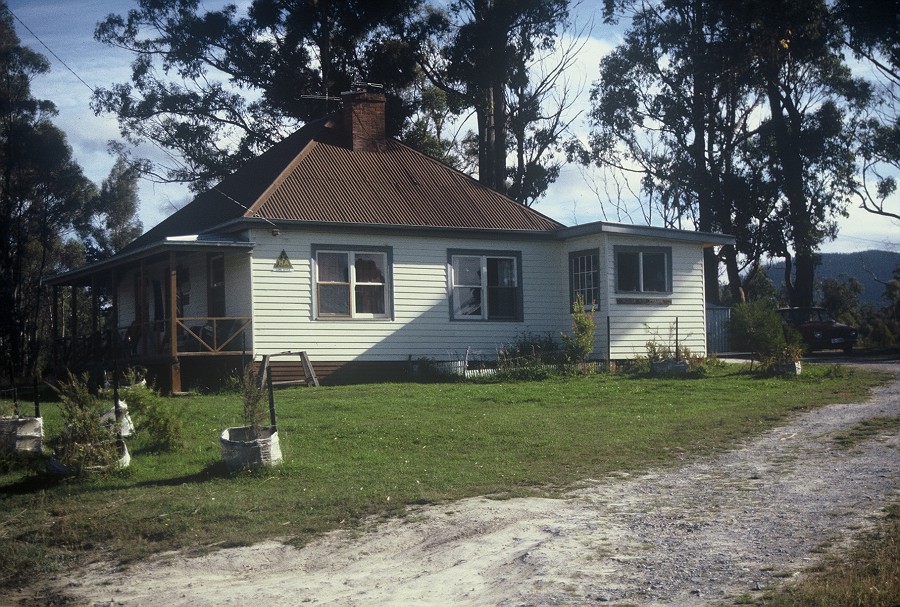
Hostel in Lune River, Tasmania, Australia
I stayed about a week here – Three years later I came back and spent two more weeks.
Great place, out in the boonies at the end of a dirt road. One of my favorite hostels and locations.
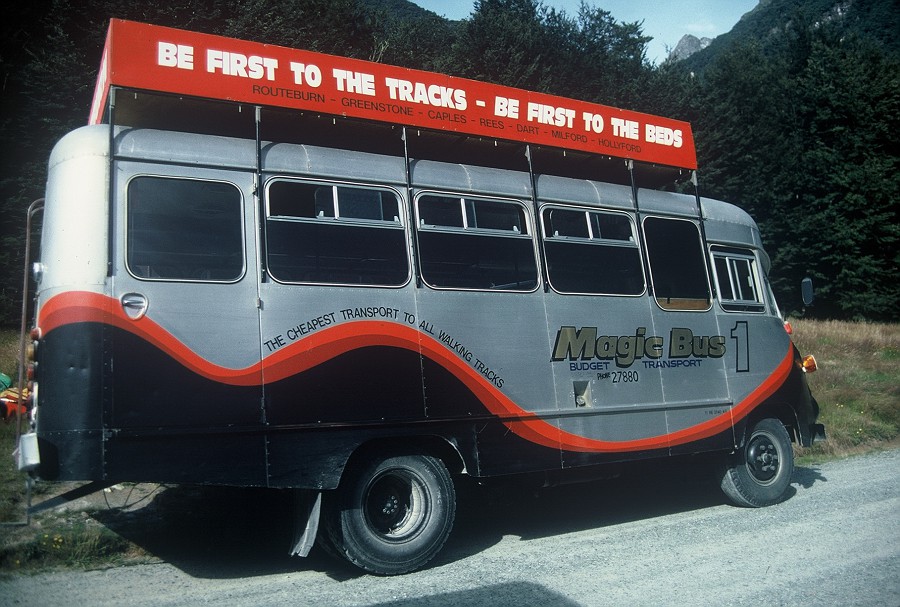
Budget Transport on New Zealand’s South Island
I spent many nights hiking the various tracks around Queenstown.
Cheap transport and cheaper lodging in the huts on the tracks.
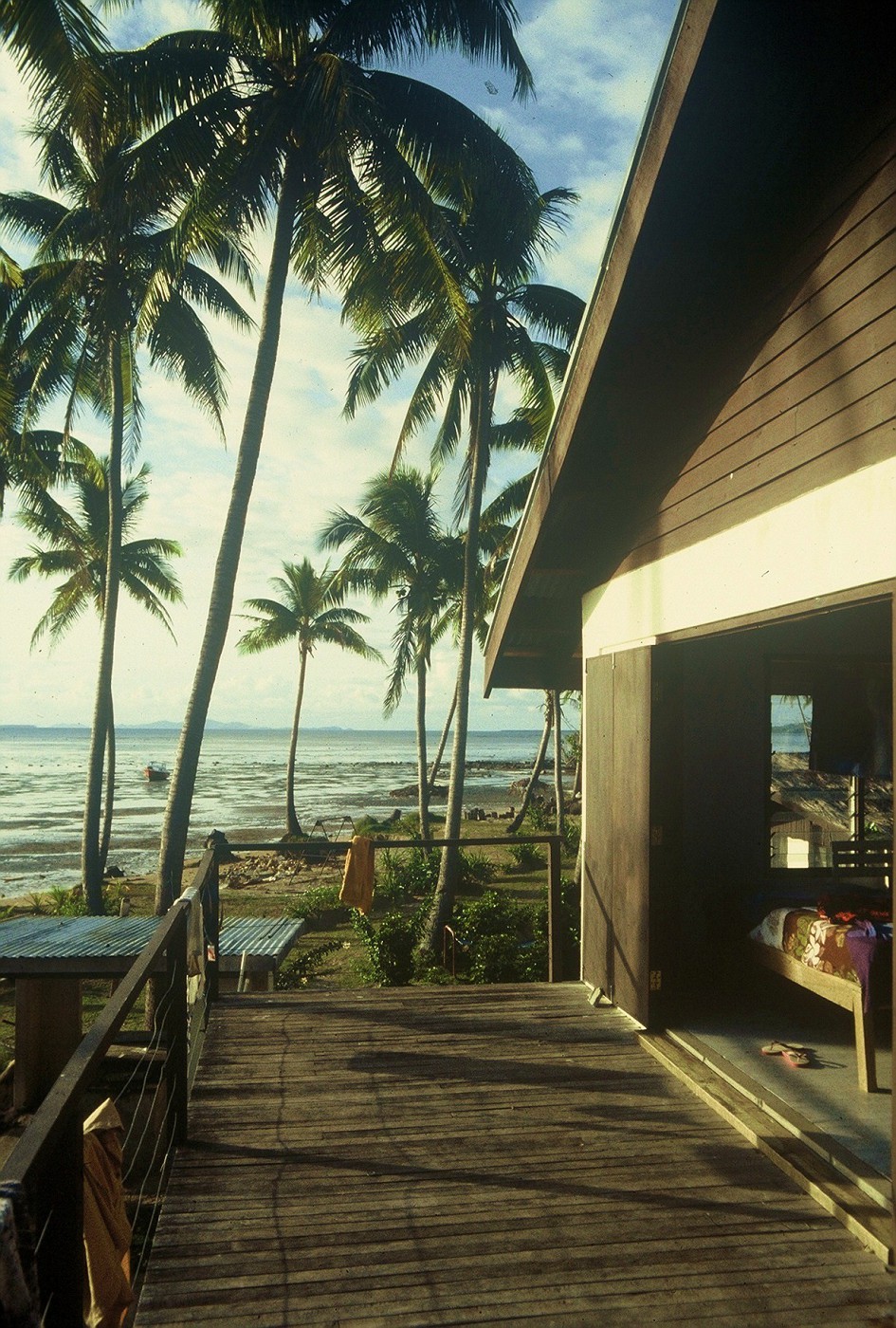
The view off the deck from my hostel on Momi Bay in Fiji
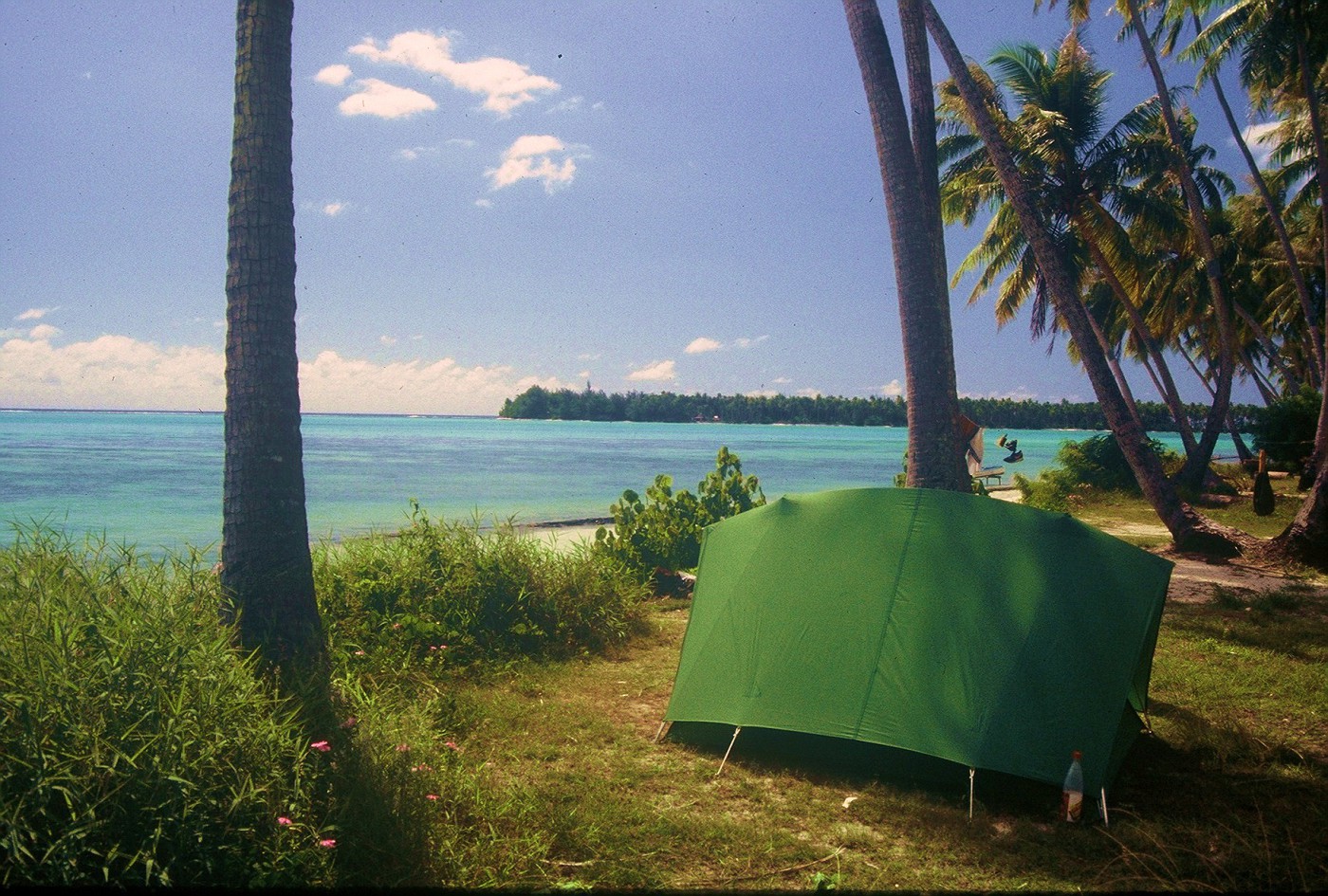
Home Sweet Home – My campsite on Moorea
This was my base for almost three weeks
I’ve always enjoyed seeing new places and experiencing different cultures and foods, but I’ve enjoyed even more the sheer pleasure of just going somewhere. I know it’s an oft used travel quote, but frankly nobody could have said it better in describing my affliction…
But I digress. Getting back to the trip report, I was looking for a way to keep on truckin’ for just a little while longer and I found it via two 7500 mile one way in-state awards on Alaska Airlines and a $107.00 one way passage aboard the Alaska Marine Highway between Juneau and Ketchikan. The beauty of the sailing that attracted my attention was twofold. First, it was aboard the M.V. Taku, my favorite ship in the fleet. Second, the sailing between Juneau and Ketchikan routed via Hoonah, Sitka and Kake. This routing made for a longer journey than the more direct route from Juneau straight down to Petersburg and Wrangell to Ketchikan. The map below should help explain the geography of the region:
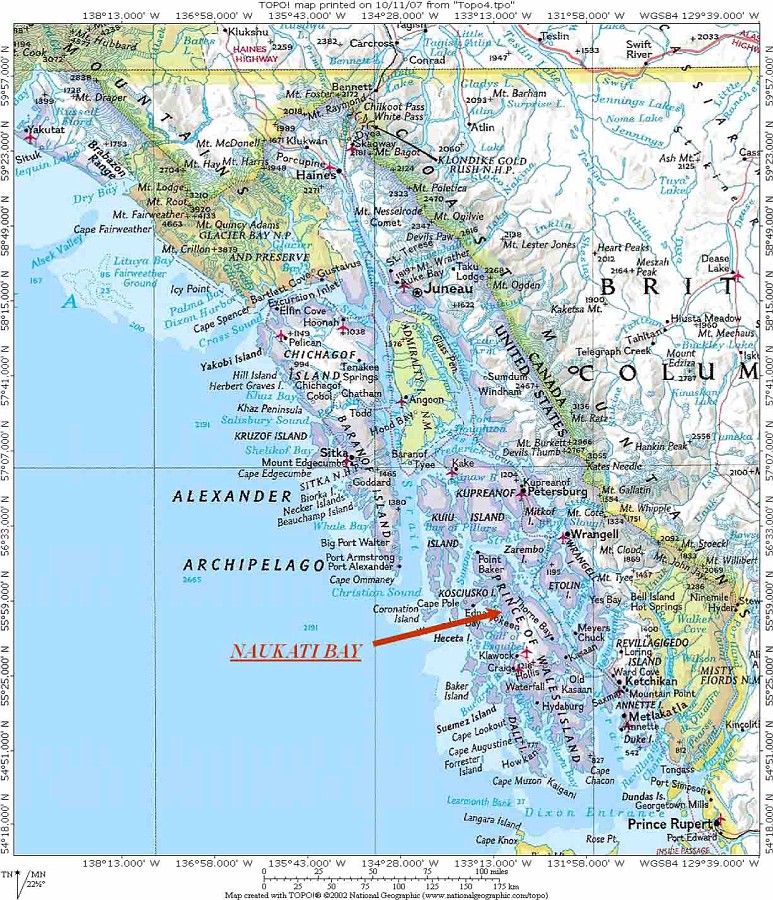
Alaska Marine Highway Southeast System Route Map
The direct route can take as little as 18 hours but the route via Sitka requires sailing across to Hoonah before proceeding up and around Chichagof Island and down to Sitka. Tides often require spending anywhere from 3-5 hours in Sitka before departing for Kake, a journey that requires traveling all the way back up Baranof Island before bearing right through the Kakul and Sergius Narrows that separate Chichagof and Baranof Islands. Bearing right (south) down the Chatham Strait, our next stop will be Kake. From there it’s pretty much a straight shot down through Petersburg and Wrangell to Ketchikan. The extra time required to sail around Chichagof and Baranof Islands results in a total sailing time of 39 hours which suits my needs perfectly.
And what are my needs? They’re quite simple really – a nice long cruise to sit back and enjoy. I don’t require a posh cabin, casinos or seven course meals. A comfortable chair and a big window on the world will do just fine, thank you. For sleeping I know of a couple of nooks on the Taku that are just perfect for my Thermarest Pad, pillow and blanket.
Other than that, the Taku offers all the creature comforts most travelers could ever ask for on three passenger decks. From the top down they include the Sun Deck, the Boat Deck and the Cabin Deck. Below those is the Car Deck.
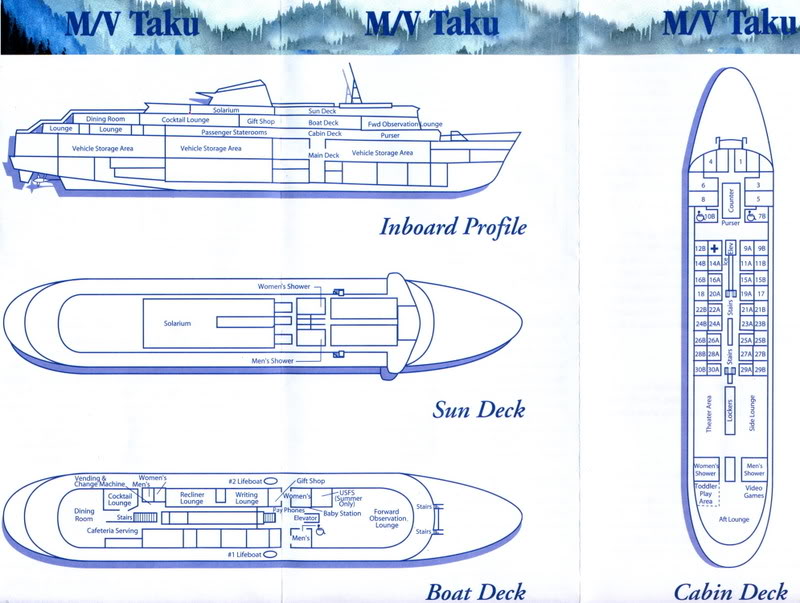
M.V. Taku Deck Plan
On the Sun Deck is a solarium equipped with overhead heat lamps and shower-equipped bathrooms. An open deck area behind the solarium provides plenty of space for deck chairs or tents. If the temperatures were warmer I’d sleep up there under the solarium but this time of year you’ll find me one level down on the Boat Deck.
The Boat Deck is the busiest deck on the boat. At the rear of the deck is the dining room – a cafeteria really, but one with decent food and a large, spacious dining area surrounded by big picture windows that provide a great view of the scenery to the sides and behind us. Just off the entrance to the dining room is the Taku Bar. It’s quite the convivial little place with bar seating for six and cocktail lounge seating for about twenty more. Moving on towards the front of the boat we come to a small lounge with recliners followed by a writing area with a few tables and chairs. Beyond that lies the forward observation lounge. This is a large room that takes up the forward quarter of the Boat Deck. It provides both recliner and day seating and some of the side seats are set around low tables. The wrap around windows is magnificent, particularly in this part of the world.
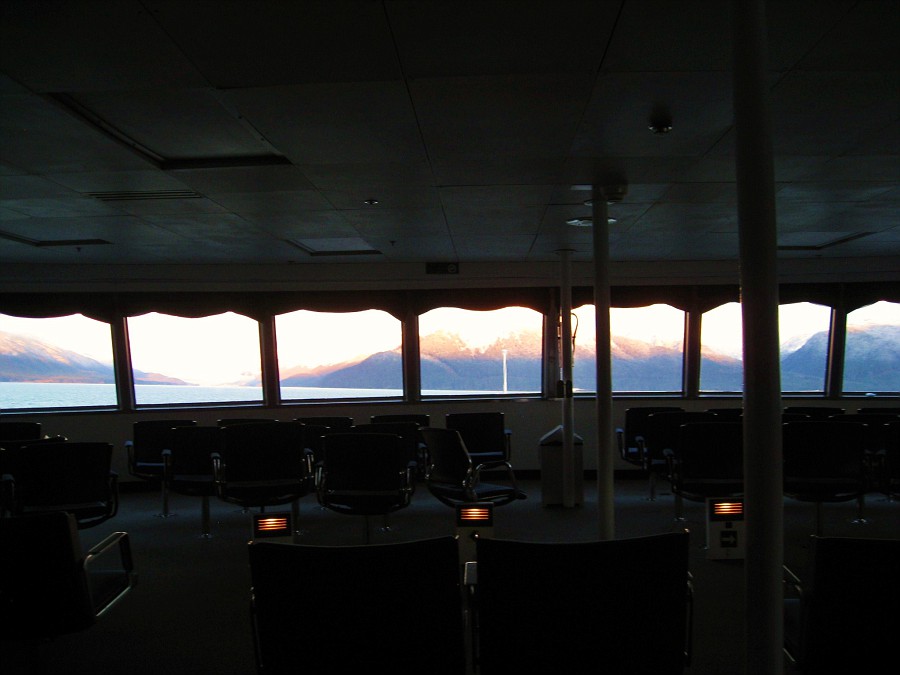
M.V. Taku Forward Lounge
The next level down is the Cabin Deck. As the name implies, it’s where you’ll find all the cabins along with the movie lounge and a couple more passenger seating lounges. I’ve seen a couple of the cabins on Alaska Marine Highway ferries, including those aboard the Taku. They’re very basic and while they’ll afford you privacy, don’t expect any creature comforts beyond a bed, some shelves and maybe an ensuite bathroom.
It’s been said that the ferries of the Alaska Marine Highway are for travelers while the fancy cruise ships from lines like Princess and Holland America are for the tourists. Both styles of travel have their advantages but from what I’ve seen (and experienced) cruise ships are often so large and come with so many man made distractions that the sea and surrounding landscape can sometimes seem secondary to the ship itself. Generally, people desiring of the considerable luxuries of a cruise ship won’t be found “driving” along the Alaska Marine Highway.
Which brings up a commonly asked question: Why is it called the Alaska Marine “Highway”?
The name can be a bit confusing to some since there are no roads to or between the communities of Southeastern Alaska. Once known as the Alaska Ferry System, the name was changed to the Alaska Marine Highway shortly after Alaska gained its statehood in 1959. One story has it that the new State of Alaska had requested federal funding for the Alaska Ferry System fleet but their request was denied by the Federal government on the basis that only highway systems are eligible for Federal transportation funds. The State of Alaska then renamed the Alaska Ferry System to the Alaska Marine Highway and lo and behold, the federal funds began to flow. Funny how government works sometimes, isn’t it?
To this day, the communities throughout Alaska’s southeastern panhandle remain accessible only by air and sea, so the ferries of the Alaska Marine Highway continue to play a vital role in the transport of people, freight and vehicles. There are currently eleven ferries in the fleet, some of them fairly small. The route system stretches as far south as Bellingham, Washington and as far west as Dutch Harbor in the Aleutian Islands.
* * * - * * * - * * *
Alright then – I need to get to Juneau. Alaska is such a big state that Alaska Airlines offers special in-state awards for just 7500 miles each way. I was able to book a nicely timed connection through Anchorage that would allow me time for lunch with friends at the nearby Millennium Hotel before connecting to my two-stop flight via Cordova and Yakutat to Juneau. At this point I think we all know what it’s like to fly coach – even on an Alaska 737 Combi - so I’ll dispense with any descriptions and leave you with a couple of pictures from the flights down to Juneau:
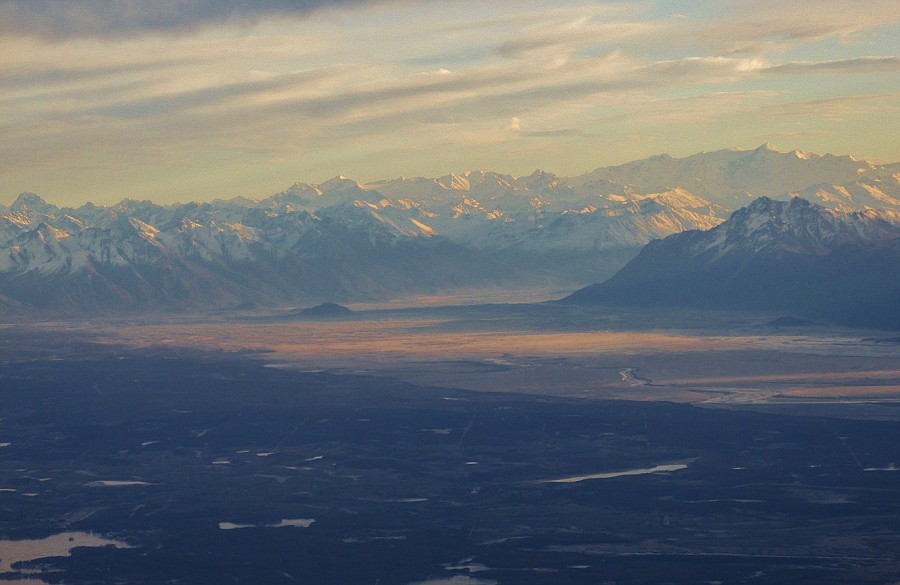
Chugach Mountains as seen on approach into Anchorage
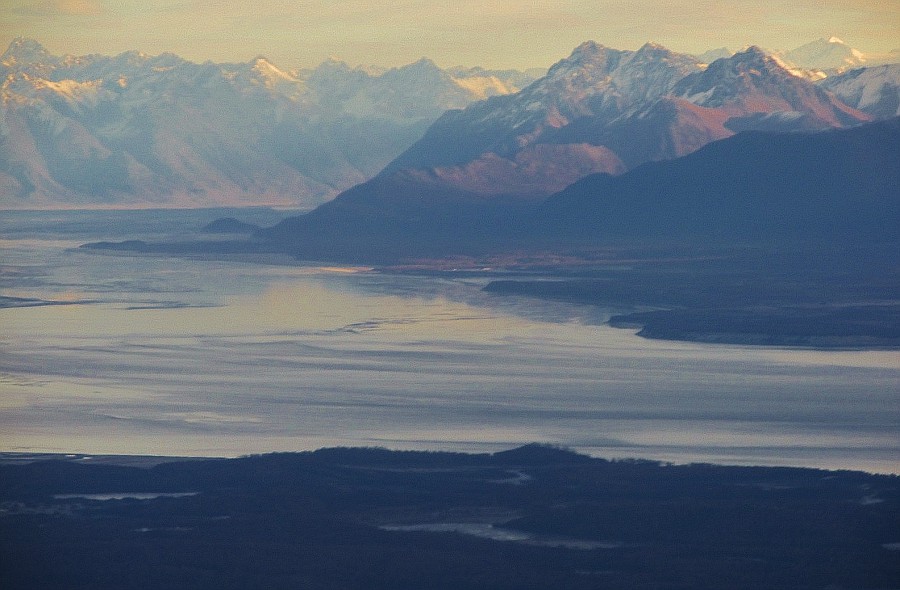
Chugach Mountains tower above the Knik Arm of the Cook Inlet
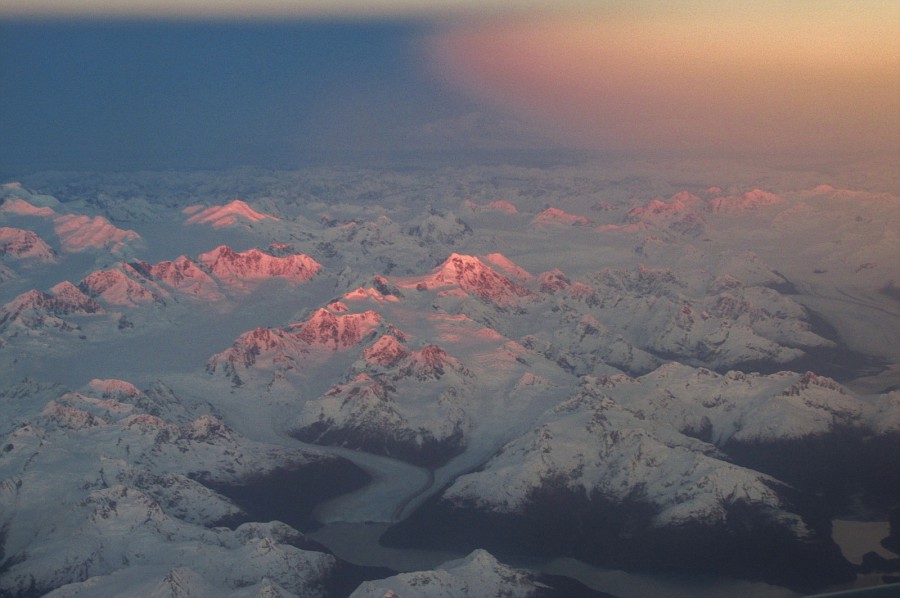
Alpenglow on the Wrangell Mountains
As seen while flying between Anchorage and Cordova
Upon arrival in Juneau, I caught a ride over to the Travelodge in its airport van. The hotel has a Mexican Restaurant on-site called Mi Casa and, with five hours until my boat was due to depart there’d be plenty of time for a leisurely dinner. I was pleasantly surprised to find that the Mexican beer on tap was an old favorite – Negro Modelo – and at just $5.00 a pint quite reasonably priced – for Juneau. The salsa was also surprisingly good. Unfortunately, I can’t offer a glowing endorsement of my meal. The service was great but the food was just so-so. Now a lot of people might think - well what did I expect? I’m in Alaska after all. Not so fast! Mexicans are everywhere these days and some of them have even come up to Alaska where in Fairbanks at least there are a couple of very good Mexican restaurants. Unfortunately my entrée tonight didn’t turn out so well. One meal does not a bad restaurant make, so I’ll check back with Mi Casa another time. As often as I pass through Juneau, there’ll be plenty of opportunities. I lingered over a couple more pints of Modelo and a good strong Wi-Fi connection before catching a taxi out to the ferry terminal. Located in Auke Bay about 8 miles out of town, that translated to an $18.00 cab fare.
The Taku had arrived in Juneau earlier that afternoon. Although cars were not allowed to drive onboard until 11:00pm, walk on passengers could board as early as 10:00pm. Check out the sign prominently posted in the ferry terminal:
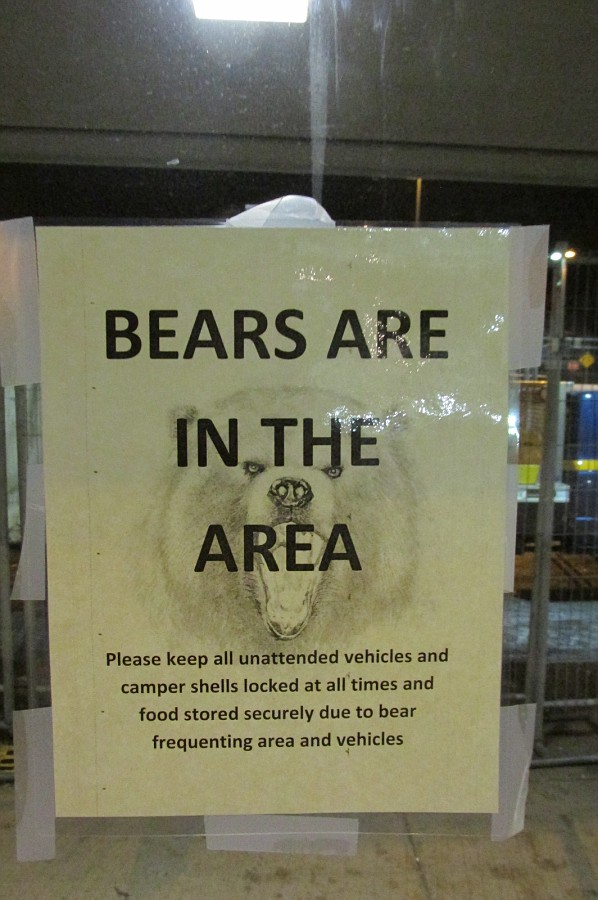
Beware of bears!
As is so often the case this time of year, the load was very light. There were a lot of cars lined up to board the Taku but only a few foot travelers. Additionally, many of the car passengers had booked rooms so by the time we set sail there were only about twenty passengers spread out around the various lounges onboard. My favorite spot is the small side passenger lounge on the Boat Deck and tonight I had the entire room to myself.
I should note here that amongst those who don’t have rooms, not all sleep in the reclining chairs. Quite a few people stretch out on the floor or better yet bring along inflatable mattresses complete with pillows, sheets and blankets. The forward lounge is very popular as is the larger aft lounge on the Cabin Deck. That’s why I like my spot in the small lounge up on the boat deck. There are usually no more than one or two other people in there. On this trip I’ll have two nights onboard as we won’t arrive Ketchikan until the day after tomorrow.
I slept well and in the morning grabbed a towel and headed upstairs to the solarium where a couple of spacious showers awaited. They provide plenty of hot water and good pressure – quite a luxury on a ferry like this and a great way to start the day. Returning to my campsite in the lounge below, I stored my blanket and pillow in my suitcase, folded my Thermarest Pad in half and stashed it beside my seat and then headed forward to the cafeteria for breakfast.

Sunrise at sea

Another beautiful day on the Inside Passage
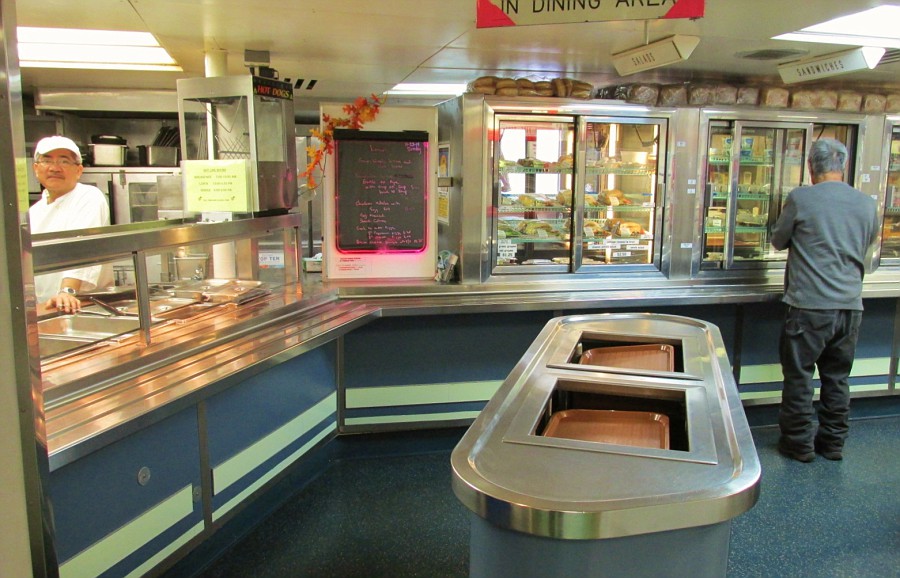
MV Taku Grill
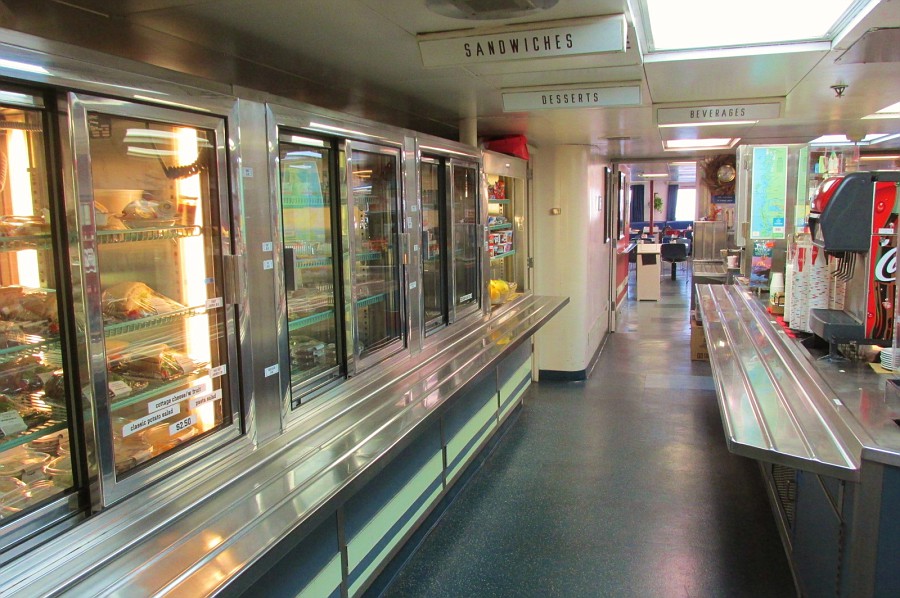
MV Taku Cafeteria
The Taku’s cafeteria offers a variety of hot breakfast entrees cooked to order or cold takeaway items from the display case such as cereal or fresh fruit and yogurt. I eat plenty of cereal at home, so I wanted to celebrate with something warm and filling. I’ll have the Denver Omelet please. Priced at just $9.95, it included toast, potatoes and a nice chat with Tommy, the cheerful short order cook working the grill. As for coffee, I brought my own along with filter cone, creamer and Stevia. The hot water was free.

MV Taku Dining Room
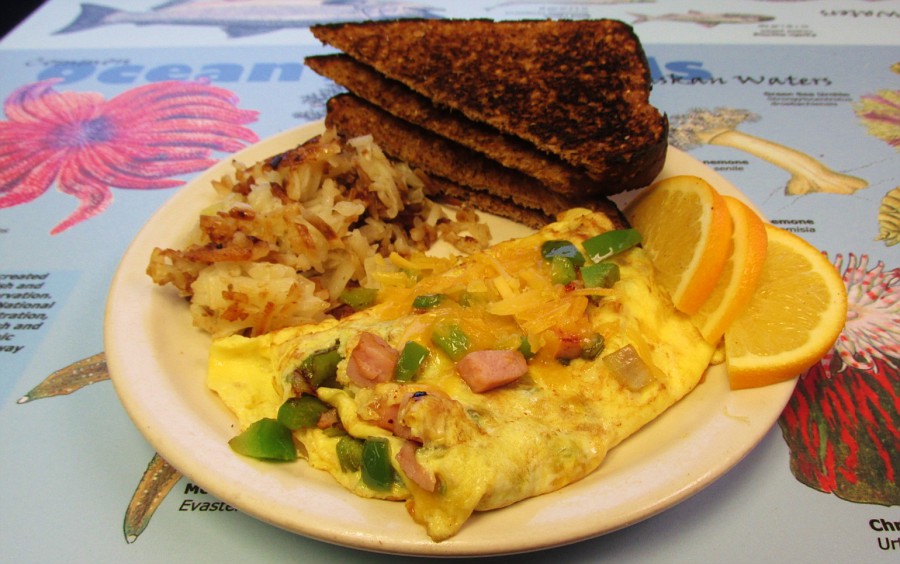
Denver Omelet Taku style
Ship board life is pretty relaxed. Many people bring mp3 players along, others have books and laptops. Although there is no Wi-Fi onboard, there are plenty of electrical outlets and more than a few people bring movies along to watch on their laptops. In the afternoon a movie is shown in the movie lounge on the cabin deck. Because the ferries travel in the protected waters of the Inside Passage, the scenery varies from broad channels that may be 3-5 miles wide to narrow passages no more than 200-300 feet wide. In some areas like the Wrangell Narrows, the boat passes between rocks that are no more than 20 feet away on each side of the boat! Here are a few pictures I took along the way…
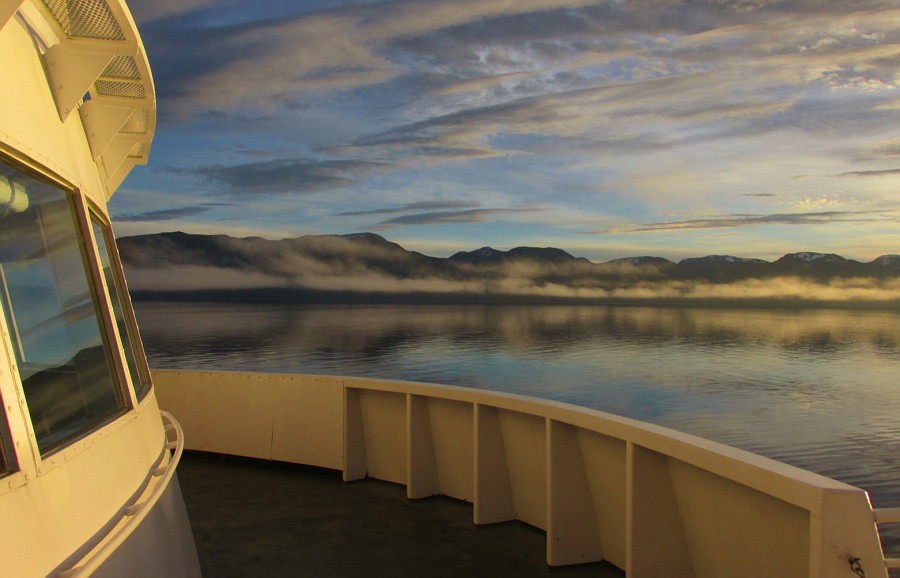
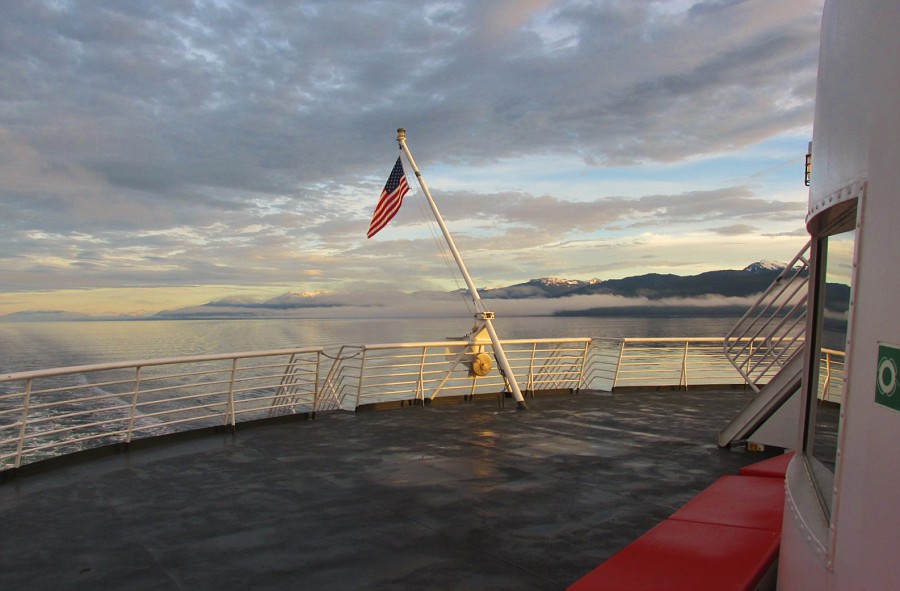
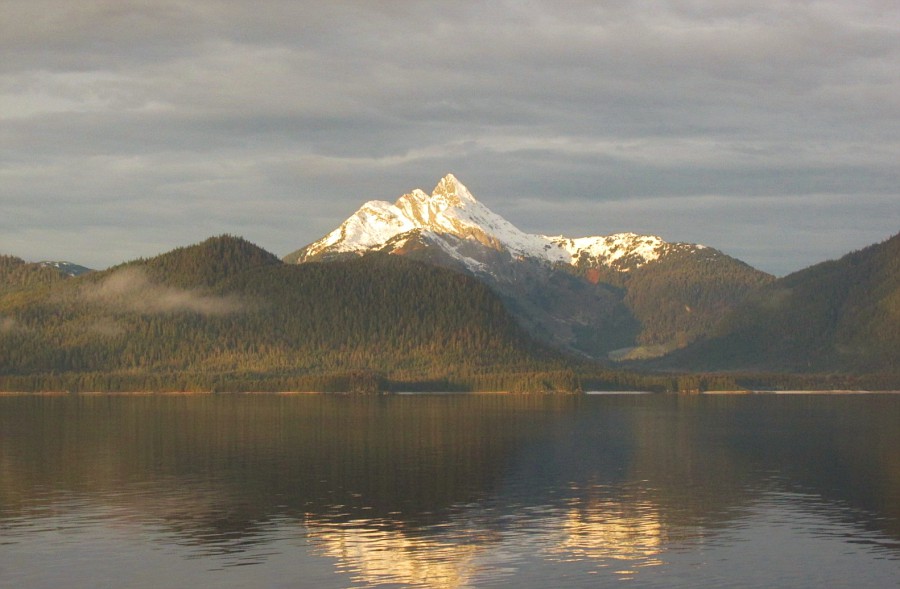
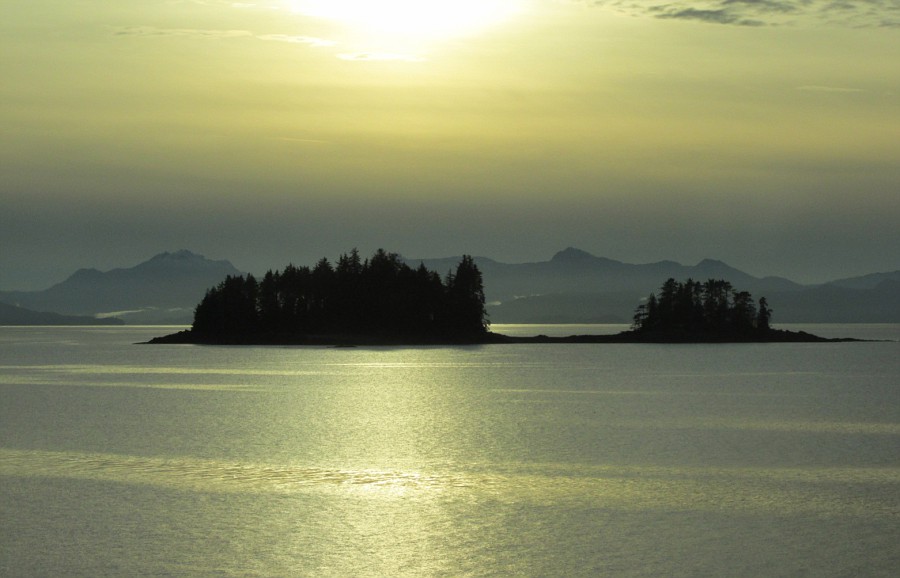
I split much of my time between the forward lounge and the writing lounge located just forward of where I was camped. It had tables and plugs and big windows and ergonomically correct chairs that proved to be a great boon given all the time I spent there working on the early portions of this report. Hard to believe it’s been almost four weeks since then!
As the day wore on I found myself stopping often to step outside and take pictures of the beautiful sea and shore in the fading light.
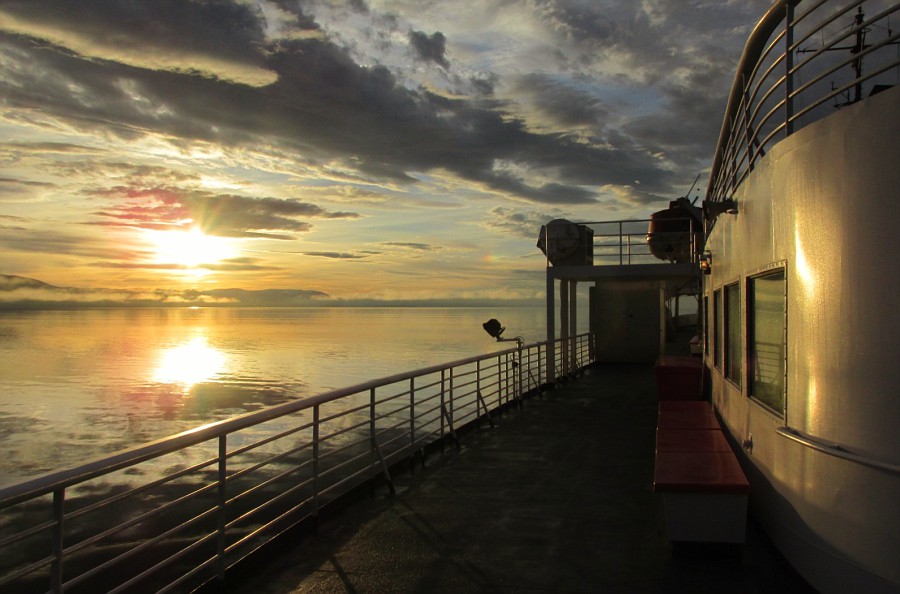
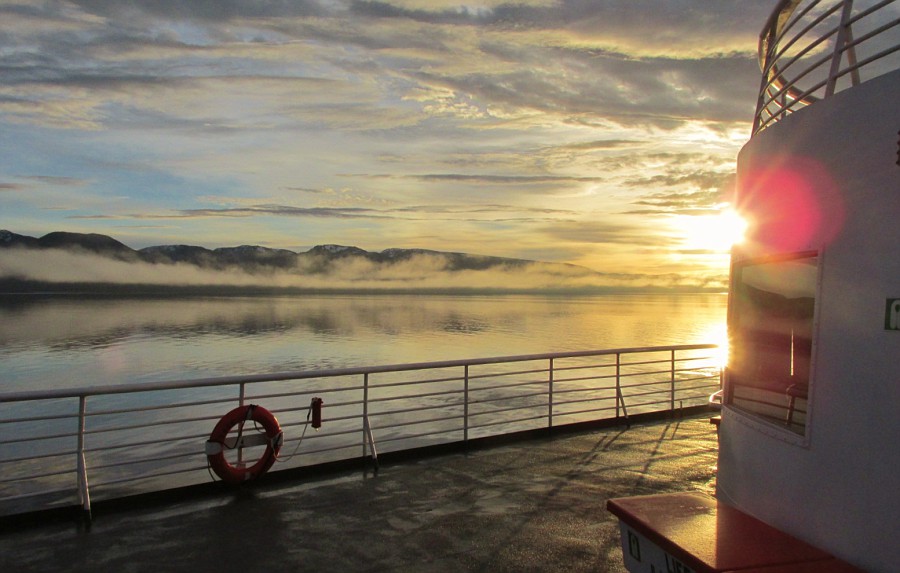
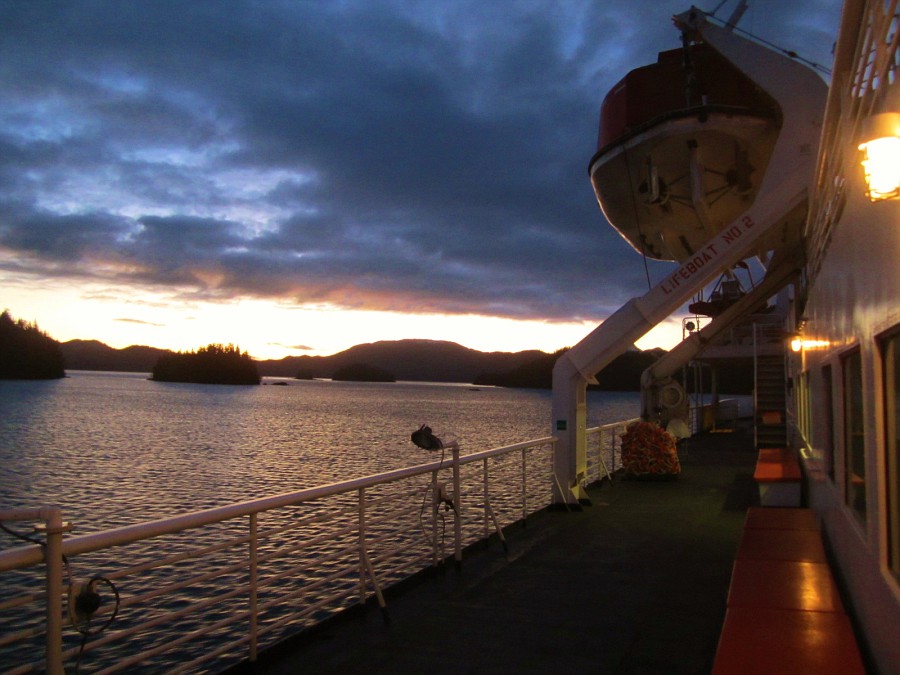
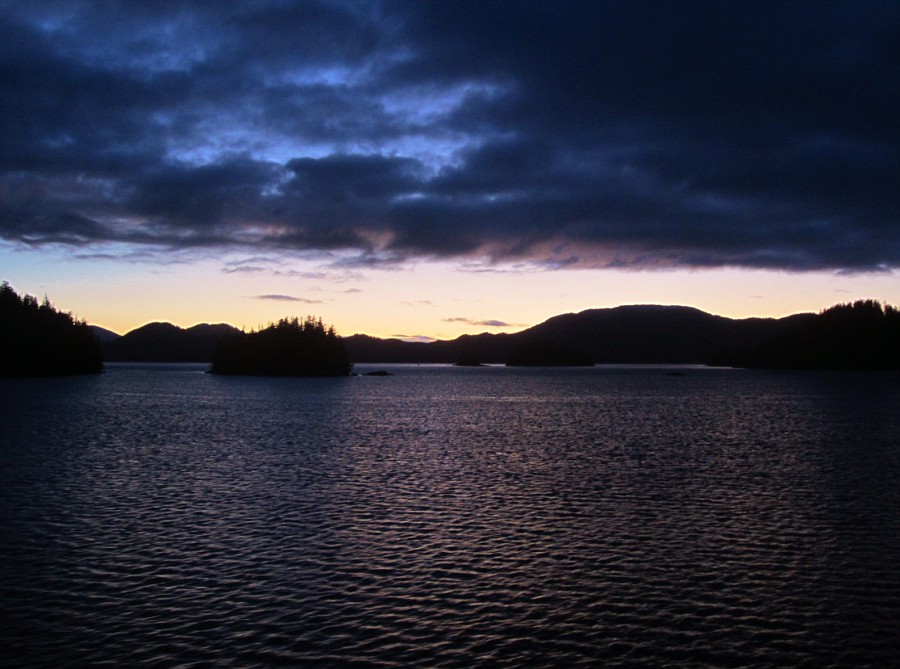
Did I mention there’s a bar on board? Well there is, just off the entrance to the dining room. It’s open from noon to 11:30pm though on these winter runs it sometimes doesn’t open until four. All of the bars that I’ve seen on the Alaska Marine Highway ferries are very nice but the one on the Taku is my favorite. It’s the smallest and the coziest of the bars I’ve visited and on some nights – especially during the busier summer season – it can get quite lively as people bring in their instruments and collective bonhomie. I remember riding up from Prince Rupert one spring when an impromptu bluegrass band sprung up and it was actually pretty darned good!
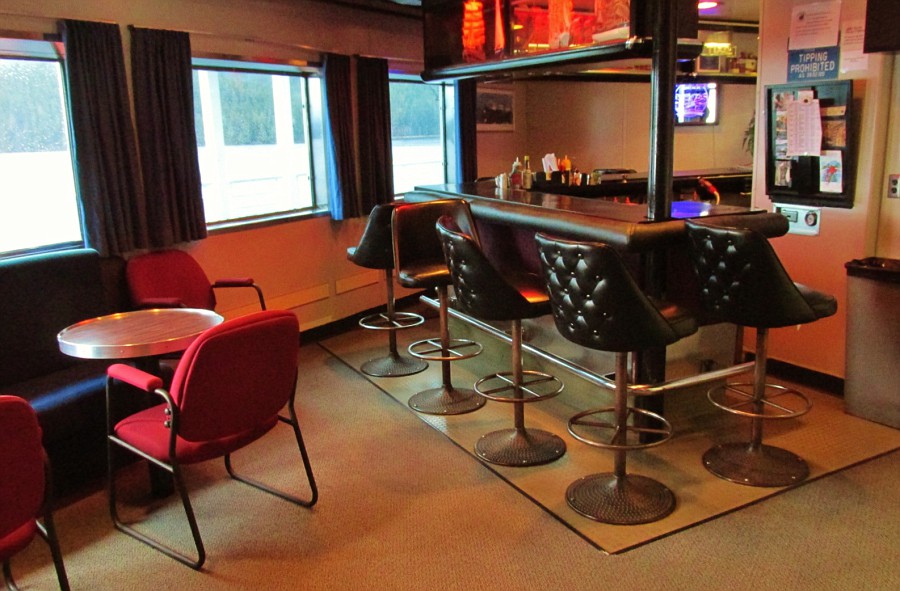
The M.V. Taku Bar
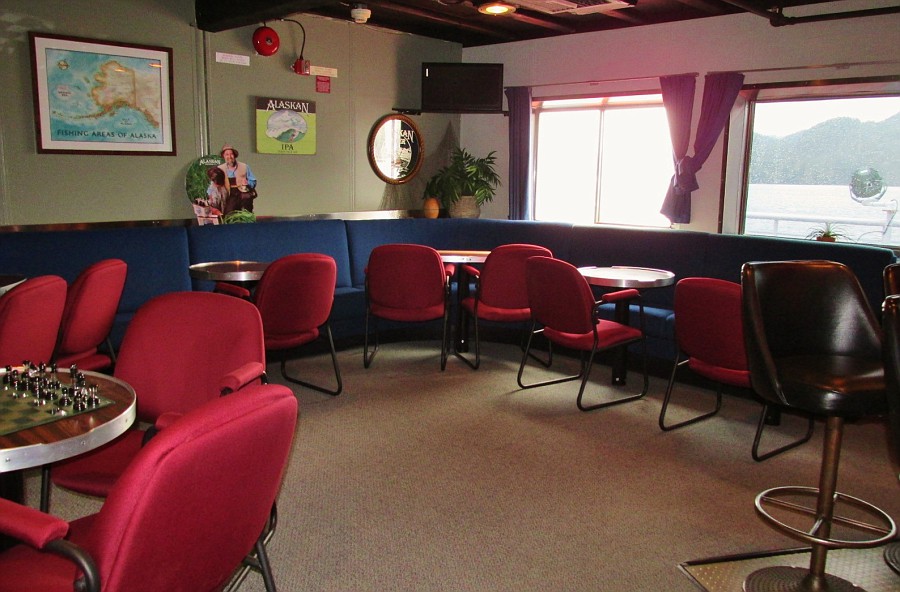
The M.V. Taku Lounge
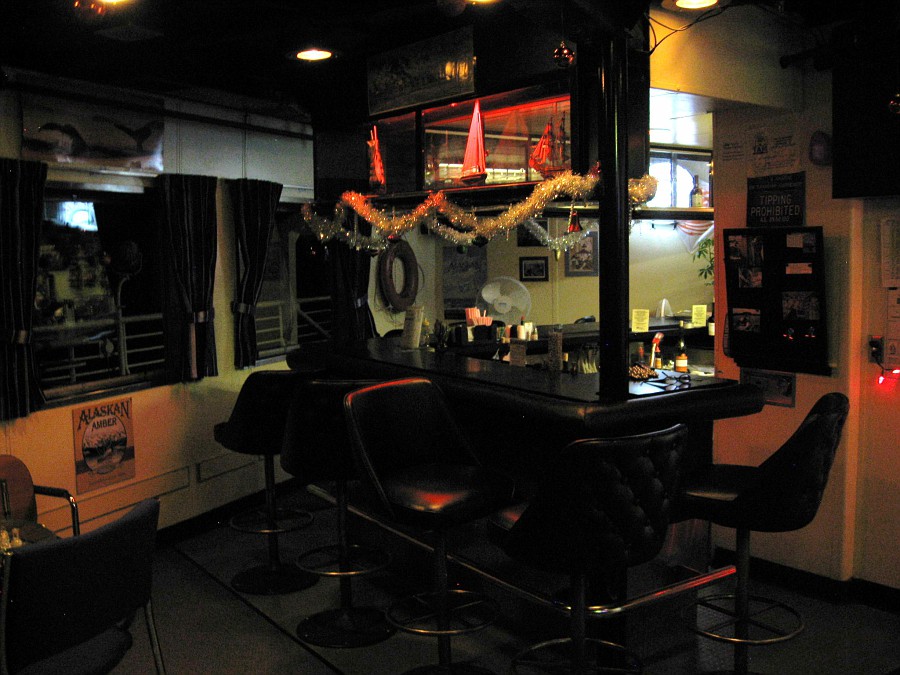
The M.V. Taku Bar at night
Alas, things were quite a bit more sedate on this trip. The crew outnumbered the passengers by at least two to one and with the exception of myself nobody seemed interested in spending any quality time in the ship’s lounge. In fact, for about three hours it was just me, the bartender and his crew chief. The chief was of Filipino heritage (as were many of the crew), had grown up in California and had had quite a long and interesting career at sea. He was also an avid football fan. American football, that is. It was Sunday and with no wi-fi nobody knew any of the scores. Thankfully he had a smart phone that was able to pick up a good enough signal that he could give us all of the scores. As things turned out for my Broncos, I missed what must’ve been a great game to watch as the Broncos beat the Dolphins 39-36. Later we were joined by a man on his way home to Lincoln, Montana. He’d been helping his son build a house in Sitka all summer and much of the fall. I envied him his drive back home as he’d be getting off in Prince Rupert and driving down the Yellowhead to Jasper before turning south down the spectacular Icefields Parkway – weather permitting. I’ve driven those roads many times and no matter how he ultimately gets home, he was going to be in for a wonderful road trip.
It was about 10 when I bid the crew in the lounge good night and headed back to what for all intents and purposes had become my personal lounge. I was loving the privacy but my enjoyment was somewhat tempered by the fact that the Alaska Marine Highway certainly couldn’t have made any money on this trip. But who knows, tomorrow or the next day they could pick up a big load of school kids commuting to a basketball game or wrestling match at another southeast community. I once shared the Taku with over 250 students heading up to Juneau for a spelling bee. They were chaperoned and generally well behaved but there were just so many of them that a relaxed journey soon became somewhat frenetic with all these kids running all over the place. I could sympathize though. I mean, I would love to have done a field trip on the ferry when I was in school. Seriously fun!
The next day I awoke to cloudy skies with intermittent rain. This was not unexpected as the coastal regions of the Alaskan panhandle are amongst the wettest places in the world. Still, there were a couple of pretty spots through all that rain and mist, one of which was some narrows where we ran fairly close to the shore during an interlude in the rain. I ran out to take a picture!
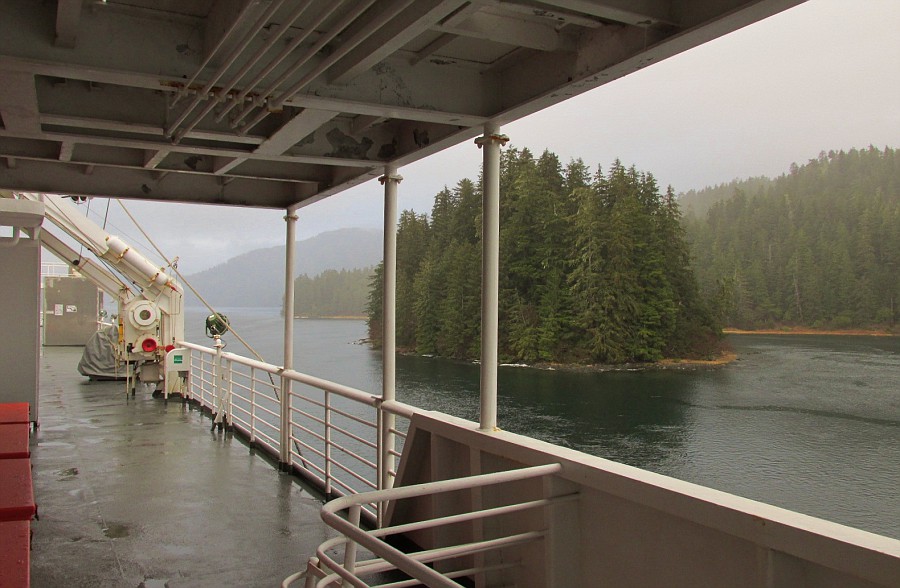
After a delicious lunch of Chicken Adobo, I headed back to my lounge and began to pack up. The purser had announced that we were expecting to arrive in Ketchikan about ten minutes early, which was good for me because once there I still had another ferry to catch to the airport, which is located on an island across the channel from Ketchikan.
As things turned out we did indeed arrive early, but by the time the deckhands had gotten the boat secured and the ramp set up for cars to drive off, we were about two minutes late. Honestly though, what a great way to spend $107.00 plus about $80 onboard for meals and drinks. In return I got 39 hours of relaxation and smooth sailing through one of the world’s most scenic landscapes. As you might imagine, I already want to go back and do it again!
Maybe next spring…
* * * - * * * - * * *
So there you have it gang! Planes, trains, cars and a ferry – what a great way to travel around the continent! Although I thoroughly enjoy flying and to that end have averaged over 180000 miles per year of doing so since 2001, in the future I’d really like to spend even more time seeing this planet from “See Level”. I’ve got my eyes set on that Trans-Siberian train across Russia as well as a paddle wheeler trip down the length of the Mississippi River. If gas prices continue to drop, I just may make my seventeenth drive from Alaska down to the Lower 48 as well. It’s so darned exciting to even contemplate trips such as these that I’d better close now before I wake up tomorrow or the next day and find myself booked on a plane outta town in pursuit of yet another excellent adventure.
Finally, if you’ve made it this far I just want thank you for the time and dedication invested in getting through a report of this length. I hope you’ve enjoyed tagging along with me and that you found the report worthy of your time.
Happy Travels and Happy Holidays to you all!
Horizon Airlines Fairbanks to Anchorage 1030a – 1145a DCH-8-400 Coach Class
Alaska Airlines Anchorage to Juneau 325p – 714p 737-400 Coach Class via CDV and YAK
Alaska Marine Highway Juneau to Ketchikan 1130p-230p+2 M.V. Taku
Now we come to the final chapter in this potpourri of travels. Fast forward to mid-November and I’d just returned home from five weeks on the road that included visits to Louisiana, Central Pennsylvania, the Florida Everglades, the Oregon Coast, the Colorado Rockies and the Desert Southwest. During that time I’d also racked up enough flights and miles to maintain top flight elite status with my favorite airline. For all intents and purposes, my travel should have been done for the year. It was time to settle in for the winter and get ready for work in January.
And yet – I wasn’t ready to call it quits just yet. I’m honestly at a loss to explain it but within a couple days of returning home, I was already looking at using some of my miles for an instate award. I knew I didn’t want to go down to the Lower 48 again but I definitely felt a desire to get out and just go somewhere. Again. I don’t know what you’d call it – momentum perhaps? It’s like after a long night of dancing with a great gal and then that’s it – the band’s done for the night. Yeah, but you both were having such a good time that you could easily go another hour or two. C’mon! Just one more song!
Thankfully, due to the seasonal nature of my work I had plenty of free time ahead of me. Combine that with good paying jobs and a contentedly frugal lifestyle that allows me more money to travel and hey – I get to decide when to call it quits, not the band! Obviously having the time available to travel is huge, but equally important for me has been the willingness to travel and live frugally. A lifetime of doing so has allowed me to travel farther and stay out longer than many others with similar amounts of money to work with.
I remember my first long overseas trip, a three and a half month journey through the South Pacific with stops in Australia, New Zealand, Fiji, Raratonga and Tahiti. It was 1984 and I had budgeted $15.00 per day to live on outside of transport and accommodations. Mostly I stayed in hostels or camped out.

Hostel in Lune River, Tasmania, Australia
I stayed about a week here – Three years later I came back and spent two more weeks.
Great place, out in the boonies at the end of a dirt road. One of my favorite hostels and locations.

Budget Transport on New Zealand’s South Island
I spent many nights hiking the various tracks around Queenstown.
Cheap transport and cheaper lodging in the huts on the tracks.

The view off the deck from my hostel on Momi Bay in Fiji

Home Sweet Home – My campsite on Moorea
This was my base for almost three weeks
I’ve always enjoyed seeing new places and experiencing different cultures and foods, but I’ve enjoyed even more the sheer pleasure of just going somewhere. I know it’s an oft used travel quote, but frankly nobody could have said it better in describing my affliction…
For my part, I travel not to go anywhere, but to go. I travel for travel's sake.
The great affair is to move.
Robert Louis Stevenson
The great affair is to move.
Robert Louis Stevenson
But I digress. Getting back to the trip report, I was looking for a way to keep on truckin’ for just a little while longer and I found it via two 7500 mile one way in-state awards on Alaska Airlines and a $107.00 one way passage aboard the Alaska Marine Highway between Juneau and Ketchikan. The beauty of the sailing that attracted my attention was twofold. First, it was aboard the M.V. Taku, my favorite ship in the fleet. Second, the sailing between Juneau and Ketchikan routed via Hoonah, Sitka and Kake. This routing made for a longer journey than the more direct route from Juneau straight down to Petersburg and Wrangell to Ketchikan. The map below should help explain the geography of the region:

Alaska Marine Highway Southeast System Route Map
The direct route can take as little as 18 hours but the route via Sitka requires sailing across to Hoonah before proceeding up and around Chichagof Island and down to Sitka. Tides often require spending anywhere from 3-5 hours in Sitka before departing for Kake, a journey that requires traveling all the way back up Baranof Island before bearing right through the Kakul and Sergius Narrows that separate Chichagof and Baranof Islands. Bearing right (south) down the Chatham Strait, our next stop will be Kake. From there it’s pretty much a straight shot down through Petersburg and Wrangell to Ketchikan. The extra time required to sail around Chichagof and Baranof Islands results in a total sailing time of 39 hours which suits my needs perfectly.
And what are my needs? They’re quite simple really – a nice long cruise to sit back and enjoy. I don’t require a posh cabin, casinos or seven course meals. A comfortable chair and a big window on the world will do just fine, thank you. For sleeping I know of a couple of nooks on the Taku that are just perfect for my Thermarest Pad, pillow and blanket.
Other than that, the Taku offers all the creature comforts most travelers could ever ask for on three passenger decks. From the top down they include the Sun Deck, the Boat Deck and the Cabin Deck. Below those is the Car Deck.

M.V. Taku Deck Plan
On the Sun Deck is a solarium equipped with overhead heat lamps and shower-equipped bathrooms. An open deck area behind the solarium provides plenty of space for deck chairs or tents. If the temperatures were warmer I’d sleep up there under the solarium but this time of year you’ll find me one level down on the Boat Deck.
The Boat Deck is the busiest deck on the boat. At the rear of the deck is the dining room – a cafeteria really, but one with decent food and a large, spacious dining area surrounded by big picture windows that provide a great view of the scenery to the sides and behind us. Just off the entrance to the dining room is the Taku Bar. It’s quite the convivial little place with bar seating for six and cocktail lounge seating for about twenty more. Moving on towards the front of the boat we come to a small lounge with recliners followed by a writing area with a few tables and chairs. Beyond that lies the forward observation lounge. This is a large room that takes up the forward quarter of the Boat Deck. It provides both recliner and day seating and some of the side seats are set around low tables. The wrap around windows is magnificent, particularly in this part of the world.

M.V. Taku Forward Lounge
The next level down is the Cabin Deck. As the name implies, it’s where you’ll find all the cabins along with the movie lounge and a couple more passenger seating lounges. I’ve seen a couple of the cabins on Alaska Marine Highway ferries, including those aboard the Taku. They’re very basic and while they’ll afford you privacy, don’t expect any creature comforts beyond a bed, some shelves and maybe an ensuite bathroom.
It’s been said that the ferries of the Alaska Marine Highway are for travelers while the fancy cruise ships from lines like Princess and Holland America are for the tourists. Both styles of travel have their advantages but from what I’ve seen (and experienced) cruise ships are often so large and come with so many man made distractions that the sea and surrounding landscape can sometimes seem secondary to the ship itself. Generally, people desiring of the considerable luxuries of a cruise ship won’t be found “driving” along the Alaska Marine Highway.
Which brings up a commonly asked question: Why is it called the Alaska Marine “Highway”?
The name can be a bit confusing to some since there are no roads to or between the communities of Southeastern Alaska. Once known as the Alaska Ferry System, the name was changed to the Alaska Marine Highway shortly after Alaska gained its statehood in 1959. One story has it that the new State of Alaska had requested federal funding for the Alaska Ferry System fleet but their request was denied by the Federal government on the basis that only highway systems are eligible for Federal transportation funds. The State of Alaska then renamed the Alaska Ferry System to the Alaska Marine Highway and lo and behold, the federal funds began to flow. Funny how government works sometimes, isn’t it?
To this day, the communities throughout Alaska’s southeastern panhandle remain accessible only by air and sea, so the ferries of the Alaska Marine Highway continue to play a vital role in the transport of people, freight and vehicles. There are currently eleven ferries in the fleet, some of them fairly small. The route system stretches as far south as Bellingham, Washington and as far west as Dutch Harbor in the Aleutian Islands.
* * * - * * * - * * *
Alright then – I need to get to Juneau. Alaska is such a big state that Alaska Airlines offers special in-state awards for just 7500 miles each way. I was able to book a nicely timed connection through Anchorage that would allow me time for lunch with friends at the nearby Millennium Hotel before connecting to my two-stop flight via Cordova and Yakutat to Juneau. At this point I think we all know what it’s like to fly coach – even on an Alaska 737 Combi - so I’ll dispense with any descriptions and leave you with a couple of pictures from the flights down to Juneau:

Chugach Mountains as seen on approach into Anchorage

Chugach Mountains tower above the Knik Arm of the Cook Inlet

Alpenglow on the Wrangell Mountains
As seen while flying between Anchorage and Cordova
Upon arrival in Juneau, I caught a ride over to the Travelodge in its airport van. The hotel has a Mexican Restaurant on-site called Mi Casa and, with five hours until my boat was due to depart there’d be plenty of time for a leisurely dinner. I was pleasantly surprised to find that the Mexican beer on tap was an old favorite – Negro Modelo – and at just $5.00 a pint quite reasonably priced – for Juneau. The salsa was also surprisingly good. Unfortunately, I can’t offer a glowing endorsement of my meal. The service was great but the food was just so-so. Now a lot of people might think - well what did I expect? I’m in Alaska after all. Not so fast! Mexicans are everywhere these days and some of them have even come up to Alaska where in Fairbanks at least there are a couple of very good Mexican restaurants. Unfortunately my entrée tonight didn’t turn out so well. One meal does not a bad restaurant make, so I’ll check back with Mi Casa another time. As often as I pass through Juneau, there’ll be plenty of opportunities. I lingered over a couple more pints of Modelo and a good strong Wi-Fi connection before catching a taxi out to the ferry terminal. Located in Auke Bay about 8 miles out of town, that translated to an $18.00 cab fare.
The Taku had arrived in Juneau earlier that afternoon. Although cars were not allowed to drive onboard until 11:00pm, walk on passengers could board as early as 10:00pm. Check out the sign prominently posted in the ferry terminal:

Beware of bears!
As is so often the case this time of year, the load was very light. There were a lot of cars lined up to board the Taku but only a few foot travelers. Additionally, many of the car passengers had booked rooms so by the time we set sail there were only about twenty passengers spread out around the various lounges onboard. My favorite spot is the small side passenger lounge on the Boat Deck and tonight I had the entire room to myself.
I should note here that amongst those who don’t have rooms, not all sleep in the reclining chairs. Quite a few people stretch out on the floor or better yet bring along inflatable mattresses complete with pillows, sheets and blankets. The forward lounge is very popular as is the larger aft lounge on the Cabin Deck. That’s why I like my spot in the small lounge up on the boat deck. There are usually no more than one or two other people in there. On this trip I’ll have two nights onboard as we won’t arrive Ketchikan until the day after tomorrow.
I slept well and in the morning grabbed a towel and headed upstairs to the solarium where a couple of spacious showers awaited. They provide plenty of hot water and good pressure – quite a luxury on a ferry like this and a great way to start the day. Returning to my campsite in the lounge below, I stored my blanket and pillow in my suitcase, folded my Thermarest Pad in half and stashed it beside my seat and then headed forward to the cafeteria for breakfast.

Sunrise at sea

Another beautiful day on the Inside Passage

MV Taku Grill

MV Taku Cafeteria
The Taku’s cafeteria offers a variety of hot breakfast entrees cooked to order or cold takeaway items from the display case such as cereal or fresh fruit and yogurt. I eat plenty of cereal at home, so I wanted to celebrate with something warm and filling. I’ll have the Denver Omelet please. Priced at just $9.95, it included toast, potatoes and a nice chat with Tommy, the cheerful short order cook working the grill. As for coffee, I brought my own along with filter cone, creamer and Stevia. The hot water was free.

MV Taku Dining Room

Denver Omelet Taku style
Ship board life is pretty relaxed. Many people bring mp3 players along, others have books and laptops. Although there is no Wi-Fi onboard, there are plenty of electrical outlets and more than a few people bring movies along to watch on their laptops. In the afternoon a movie is shown in the movie lounge on the cabin deck. Because the ferries travel in the protected waters of the Inside Passage, the scenery varies from broad channels that may be 3-5 miles wide to narrow passages no more than 200-300 feet wide. In some areas like the Wrangell Narrows, the boat passes between rocks that are no more than 20 feet away on each side of the boat! Here are a few pictures I took along the way…




I split much of my time between the forward lounge and the writing lounge located just forward of where I was camped. It had tables and plugs and big windows and ergonomically correct chairs that proved to be a great boon given all the time I spent there working on the early portions of this report. Hard to believe it’s been almost four weeks since then!
As the day wore on I found myself stopping often to step outside and take pictures of the beautiful sea and shore in the fading light.




Did I mention there’s a bar on board? Well there is, just off the entrance to the dining room. It’s open from noon to 11:30pm though on these winter runs it sometimes doesn’t open until four. All of the bars that I’ve seen on the Alaska Marine Highway ferries are very nice but the one on the Taku is my favorite. It’s the smallest and the coziest of the bars I’ve visited and on some nights – especially during the busier summer season – it can get quite lively as people bring in their instruments and collective bonhomie. I remember riding up from Prince Rupert one spring when an impromptu bluegrass band sprung up and it was actually pretty darned good!

The M.V. Taku Bar

The M.V. Taku Lounge

The M.V. Taku Bar at night
Alas, things were quite a bit more sedate on this trip. The crew outnumbered the passengers by at least two to one and with the exception of myself nobody seemed interested in spending any quality time in the ship’s lounge. In fact, for about three hours it was just me, the bartender and his crew chief. The chief was of Filipino heritage (as were many of the crew), had grown up in California and had had quite a long and interesting career at sea. He was also an avid football fan. American football, that is. It was Sunday and with no wi-fi nobody knew any of the scores. Thankfully he had a smart phone that was able to pick up a good enough signal that he could give us all of the scores. As things turned out for my Broncos, I missed what must’ve been a great game to watch as the Broncos beat the Dolphins 39-36. Later we were joined by a man on his way home to Lincoln, Montana. He’d been helping his son build a house in Sitka all summer and much of the fall. I envied him his drive back home as he’d be getting off in Prince Rupert and driving down the Yellowhead to Jasper before turning south down the spectacular Icefields Parkway – weather permitting. I’ve driven those roads many times and no matter how he ultimately gets home, he was going to be in for a wonderful road trip.
It was about 10 when I bid the crew in the lounge good night and headed back to what for all intents and purposes had become my personal lounge. I was loving the privacy but my enjoyment was somewhat tempered by the fact that the Alaska Marine Highway certainly couldn’t have made any money on this trip. But who knows, tomorrow or the next day they could pick up a big load of school kids commuting to a basketball game or wrestling match at another southeast community. I once shared the Taku with over 250 students heading up to Juneau for a spelling bee. They were chaperoned and generally well behaved but there were just so many of them that a relaxed journey soon became somewhat frenetic with all these kids running all over the place. I could sympathize though. I mean, I would love to have done a field trip on the ferry when I was in school. Seriously fun!
The next day I awoke to cloudy skies with intermittent rain. This was not unexpected as the coastal regions of the Alaskan panhandle are amongst the wettest places in the world. Still, there were a couple of pretty spots through all that rain and mist, one of which was some narrows where we ran fairly close to the shore during an interlude in the rain. I ran out to take a picture!

After a delicious lunch of Chicken Adobo, I headed back to my lounge and began to pack up. The purser had announced that we were expecting to arrive in Ketchikan about ten minutes early, which was good for me because once there I still had another ferry to catch to the airport, which is located on an island across the channel from Ketchikan.
As things turned out we did indeed arrive early, but by the time the deckhands had gotten the boat secured and the ramp set up for cars to drive off, we were about two minutes late. Honestly though, what a great way to spend $107.00 plus about $80 onboard for meals and drinks. In return I got 39 hours of relaxation and smooth sailing through one of the world’s most scenic landscapes. As you might imagine, I already want to go back and do it again!
Maybe next spring…
* * * - * * * - * * *
So there you have it gang! Planes, trains, cars and a ferry – what a great way to travel around the continent! Although I thoroughly enjoy flying and to that end have averaged over 180000 miles per year of doing so since 2001, in the future I’d really like to spend even more time seeing this planet from “See Level”. I’ve got my eyes set on that Trans-Siberian train across Russia as well as a paddle wheeler trip down the length of the Mississippi River. If gas prices continue to drop, I just may make my seventeenth drive from Alaska down to the Lower 48 as well. It’s so darned exciting to even contemplate trips such as these that I’d better close now before I wake up tomorrow or the next day and find myself booked on a plane outta town in pursuit of yet another excellent adventure.
Finally, if you’ve made it this far I just want thank you for the time and dedication invested in getting through a report of this length. I hope you’ve enjoyed tagging along with me and that you found the report worthy of your time.
Happy Travels and Happy Holidays to you all!
Last edited by Seat 2A; Dec 25, 2014 at 1:50 pm



















